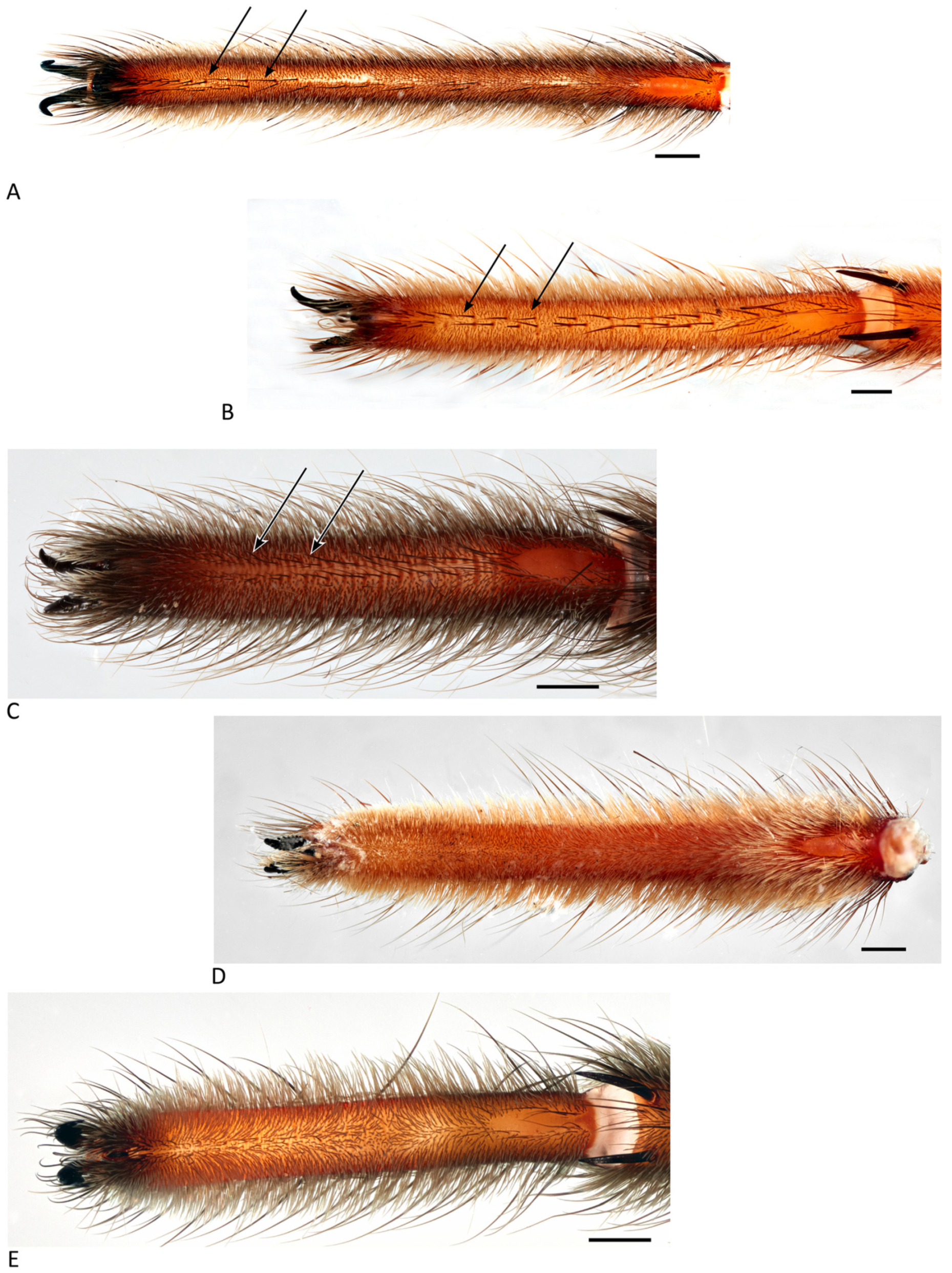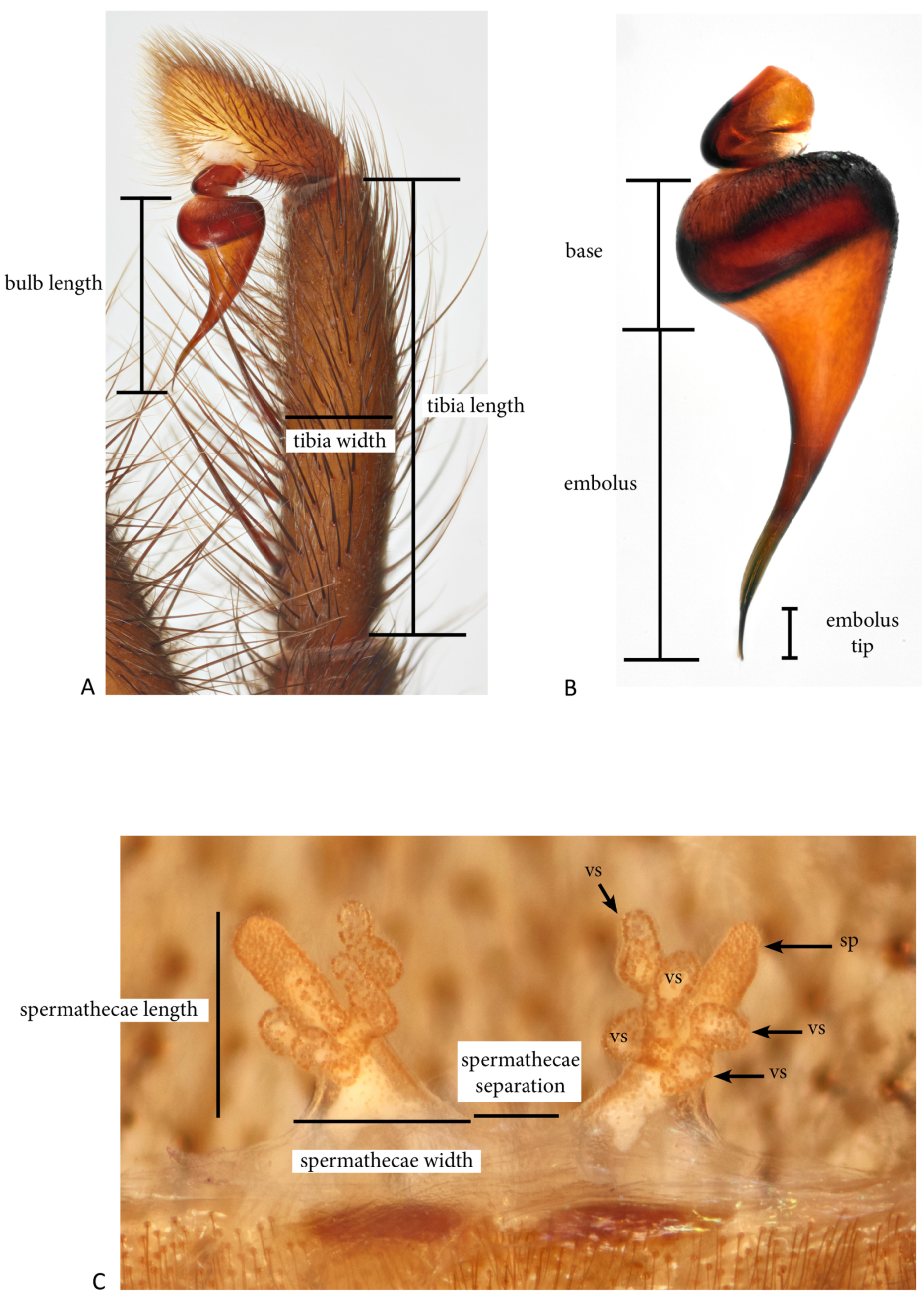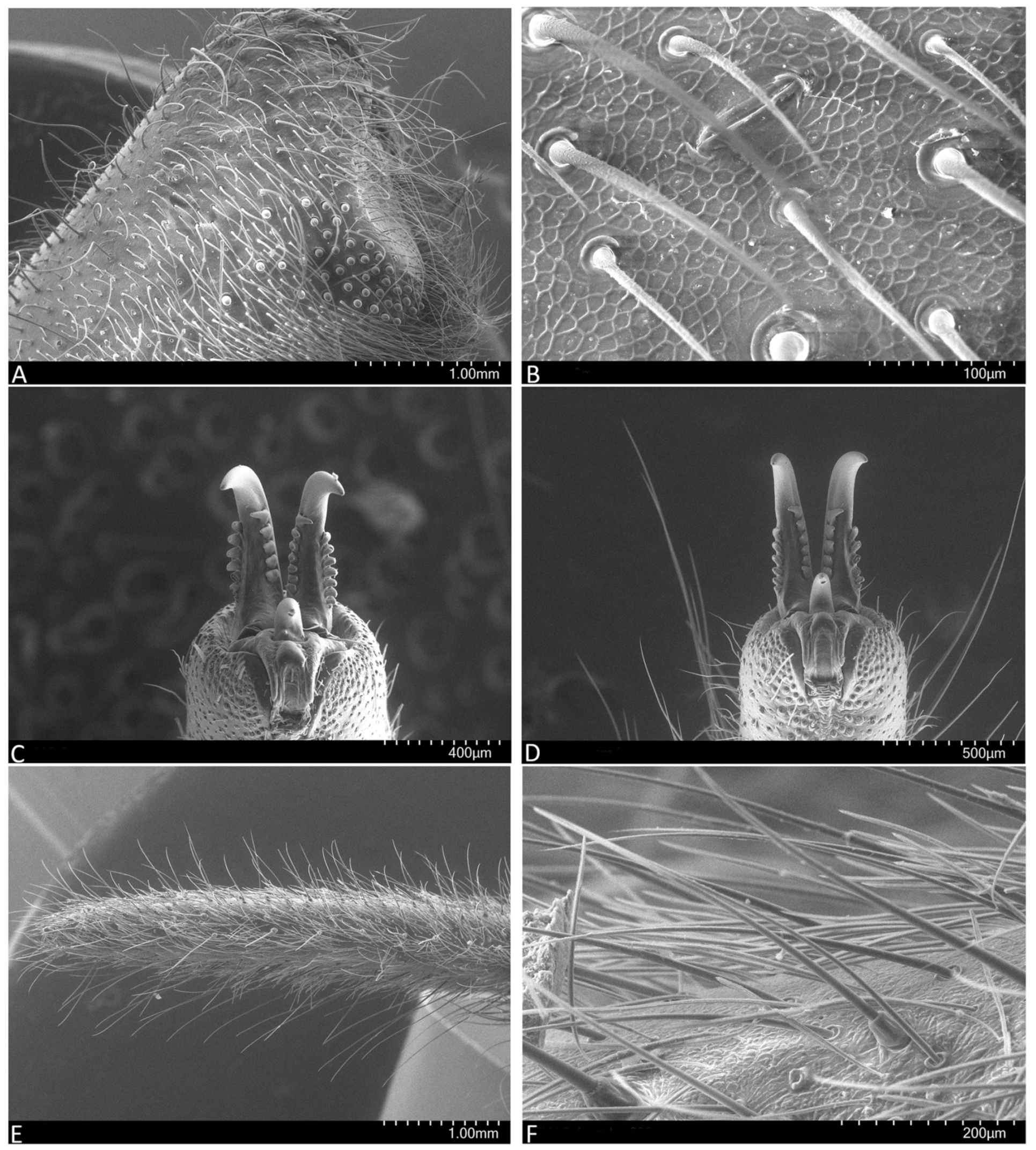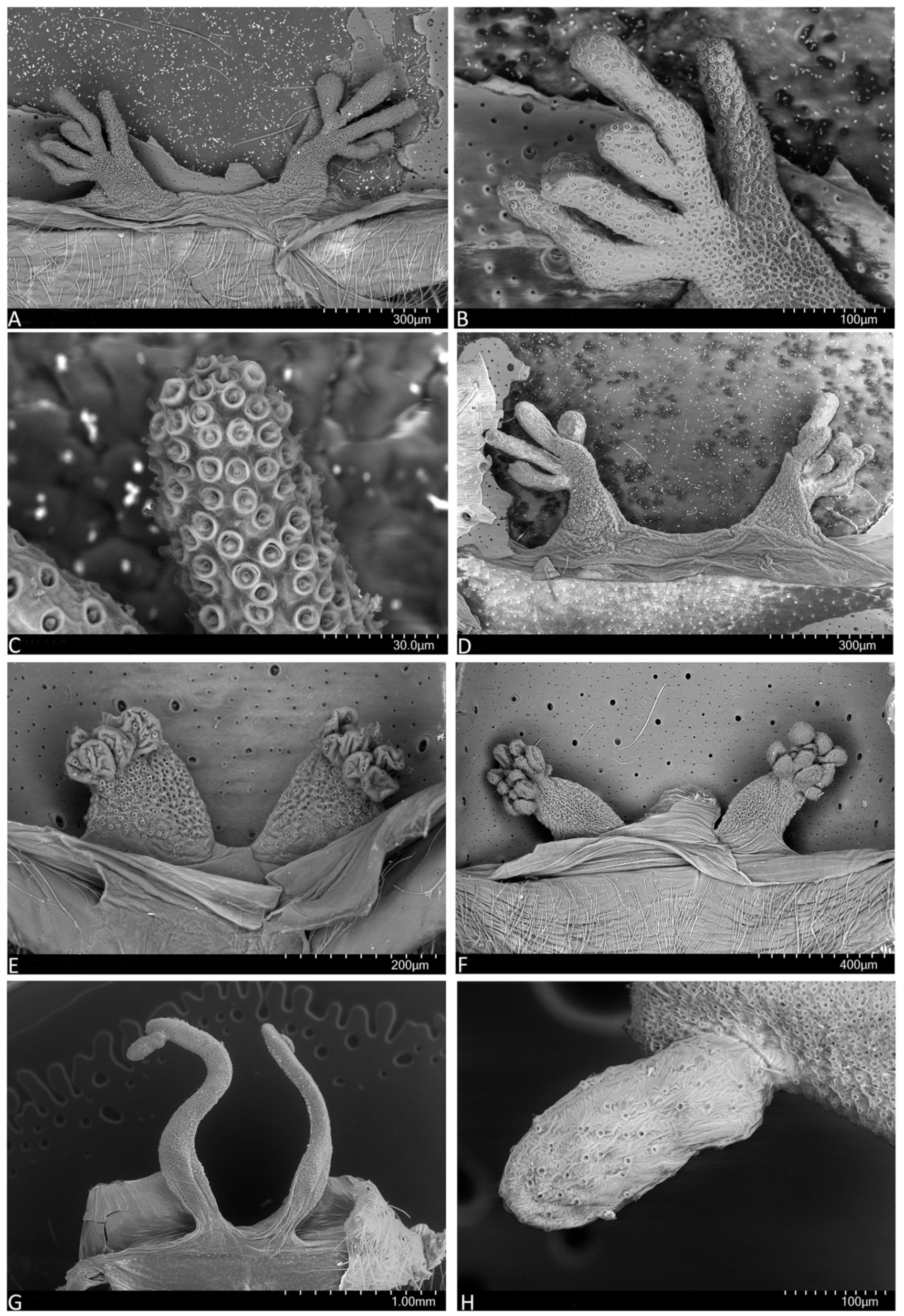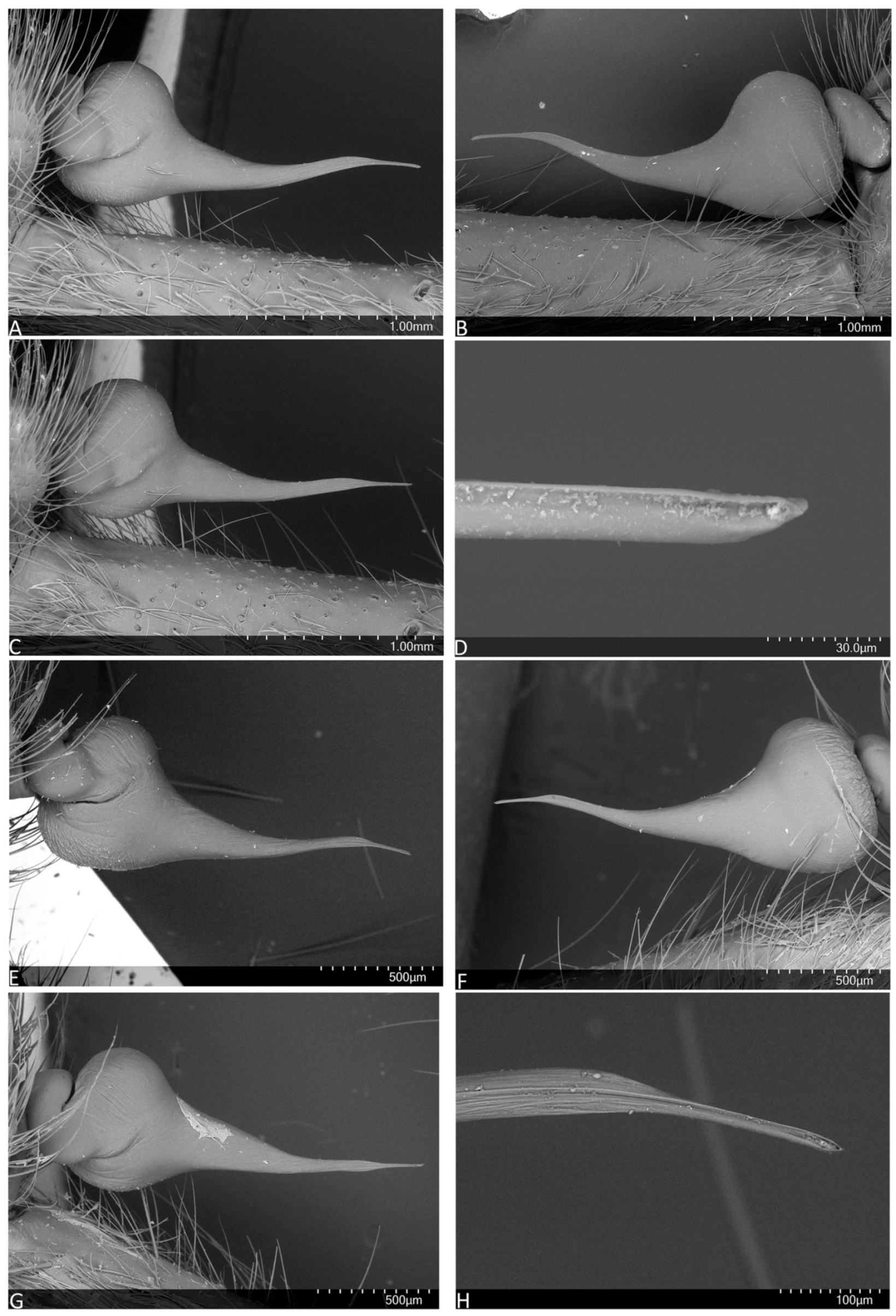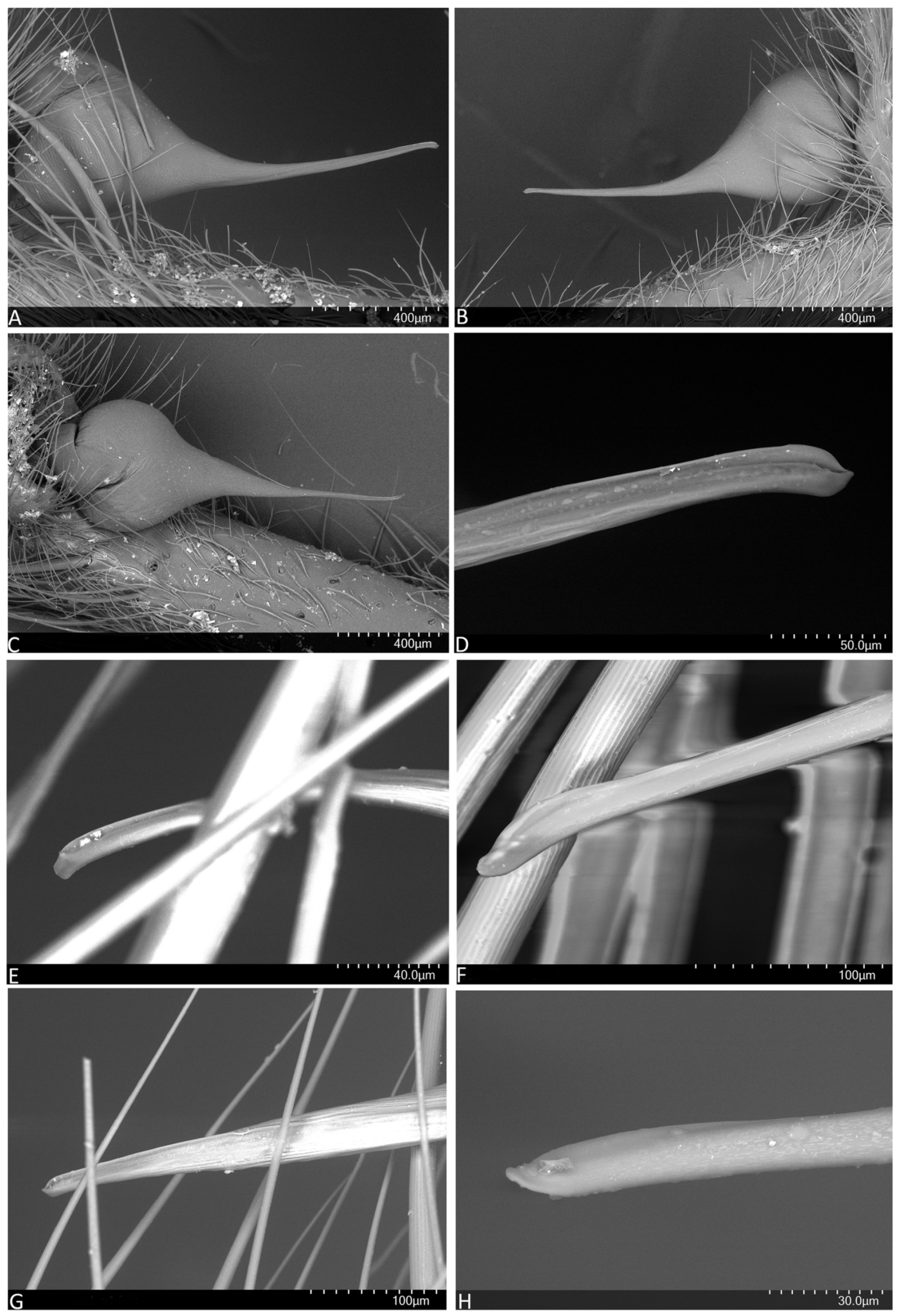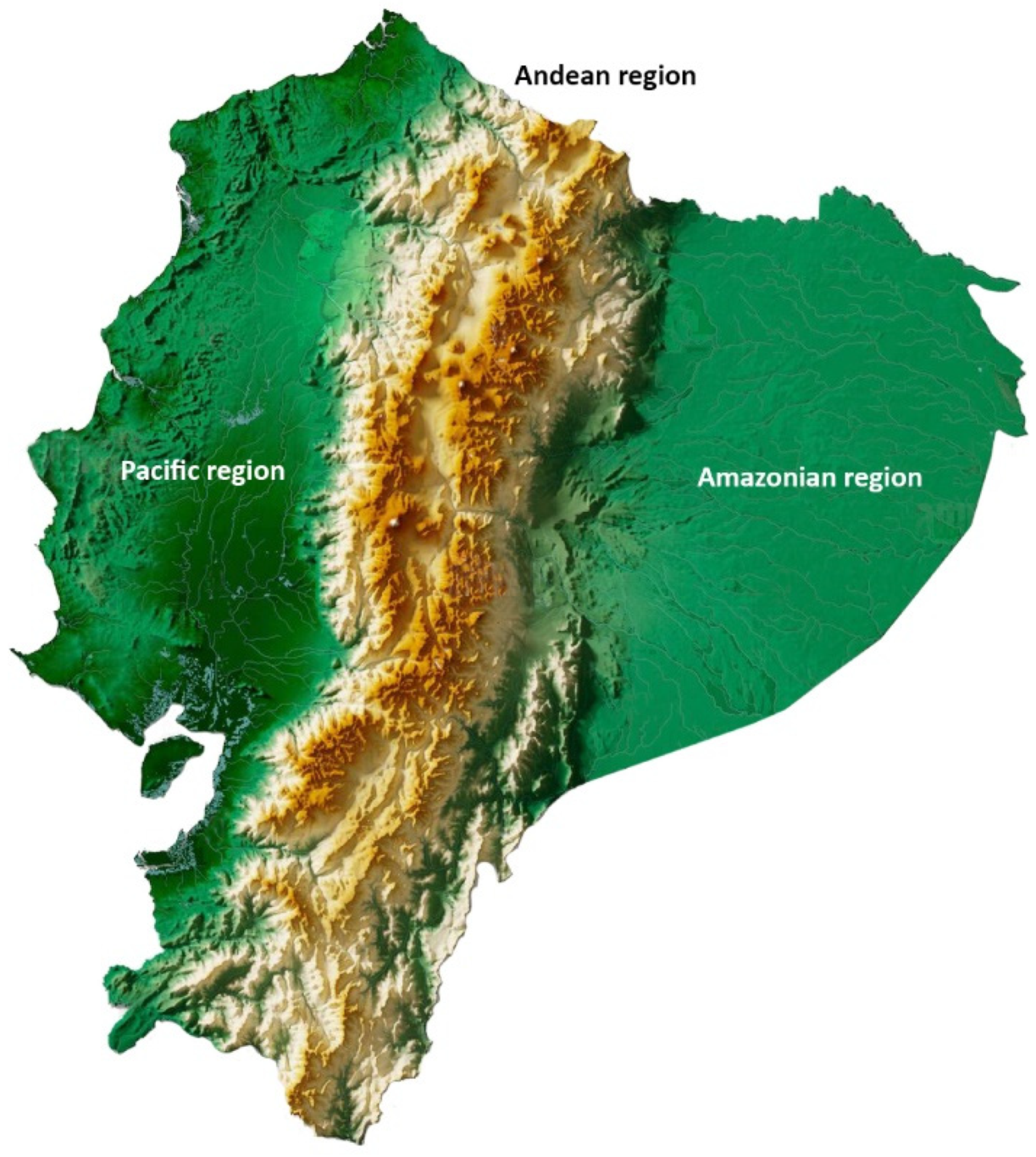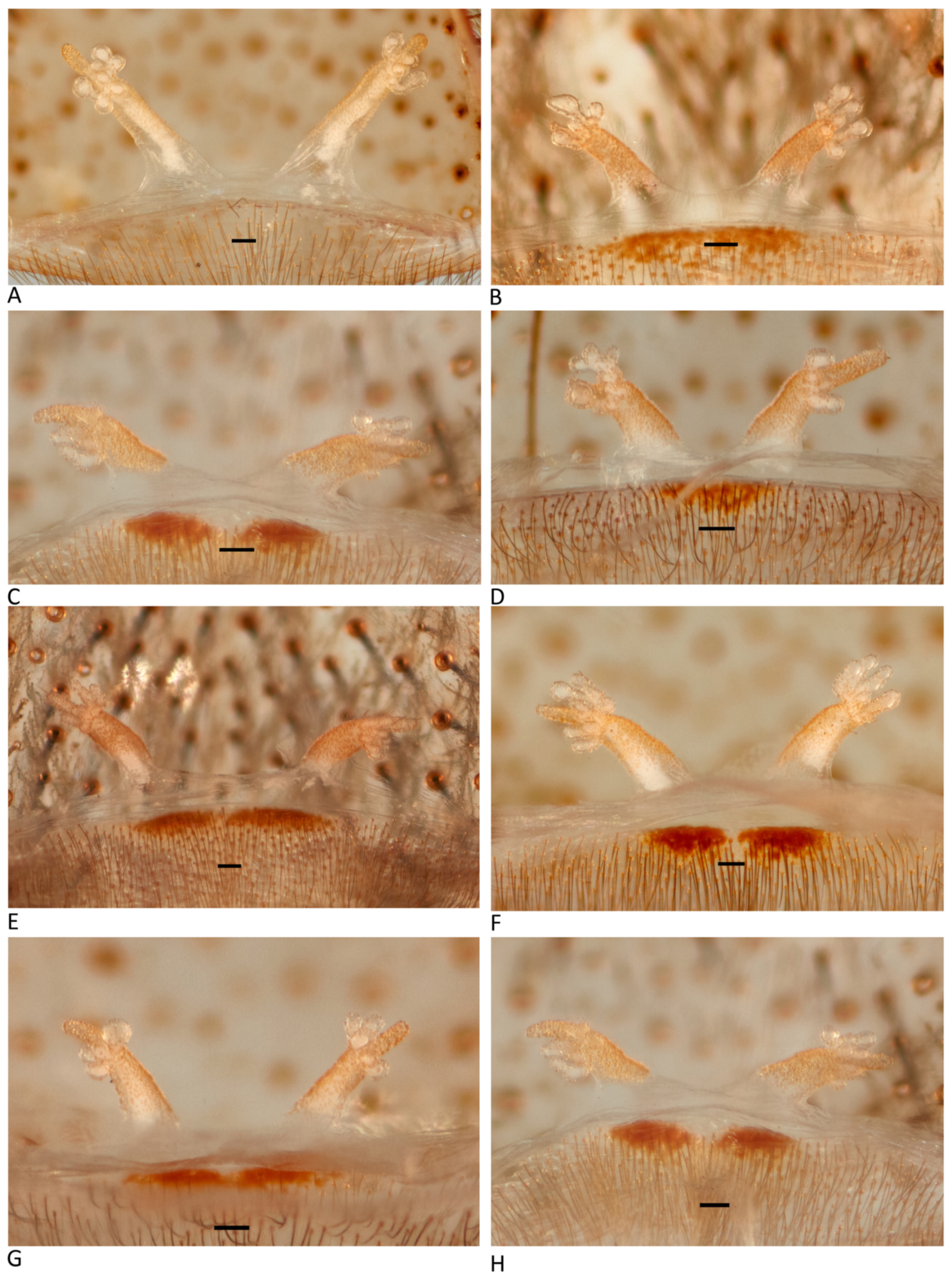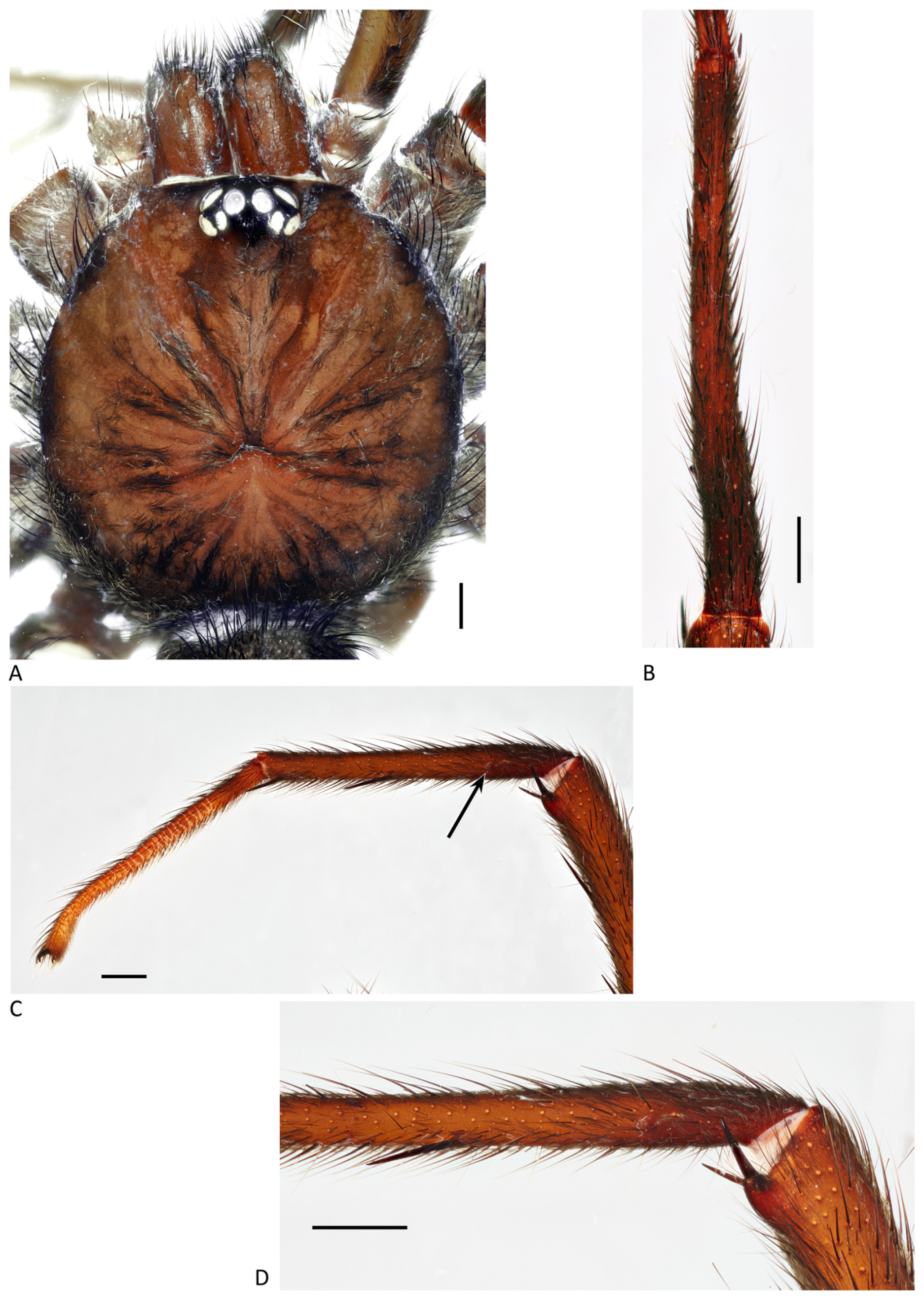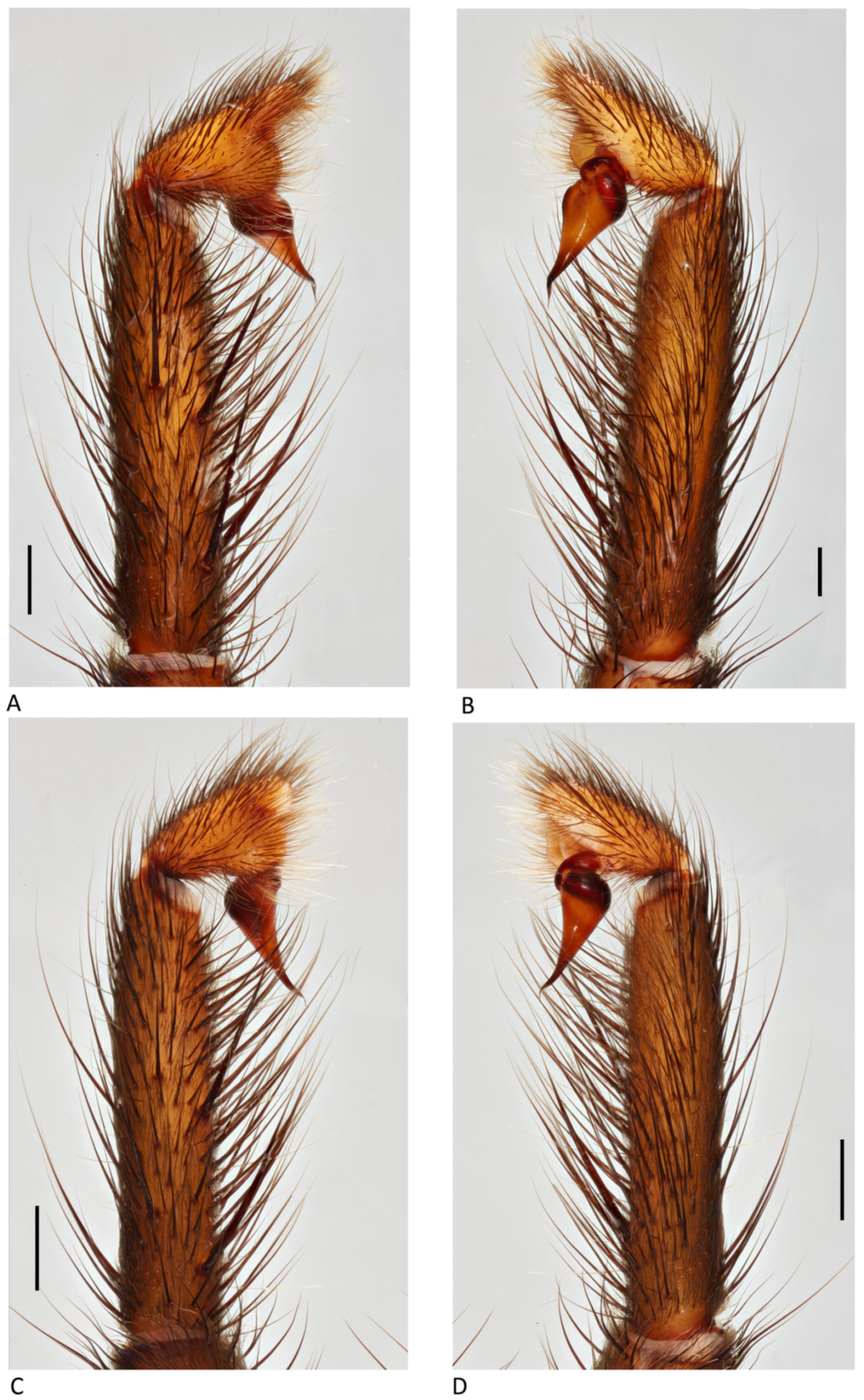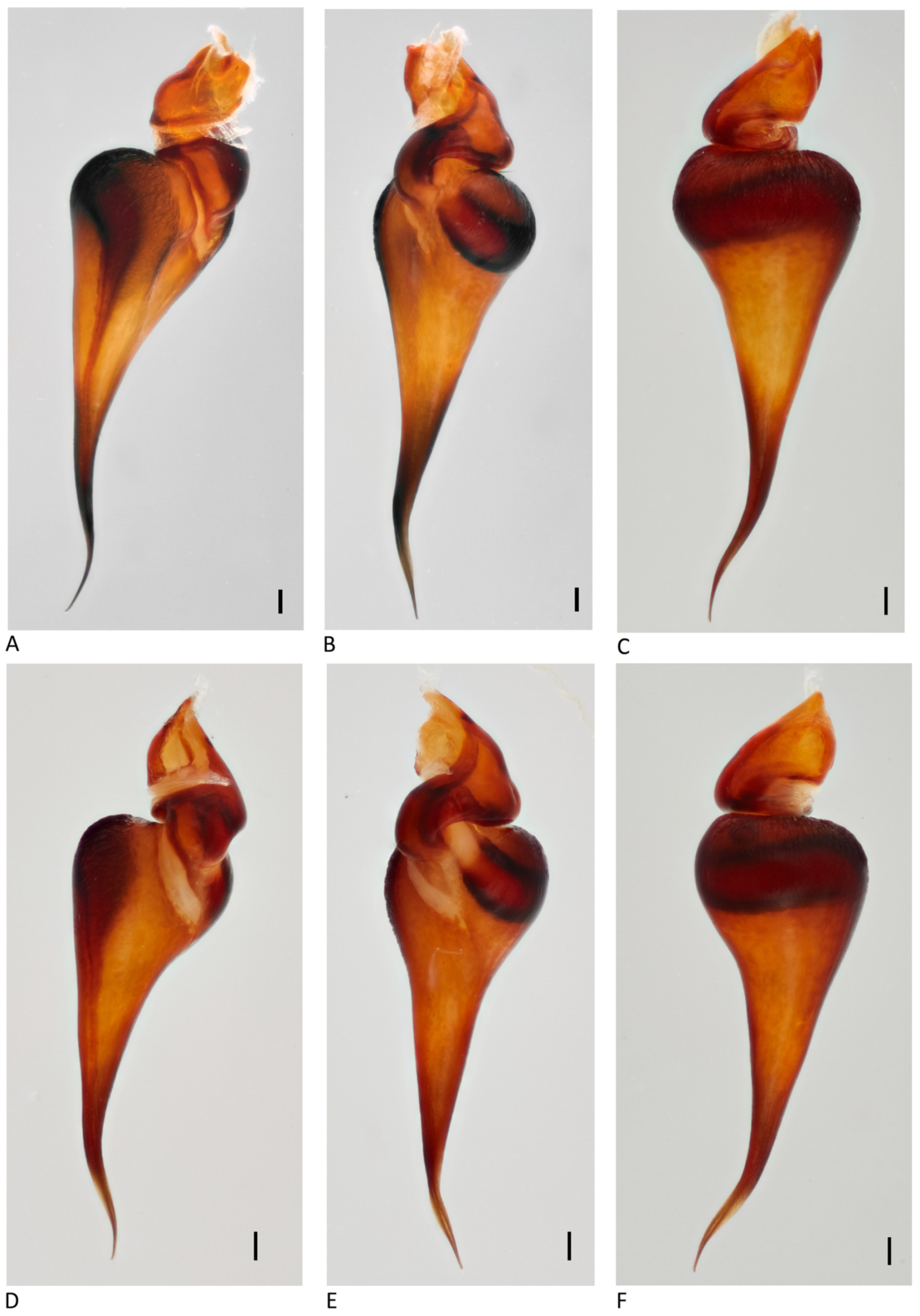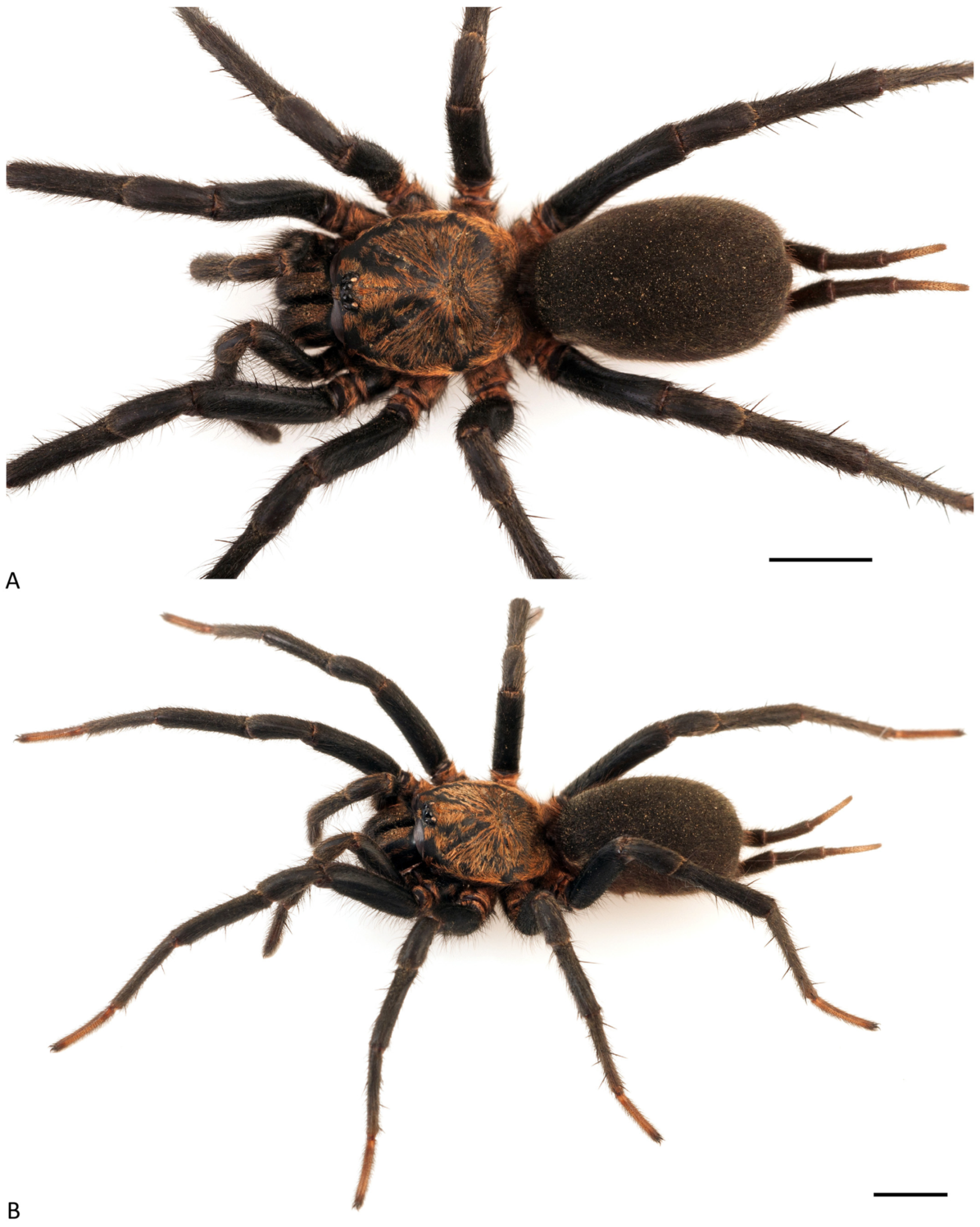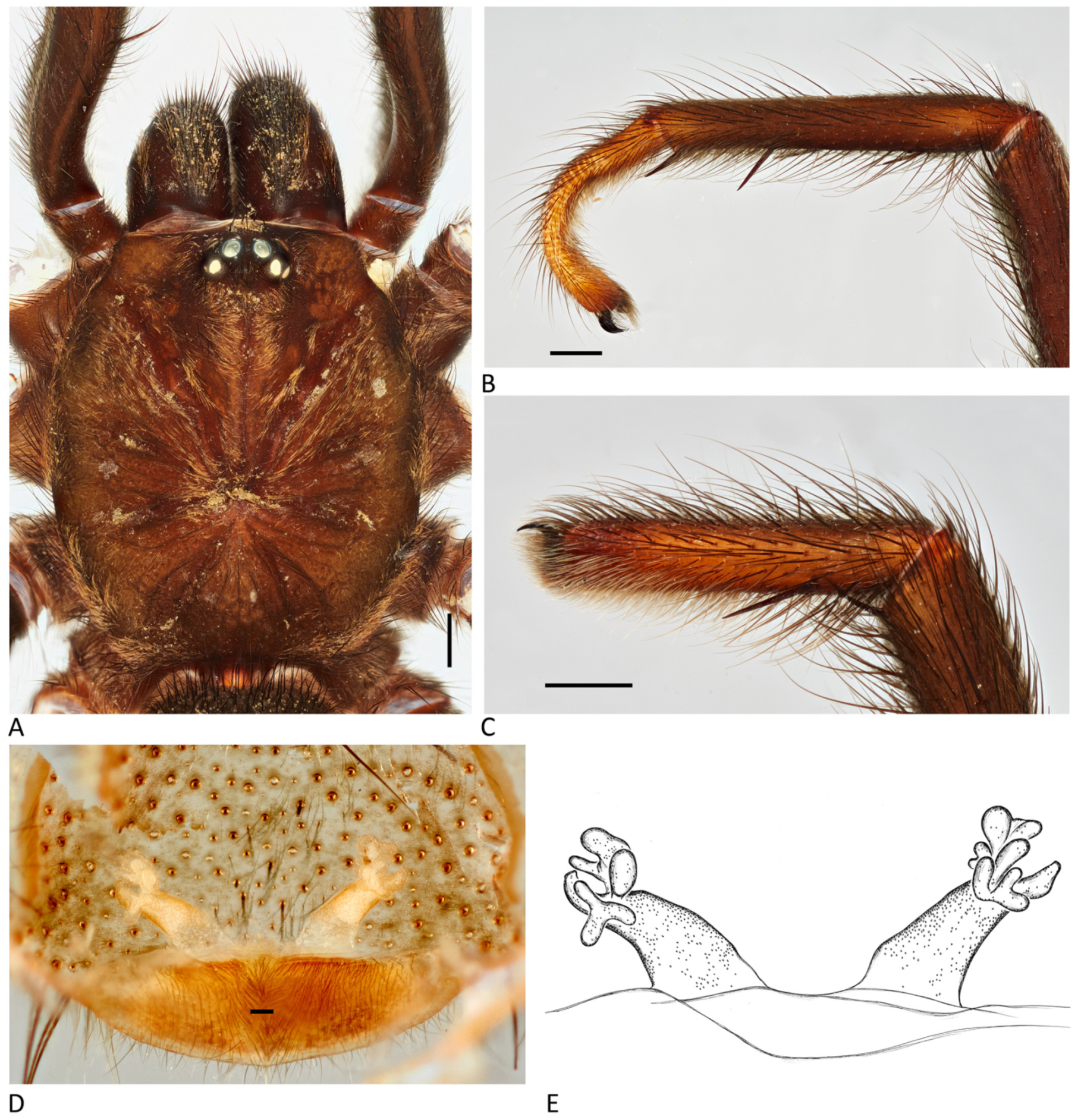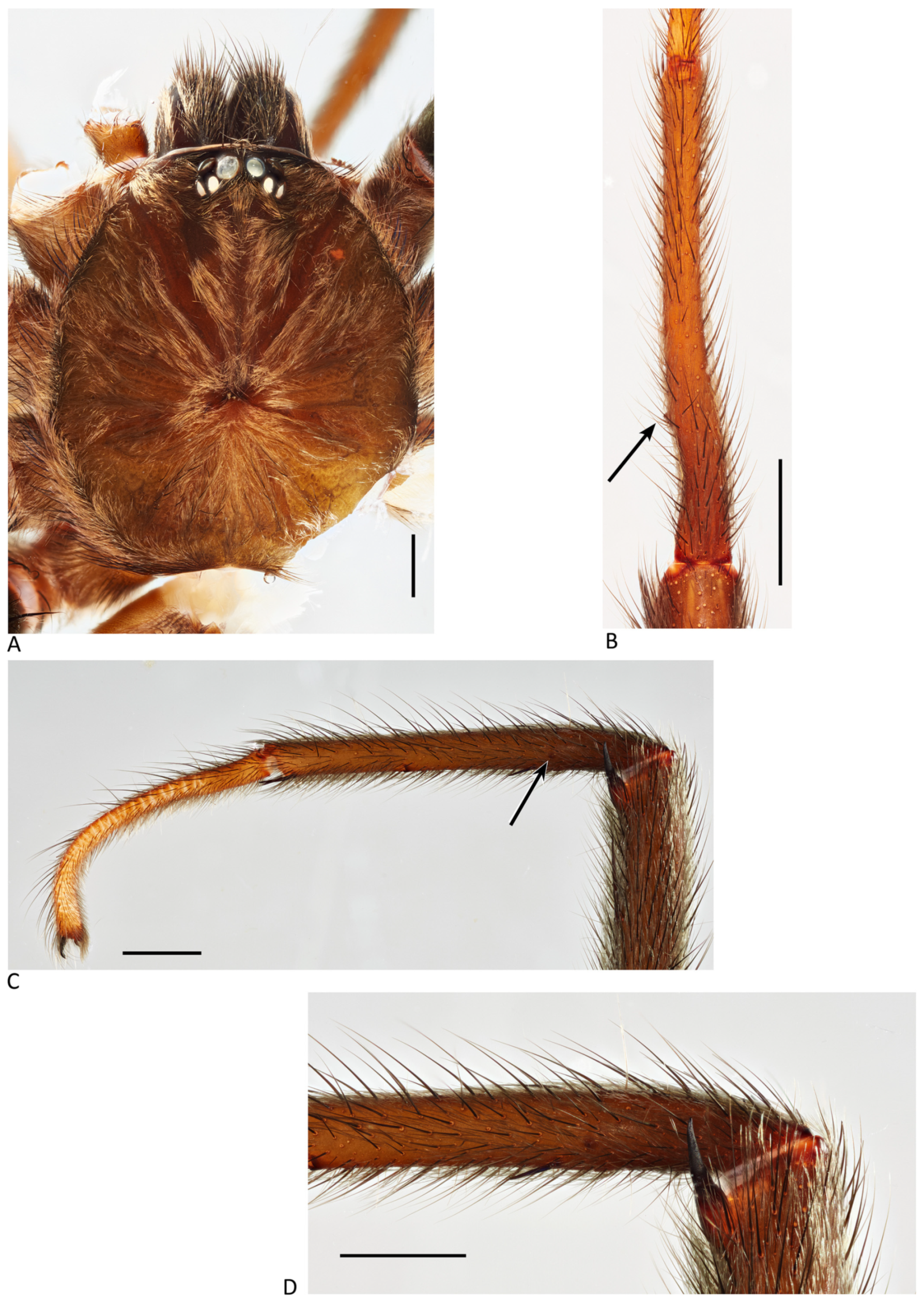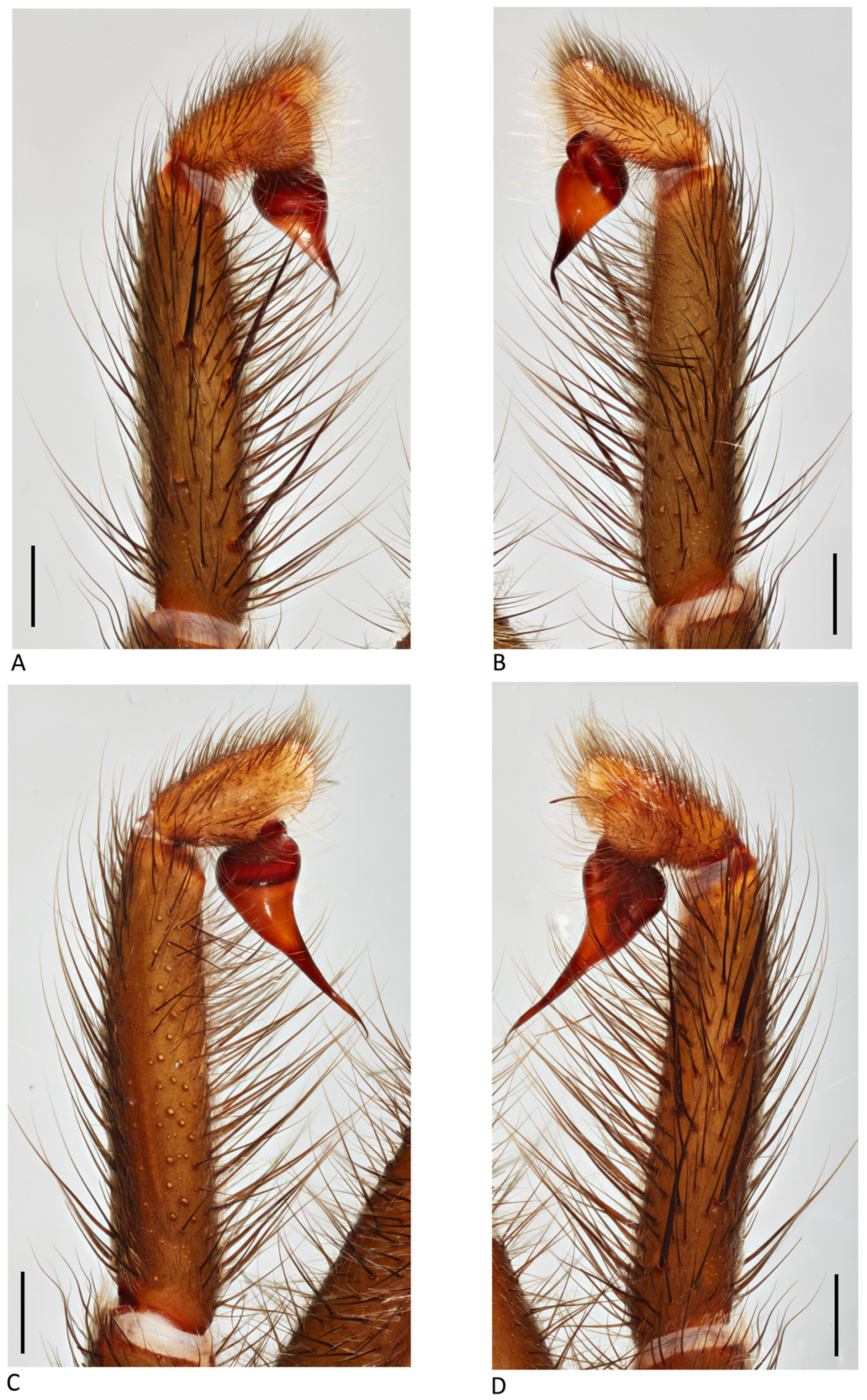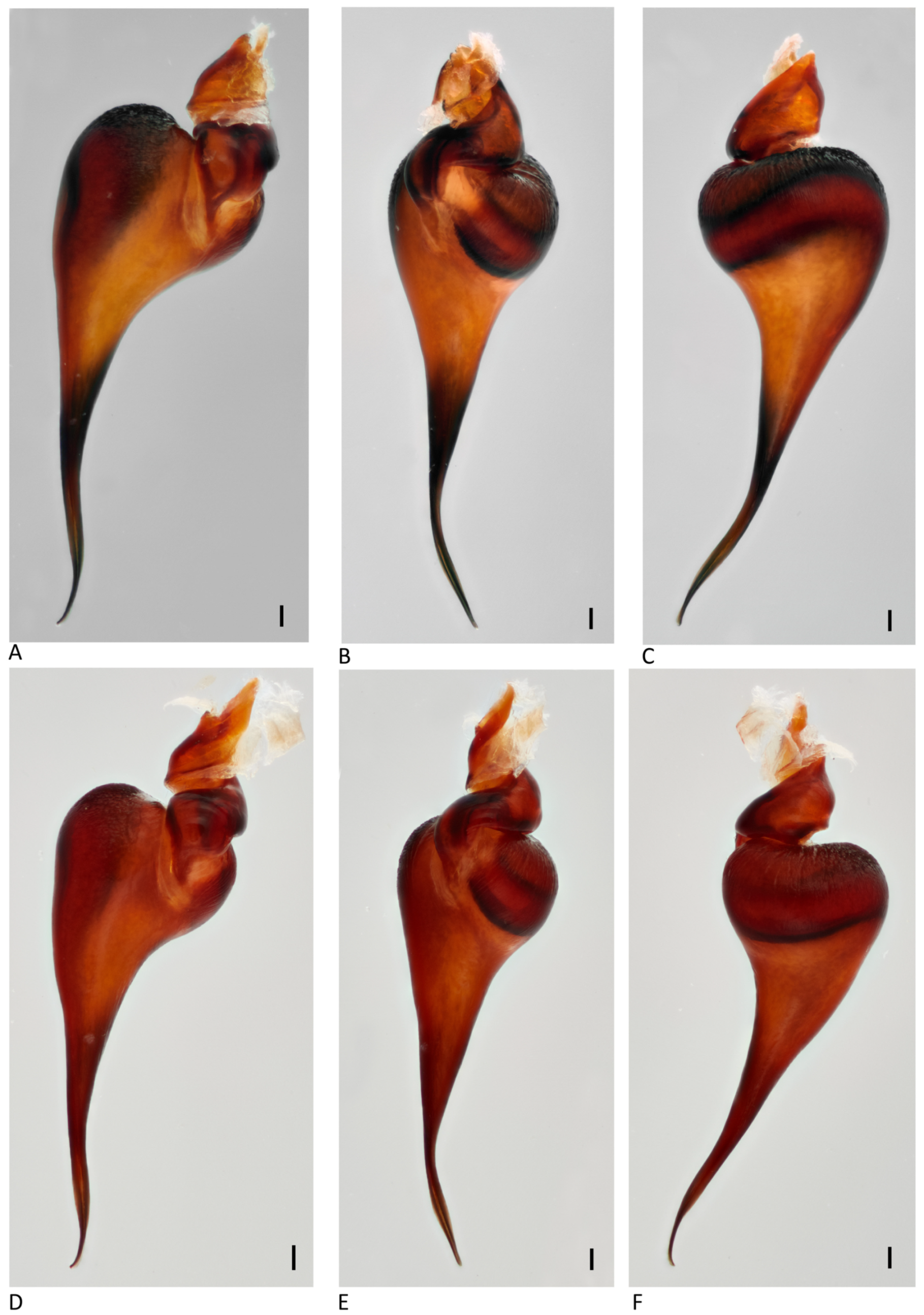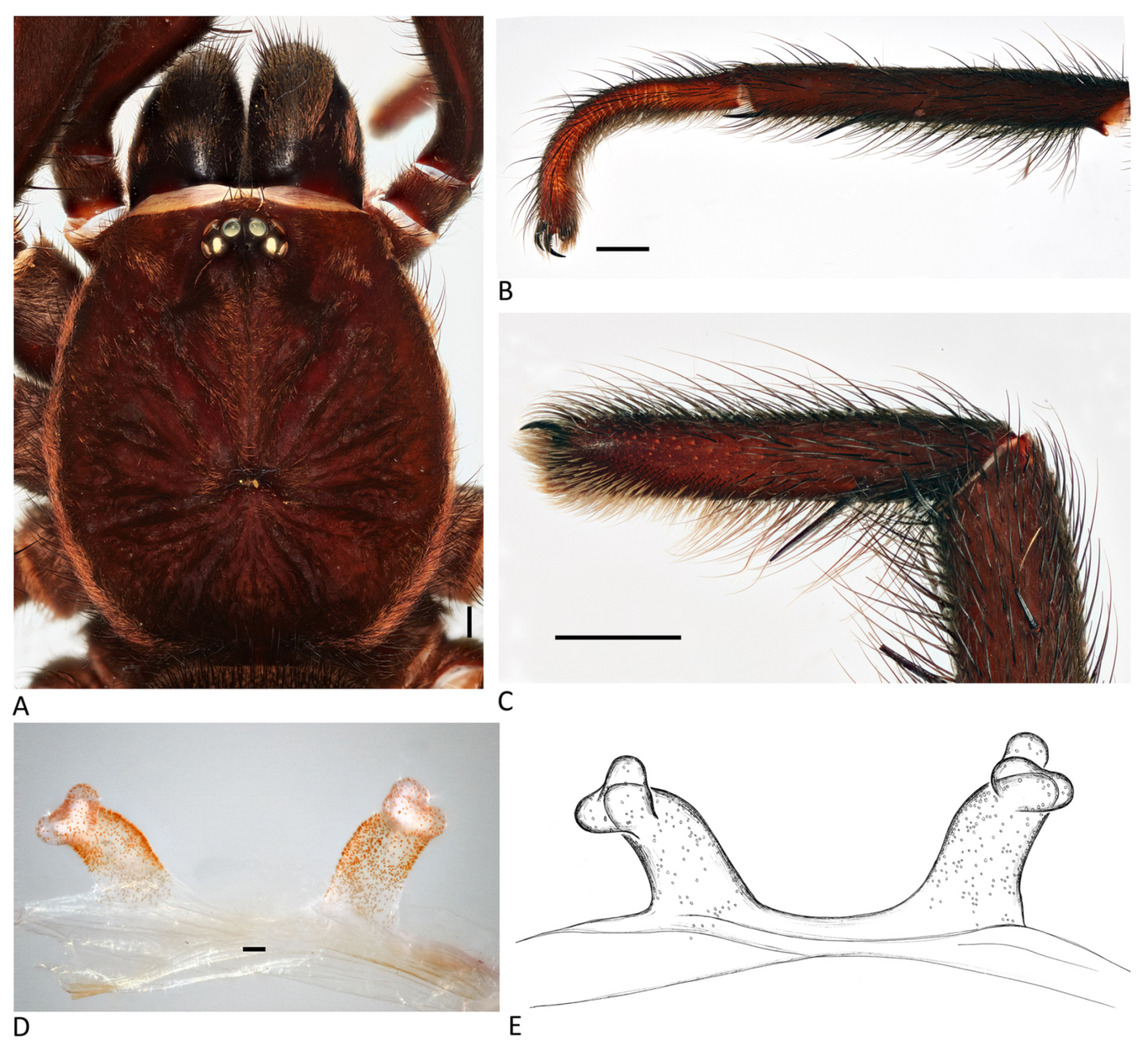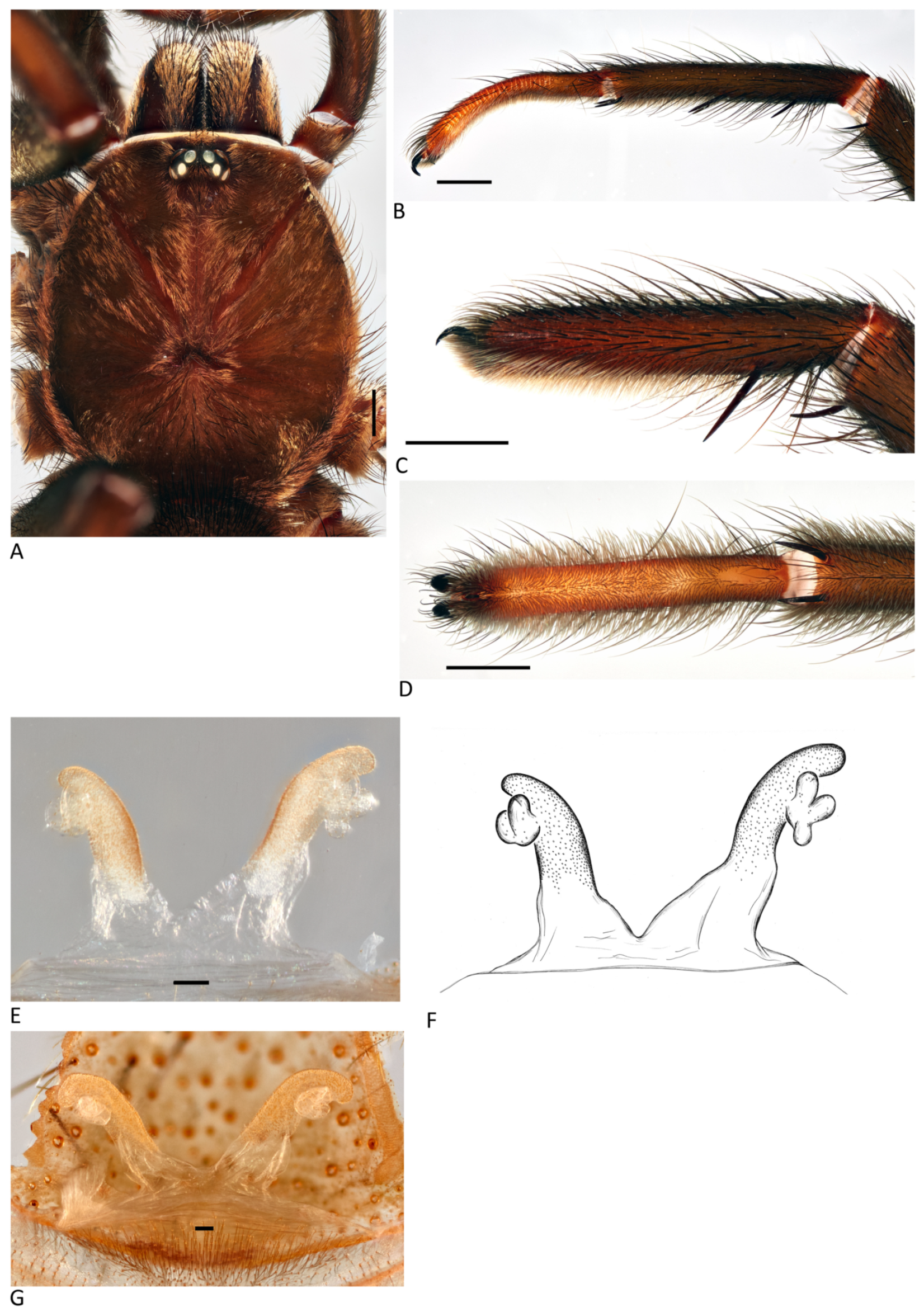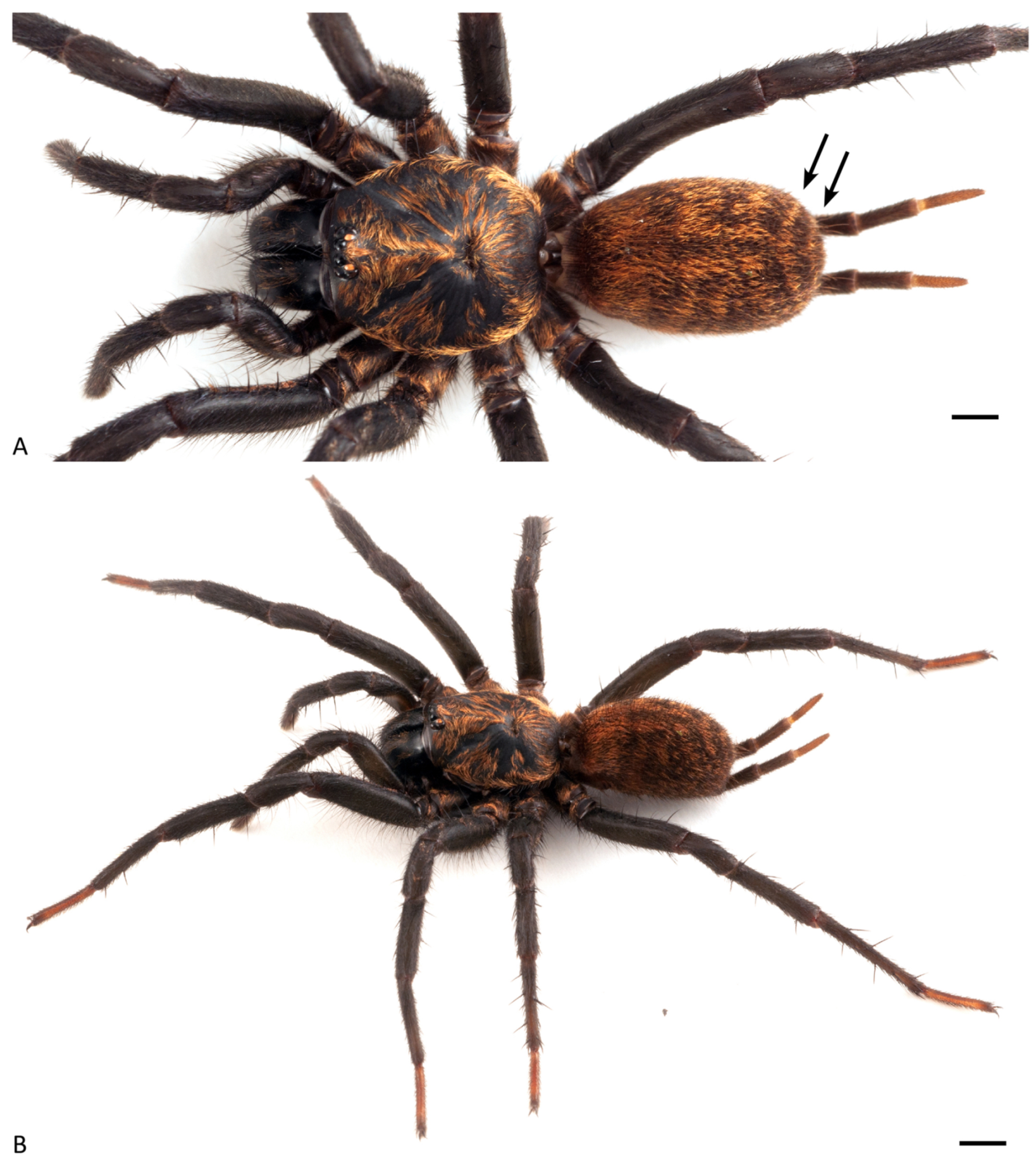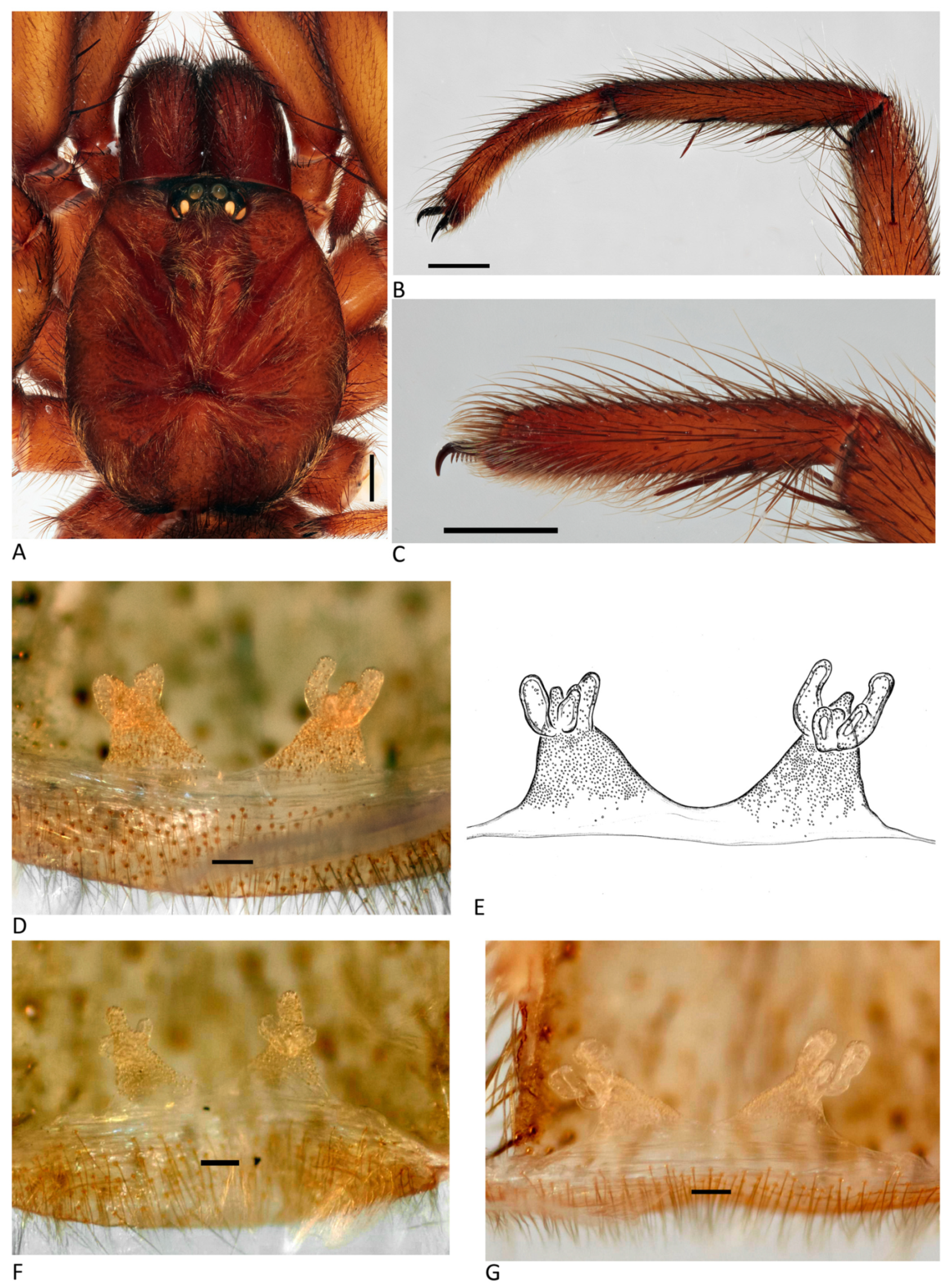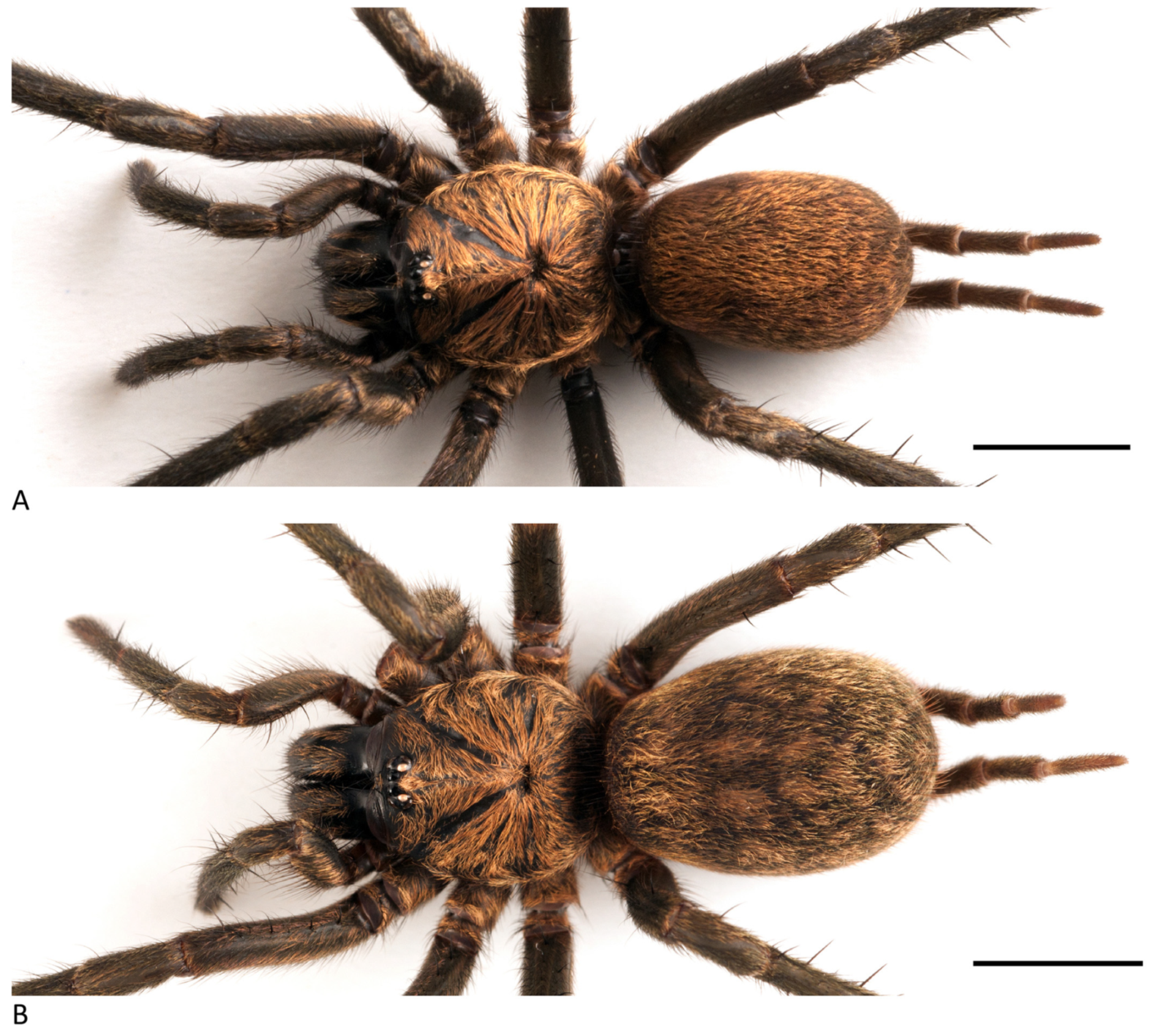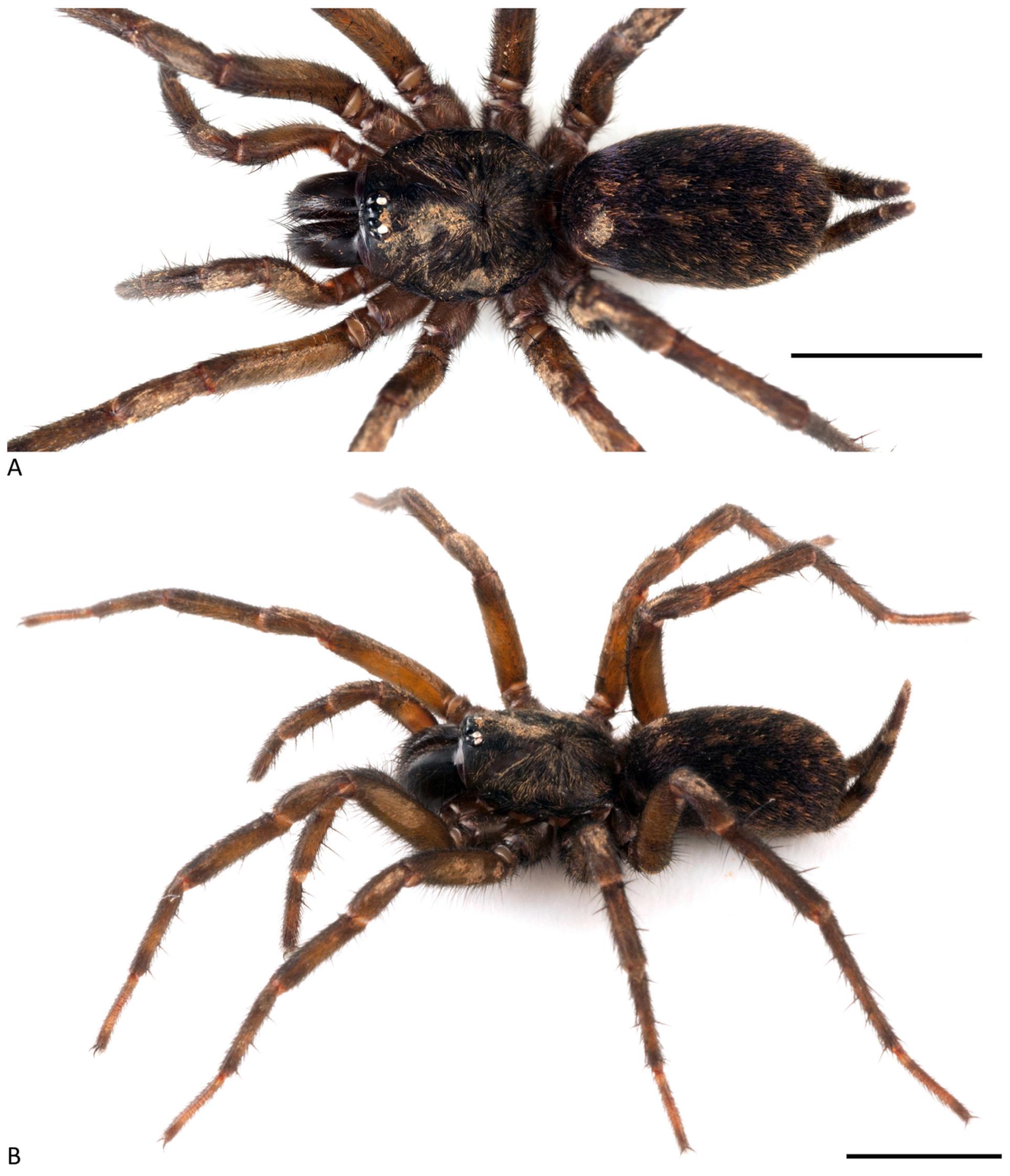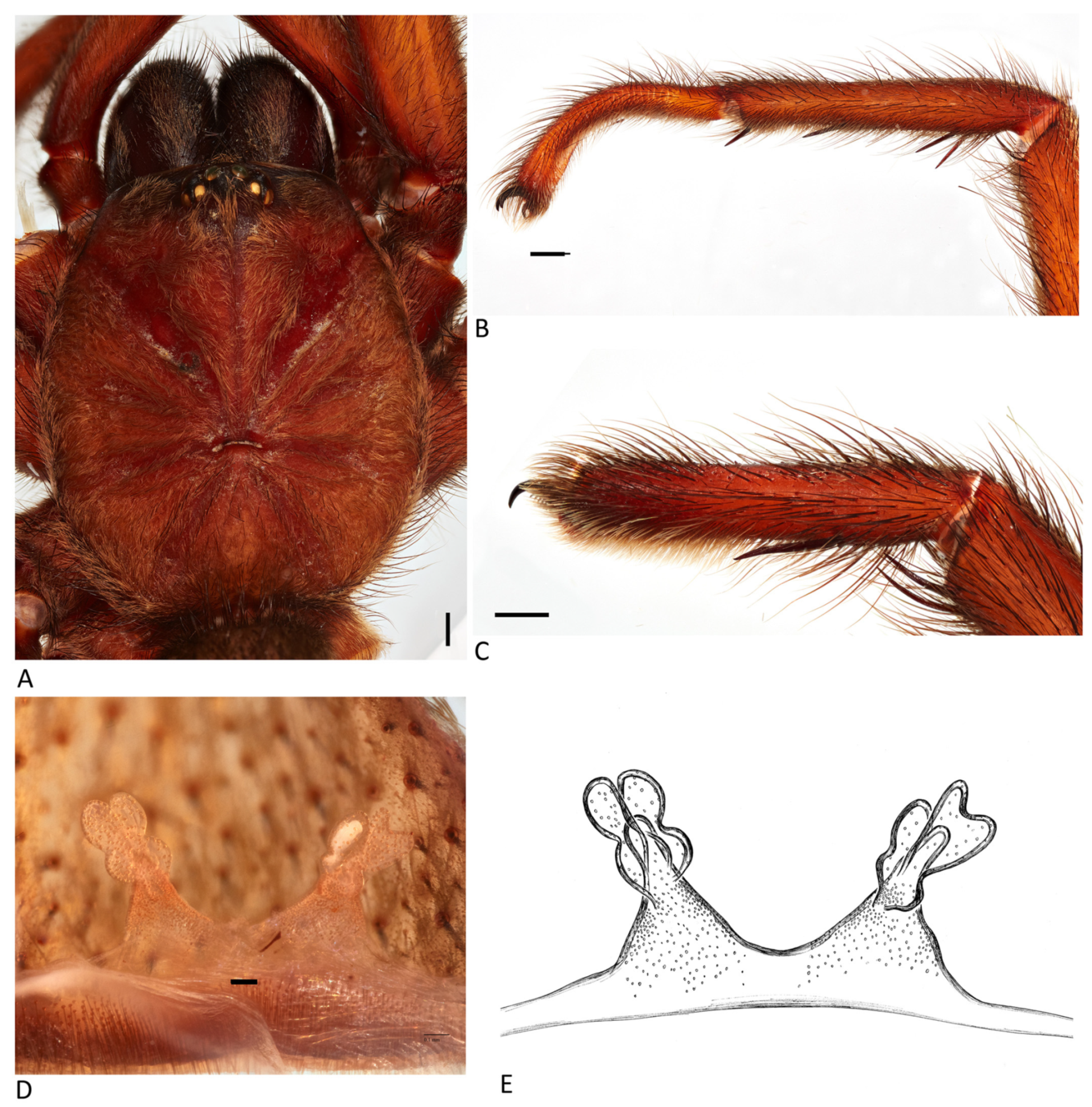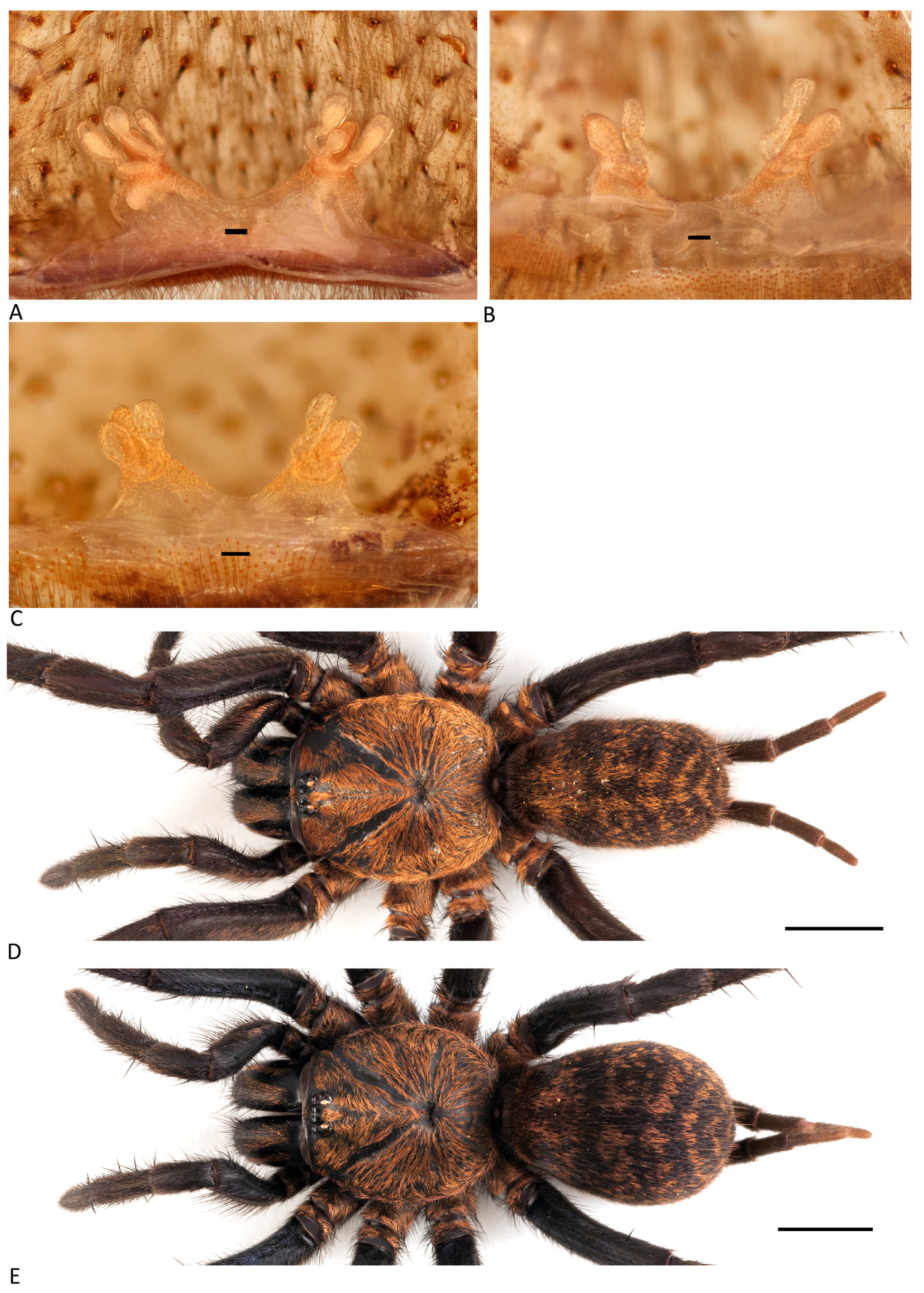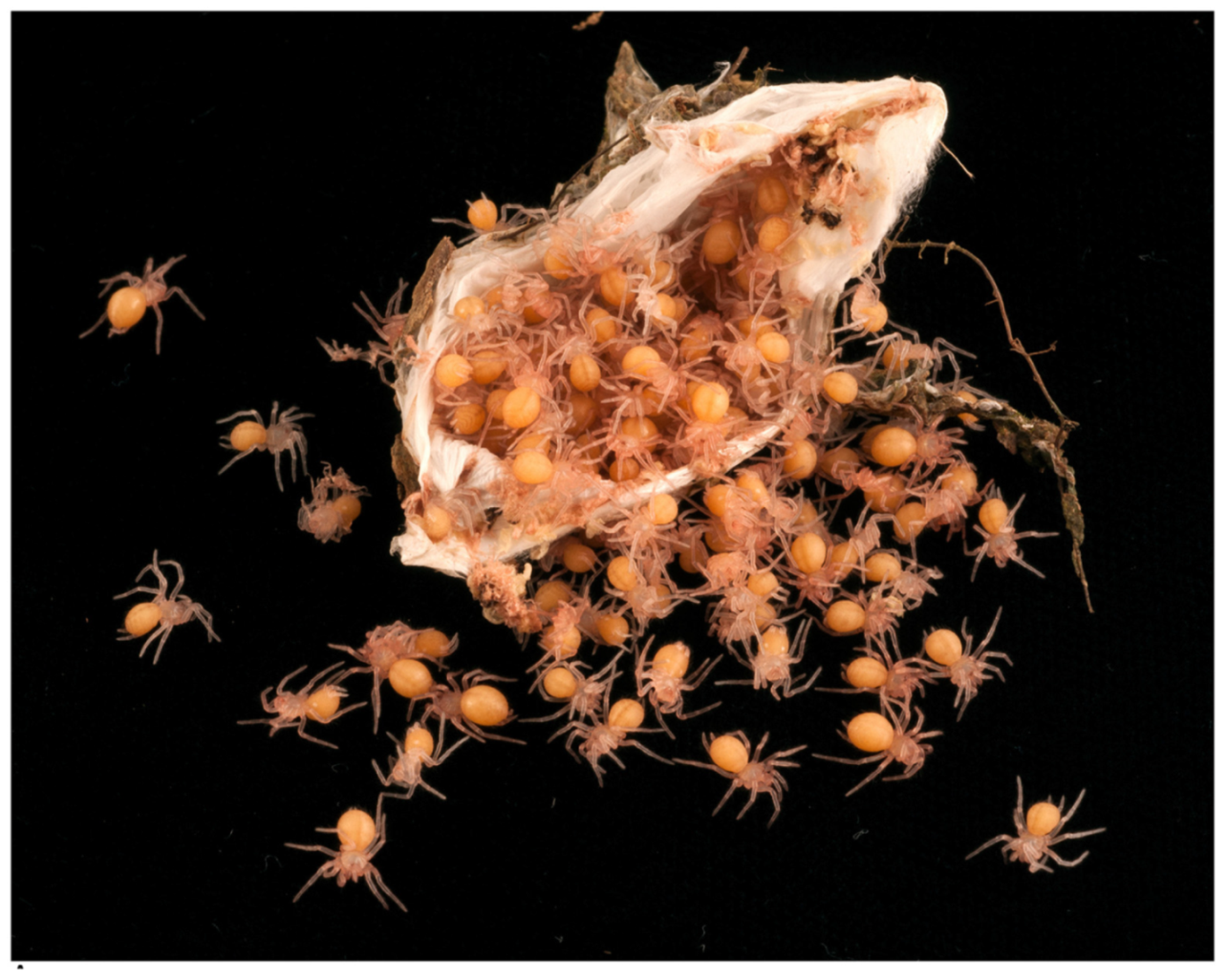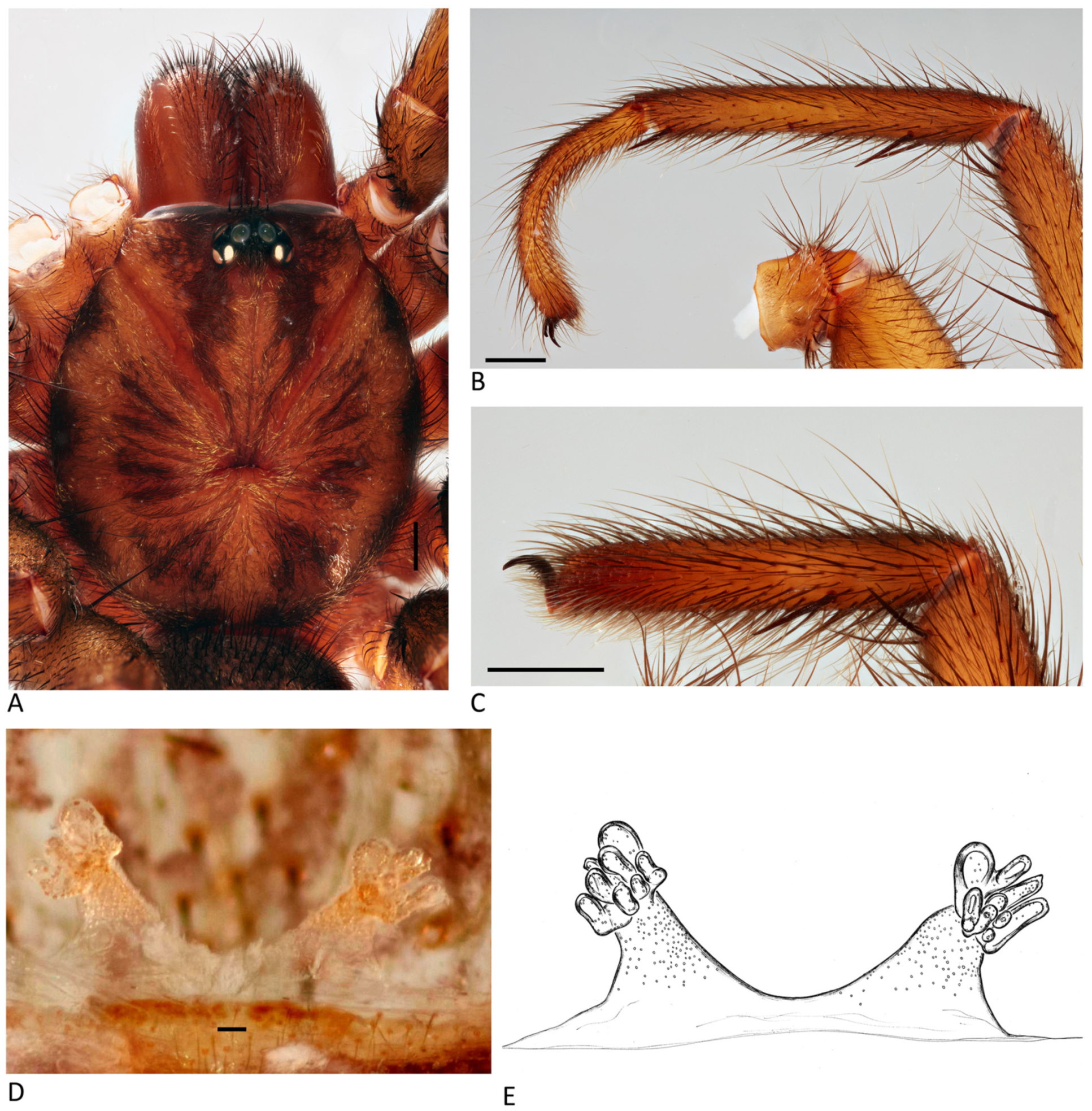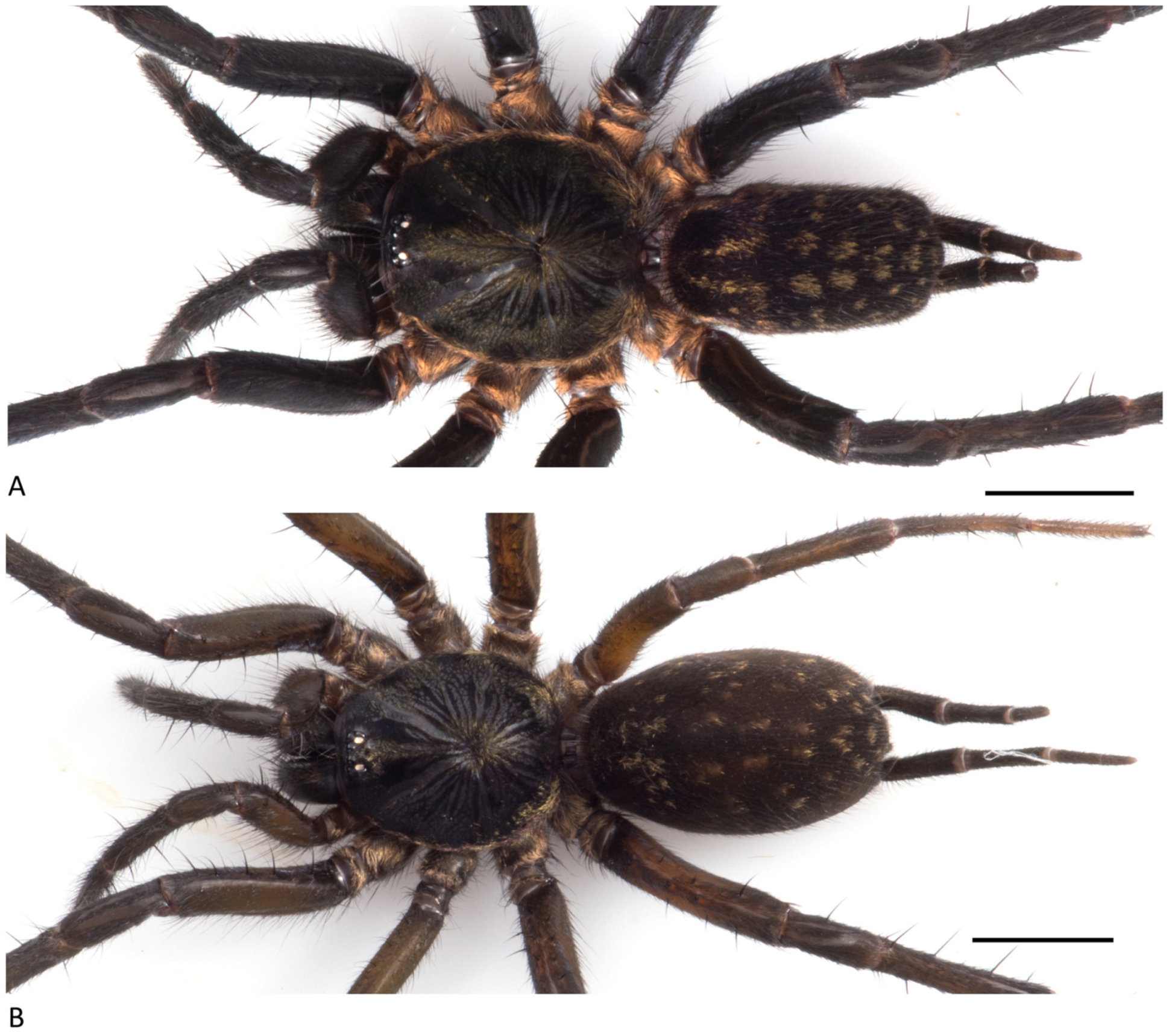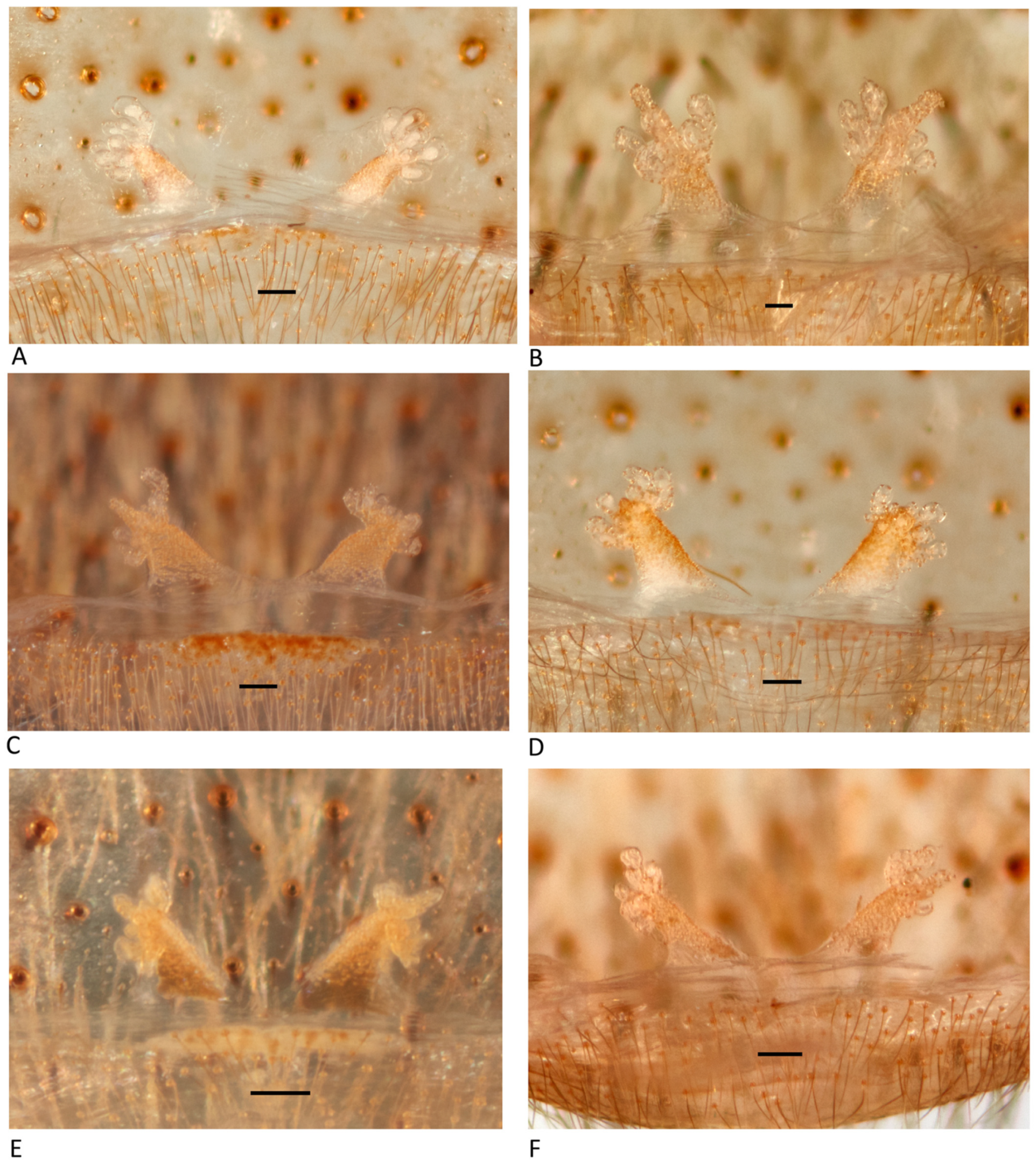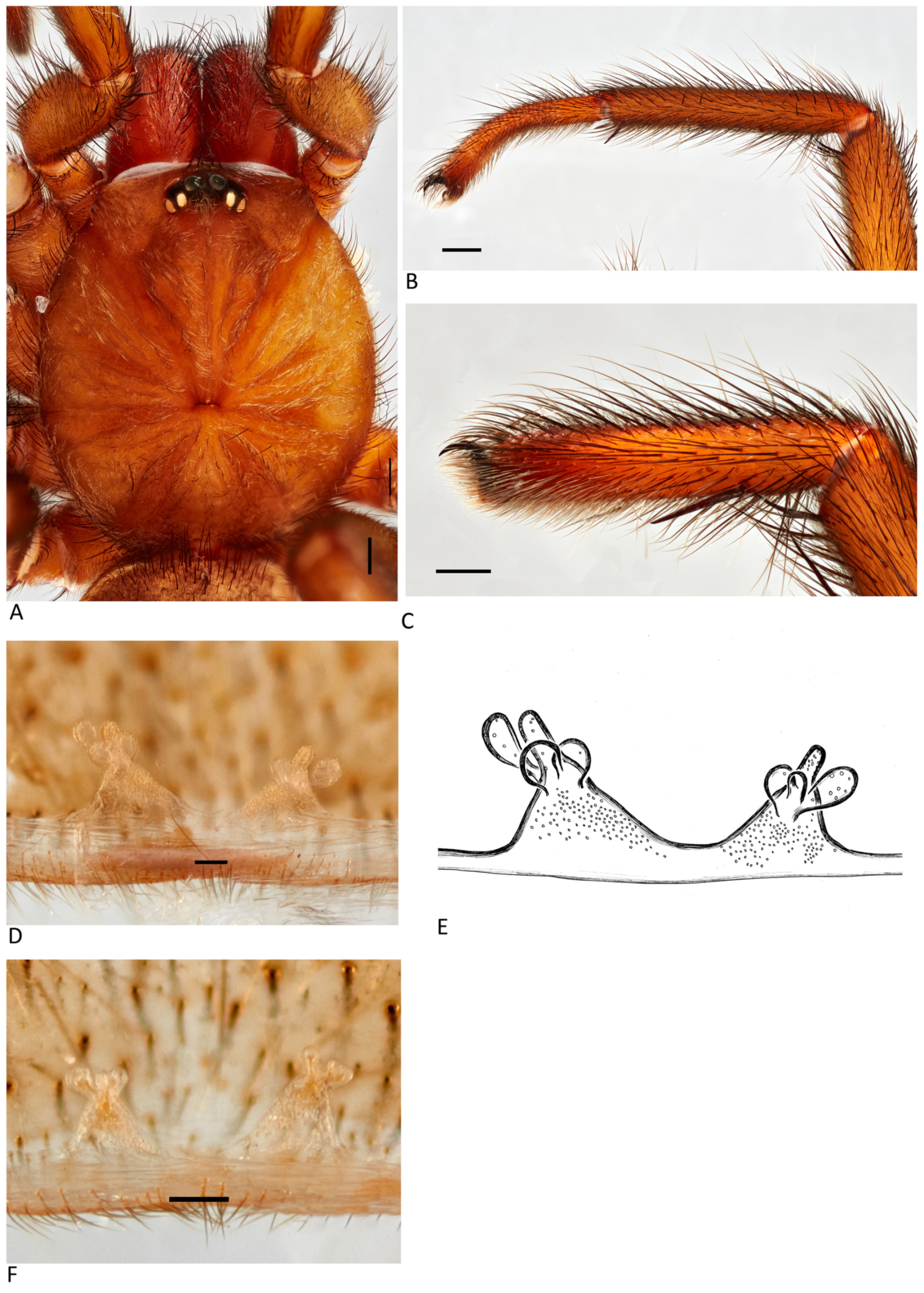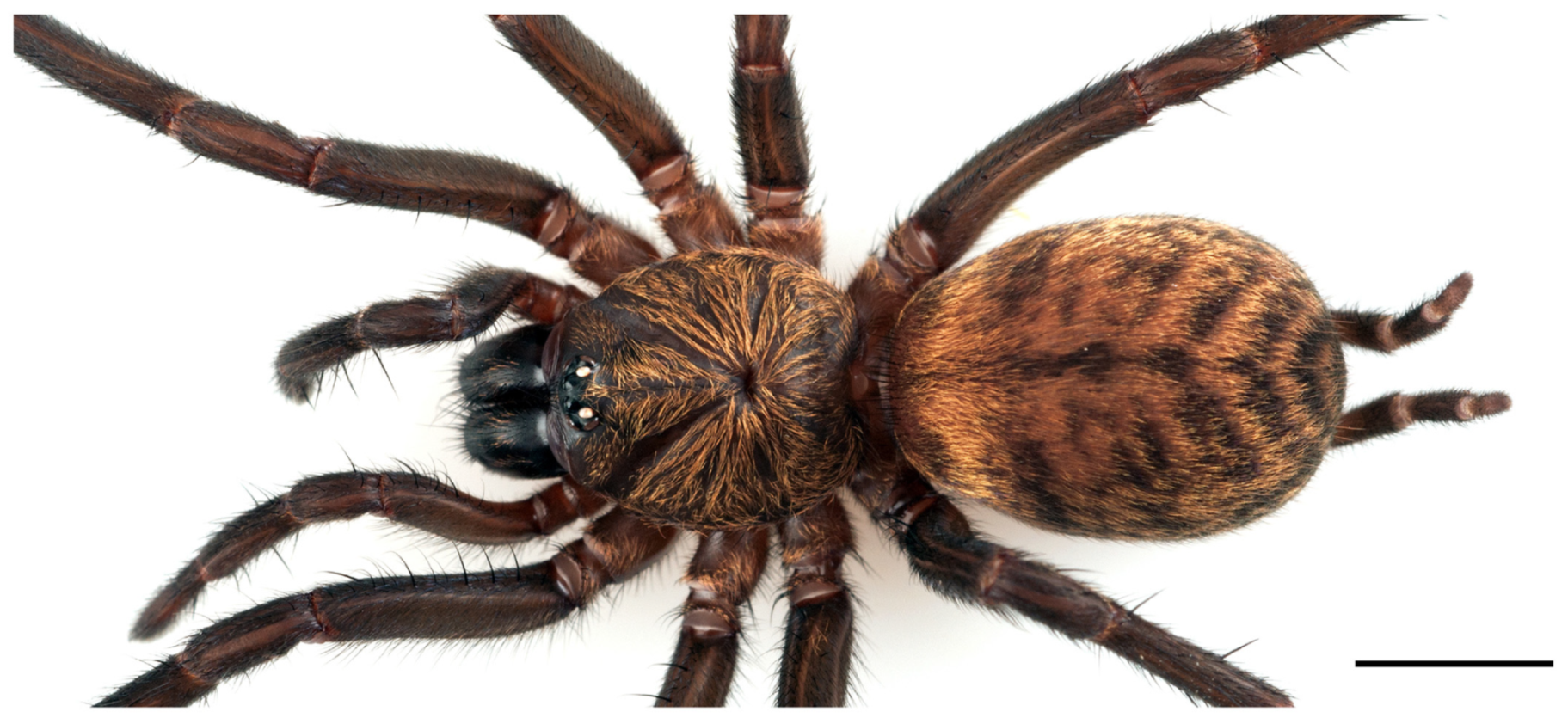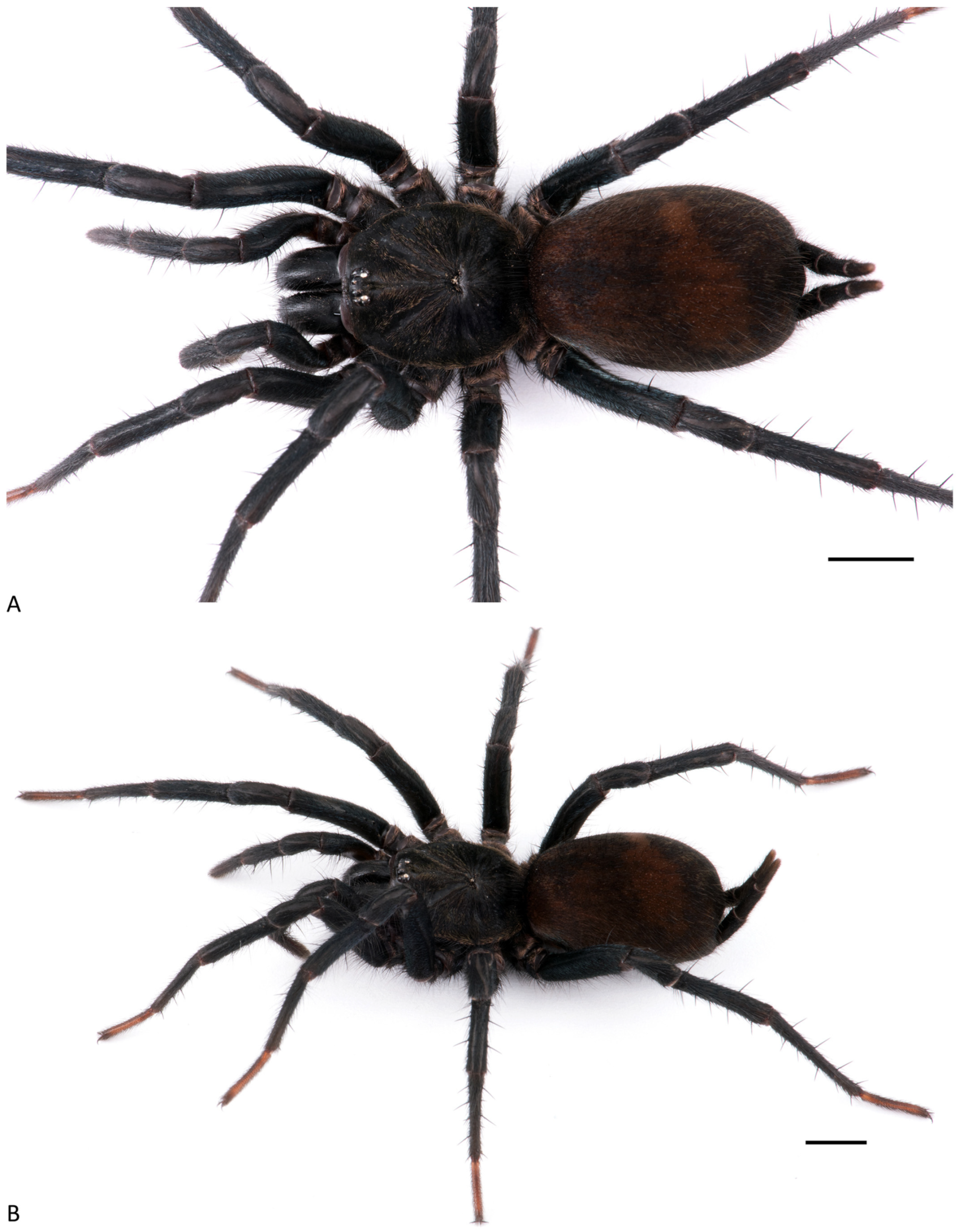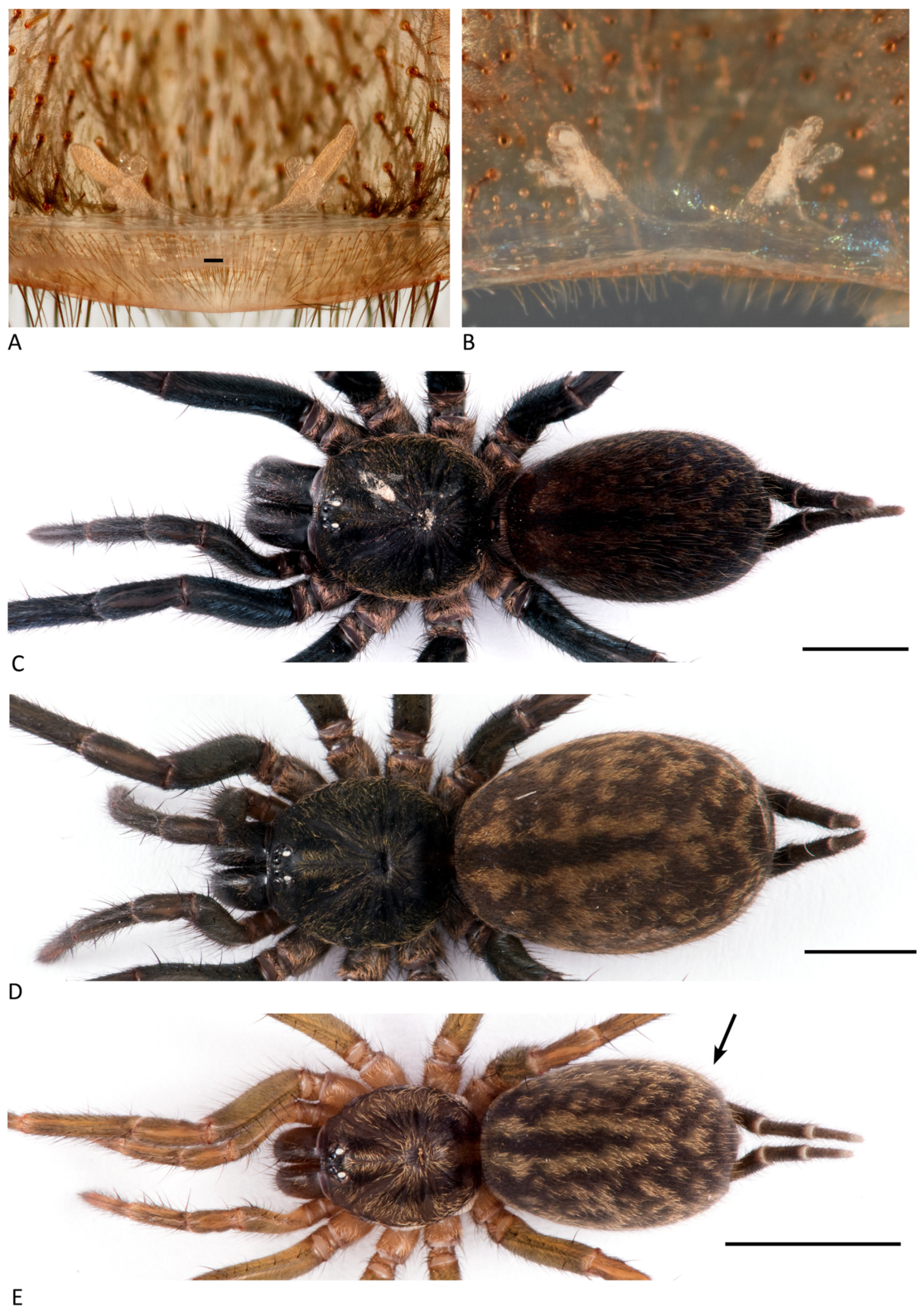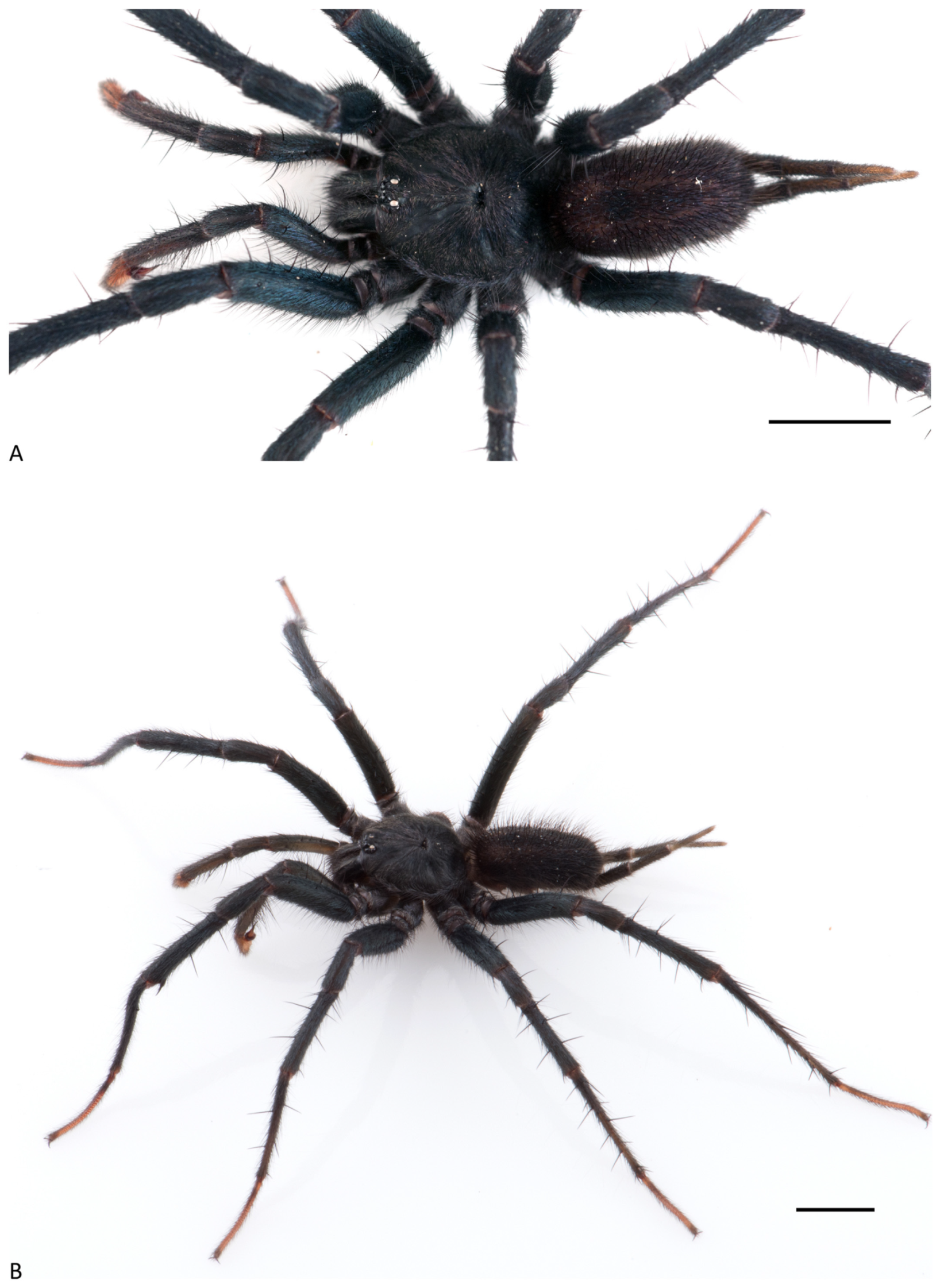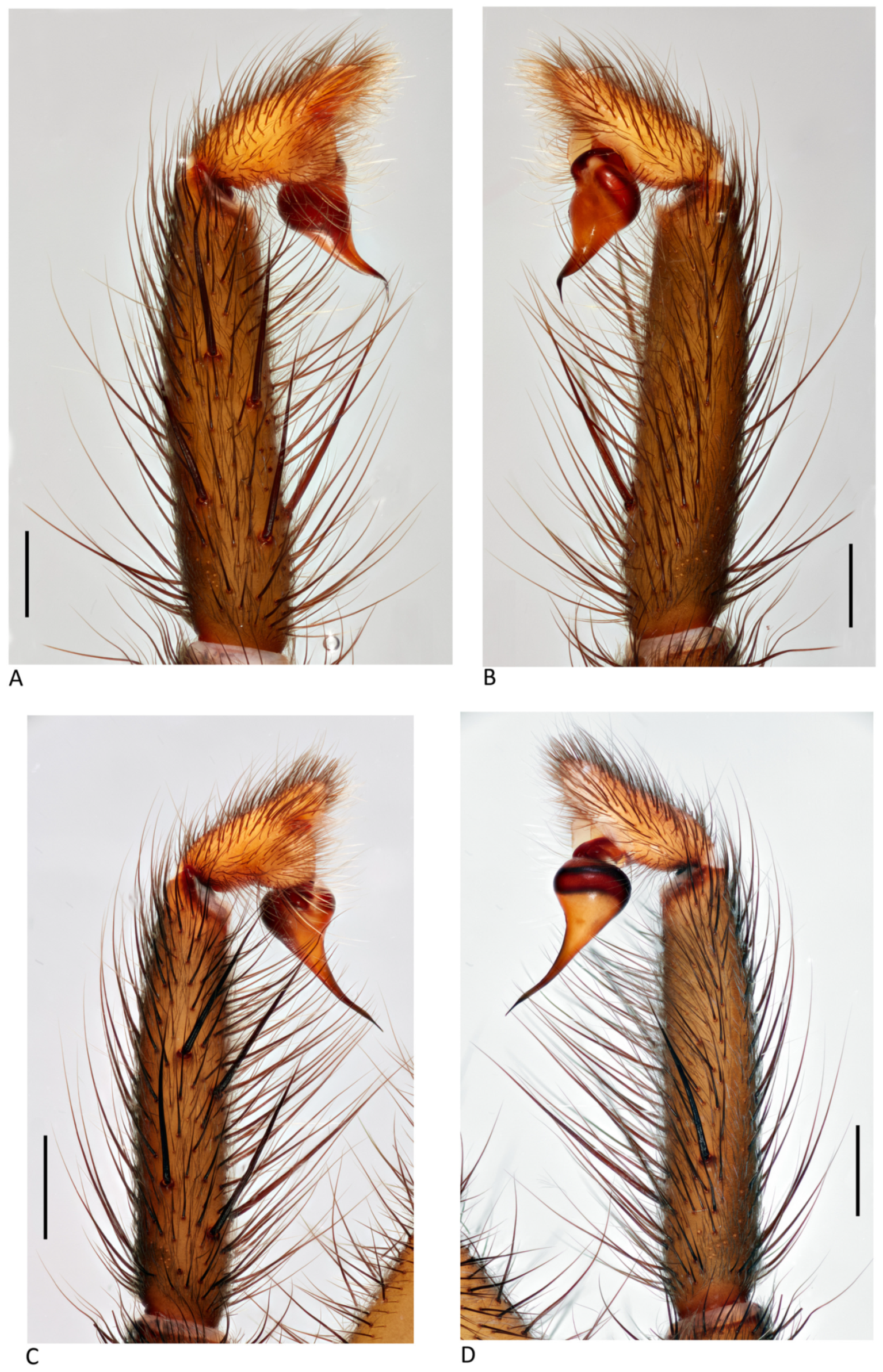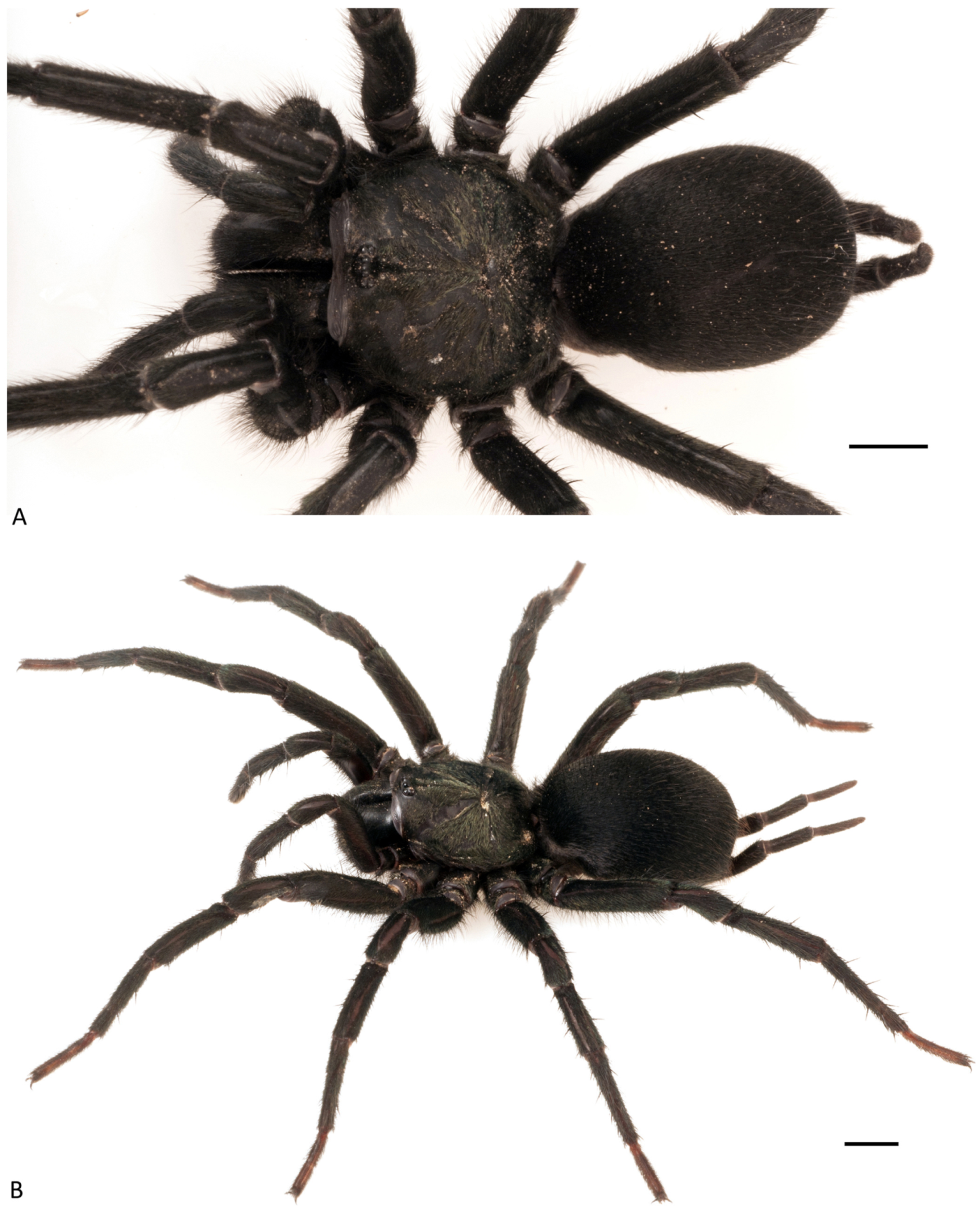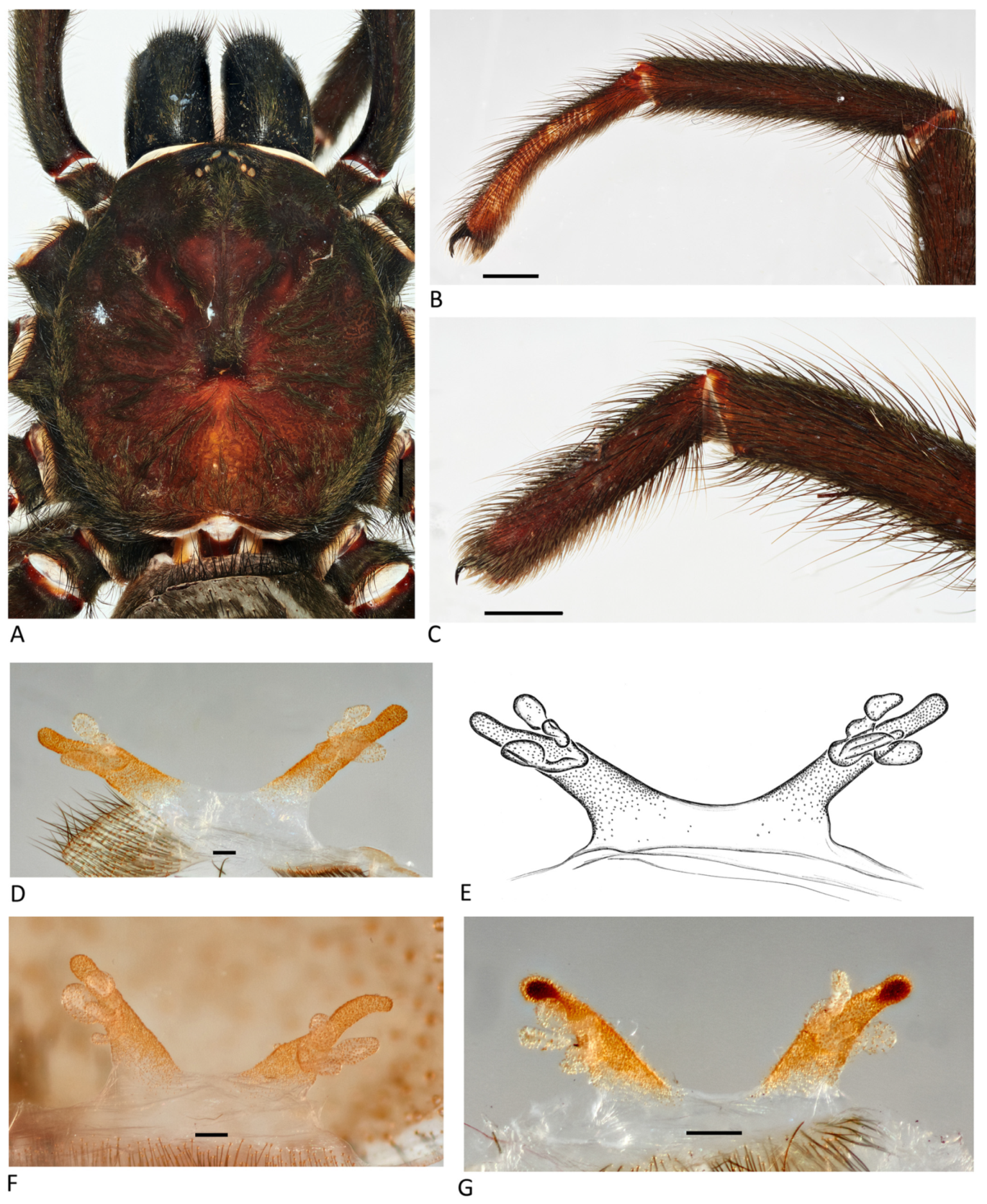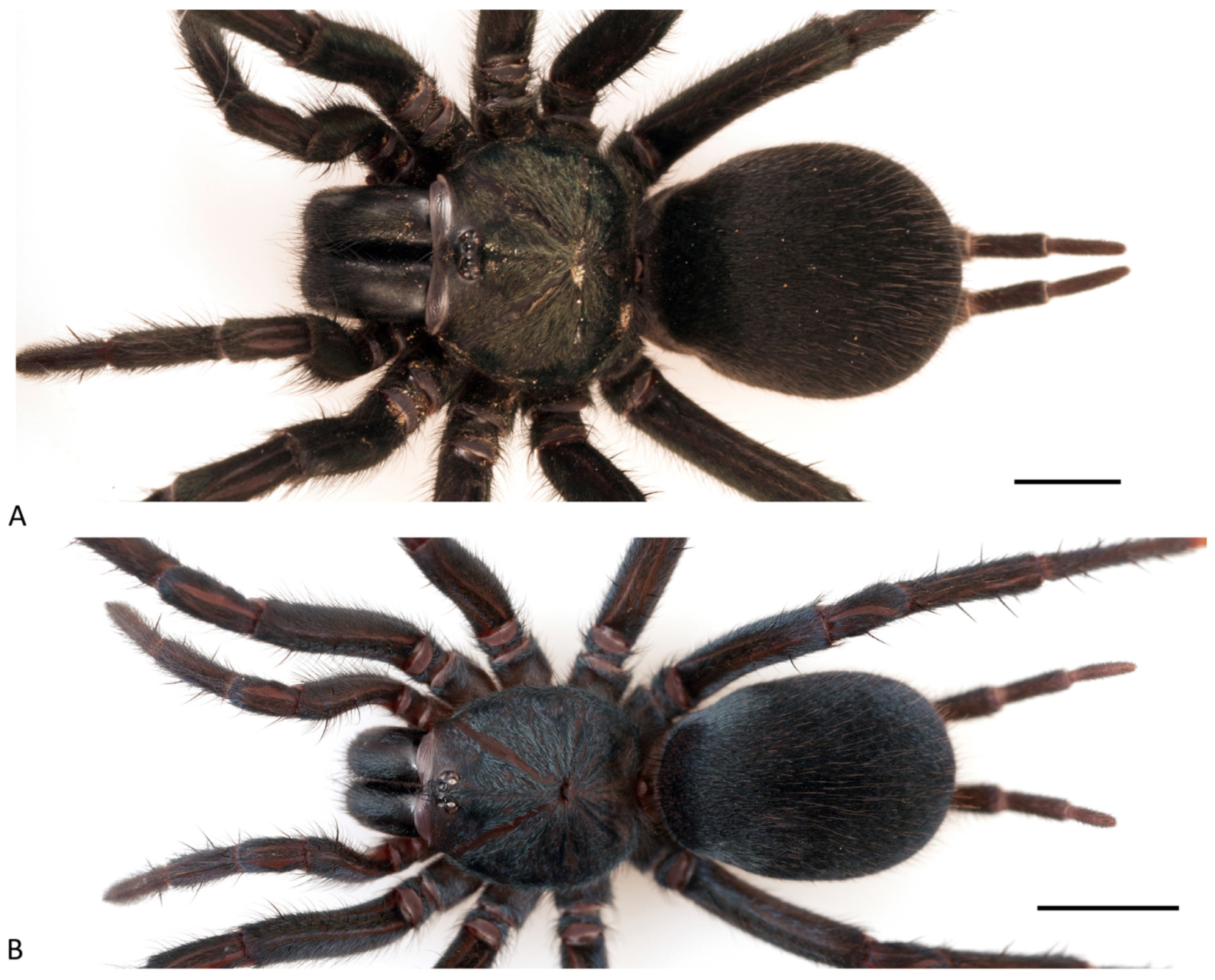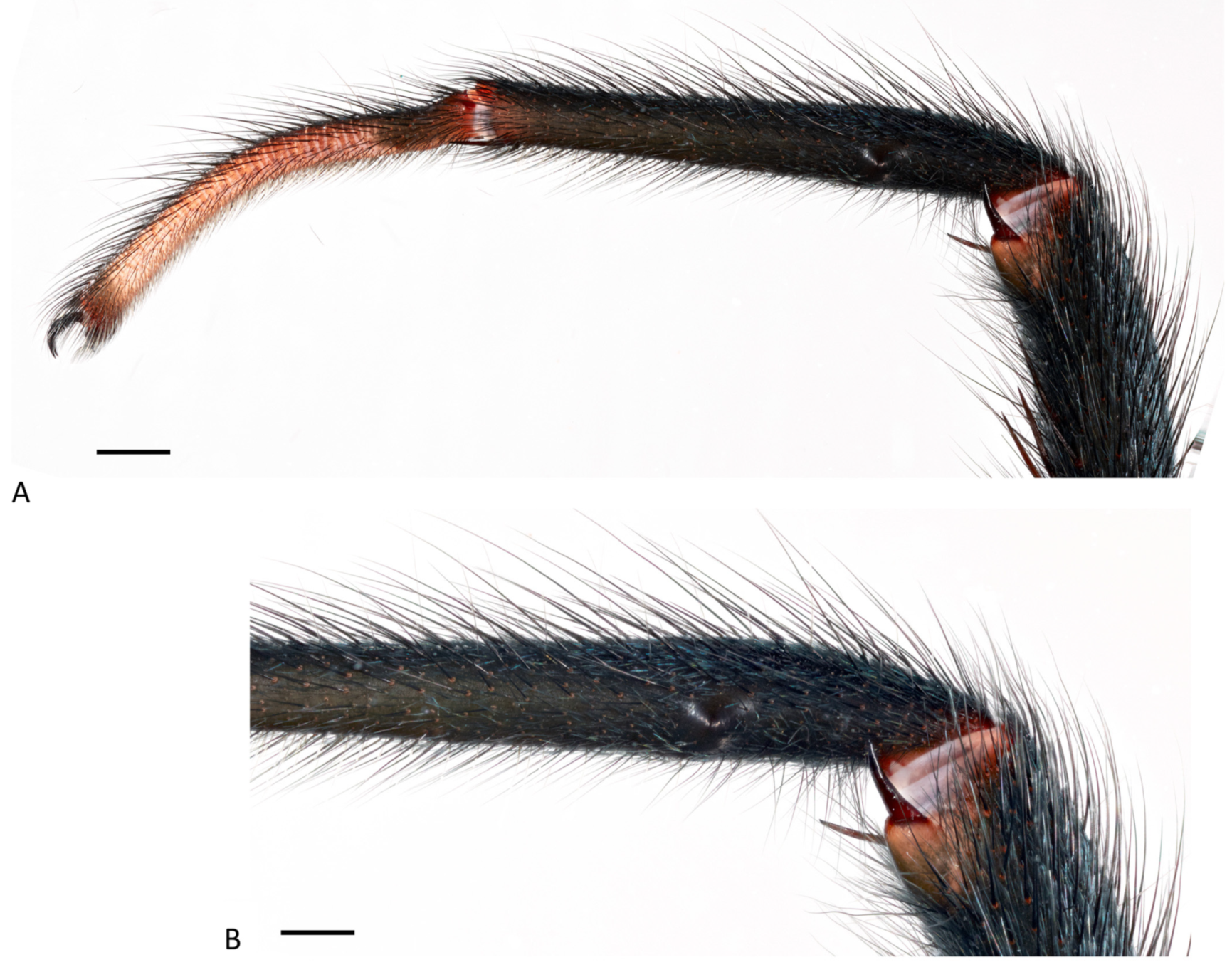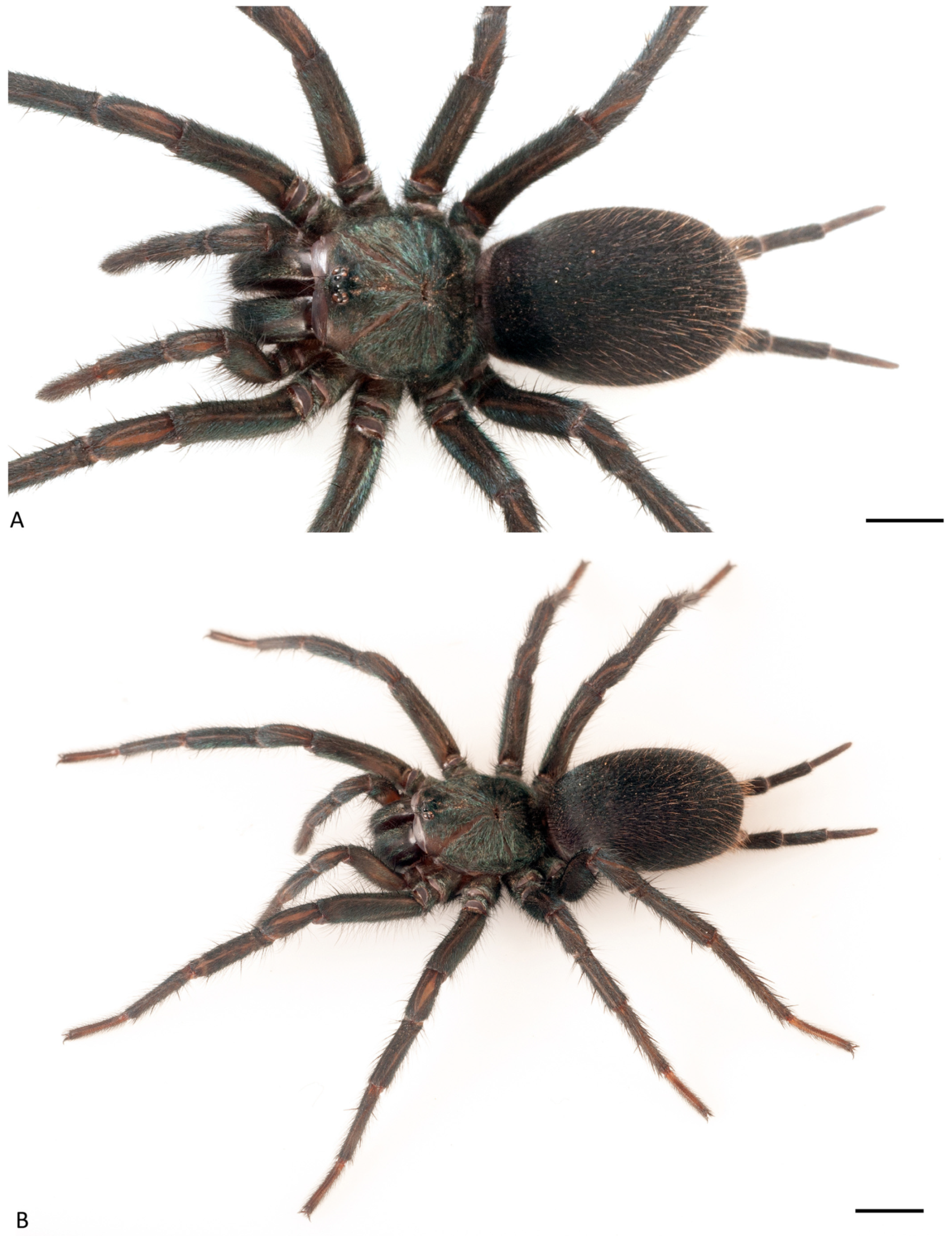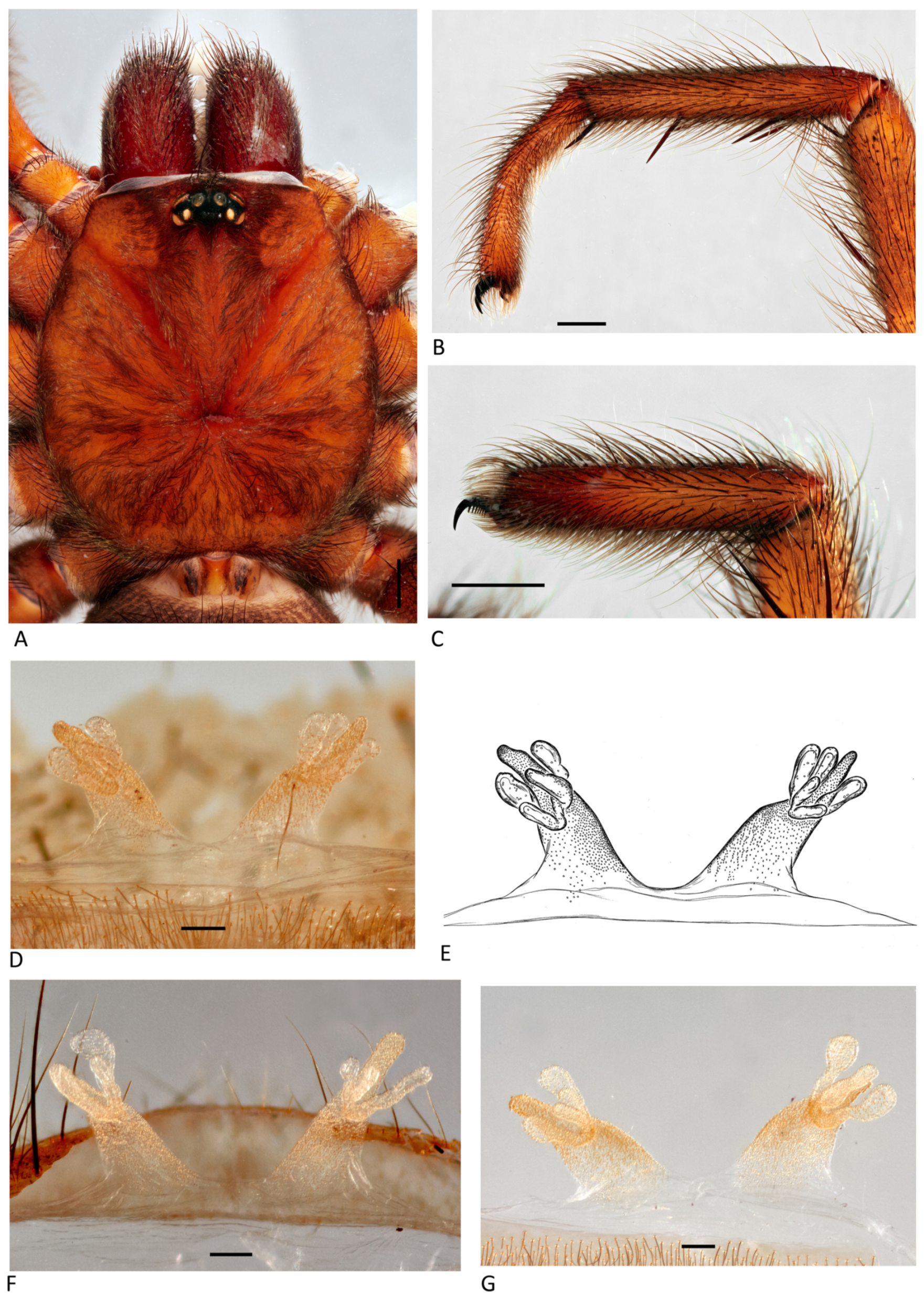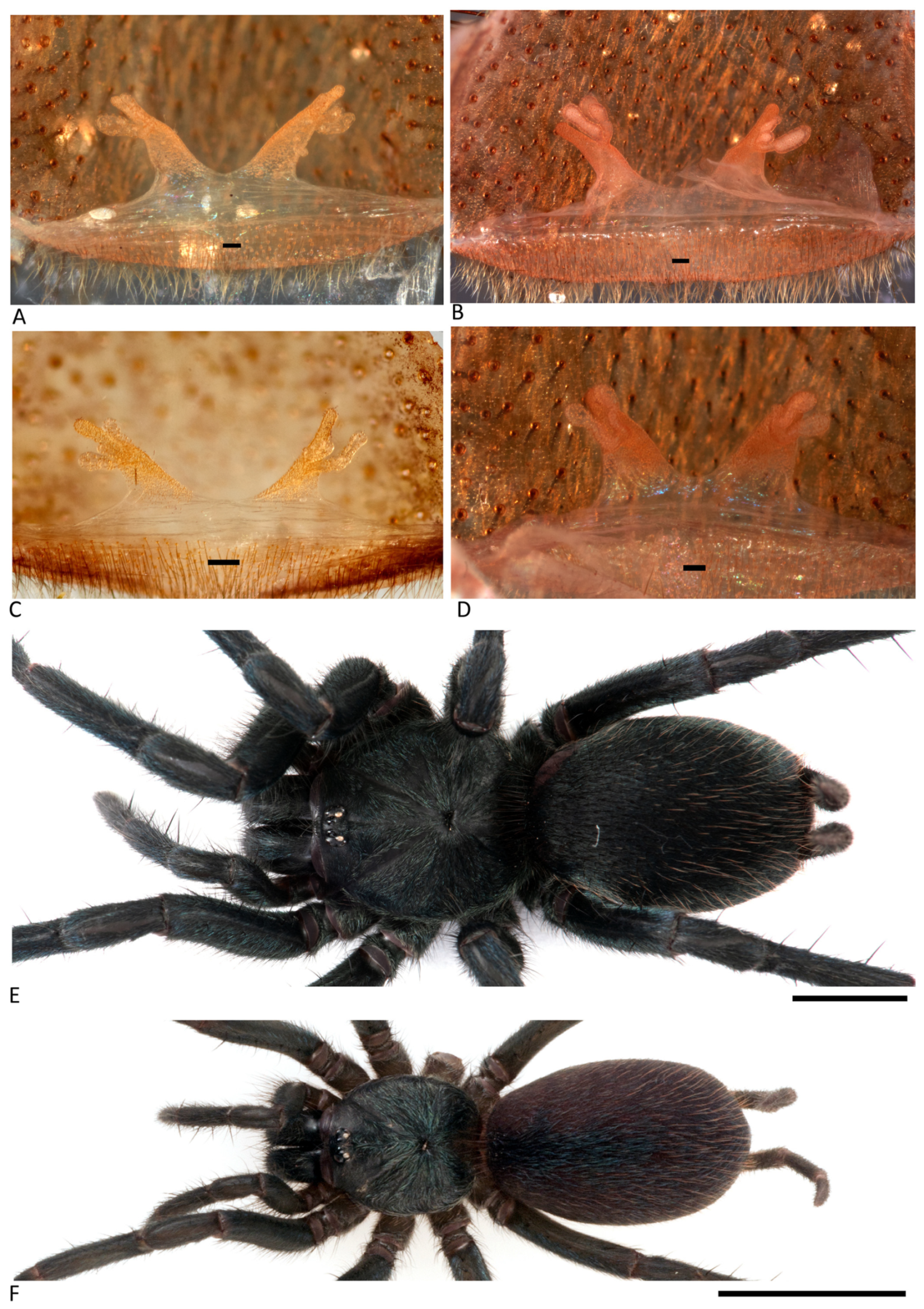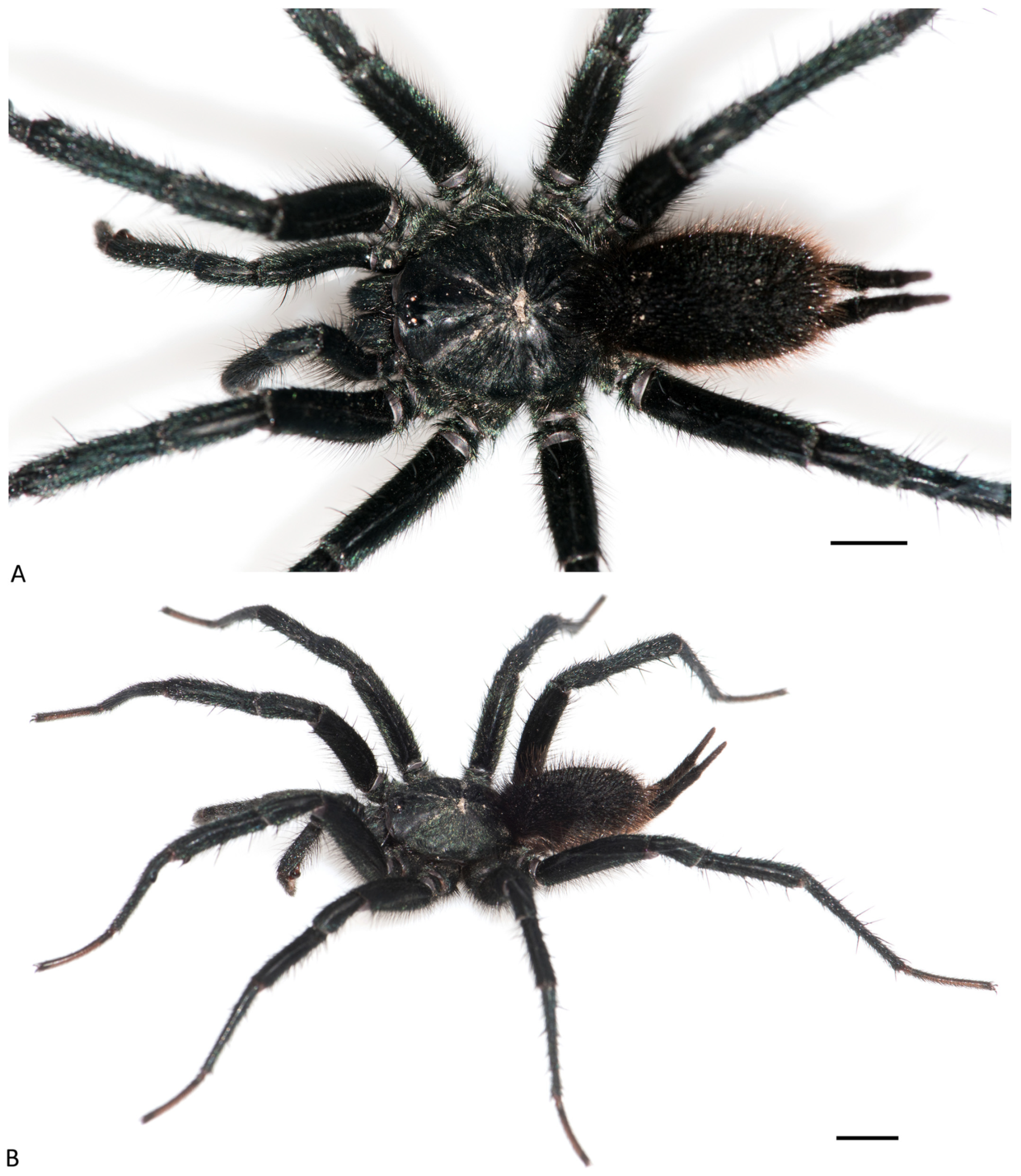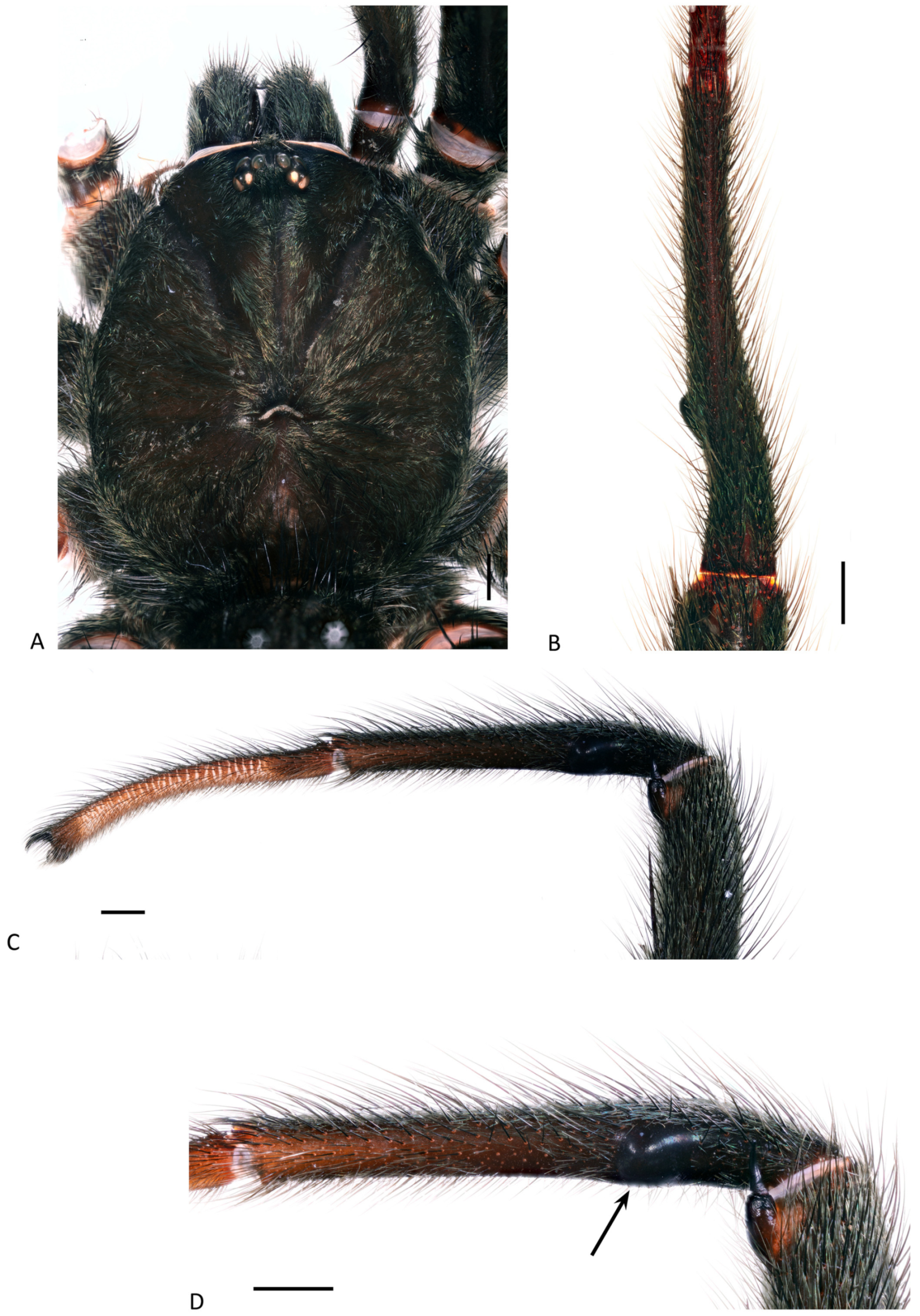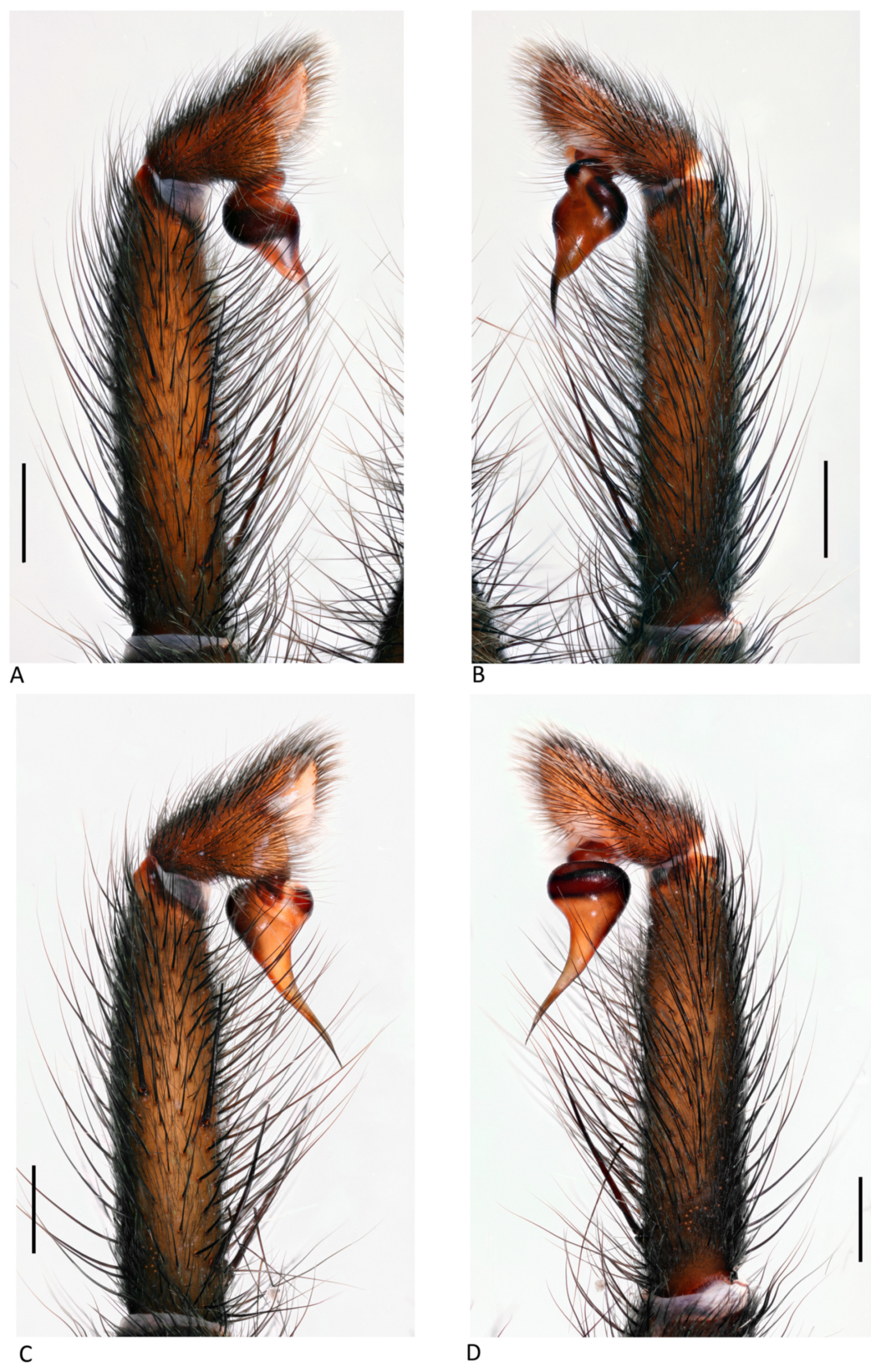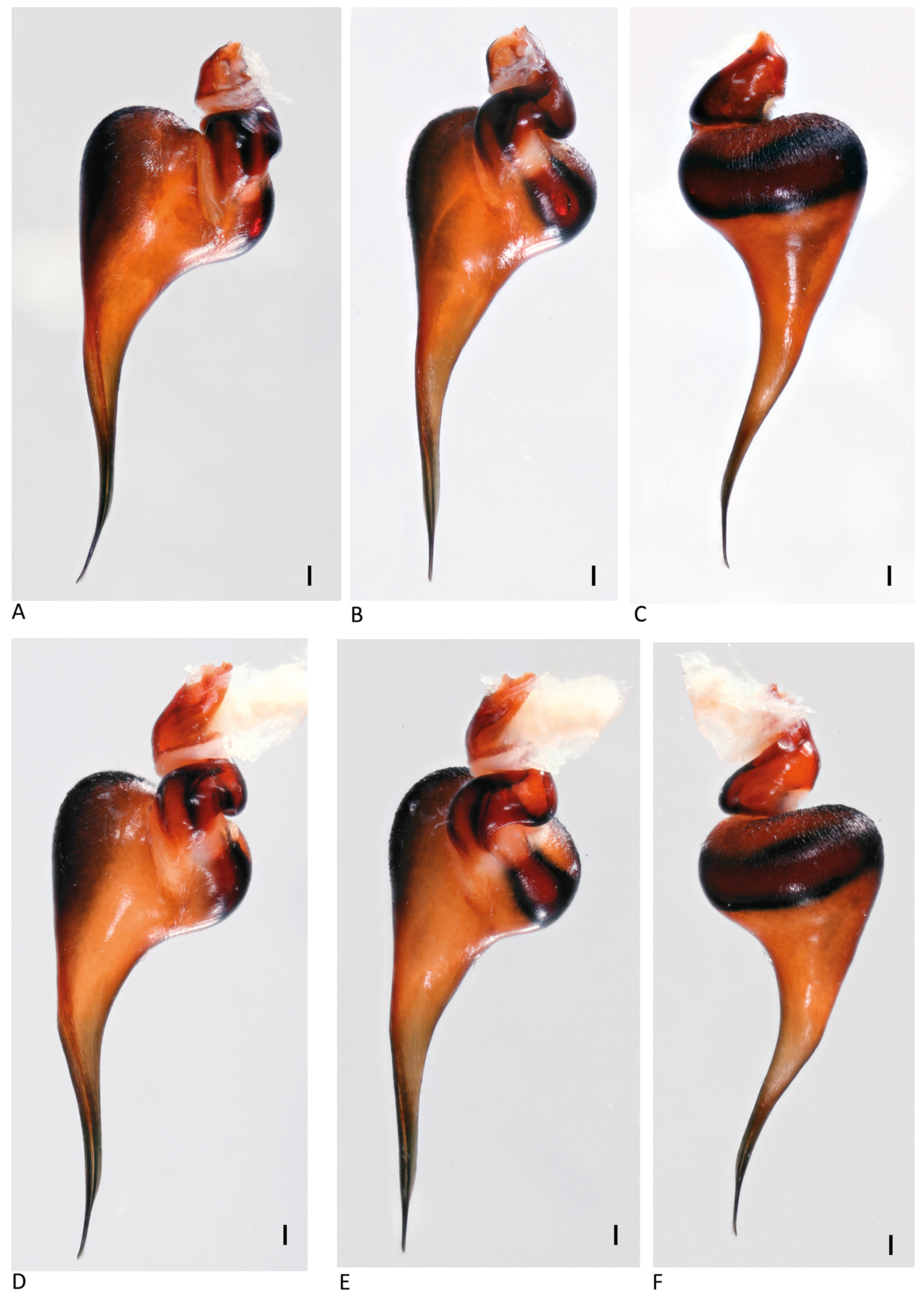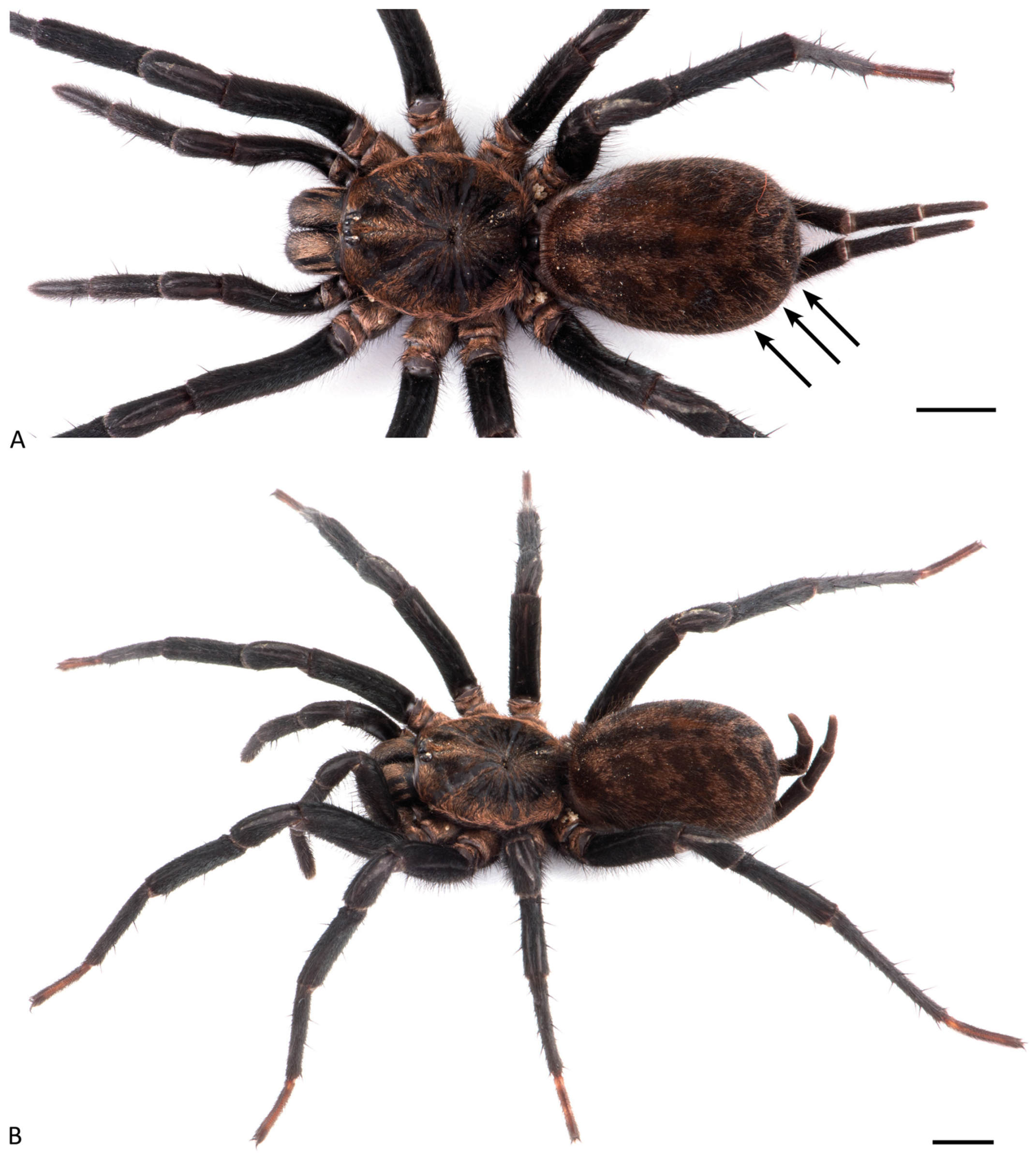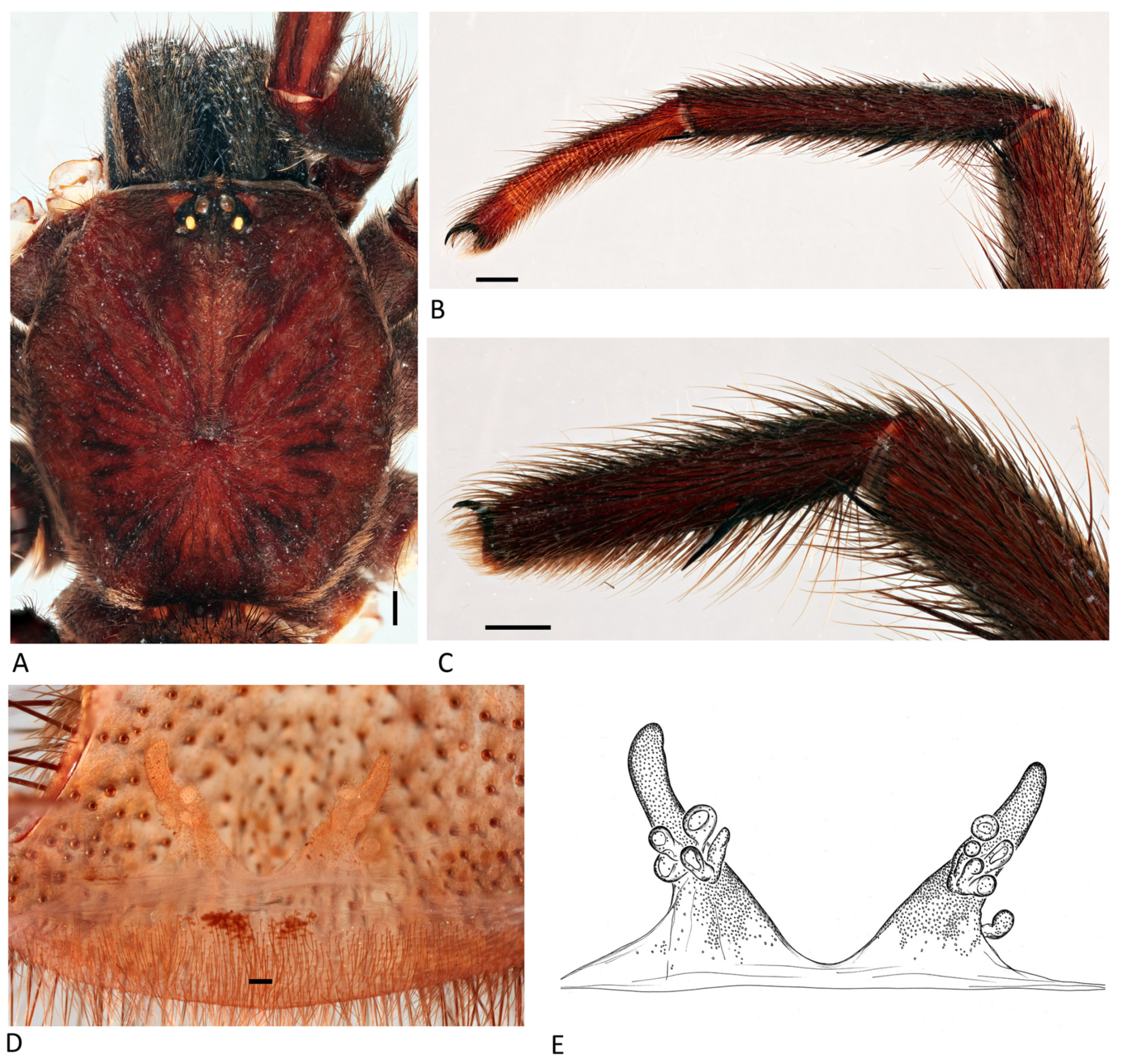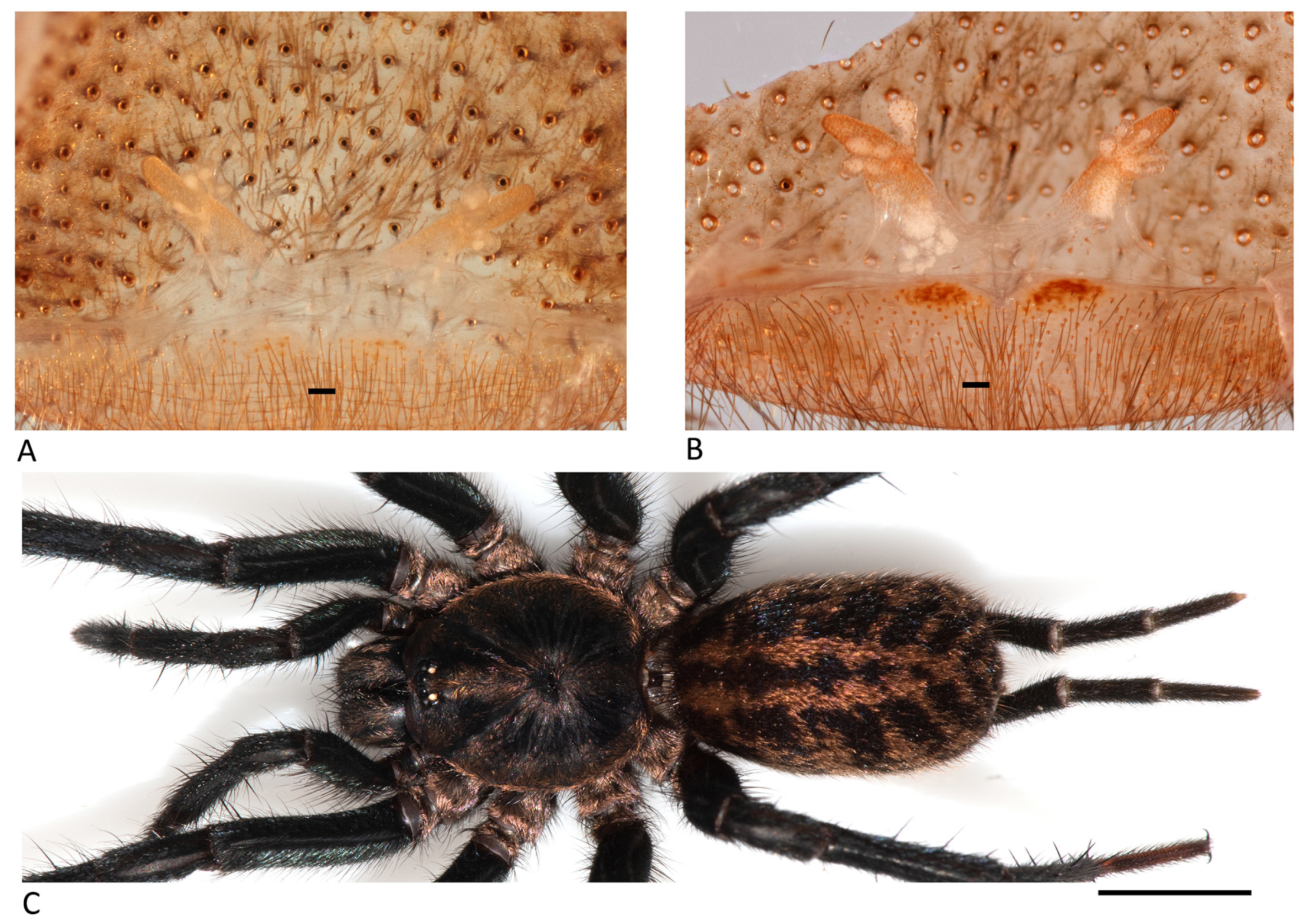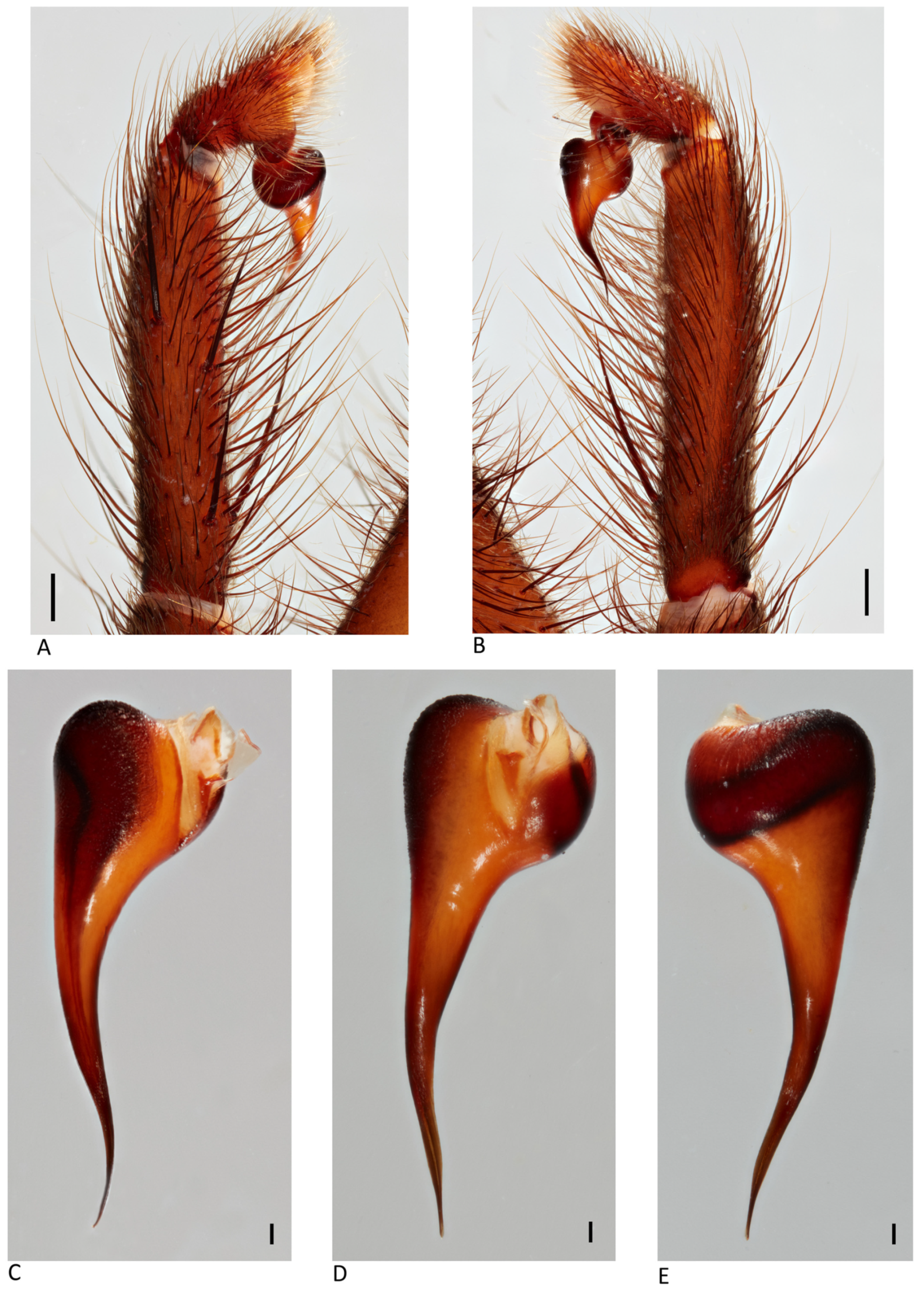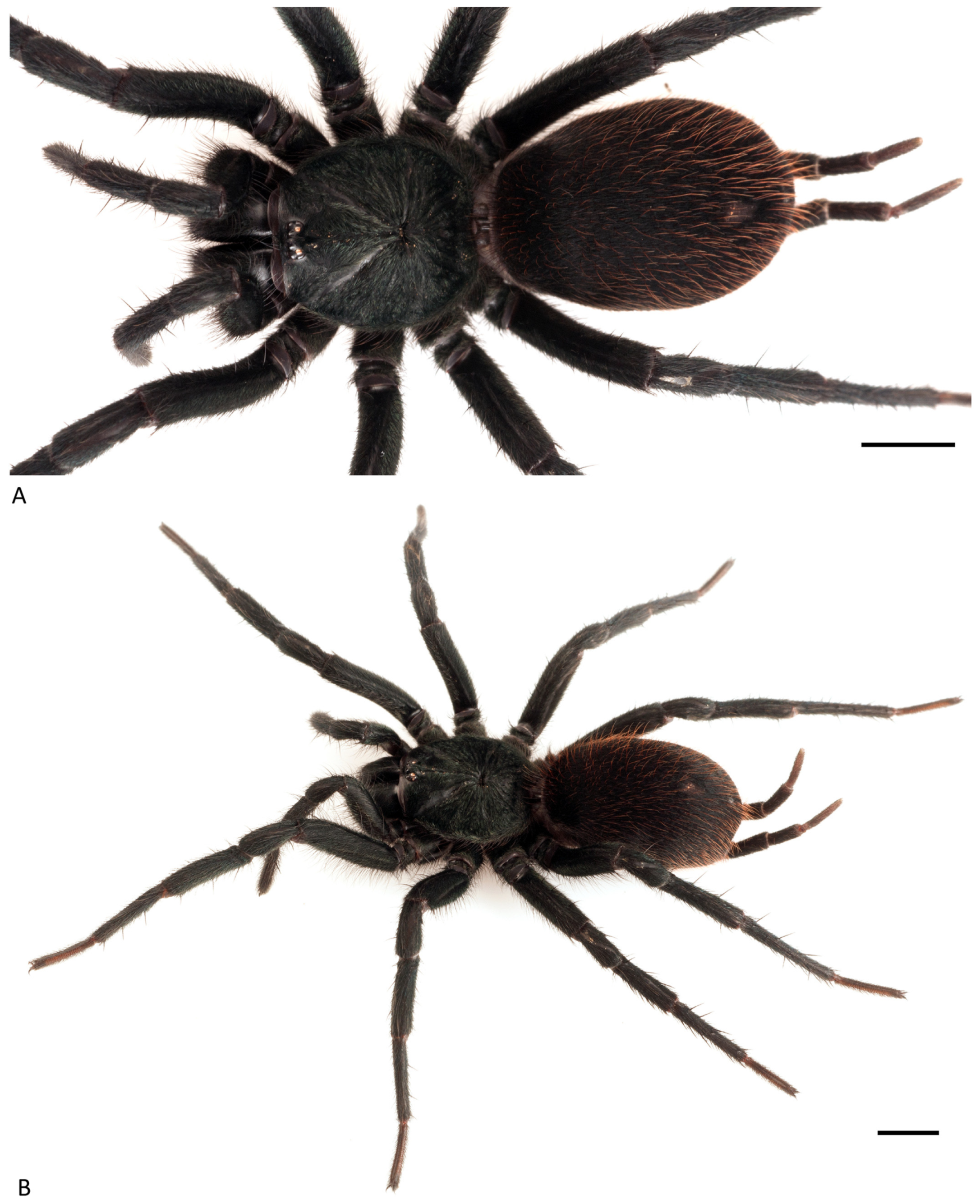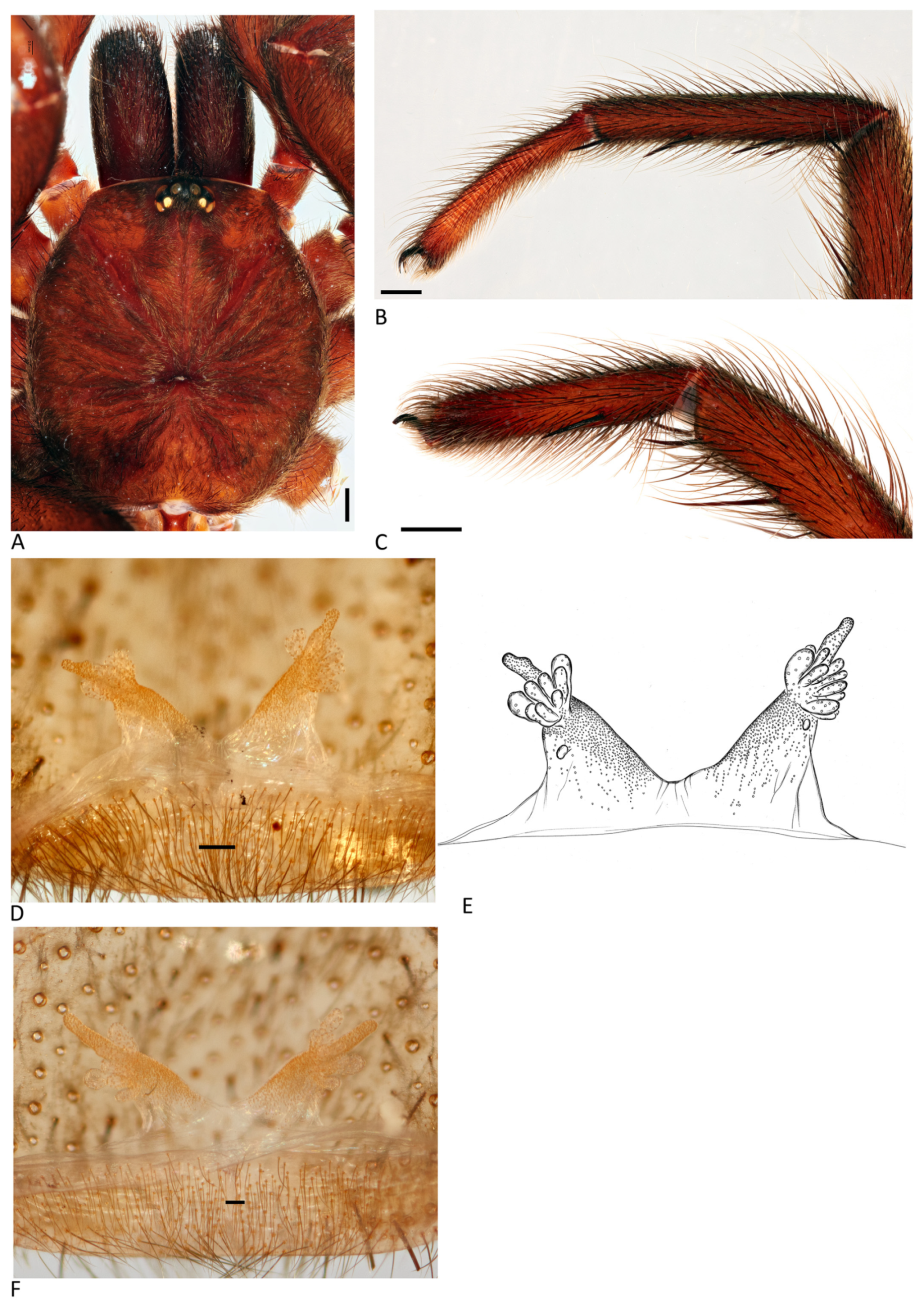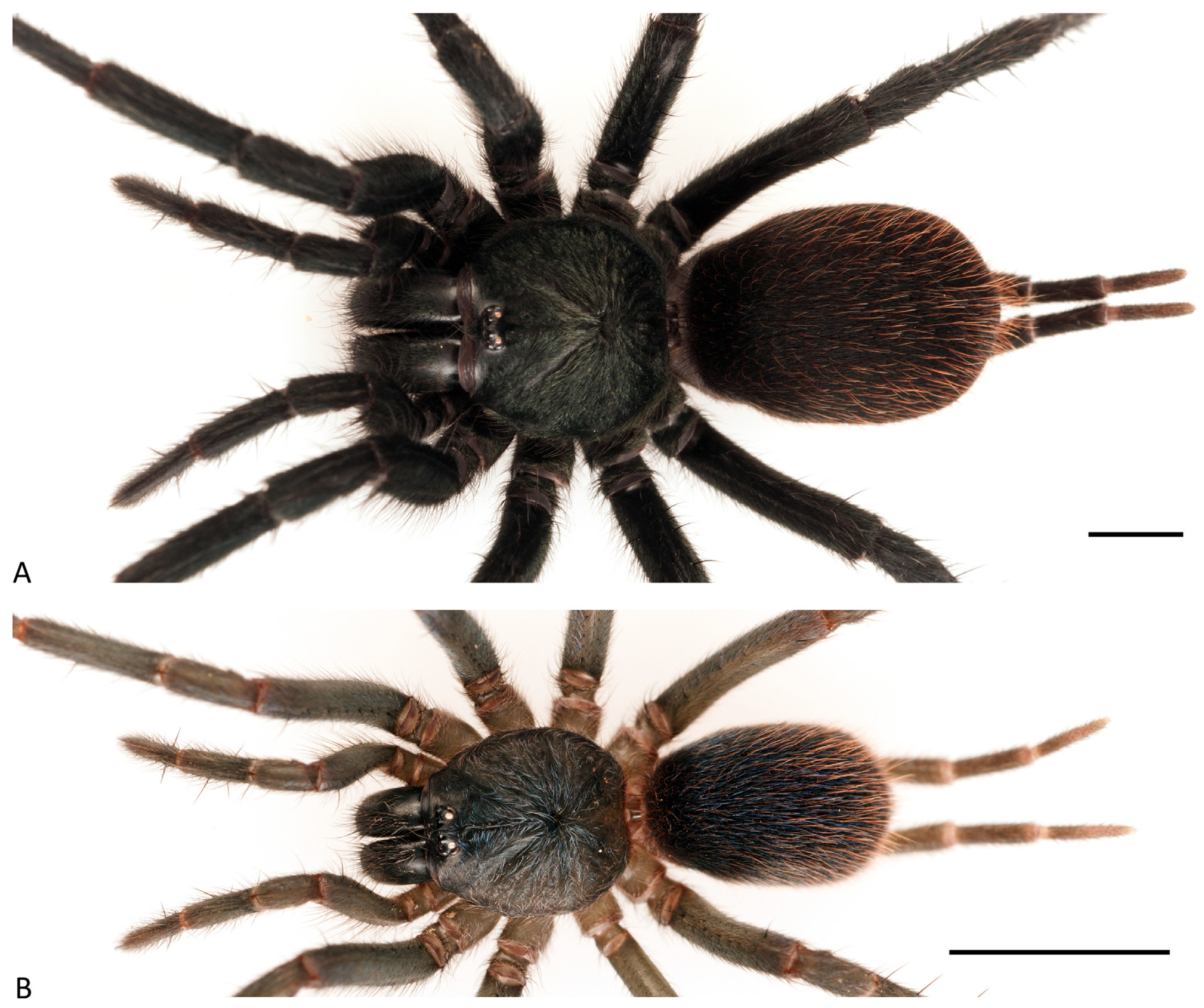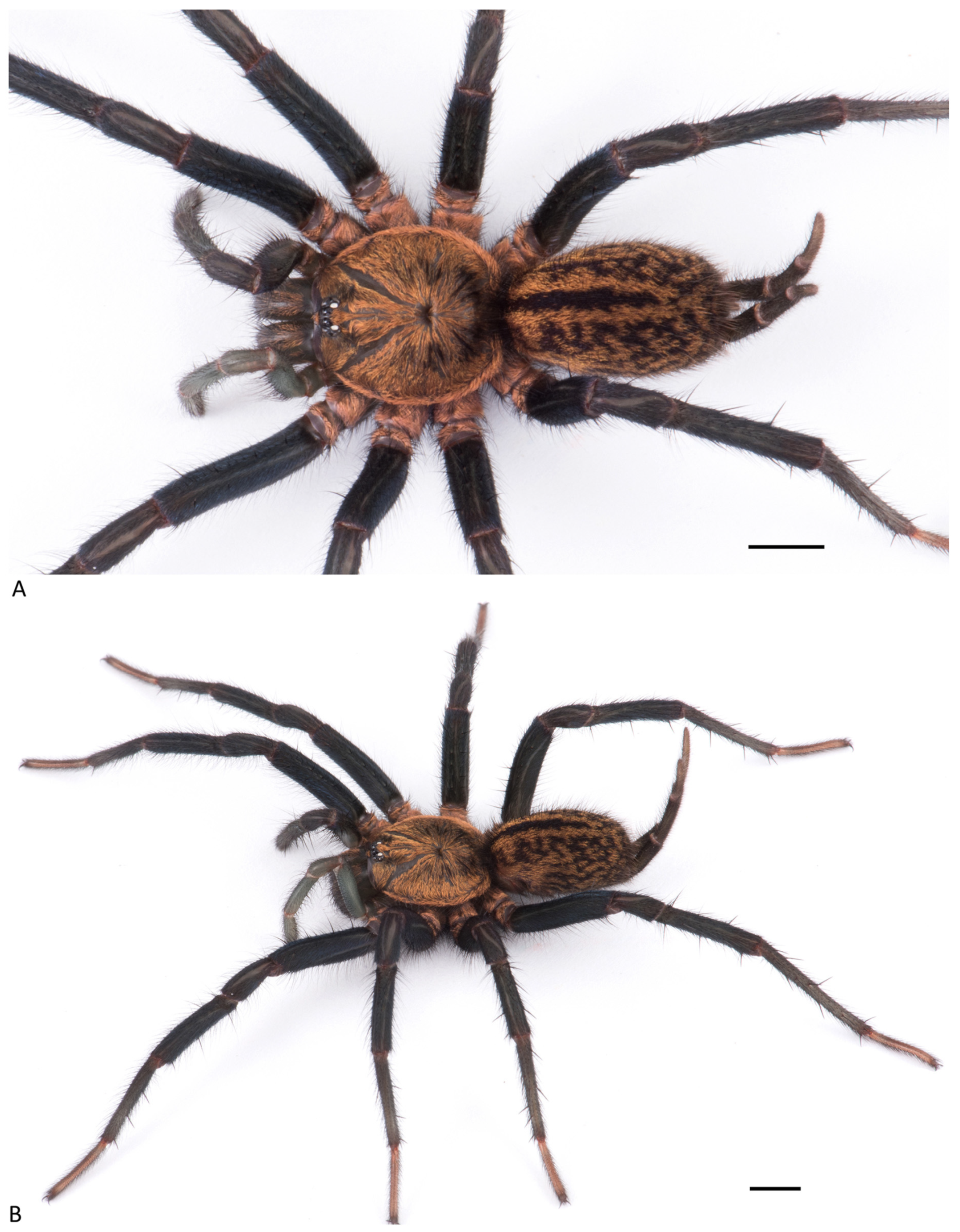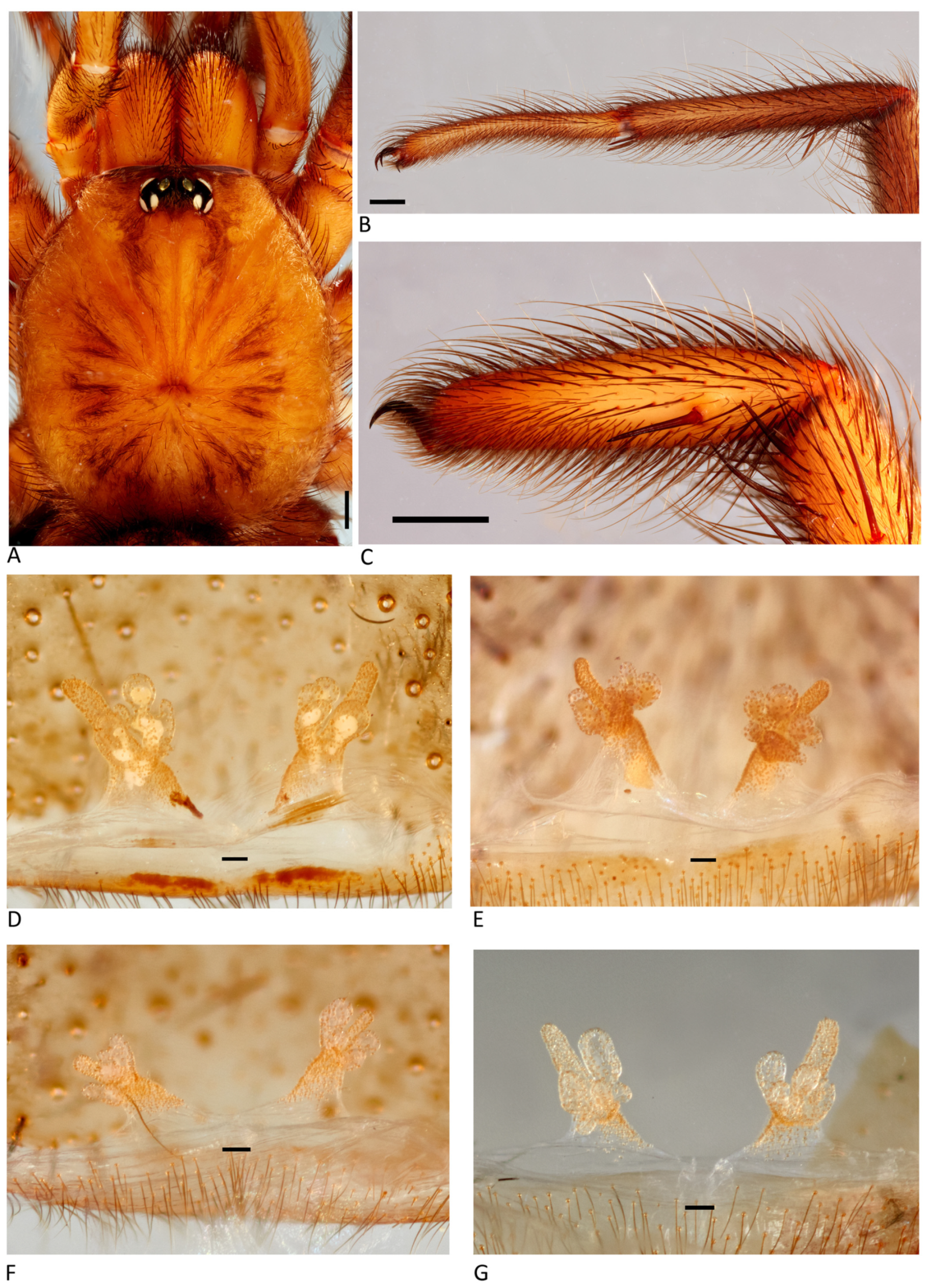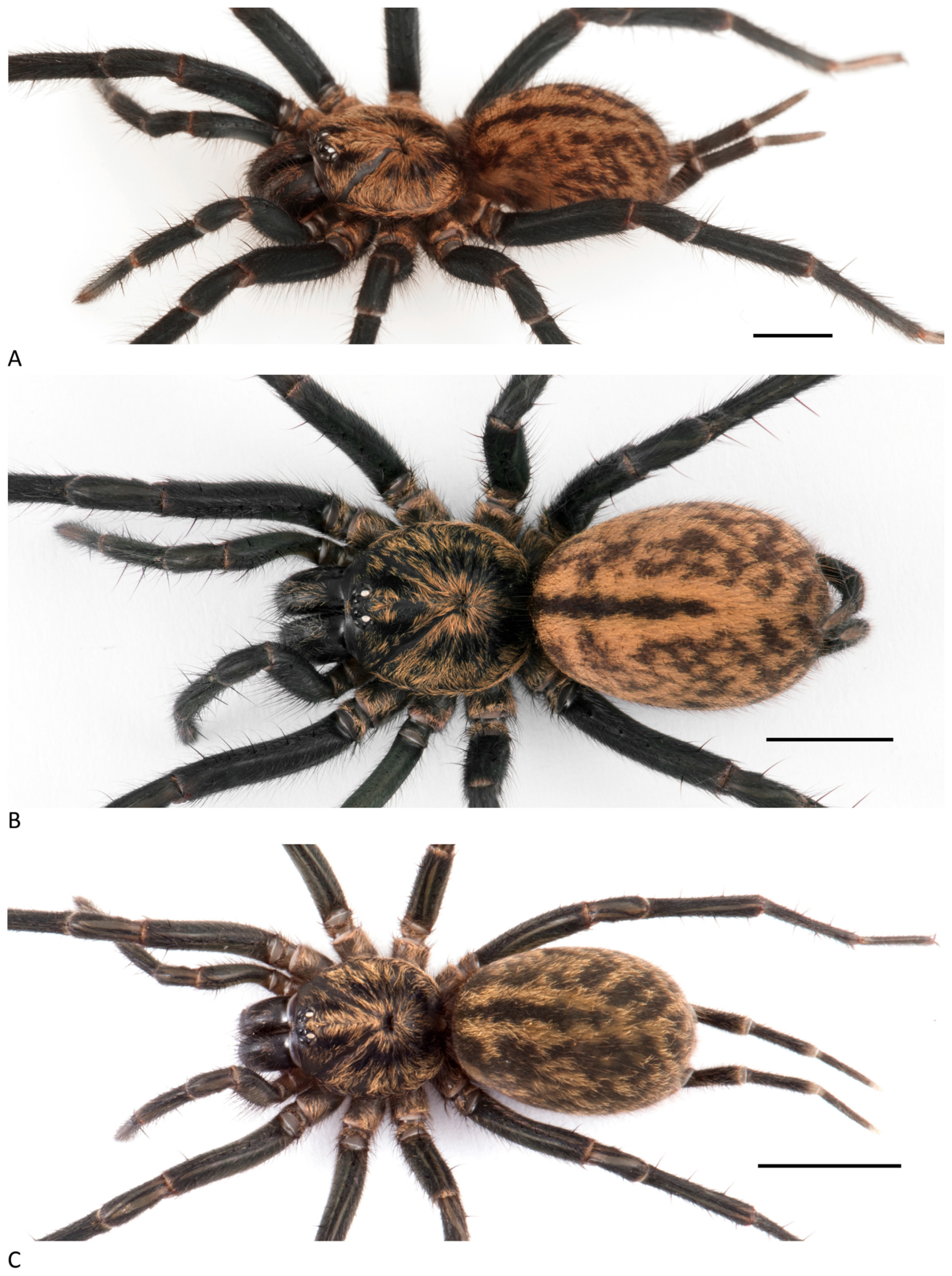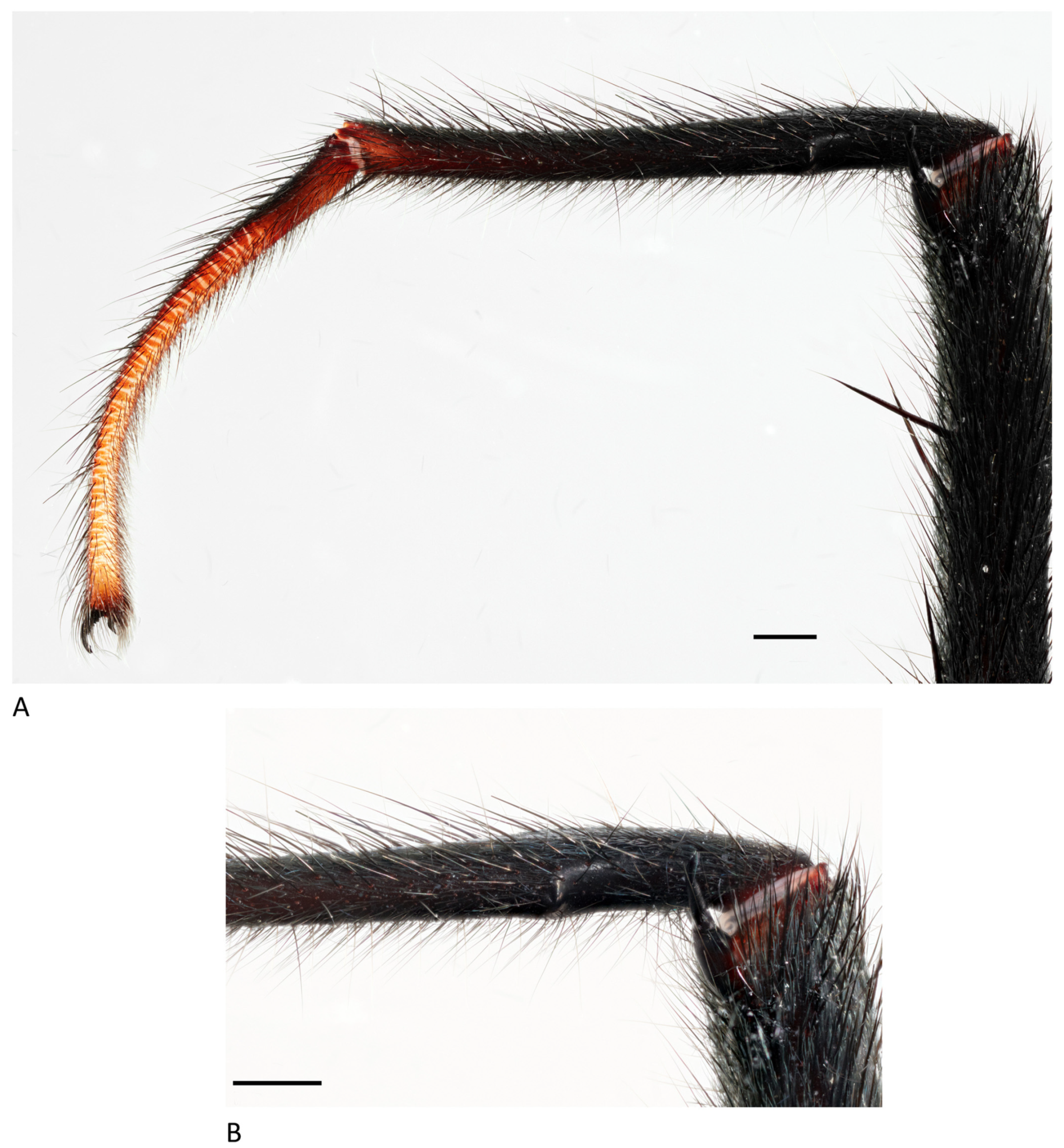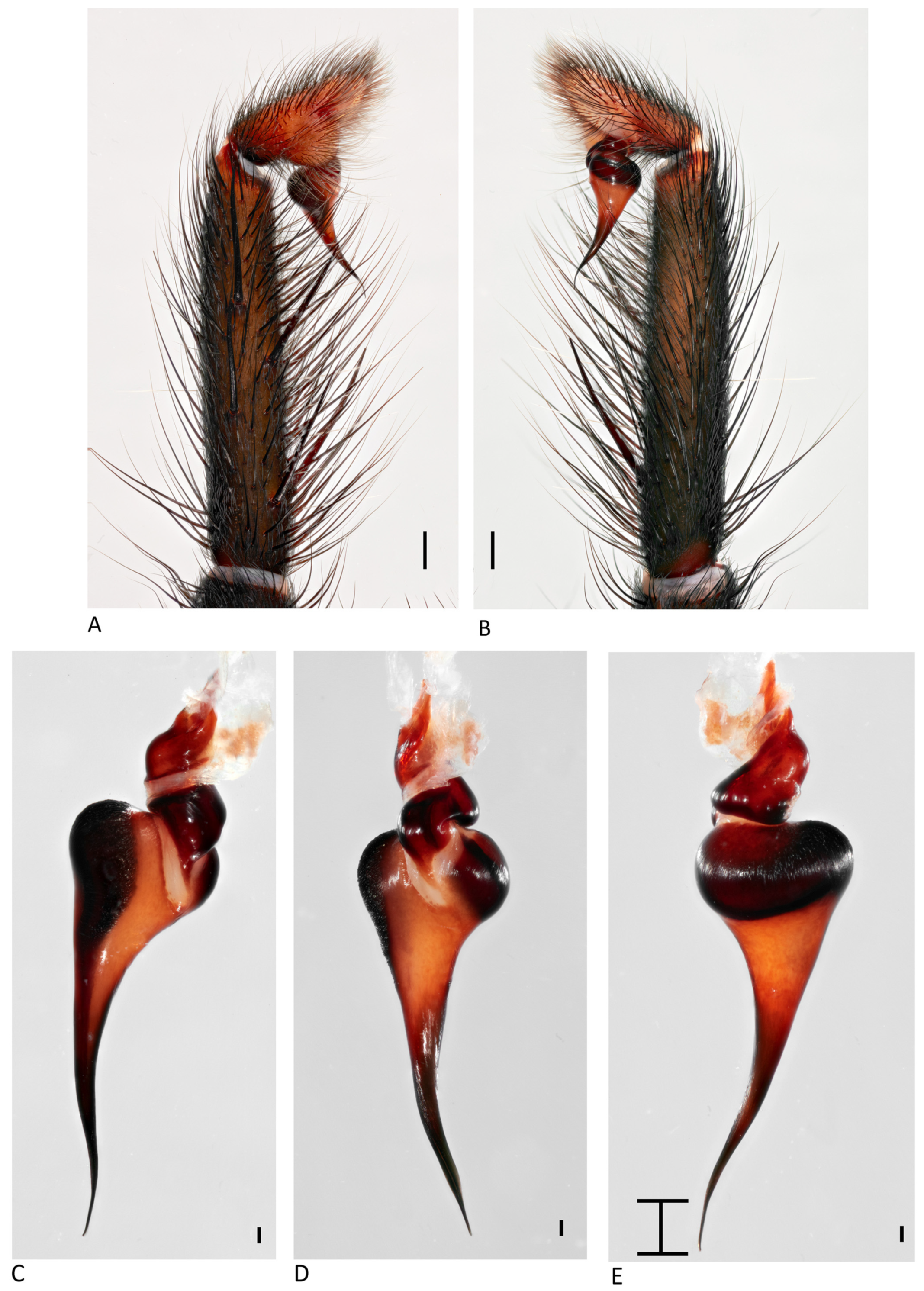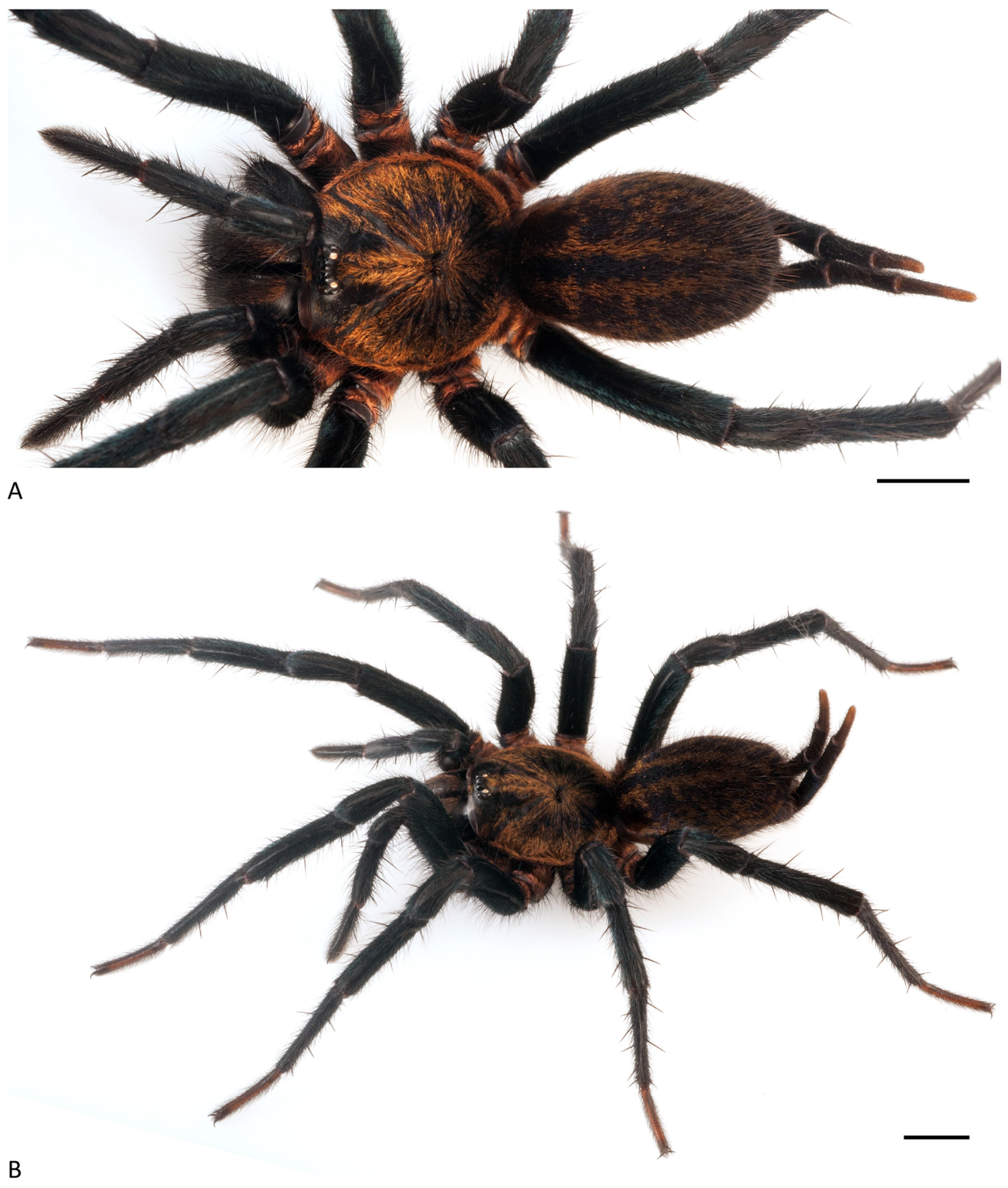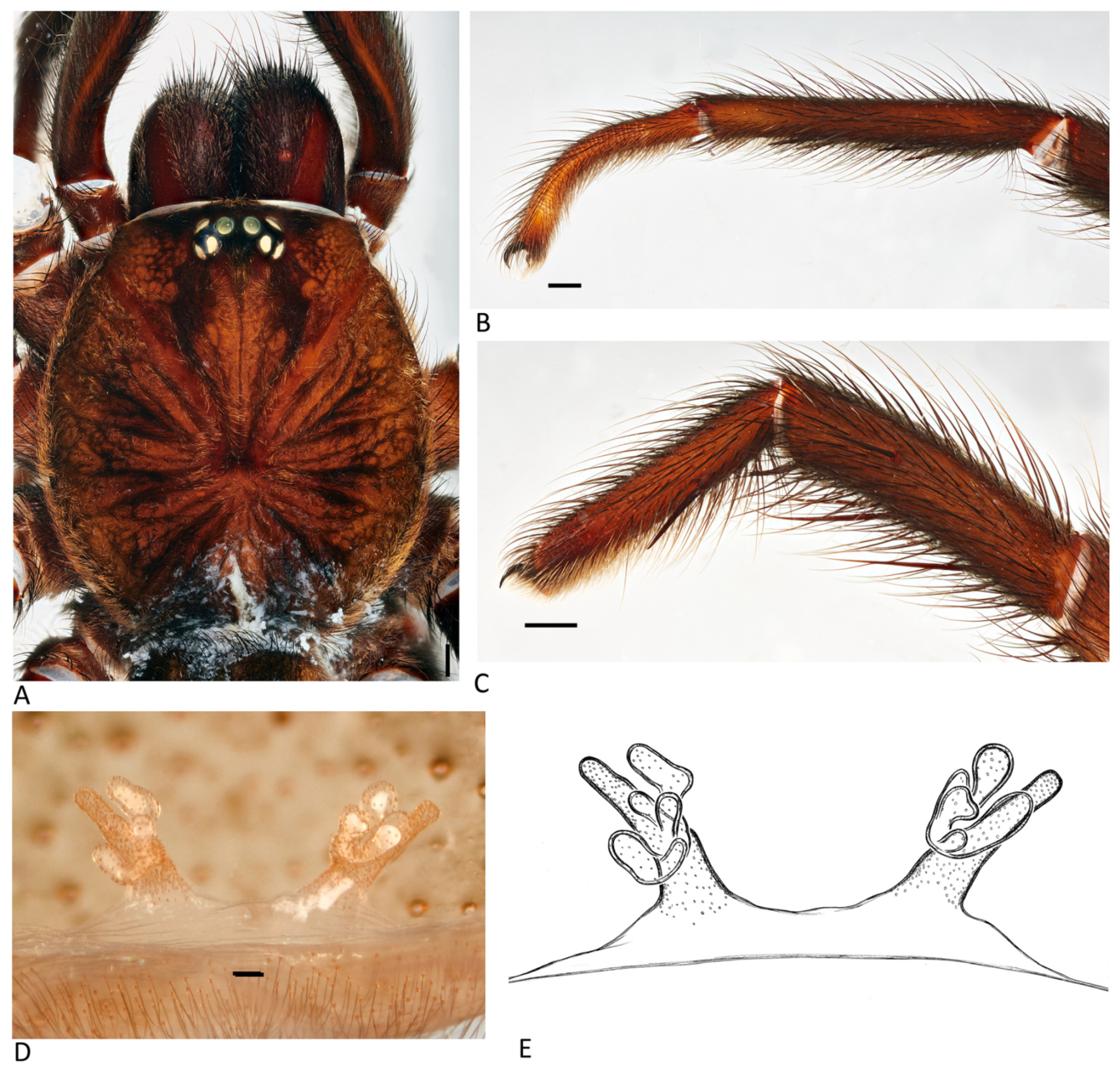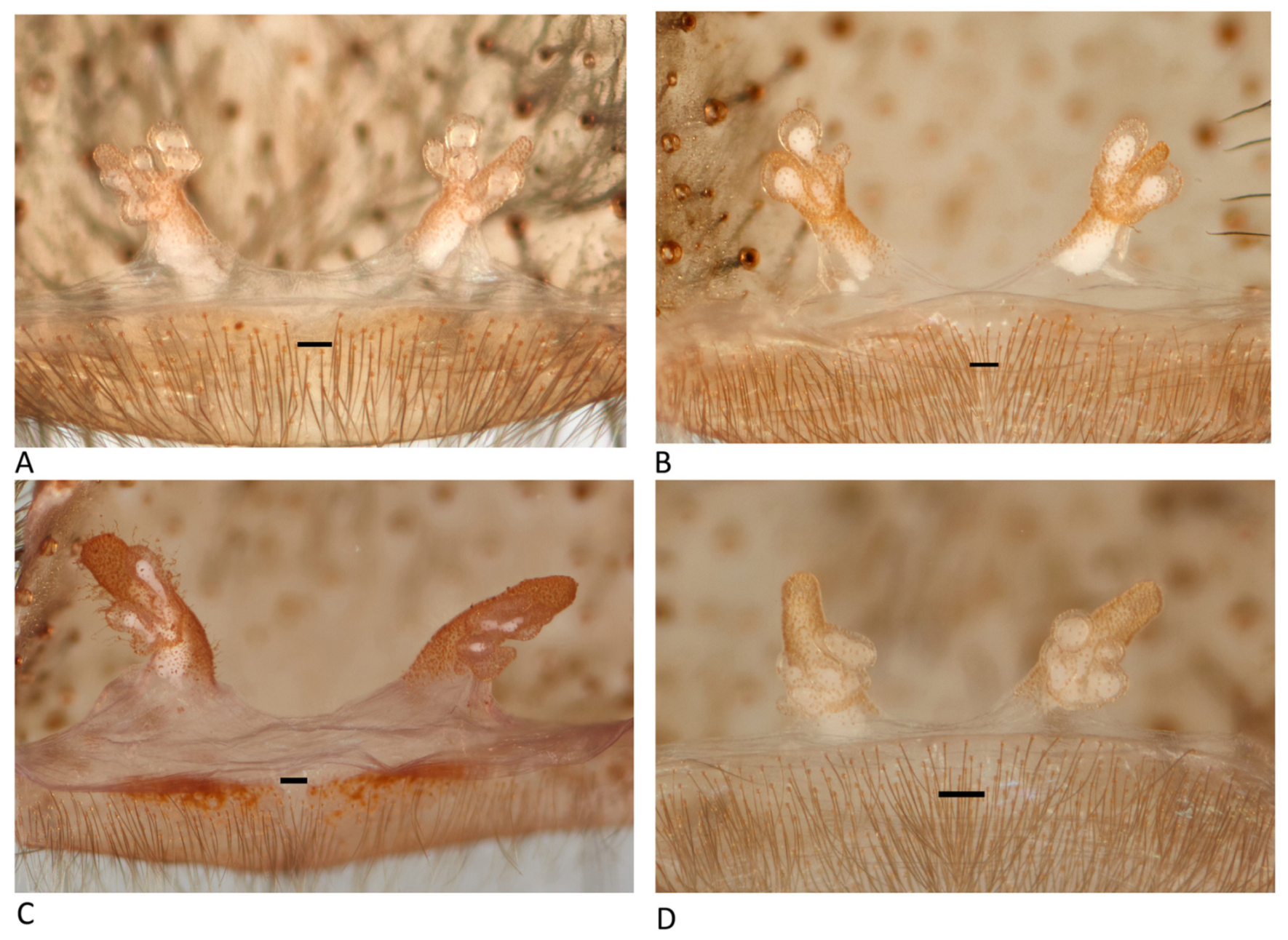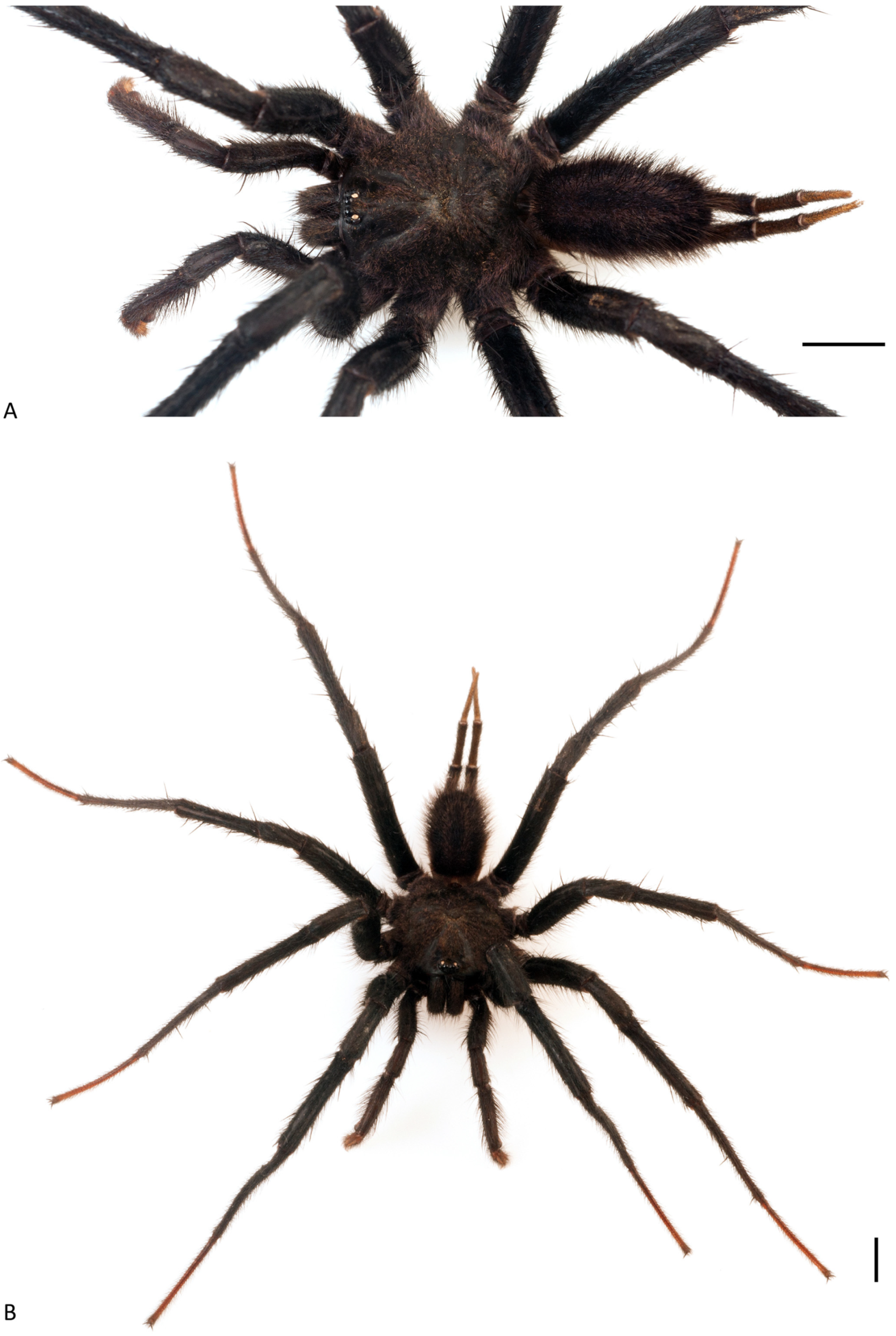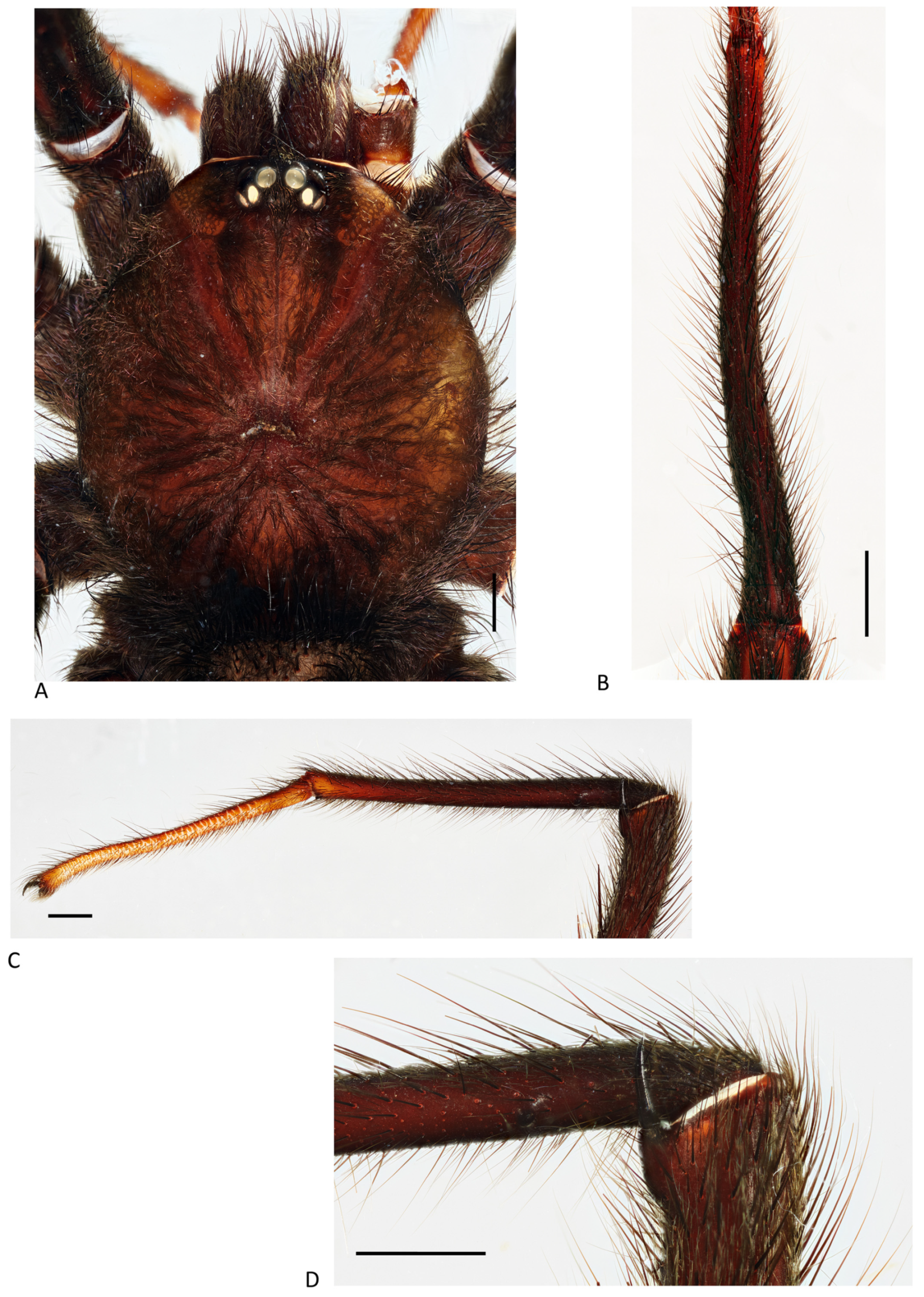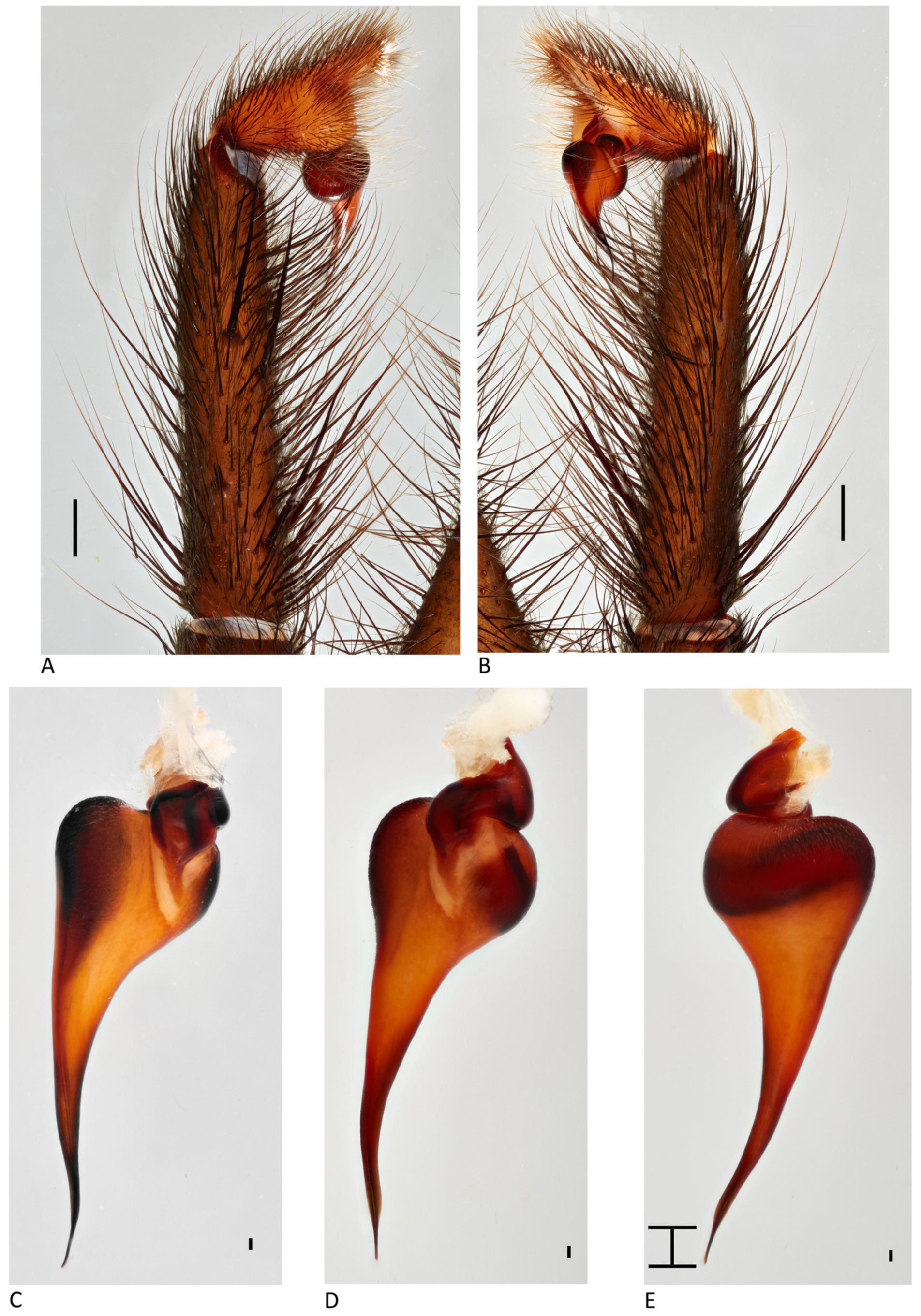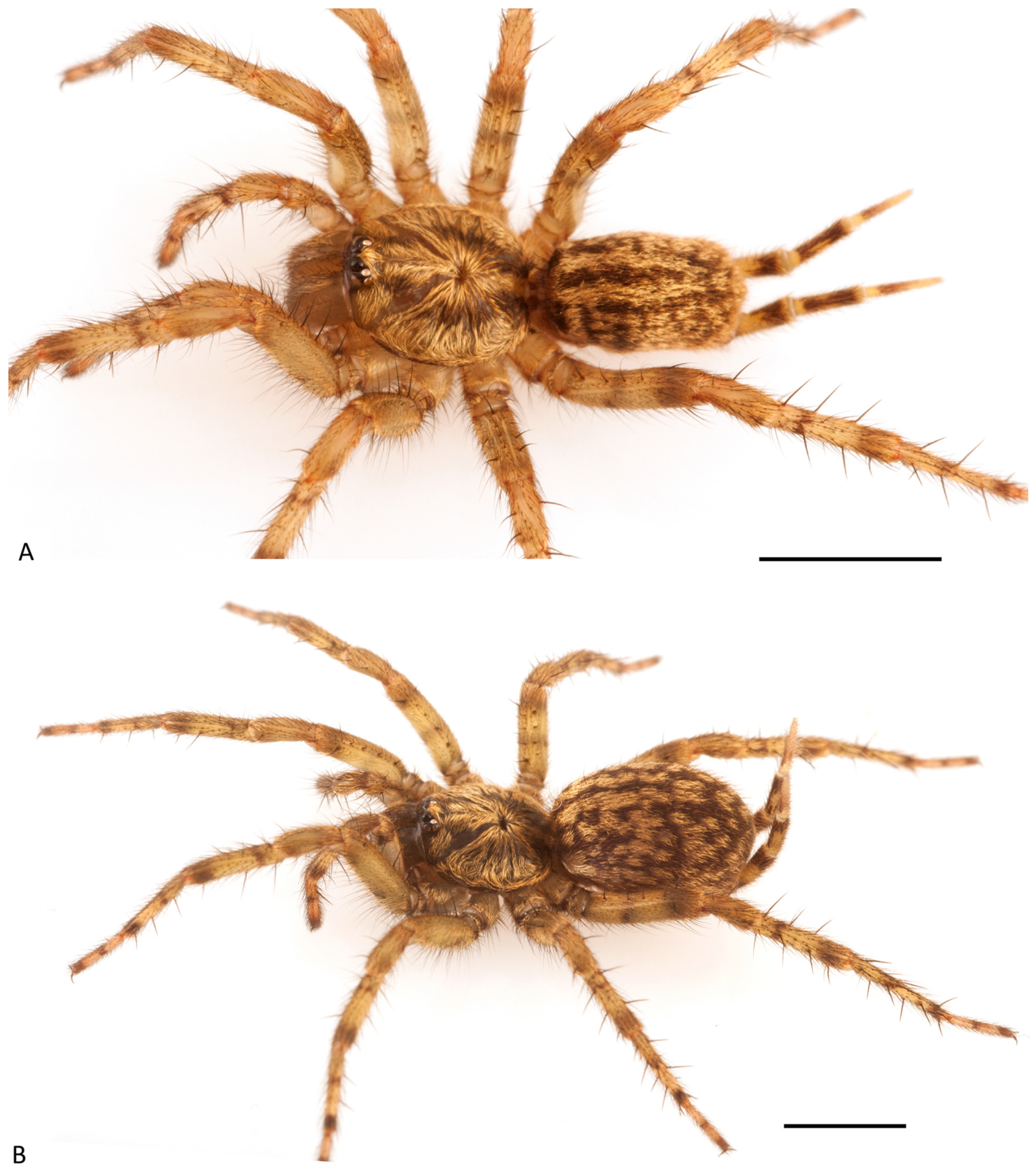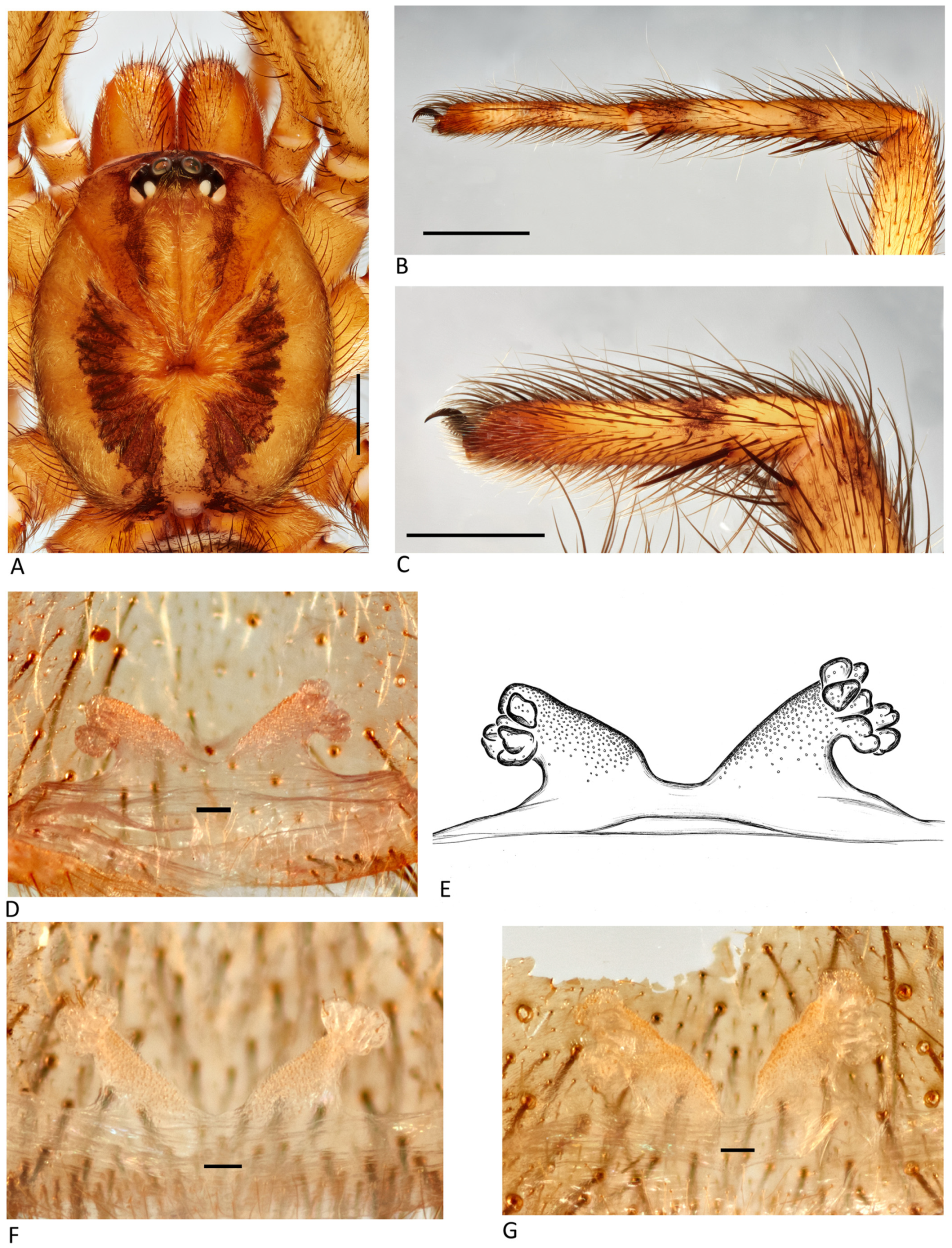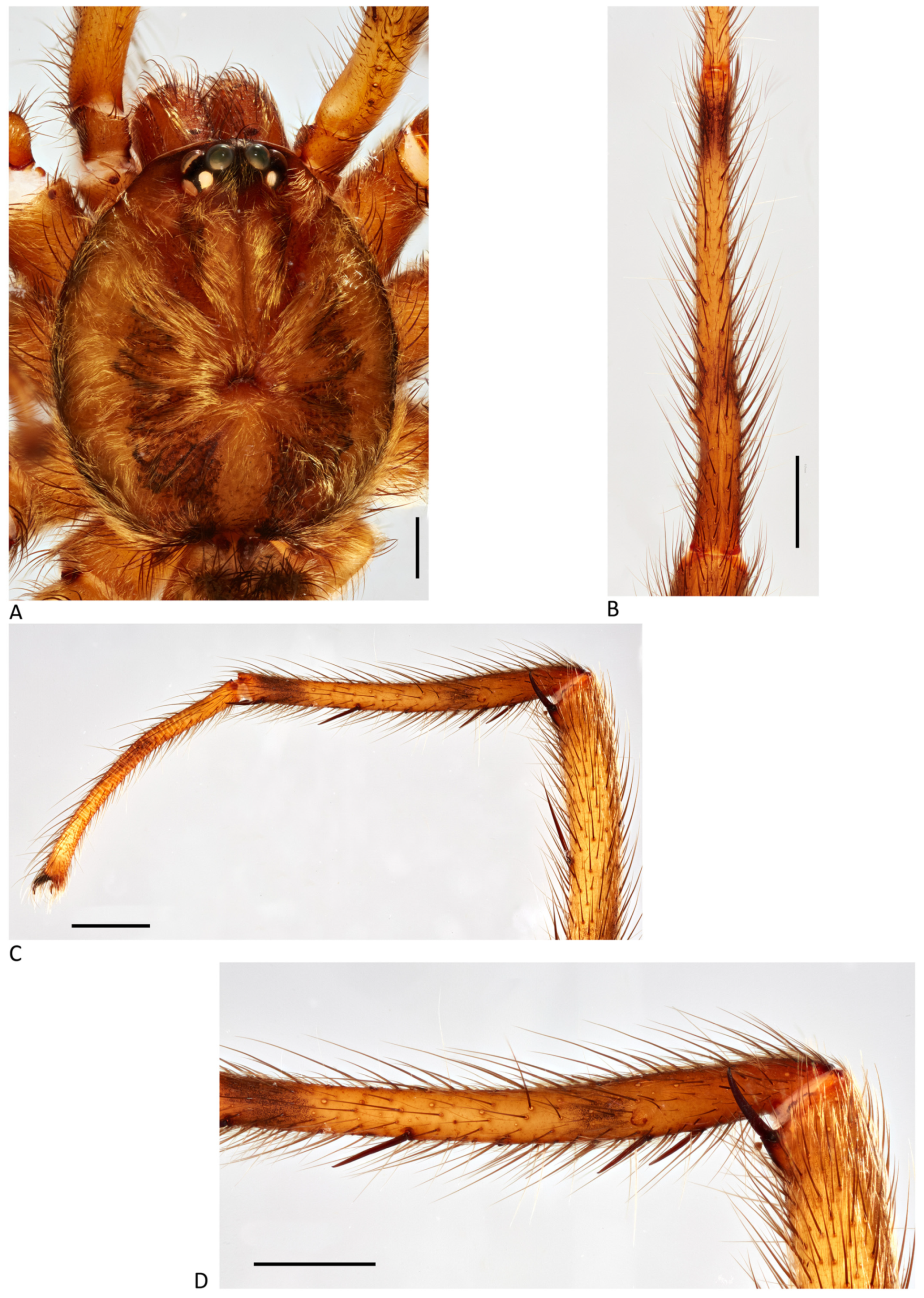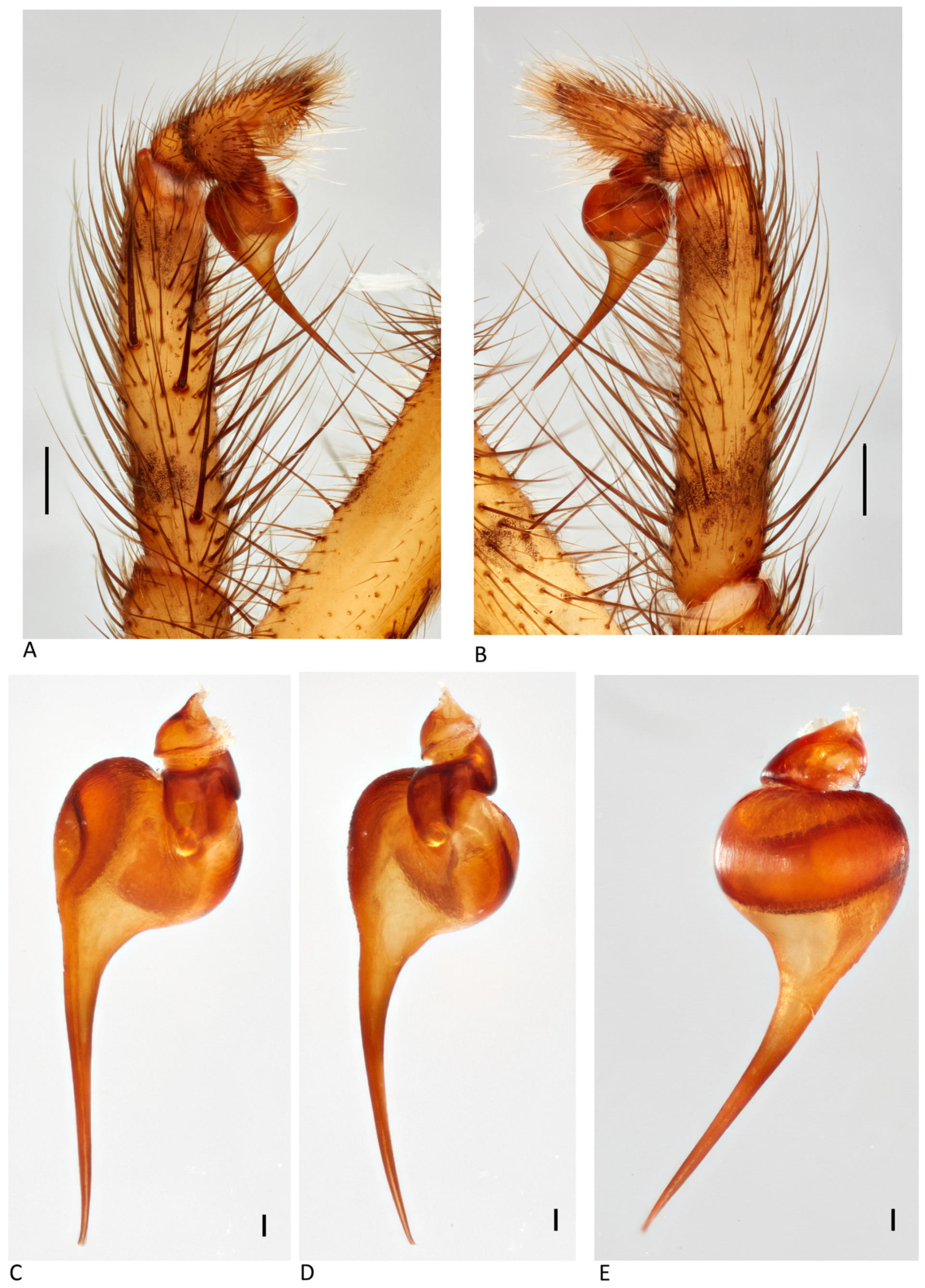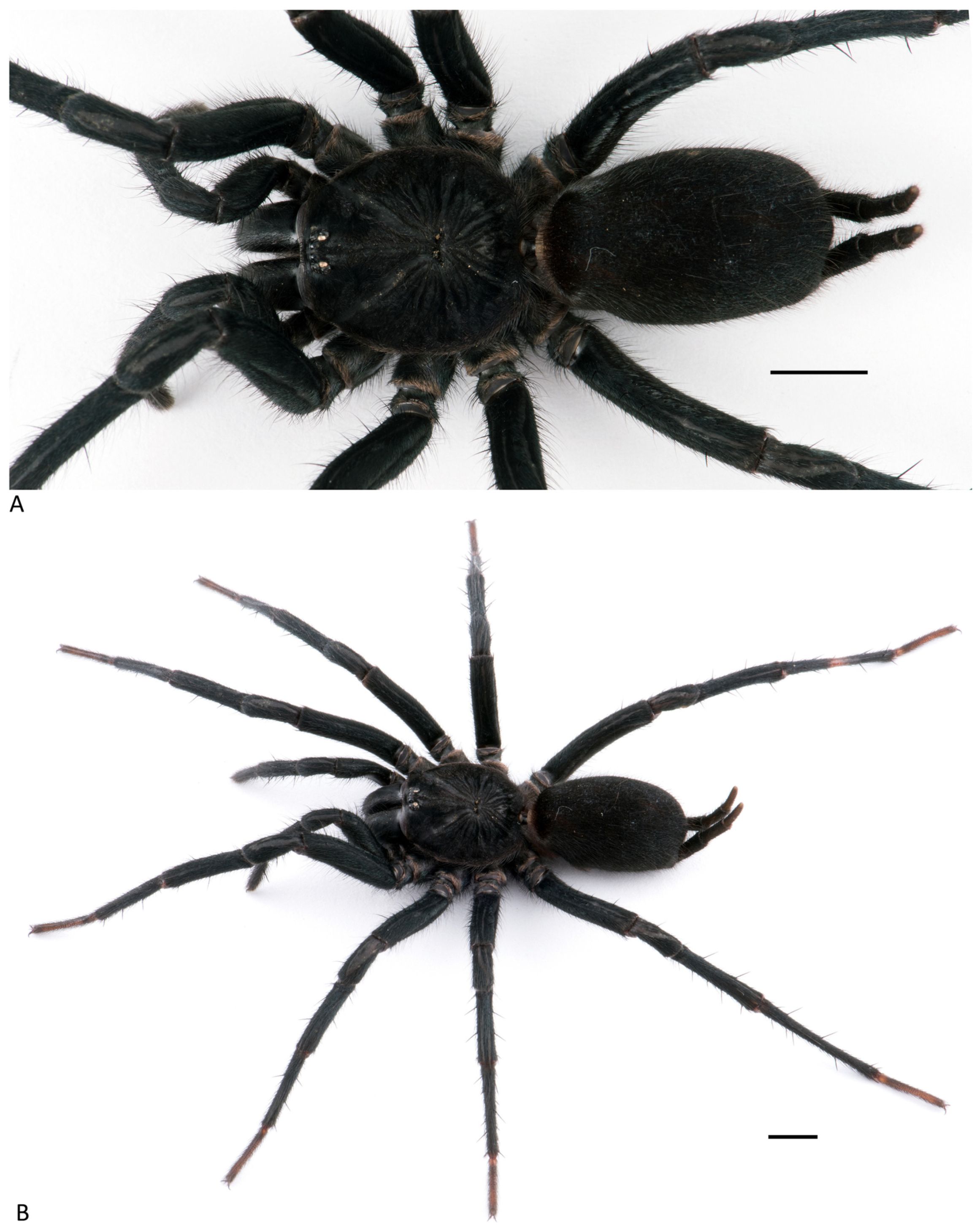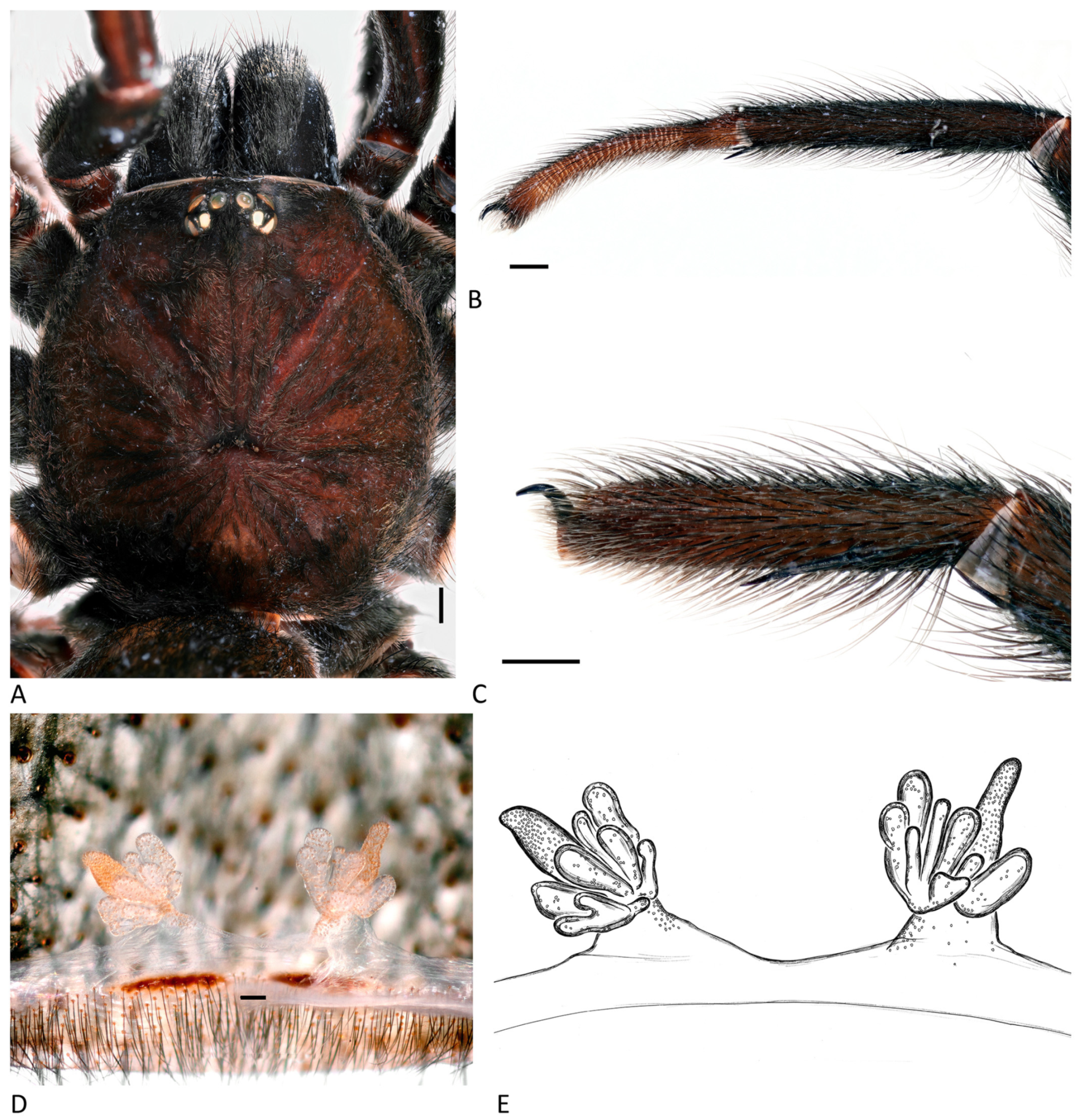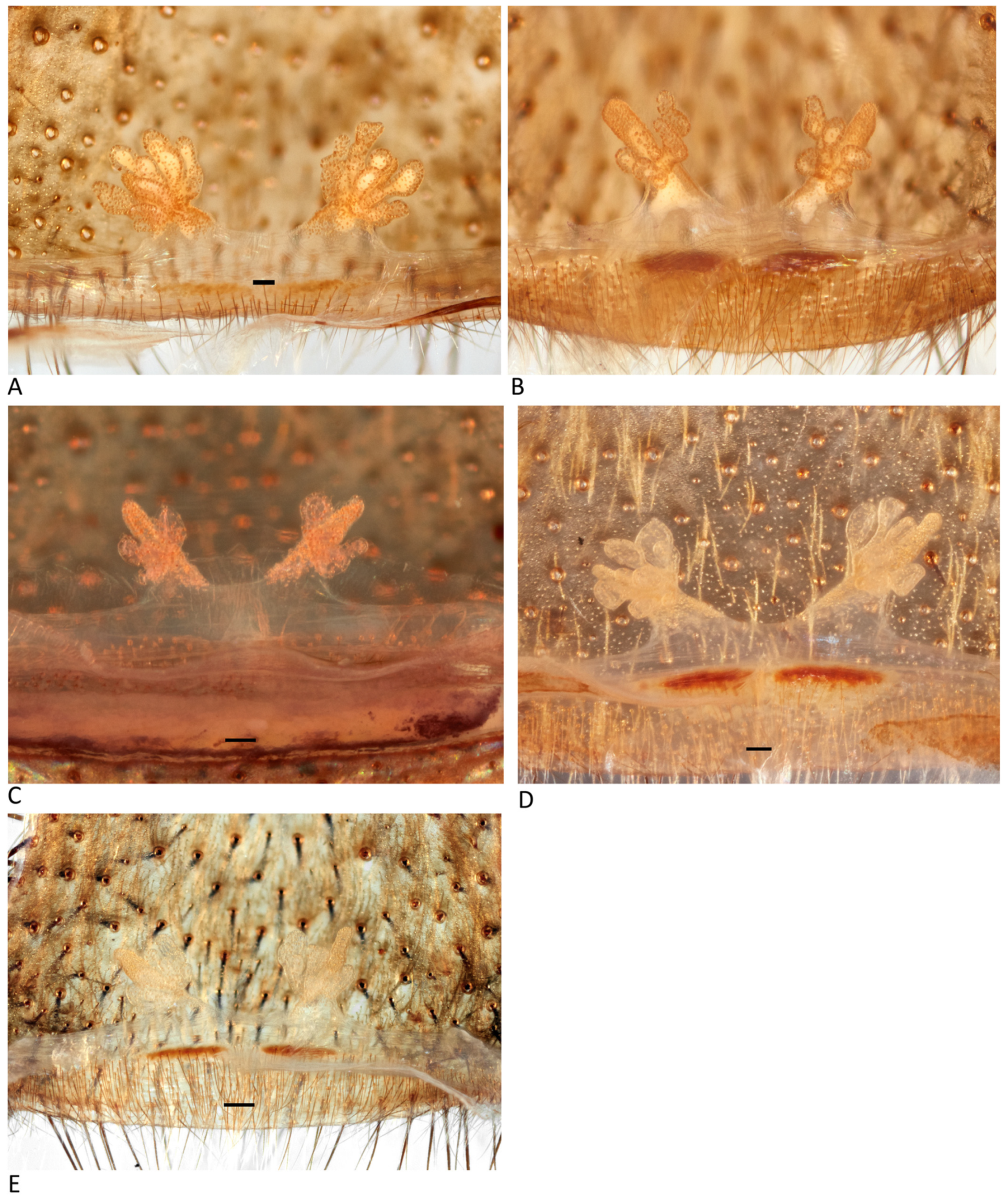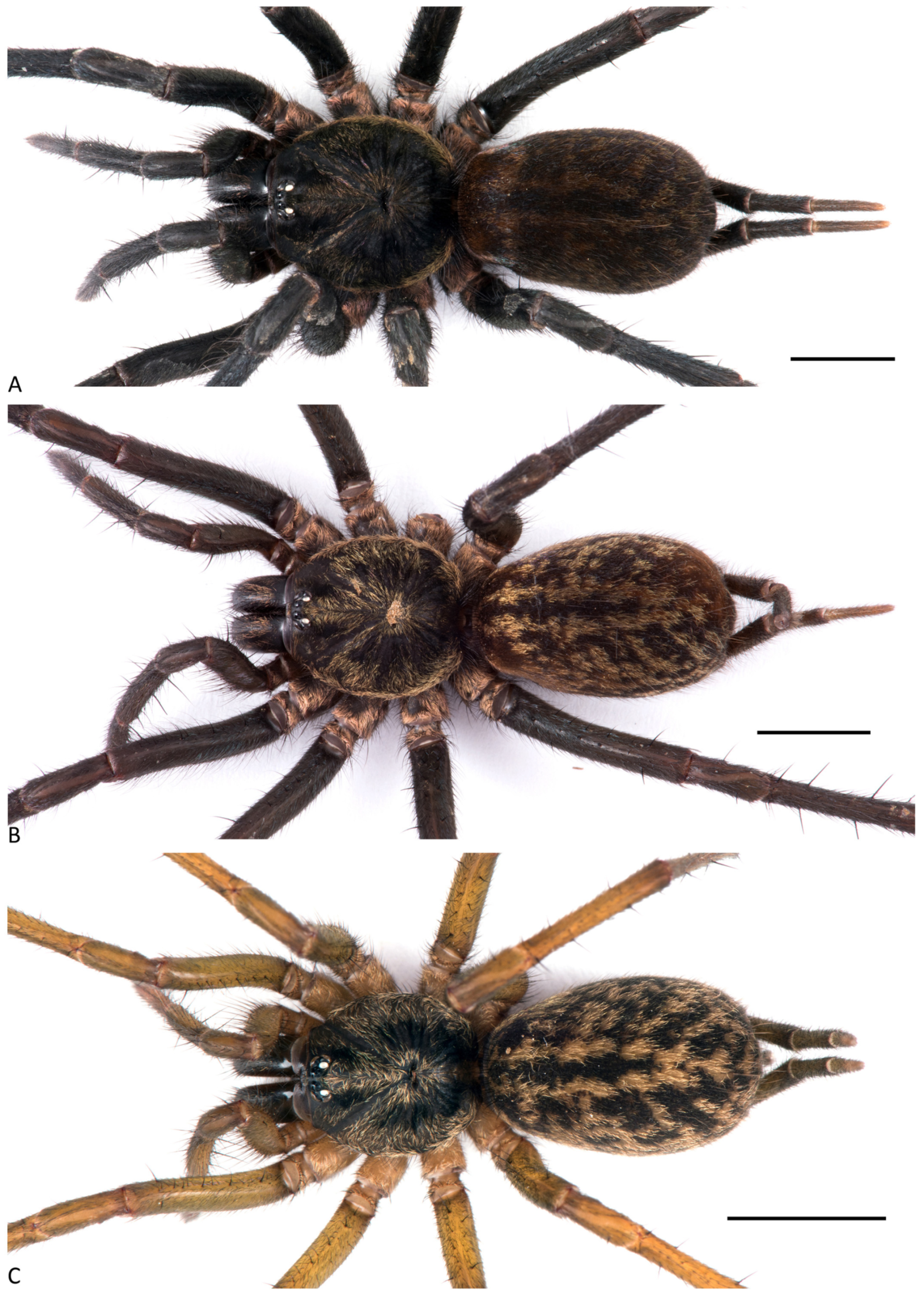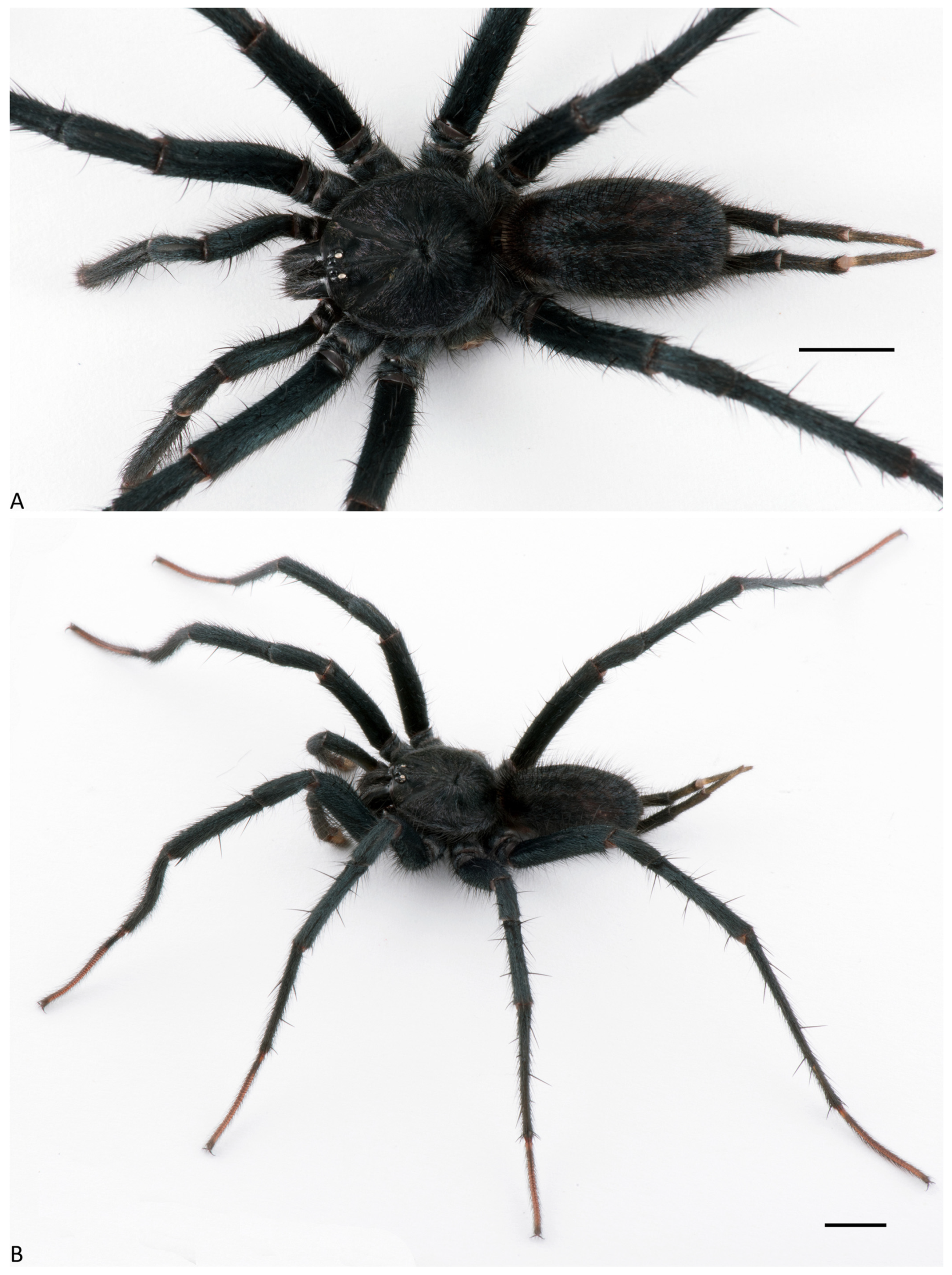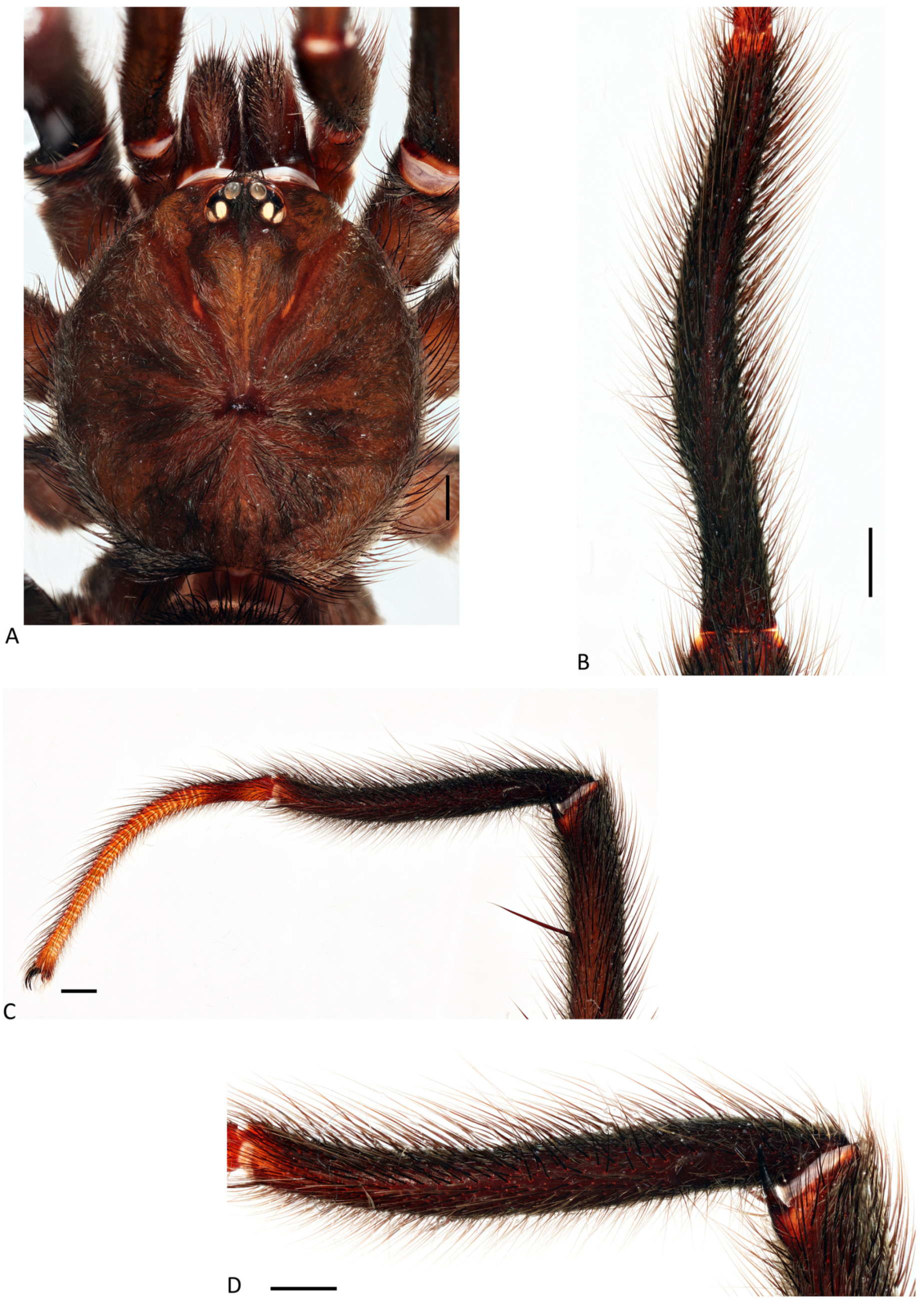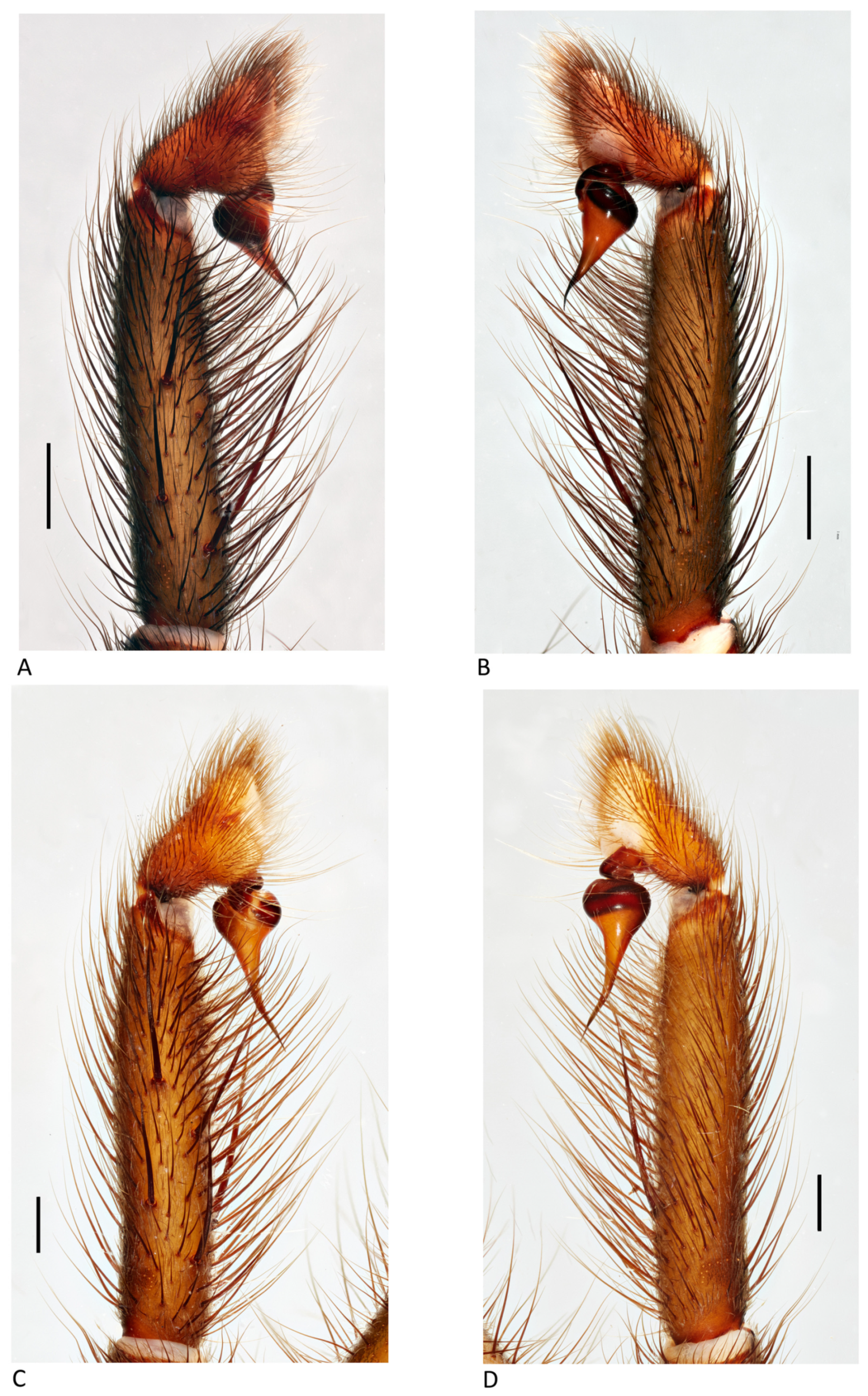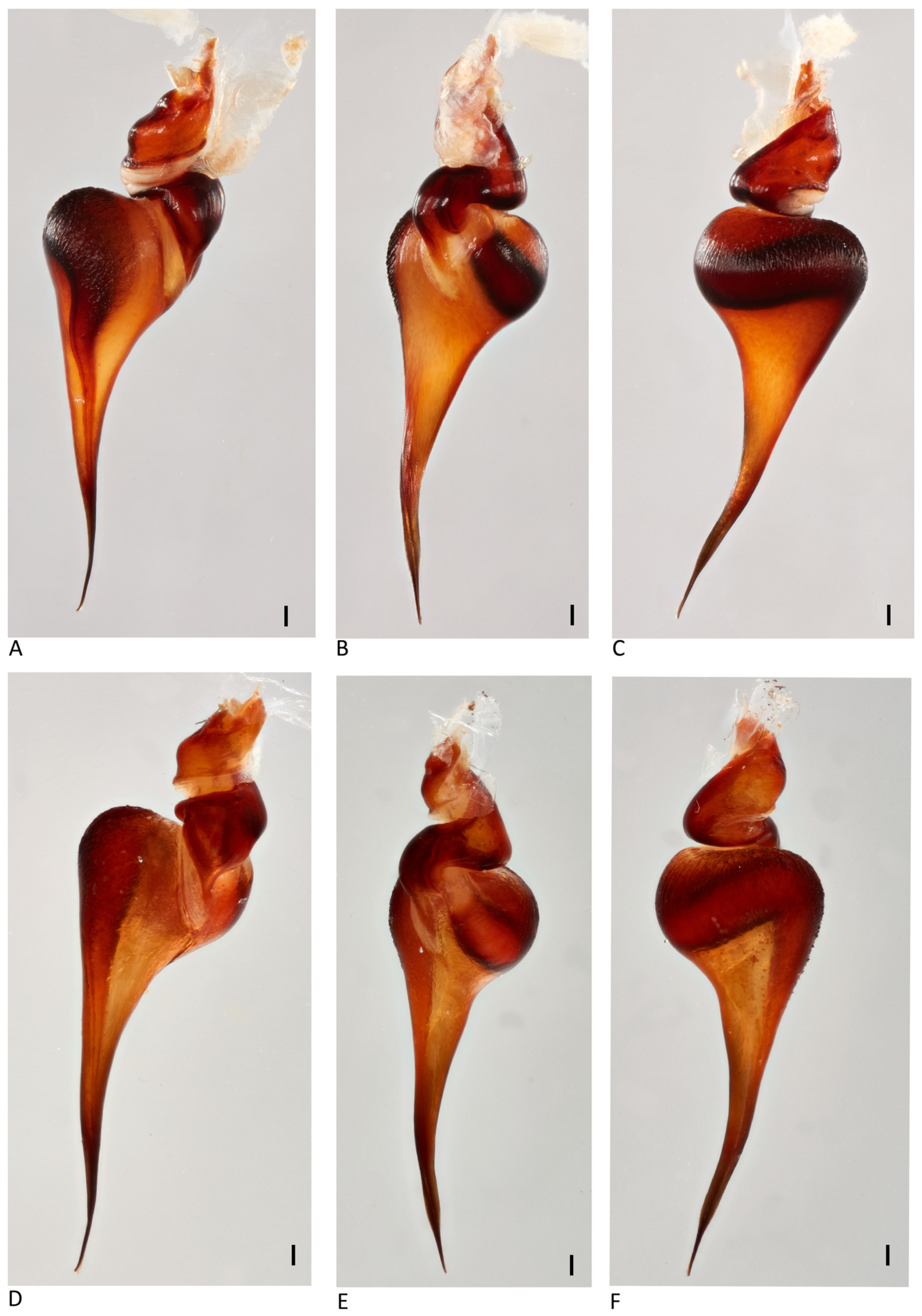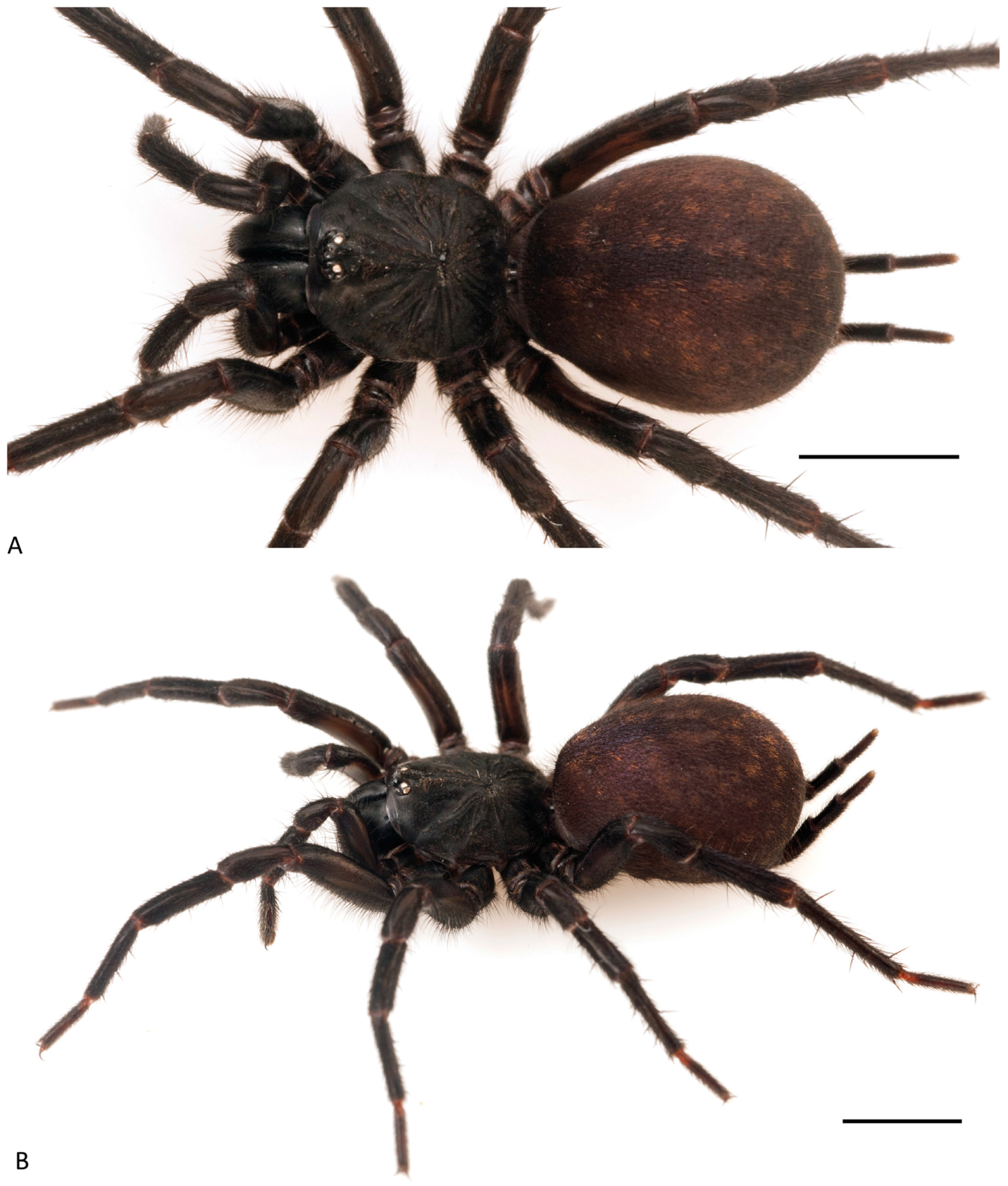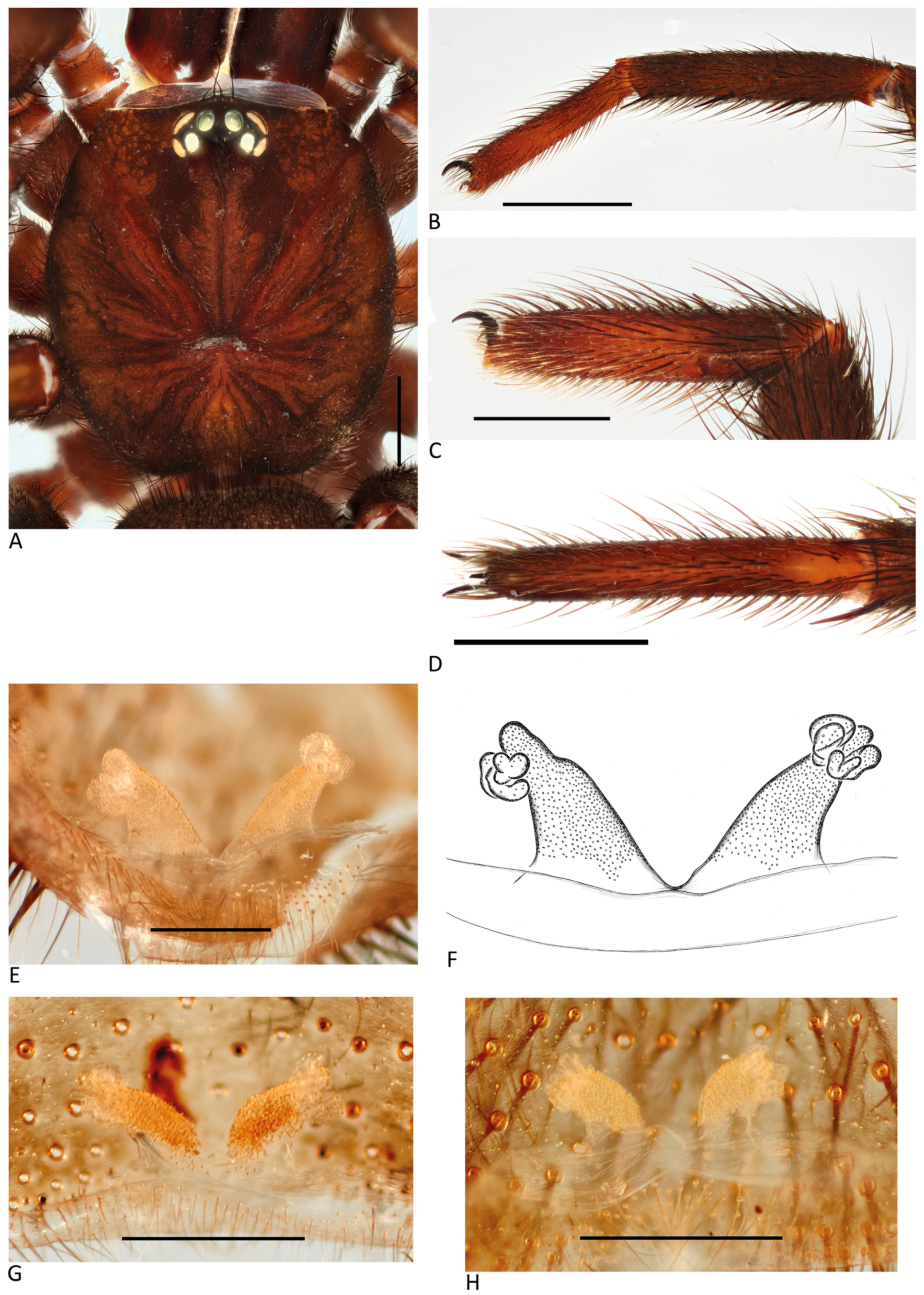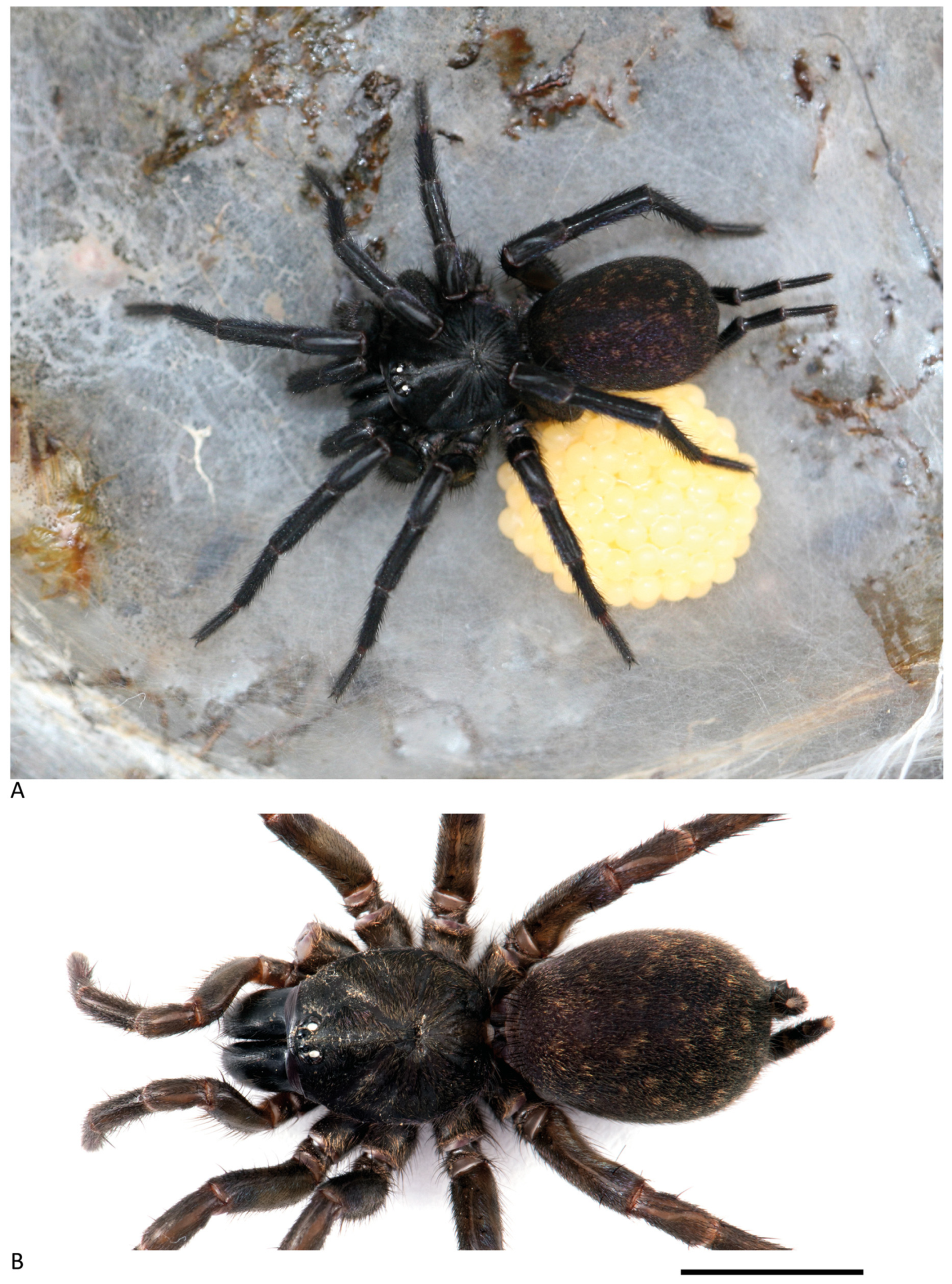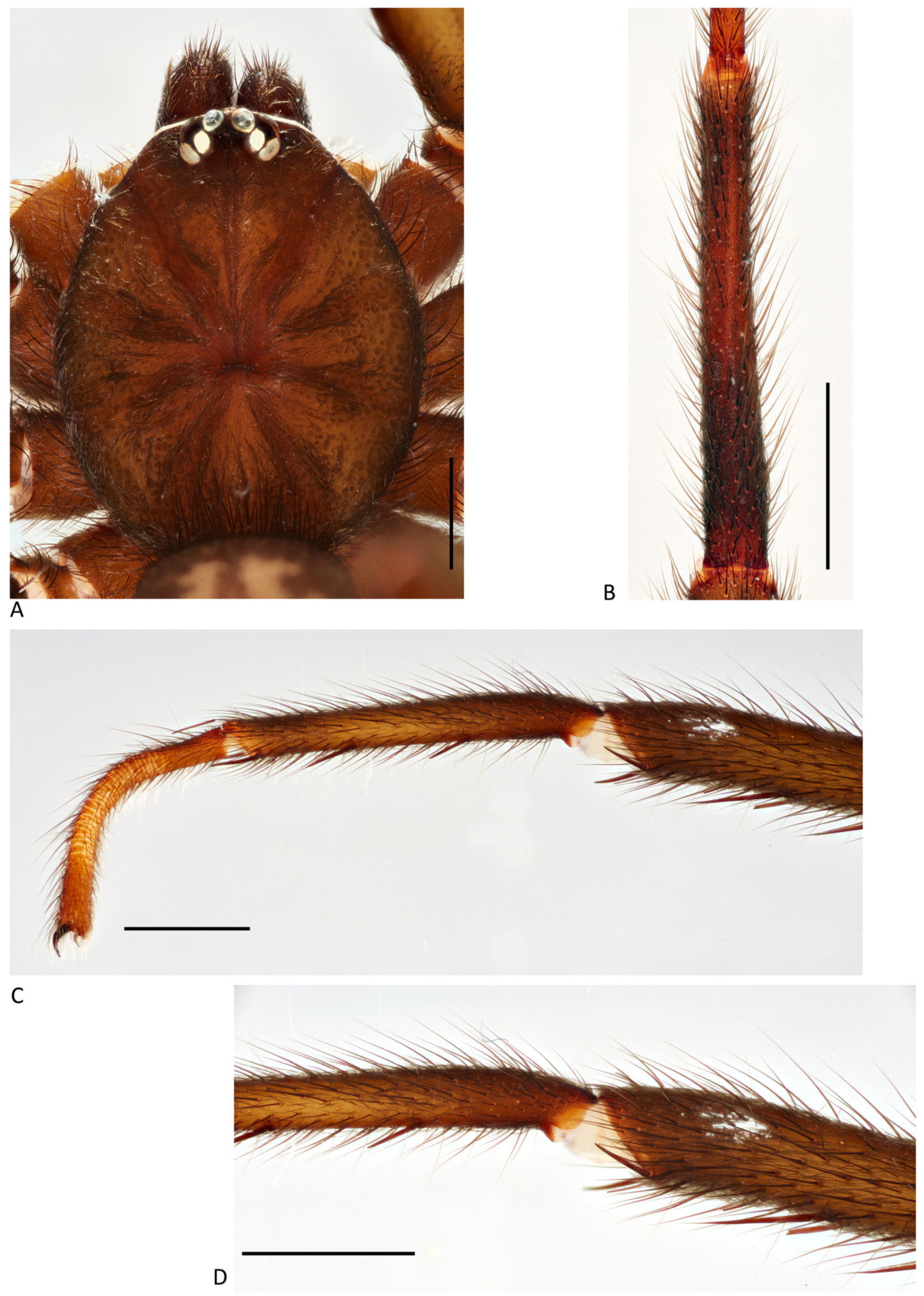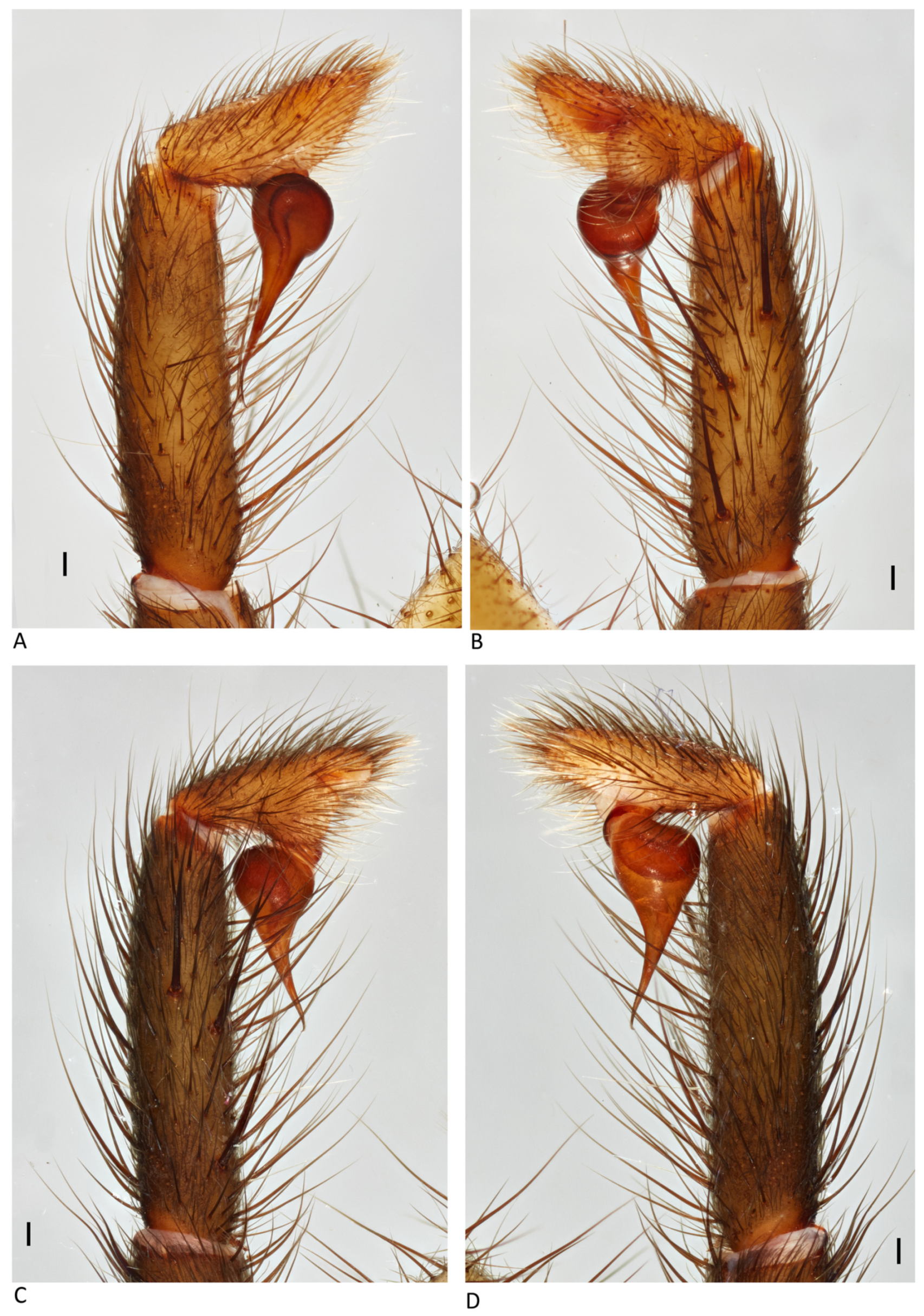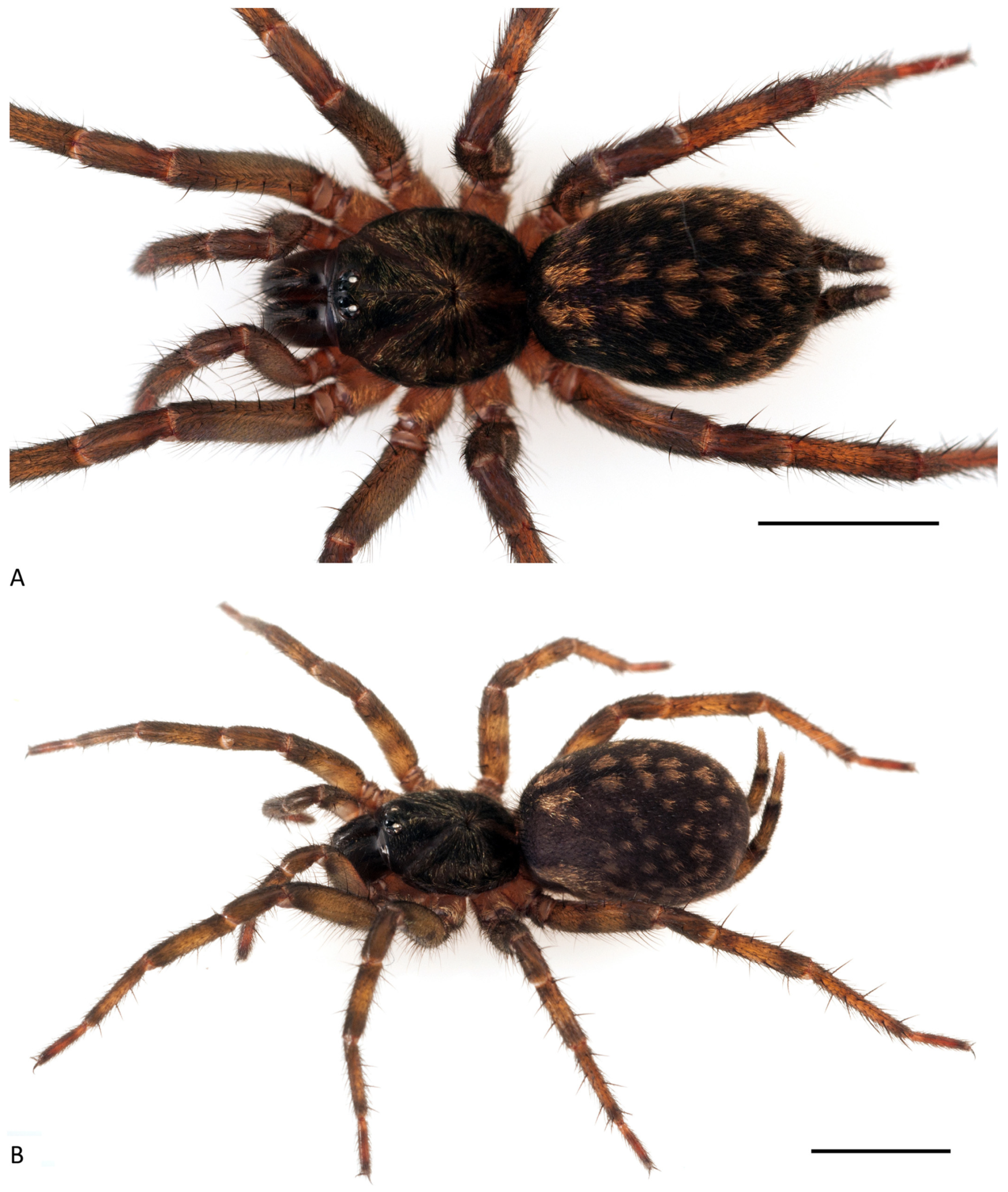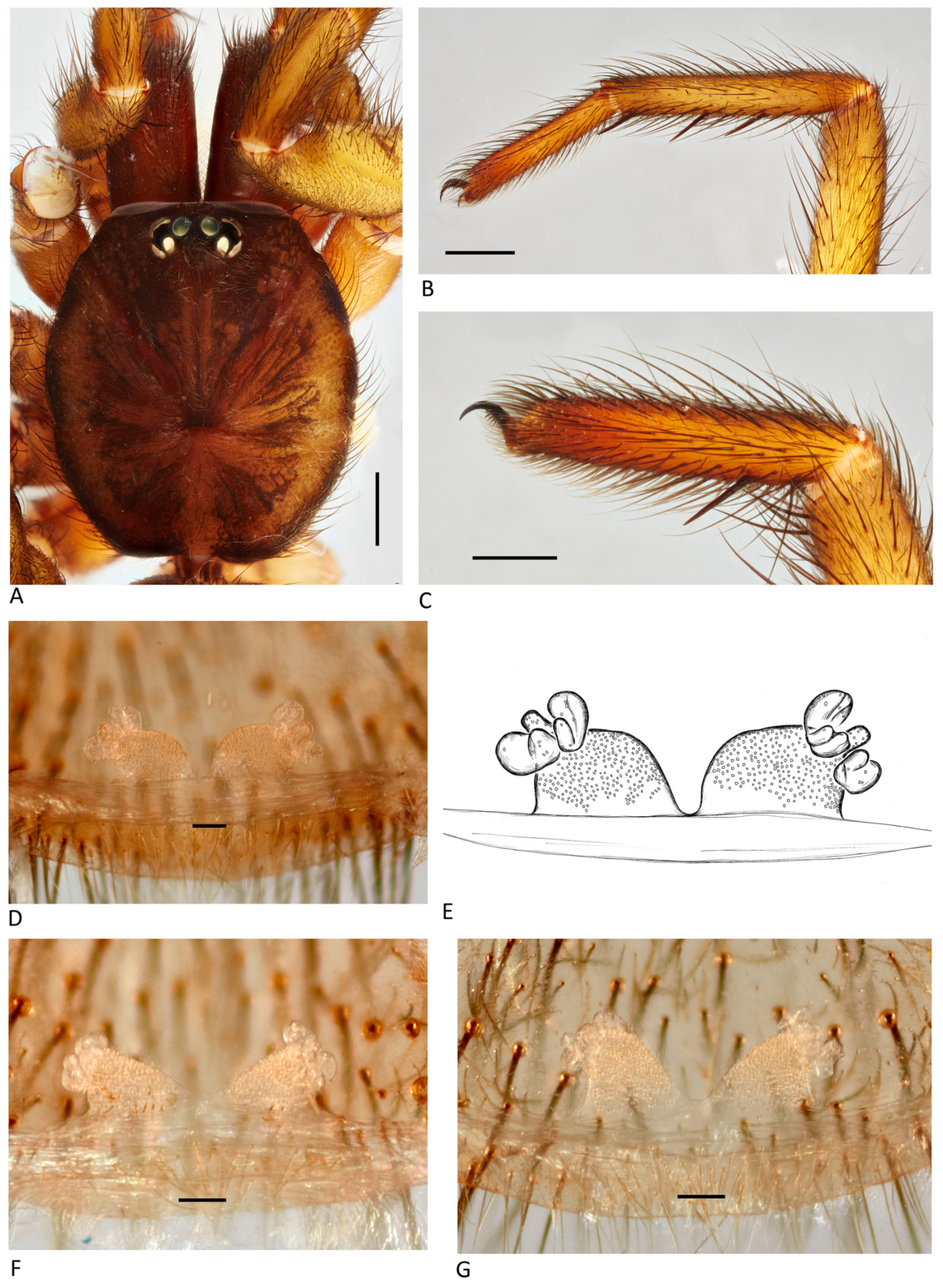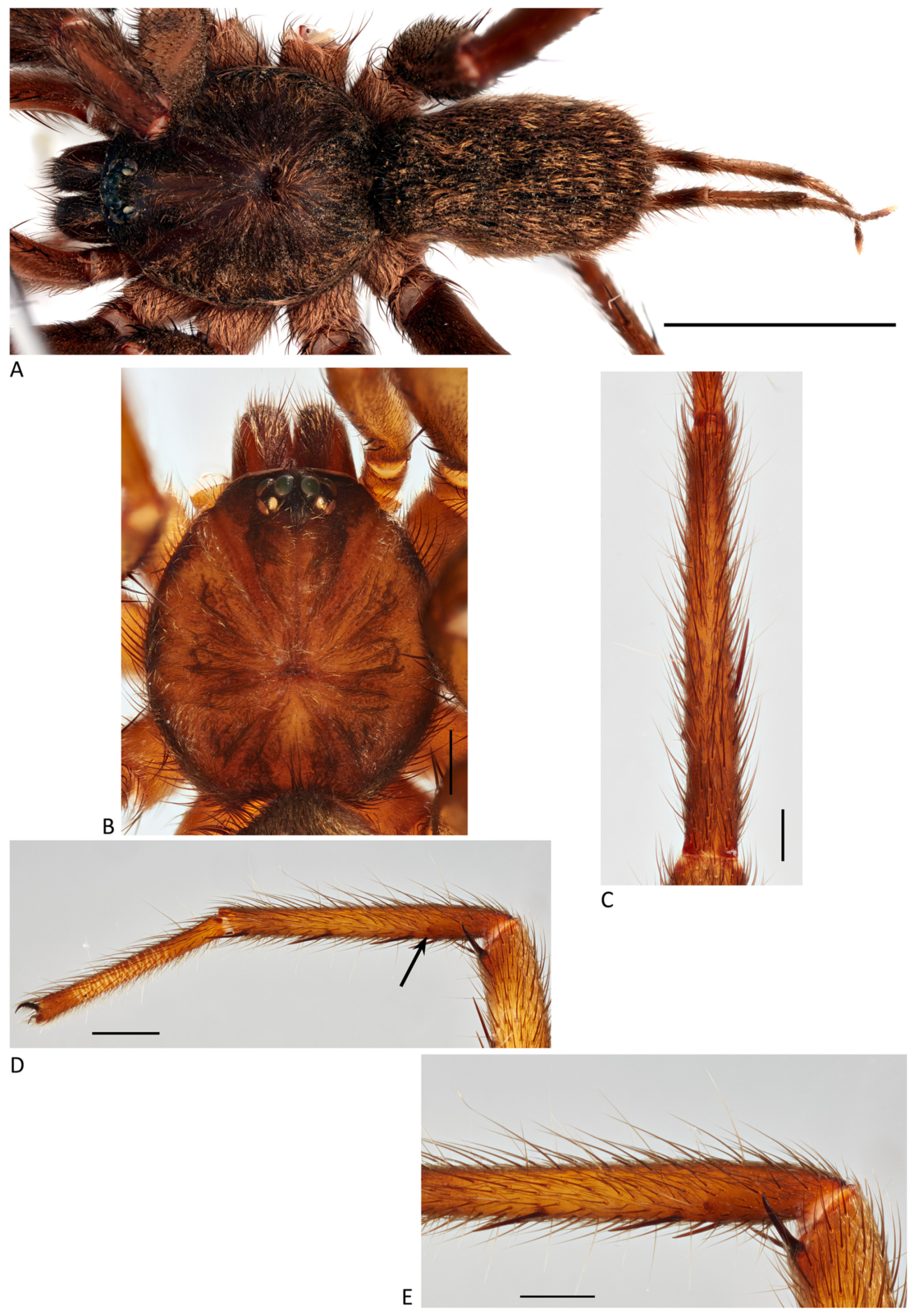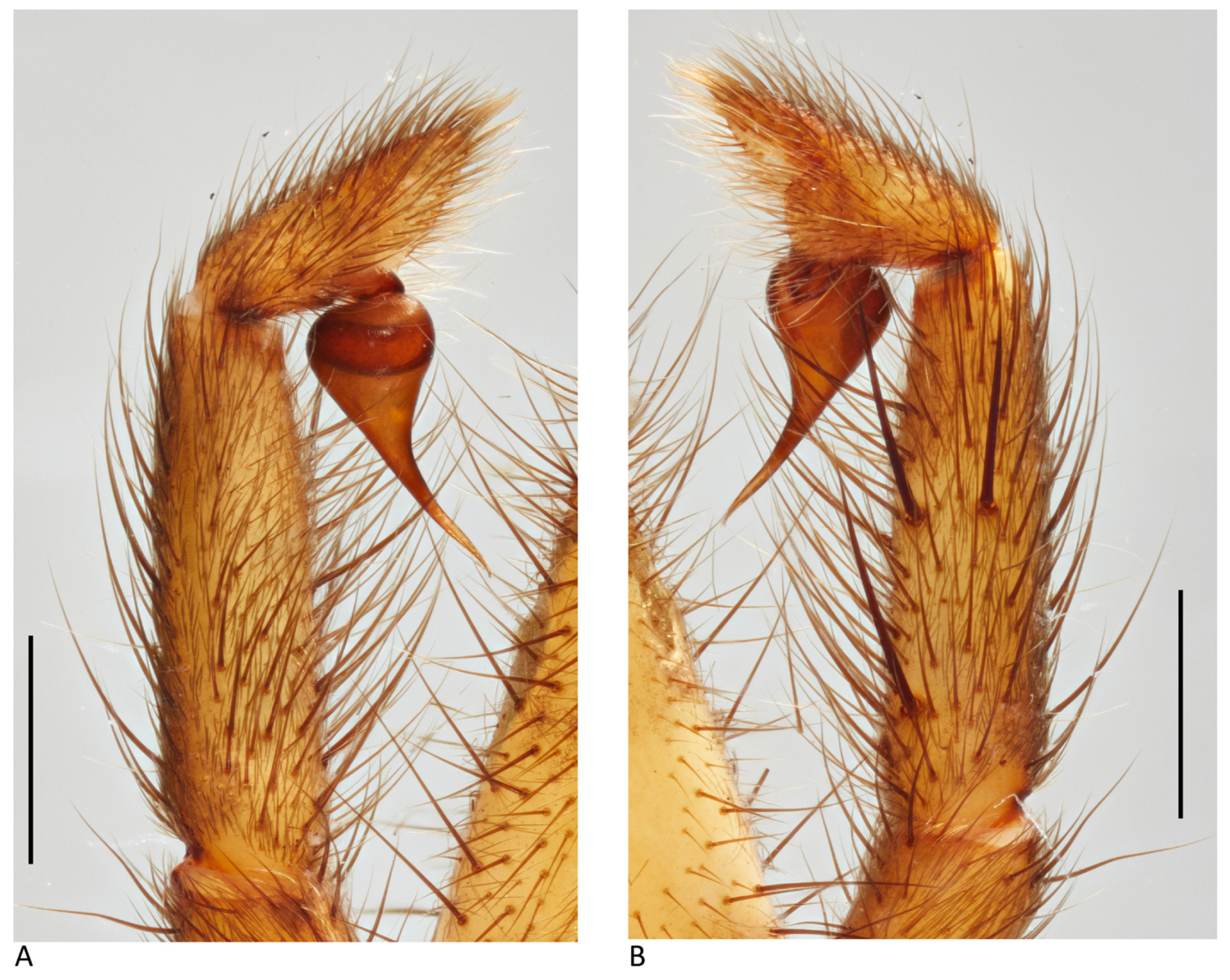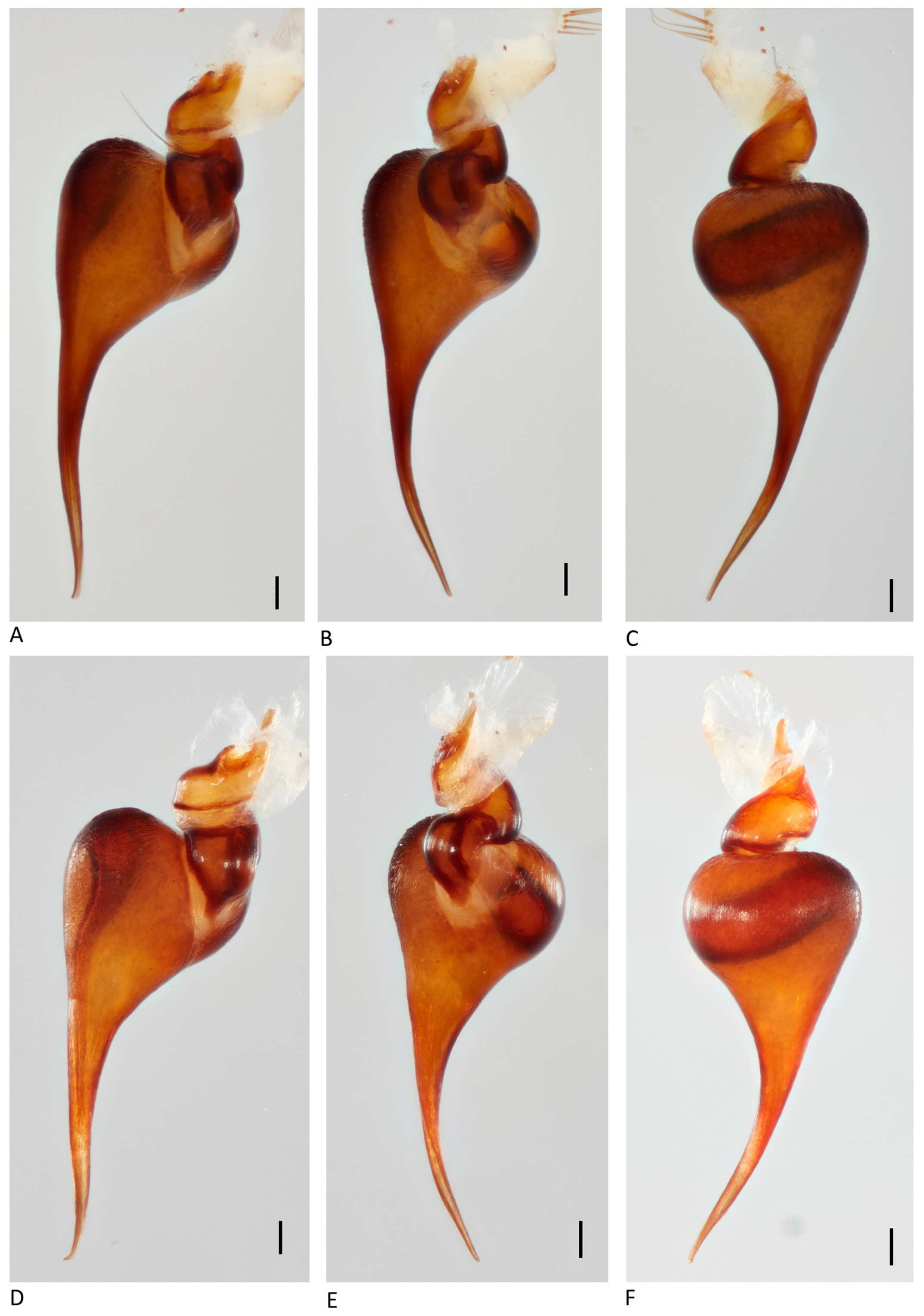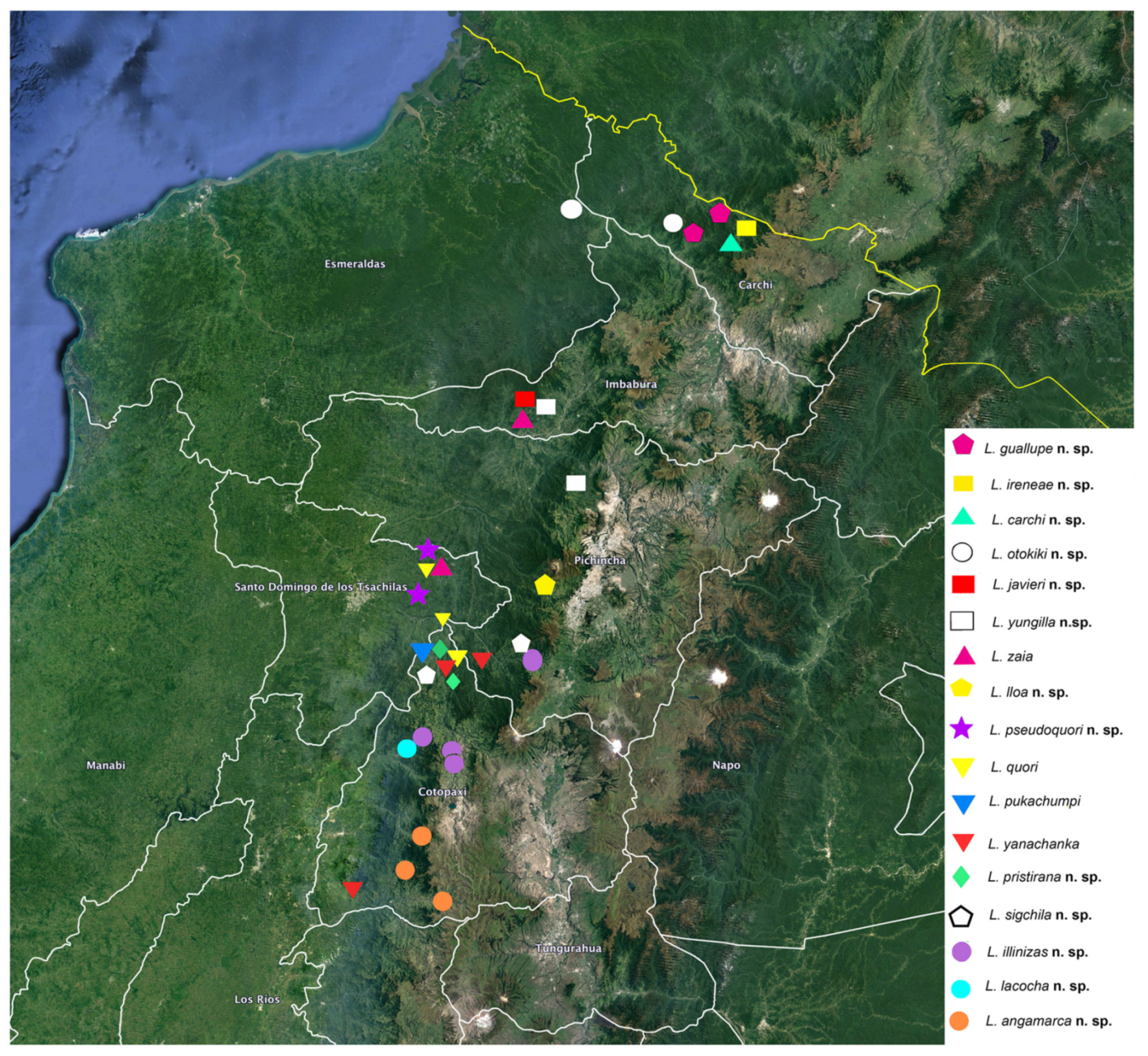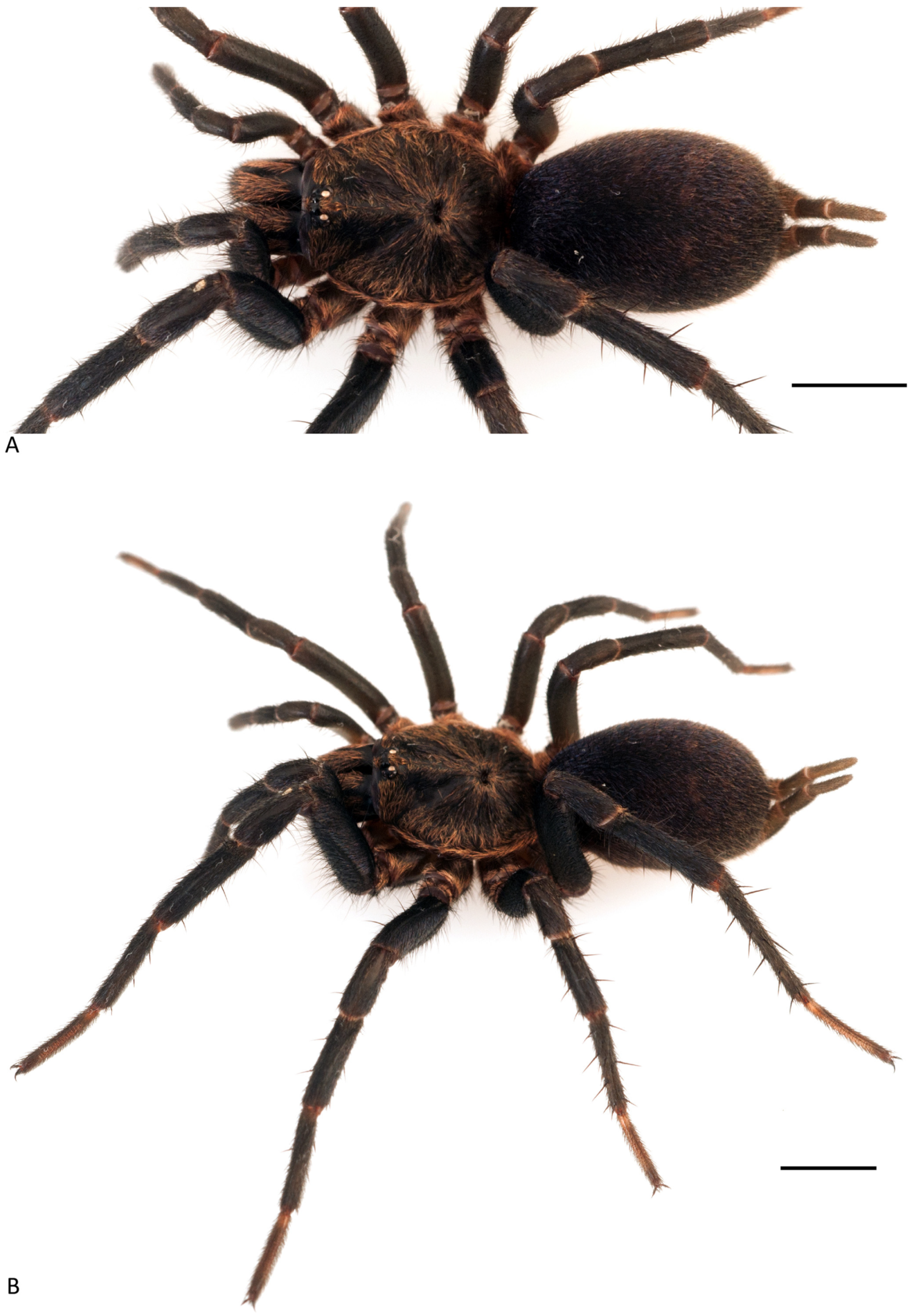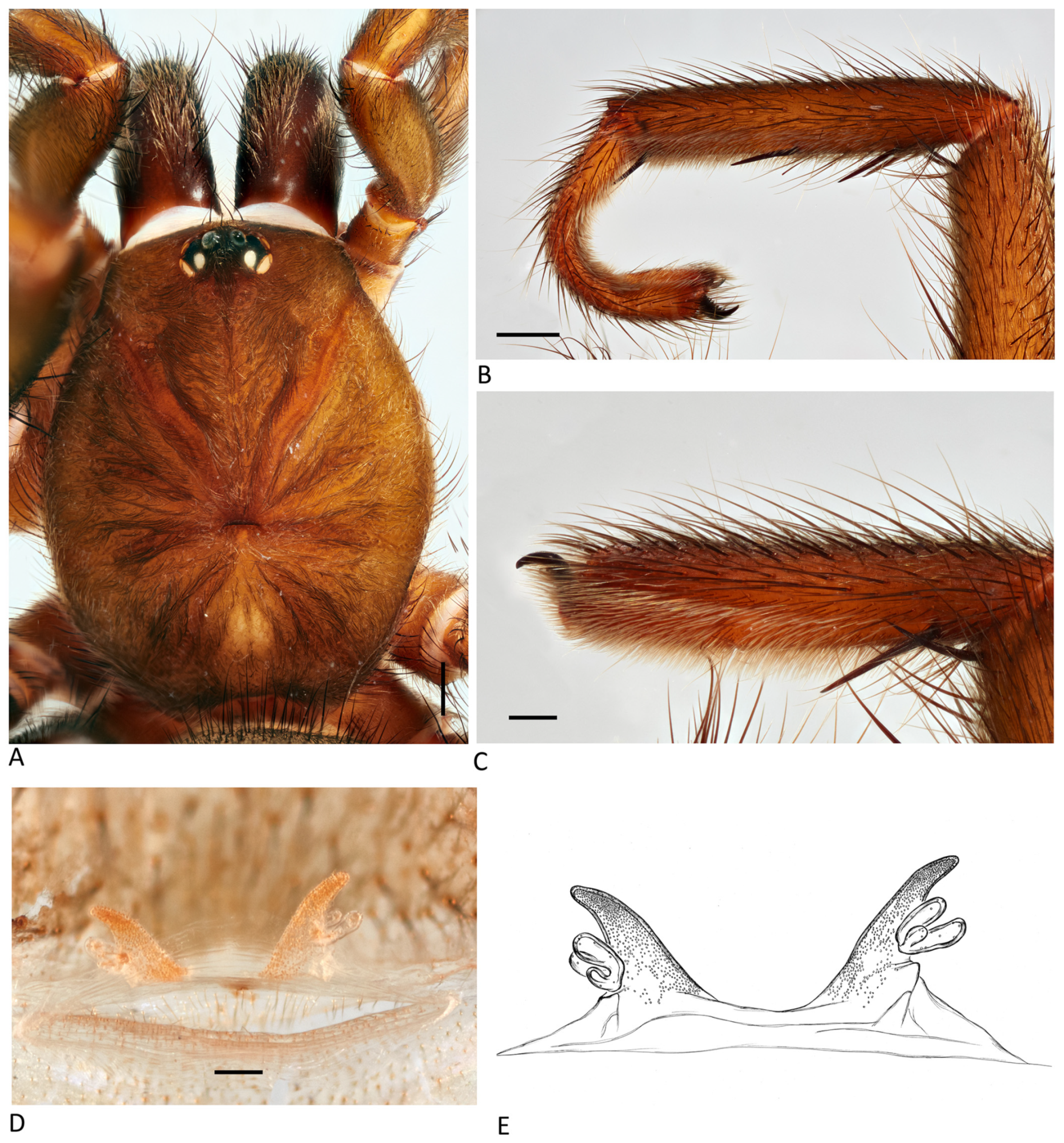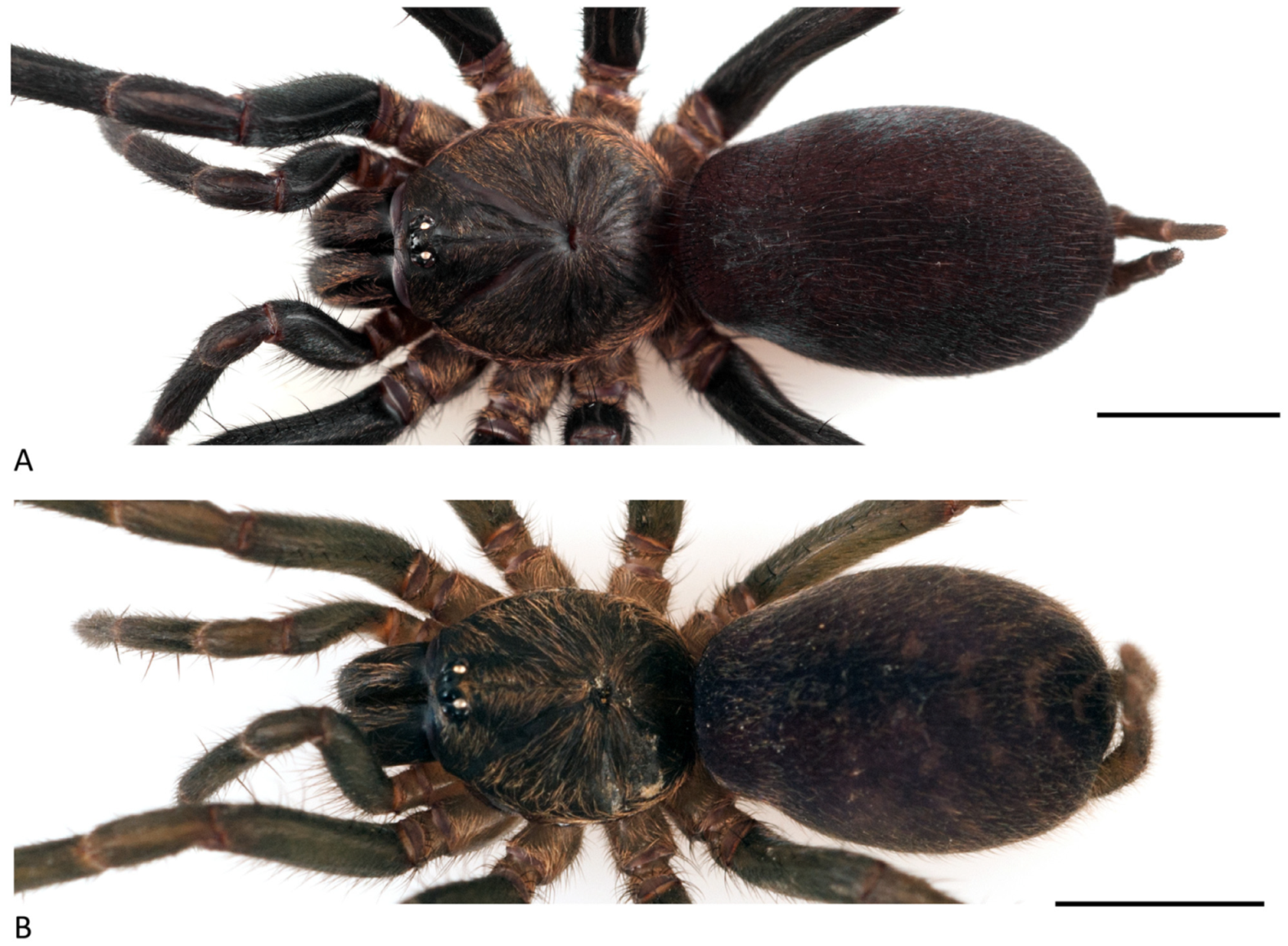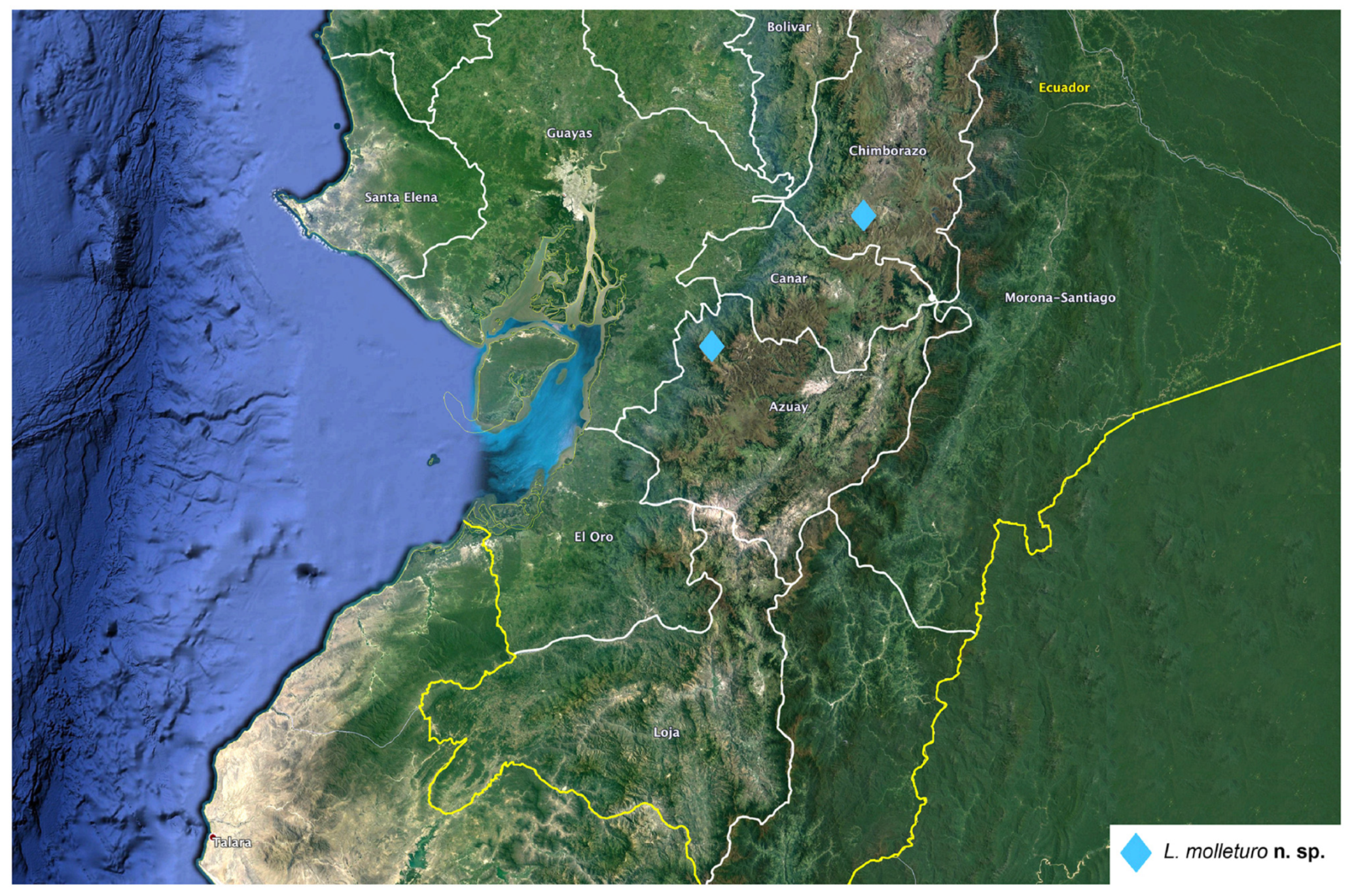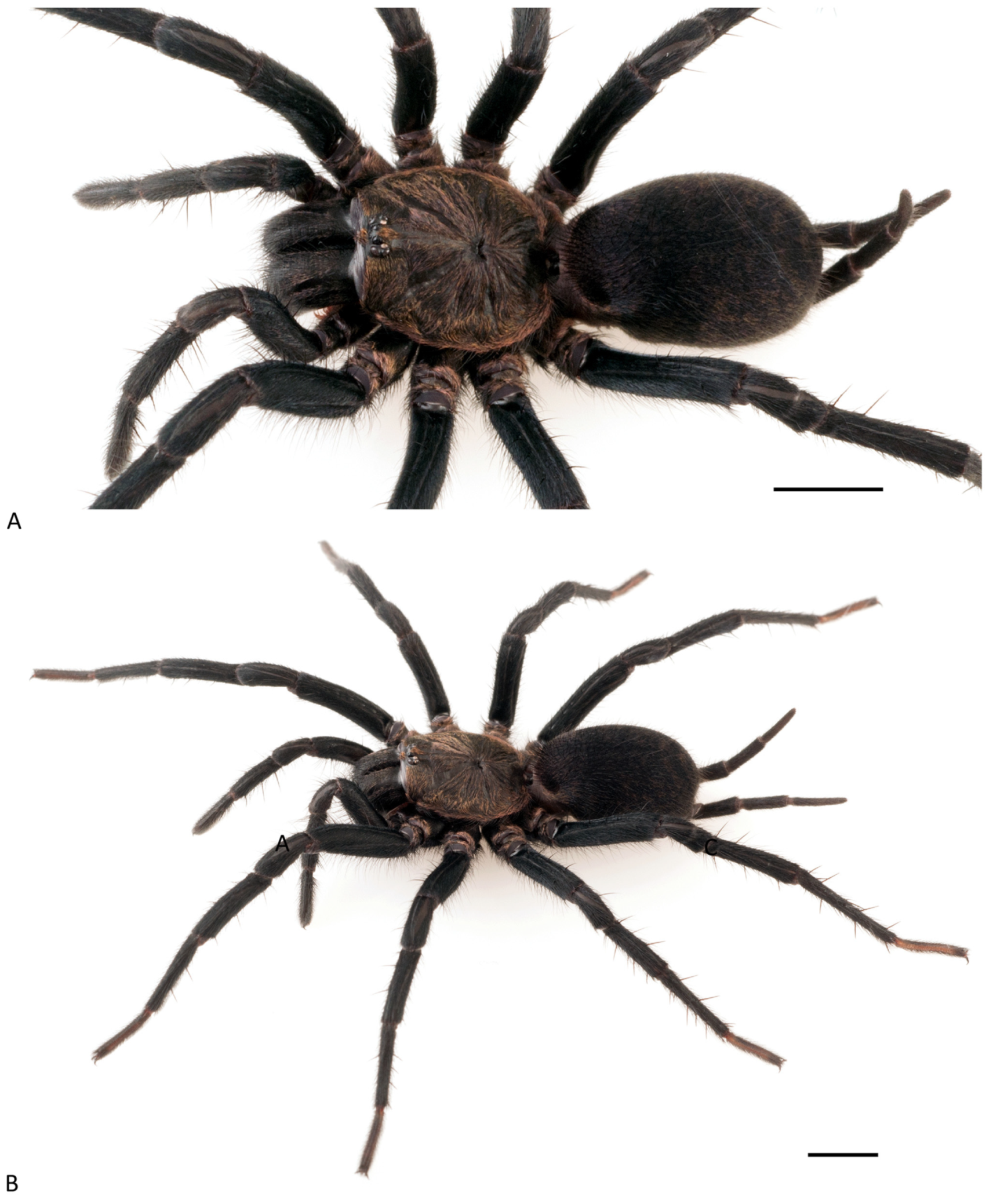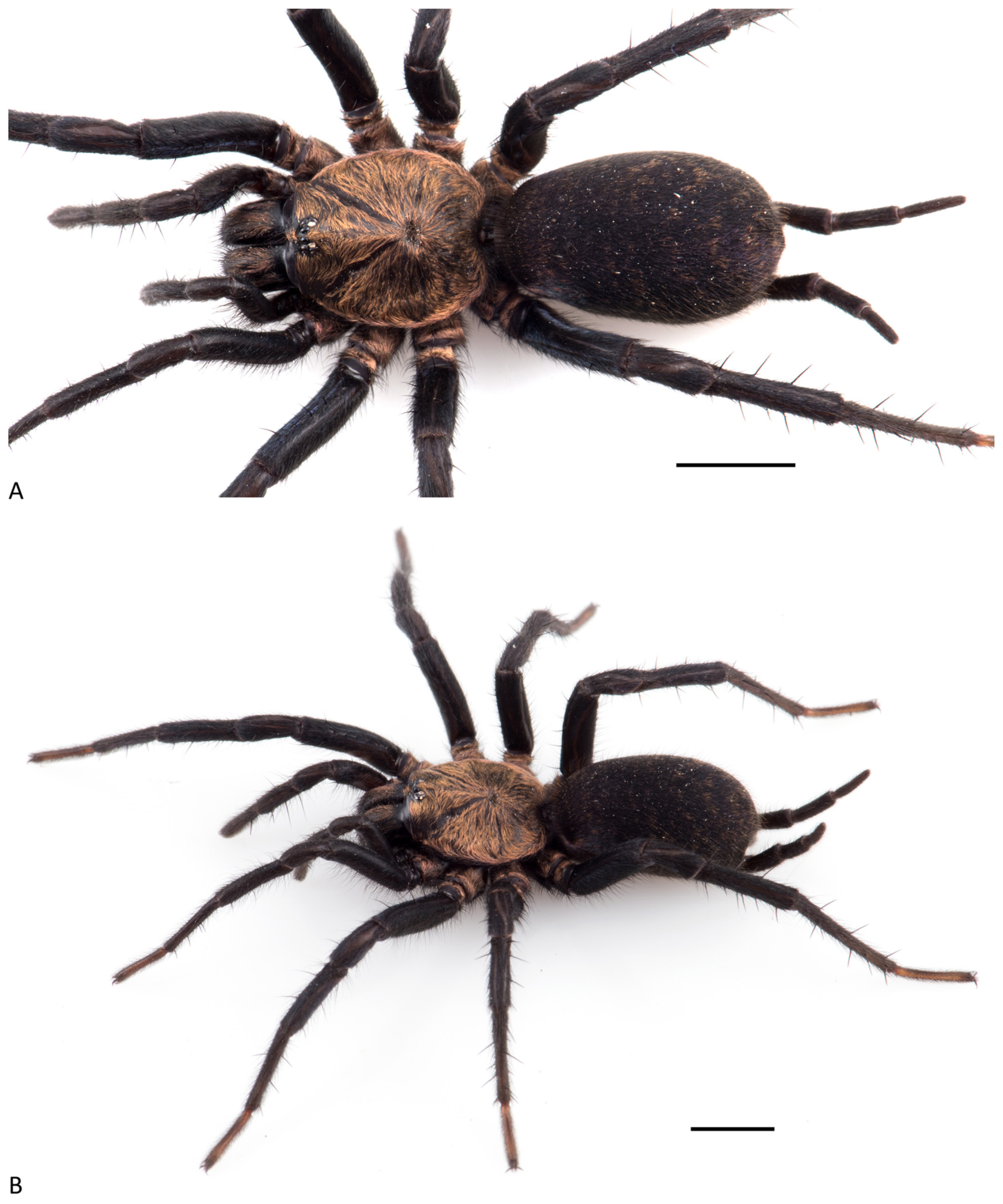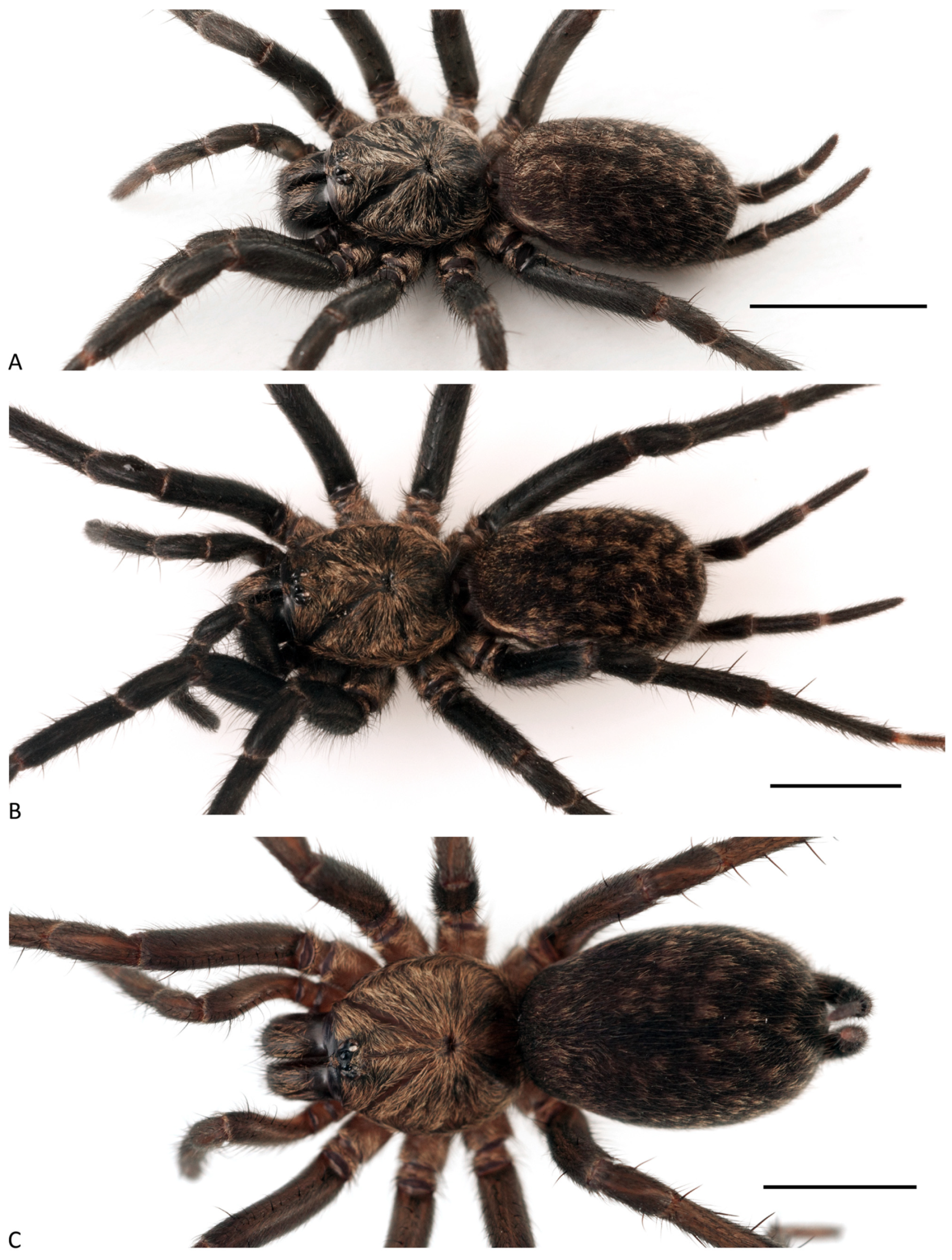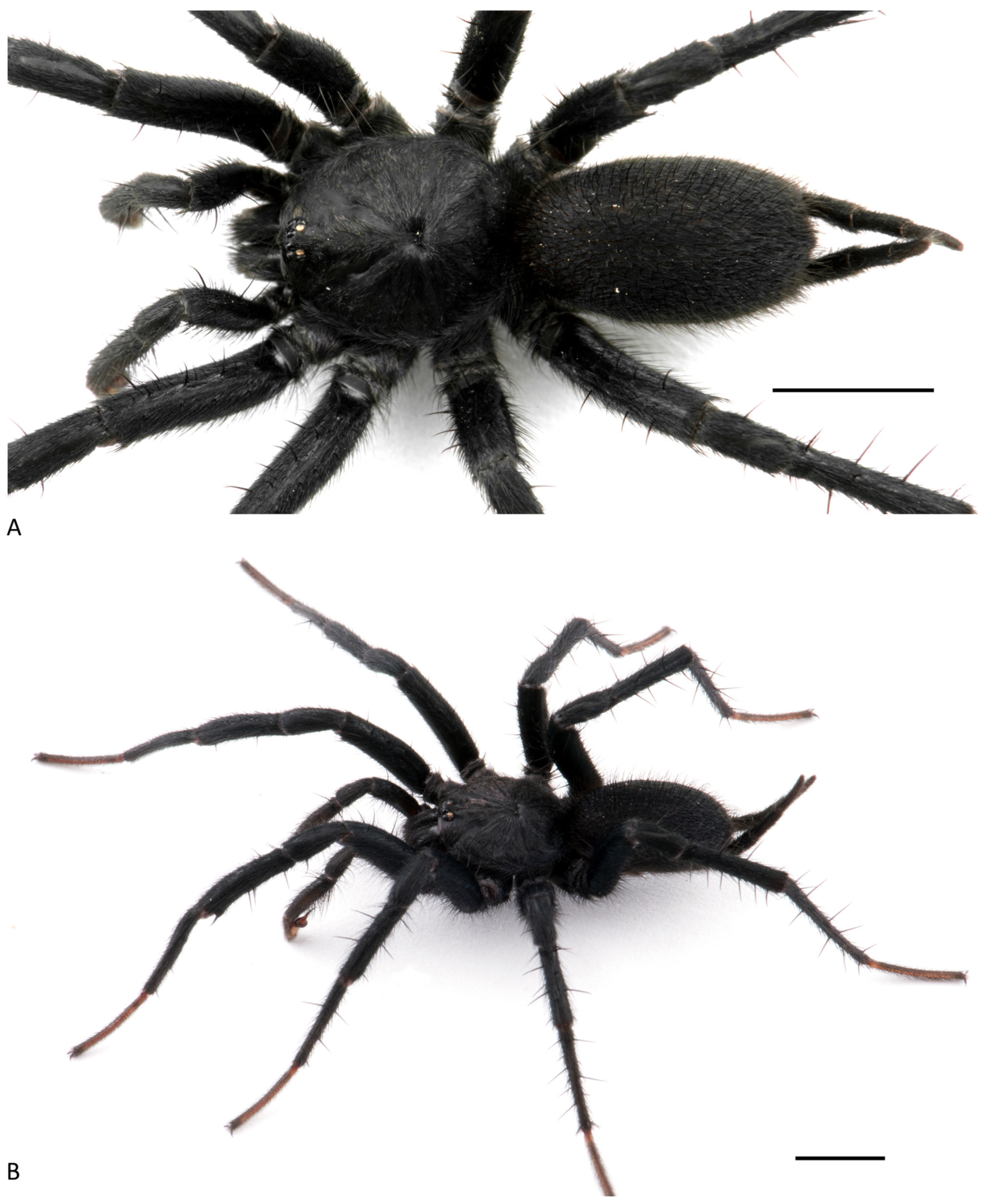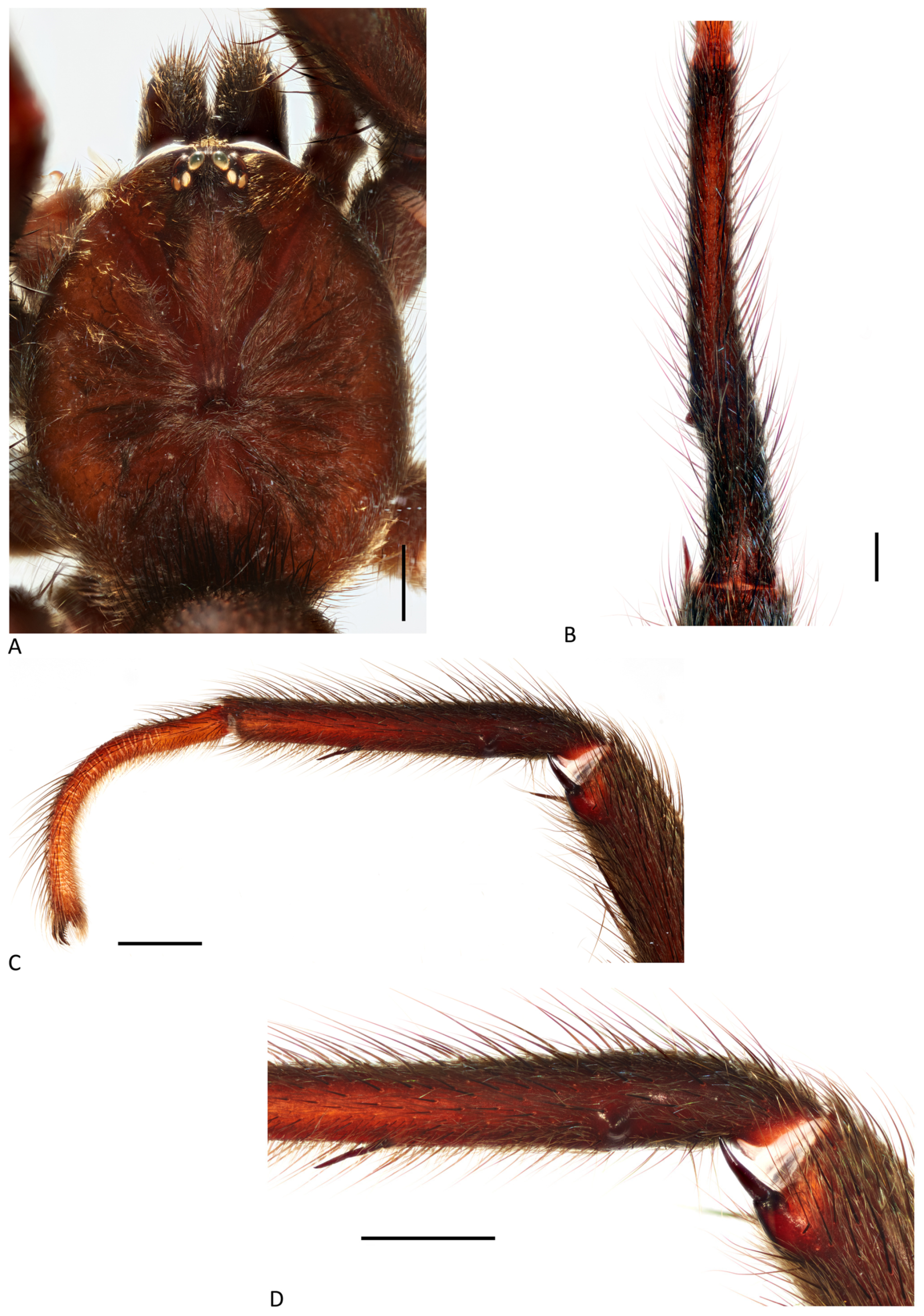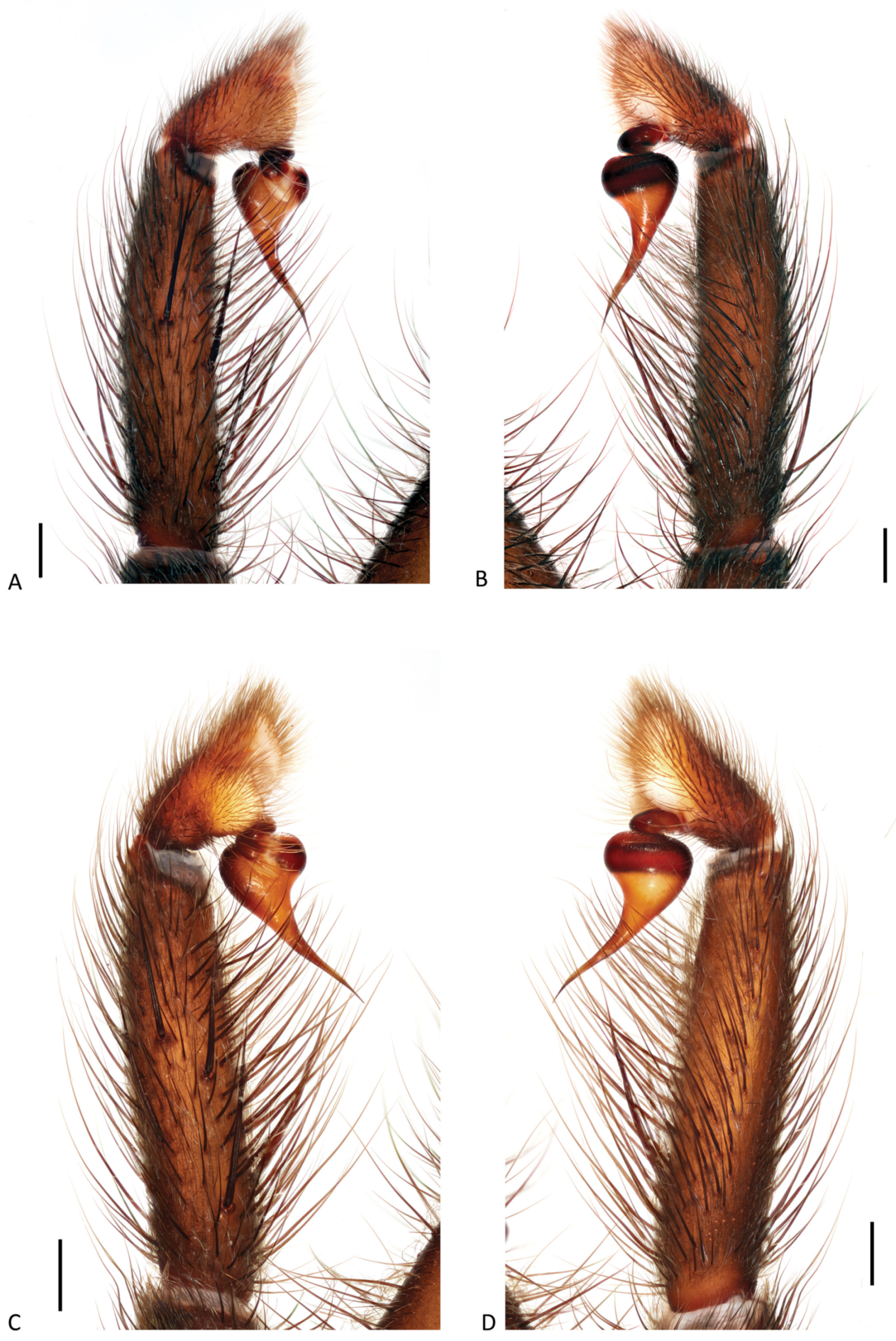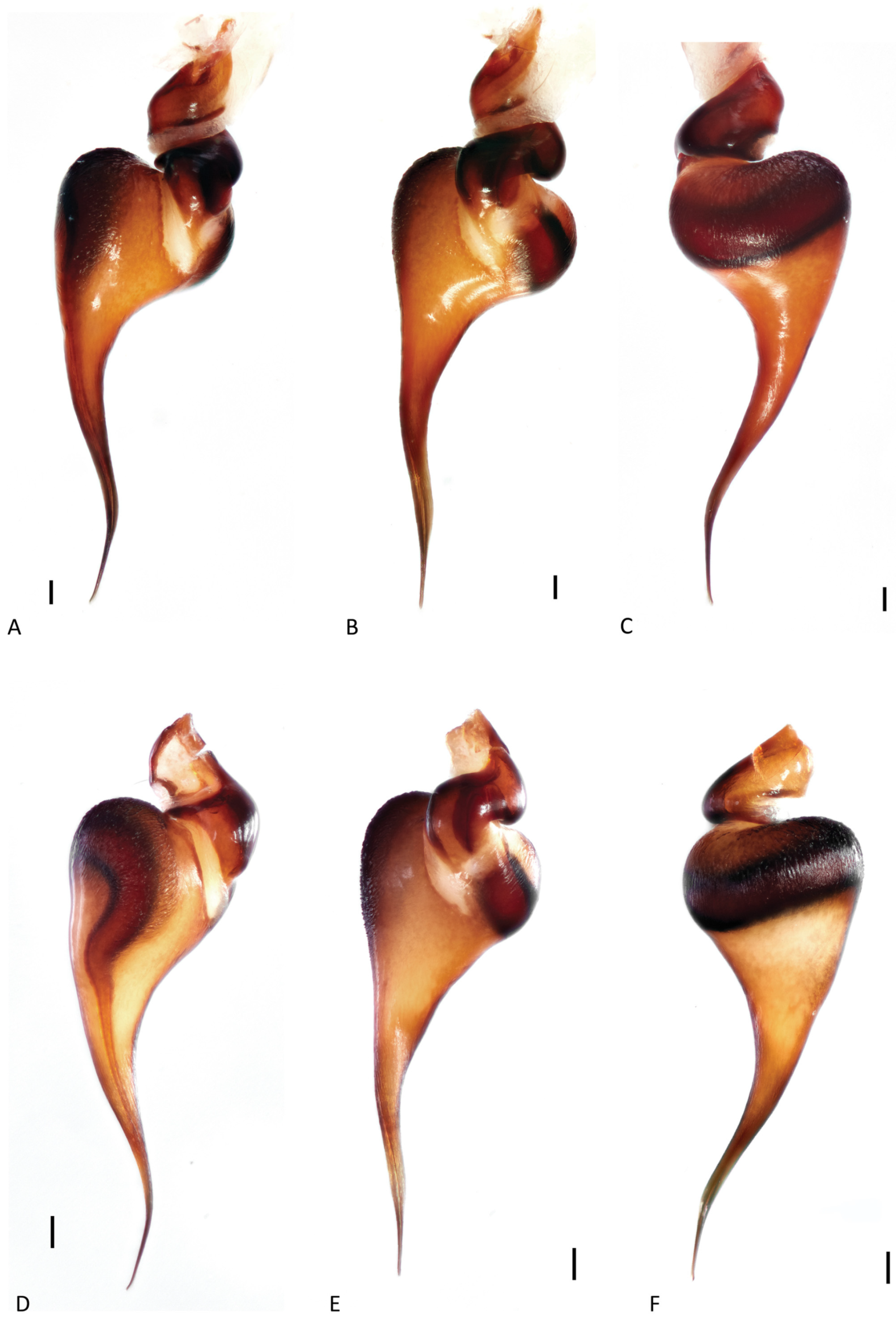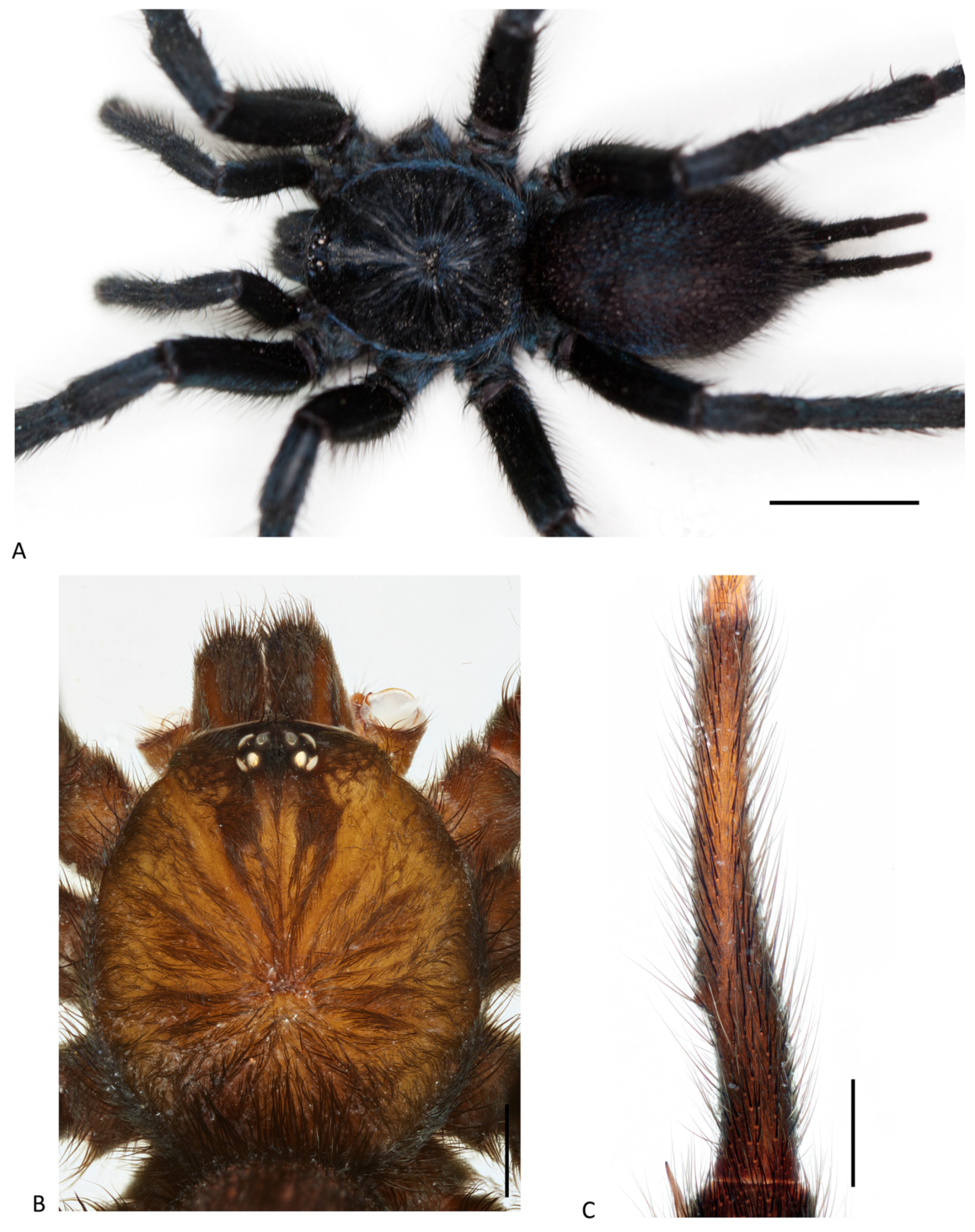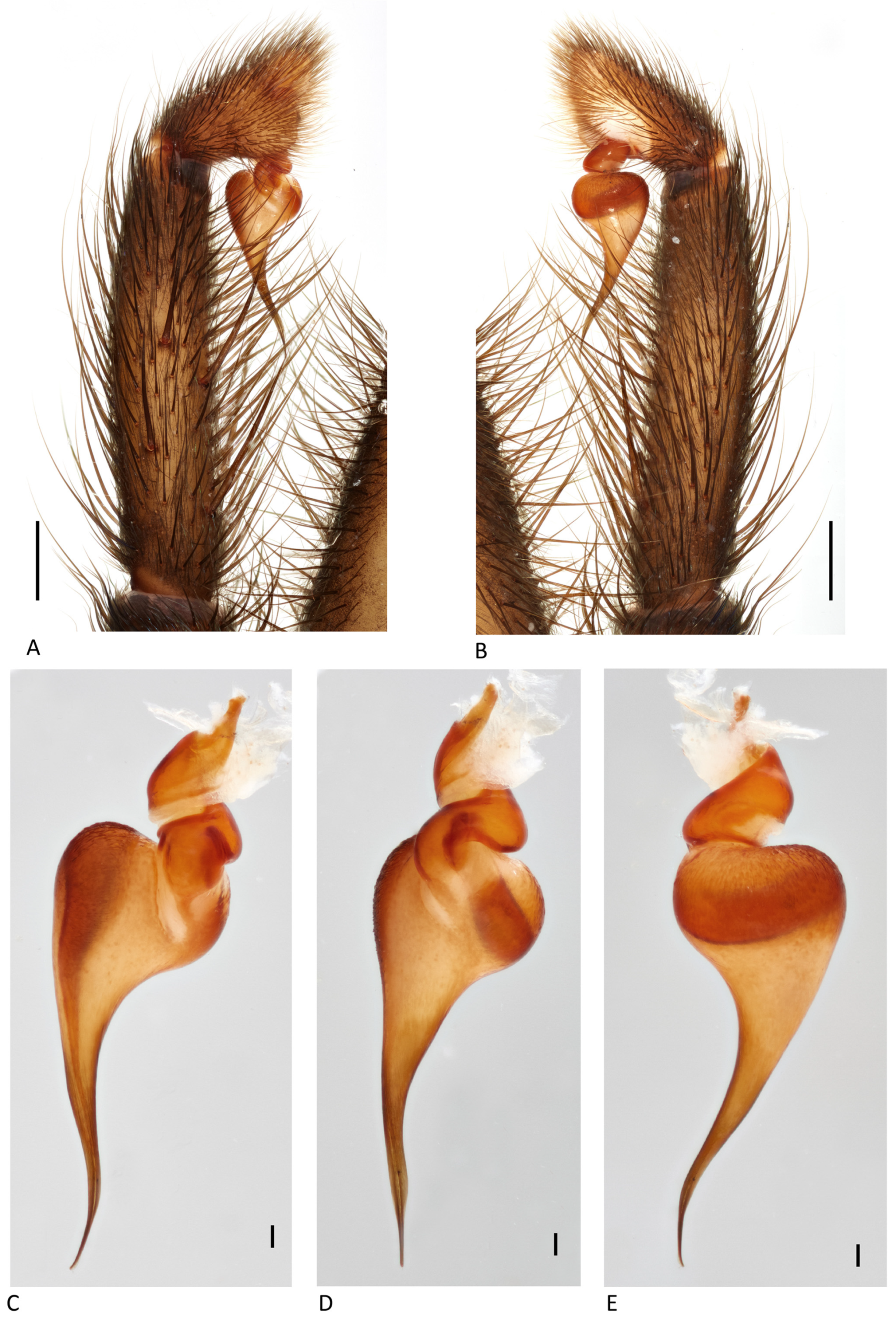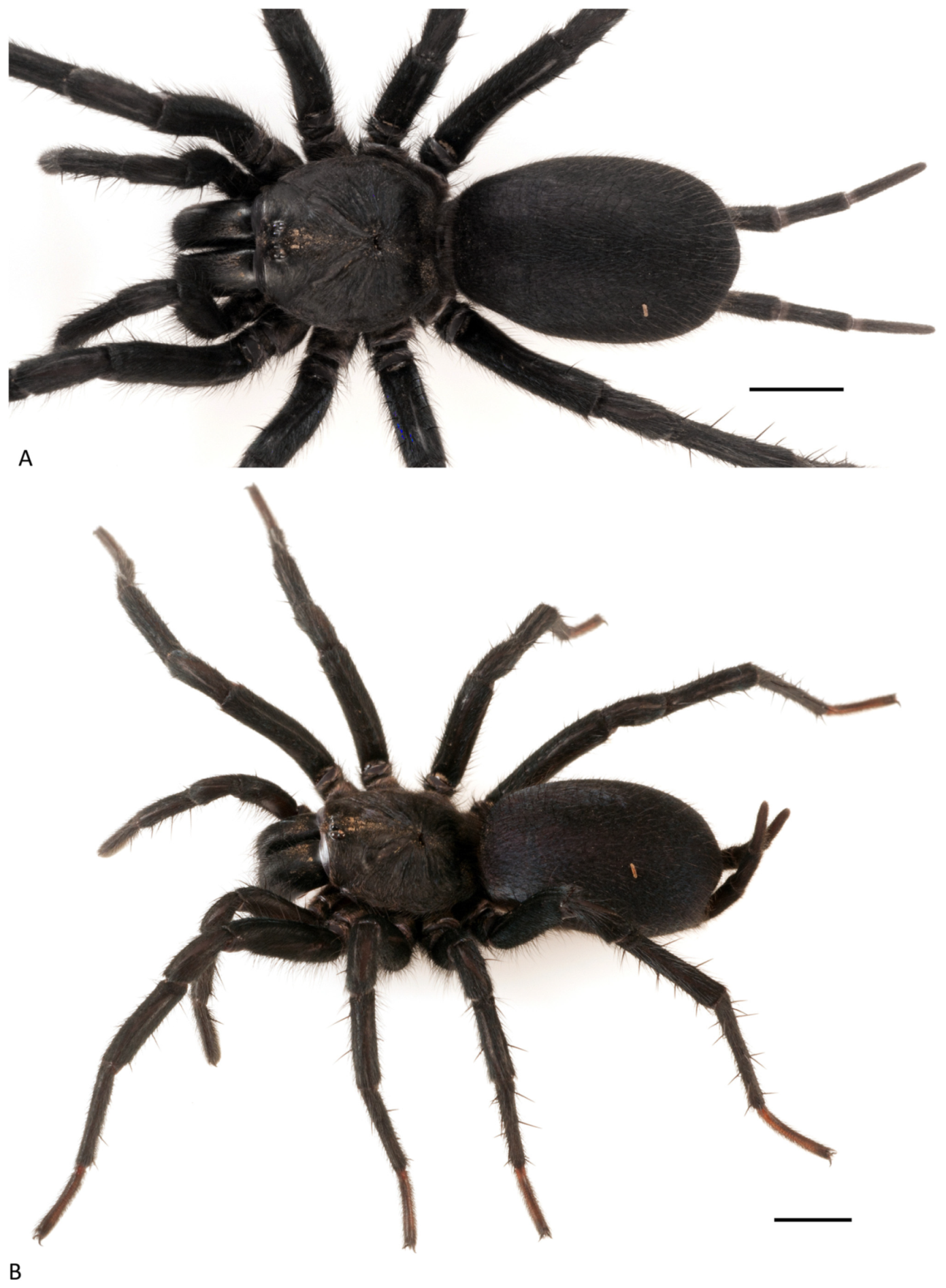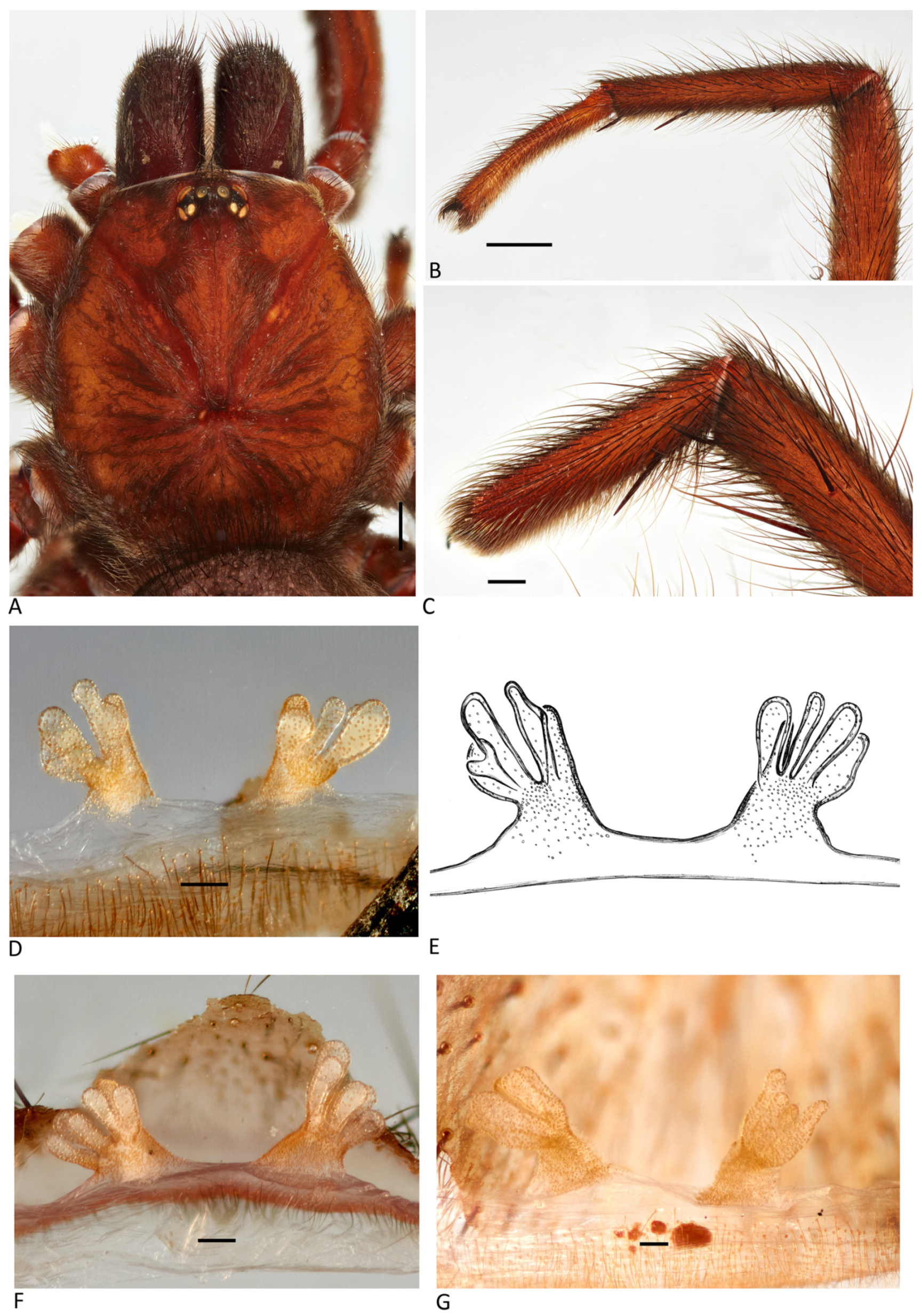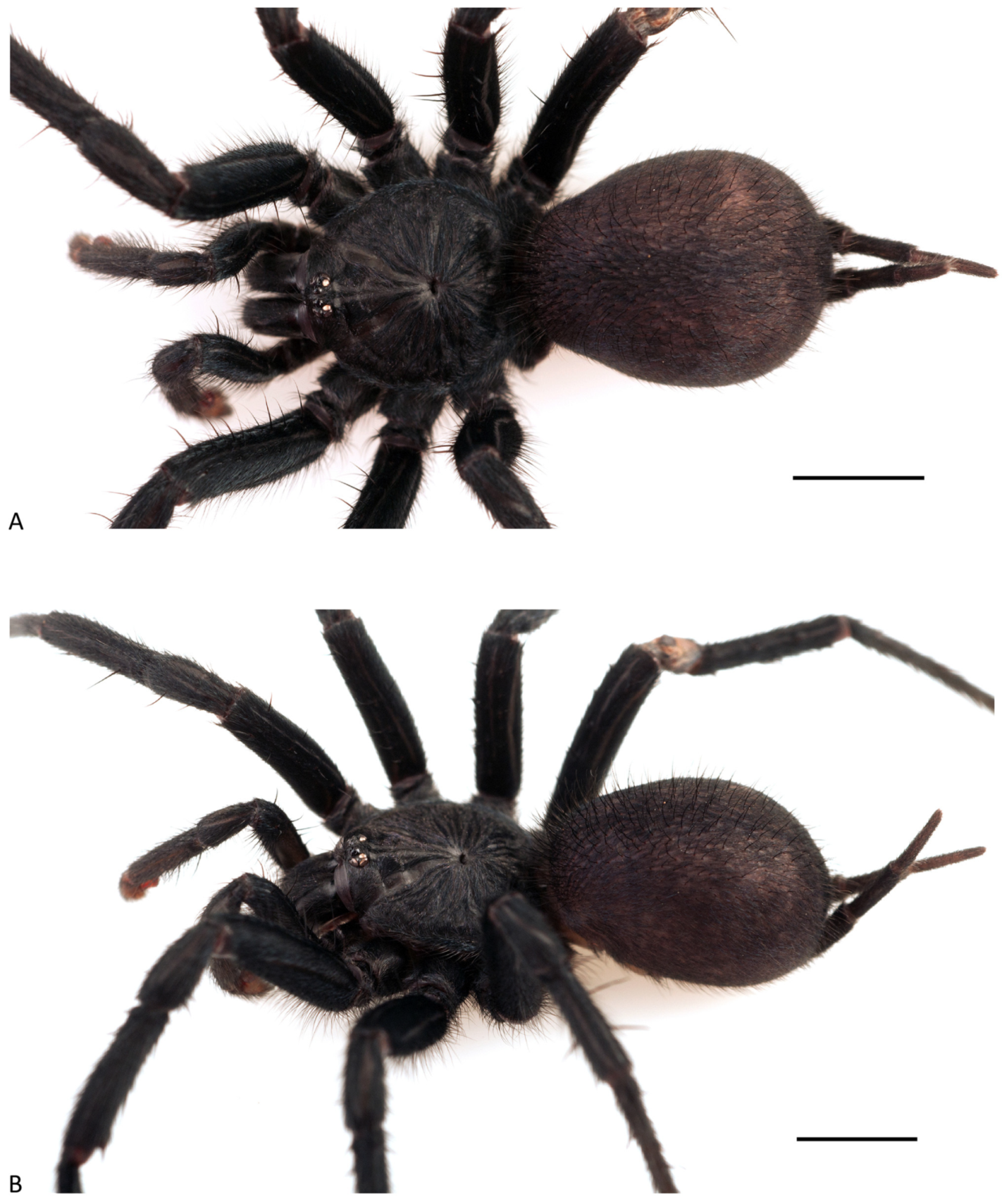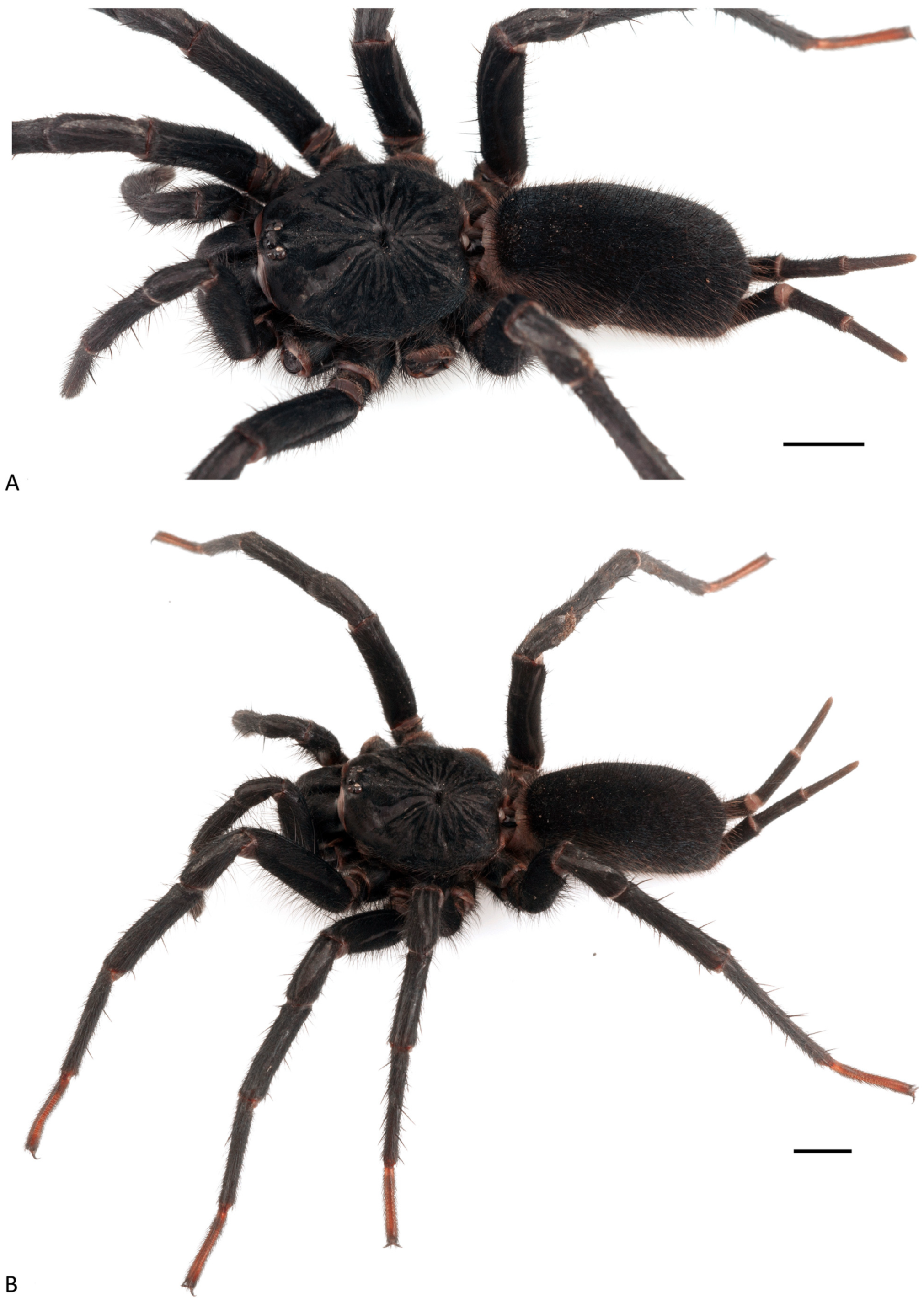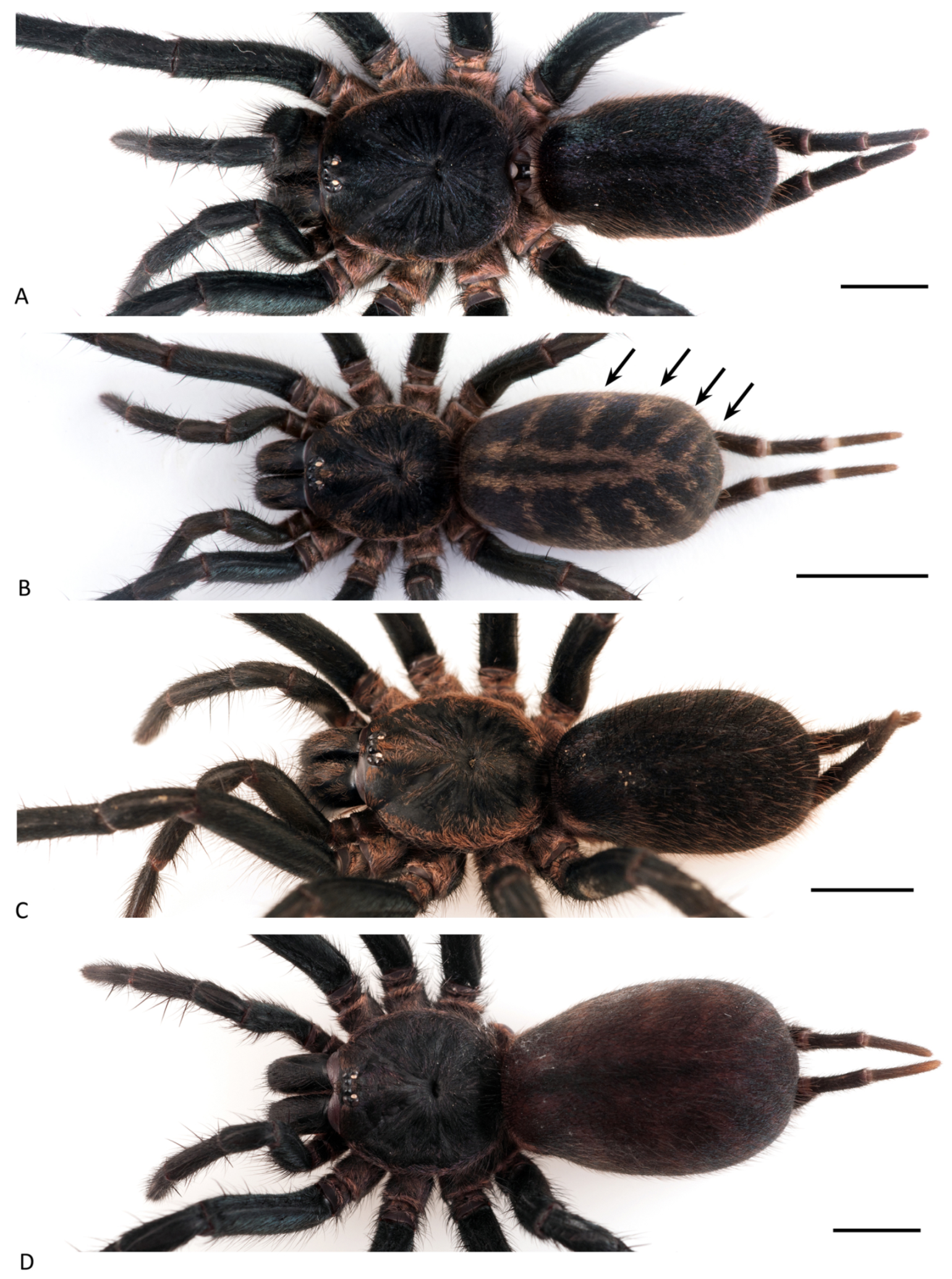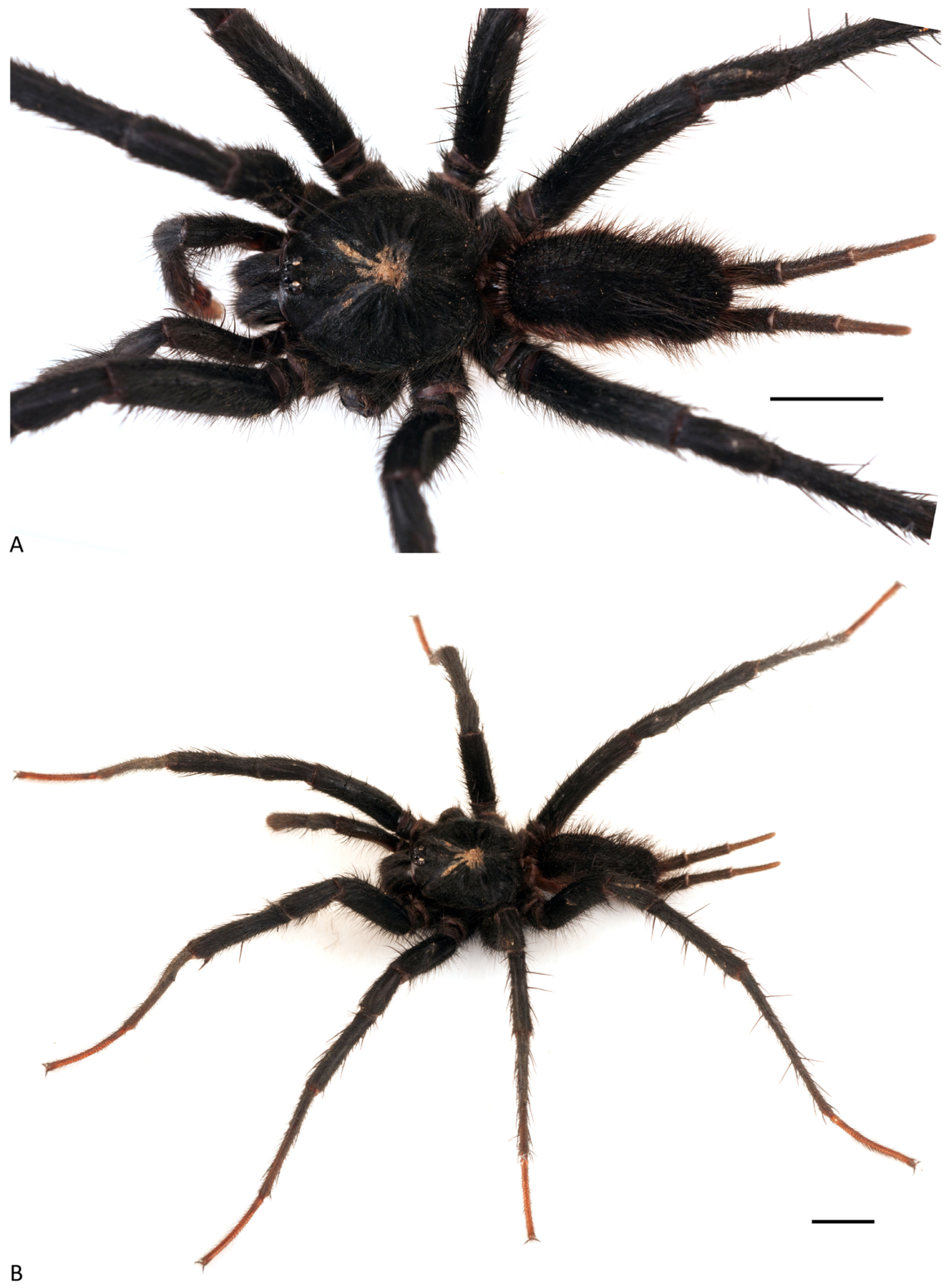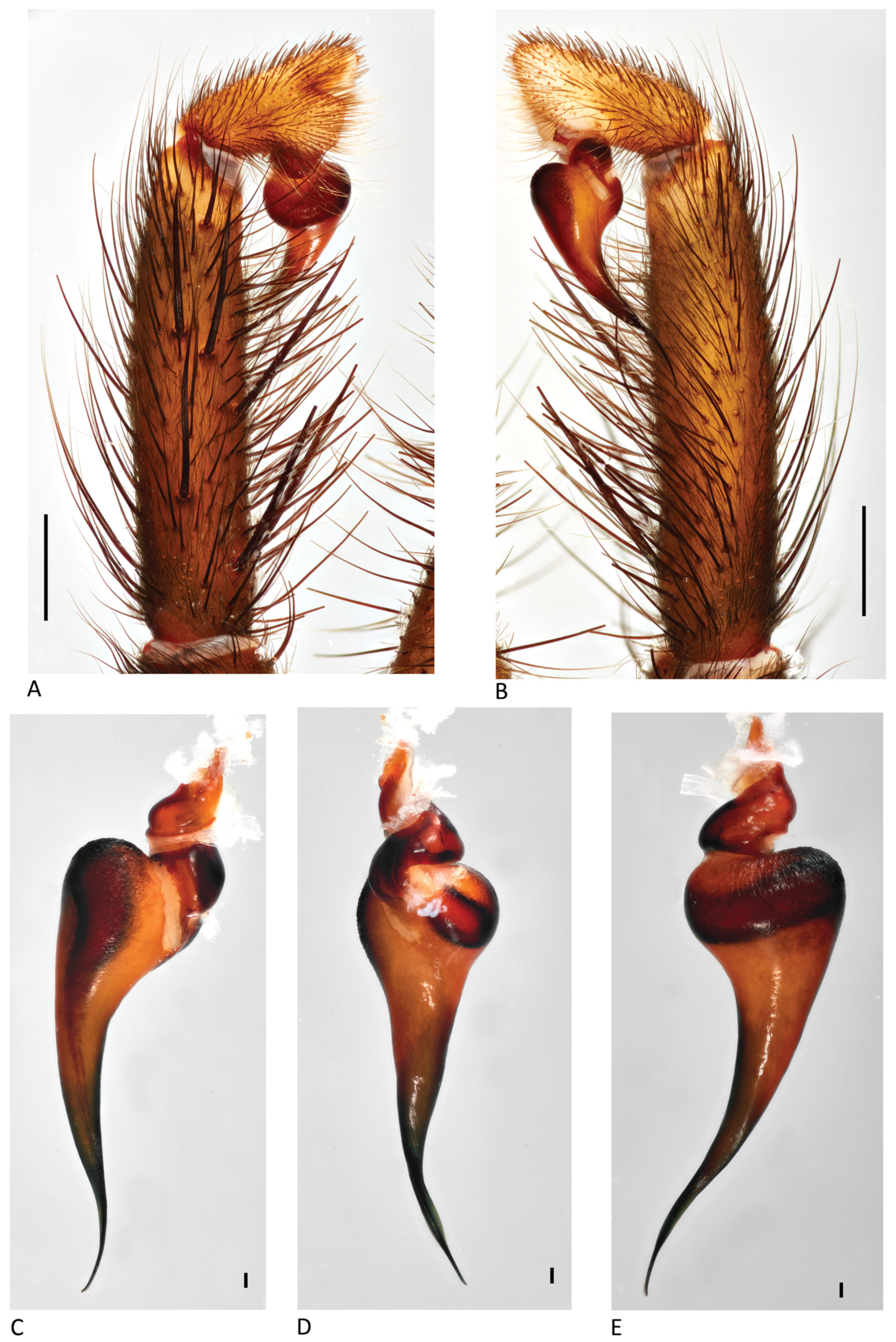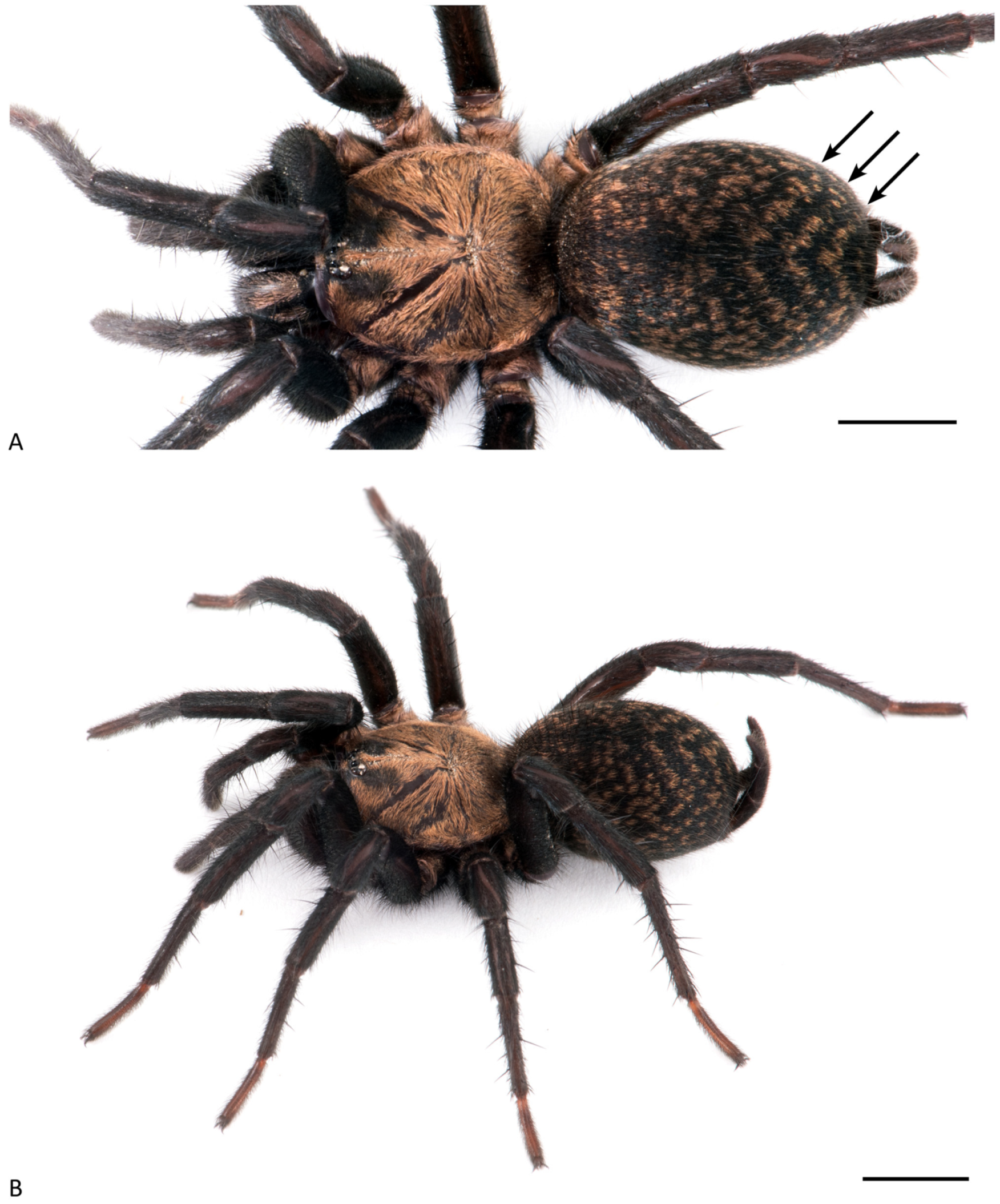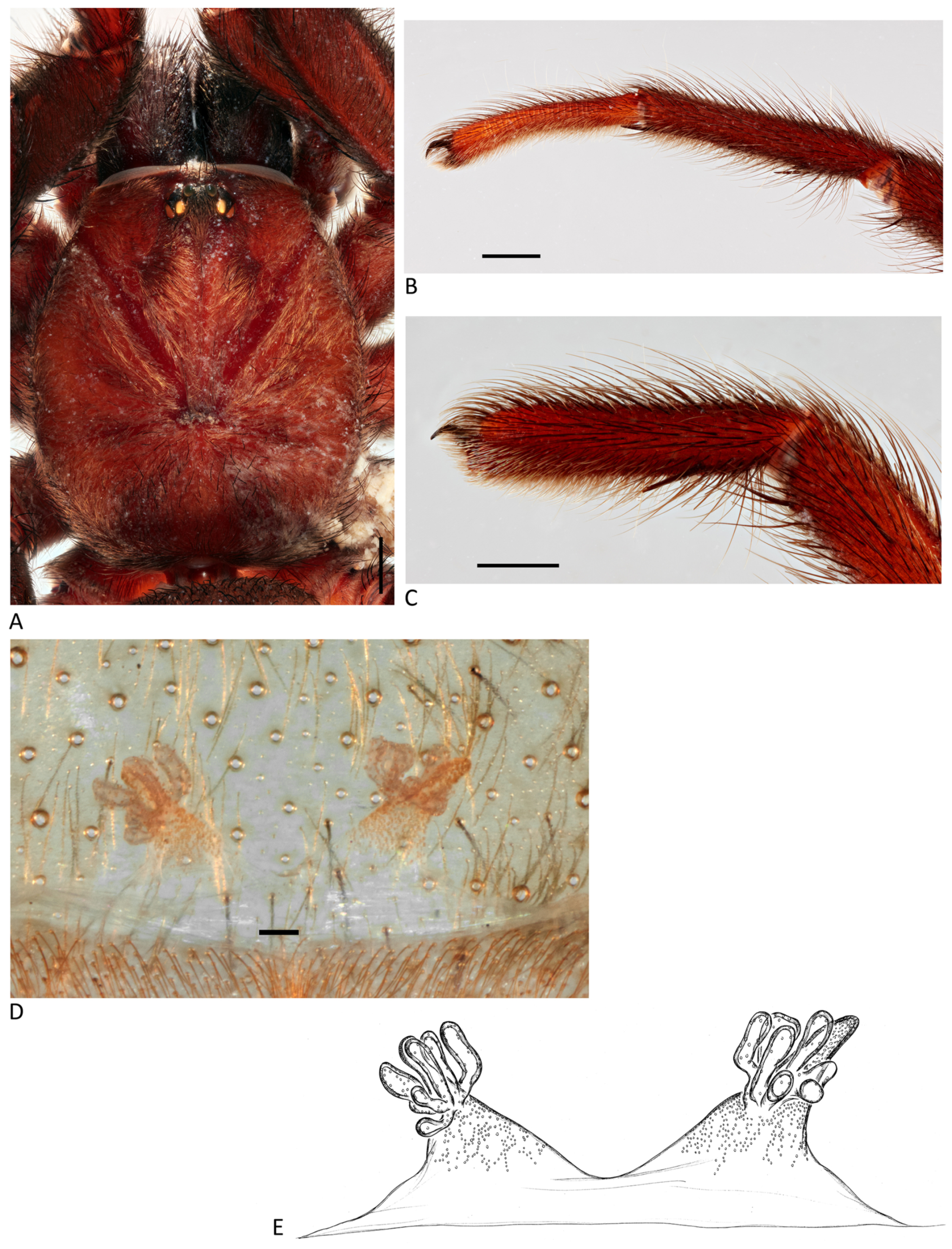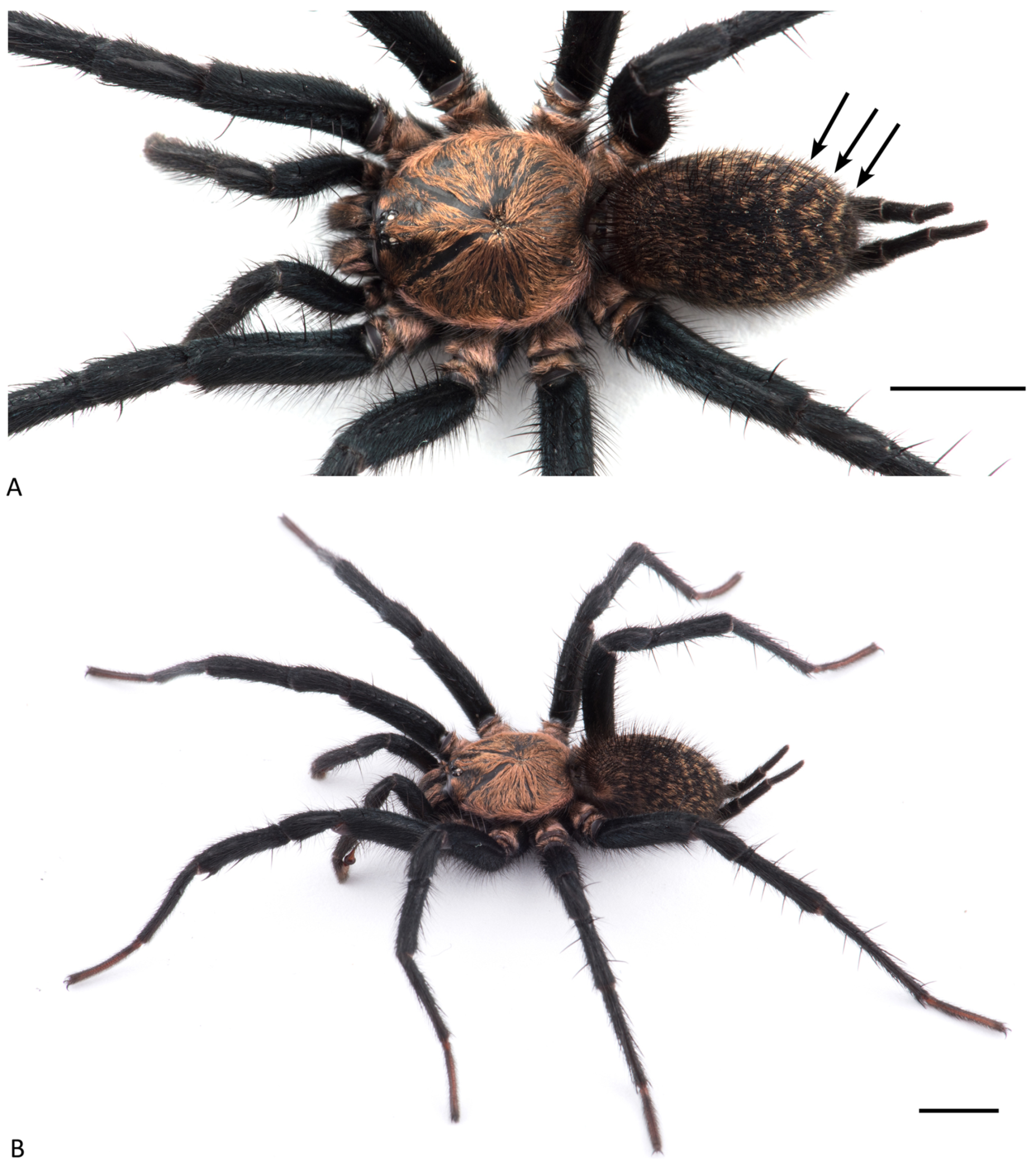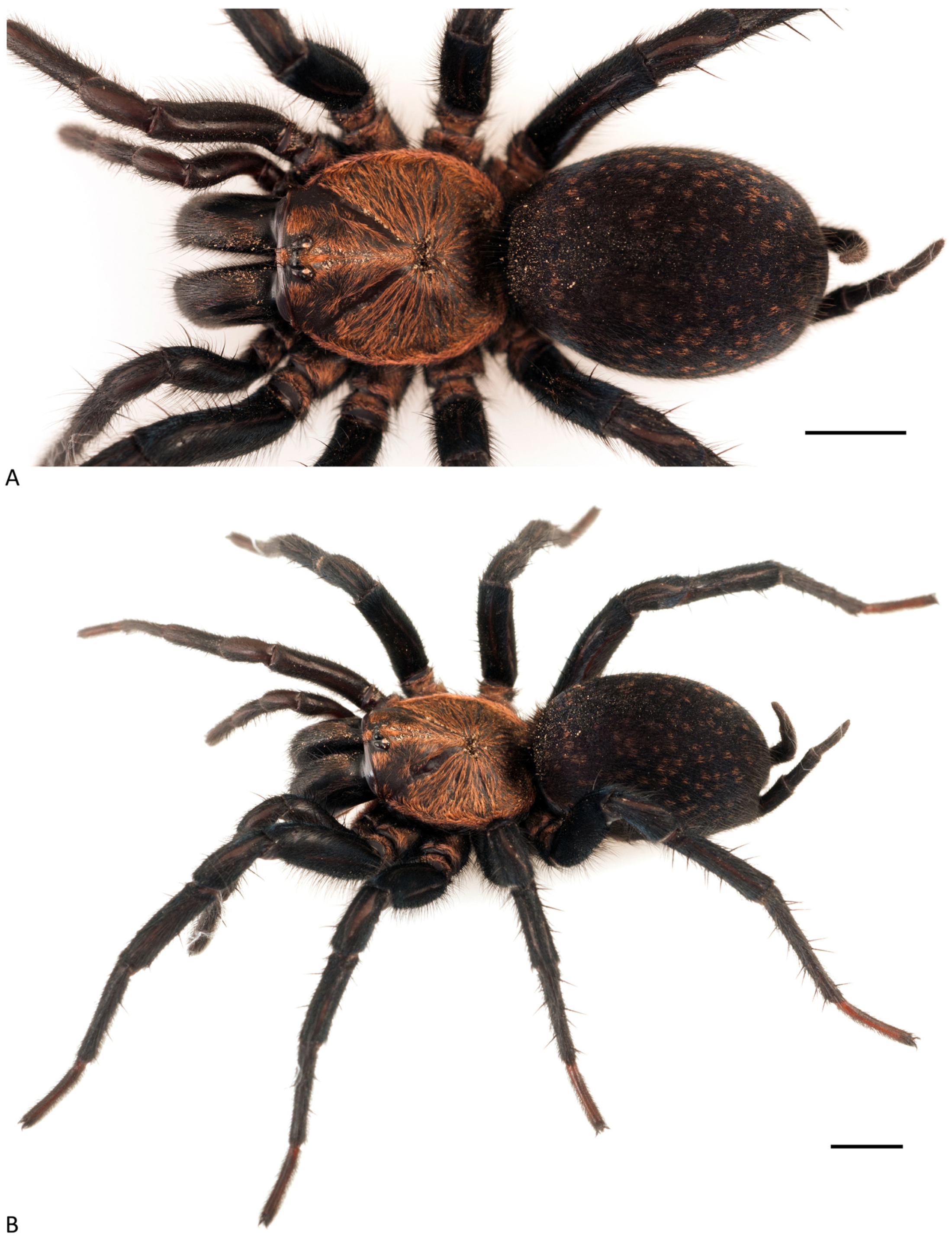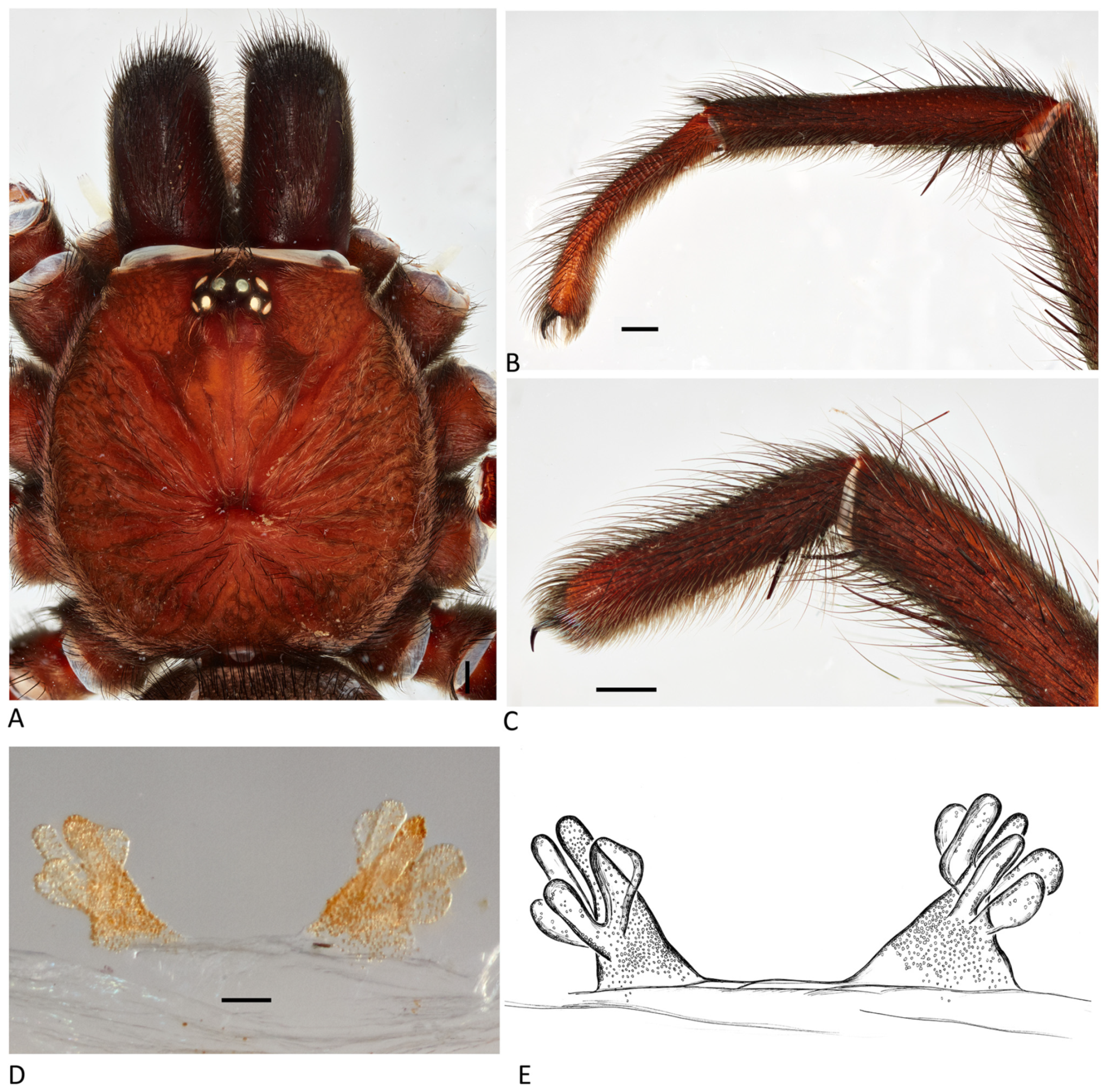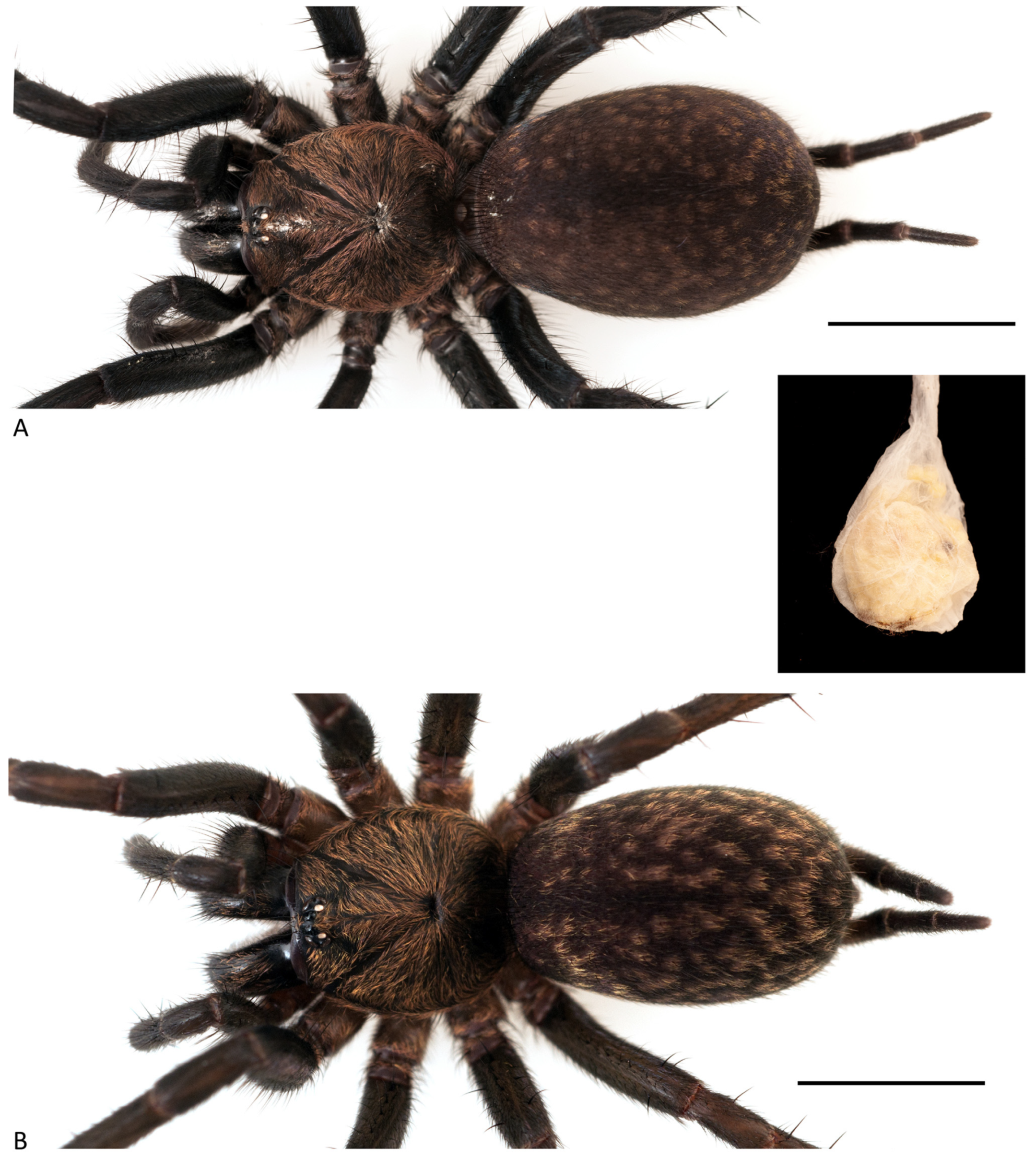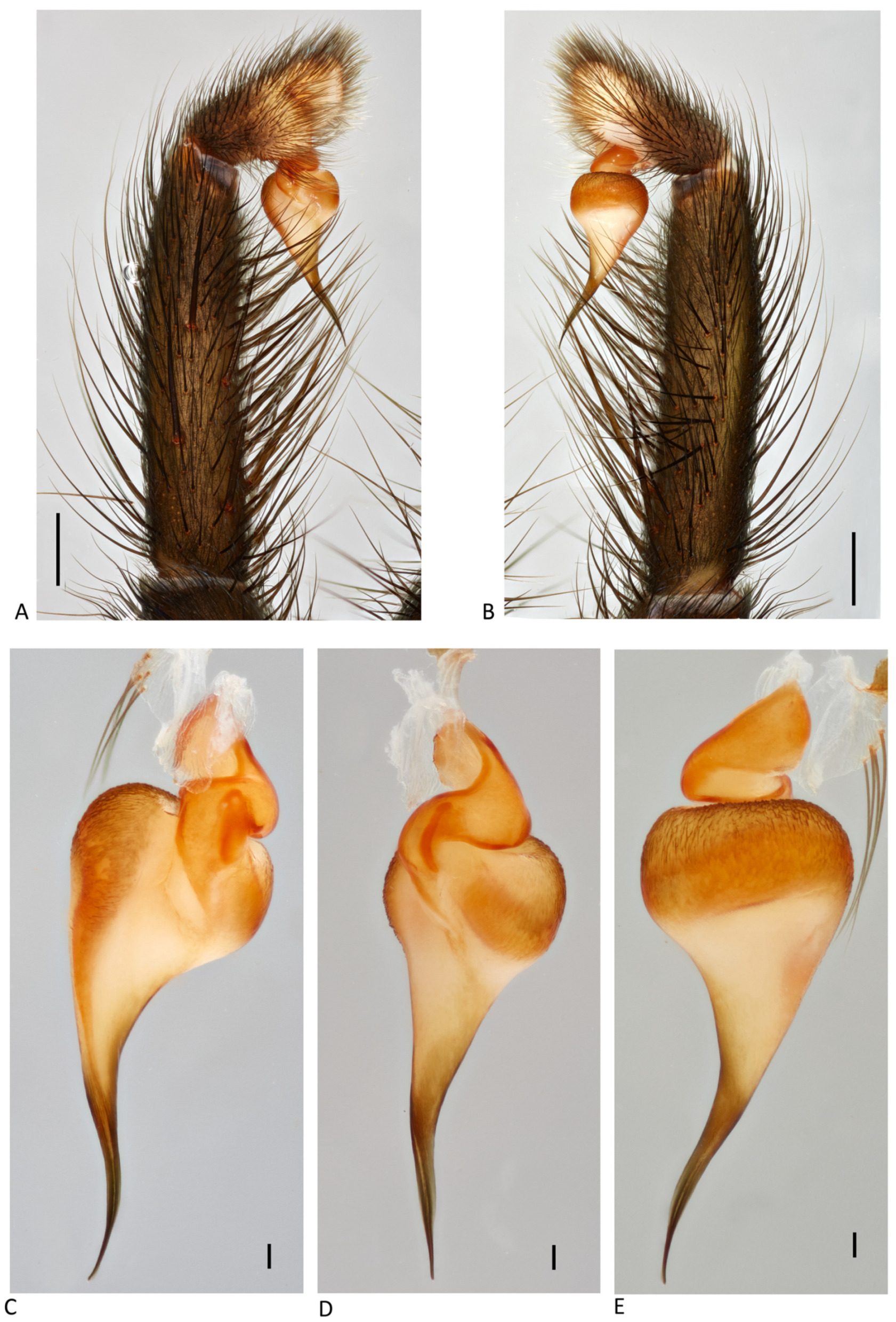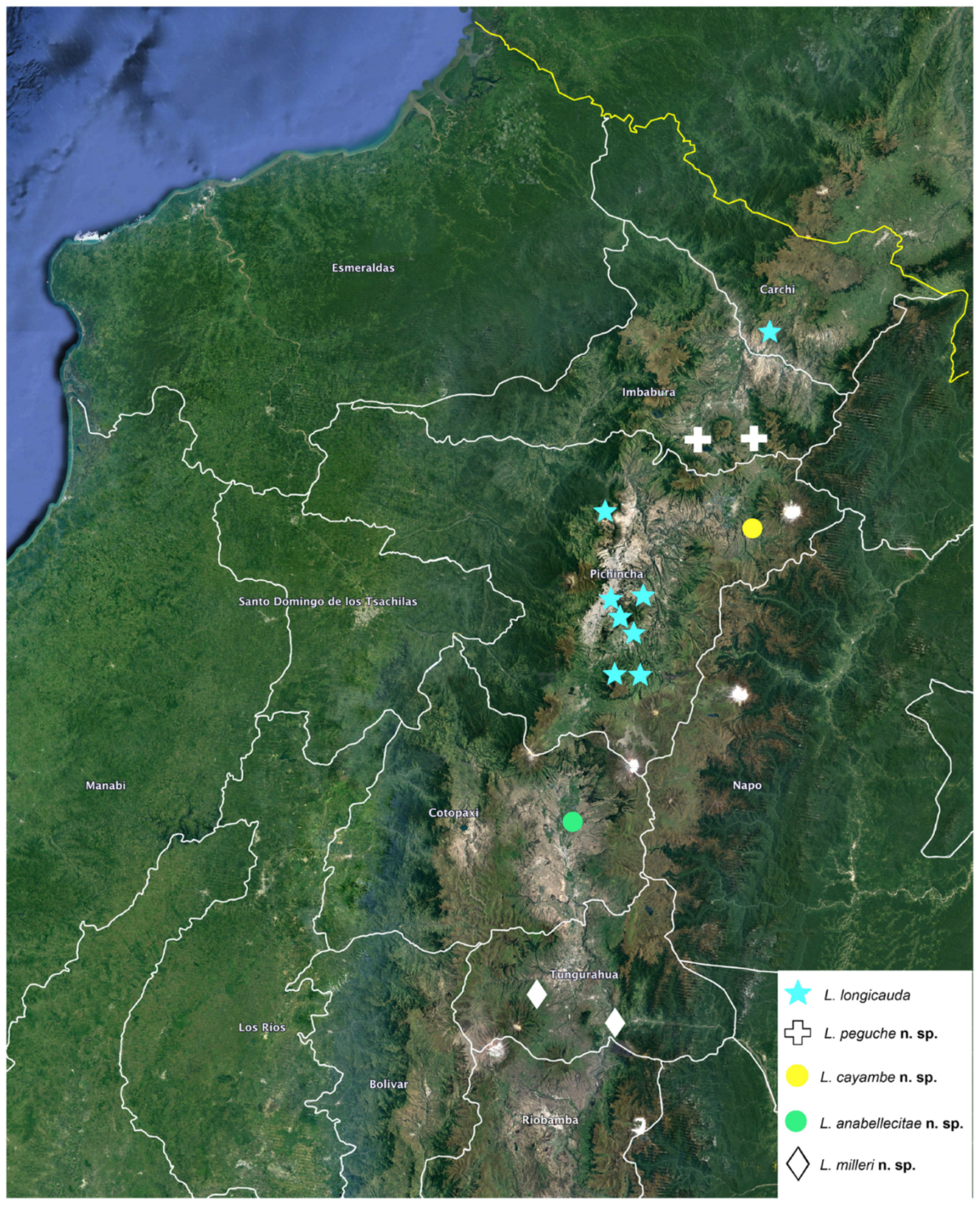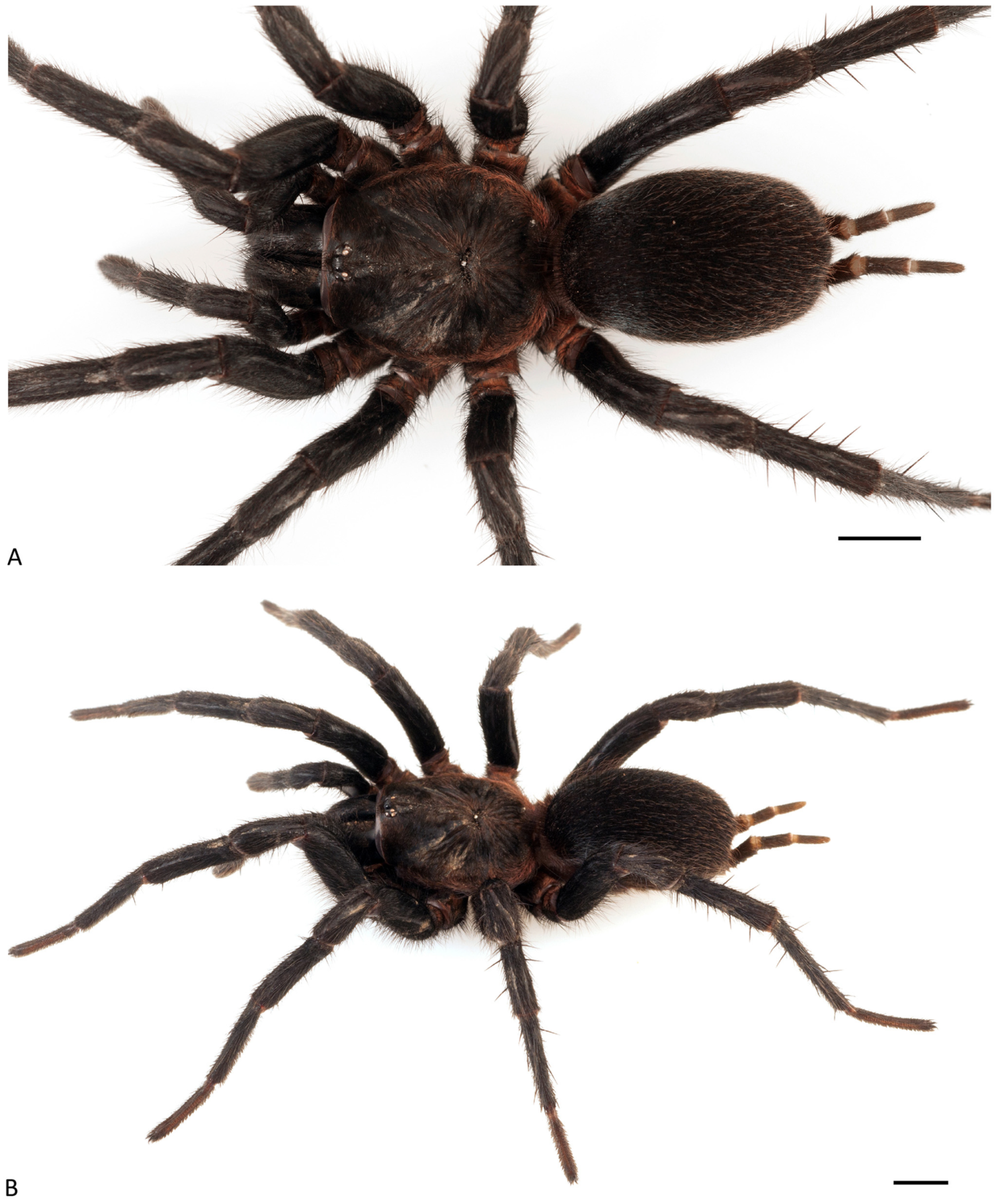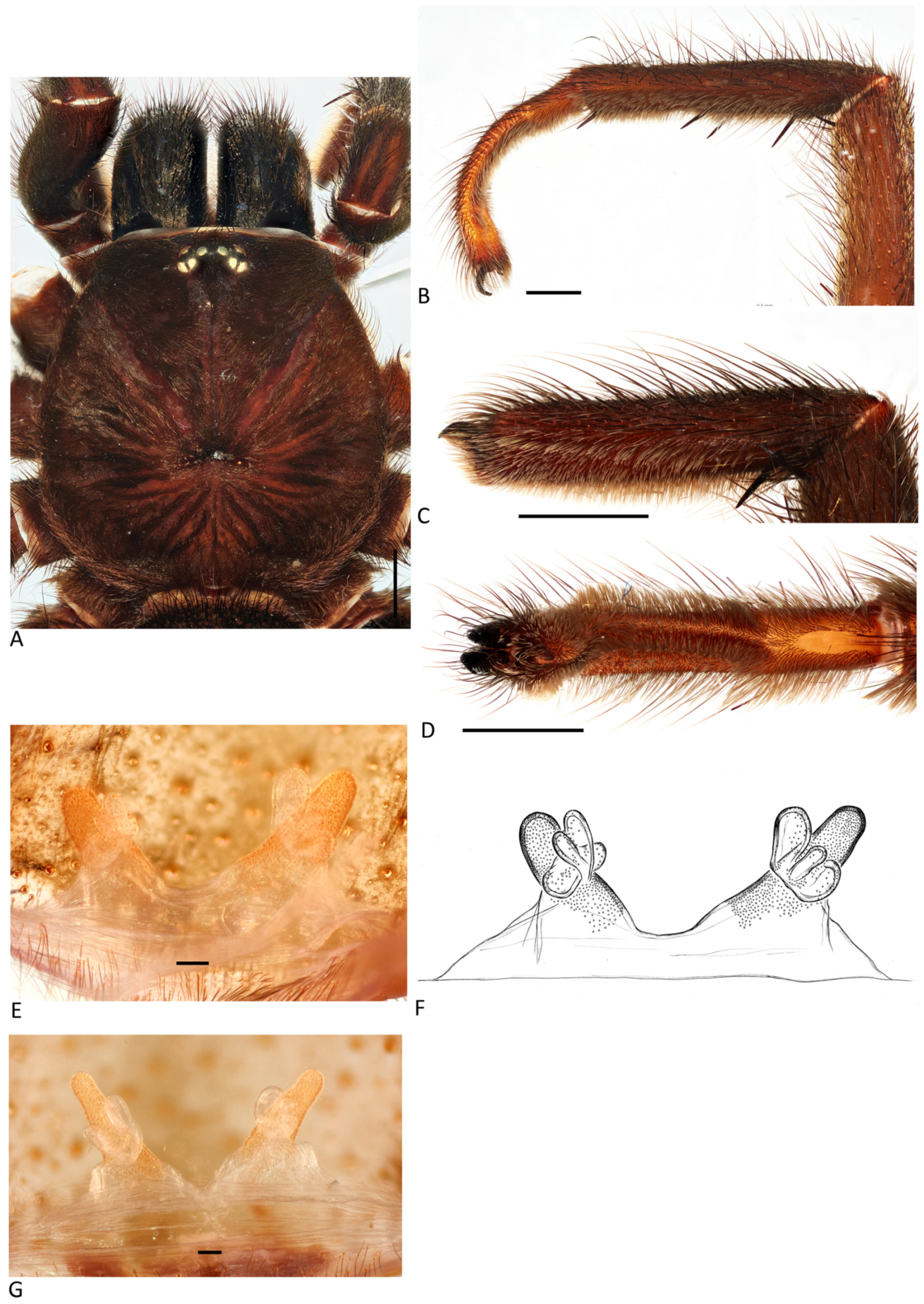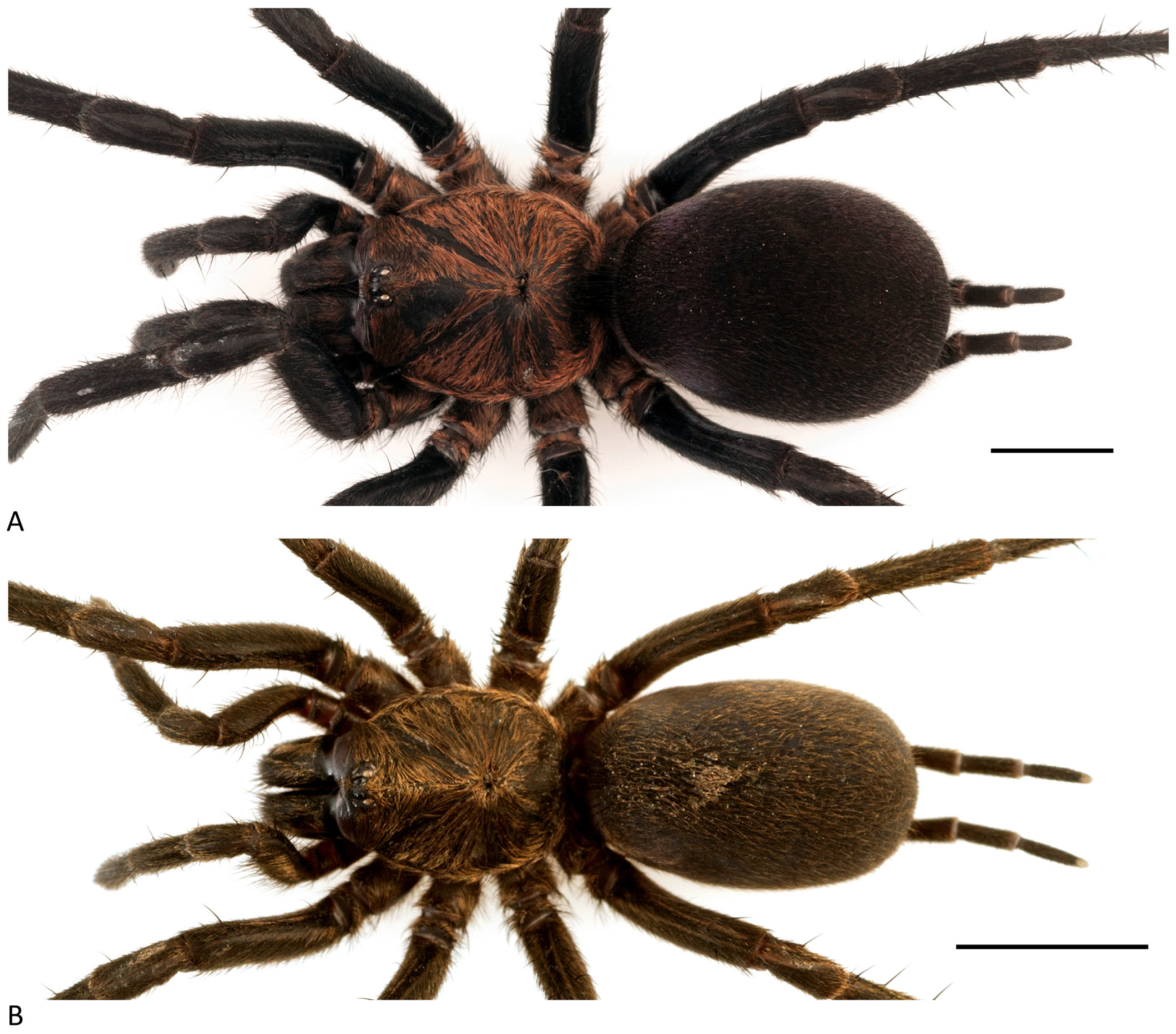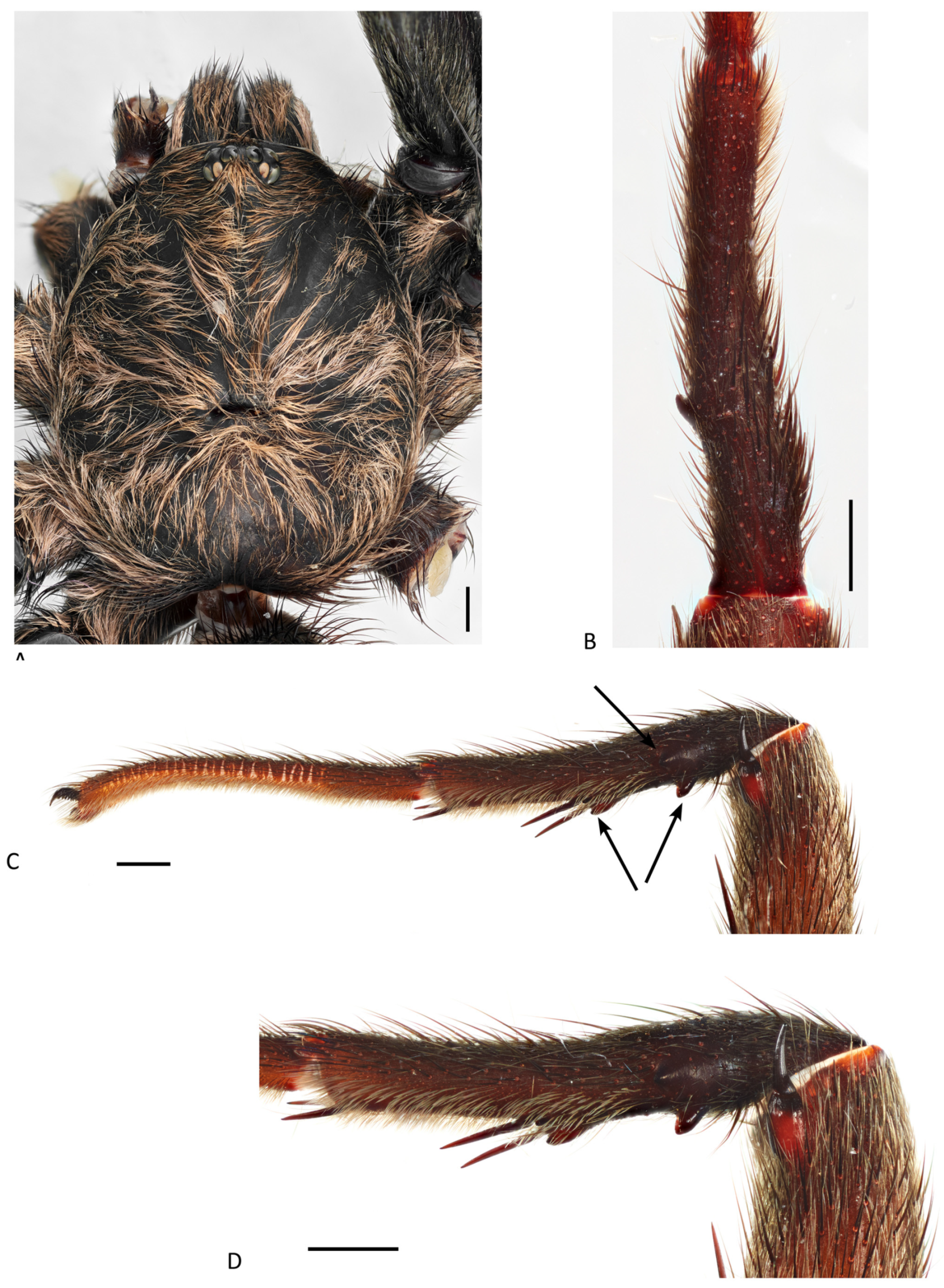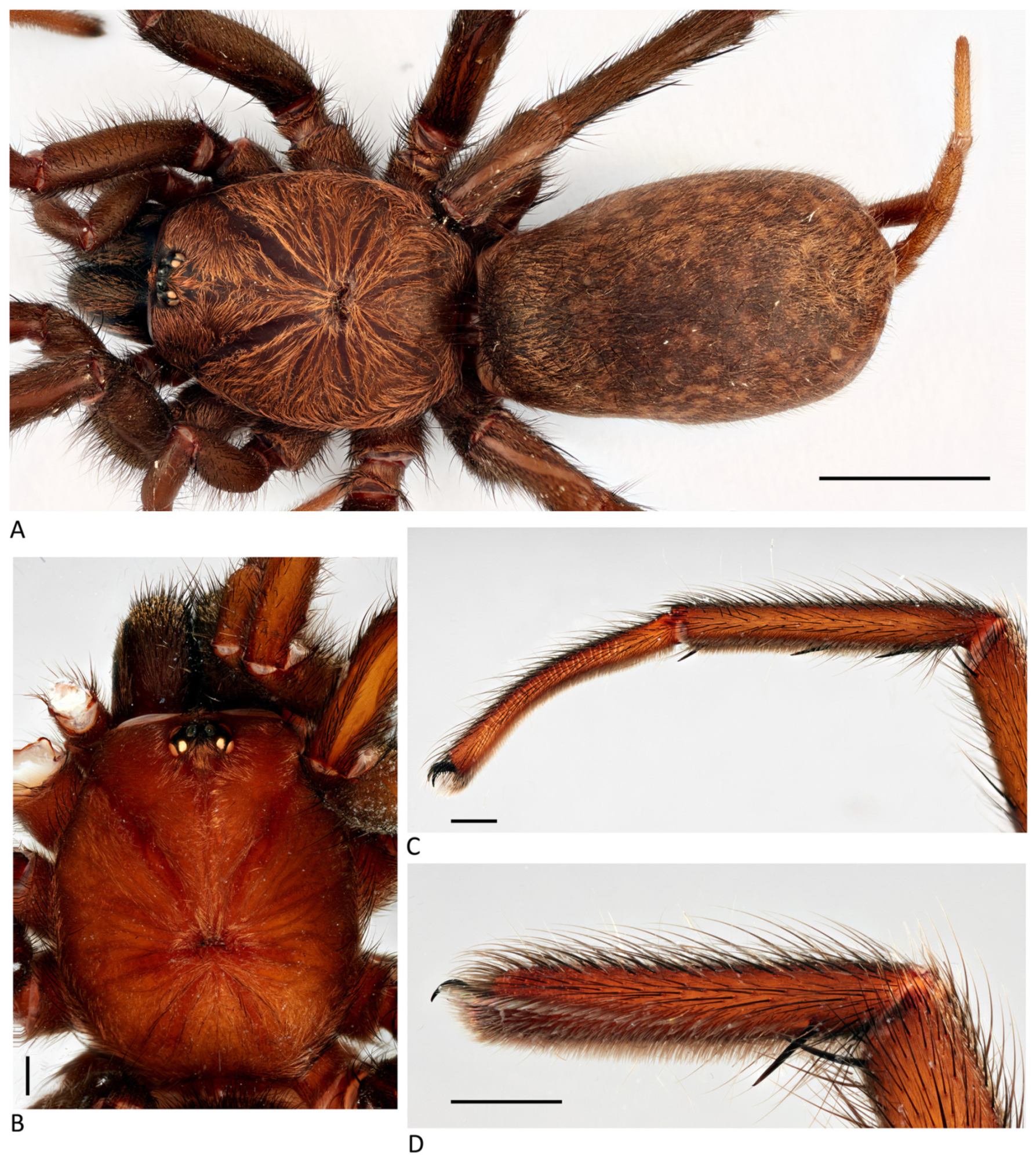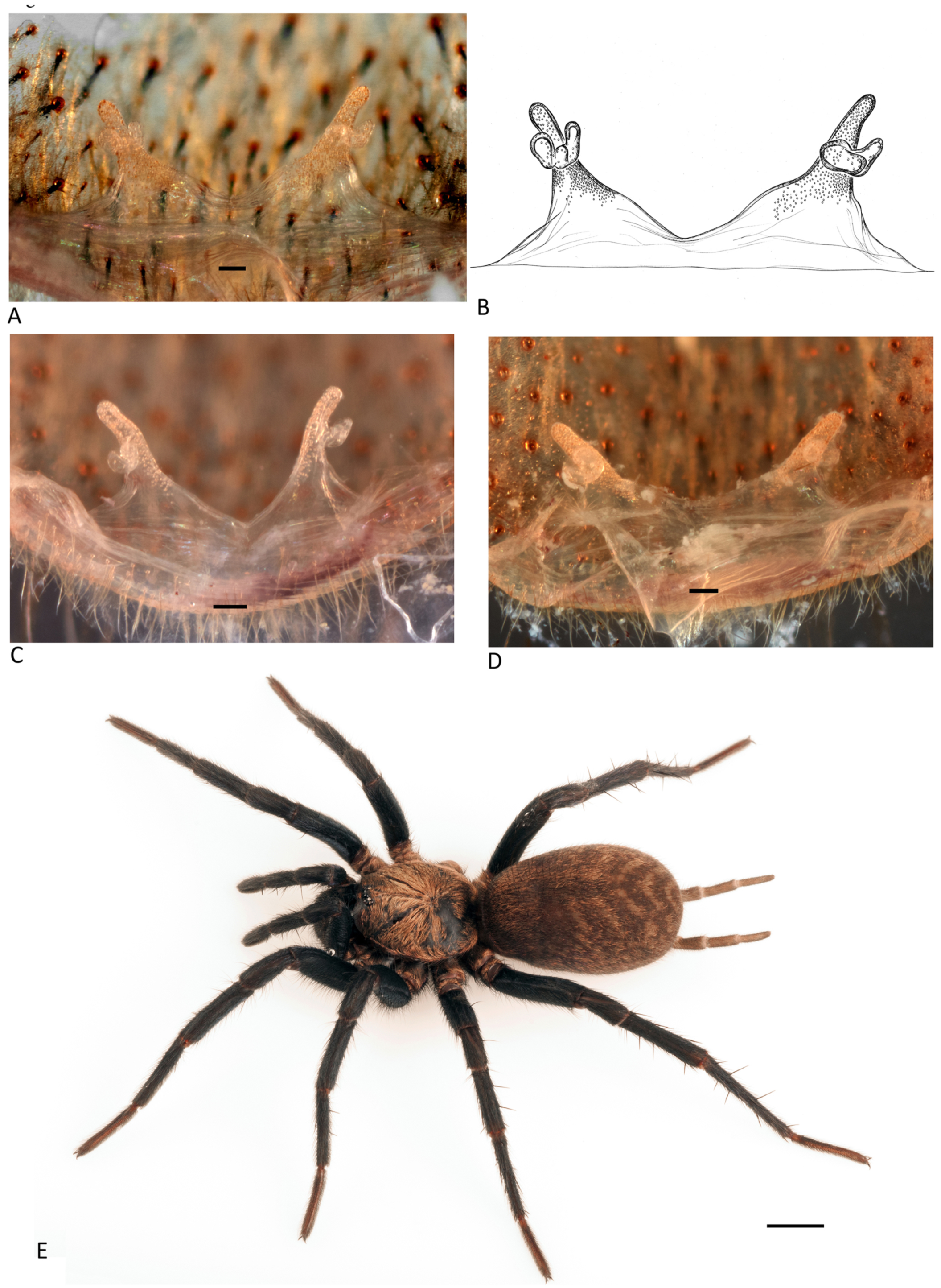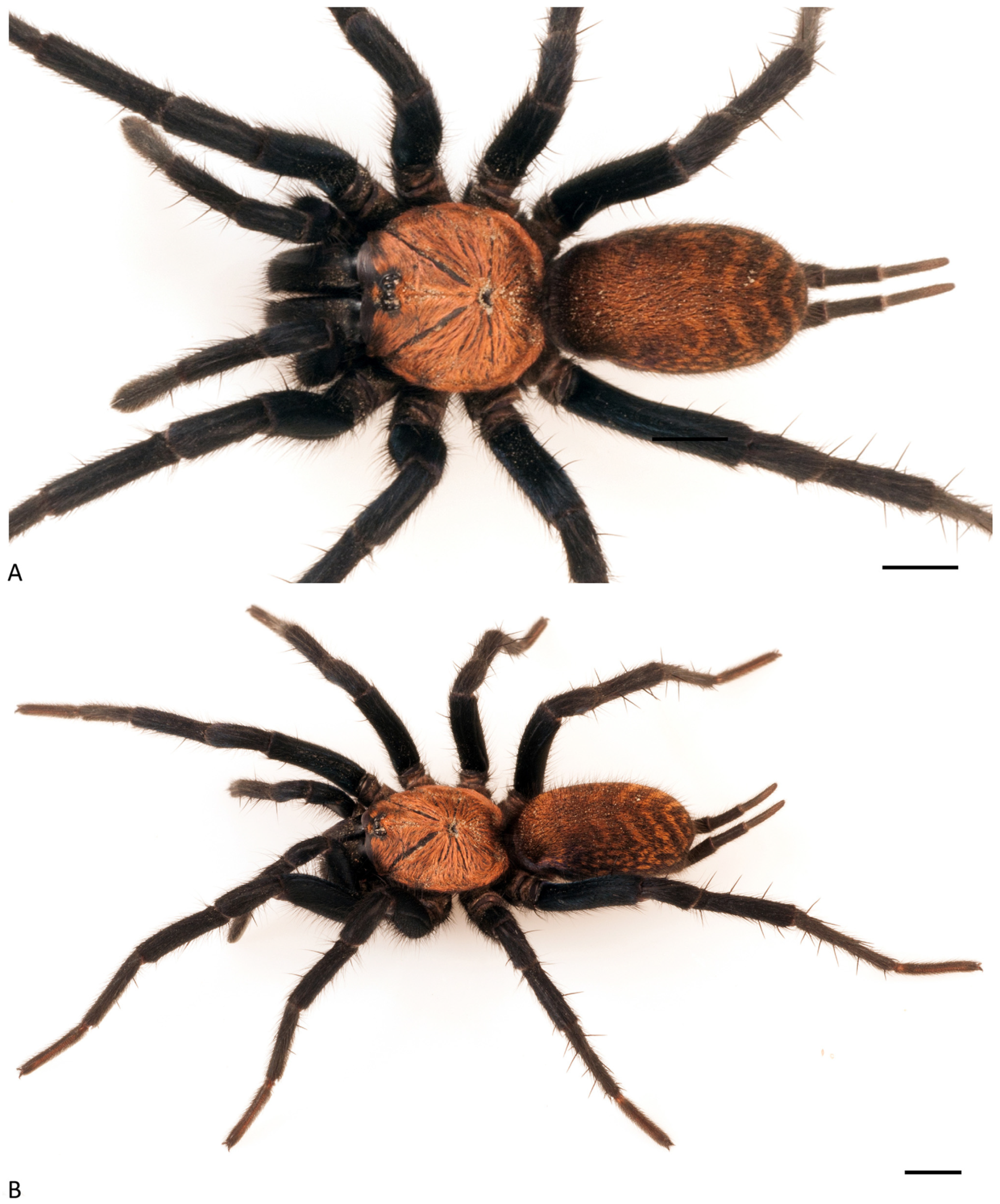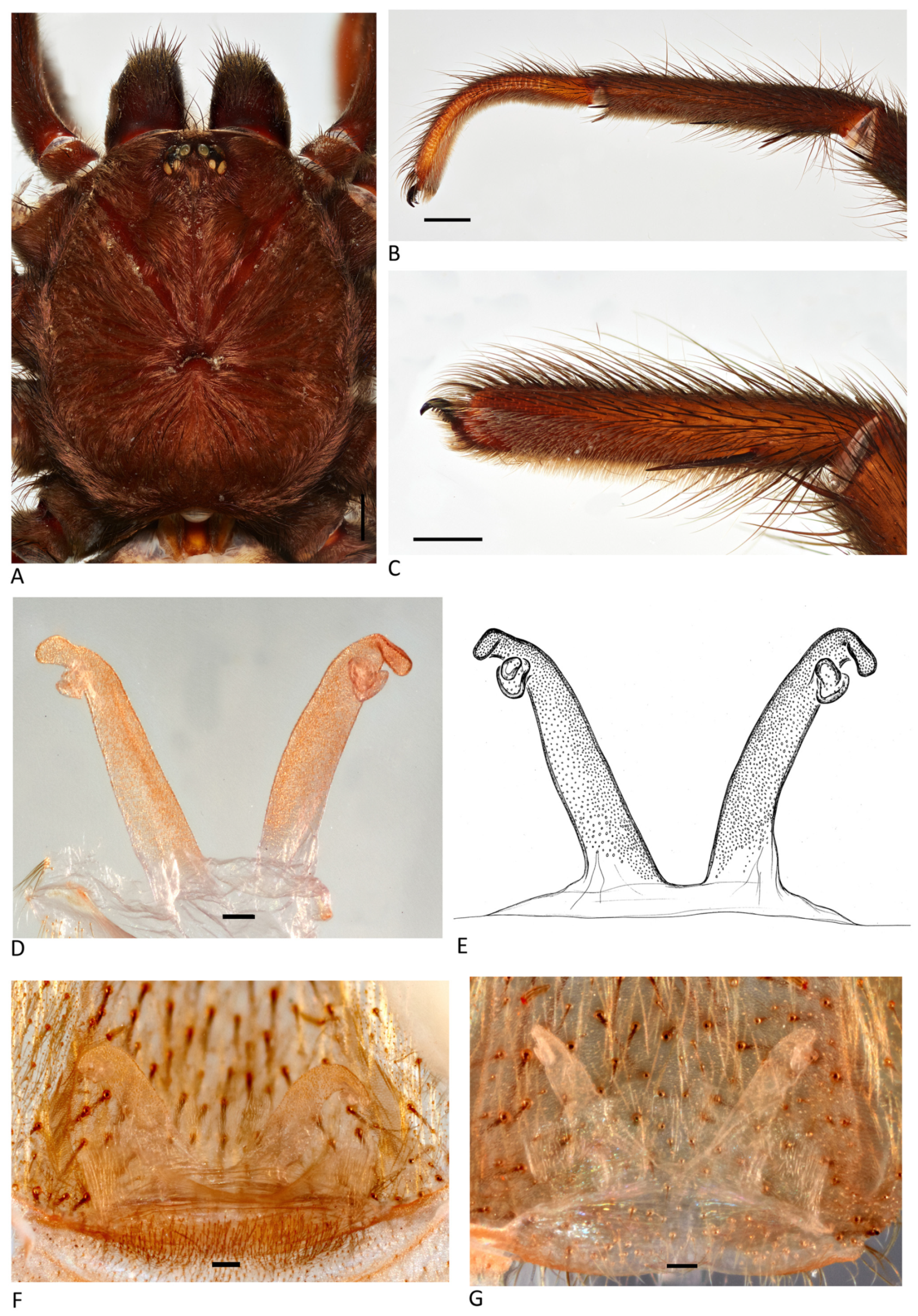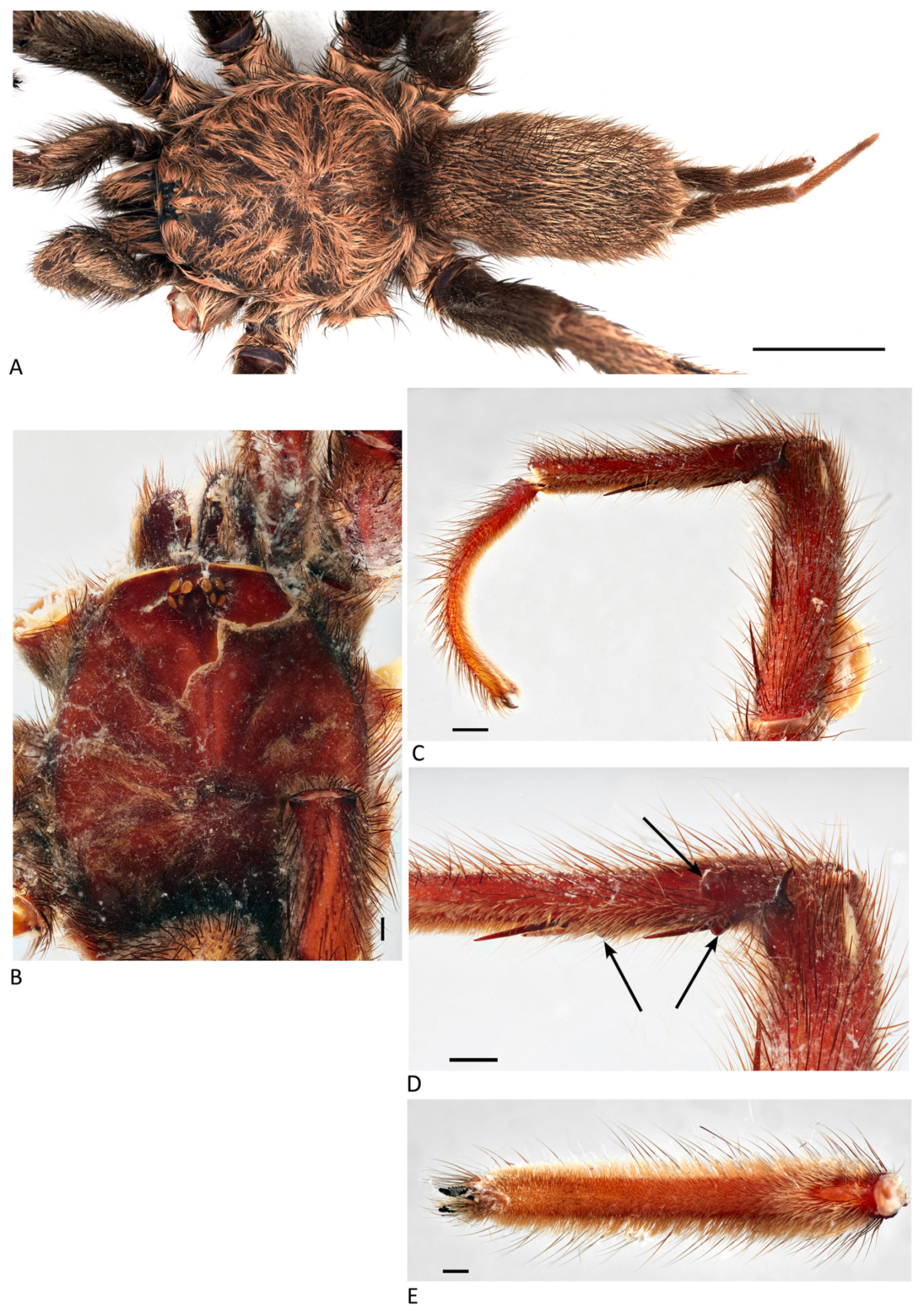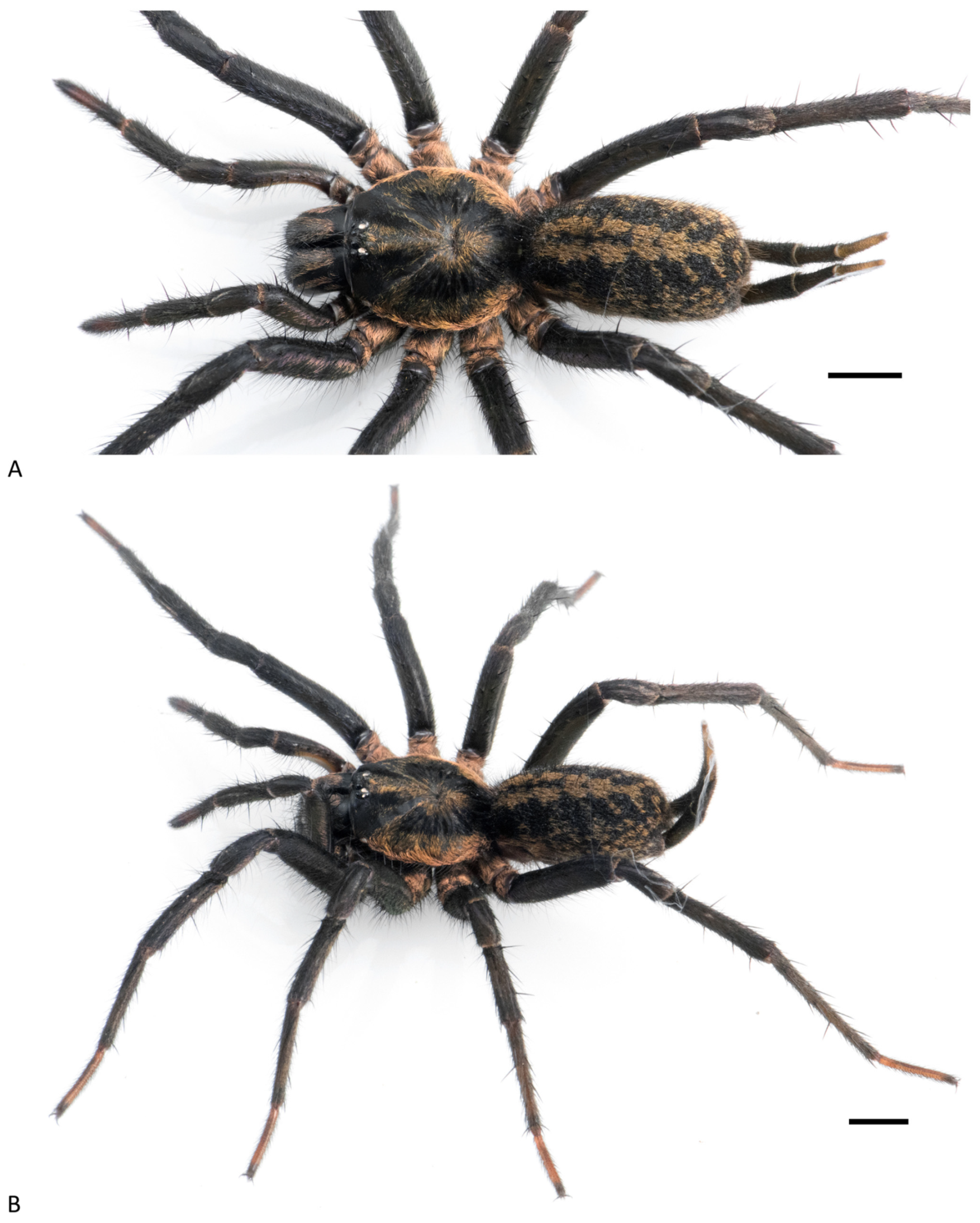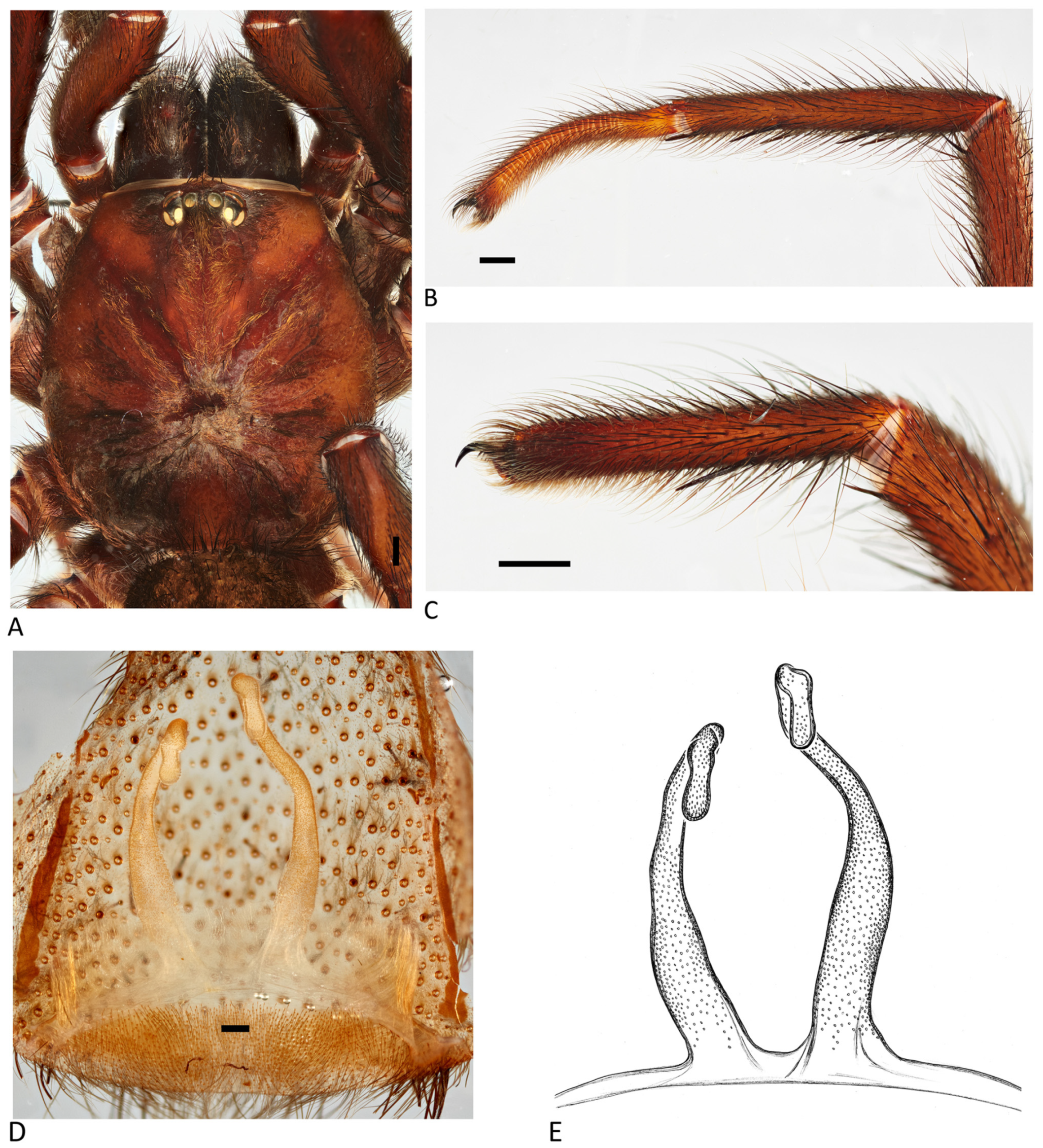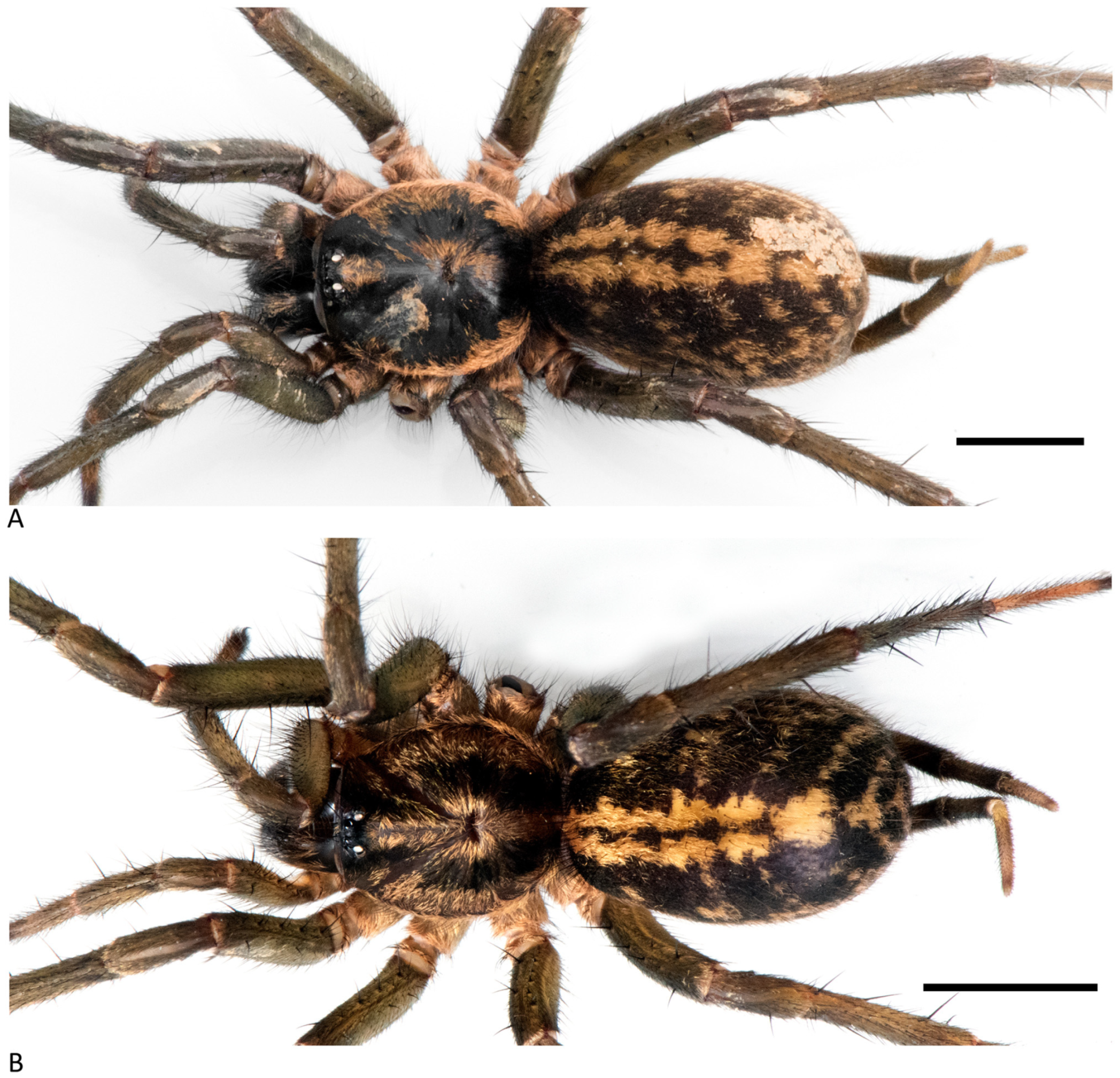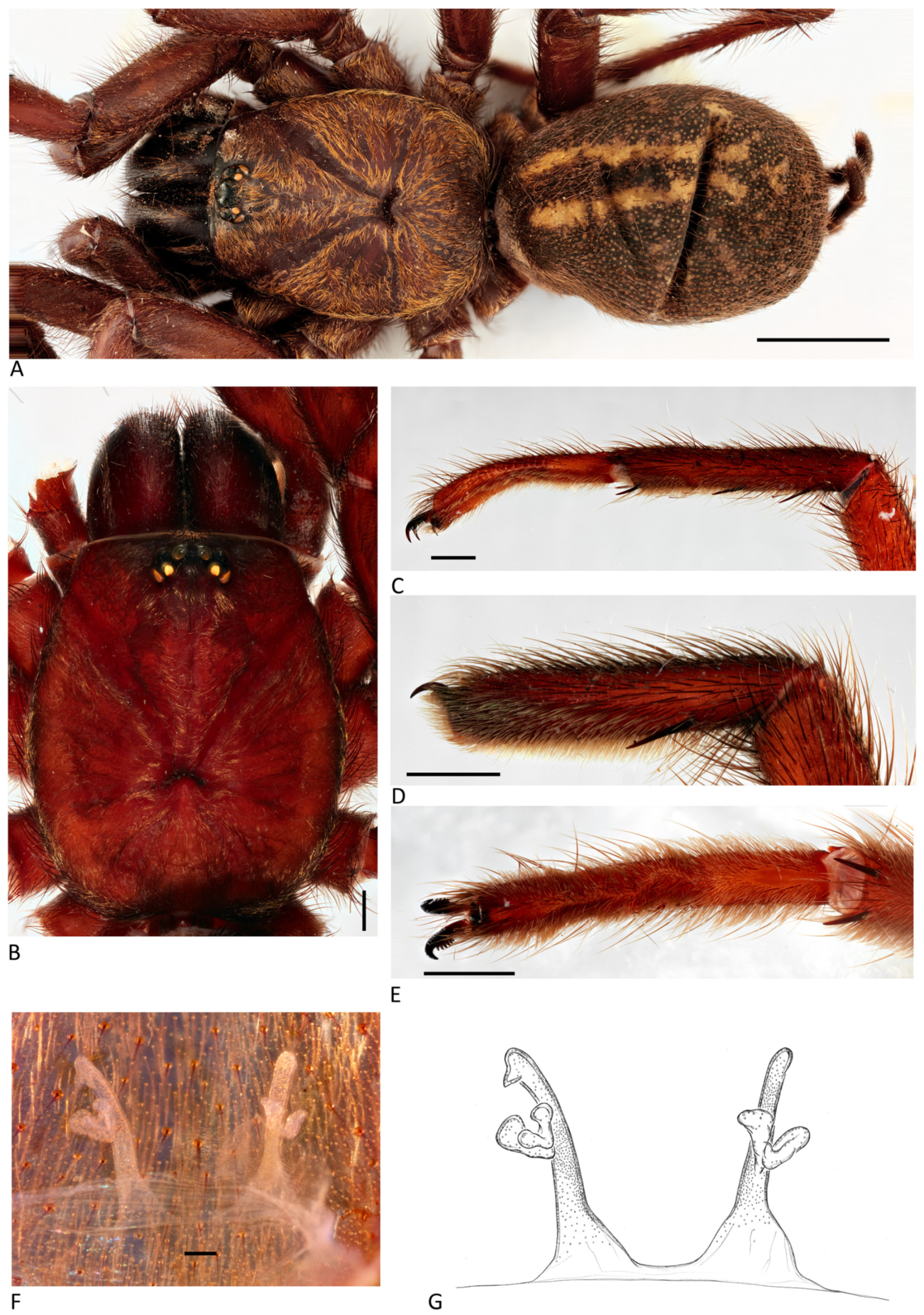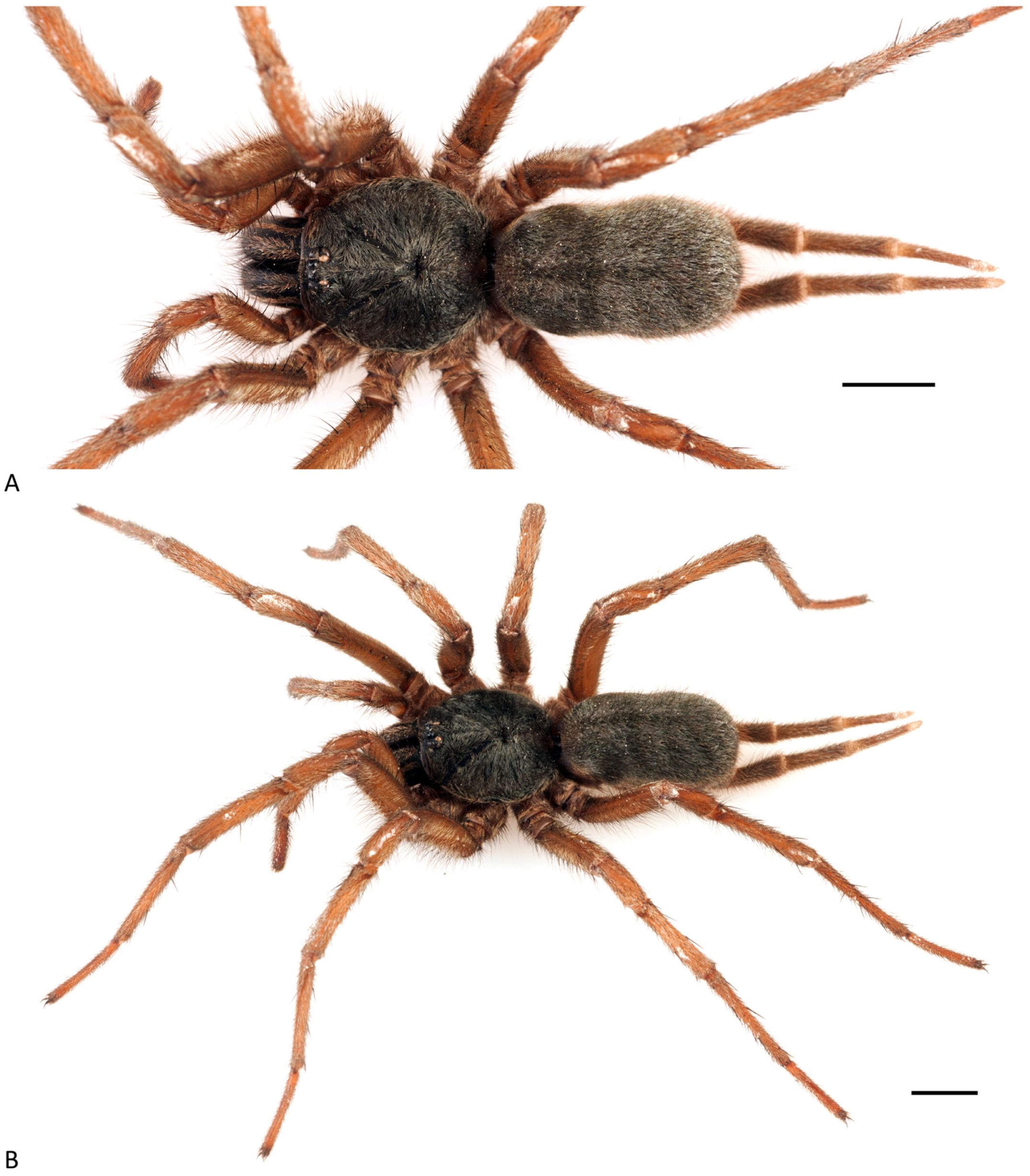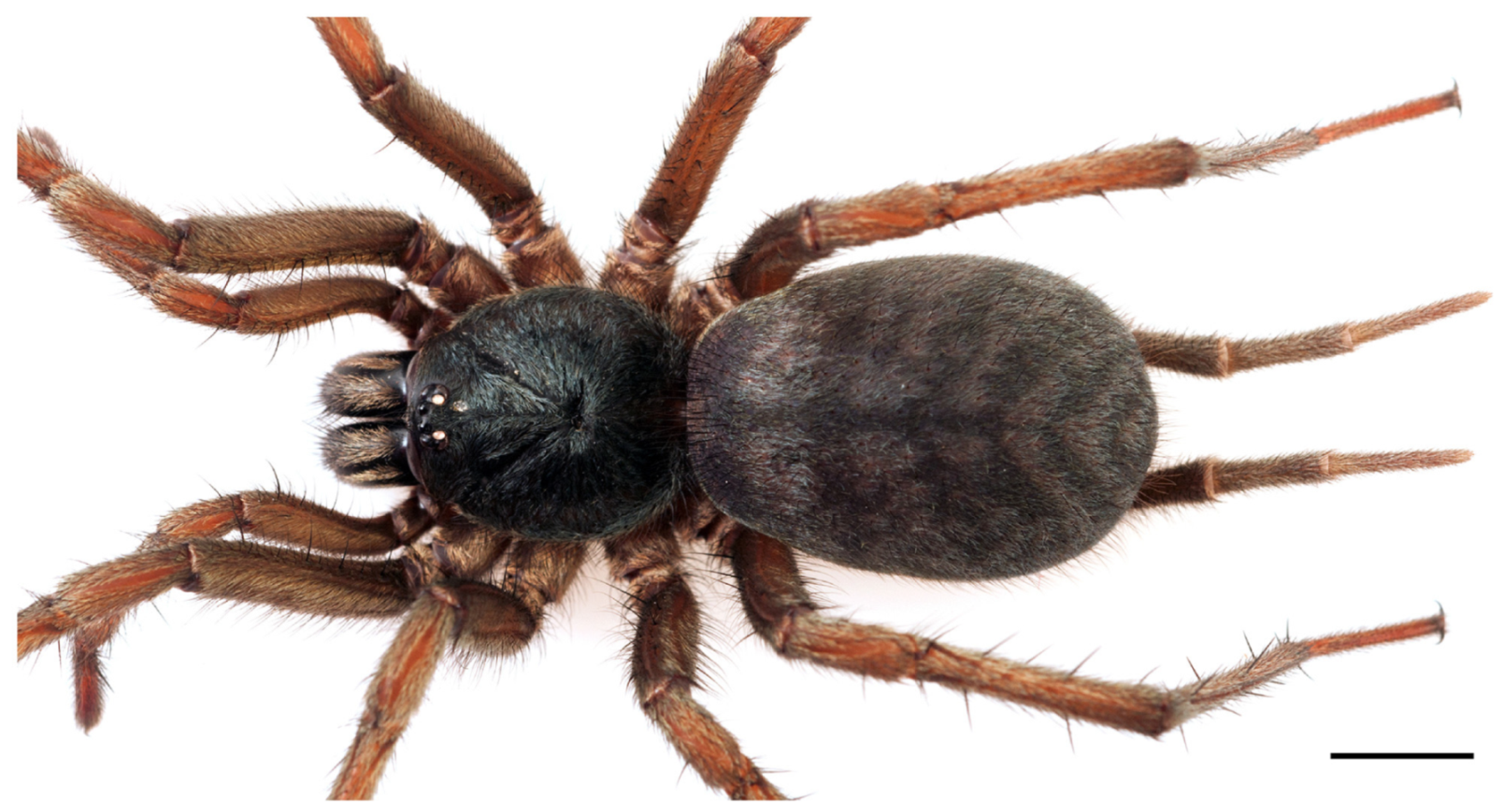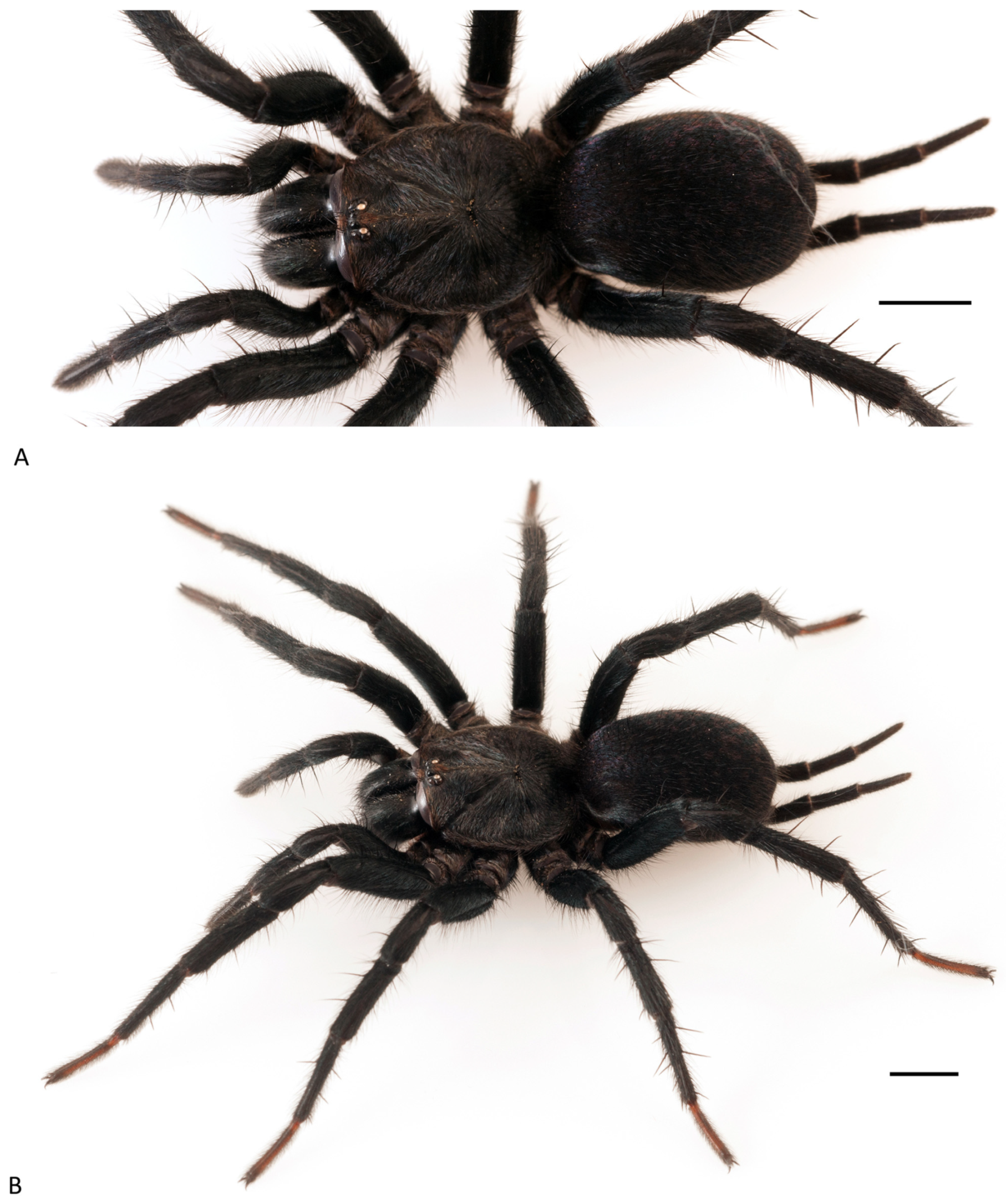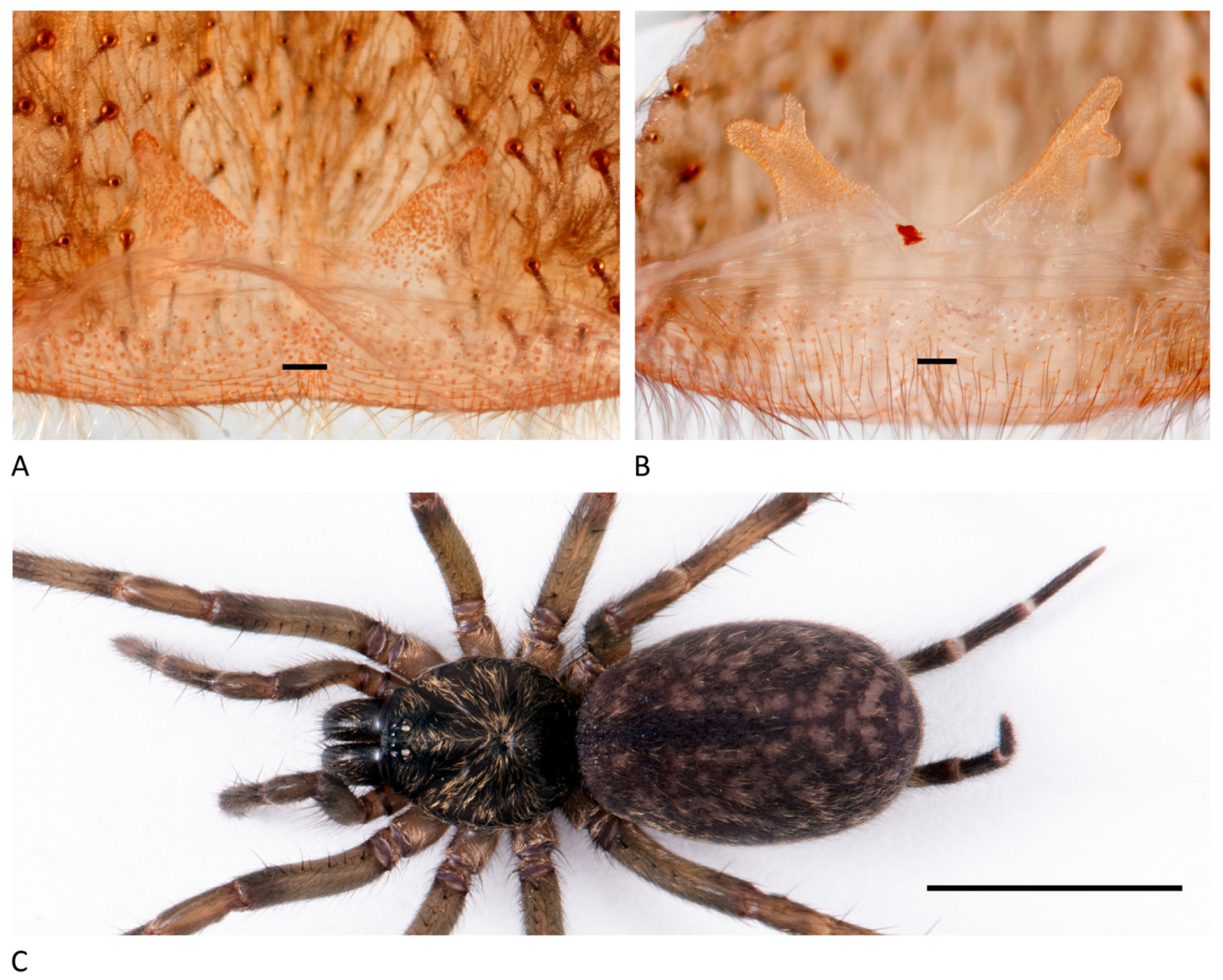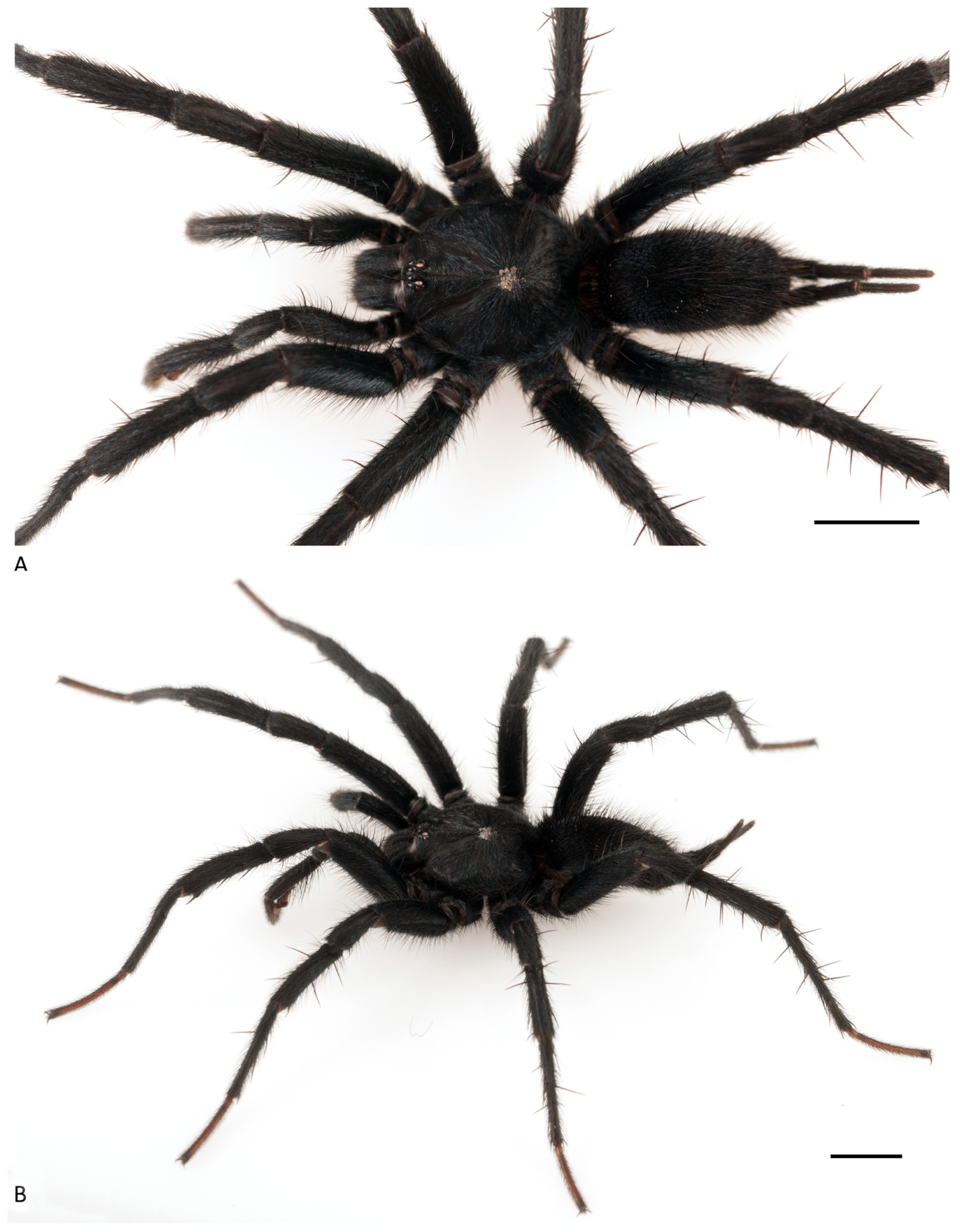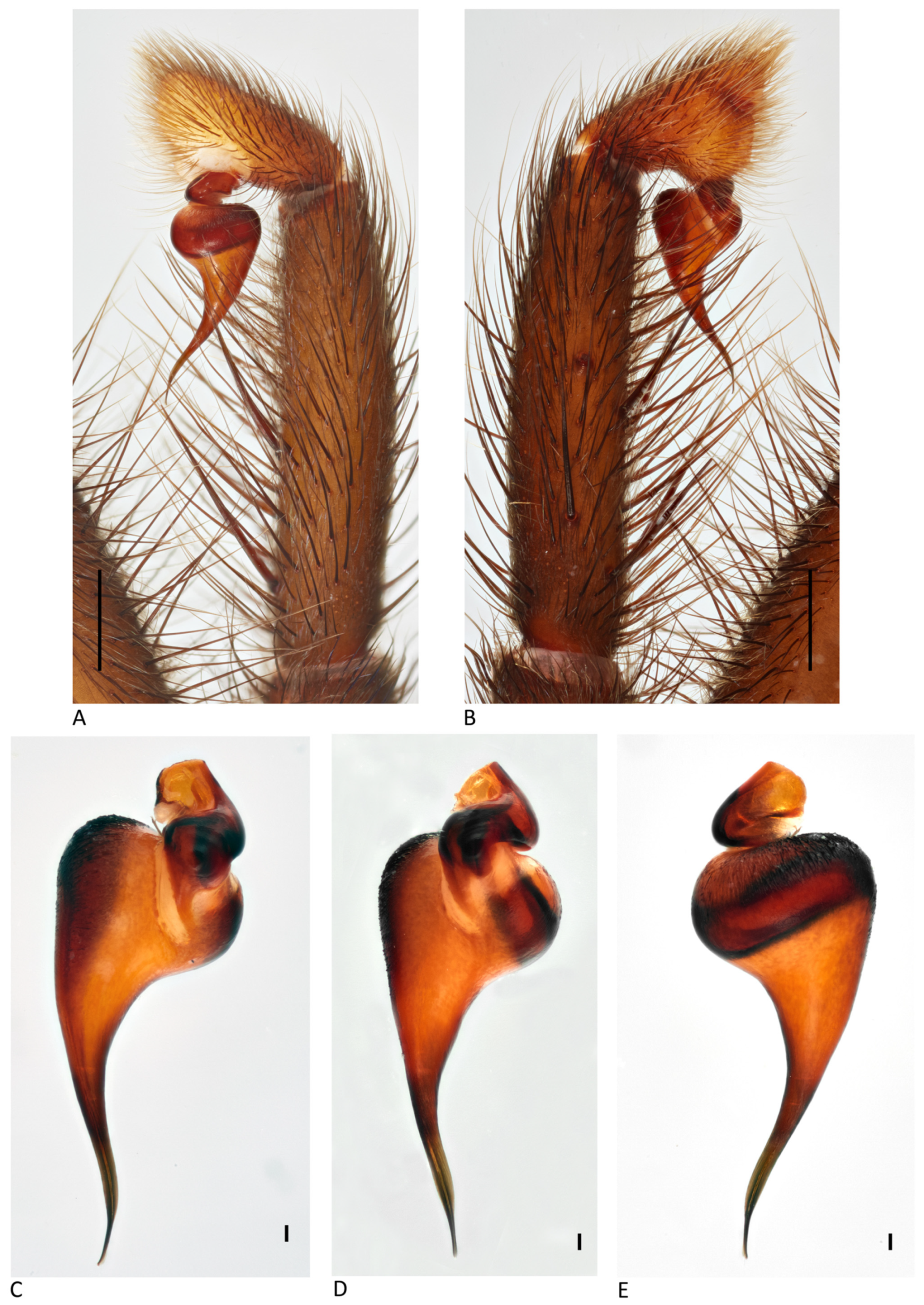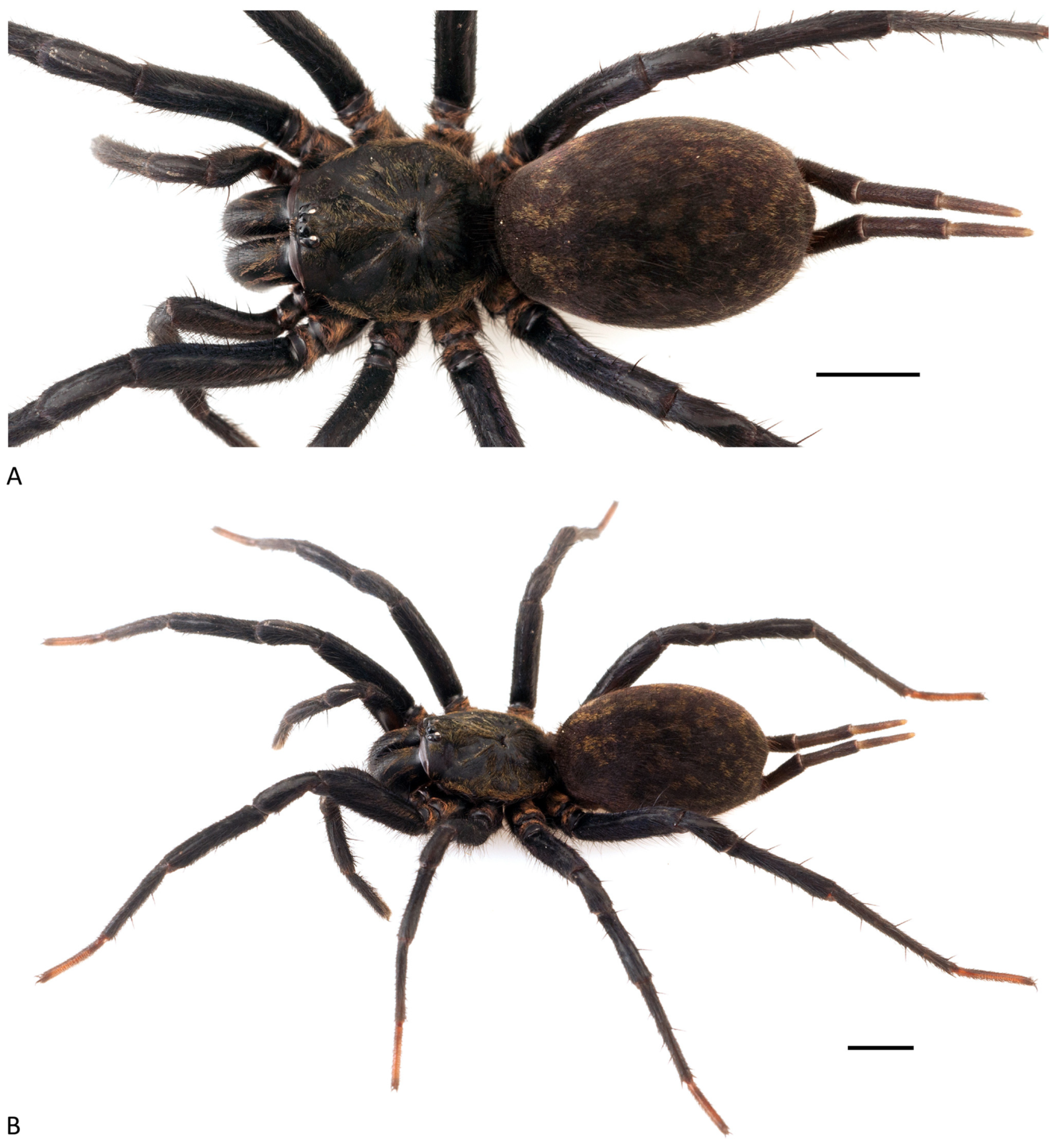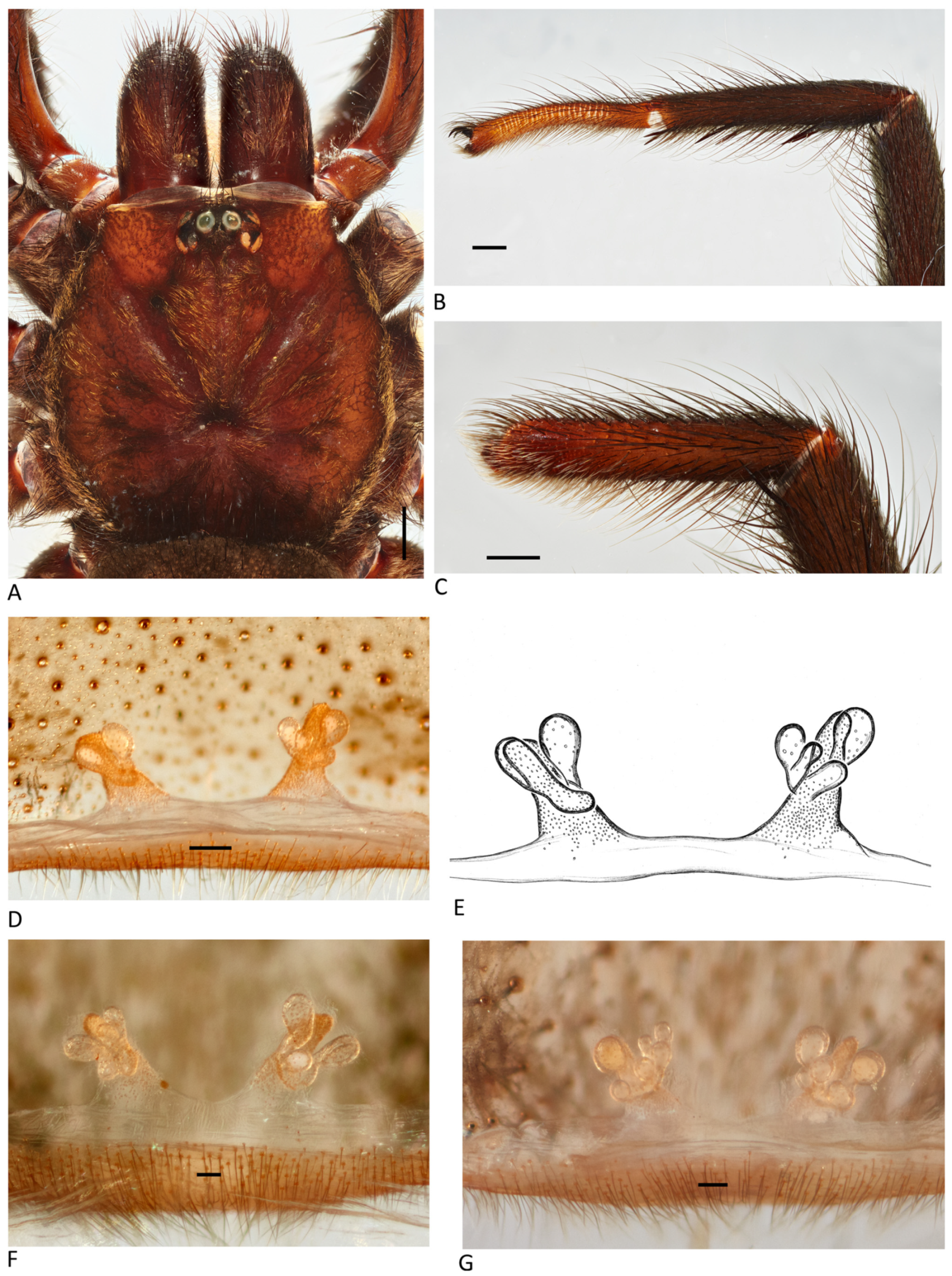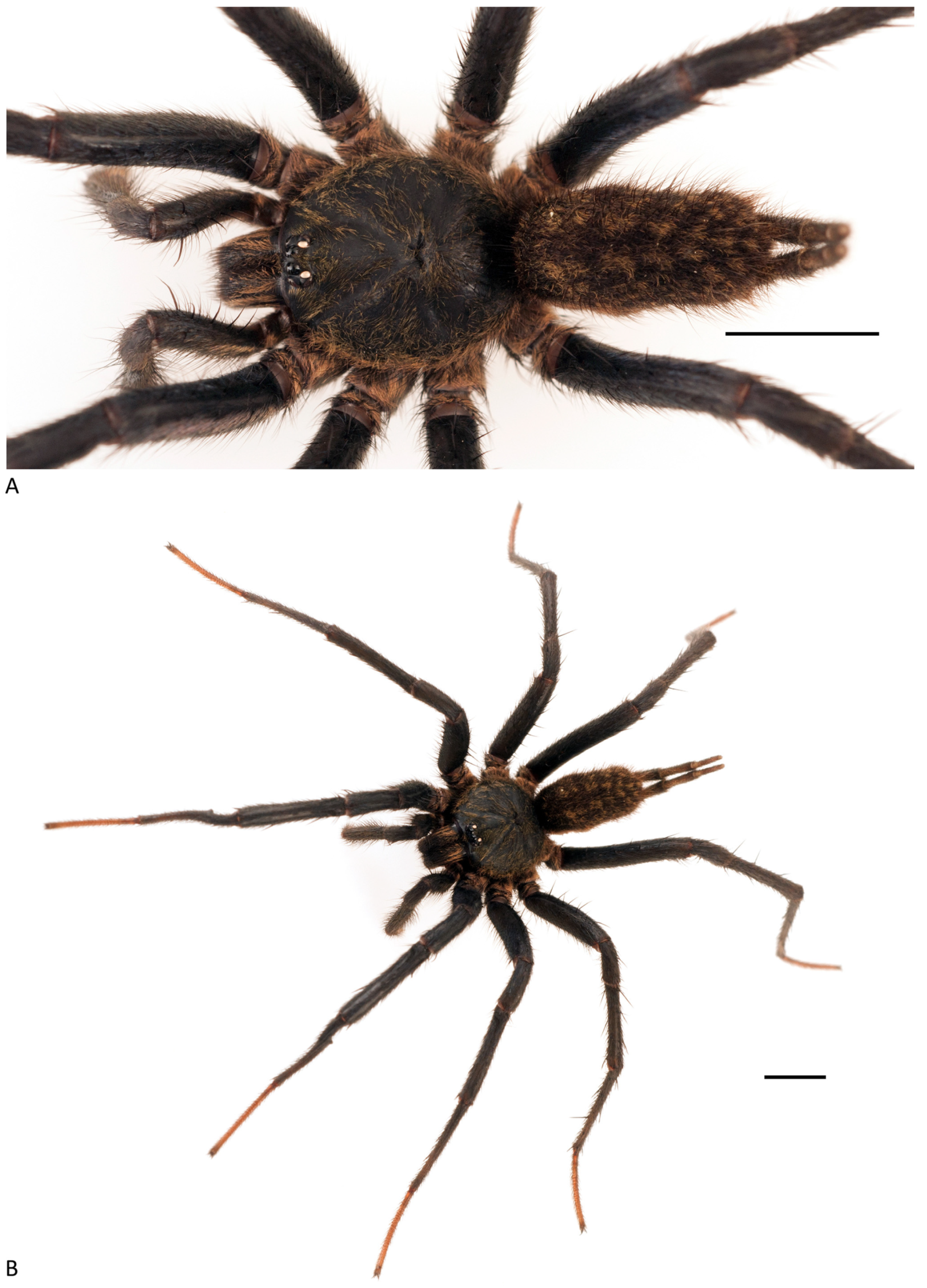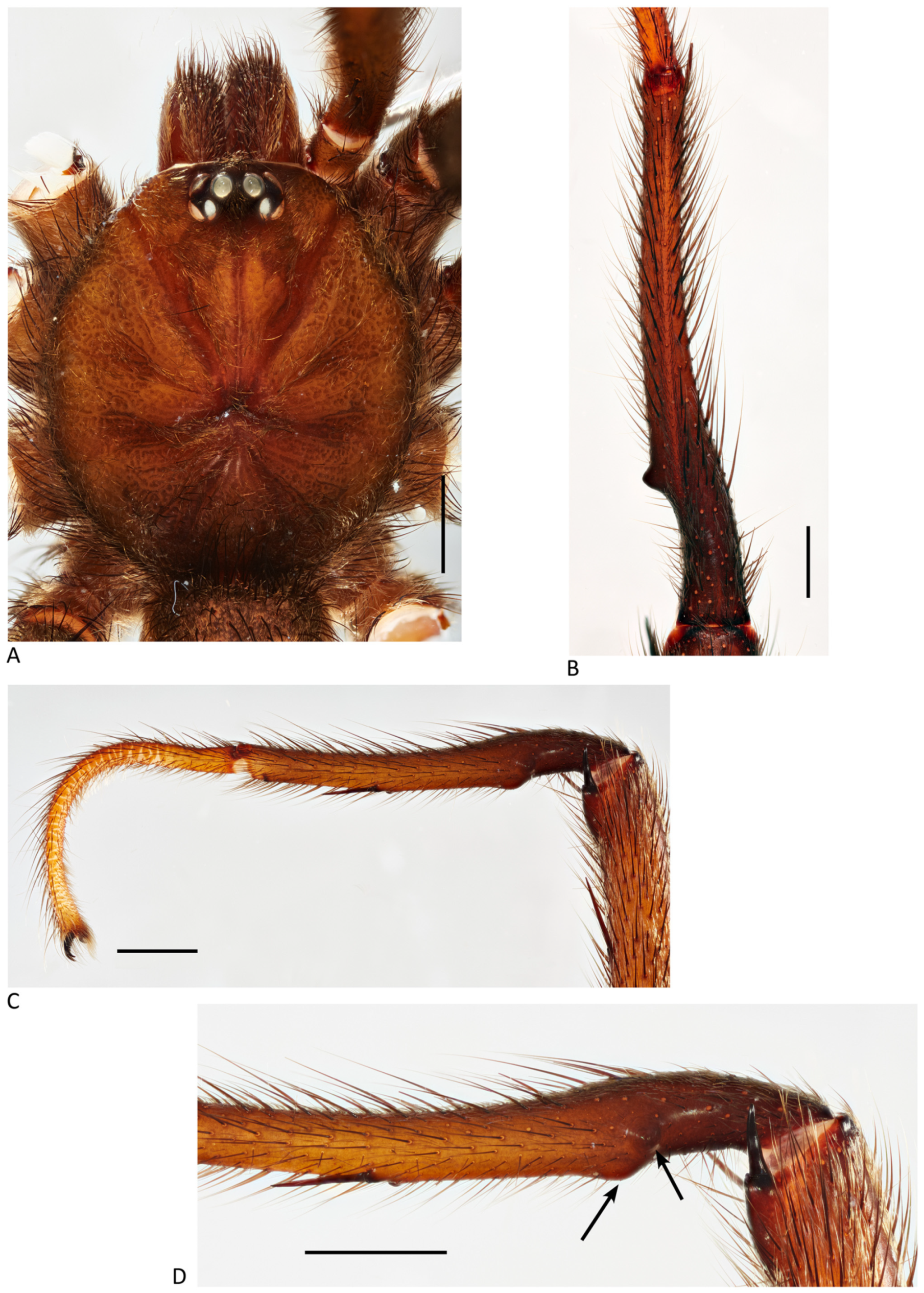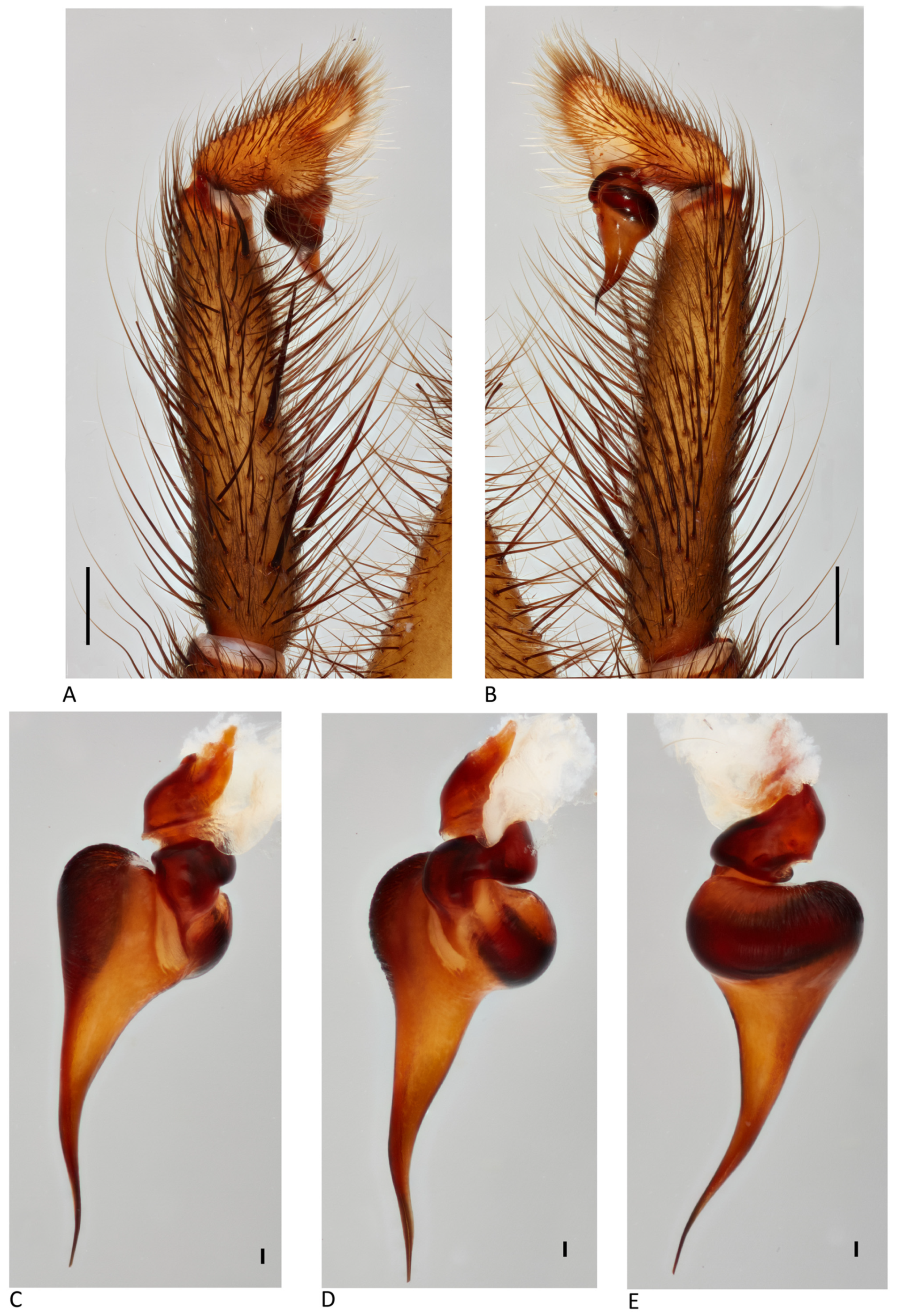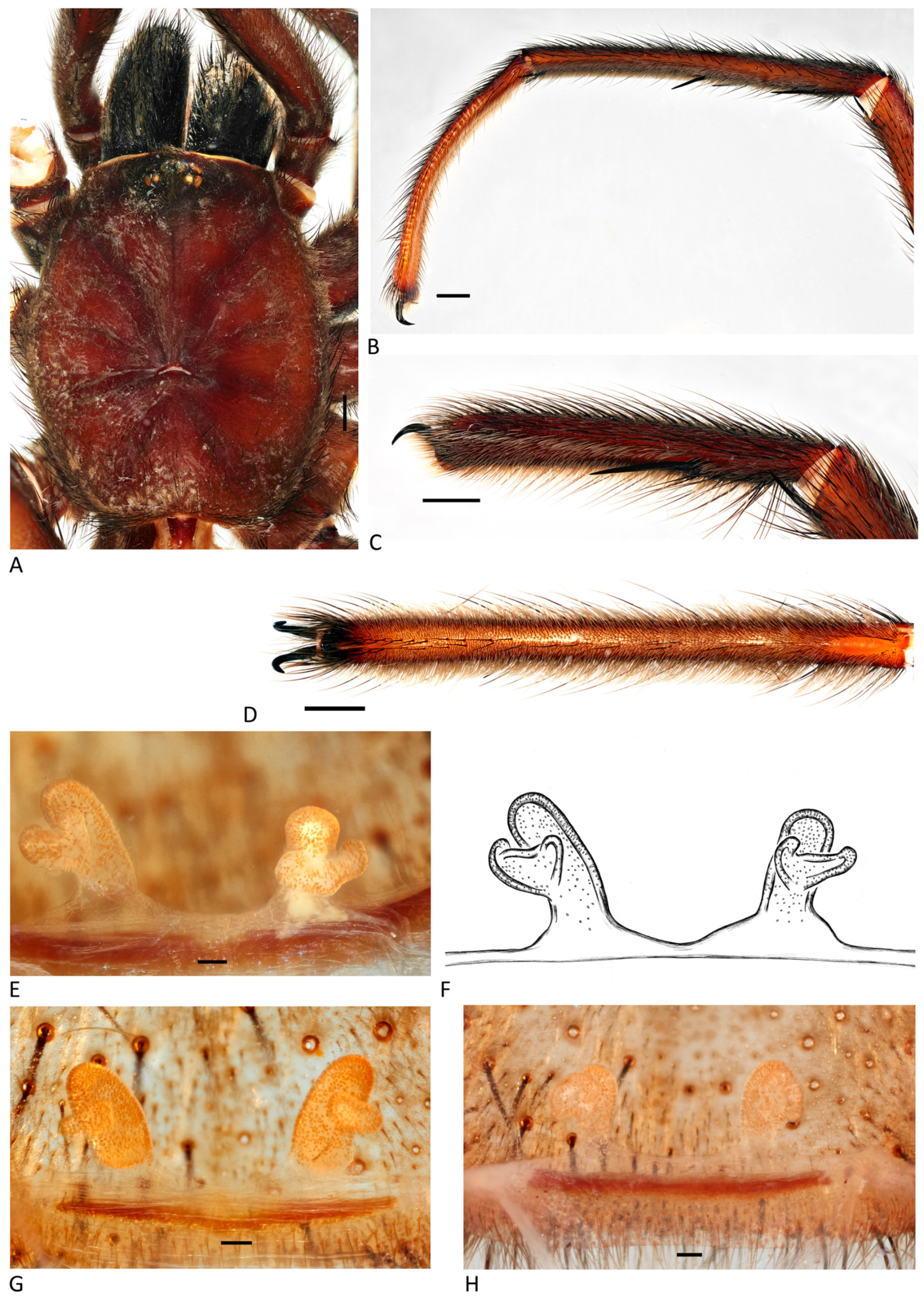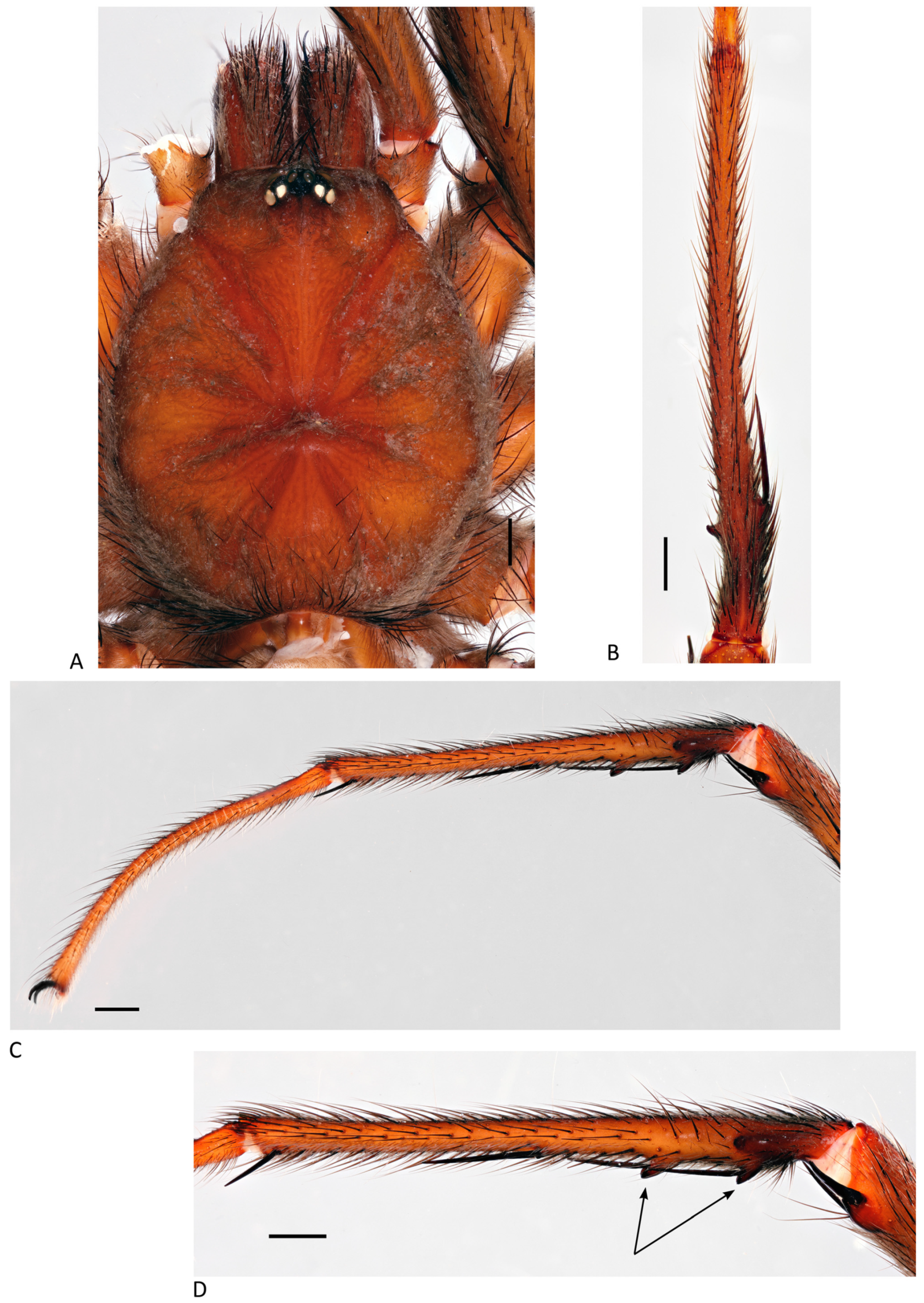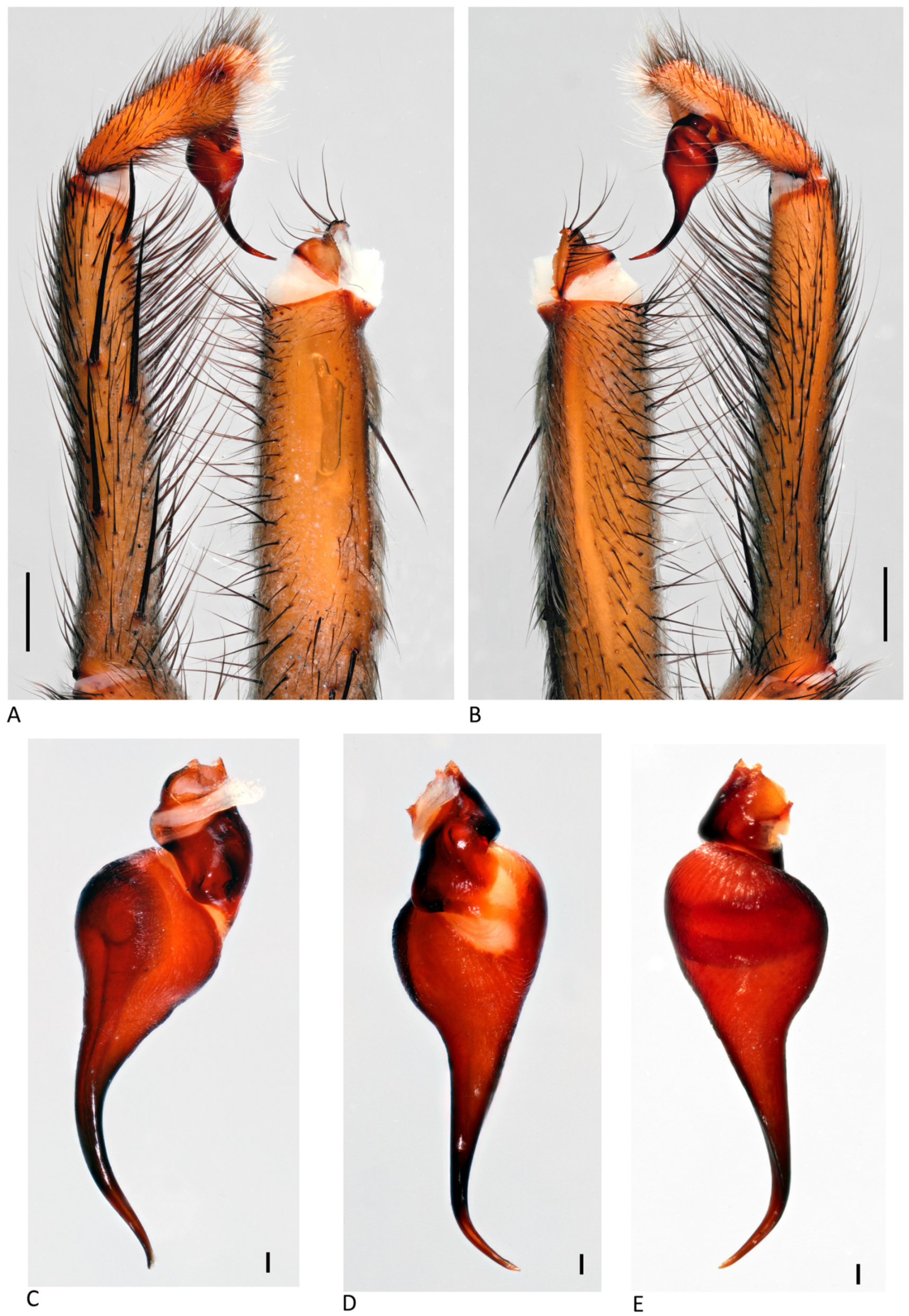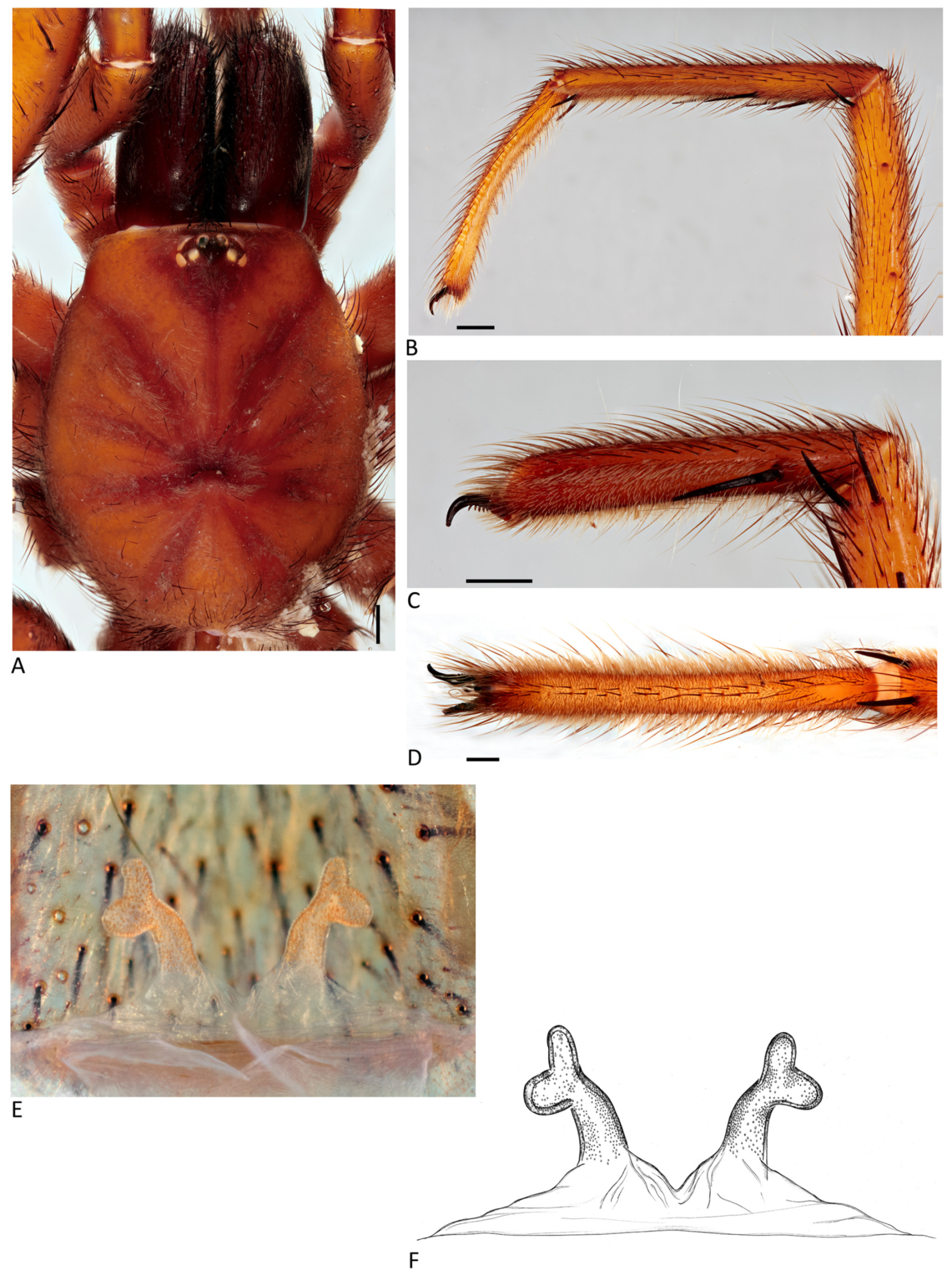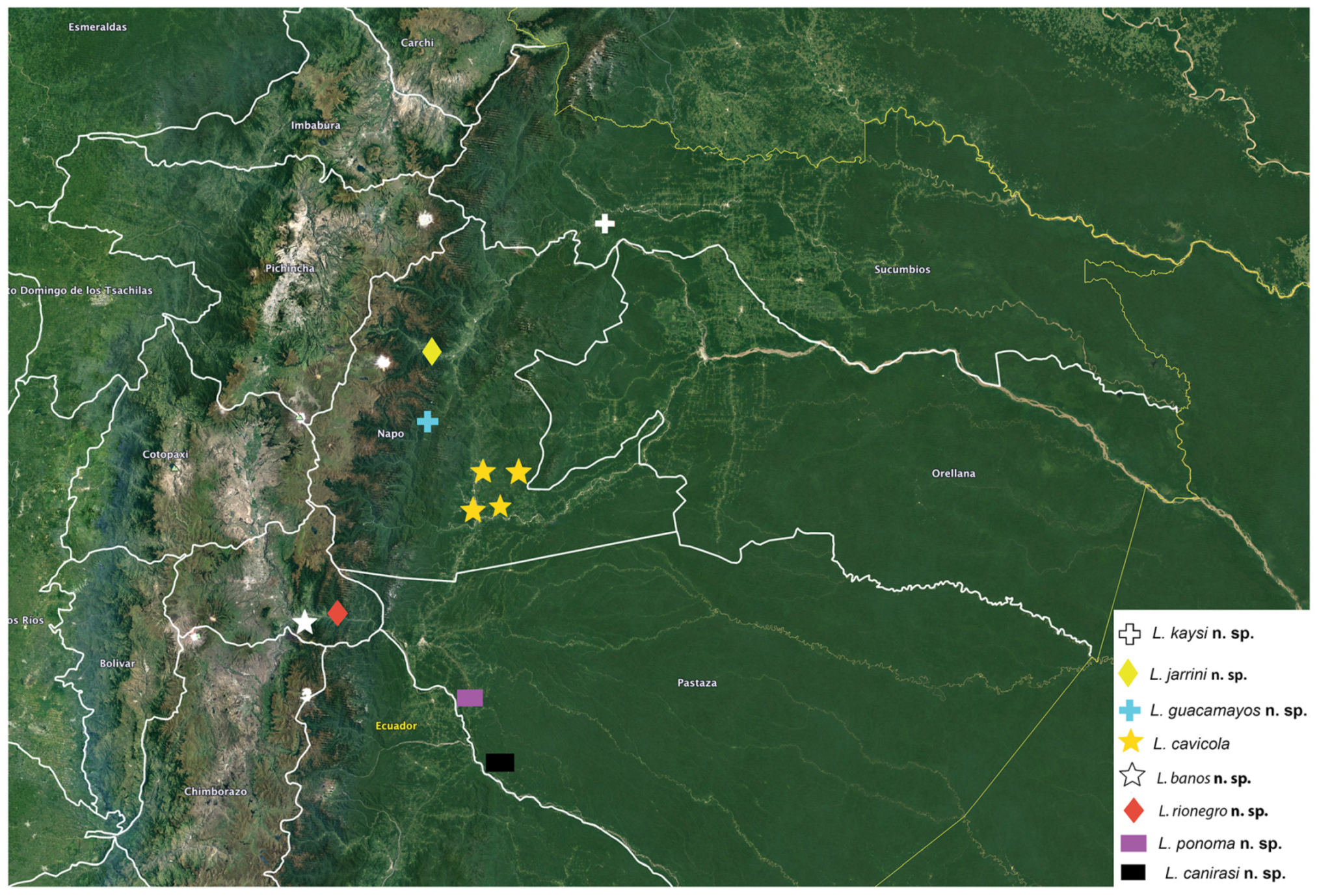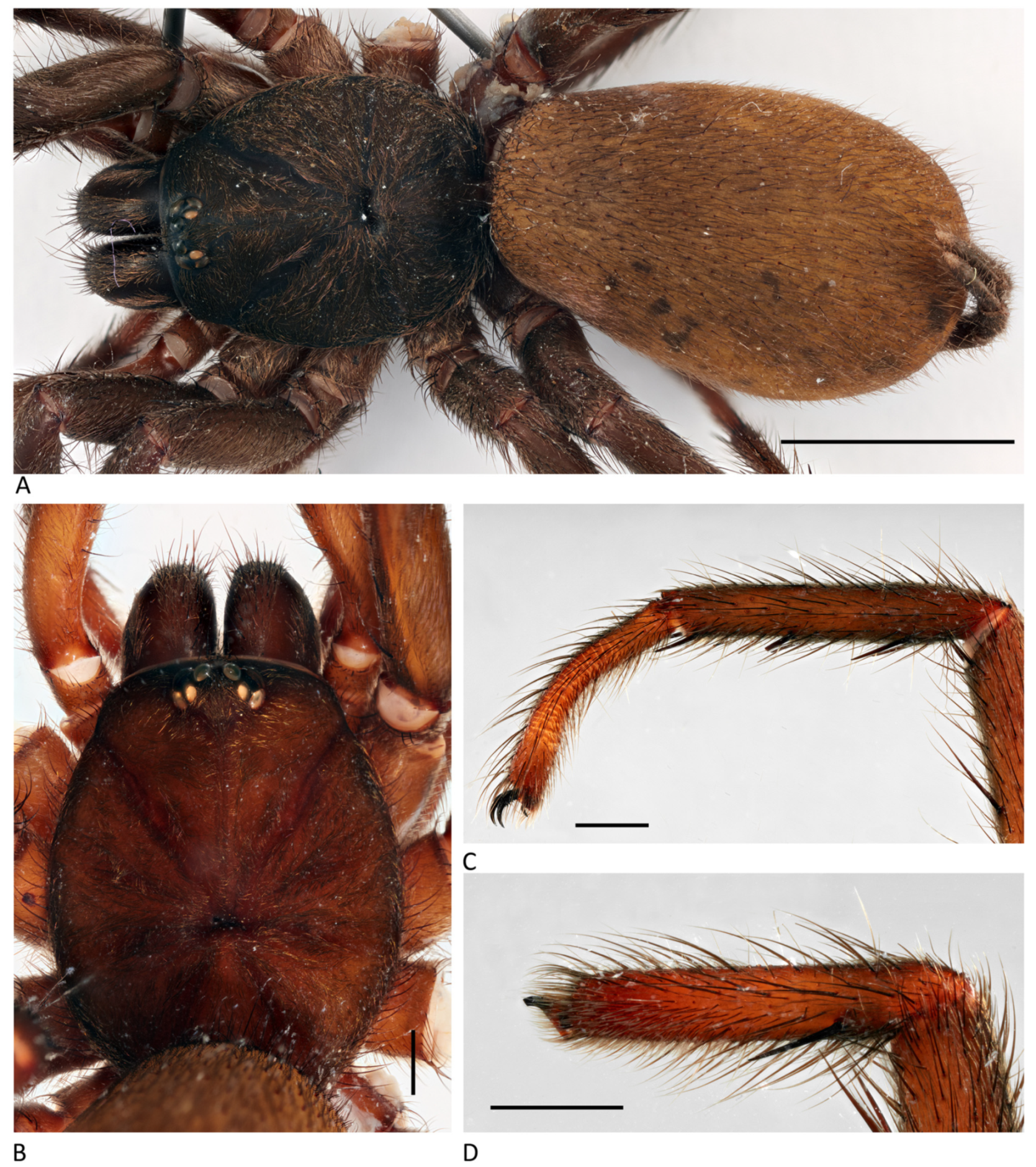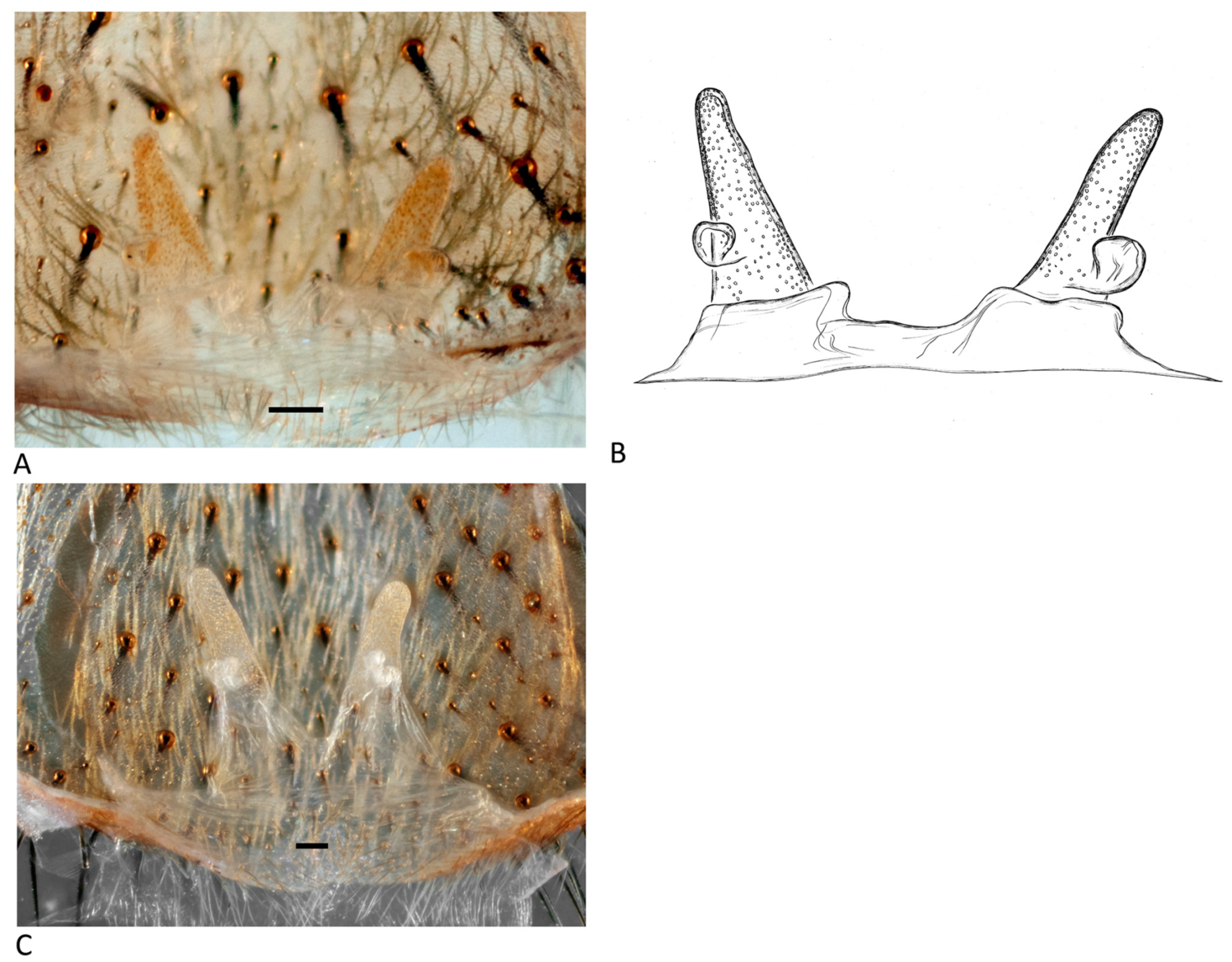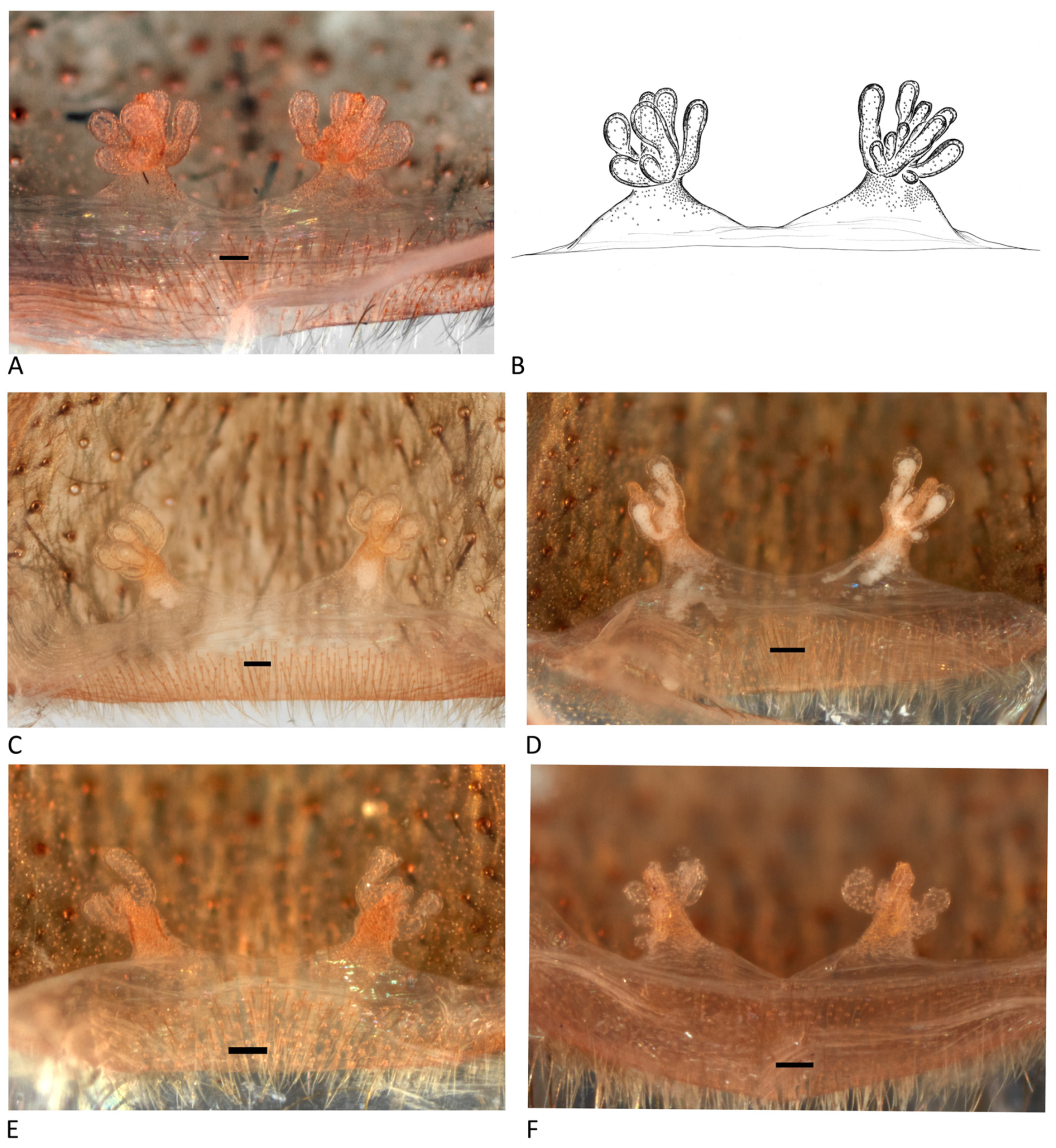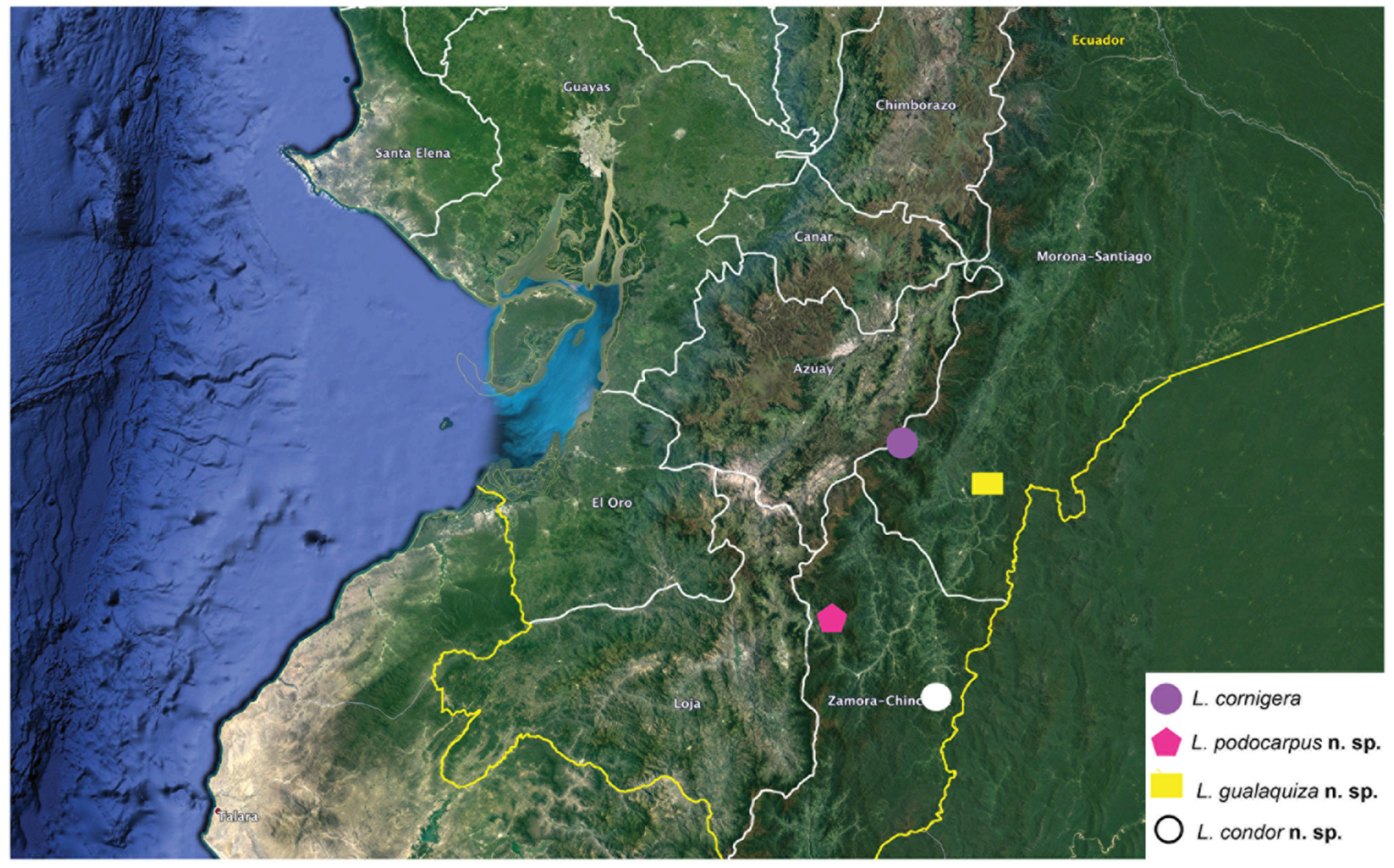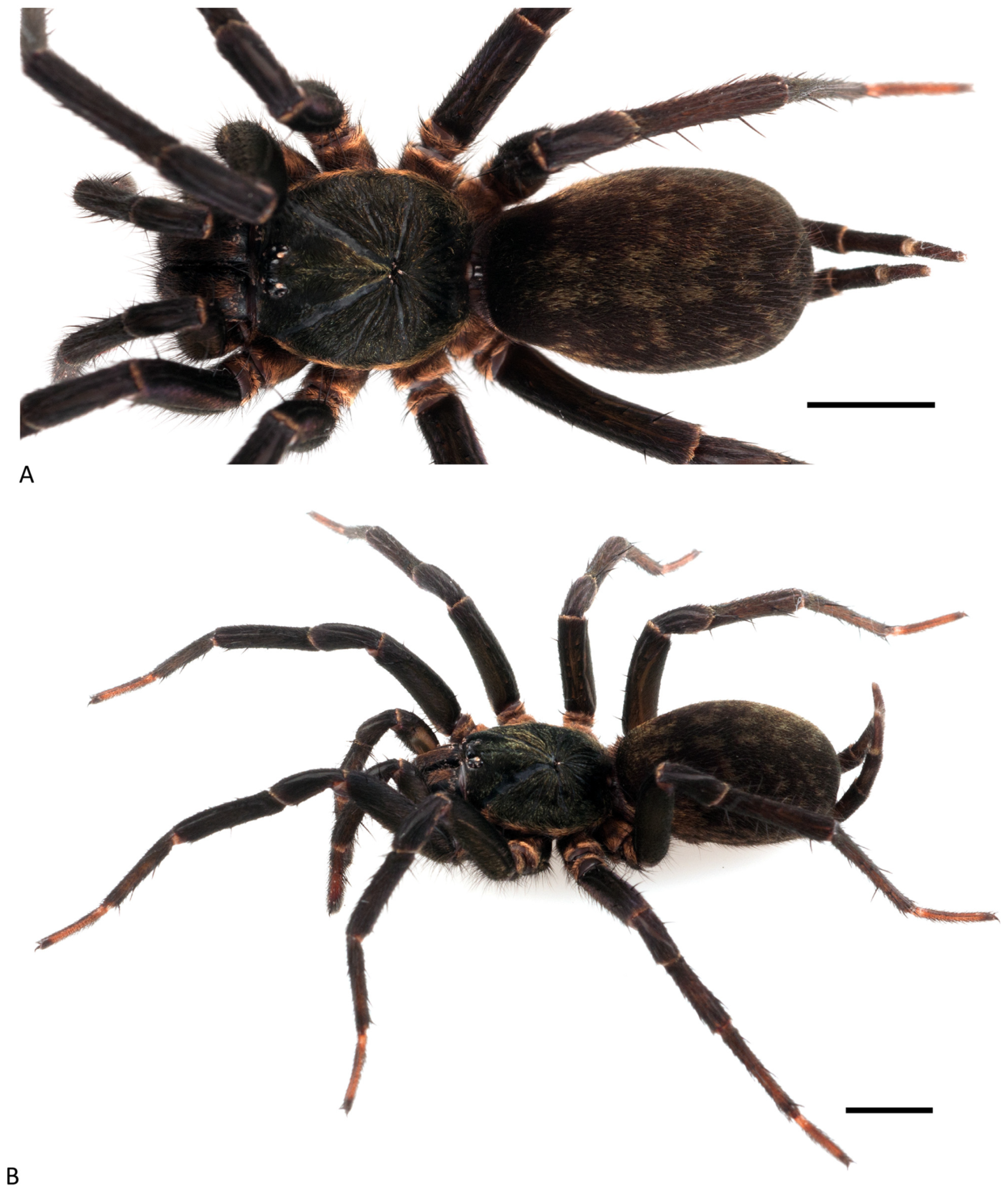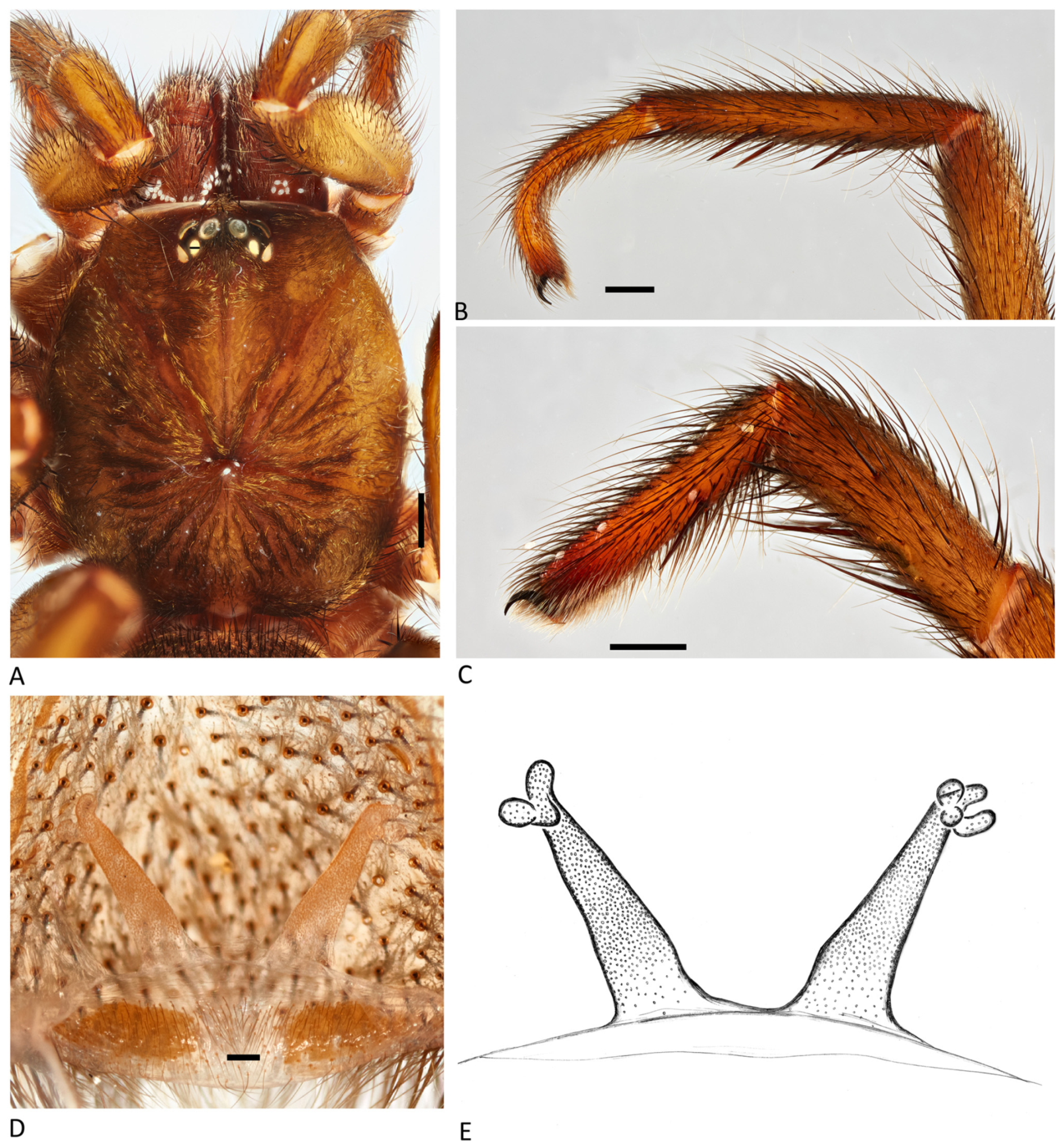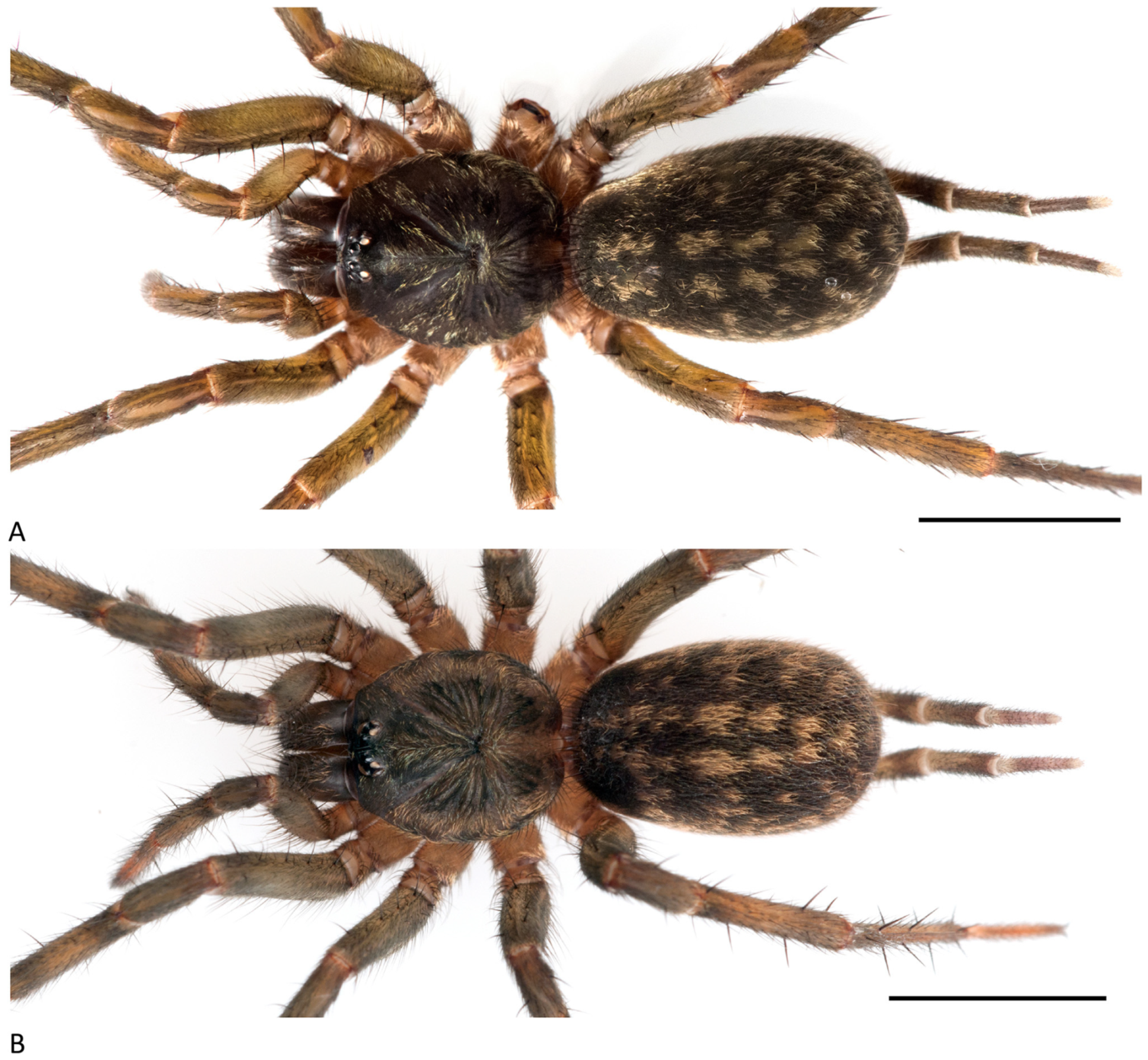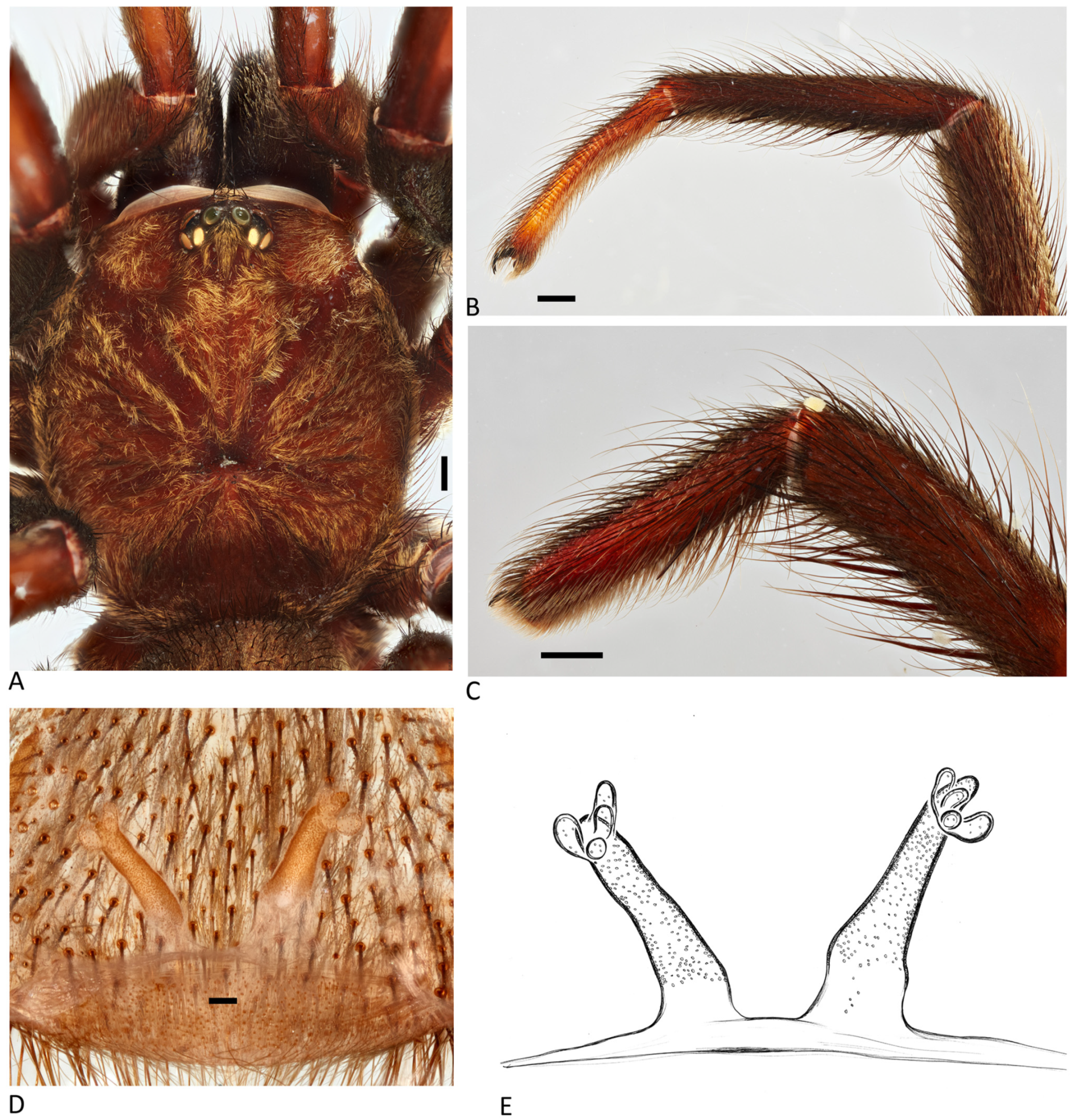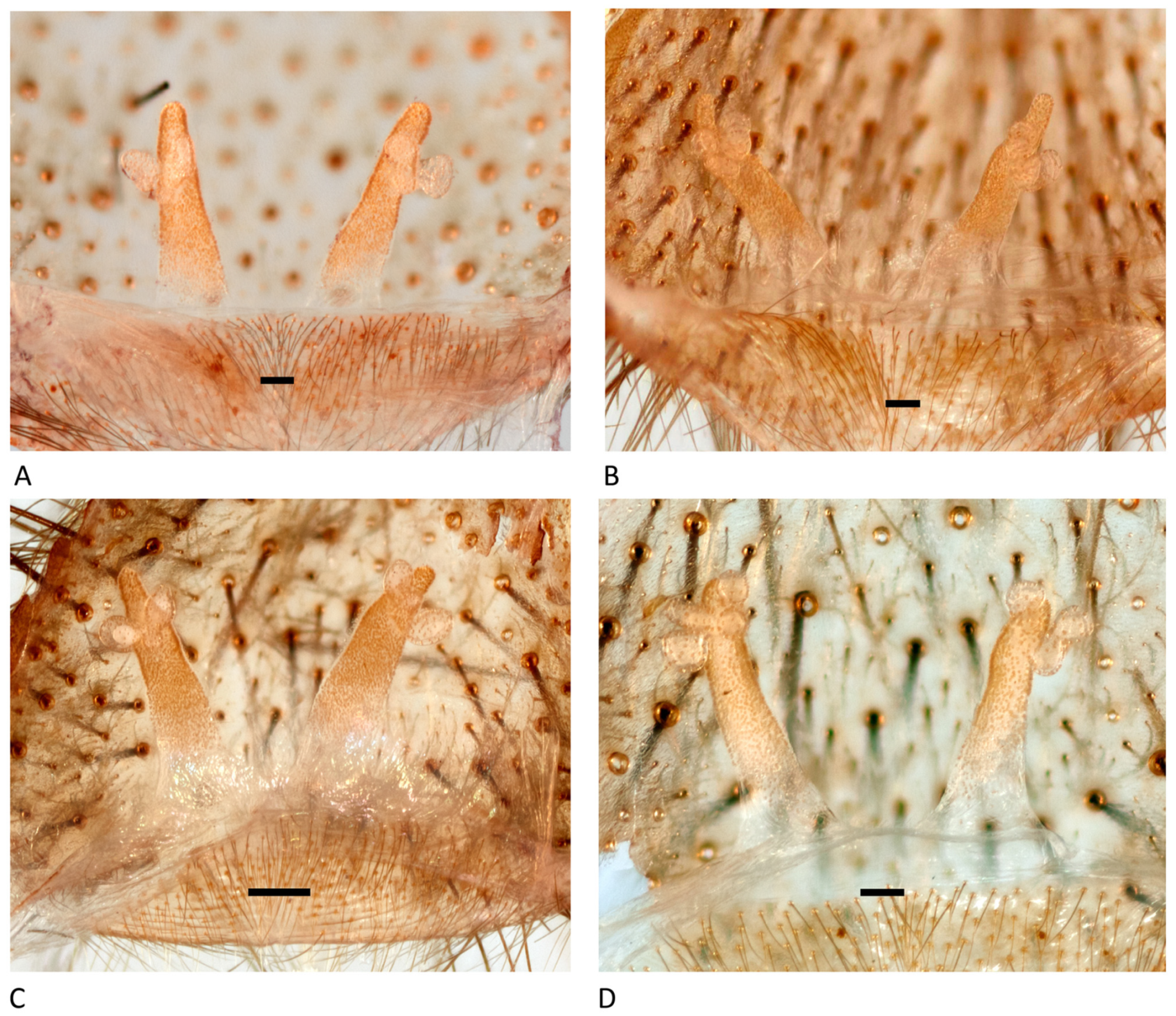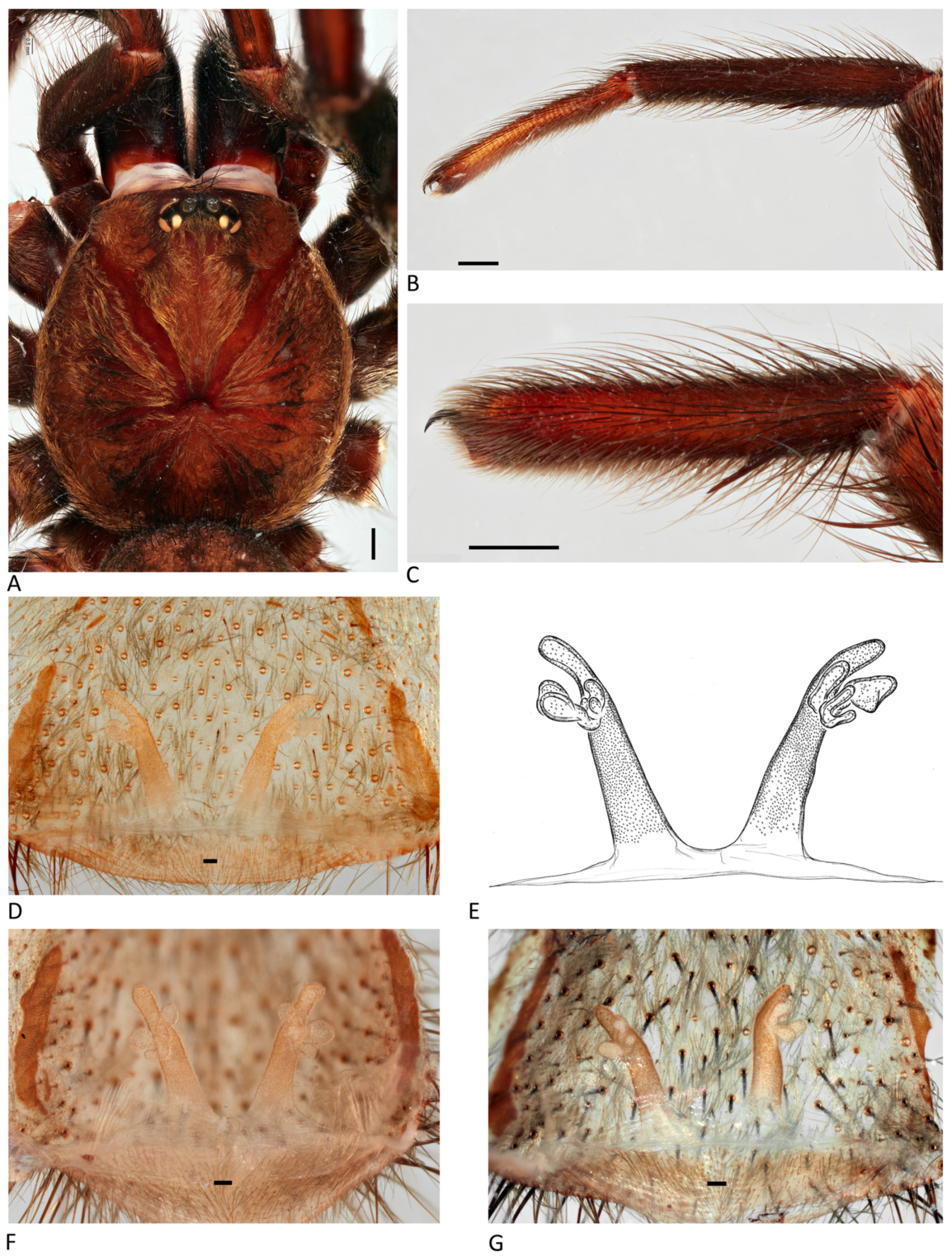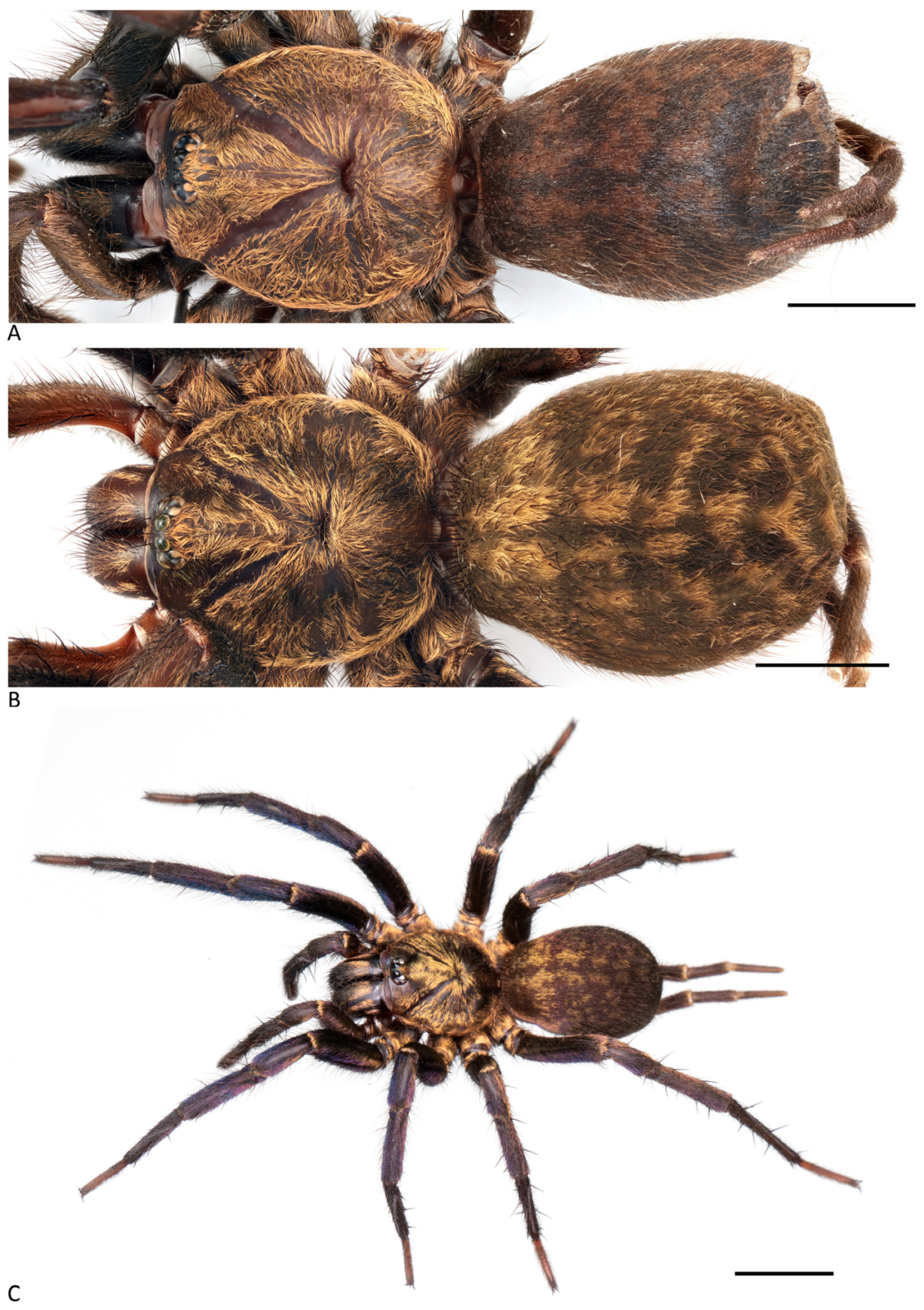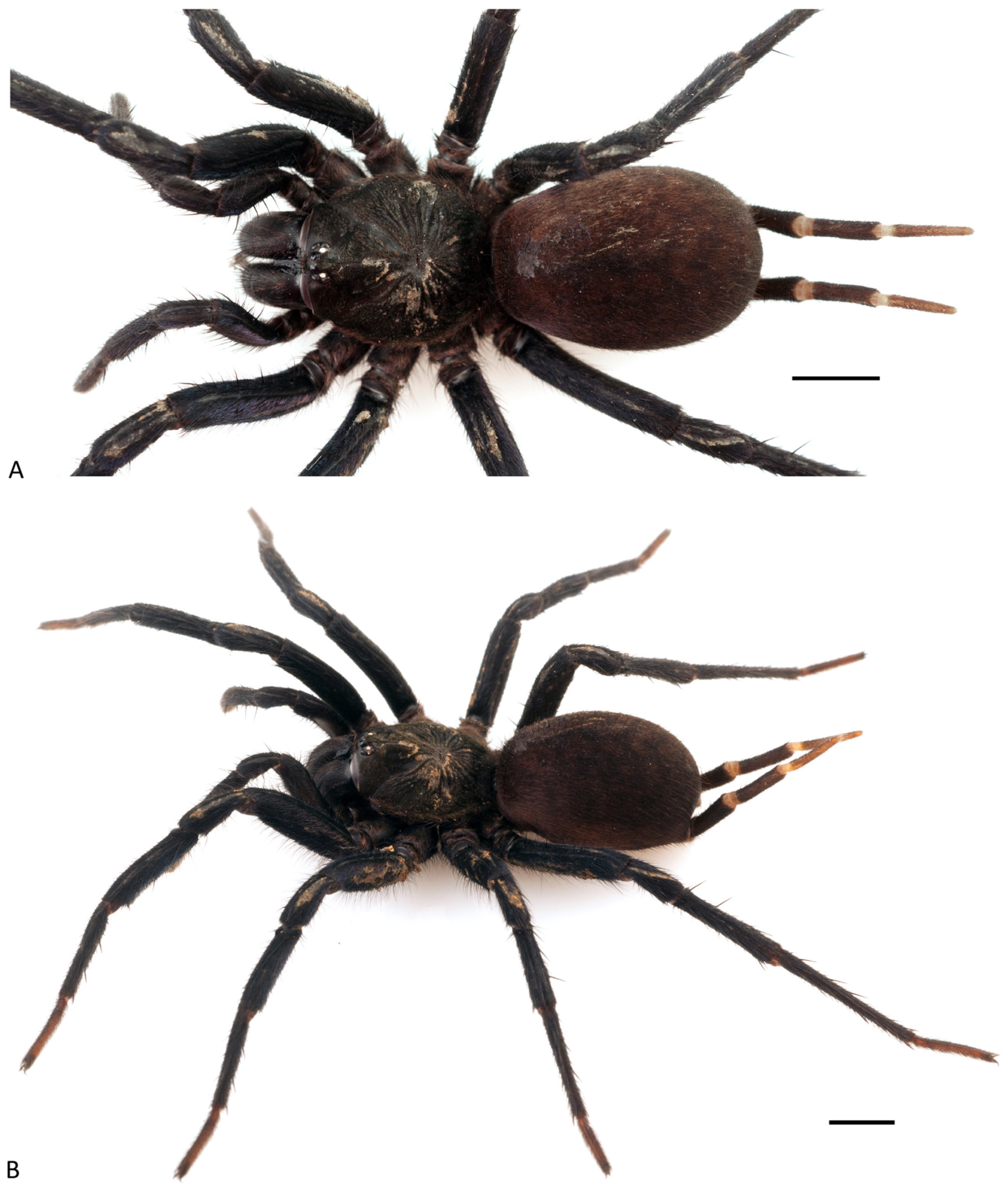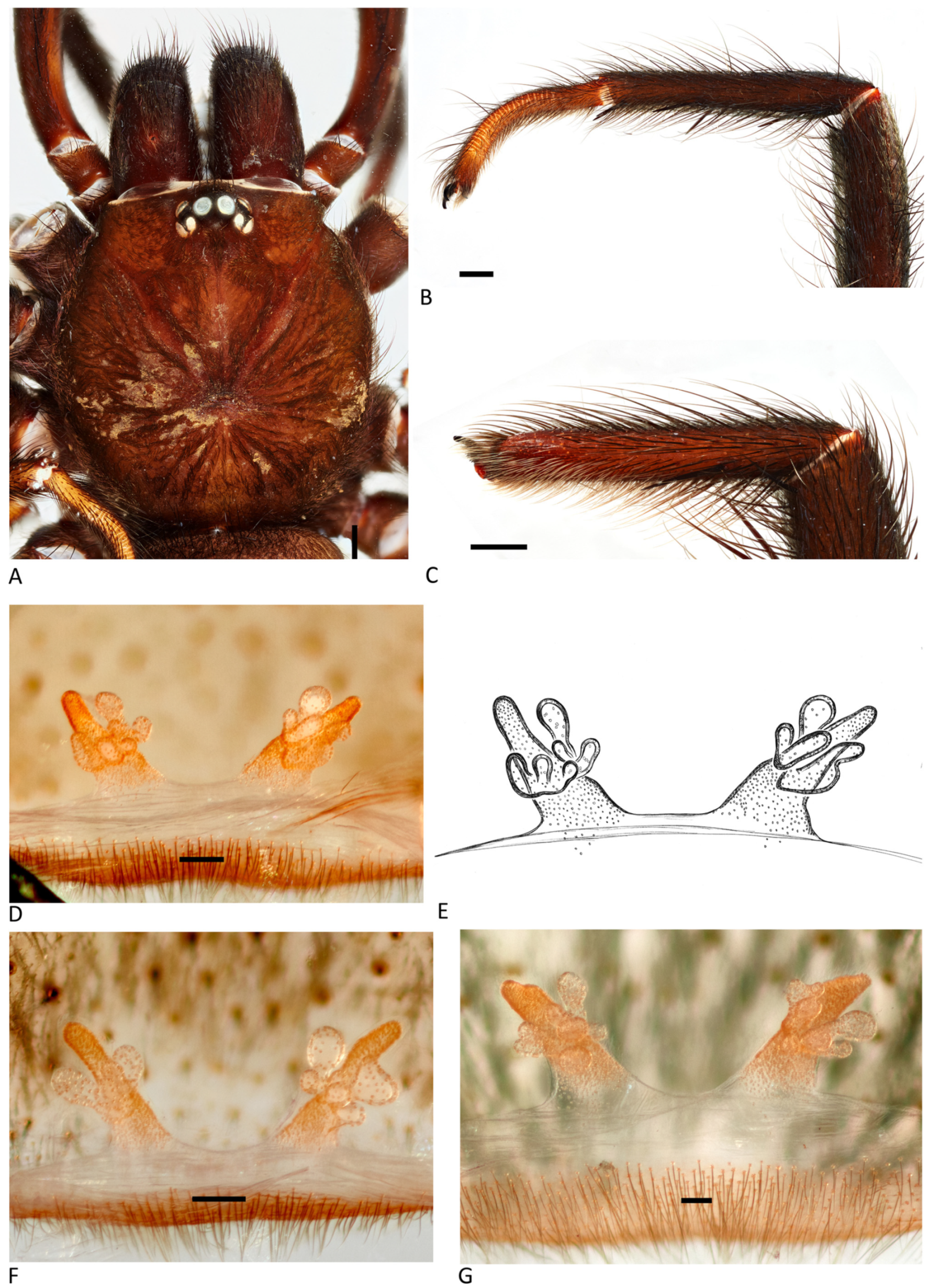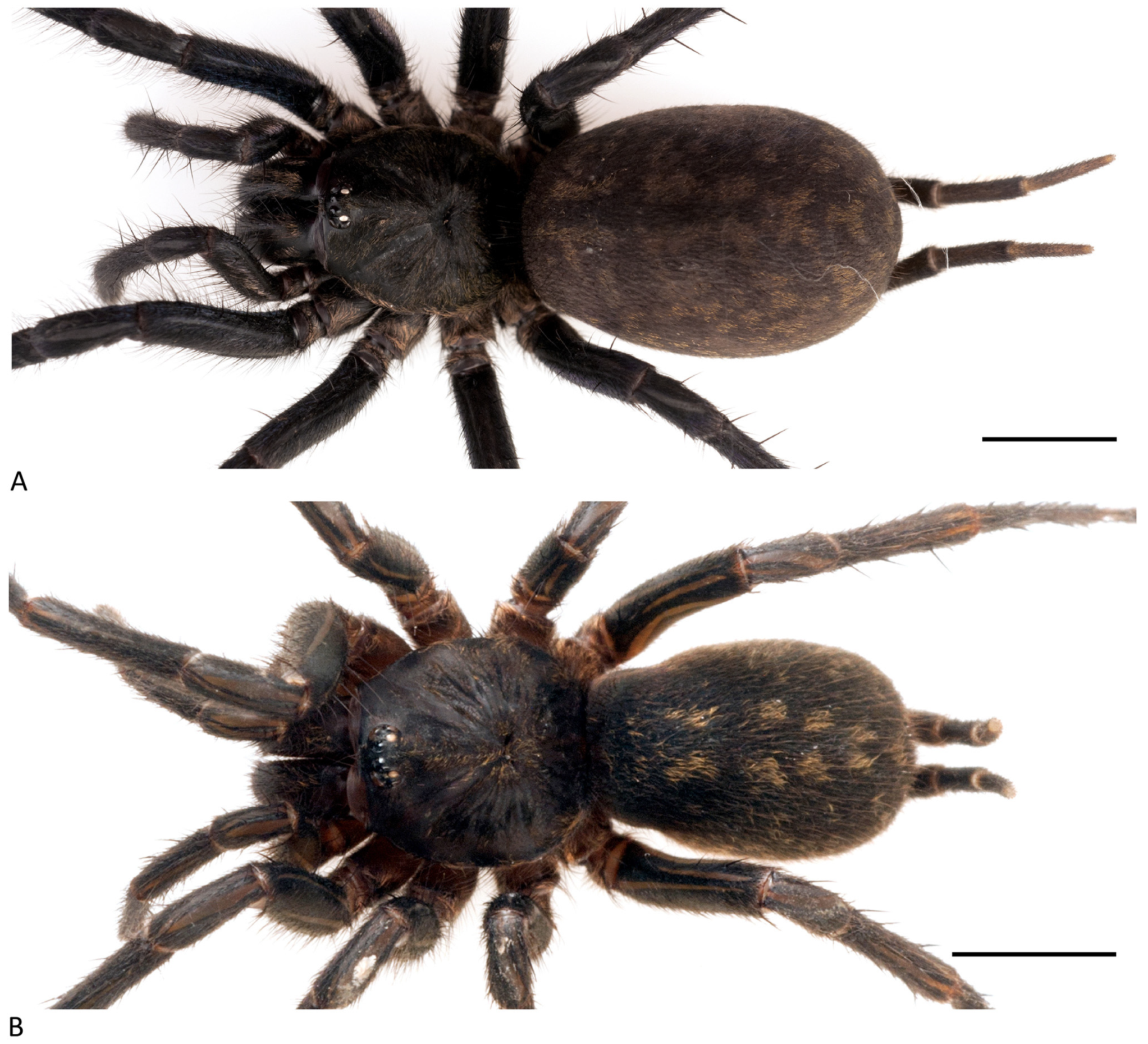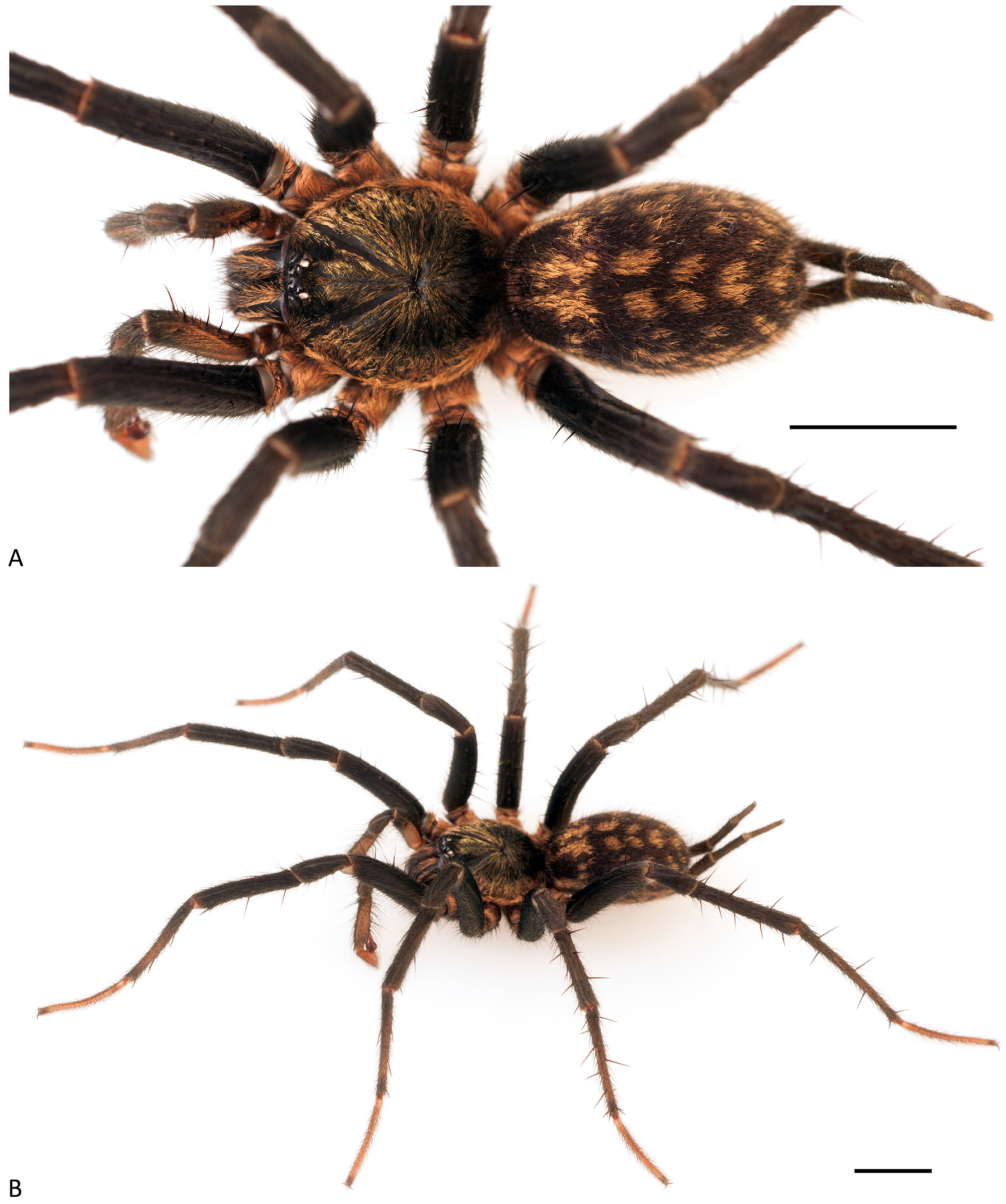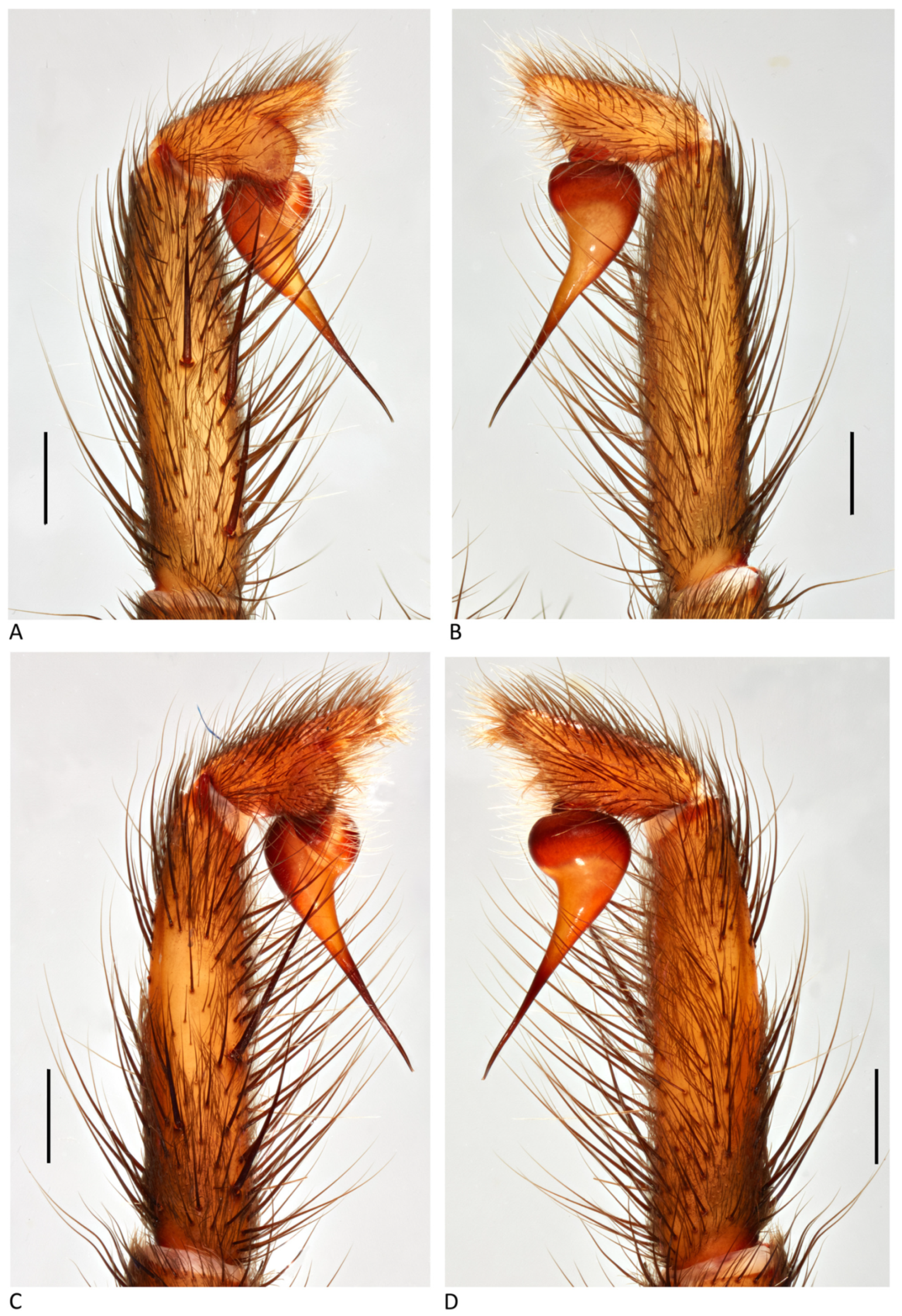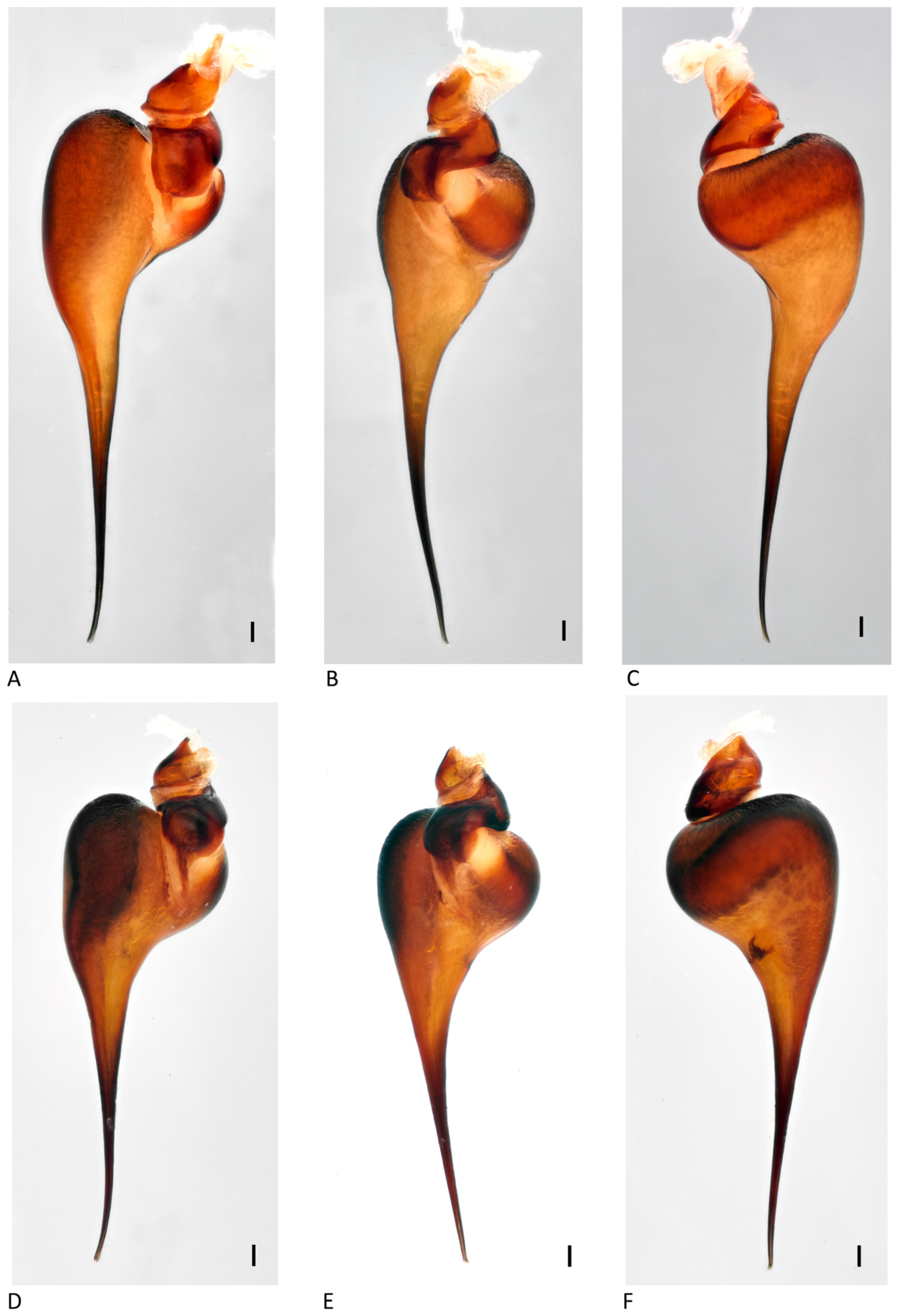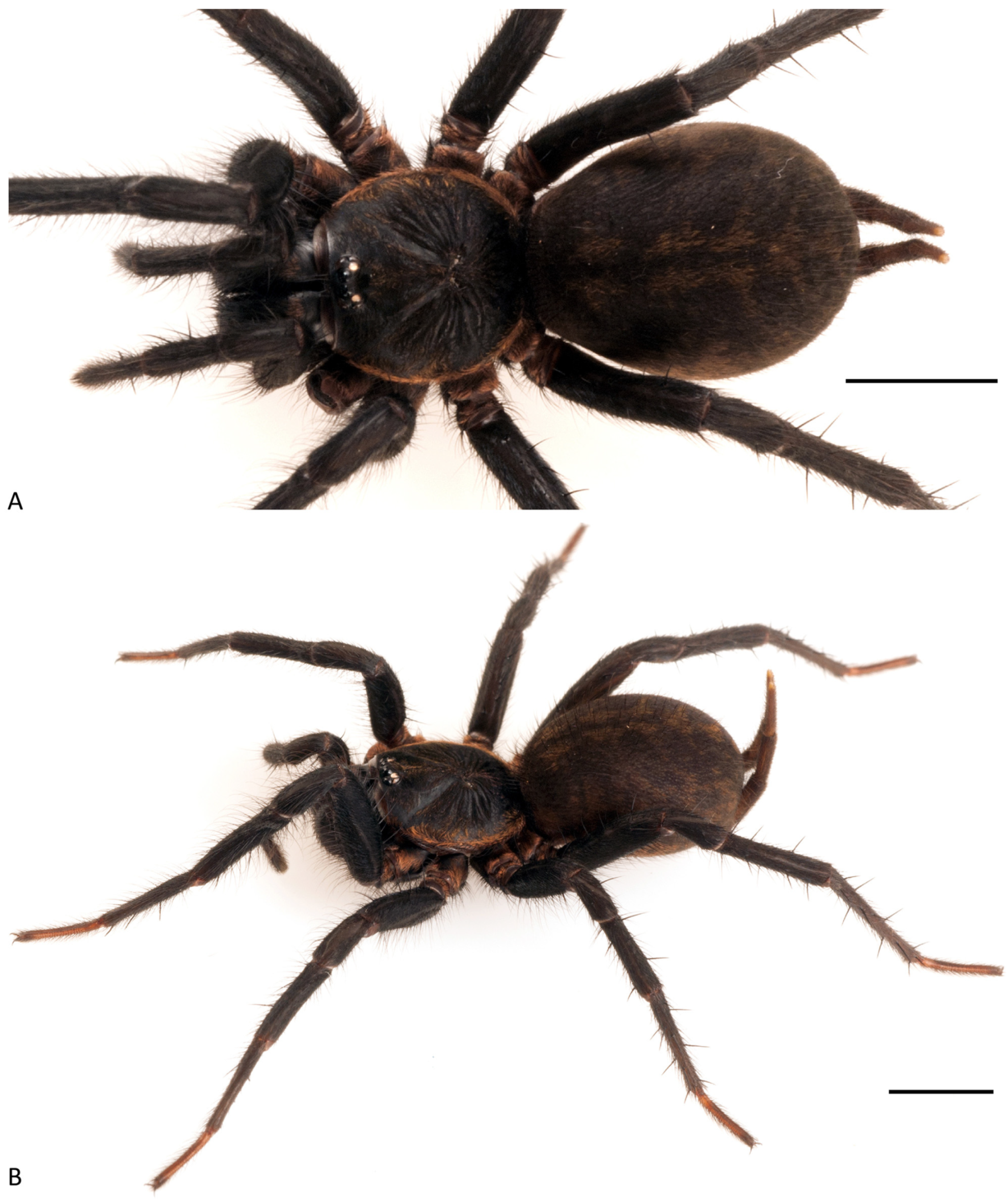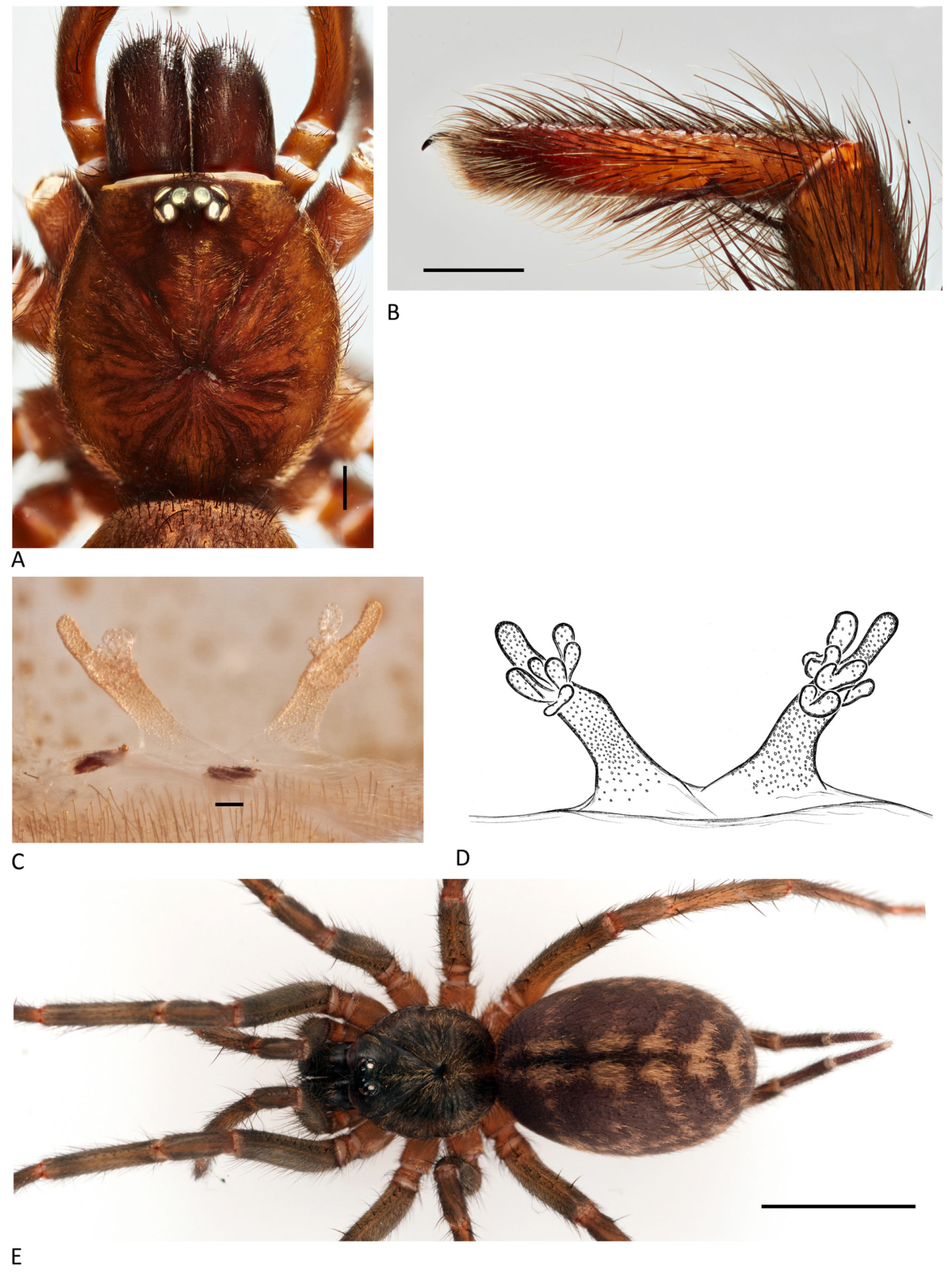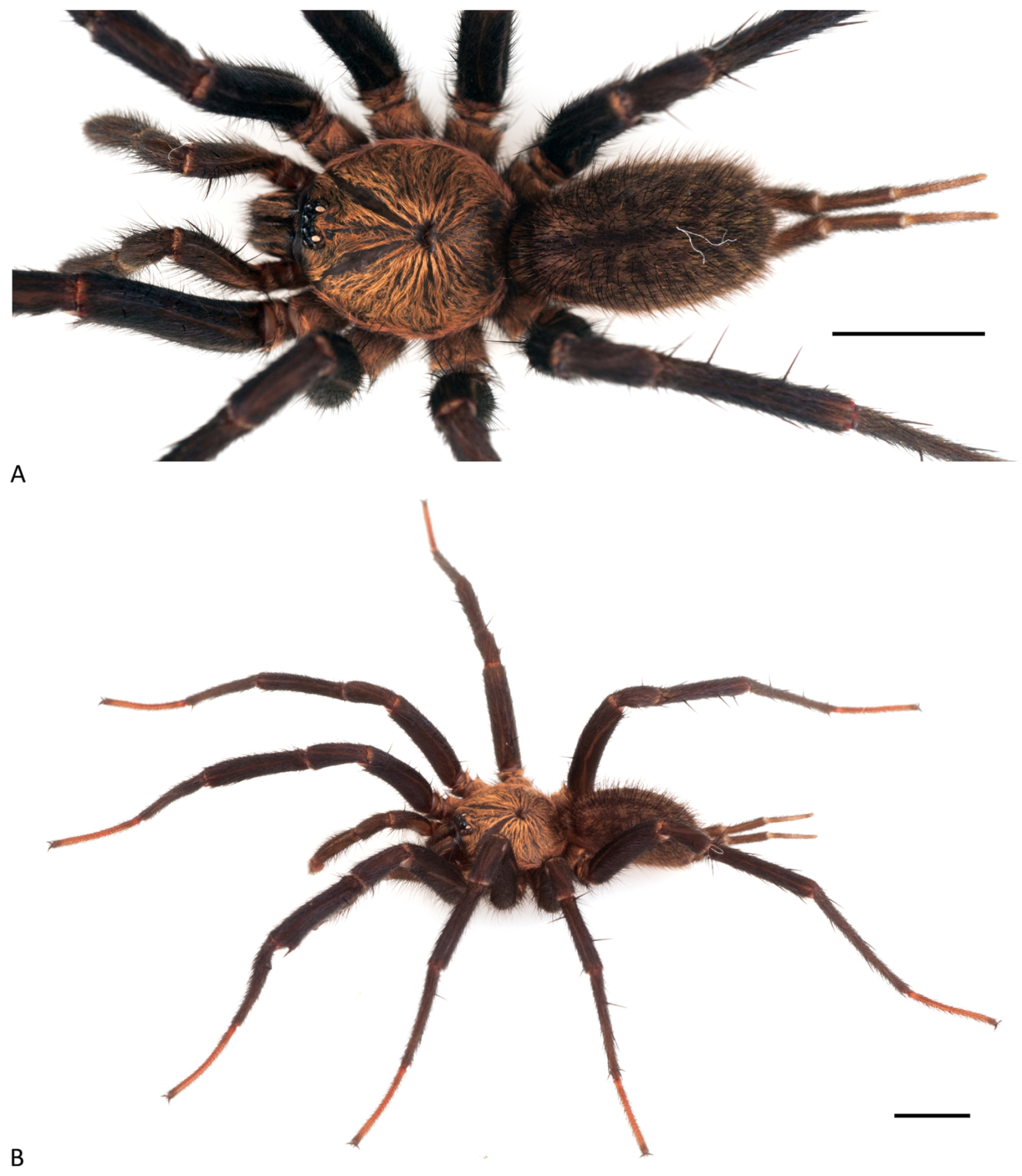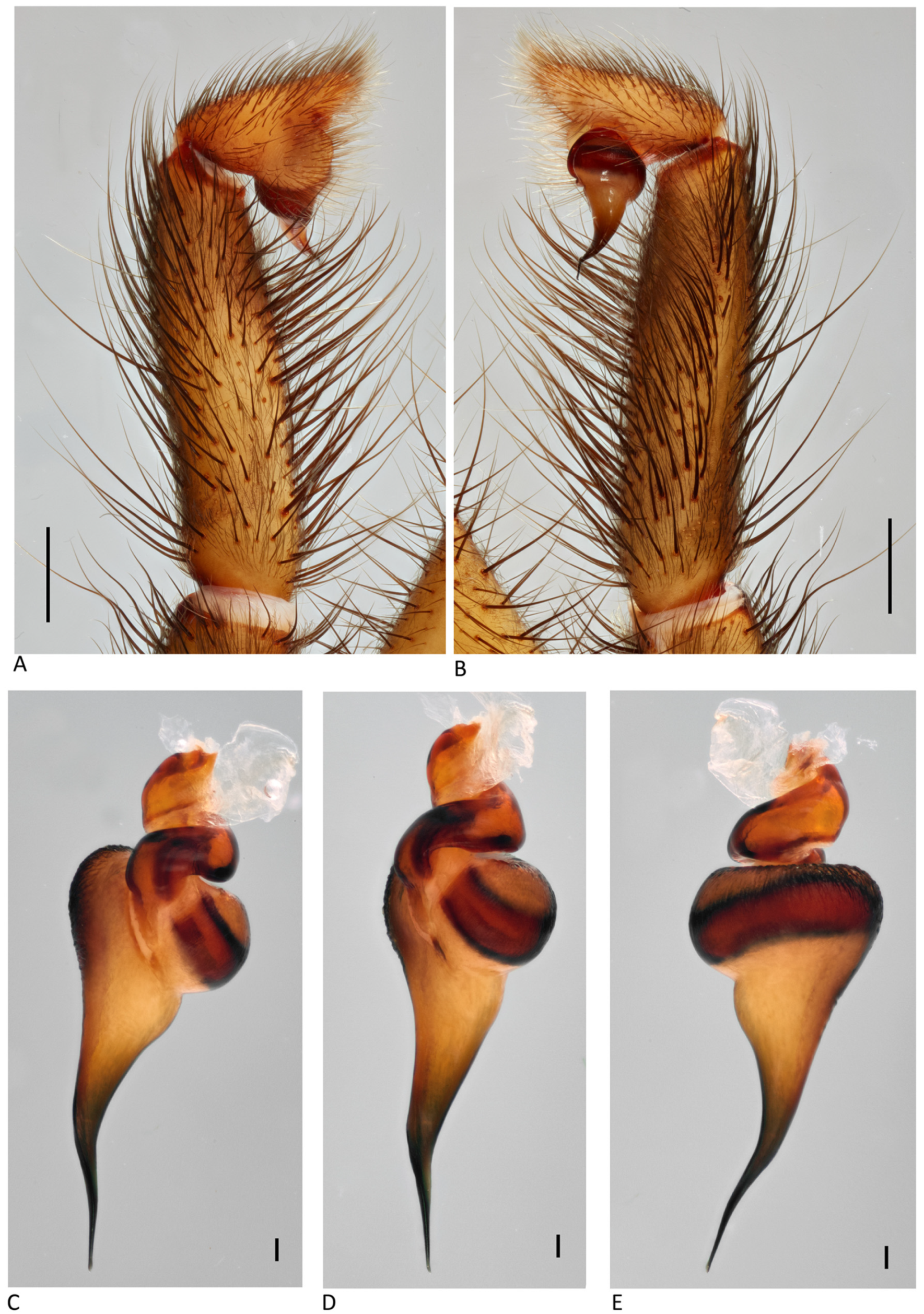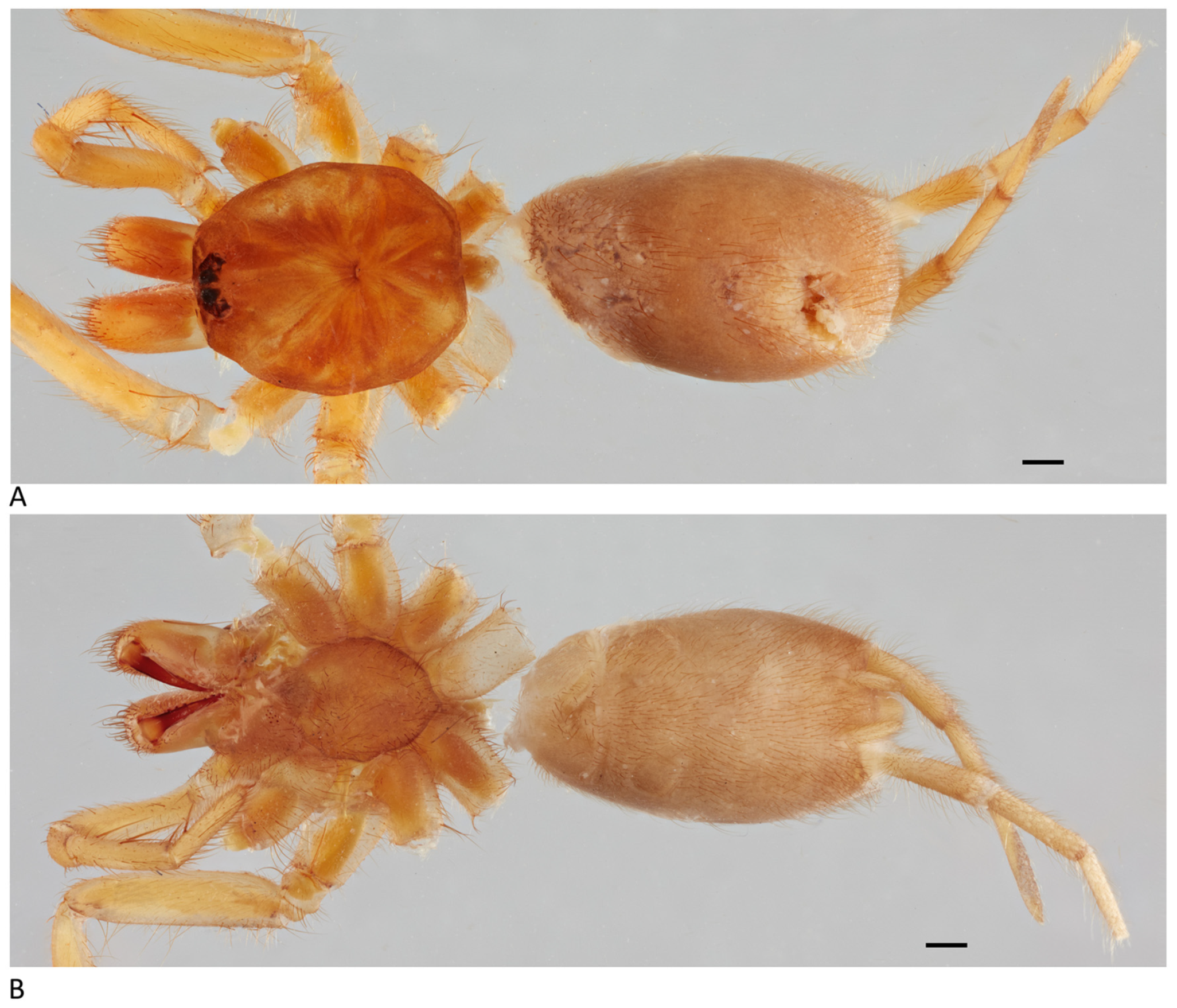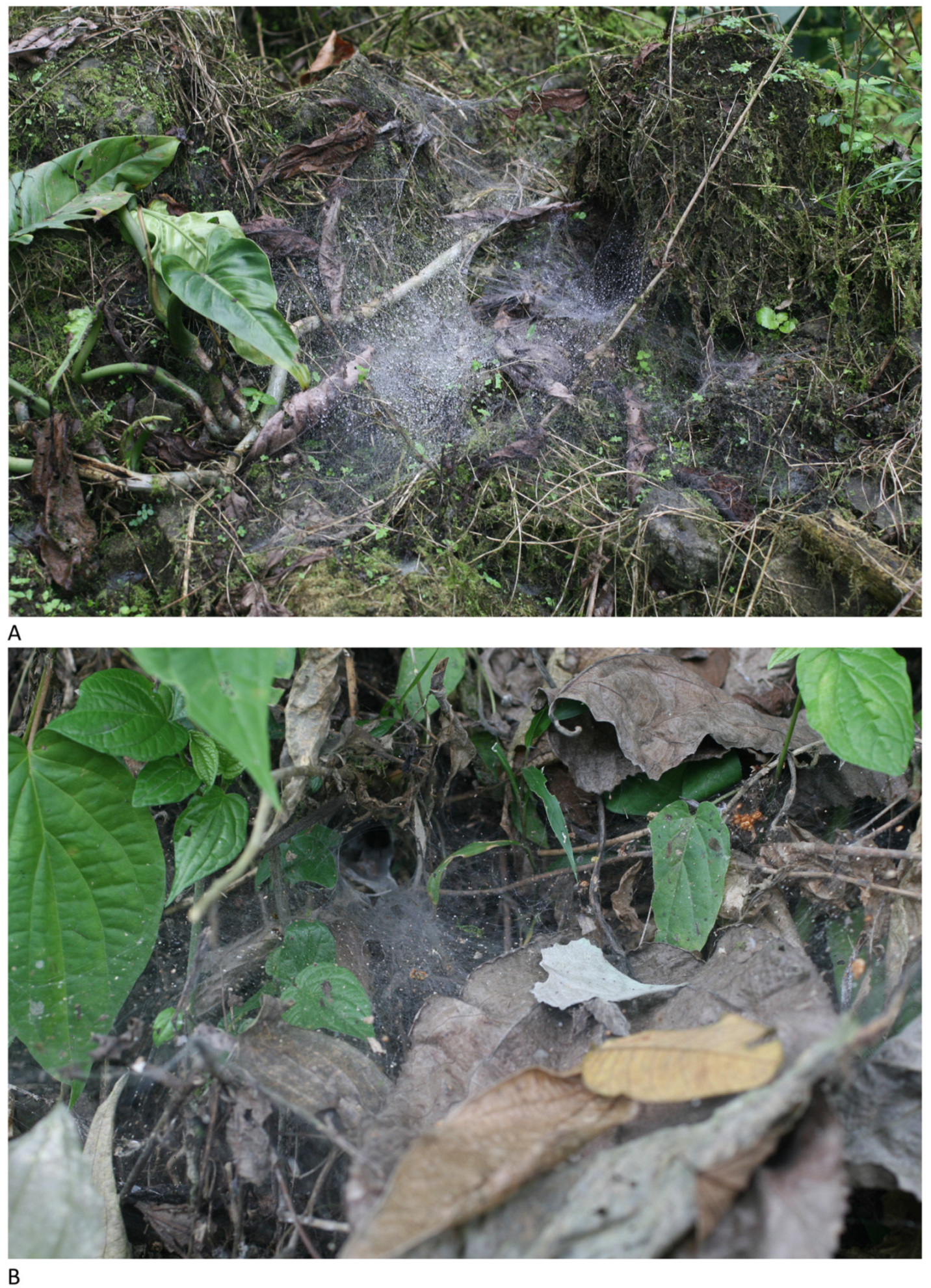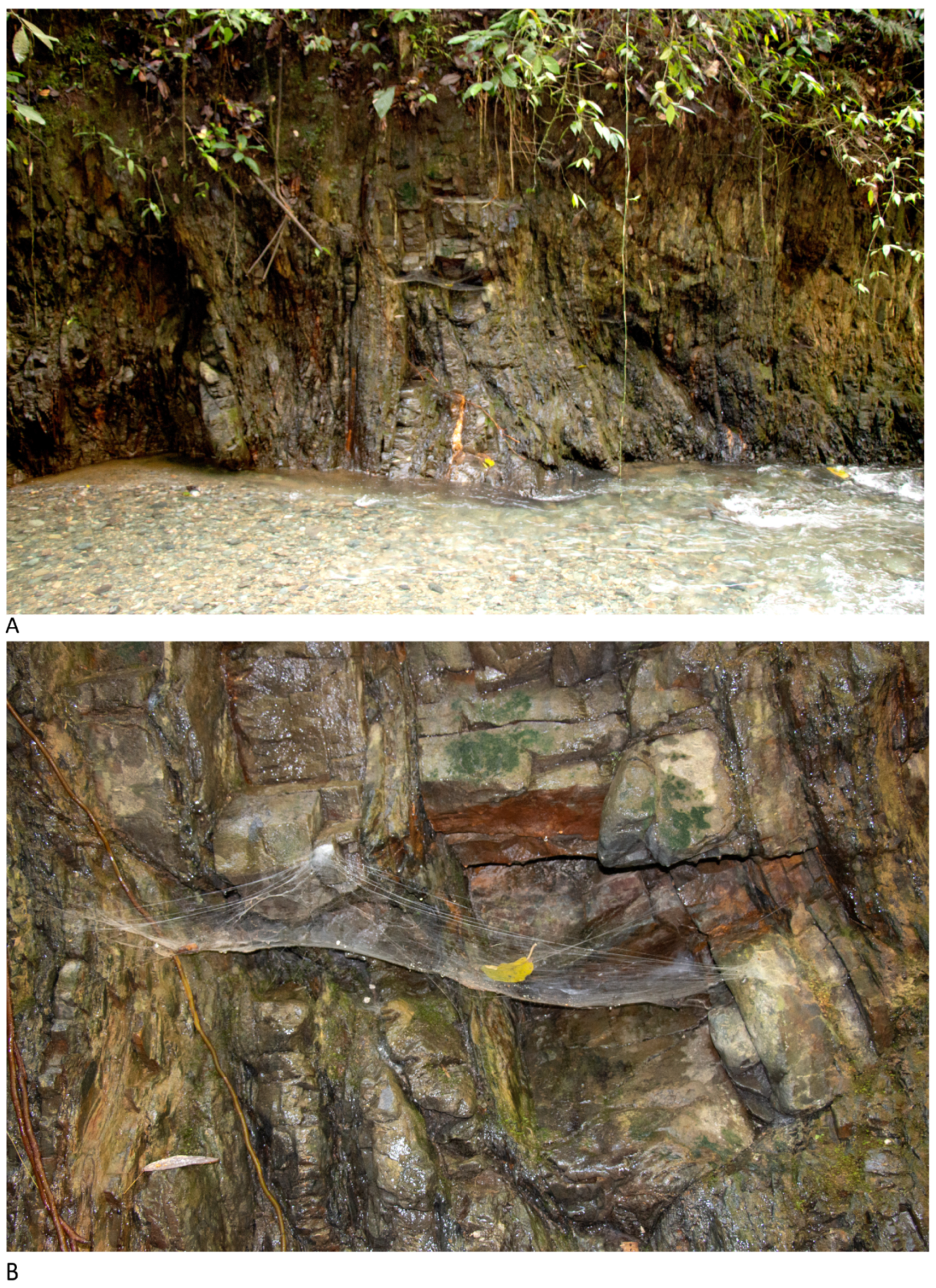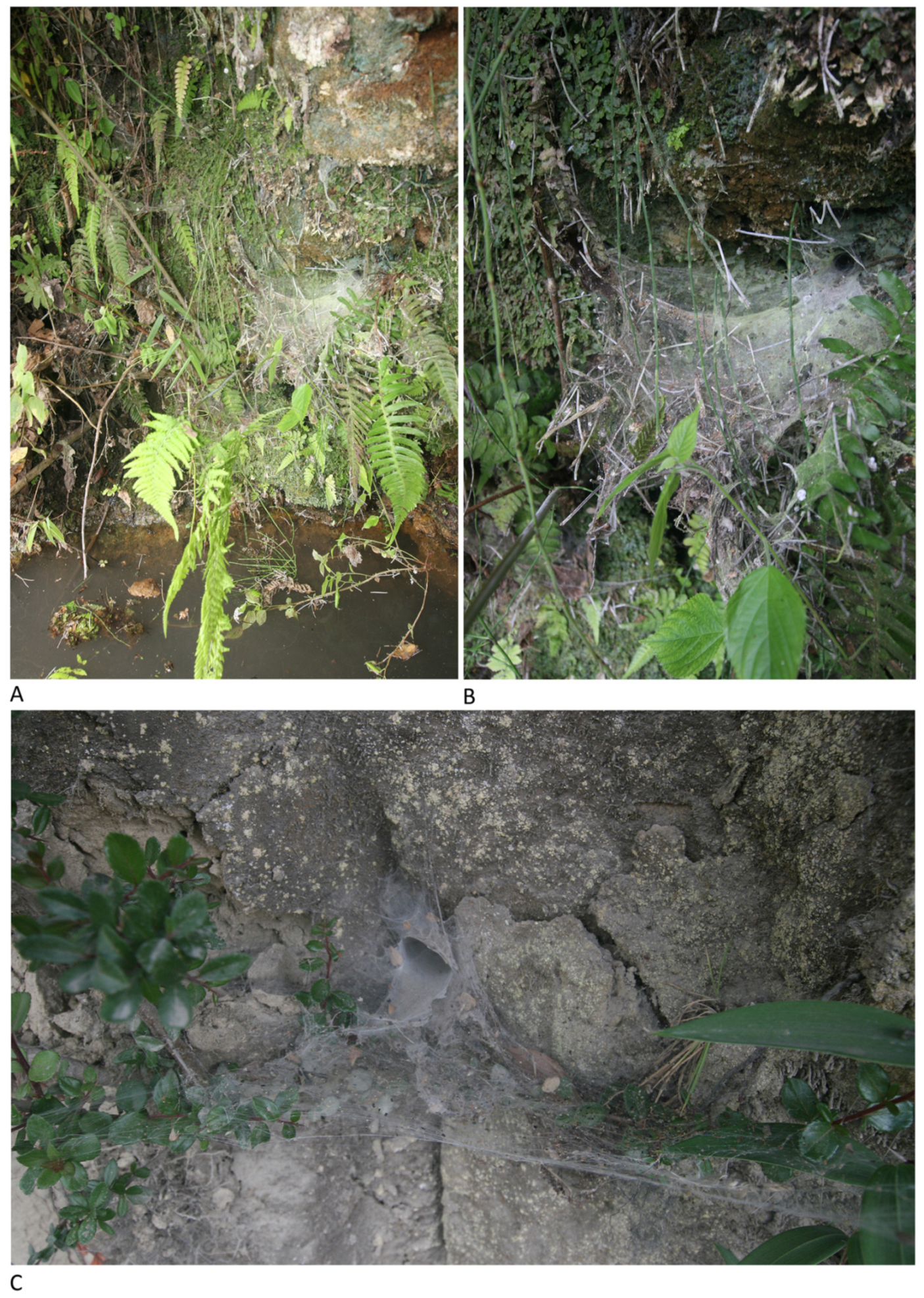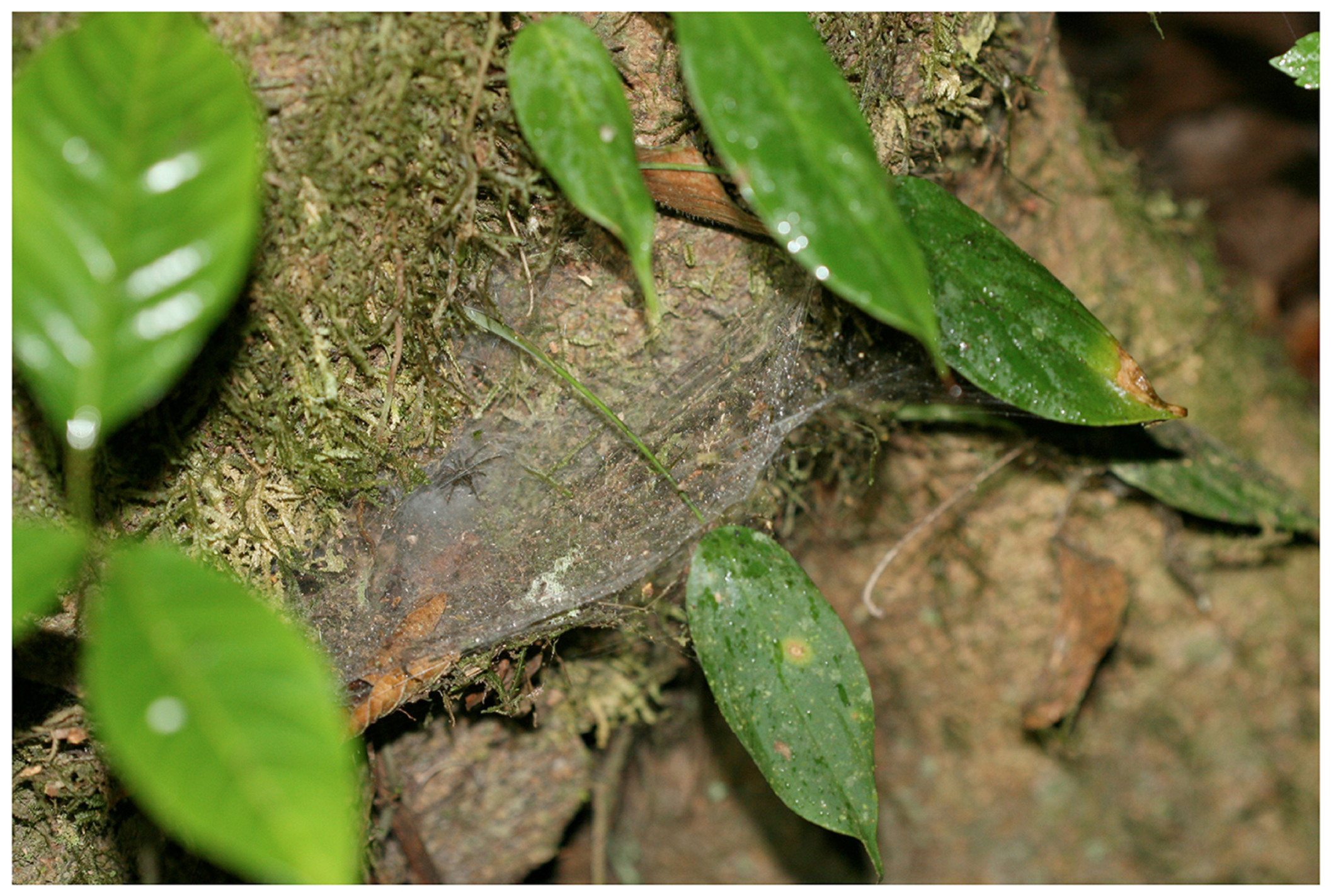3.1. Taxonomy
Family Dipluridae Simon, 1889
Linothele Karsch, 1879
Type species. Linothele curvitarsis Karsch, 1879
Diagnosis. Members of the genus Linothele are distinguished from all other Dipluridae by the combination of the following characteristics: absence of maxillary lyra; labium with 0–5 cuspules; maxillae with cuspules; female internal genitalia with spermathecae without or with numerous vesicles; males with retro-ventral mating spur on tibia I, tarsi I–IV pseudosegmented.
Diagnostic characters. Medium to large mygalomorph spiders (9.0–32.0); three tarsal claws, no claw tuft; eight eyes on a low tubercle; rastellum absent; maxillae with cuspules, maxillary lyra absent; four spinnerets.
Description. See Drolshagen and Backstam [
16].
Composition. 23 species [
1], plus 38 new species described herein.
Distribution. Guyana, Venezuela, Colombia, Ecuador, Bolivia, Brazil, and Peru.
Linothele tsachilas Dupérré & Tapia, 2015
Type material. Female holotype from Ecuador, Santo Domingo de Las Tsáchilas Province, Parroquia San José de Alluriquín, La Florida (−00.25254° −79.03043°) 884 m, 17.xii.2014, hand collected in web with juvenile Mysmenopsis, E. Tapia (QCAZ). Paratype: 1♀ from Santo Domingo de Las Tsáchilas, Parroquia San José de Alluriquín, La Florida (−00.25254° −79.03043°), 884 m, 30.x.2014, hand collected in web, E. Tapia (QCAZ). Not examined.
Other material examined. ECUADOR: Carchi: Lita Via Rio Baboso (0.880961° −78.447373°) 667 m, 14 Feb. 2018, 1♀, wet forest in holes in roadside talus, E. Tapia, ECFN 054 (ZMH-A0002964); Comunidad Rio Baboso (0.904459° −78.450611°) 951 m, 15 Feb. 2018, 3♀, secondary wet forest, roadside talus, E. Tapia, ECFN 056, 057, 058 (DTC). Esmeraldas: Alto Tambo, Sector Palo Amarillo (00.97681° −78.56061°) 620 m, 17 Mar. 2019, 3♀1juv., E. Tapia, ECFN 1199, 1200 (QCAZ), ECFN 1201 (DTC), ECFN 1205 (ZMH-A0014254), 1♀, in web on ground, E. Tapia, ECFN 9130 (DTC), 5♀, E. Tapia, ECFN9129 (AMNH), 2♀, in web on ground, E. Tapia (QCAZ); Alto Tambo, Otokiki Natural Reserve (00.911036° −78.57070°) 700 m, 5 Oct. 2015, 1♀, in web on ground, E. Tapia, ECFN 9126 (ZMH-A0001324); 10 Feb. 2016, 1♀, in web, E. Tapia (ZMH-A0002175); 7 Oct. 2015, 1♂1♀ in web on ground, E. Tapia, ECFN 9128 (QCAZ), Oct. 2015, 1♀, E. Tapia, ECFN 9125 (DTC), 5 Oct. 2015, 2♀, E. Tapia, ECFN 9127 (ZMH-A0014244), 10 July 2016, 1♀, E. Tapia, ECFN 9254 (QCAZ); Alto Tambo, Otokiki Natural Reserve (00.91325° −78.565679°) 638 m, 5 Oct. 2015, 1♀, in web with Mysmenidae, E. Tapia, I. Tapia, ECFN 9167 (DTC); 3 km de Alto Tambo via Durango (0.961150° −78.561224°) 671 m, 15 Feb. 2018, 1♂, in schrubs in open grassland, very wet area, E. Tapia, ECFN 076 (ZMH-A0003033); Laguna de Cube (00.456336° −79.588134°) 350 m, 27 Dec. 2016, 3♀, E. Tapia, ECFN 9169 (DTC), ECFN 9165, 9168 (QCAZ, ZMH-A0014256). Santo Domingo de los Tsáchilas: Bosque Protegido Las Rocas (−00.46341° −79.19624°) 661 m, 19 Mar. 2016, 1♀, 1juv., E. Tapia ECFN 9133 (QCAZ), ECFN 9164 (DTC); Nuevo Israel (−00.25838° −79.397451°) 281 m, 19 Mar. 2016, 1♀, E. Tapia, N. Dupérré, A. Tapia, ECFN 9194 (QCAZ); El Paraiso (−00.317196° −79.1035°) 749 m, 19 March 2020, 1juv., E. Tapia (DTC); Comunidad Polanco (−00.477208° −79.28194°) 445 m, 19 Mar. 2016, 2♀, E. Tapia, N. Dupérré, A. Tapia, ECFN 9194 (DTC), ECFN 9166 (ZMH-A0014247); Monterrey (−00.41180° −79.491250°) 198 m, 19 Mar. 2016, 1♀, E. Tapia, N. Dupérré, A. Tapia, ECFN 9195 (DTC). Pichincha: Otongachi (−00.321295° −78.95163°) 900 m, 25 July 2015, 1♀, E. Tapia, ECFN 9132 (ZMH-A001429), 25 July 2015, ECFN 9197 (QCAZ); Otongachi (−00.322689° −78.953696°) 892 m, 27 July 2015, 1♀, in web on ground, E. Tapia, ECFN 9131 (ZMH-A0014255), 17 Oct. 2015, 1♂, I. Tapia, ECFN 9193 (DTC); Otongachi (−00.321295° −78.95163°) 900 m, 10–13 June 2003, 1♂, malaise trap, G. Onore, ECFN 9192 (QCAZ); Otongachi (−00.321295° −78.95163°) 835 m, 21 Feb. 2019, 1♂, E.E. Tapia & I.G. Tapia, ECFN 1090 (AMNH); Otongachi (−00.330510° −78.934422°) 1087 m, 13 Feb. 2020, 2♂, I. G. Tapia E. E. Tapia & N. Dupérré, ECFN 4765 (ZMH-A0014248), ECFN 6590 (AMNH); Otongachi (−00.322689° −78.953696°) 898 m, 23 Oct. 2015, pitfalls trap, E.E. Tapia, ECFN 9163 (QCAZ).
Diagnosis. (Updated from Dupérré and Tapia 2015) Females are distinguished from most species by their carapace with copper setae along radiating lines and margin and abdomen with faint copper spots (
Figure 7A,B and
Figure 9A,B), and from similar coloured species
L. otokiki n. sp. and
L. archidona n. sp. by their spermathecae (3× longer than wide) with sub-terminal short vesicles (
Figure 8A,B and
Figure 10A–H), while
L. otokiki has short spermathecae (1.5× longer than wide) with numerous vesicles (6–7) (Figure 39A–E) and
L. archidona n. sp. has elongated spermathecae (3× longer than wide), with terminal vesicles (Figure 196A–D). Males are distinguished from most species by their color pattern (similar to females) but with fewer copper setae on the carapace (
Figure 11A,B) and from similar coloured species
L. pseudoquori n. sp. by the metatarsi curved and 12× longer than wide (
Figure 12B), while metatarsi are straight and 8× longer than wide in the latter species (Figure 105C).
Description. Female (for complete description see Dupérré & Tapia 2015: p. 360). Female (ECFN 9128) Coloration (live): carapace black covered with copper setae along margin, fovea and behind PME, and black depressed setae on pars cephalica, cephalic groove bare (
Figure 7A); fovea deep and straight; chelicerae black with depressed copper setae and black erected setae; abdomen black with copper setae patches (
Figure 7A,B); PLS black, median (1.0×), apical segment brown; legs black, coxae and trochanters covered with copper setae, tarsi orange-brown with black apically and dorsally (
Figure 7B). All tarsi segmented and flexible; tarsi I-II with thin, complete scopulae with series of strong setae, divided (
Figure 8A); metatarsi I-II with thin apical scopulae; tarsi III-IV without scopulae, with series of strong setae; metatarsi I-IV without scopulae; palp with apical scopulae; palpal tarsal claw with seven teeth; tarsal claw teeth: I: 7-6, II: 6-7, III: 6-6, IV: 6-5. Genitalia: spermathecae long (3× longer than wide), acuminated apically, with numerous vesicles (5–9) subapico-ventrally positioned (
Figure 8D,E).
Male (ECFN 9128): Total length: 16.29; carapace length: 8.03; carapace width: 7.50; abdomen length: 8.26. Coloration (live): same as female, slightly fewer copper setae on carapace (
Figure 11A,B). Coloration (ethanol): carapace dark reddish-brown covered with depressed copper setae and black depressed setae on pars cephalica creating a mark and along radiating lines, cephalic groove bare; fovea deep and recurved (
Figure 12A). Maxillae with 38 cuspules. Labium without cuspule. Sternum brown covered with black depressed and black erected setae. Chelicerae promargin 10 teeth, fang furrow ~30 cuspules. Eyes: eight on a low mound, AME rounded, separated by less than radius; ALE oval, largest; LE touching; PME smallest, separated by 4× their diameter (
Figure 12A). Spinnerets: PLS median (1.2×); total length 9.48 (3.10/3.03/3.34). Legs: total length: I 32.43 (8.16/3.58/6.82/7.02/6.85); II 31.49 (7.71/3.42/6.21/7.67/6.47); III 30.10 (7.49/4.04/4.96/7.78/5.83); IV 37.83 (9.89/2.63/7.56/11.18/6.57). All tarsi segmented and flexible; tarsi I-IV without scopulae, with series of strong setae; metatarsi I-IV without scopulae; metatarsi I curved, with one small triangular tubercle and one pair apical and one subapical macrosetae (
Figure 12C); tibia I with large mating spur (
Figure 12D); tarsal claw teeth: I: 8-7, II: 8-7, III: 5-5, IV: 5-4. Palp: tibia one ventral and three prolateral macrosetae (
Figure 13A–D); bulb 2.5× longer than wide; 0.4× tibia length; bulb base slightly swollen (
Figure 14C), embolus straight, bending sharply subapically (
Figure 14B), with subapical enlargement and short pointed tip (
Figure 14A–C).
Distribution. Ecuador, Carchi, Esmeraldas, Santo Domingo de los Tsáchilas and, Pichincha provinces.
Variation. Juvenile specimens present slightly fewer copper setae on the carapace than adults (
Figure 9C). Female body length: 18.62–23.41,
22.43,
n = 5; male body length: 15.53–18.79,
16.84
n = 5.
Natural history. This species is found between 201–1087 m; specimens were collected in low evergreen montane forest of the Chocó in the Coastal range (BsBc01) [
26], in evergreen lowland forest (BsTc01) [
27], and in evergreen foothill forest on the western side of the Andes (BsPn01) [
28]. The species is distributed in the coast-foothill region with a range of about 185km, it lives in sympatry with
L. otokiki n. sp. in Esmeraldas province, and with
L. quori,
L. pseudoquori and,
L. zaia in Santo Domingo de los Tsáchilas province and with
L. quori and
L. pristirana n. sp. at Otongachi Reserve in Pichincha province.
Linothele costenita Dupérré & Tapia, new species
Type material. Female holotype from Ecuador, Cañar Province, Manta Real (−02.54863° −79.36391°) 235 m, 17 July 2016, large web on ground in coastal forest, ECFN 9056 (QCAZ). Allotype: 1♂ from Cañar Province, Manta Real (−02.54863° −79.36391°) 235 m, 17 July 2016, in large web at base of epiphytes, 1m from ground, ECFN 9052 (QCAZ). Paratypes: same data as holotype, 1♀ ECFN 9055 (USNM), 1♀ ECFN 9112 (AMNH), ECFN 9041 2♀14juv., (QCAZ), 1♀ ECFN 9283 (ZMH-A0014327).
Other material examined. ECUADOR: Cañar: Manta Real (−02.54863° −79.36391°) 235 m, 17 July 2016, 3juv., web on ground, E. Tapia, ECFN 9051, 9053, 9054. (DTC). Guayas: Guayaquil (−2.041133° −79.931850°) 98 m, 1♀, R. Paessler, leg.15.vi.1910, ded. 5.ix.1910 (ZMH-A0002186); Guayaquil, 1902, 1♀, F.V. Buchwald leg. ded. 2.iii.1903 (ZMH-A0002186); Cacaoloma, Rio Chilcaplaya (−02.60989° −79.43625°) 287 m, 17 July 2016, 1♂1♀, web on ground, E. Tapia, N. Dupérré, ECFN 9115, 9116 (ZIMG). El Oro: Valle Hermoso (−03.51525° −79.83190°) 235 m, 18 Jul. 2016, 1♀1♂, web on ground, E. Tapia, N. Dupérré, A. Tapia, ECFN 9057, 9109 (AMNH); same data, 1♂, ECFN 9058 (USNM); 1♀ ECFN 9108 (DTC), 1♀ (MCZ); Comunidad Schuar (−02.80888° −79.64703°) 112 m, 18 Jul. 2016, 1♂, web on ground road, E. Tapia, N. Dupérré, A. Tapia, ECFN 9111 (ZMH-A0014328); Bella Maria (−03.50852° −79.85770°) 80 m, 1♀1juv., E. Tapia, N. Dupérré, ECFN 9113 (ZMH-A0014329), ECFN 9114 (DTC).
Etymology. The specific epithet is a noun in apposition taken from Spanish language “costenita”, meaning from the coastal region.
Diagnosis. Females are differentiated from most
Linothele species by their carapace completely covered with copper setae and abdomen without a pattern (
Figure 15A,B) and from similar coloured
L. molleturo n. sp. by their spermathecae with numerous short vesicles apically positioned (
Figure 16D,E and
Figure 17A–D), while the latter two have spermathecae with vesicles positioned basally (Figures 108E,F and 111A–C). ales are distinguished from most species by their color pattern similar to female (
Figure 18A,B), from
L. condor n. sp. by metatarsi I with minuscule tubercle (
Figure 19A, arrow), 1-1-2 ventral macrosetae, the latter with metatarsi I with large tubercle, no ventral macrosetae (Figure 212B,C).
Description. Female (
holotype). Total length: 21.99; carapace length: 9.45; carapace width: 7.78; abdomen length: 12.54. Coloration (live): carapace black densely covered with copper setae; chelicerae black with depressed copper setae and black erected setae; abdomen uniformly dark brown with black erected setae; PLS black, apical segment light brown; legs black, coxae and trochanter densely covered with copper setae, tarsi orange-brown with black tip (
Figure 15A,B). Coloration (ethanol): carapace dark reddish-brown covered with depressed copper setae and few black semi-erected setae, with black mark on pars cephalica; cephalic groove bare; fovea deep and recurved (
Figure 16A). Maxillae with 27 cuspules. Labium with four cuspules. Sternum brown covered with grayish depressed and black erected setae. Chelicerae promargin with 12 teeth, fang cuspules not observed. Eyes: eight on a low mound; AME rounded, separated by their radius; ALE oval, largest; LE touching; PME smallest, separated by 5 time their diameter (
Figure 16A). Spinnerets: PLS median (1.0×); total length: 9.38 (2.41/3.11/3.86). Legs: total length: I 27.09 (7.76/3.5176.19/5.65/3.98); II 25.11 (7.06/3.02/5.42/5.55/4.06); III 22.44 (6.23/2.70/4.83/5.75/2.93); IV 29.22 (7.96/2.45/6.14/8.31/4.36). All tarsi segmented and flexible; tarsi I-II with complete scopulae, with series of strong setae, divided; tarsi III-IV without scopulae, with series of strong setae; metatarsi I-II with weak 1/3 scopulae (
Figure 16B); metatarsi III-IV without scopulae; palpal tarsi with half scopulae (
Figure 16C); palpal claw with seven teeth; tarsal claws teeth: I: 8-8, II: 8-6, III: 8-7, IV: 8-7. Genitalia: spermathecae short (1.6× longer than wide), acuminate, not widely separated (1×), curved outward, with numerous (3-6) short vesicles apically positioned, covering the tip of spermathecae (
Figure 16D,E)
Male (
allotype). Total length: 18.32; carapace length: 8.24; carapace width: 7.14; abdomen length: 10.08. Coloration (live): carapace black densely covered with copper setae; chelicerae black covered with depressed copper setae and black erected setae; abdomen uniformly dark brown; PLS dark brown, apical segment light brown; legs black, coxae and trochanters, densely covered with copper setae; except tarsi orange-brown with black tip (
Figure 18A,B). Coloration (ethanol): carapace reddish-brown covered with depressed copper setae and few black semi-erected setae; cephalic groove bare; fovea deep and recurved (
Figure 19A). Maxillae with 27 cuspules. Labium with four cuspules. Sternum light brown covered with copper depressed setae and black erected setae. Chelicerae promargin 11 teeth, fang furrow ~100 cuspules. Eyes: eight on a low mound; AME rounded, separated by their radius; ALE oval, largest; LE touching; PME smallest, separated by 5 times their diameter (
Figure 19A). Spinnerets: PLS median (1.1×); 9.25 (2.42/3.35/3.48). Legs: total length: I 30.07 (7.93/3.24/6.58/6.87/5.45); II 26.54 (7.20/2.60/5.97/6.82/3.95); III 28.58 (7.53/2.97/6.13/7.02/4.93); IV 32.88 (8.20/2.28/6.60/10.37/5.43). All tarsi segmented and flexible; tarsi I-IV without scopulae, with series of strong setae; metatarsi I-IV without scopulae; metatarsi I straight with very small tubercle (
Figure 19B,C, arrows); 1-1-2 ventral macrosetae; tibia I with large mating spur (
Figure 19D); claw teeth pattern: I: 12-7, II: 12-6, III: 9-8, IV: 9-8. Palp: tibia without ventral and four prolateral macrosetae (
Figure 20A,B); bulb 2.5× longer than wide; 0.5× tibia length; bulb base rounded (
Figure 21C), embolus straight, bending sharply subapically (
Figure 21B), with slight subapical enlargement and short pointed tip (
Figure 21A–C).
Distribution. Ecuador, Cañar, Guayas and El Oro provinces.
Variation. Younger adult females have a faint abdominal pattern (
Figure 17E). Female body length: 19.85–23.15,
1.58,
n = 5; male body length: 16.31–18.32,
17.78,
n = 5; juvenile body length: 12.93–21.57,
18.62,
n = 5.
Natural history. Specimens were collected on the coastal region between 80 to 287 m, in the Jama-Zapotillo lowland semi-deciduous forest (BmTc01) [
29], and in the seasonal foothills evergreen forest of the Western Cordillera (BePn01) [
30]. This coastal species lives in sympatry with
L. troncal n. sp. at the foothill of the Andes and is distributed over 165 km.
Linothele troncal Dupérré & Tapia, new species
Type material. Female holotype from Ecuador, Canãr Province, La Troncal (−02.46862° −79.26930°) 330 m, 17 Jul. 2016, in web, in a secondary foothill forest on 80% slope, N. Dupérré, E. Tapia, A. Tapia, ECFN 9046 (QCAZ). Paratypes: 14♀, same data as holotype, ECFN 9035, 9044, 9280 (ZMH-A0014330, A0014331, A00142333), ECFN 9045 (AMNH), ECFN 9047 (QCAZ), ECFN 9034 (MCZ), ECFN 9048 (USNM), ECFN 9050 (ZIMG), ECFN 9043 (QCAZ), ECFN 9277 (QCAZ), ECFN 9278 (AMNH), ECFN 9279 (MCZ), ECFN 9281 (USNM), ECFN 9282 (ZIMG).
Other material examined. ECUADOR: Canãr: La Troncal (−02.46862° −79.26930°) 330 m, 17 Jul. 2016, 5♀, in web, large web in a secondary foothill forest on 80% slope, N. Dupérré, E. Tapia, A. Tapia, ECFN 9049 (QCAZ). Guayas: Rio Chilcaplaya (−02.60989° −79.43625°) 287 m, 17 Jul. 2016, 5♀, in web on ground, semi-dry forest on a 70–80% slope, N. Dupérré, E. Tapia, A. Tapia, ECFN 9036 (ZMH-A0014332), ECFN 9042 (AMNH), ECFN 9037 (DTC). Cotopaxi: San Ramon, 1051 m (−01.14891 −79.12135) 6 Mar. 2019, 1♀, in roadside talus E.E. Tapia, ECFN 1143 (DTC).
Etymology. The specific epithet is a noun in apposition taken from the type locality.
Diagnosis. Females are distinguished from most
Linothele species by their black carapace with abundant reddish-copper setae along the midline, margin, as well as coxae and trochanters and their uniformly blackish abdomen (
Figure 22A,B). From
L. condor n. sp. and
L. alausi n. sp. with similar color patterns, they are differentiated by their blunt spermathecae curved outward with apically positioned vesicles (
Figure 23D,E and
Figure 24A–D), while basally positioned vesicles in
L. alausi n. sp. (Figure 153E,G) and straight and elongated in the latter (Figure 210C,D).
Description. Female (
holotype). Total length: 30.43; carapace length: 12.94; carapace width; 11.53; abdomen length: 17.49. Coloration (live): carapace black covered with reddish-copper setae along the midline of pars cephalica and margins; chelicerae with depressed reddish-copper setae and erected black setae; abdomen uniformly black without pattern; PLS black apical segment brown; legs black, trochanters and coxae covered with reddish-copper setae; tarsi orange-brown (
Figure 22A,B). Coloration (in ethanol): carapace dark reddish-brown covered with depressed copper setae along midline of pars cephalica and margin and black setae along radiating lines and a few semi-erected black setae; cephalic groove bare; fovea deep and recurved (
Figure 23A). Chelicerae promargin with 13 teeth; fang furrow with ~50 cuspules. Labium without cuspule. Maxillae with 25 cuspules. Sternum dark brown covered with black depressed and erected setae. Eyes: eight on a low mound; AME rounded, separated by their radius; LE oval, touching; ALE largest; PME smallest, separated by 6× their diameter (
Figure 23A). Spinnerets: PLS short (0.9×); total length: 11.85 (3.90/3.95/4.00). Legs: total length: I 43.61 (12.26/4.54/9.36/13.17/4.28); II missing; III 32.90 (8.77/3.52/6.45/8.89/5.27); IV 44.22 (11.43/3.63/9.90/12.65/6.61). All tarsi pseudosegmented and flexible; tarsi I-II with scopulae, with series of strong setae, divided; tarsi III-IV without scopulae; metatarsi I with weak scopulae (
Figure 23B); metatarsi II-IV without scopulae; palpal tarsi with half scopulae (
Figure 23C), palpal claw with six teeth; tarsal claws teeth: I: 6-6; III-IV: 5-6. Genitalia: spermathecae short (1.3× longer than wide), rounded apically, widely separated (2×), with one short vesicle apico-ventrally positioned (
Figure 23D,E).
Male. Unknown.
Distribution. Ecuador, Cotopaxi, Canãr, and Guayas provinces.
Variation. No ontogenetic color variation was observed in this species. Female body length: 29.24–32.84, 30.53, n = 5.
Natural history. Specimens were collected between 287–1051 m. This species live in sympatry with
L. costenita n. sp. in the seasonal, foothills evergreen forest (BePn01) [
30] and with
L. yanachanka in the evergreen foothill forest on the western side of the Andes (BsPn01) [
28] in Cotopaxi Province. This species is a foothill-coastal species distributed over 160 km.
Linothele victoria Dupérré & Tapia, new species
Type material. Female holotype from Ecuador, El Oro, Via Arenillas-Alamor, La Victoria (−03.79931° −80.02955°) 585 m, 18 Jul. 2016, in web on ground, semi-arid area, E. Tapia, N. Dupérré, A. Tapia, ECFN 9071 (QCAZ). Paratypes: 2♀ same data as holotype, ECFN 9070 (QCAZ), ECFN 9069 (ZMH-A0014313).
Etymology. The specific epithet is a noun in apposition taken from the type locality.
Diagnosis. Females are distinguished from all species by their carapace densely covered with reddish-copper setae (
Figure 25A) and from
L. gaujoni by the chelicerae, coxae, and trochanters densely covered with copper setae (
Figure 25A,B), scarce in the latter species (Figure 161A,B), spermathecae 3× longer than wide (
Figure 26E–G), versus 4× longer than wide in
L. gaujoni (Figure 162D–G).
Description. Female (
holotype). Total length: 23.48; carapace length: 10.28; carapace width: 9.48; abdomen length: 13.2. Coloration (live): carapace black densely covered with reddish-copper setae; chelicerae black densely covered with reddish-copper setae; abdomen black with a reddish-copper pattern of chevron posteriorly; PLS black; legs black, coxae, trochanters, and femora with reddish-copper setae, tarsi reddish-brown, black apically (
Figure 25A,B). Coloration (ethanol): carapace densely covered with depressed copper setae, and a few black semi-erected setae; cephalic groove bare; fovea deep and strongly recurved (
Figure 26A). Chelicerae promargin with 10 teeth, fang furrow with ~50 cuspules. Labium with one cuspule. Maxillae with 40 cuspules. Sternum dark brown covered with grayish depressed setae and black erected setae. Eyes: eight on a low mound; AME rounded, separated by their radius; LE and PME oval, LE touching, ALE the largest; PME the smallest, separated by 4× diameter (
Figure 25A). Spinnerets: PLS short (0.8×); total length 8.24 (2.28/3.10/2.86). Legs: total length I 30.88 (8.62/3.78/6.77/6.72/4.99); II missing; III 29.02 (7.83/3.43/6.01/7.19/4.56); IV 33.85 (8.76/3.05/7.25/9.47/5.32). All tarsi pseudosegmented and flexible; tarsi I-II with complete scopulae, undivided (
Figure 26D); metatarsi I-II with scopulae (
Figure 26B); tarsi III-IV with thin scopulae, instead with thick setae; metatarsi III-IV without scopulae; palpal tarsi with 2/3 scopulae (
Figure 26C); palpal claw with seven teeth; tarsal claws teeth: I: 6-6; III, IV: 5-6. Genitalia: spermathecae long (2.3× longer than wide), not widely separated (2×), rounded apically, with 2–3 small vesicles subapico-externally positioned (
Figure 26E,F).
Male. Unknown.
Distribution. Ecuador, El Oro province.
Natural history. Specimens were collected in the pacific region at 585 m, in a seasonal foothills evergreen forest of the Catamayo-Alamor sector southwest of the Andes Region (BePn02) [
31],
L. victoria n. sp. builds large curtain-webs on stony soils on a moderate slope.
West Andes
Linothele guallupe Dupérré & Tapia, new species
Type material. Female holotype from Ecuador, Carchi, Via Guallupe-Chical km 36 (00°51′45.53″–78°13′22.11″) 2136 m, 12 Feb. 2017, 1♀, cloud forest in between moss and epiphytes over trees, E. Tapia, A. Tapia, I. Tapia, ECFN 8899 (QCAZ). Paratypes: 2♀, same data as holotype, ECFN 9075 (QCAZ) ECFN 9076 (ZMH-A0002162); 1♀, 6juv., ECFN 9074 (QCAZ).
Other material examined. Ecuador: Carchi: Via Guallupe-Chical km 36 (00°51′45.53″ −78°13′22.11″) 2136 m, 12 Feb. 2017 3juv., cloud forest in between moss and epiphytes over trees, E. Tapia, A. Tapia, I. Tapia, ECFN 8895 (DTC); Via Tufiño-Chical (00°51′00.93″ −78°03′43.43″) 2461 m, 12 Feb. 2017, 2♀, E. Tapia, A. Tapia, I. Tapia, ECFN 8900 (QCAZ), ECFN 8928 (DTC).
Etymology. The specific epithet is a noun in apposition taken from the type locality.
Diagnosis. Females are distinguished from most species by their coloration, carapace, and coxae, black and densely covered with copper setae, and abdomen with inconspicuous chevron pattern (
Figure 27A,B), from
L. javieri n. sp. by their abdominal pattern with inconspicuous chevrons (2) (
Figure 27A and
Figure 29A,B) while defined chevrons (4) are present in the latter in (Figure 40A), and from
L. ireneae n. sp. by their smaller size (
14.75) and spermathecae with short vesicles (
Figure 28D–G) while
L. ireneae n. sp. is larger (
19.28) and has spermathecae with long vesicles (Figure 34A–C).
Description. Female (
holotype). Total length: 20.34; carapace length: 7.14; carapace width: 6.06; abdomen length: 9.23. Coloration (live): carapace, and coxae black densely covered with copper setae; chelicerae black with few depressed copper setae and black rected seate; abdomen densely covered with dark brown setae and copper setae, with inconspicuous chevrons pattern; PLS basal and medial segments dark brown, apical segment orange-brown; legs blackish, tarsi orange-brown (
Figure 27A,B). Coloration (ethanol): carapace dark reddish-brown covered with copper setae and black semi-erected setae, with black marks along the margin, pars cephalica, and radiating lines; cephalic groove bare; fovea deep and slightly recurved (
Figure 28A). Maxillae with 44 cuspules. Labium with three cuspules. Chelicerae promargin with nine teeth, fang furrow with ~22 cuspules. Sternum with a lighter median band. Eyes: eight on a low mound; AME rounded, separated by their radius; ALE oval, largest; LE touching; PME smallest, separated by 4× their diameter (
Figure 28A). Abdomen: oval. Spinnerets: PLS short (0.9×); total length 6.12 (2.38/1.45/2.29). Legs: total length: I 19.79 (5.27/2.59/4.39/4.79/2.75); II 19.16 (5.11/2.37/4.29/4.69/2.70); III 17.79 (4.49/2.37/3.66/4.56/2.71); IV 21.67 (6.16/2.15/4.75/5.46/3.15). All tarsi pseudosegmented and flexible; tarsi I-II with complete scopulae, with series of stronger setae, divided (
Figure 28B); tarsi III-IV without scopulae; metatarsi I with inconspicuous scopulae (
Figure 28B), II-IV without scopulae; palpal tarsi with half scopulae (
Figure 28C); palpal claw with six teeth; tarsal claws: I: 8-10, II: 7-10, III: 7-8, IV: 7-8. Genitalia: spermathecae triangular, short (1×), close together (<than the width of their base) with three short, rounded vesicles ventro-medially positioned (
Figure 28D,E).
Male. Unknown.
Distribution. Ecuador, Carchi province.
Variation. No ontogenetic coloration was observed. Female body length: 11.25–20.34, 14.75, n = 5; juvenile body length: 8.53–11.02, 10.04, n = 5.
Natural history. All specimens were collected in between moss and epiphytes on trees, the species is believed to be arboreal.
L. guallupe n. sp. was collected between 2136–2461 m in an evergreen mountain forest of the Western cordillera (BsMn03) [
32], at higher altitude the species lives in sympatry with
L. ireneae n. sp. and
L. carchi n. sp.Linothele carchi Dupérré & Tapia, new species
Type material. Female holotype from Ecuador, Carchi, Via Tufiño-Chical (0.850319°–78.061943°) 2461 m, 12 Feb. 2017, E. Tapia, A. Tapia, I. Tapia, ECFN 8924 (QCAZ). Paratype: 1♀ with egg sac, same data as holotype, ECFN 8923 (QCAZ).
Etymology. The specific epithet is a noun in apposition taken from the type locality.
Diagnosis. Adult females are distinguished from most other
Linothele by their patterned legs (
Figure 30B), and from other species with patterned legs,
L. quori and
L. pseudoquori n. sp., by their brown color pattern (
Figure 30A), golden in
L. quori (Figure 84A); from
L. pseudoquori n. sp. by their elongated and narrow spermathecae (2× as long as wide) (
Figure 31D–F), short and wide (1.2× longer than wide) in the latter (Figure 104D–G).
Description. Female (
holotype). Total length: 12.16; carapace length: 5.11; carapace width: 4.39; abdomen length: 7.05. Coloration (live): carapace black covered with copper setae on pars cephalica and around the fovea; chelicerae black with few depressed copper setae and black erected setae; abdomen black with patches of copper setae; PLS basal and medial segments dark brown basally and black apically, apical segment light brown basally and apically, dark brown medially; legs coxae and trochanters dark brown with few copper setae; femur to metatarsi dark brown with black bands apically and basally; tarsi orange, black apically (
Figure 30A,B). Coloration (ethanol): carapace orange covered with few depressed copper setae and numerous black semi-erected setae, with black marks along margin, radiating lines, and pars cephalica; cephalic groove bare; fovea deep and straight (
Figure 31A). Maxillae with 12 cuspules. Labium with two cuspules. Sternum orange with a lighter median band, covered with grayish depressed and black erected setae. Chelicerae: promargin 11 teeth, fang furrow with ~30 cuspules. Eyes: eight on a low mount; AME rounded, separated by their radius; ALE oval, largest; LE touching; PME smallest, separated by 3× their diameter (
Figure 31A). Spinnerets: PLS median (1.0×); total length 6.24 (2.09/1.97/2.18). Legs: total length: I 15.38 (4.54/1.85/3.14/3.39/2.46); II 12.87 (3.53/1.41/2.77/2.79/2.37); III 12.54 (3.45/1.40/2.71/2.59/2.39); IV 17.55 (4.50/1.31/3.78/4.96/3.00). All tarsi pseudosegmented and flexible; tarsi I-II without scopulae, with series of stronger setae, divided (
Figure 31B); tarsi III-IV without scopulae; metatarsi I-IV without scopulae; palpal with inconspicuous scopulae (
Figure 31C); palpal claw with six teeth; tarsal claw teeth: I: 8-6, II: 6-7, III: 6-8, IV: 4-6. Genitalia: spermathecae median (2× longer than wide), rounded apically, widely separated (2×), with numerous short, rounded vesicles ventrally positioned (
Figure 31D,E).
Male. Unknown.
Distribution. Ecuador, Carchi province.
Variation. Adult females body length: 12.16–14.45, 13.05, n = 2.
Natural history. Specimens were collected at 2461 m in elevation in an evergreen mountain forest of the Western cordillera (BsMn03) [
32], where it lives in sympatry with
L. ireneae n. sp. and
L. guallupe n. sp. The paratype female was found with an egg sac with 33 spiderlings inside.
Linothele ireneae Dupérré & Tapia, new species
Type material. Female holotype from Ecuador, Carchi, Via Tulcan-Chical, Chilma Alto (0.850319° −78.061943°) 2461 m, 12 Feb. 2017, hand collected in web on ground, wet forest, E. Tapia, A. Tapia, I. Tapia, ECFN 8927 (QCAZ). Paratypes: 7♀, same data as holotype, ECFN 8897, 9273 (QCAZ), ECFN 9275, 8901 (ZMH-A0014304, 14305), ECFN 8898 (AMNH) ECFN 9274 (USNM), ECFN 9276 (MCZ).
Other material examined. ECUADOR: Carchi: Via Tufiño-Chical, Chilma Alto (0.850319° −78.061943°) 2461 m, 12 Feb. 2017, 1♀12juv., E. Tapia, A. Tapia, I. Tapia, ECFN 8929, 8894, 8896 (DTC).
Etymology. The specific epithet is in honor of Irene Grima Tapia for her help and support in collecting Ecuadorian spiders.
Diagnosis. Adult females are distinguished from most other
Linothele by their carapace, coxae, and trochanters completely covered with copper setae and abdomen dark brown with copper chevrons pattern (
Figure 32A,B). From similar coloured species
L. javieri n. sp. and
L. guallupe n. sp. by their spermathecae with long vesicles (
Figure 33D,E and
Figure 34A–C), whilst
L. javieri n. sp. spermathecae are with short vesicles (Figure 40D–F) and from
L. guallupe n. sp. by the PME separated by 5× their diameter (
Figure 33A) and larger size (
9.28), while PME separated by 4× their diameter (
Figure 28A), and smaller size (
14.75) in the latter.
Description. Female (
holotype). Total length: 24.97; carapace length: 11.72; carapace width: 10.52; abdomen length: 13.25. Coloration (live): carapace, coxae, trochanters, black densely covered with copper setae; chelicerae black densely covered with copper setae and black erected setae; abdomen dark brown densely covered with copper setae anteriorly and pattern of chevron posteriorly; PLS dark brown, apical segment light brown; leg: dark brown, tarsi orange-brown (
Figure 32A,B). Coloration (ethanol): carapace covered with depressed copper setae, few semi-erected black setae, cephalic groove bare, and some part of pars cephalic along radiating lines; fovea deep and straight (
Figure 33A). Chelicerae promargin with 12 teeth, fang furrow with ~25 denticles. Labium without one cuspule. Maxillae with 58 cuspules. Sternum light brown with yellow depressed setae and black erected setae. Eyes: eight on a tubercle; AME rounded, separated by their radius; LE and PME oval, LE touching, ALE the largest; PME the smallest, separated by 5× their diameter (
Figure 33A). Spinnerets: PLS short (0.9×); 10.55 (3.73/2.89/3.93). Legs: total length: 36.09 (10.58/4.79/7.80/7.36/5.56); II 30.89 (8.70/3.43/7.00/6.97/4.79); III 30.00 (8.17/3.53/5.86/8.05/4.39); IV 38.11 (9.78/3.95/8.14/10.83/5.41). All tarsi pseudosegmented and flexible; tarsi I-II with complete scopulae, with series of stronger setae, divided (
Figure 33B); tarsi III-IV without scopulae, instead rows of strong setae; metatarsi I with 2/3 scopulae (
Figure 33B); metatarsi II with half scopulae; metatarsi III-IV without scopulae; palpus with half scopulae (
Figure 33C); palpal claw with nine teeth; tarsal claws teeth: I: 9-8, II: 10-9, III: 10-9, IV: 9-7. Internal genitalia: spermathecae short with a triangular base (1× longer than wide), not widely separated, with two long vesicles, almost connected at their base, situated medio-medially (
Figure 33D,E).
Male. Unknown.
Distribution. Ecuador: Carchi Province.
Variation. Juvenile or smaller females have the same pattern coloration as adult females, slightly with more contrasted abdominal pattern (
Figure 34D,E). Females body length: 13.76–24.97,
19.28,
n = 5; juvenile body length: 13.87–16.60,
15.08,
n = 5.
Natural history. Specimens were collected at 2461 m in elevation in an evergreen mountain forest of the Western Cordillera (BsMn03) [
32], where it lives in sympatry with
L. carchi n. sp. and
L. guallupe n. sp. One female (ECFN 8897) was collected with an egg sac containing about 140 spiderlings (
Figure 35) and another female was collected with an egg sac containing 100 eggs. The species make large webs on the ground.
Linothele otokiki Dupérré & Tapia, new species
Type material. Female holotype from Ecuador, Esmeraldas province, Otokiki reserve (00.911036° −78.57070°) 700 m, 16 July 2016, in web in ground, E. Tapia, ECFN9257 (QCAZ). Paratypes: 3♀ from Esmeraldas province, Alto Tambo, Otokiki Natural Reserve (00.91325° −78.565679°) 638 m, 5 Oct. 2015, in web in ground, E. Tapia, I. Tapia ECFN 9259, ECFN 9261 (QCAZ), ECFN 9264 (ZMH-A0001291); 2♀, Alto Tambo, Otokiki Natural Reserve (00.911136° −78.57370°) 655 m, 5 Oct. 2015, in web in ground, E. Tapia, I. Tapia, ECFN 9258 (QCAZ), ECFN 9263 (ZMH-A0014245); 2♀, Alto Tambo, Sector Palo Amarillo (00.97681 −78.56061) 620 m, 17 Mar. 2019, in epiphytes, E.E. Tapia, ECFN 1206 (ZMH-A0014246), ECFN 1207 (QCAZ).
Other material examined. ECUADOR: Carchi: Via Guallupe-Chical, 12 Feb. 2017, 1964 m, 1♀, web in ground, E. Tapia, A. Tapia, I. Tapia ECFN 9256 (DTC). Esmeraldas: Otokiki Natural Reserve (00.91111° −78.57370°) 700 m, 12 July 2016, 1♀ with egg sac, web in ground, E. Tapia ECFN 9262 (DTC); 655m, 5.X.2015, 1juv., E. Tapia ECFN 9260 (DTC); Alto Tambo, Sector Palo Amarillo (00.97681° −78.5606°) 620 m, 17 Mar. 2019, 1juv., E.E. Tapia, ECFN 1215 (DTC).
Etymology. The specific epithet is a noun in apposition taken from the type locality, Otokiki reserve.
Diagnosis. Females are distinguished from most species of
Linothele by their carapace with copper setae along radiating lines, sub-margin and margin, and abdomen with copper spots (
Figure 36A,B), from similar colored species
L. tsachilas and
L. archidona n. sp. by their internal genitalia with short spermathecae (1.5× longer than wide) with subapical vesicles (6-7) (
Figure 37D,E and
Figure 39A–F), while
L. tsachilas has long spermathecae (3× longer than wide) (
Figure 10A–H) and
L. archidona n. sp. has also long spermathecae (3× longer than wide), but with terminal vesicles (Figure 196A–D).
Description. Female (
holotype). Total length: 18.32; carapace length: 7.30; carapace width: 6.37; abdomen length: 11.02. Coloration (live): carapace black covered with black setae and copper setae along margin, around fovea and middle part of pars cephalica; chelicerae black with depressed copper setae and black erected setae; abdomen black with copper setae in patches; PLS black last segment brown; legs blackish, coxae and trochanters with some copper setae, tarsi orange-brown with black apico-basally and apically (
Figure 36A,B). Coloration (ethanol): carapace light orange-brown covered with depressed copper setae around fovea and black depressed setae along margin, mid-pars thoracica, and behind PME; cephalic groove bare; fovea deep and straight (
Figure 37A). Chelicerae promargin nine teeth and two small denticles, fang furrow ~30 cuspules. Labium with five cuspules. Maxillae with ~38 cuspules. Sternum light brown, covered with depressed dark setae and black erected setae. Eyes: eight on a low mound, AME rounded, separated by their radius; LE and PME oval, LE touching, ALE the largest; PME the smallest, separated by 6× their diameter. Spinnerets: PLS median (1.2×); total length: 8.50 (2.50/2.79/3.21). Legs: total length: I 23.96 (6.71/2.61/5.76/5.14/3.67); II 22.23 (5.87/2.50/5.66/4.55/3.65); III 21.86 (5.65/1.94/4.69/5.86/3.72); IV 29.03 (7.49/2.39/6.29/8.50/4.36). All tarsi segmented and flexible; tarsi I-IV inconspicuous scopulae, with series of strong setae (
Figure 37A); metatarsi I-IV without scopulae; palpal tarsi with 1/3 apical thin scopulae (
Figure 37C); palpal claw with eight teeth; tarsal claw teeth: I: 6-7, II: 7-5, III: 5-6, IV: 5-4. Genitalia: spermathecae medium (1.5× longer than wide), acuminated apically, not widely separated (1.5×), with numerous vesicles (6-7) subapico-ventrally positioned (
Figure 37D,E).
Male. Unknown.
Distribution. Ecuador: Carchi and Esmeraldas provinces.
Variation. No obvious ontogenetic color variation was observed (
Figure 38A,B). Females body length: 17.27–25.64,
20.07,
n = 7.
Natural history. Specimens were collected between 620–700 m in an evergreen foothill forest (BsPn01) [
28] and at 1964 m in a low mountain evergreen forest (BsBn04) [
33] of the Western Cordillera, approximately 41 km apart. This species is found in sympatry with
L. tsachilas between 620–700 m in Esmeraldas province, Otokiki reserve. One female was found with an egg sac that contained 54 eggs (ECFN 9262).
Linothele javieri Dupérré & Tapia, new species
Type material. Female holotype from Ecuador, Imbabura province, Junin (0.328056° −78.651667°) 2500 m, 18 Mar. 2016, hand collected in web at base of epiphytes 1 m from ground in cloud forest, E. Tapia, ECFN 9072 (QCAZ). Paratype: 1♀, same data as holotype ECFN 9073 (QCAZ).
Etymology. The specific epithet is a patronym in honor of Javier Ramirez for his work and dedication to protecting Ecuador’s remaining Chocoan rainforests against mining industries in the Junín community reserve, where this species and two endangered frog species, Atelopus longirostris and Ectopoglossus confusus, were found.
Diagnosis. Females are diagnosed from most species by their carapace densely covered with copper setae and abdomen with a strong pattern of copper chevrons (4) on basal half of the abdomen (
Figure 40A,B). From similarly coloured species
L. guallupe n. sp. and
L. ireneae n. sp. they are distinguished by their abdominal pattern presenting chevrons (
Figure 40A,B and
Figure 42), inconspicuous chevrons (2) present in
L. guallupe n. sp. (
Figure 27A,B) and from
L. ireneae n. sp. by their spermathecae with short vesicles (
Figure 41D,E), while the latter has spermathecae with long vesicles (
Figure 34A–C).
Description. Female (
holotype). Total length: 21.82; carapace length: 8.74; carapace width: 7.80; abdomen length: 13.08. Coloration (live): Carapace black densely covered with copper setae; chelicerae black covered with depressed copper setae and erected black setae; abdomen black covered with copper setae forming chevron pattern (4) on posterior half; PLS black, apical segment slight paler; legs coxae and trochanters dark brown covered with copper setae, femur to metatarsi to dark brown, tarsi orange-brown (
Figure 40A,B). Coloration (ethanol): carapace light yellow-brown densely covered with copper setae and a few black erected setae; cephalic groove bare; fovea deep and slightly recurved (
Figure 41A). Chelicerae promargin with ten teeth, fang furrow with ~25 cuspules. Labium with three cuspules. Maxillae with 33 cuspules. Sternum light brown with lighter median band covered with black depressed and erected setae. Eyes: eight on a low mount; AME rounded, separated by their radius; LE and PME oval, LE touching, ALE and PLE same size; PME the smallest, separated by 5× their diameter (
Figure 41A). Spinnerets: PLS short (0.9×); 7.98 (2.39/2.73/2.86). Legs: total length: 26.21 (7.44/3.38/6.09/5.48/3.82); II 24.05 (6.85/3.23/5.19/5.24/3.63); III 21.33 (5.76/2.45/4.27/5.31/3.54); IV 28.25 (7.60/2.95/5.97/7.89/3.84). All tarsi segmented and flexible; tarsi I-II with complete scopulae, with series of strong setae, divided (
Figure 41B); tarsi III-IV without scopulae; metatarsi I-II with weak half scopulae (
Figure 41B); metatarsi III-IV without scopulae; palpal tarsi half scopulae (
Figure 41C); palpal claw with seven teeth; tarsal claws teeth: I: 7-7, II: 7-6, III: 5-3, IV: 7-6. Genitalia: spermathecae triangular, short and wide (1×), not widely separated (1×) with three short, rounded vesicles ventro-medially positioned (
Figure 41D,E).
Male. Unknown.
Distribution. Ecuador, Imbabura province.
Natural history. All specimens were collected at 2500 m in an evergreen mountain forest of the Western Cordillera (BsMn03) [
32]. The two female specimens were collected in their curtain-web at the base of epiphytes on trees. The species is believed to be arboreal.
Linothele yunguilla Dupérré & Tapia, new species
Type material. Female holotype from Ecuador, Pinchicha province, 3 km via Termas de Pululahua-Comunidad de Yunguilla (00.062774° −78.526553°) 2228 m, 3 Feb. 2019, in web with Mysmenidae, E. Tapia, ECFN 1004 (QCAZ). Paratypes: Pinchicha province: 3 km via Termas de Pululahua-Comunidad de Yunguilla (00.062774° −78.526553°) 2228 m, 3 Feb. 2019, 4♀, in web with Mysmenidae, E. Tapia, ECFN 1003, 1006, 1007 (QCAZ), ECFN 1005 (ZMH-A0014281); Pululahua Geobotanical reserve (00.059720° −78.509230°) 2128 m, 4 Nov. 2016, 1♂, E. Tapia, A. Tapia, N. Dupérré, ECFN 9255 (QCAZ); Pululahua Geobotanical reserve, termas de pululahua (00.059720° −78.509230°) 2128 m, 2 Aug. 2015, 1♀, E. Tapia, A. Tapia, N. Dupérré, ECFN 9176 (QCAZ); Pululahua reserve (00.059720° −78.509230°) 2128 m, 4 Nov. 2016, 1♂, E. Tapia, A. Tapia, N. Dupérré ECFN 9255 (QCAZ); Volcan Pululahua, aguas termales (00.059720° −78.509230°) 2128 m, 3 Feb. 2019, 1♂, in web with Mysmenidae, E. Tapia, ECFN 994 (ZMH-A0014279); Volcan Pululahua, aguas termales (00.059720° −78.509230°) 2128 m, 3 Feb. 2019, 4♀, with Mysmenidae, E. Tapia, ECFN 995, 1001 (QCAZ); ECFN 996, 999 (AMNH); Pululahua Geobotanical reserve, termas de Pululahua (00.059720° −78.509230°) 2128 m, 2 Aug. 2015, 2♀, E. Tapia, A. Tapia, N. Dupérré, ECFN 9178 (QCAZ); ECFN 9144 (ZMH-A0014279); Pululahua reserve (0.025753° −78.509826°) 1920 m, 2 Aug. 2015, 1♀, hand collected in dirt talus roadside, E. Tapia, A. Tapia, N. Dupérré, ECFN 8936 (ZMH-A0002164), 4juv., ECFN 8892, 8943, 9143, 9145 (DTC).
Other material examined. ECUADOR: Pichincha: Pululahua Geobotanical reserve, termas de pululahua (00.059720° −78.509230°) 2128 m, 2 Aug. 2015, 7 juv., E. Tapia, A. Tapia, N. Dupérré, ECFN 9173-9175, 9177, 9179, 9180 (DTC); Volcan Pululahua, aguas termales (00.059720° −78.509230°) 2128 m, 3 Feb. 2019, in web with Mysmenidae, 2 juv., E. Tapia ECFN 997, 998 (DTC); Reserva Geobotanica Pululahua, Comunidad Niebia (00.057717° −78.522472°), 2081 m, 23.i.2023, 1♂4♀2juv., hand collected in web in the ground alongside the secondary road, cloud forest, E. Tapia, G. Tapia (DTC); Reserva Geobotanica Pululahua, (00.059720° −78.509230°) 2128 m, 23.i.2023, 3♂4♀12juv., hand collected in web in wall of the hot spring, E. Tapia, G. Tapia (AMNH, ZMH-A0019781, DTC). Imbabura: Comunidad Junin (00.30157° −78.63392°) 2000 m, 31 Mar. 2016, 3♀, hand collected in web on ground, E. Tapia, ECFN 9249, 9250 9191 (AMNH).
Diagnosis. Females are distinguished from most species by their abdomen dark reddish-brown with a faint to strong copper setae pattern (
Figure 43A,B and
Figure 45C,D); from similarly coloured species
L. pukachumpi they are distinguished by their long spermathecae (2.5× longer than wide) (
Figure 44D–G and
Figure 45A,B) while
L. pukachumpi has shorter spermathecae (1.7× longer than wide) (Figure 90A–E). Males are distinguished from most species by their dark coloration, abdomen with V-shaped pattern dorsally (
Figure 46A), from
L. yanachanka by their much smaller size (
15.74) and by their tarsi I with less segmentation (27) (
Figure 47C), larger in size (
22.07) and more segmentations (50) on tarsi I in
L. yanachanka (Figure 76A), from
L. zaia by their shorter metatarsi I (11× longer than wide) (
Figure 47B), whilst metatarsi I (13× longer than wide) in the latter (Figure 82B).
Etymology. The specific epithet is a noun in apposition taken from the type locality, a local community involved in nature conservancy via ecologically sustainable development.
Description. Female (
holotype): Total length: 24.73; carapace length: 10.03; carapace width: 8.25; abdomen length: 14.60. Coloration (live): carapace dark brown with few, scattered copper setae along radiating lines and margin; chelicerae black with black depressed and erected setae; abdomen dark reddish-brown with a faint pattern of copper setae and black erected setae; PLS black; legs coxae and trochanters black with some copper setae, femur to metatarsi black, tarsi orange-brown (
Figure 43A,B). Coloration (ethanol): carapace dark brown covered with copper setae along radiating line and carapace margin dark brown setae and a few black semi-erected setae; cephalic groove bare; fovea deep and recurved (
Figure 44A). Chelicerae promargin with 13 teeth, fang furrow ~38 cuspules. Labium with three cuspules. Maxillae with 38 cuspules. Sternum brown covered with black depressed and erected setae. Eyes: eight on a low mound; AME rounded, separated by less than radius; LE and PME oval, LE touching, ALE the largest; PME the smallest, separated by 4× their diameter (
Figure 44A). Spinnerets: PLS median (1.1×); total length 10.65 (2.92/3.29/4.44). Legs: total length: I 28.07 (7.97/3.32/6.58/5.76/4.50); II 27.63 (8.14/3.37/6.24/5.45/4.46); III 28.47 (7.90/3.24/6.11/6.80/4.42); IV 34.36 (9.41/3.27/7.06/9.57/5.05). All tarsi segmented and flexible; tarsi I-II with weak scopulae; with series of strong setae, divided (
Figure 44B); tarsi III-IV without scopulae, replaced by with series of thick setae; metatarsi II-II with weak socpulae; metatarsi III-IV without scopulae; palpal tarsi with half scopulae (
Figure 44C); palpal claw with eight teeth; tarsal claw teeth: I: 10-7, II: 10-7, III: 9-6, IV: 8-7. Genitalia: spermathecae long (2.5× longer than wide), widely separated (2×), with numerous (7) vesicles basally positioned (
Figure 44D,E).
Male (
paratype). Total length: 15.96; carapace length: 6.72; carapace width: 6.50; abdomen length: 9.24. Coloration (live): carapace black densely covered with pinkish-blue setae; chelicerae black covered with black depressed and erected setae; abdomen black with two longitudinal paler bands touching subapically, covered with dark pinkish-blue depressed setae and black erected setae; PLS black, apical segment light brown; legs black with a blueish tinge, except tarsi light orange-brown (
Figure 46A,B). Coloration (ethanol): carapace orange-brown covered with depressed dark brown and pale setae and a few black semi-erected setae; cephalic groove bare; fovea deep and recurved (
Figure 47A). Maxillae with 26 cuspules. Labium without cuspules. Sternum light brown covered with copper depressed black setae and black erected setae. Chelicerae promargin 11 teeth, fang furrow with ~20 cuspules. Eyes: eight on a low mound; AME rounded, separated by their radius; ALE oval, largest; LE touching; PME smallest, separated by 3× their diameter (
Figure 47A). Spinnerets: PLS median (1.2×); total length 7.78 (2.13/2.76/2.89). Legs: total length: I 27.66 (6.83/2.97/5.97/6.47/5.42); II 26.76 (6.79/2.65/5.54/6.73/5.05); III 24.66 (6.17/2.42/4.63/7.12/4.32); IV 31.85 (7.82/2.83/6.37/9.56/5.27). All tarsi segmented and flexible; tarsi I-IV inconspicuous; metatarsi I-IV without scopulae; metatarsi I slightly curved with small tubercle; without ventral macrosetae (
Figure 47B,C); tibia I with large mating spur (
Figure 47D); tarsal claw teeth: I: 11-9, II: 9-8, III:10-8, IV: 10-8. Palp: tibia with one ventral and four prolateral macrosetae (
Figure 48A,B); bulb 2.2× longer than wide; 0.4× tibia length; bulb base globular (
Figure 49C), embolus sinuous bending subapically (
Figure 49B), subapical slight enlargement and median length pointed tip (
Figure 49A–C).
Distribution. Ecuador, Pichincha and Imbabura provinces.
Variation. Younger adult females and juveniles have a stronger abdominal pattern (
Figure 45D,E) while larger female have a fainter pattern and are more reddish-brown (
Figure 43A and
Figure 45C). Females body length: 20.08–24.73,
21.71,
n = 5; male body length: 15.68–15.96,
15.86,
n = 3.
Natural history. Specimens were collected between 2000–2228 m in an evergreen mountain forest of the Western Cordillera (BsMn03) [
32], in two different localities about 30 km apart. One female was collected with and egg sac containing 78 eggs.
Note. Juveniles differ from the juveniles of
L. angamarca n. sp. by their abdomen being spotted laterally (
Figure 45E, arrow) while the others are lineated (Figure 135B, arrow).
Linothele lloa Dupérré & Tapia, new species
Type material. Female holotype from Ecuador, Pichincha Province, Lloa, sector Palmira 16 km from Lloa, via Lloa direction Mindo (−00.22151° −78.64677°) 2719 m, 31 Jan. 2016, in web along road, with Mysmeopsis, E. Tapia, N. Dupérré, A. Tapia, ECFN 962 (QCAZ). Allotype: 1♂ from Pichincha, Lloa via Mindo (−00.22151° −78.64677°) 2719 m, 17.i.2023, web on ground E. Tapia, ECFN 9478 (QCAZ). Paratypes: 2♀, Pichincha Province, Lloa, sector Palmira 16 km from Lloa (−00.22151° −78, 64677°) 2719 m, 31 Jan. 2016, E. Tapia, N. Dupérré, A. Tapia, ECFN 9059 (QCAZ), ECFN 9061 (ZMH-A0014257).
Other material examined. ECUADOR: Pichincha: Lloa (−00.22042° −78.64782°) 2783 m, 31 Jan. 2016, 1juv., E. Tapia, N. Dupérré, A. Tapia, ECFN 9063 (DTC); Lloa, sector Palmira 16 km the Lloa, via Lloa direction Mindo (−00.22151° −78, 64677°) 2719 m, 31 Jan. 2016, 1juv., E. Tapia, N. Dupérré, A. Tapia, ECFN 9060 (DTC).
Etymology. The specific epithet is a noun in apposition taken from the type locality.
Diagnosis. Females are differentiated from most
Linothele by their greenish setae of the carapace (
Figure 50A), and from the similar coloured species
L. ilinizas n. sp. and
L. lacocha n. sp. by their abdomen, black with brown semi-erected setae, while the other two species have reddish semi-erected setae (
Figure 50A,B). Furthermore, females are distinguished by their internal genitalia, spermathecae longer (3× longer than wide) with globular vesicles, obtuse apically (
Figure 51D–G), while
L. ilinizas n. sp. and
L. lacocha n. sp. have shorter spermathecae (2× longer than wide) (Figures 58A–D and 70D–F). Males are differentiated from most
Linothele by their greenish setae of the carapace and abdomen black with greenish setae (
Figure 53A), and from the similar coloured species
L. ilinizas n. sp. by longer embolus tip and sinuous palpal bulb (
Figure 55C,D), while the latter has a shorter embolus tip and straight palpal bulb (Figure 62B,E), and from
L. peguche n. sp. by their much larger and broader metatarsal tubercle (
Figure 54B) and small tubercle in the latter (Figures 125C and 126A).
Description. Female (
holotype). Total length: 31.64; carapace length: 14.19; carapace width; 12.87; abdomen length: 17.45. Coloration (live): carapace black covered with greenish setae; chelicerae black with a few depressed greenish setae and black erected setae; abdomen black covered with black depressed setae, reddish semi-erected setae, and black erected setae; PLS black, apical segment dark brown; legs black with a greenish tinge, except tarsi dark brown ventrally, black dorsally (
Figure 50A,B). Coloration (ethanol): carapace dark reddish-brown covered by greenish depressed setae and a few erected black setae, cephalic groove bare, fovea deep and recurved (
Figure 51A). Chelicerae promargin with 12 teeth, fang furrow with ~25 cuspules. Labium without cuspule. Maxillae with 60 cuspules. Sternum dark black covered with black depressed and erected setae. Eyes: eight on a low mound; AME rounded, separated by almost radius; LE and PME oval, LE touching, ALE the largest; PME the smallest, separated by 6× their diameter (
Figure 51A). Spinnerets: PLS short (0.9×); total length: 13.54 (5.08/3.80/4.66) Legs: total length: I 39.73 (11.49/5.20/9.34/7.98/5.73); II 36.80 (10.51/5.88/8.30/7.11/5.00); III 33.63 (9.65/4.95/6.78/7.91/4.34); IV 43.50 (12.22/5.57/8.36/10.91/6.44). All tarsi segmented and flexible; tarsi I-II with dense scopulae, with series of strong setae, divided (
Figure 52B); metatarsi I-II with scopulae; tarsi III-IV without scopulae, replaced by with series of thick setae; metatarsi III-IV without scopulae; palpal tarsi with half scopulae (
Figure 51C); palpal claw 11 teeth; tarsal claw teeth: I: 8-5, II: 7-4, III: 8-4, IV: 7-4. Genitalia: spermathecae long (3× longer than wide), not widely separated (1–1.5×) directed outward, with few 2–4 globular long vesicles medio-ventrally, positioned not reaching the tip of spermathecae (
Figure 51D,E).
Male (
allotype). Total length: 22.23; carapace length: 8.82; carapace width: 6.94; abdomen length: 13.41. Coloration (live): carapace black covered with greenish setae; chelicerae black with depressed greenish setae and black erected setae; abdomen black covered with greenish depressed setae, back semi-erected setae; PLS black, apical segment dark brown; legs black with a greenish tinge (
Figure 53A). Coloration (ethanol): carapace brown, covered by black depressed setae and a few black erected setae with a greenish tinge, cephalic groove bare; fovea deep and recurved (
Figure 53B). Chelicerae promargin with 11 teeth, fang furrow without cuspules. Labium with three cuspules. Maxillae with 57 cuspules. Sternum dark brown covered with dark brown depressed setae and black erected setae. Eyes: eight on a low mound; AME rounded, separated by their diameter; LE and PME oval, LE touching, ALE the largest; PME the smallest, separated by 4× their diameter (
Figure 53B). Spinnerets: PLS median (1.1×); total length 9.39 (2.21/3.22/3.96). Legs: total length: I 33.90 (9.08/3.57/8.24/7.17/5.84) II 32.33 (7.92/3.74/6.87/7.52/6.28) III 29.46 (7.23/2.69/6.07/8.15/5.32) IV 39.26 (8.60/3.49/8.03/12.06/7.08). All tarsi segmented and flexible; tarsi I-II with weak scopulae, with thick setae, divided; tarsi III-IV without scopulae; metatarsi I-IV without scopulae; metatarsi I slightly curved, with one medium triangular tubercle and only ventral apical macrosetae (
Figure 53C and
Figure 54A); tibia I with large mating spur (
Figure 54B); tarsal claw teeth: I: 12-11, II: 11-10, III: 10-5, IV: 9-9. Palp: tibia one ventral, four prolateral macrosetae (
Figure 55A,B); bulb 4.5× longer than wide; 0.5× tibia length; bulb base strongly swollen (
Figure 55D,E), embolus sinuous, slightly bending subapically (
Figure 55D), with slight subapical enlargement and long pointed tip (
Figure 55C–E).
Distribution. Ecuador, Pichincha province.
Variation. No ontogenetic color variation was observed. Female body length: 24.55–31.64, 27.29, n = 3; juvenile body length: 18.33–18.86, 18.60, n = 2.
Natural history. Specimens were collected between 2719–2783 m in the evergreen mountain forest of the Western Cordillera (BsMn03) [
32].
Linothele ilinizas Dupérré & Tapia, new species
Type material. Female holotype from Ecuador, Cotopaxi Province, Sigchos, via San Francisco de Las Pampas (−00.699834° −78.903805°) 2640 m, 2 Jan. 2016, 2♀, in web on ground, E. Tapia, N. Dupérré, A. Tapia, ECFN 10777 (QCAZ). Allotype: 1♂ from Cotopaxi Province, Via Sigchos-Latacunga (−00.70076° −78.80211°) 3087 m, 15 Mar. 2019, E.E. Tapia ECFN 1193 (QCAZ). Paratypes: Cotopaxi Province, Via Sigchos to Latacunga (−00.70076° −78. 80211°) 3087 m, 20 Feb. 2019, 8♀, in web, E. Tapia, ECFN 1068 (AMNH); same data, 1♂, ECFN 1067 (ZMH-A0014259); 2♀, ECFN 1069, 1070 (QCAZ); Sigchos, via San Francisco de Las Pampas (−00.699834° −78.903805°) 2640 m, 2 Jan. 2016, 2♀, E. Tapia, N. Dupérré, A. Tapia, ECFN 9038, 10776 (ZMH-A0014258, ZMH-A0014262); via Chugchilan to Sigchos (−00.736499° −78.897675°) 2886 m, 1 Jan. 2016, 2♀, in web on ground, E. Tapia, N. Dupérré, A. Tapia, ECFN 9039, 9040 (QCAZ).
Other material examined. ECUADOR: Pichincha: Via Aloag-Santo Domingo, Quitazol (−00.44008° −78.63559°) 2986 m, 11 Feb. 2019, 8juv., roadside talus, E. Tapia ECFN 1044 (DTC), 1♀, ECFN 10779 (ZIMG), 1♀, ECFN 10779 (DTC), ECFN 10780 (AMNH), 1♀, ECFN 1045 (ZMH-A0014260); Via Aloag-Santo Domingo, 2 km before dos cascadas (−00.4428° −78.67235°) 2752 m, 6 Feb. 2019, 1♀, large web on rocky ground, E. Tapia, ECFN 1016 (ZMH-A0014261); 4 juv., large web on rocky ground, E. Tapia, ECFN 1017-1020 (DTC); 1♀2juv., in web alongside road in wet cloud forest, E. Tapia, ECFN 9226 (DTC); 1♀, Via Aloag-Santo Domingo, approx. 10 km (−00.43569° −78.67270°) 2547 m, 27.ii.2016, collected in web on ground, E. Tapia, ECFN 9252 (DTC); Vía Aloag Santo Domingo, sector dos cascadas (−00.450532° −78.685361°) 2594 m, 17.i.2023, 1♀, hand collected in web in the ground, E. Tapia, I. Tapia ECFN 9477 (AMNH). Cotopaxi: Via Sigchos to Latacunga (−00.700076° −78.80211°) 3087 m, 20 Feb. 2019, 2♀, in web, E. Tapia ECFN 1194-1196 (QCAZ).
Etymology. The specific epithet is a noun in apposition taken from the Ilinizas volcanos situated in the distribution range of the species.
Diagnosis. Females and males are differentiated from most
Linothele by their carapace with greenish setae (
Figure 56A,B). Females are further differentiated from similar coloured species
L. lloa n. sp. by their abdomen with semi-erected reddish setae (
Figure 56A,B), brown in the latter (
Figure 50A,B); from
L. lacocha n. sp. by their abdomen sparsely covered with semi-erected reddish setae (
Figure 56A,B), while the abdomen of
L. lacocha n. sp. is densely covered with semi-erected reddish setae (Figure 69A,B). Furthermore, by their internal genitalia, shorter spermathecae (2× longer than wide) with 4–5 vesicles (
Figure 57A–G and
Figure 58A–D), whereas
L. lloa n. sp., has longer spermathecae long (3× longer than wide) (
Figure 51D–G) and
L. lacocha n. sp. has 9–10 vesicles (Figure 70D–F). Males are distinguished from most species by their back coloration with a greenish tinge and black abdomen with reddish setae from (
Figure 59A,B), similar coloured species,
L. lloa n. sp., by their straight palpal bulb (
Figure 62B,E) sinuous in the atter (
Figure 55D), from
L. sigchila n. sp. by their lower and wider metatarsal tubercle (
Figure 60D), higher and narrower in
L. sigchila n. sp. (Figure 67B) and palpal bulb shorter (2.3× as long as wide) while longer (2.7× as long as wide) in the latter species.
Description. Female (
holotype). Total length: 23.63; carapace length: 9.30; carapace width; 8.10; abdomen length: 14.33. Coloration (live): carapace black covered with greenish depressed setae and black erected setae; chelicerae black with greenish depressed setae and black erected setae; abdomen black with reddish erected setae; PLS black; legs black, with a greenish tinge, except tarsi orange-brown ventrally and black dorsally (
Figure 56A,B). Coloration (ethanol): carapace dark reddish-brown covered by greenish depressed setae and a few erected black setae, cephalic groove bare, fovea deep and straight (
Figure 57A). Chelicerae promargin with 11 teeth, fang furrow with ~34 cuspules. Labium without cuspules. Maxillae with 44 cuspules. Sternum dark brown black covered with black depressed and erected setae. Eyes: eight on a low mound; AME rounded, separated by radius; LE and PME oval, LE touching, ALE the largest; PME the smallest, separated by 5× their diameter (
Figure 57A). Spinnerets: PLS short (0.9×); total length: 8.44 (3.10/2.66/2.68). Legs: total length: I 25.12 (7.18/2.97/6.11/5.07/3.79); II 22.96 (6.17/3.00/4.66/5.07/4.06); III 22.43 (6.07/2.81/4.46/5.05/4.04); IV 31.99 (8.29/3.30/6.54/8.99/4.96). All tarsi segmented and flexible; tarsi I-II with scopulae, with series of thick setae, divided (
Figure 57B); metatarsi I-II with inconspicuous apical scopulae; tarsi III-IV without scopulae, with series of thick setae; metatarsi III-IV without scopulae; palpal tarsi with half scopulae (
Figure 57C); palpal claw with seven teeth; tarsal claw teeth: I: 8-9, II: 8-10, III: 10-9, IV: 8-9. Genitalia: spermathecae medium (2× longer than wide), not widely separated (1×) directed outward, with 4–5 long vesicles medio-ventrally, positioned almost reaching the tip of spermathecae (
Figure 57D,E).
Male (
allotype). Total length: 21.07; carapace length: 9.98; carapace width; 8.49; abdomen length: 11.09. Coloration (live): carapace black covered with greenish depressed setae and black setae; chelicerae black brown with greenish depressed setae and black erected setae; abdomen black with black depressed setae and reddish semi-erected setae, and black erected setae; PLS black; legs black with a greenish tinge, except tarsi orange-brown ventrally and black dorsally (
Figure 59A,B). Coloration (ethanol): carapace dark blackish brown covered by greenish depressed setae and a few erected black setae, cephalic groove bare, fovea deep, recurved (
Figure 60A). Chelicerae promargin with 12 teeth, fang furrow with ~16 cuspules. Labium with two cuspules. Maxillae with 45 cuspules. Sternum dark covered with black depressed and erected setae. Eyes: eight on a low mound; AME rounded, separated by their diameter; LE and PME oval, LE touching, ALE the largest; PME the smallest, separated by 5× their diameter (
Figure 60A). Spinnerets: PLS median (1.0×); total length: 10.52 (2.96/3.77/3.79) Legs: total length: I 33.78 (8.94/4.27/97.44/7.07/56.06); II 32.12 (8.51/3.75/7.13/6.84/5.89); III 31.24 (7.76/3.53/5.94/8.33/5.68); IV 38.45 (8.97/4.06/8.13/10.59/6.70). All tarsi segmented and flexible; tarsi I-II with scopulae, with a series of thick setae, divided (
Figure 60C); metatarsi I-IV without scopulae; tarsi III-IV without scopulae, replaced by with series of small thick setae; metatarsi I slightly sinuous, with large tubercle (
Figure 60B,D); without ventral macrosetae (
Figure 60C); tibia I with short mating spur on large tubercle (
Figure 60D); tarsal claw teeth: I: 11-12, II: 10-10, III: 11-10, IV: 11-11.
Palp: tibia with one ventral and three prolateral macrosetae (
Figure 61A,B); bulb 2.3× longer than wide; 0.4× tibia length; bulb base swollen (
Figure 62B); embolus straight, not bent (
Figure 62B), reducing gradually and medium length pointed tip (
Figure 62A–C).
Distribution. Ecuador, Cotopaxi and Pichincha provinces.
Variation. No ontogenetic color variation was observed (
Figure 58E,F). Female body length: 23.63–28.35,
25.69,
n = 5; male body length 20.10–21.07,
20.59,
n = 2; juvenile body length 18.59–21.60,
19.99,
n = 5.
Natural history. Specimens were collected between 2640–3087 m in evergreen mountain shrubs from north Andes (AsMn01) [
34], and in evergreen mountain forest (BsMn03) [
32] of the Western Cordillera of the Andes.
L. ilinizas n. sp. was found in sympatry with
L. sigchila n. sp. in Pichincha province.
Linothele sigchila Dupérré & Tapia, new species
Type material. Female holotype from Ecuador, Cotopaxi Province, Sigchos, Y de Costa Azul (−00.53018° −78.99059°) 2520 m, 11 Feb. 2019, E. Tapia, ECFN 1056 (QCAZ). Allotype: 1♂ from Cotopaxi Province, 4.5 km desde el desvio de la carratera Sigchos hacia San Pablo de Ahuila (−00.52739° −78.94207°) 2318 m, 15 Mar. 2019, E. Tapia, ECFN 1176 (QCAZ). Paratypes: 1♀ same data as holotype, ECFN 1174 (QCAZ); 1♀, same data as allotype, ECFN 1179 (ZMH-A0014282).
Other material examined. ECUADOR: Cotopaxi: 4.5 km desde el desvio de la carratera Sigchos hacia San Pablo de Ahuila (−00.52739° −78.94207°) 2318 m, 15 Mar. 2019, E. Tapia, ECFN 1175 (DTC). Pichincha: Via Aloag-Santo Domingo, sector dos cascadas (−00.450532° −78.685361°) 2594 m, 6 Feb. 2019, 3juv., large web on rocky ground, E. Tapia, ECFN 1021-1023 (DTC); 17 Jan. 2023, 4juv., E. Tapia, I. Tapia, ECFN 9473-9476 (DTC).
Etymology. The specific epithet is a noun in apposition derived from the region Sigchos where the species is found, in honor of the pre-Inca leader “Sigchila”.
Diagnosis. Females are distinguished from most species by their abdomen with copper setae in a V-shaped pattern dorsally with diagonal lines (
Figure 63A,B), from the similar coloured species
L. yunguilla n. sp. by their longer spermathecae (1.9× longer than wide) and abdominal diagonal lines (
Figure 63A and
Figure 64D), while the latter has shorted spermathecae (1.2× longer than wide) and no or spotted diagonal lines (
Figure 43A,
Figure 44D–G and
Figure 45C–E). From
L. angamarca n. sp. they are differentiated by their spermathecae with five short vesicles (
Figure 64D,E), while
L. angamarca n. sp. spermathecae have three to four elongated vesicles (Figure 134D–G). Males are distinguished from similar coloured species,
L. ilinizas n. sp. by their higher metatarsal tubercle (
Figure 67B,D) lower and wider in
L. ilinizas n. sp. (
Figure 60D) and palpal bulb longer (2.7× as long as wide) (
Figure 68C–E), shorter (2.3× as long as wide) in the latter species (
Figure 62A,C).
Description. Female (
holotype). Total length: 28.94; carapace length: 11.85; carapace width; 9.85; abdomen length: 17.09. Coloration (live): carapace black covered with copper setae along the margin, the lower part of pars cephalica, and around the fovea; chelicerae black covered with depressed copper setae and black erected setae; abdomen black with copper pattern, two longitudinal marks, uniting medially with three diagonal lines posteriorly; PLS black; legs black, coxae and trochanter cover with copper setae, tarsi orange-brown with black apically and dorsally (
Figure 63A,B). Coloration (ethanol): carapace dark reddish-brown covered by copper and black depressed setae and a few erected black setae, cephalic groove bare, fovea deep and recurved (
Figure 64A). Chelicerae promargin with 14 teeth, fang furrow with ~59 cuspules. Labium with two cuspules. Maxillae with 34 cuspules. Sternum dark brown covered with black depressed and erected setae. Eyes: eight on a low mound; AME rounded, separated by radius; LE and PME oval, LE touching, ALE the largest; PME the smallest, separated by 5× their diameter (
Figure 64A). Spinnerets: PLS median (1.0×); total length: 12.44 (4.17/4.05/4.22) Legs: total length: I 34.83 (10.31/3.99/7.66/7.68/5.19); II 32.41 (9.32/3.88/7.66/6.46/5.09); III 33.54 (9.14/3.38/5.98/9.10/5.47); IV 42.32 (10.93/3.91/9.07/12.42/5.99). All tarsi segmented and flexible; tarsi I-II scopulae inconspicuous, with a series of stronger setae, divided (
Figure 64B); metatarsi I-IV without scopulae; tarsi III-IV without scopulae, replaced by with series of thick setae; palpal tarsi with thin apical scopulae (
Figure 64C); palpal claw with eight teeth; tarsal claws teeth: I: 7-6, II: 9-8, III: 9-7, IV: 9-6. Genitalia: spermathecae long (1.9× longer than wide), not widely separated (1×), with five short vesicles medio-ventrally positioned not reaching the tip of spermathecae (
Figure 64D,E).
Male (
allotype). Total length: 18.77; carapace length: 9.08; carapace width: 8.15; abdomen length: 9.69. Coloration (live): carapace and chelicerae black covered with black depressed setae with a tinge of blue and black erected setae; abdomen black covered with black depressed setae with a tinge of blue and black erected setae; PLS black; legs black with a tinge of blue, tarsi orange-brown, black basally and apically (
Figure 66A,B). Coloration (ethanol): carapace dark reddish-brown covered by pale depressed setae and a few erected black setae, cephalic groove bare, fovea deep and recurved (
Figure 67A). Chelicerae promargin with 13 teeth, fang furrow with ~40 cuspules. Labium with five cuspules. Maxillae with 30 cuspules. Sternum dark brown covered with black depressed and erected setae. Eyes: eight on a low mound; AME rounded, separated by almost radius; LE and PME oval, LE touching, ALE the largest; PME the smallest, separated by 5× their diameter (
Figure 67A). Spinnerets: short (1.0×); total length: 9.84 (3.88/2.91/3.05) Legs: total length: I 34.70 (9.93/3.48/7.05/7.93/6.31); II 32.84 (9.32/2.83/6.92/8.16/5.61); III 30.97 (7.81/3.38/5.62/8.56/5.60); IV 39.91 (9.89/4.32/7.19/11.74/6.77). All tarsi segmented and flexible; tarsi I-II scopulae inconspicuous, with a series of stronger setae; metatarsi I-IV without scopulae; tarsi III-IV without scopulae, with series of thick setae; metatarsi I strongly curved, with one large triangular tubercle and one apical ventral macrosetae (
Figure 67C); tibia I with large mating spur (
Figure 67B,D); tarsal claw teeth: 11-8, II: 11-9, III: 11-8, IV:10-8. Palp: tibia with one ventral and three prolateral macrosetae (
Figure 68A,B); bulb 2.7× longer than wide; 0.4× tibia length; bulb base swollen (
Figure 68D,E), embolus mostly straight, slightly bending subapically (
Figure 68D), with slight subapical enlargement and medium length pointed tip (
Figure 68C–E).
Distribution. Ecuador, Cotopaxi and Pichincha provinces.
Variation. Juveniles have a stronger color pattern (
Figure 65C). Female body length: 23.98–28.94,
26.79,
n = 3.
Natural history. Specimens were collected between 2318–2520 m in the evergreen mountain forest of the Western Cordillera (BsMn03) [
32].
L. sigchila n. sp. was found in sympatry with
L. ilinizas n. sp. in the Pichincha province.
Linothele lacocha Dupérré & Tapia, new species
Type material. Female holotype from Ecuador, Cotopaxi Province, Sigchos, Via Pucayacu, La Cocha (−00.660819° −78.990285°) 2644 m, 4 Feb. 2017, wet forest, E. Tapia, A. Tapia, I. Tapia, ECFN 9266 (QCAZ). Paratypes: 2♀ same data as holotype ECFN 9267, 9268 (QCAZ, ZMH-A0014283).
Other material examined. ECUADOR: Cotopaxi: Sigchos, Via Pucayacu, La Cocha (−00.660819° −78.990285°) 2644 m, 3juv. 4 Feb. 2017, wet forest, E. Tapia, A. Tapia, I. Tapia, ECFN 9269-9272 (DTC).
Etymology. The specific epithet is a noun in apposition taken from type locality.
Diagnosis. Females are differentiated from most
Linothele by their carapace covered with greenish setae (
Figure 69A,B); females are further differentiated from similar coloured species
L. lloa n. sp. and
L. ilinizas n. sp. by their abdomen densely covered with reddish semi-erected setae (
Figure 69A,B), abdomen covered with brown semi-erected setae in
L. lloa n. sp. (
Figure 50A,B), and abdomen sparsely covered with reddish semi-erected setae in
L. ilinizas n. sp. (
Figure 56A,B). Furthermore, they are distinguished by their internal genitalia; spermathecae medium (2× longer than wide) acuminated apically with 9–10 vesicles (
Figure 70D–F), while
L. lloa n. sp. has longer spermathecae stalks (3× longer than wide) (
Figure 51D–G) and
L. ilinizas n. sp. has 4–5 spermathecal vesicles (
Figure 57D–G).
Description. Female (
holotype). Total length: 27.74; carapace length: 10.81; carapace width; 9.93; abdomen length: 16.93. Coloration (live): carapace black covered with depressed greenish setae; chelicerae black with a few greenish setae and black erected setae; abdomen black with black depressed setae, and reddish semi-erected setae; PLS black, apical segment brown: legs black with a greenish tinge, tarsi dark brown ventrally, black dorsally (
Figure 69A,B). Coloration (ethanol): carapace dark reddish-brown covered by black depressed setae and a few erected black setae, cephalic groove bare, fovea deep, recurved (
Figure 70A). Chelicerae promargin with 12 teeth, fang furrow with ~21 cuspules. Labium without cuspule. Maxillae with 21 cuspules. Sternum dark brown covered with black depressed and erected setae. Eyes: eight on a low mound; AME rounded, separated by their radius; LE and PME oval, LE touching, ALE the largest; PME the smallest, separated by 5× their diameter (
Figure 70A). Spinnerets: PLS short (0.9×); total length: 10.08 (2.99/3.33/3.76) Legs: total length: I 30.67 (9.12/3.73/7.08/6.18/4.56); II 27.31 (7.39/3.40/6.07/5.95/4.50); III 26.43 (7.14/2.54/5.37/7.04/4.34); IV 33.67 (7.90/3.25/7.18/10.42/4.92). All tarsi segmented and flexible; tarsi I-II with scopulae, with a series of strong setae, divided (
Figure 70B); metatarsi I-II with thin apical scopulae; tarsi III-IV without scopulae, replaced by with series of thick setae; metatarsi III-IV without scopulae; palpal tarsi with apical scopulae (
Figure 70C); palpal claw with seven teeth; tarsal claw teeth: I: 8-7, II: 7-8, III: 8-6, IV: 7-6. Genitalia: spermathecae long (2× longer than wide), not widely separated (<1×) directed outward, with 9–10 vesicles medio-ventrally positioned not reaching the tip of spermathecae, and one small separate vesicle, spermathecae apically acuminated (
Figure 70D,E).
Male. Unknown.
Distribution. Ecuador, Cotopaxi province.
Variation. No ontogenetic color variation was observed (
Figure 71A,B). Female body length: 17.74–27.07,
24.18,
n = 3; juvenile body length: 19.18–21.63,
20.03,
n = 3.
Natural history. Specimens were collected at 2644 m in elevation in the evergreen mountain forest of the Western Cordillera (BsMn03) [
32].
Linothele yanachanka Dupérré & Tapia 2015
Type material. Female holotype from Ecuador, Cotopaxi Province, Parroquia San Francisco de Las Pampas, Casa César Tapia (−00.42415° −78.95719°), 1426 m, 08.xii.2014, hand collected from web with 1♂1♀ Mysmenopsis onorei symbionts, E. Tapia and C. Tapia (QCAZ). Male and female paratypes: Cotopaxi Province, San Francisco de Las Pampas, Casa César Tapia (−00.42415° −78.95719°), 1426 m, 25.xii.2014, hand collected from web with 1♀3juv. Mysmenopsis onorei, symbionts, E. Tapia, I. Tapia and C. Tapia (QCAZ). Not examined.
Other material examined. ECUADOR: Cotopaxi: Casa César Tapia (−00.42415° −78.95719°) 1426 m, Sept. 2012, hand collected, 1♀, C. Tapia, ECFN 9007 (ZMH-A0014284); 5.I.2016, 1♀, hand collected in web, 1♀, E. Tapia, A. Tapia, C. Tapia ECFN 9001 (USNM), 20 Apr. 2016, hand collected in web, 1♀, E. Tapia, C. Tapia ECFN 9003 (MCZ), 20 Apr. 2016, hand collected, 1♀, E. Tapia, C. Tapia, ECFN 9002 (QCAZ), 20 Apr. 2016, hand collected, 1♀, E. Tapia, C. Tapia, ECFN 9004 (QCAZ), 23 Apr. 2016, hand collected in web in ground, 1♀, E. Tapia, C. Tapia ECFN 8999 (QCAZ), 1♀, ECFN 9000 (AMNH), 1♀, ECFN 8997 (MCZ), 1juv., ECFN 8996 (DTC), 1juv., (DTC); OTONGA Biological Reserve (−00.41395° −78.99085°) 1728 m, 7 Nov. 2015, 1♀, large web under a log at margin of cloud forest, E. Tapia, N. Dupérré, A. Tapia, ECFN 9009 (QCAZ), 1♀, ECFN 9010 (QCAZ); OTONGA Biological Reserve, Sector las Damas, Sapo Guarumo (−00.408552° −78.996810°) 1700 m, 2014, 1♀, hand collected in web on ground, E. Tapia, C. Tapia, ECFN 9008 (DTC); Reserva Natural Pristirana (−00.42415° −78.95719°) 1426 m, 25 XII. 2014, 1♀, hand collected in web in Phytelephas palm, E.E. Tapia, ECFN 9006 (DTC), ECFN 9005, 1juv. (DTC), ECFN 8998 (DTC); Reserva Natural Pristirana (−00.42492° −78.95707°) 1416m, 11 Feb. 2019, 1♀juv., 3juv., E.E. Tapia, ECFN 1047, 1054 (DTC); Reserva Natural Pristirana (−00.42492° −78.95707°) 1416 m, 27 Feb. 2019, 2♀juv., 1♀juv., E.E. Tapia & I.G. Tapia, ECFN 1128-1130 (DTC); Reserva Natural Pristirana (−00.424351° −78.959237°) 1521 m, 27 Feb. 2020, 1♀, Faml. Tapia-Caisaguano, N. Dupérré, E.E. Tapia & A. Tapia, ECFN 5548 (AMNH), ECFN 4757 (USNM); Reserva Natural Pristirana (−00.42414 −78.95719) 1480 m, 15 Feb. 2019, 1♀, E.E. Tapia, ECFN 1610 (DTC); Reserva Natural Pristirana (−00.422762° −78.954281°) 1335 m, 24 Nov. 2019, 9♀2juv., hand collecting in web along river bank, E. Tapia, Family Tapia-Caisaguano, ECFN 2673-2681, 3052, 3127 (ZMH-A0015344-A0015354); San Francisco de las Pampas, Saguambi (−00.483453° −78.990117°) 1524m, 17 Feb. 2019, 1♀, in talus of road, E.E. Tapia, ECFN 1055 (DTC), San Ramon (−01.14891 −79.12135) 1051 m, 6 Mar. 2019, 3♀, in talud E. Tapia, ECFN 1144-1146 (DTC). Pichincha: Via Tandapi to Sarapullo (−00°27.206″ −78°50.768) 1702 m, 1♀, 15.viii.2001, collected in epiphytes, I. Tapia, Q. Tapia, ECFN 8772 (QCAZ).
Diagnosis. Females are distinguished from most
Linothele species by their carapace densely covered with copper setae and abdomen V-shaped copper pattern (
Figure 72A,B). From similarly coloured species
L. zaia, they are distinguished by their internal genitalia with spermathecae closer together (1.2×) with four or more vesicles (
Figure 73D–G), while the latter has widely separated spermathecae (1.5×) with four or less vesicles (Figure 80A–D); from
L. yunguilla n. sp. by the vesicles positioned medially (
Figure 73D–G), while basally positioned in the latter (
Figure 44F,G). Adult males are distinguished from most species by their black coloration with purplish depressed setae, and abdomen with a black median band flanked by dark brown (
Figure 75A); from similar coloured species,
L. pukachumpi by their slightly curved metatarsi I (
Figure 75C), curved in the latter (Figure 93B), from
L. zaia by their longer tip of embolus (
Figure 77E), shorter in the latter (Figure 83E) and from
L. yunguilla n. sp. by their larger in size (
22.07) and more segmentations (50) on tarsi I (
Figure 76A) while
L. yunguilla n. sp. is smaller in size (15.74) and by with tarsi I with less segmentations (27) (
Figure 47C).
Description. (for the complete description Dupérré & Tapia [
18]: p. 353). Male (EFCN 9401) Coloration (live): carapace black, with black setae with a purplish tinge; chelicerae black with black setae with a purplish tinge and erected black setae; abdomen black with two longitudinal paler bands touching subapically, covered with purplish depressed setae and black erected setae; PLS black, apical segment brown (
Figure 75A). Coloration (ethanol): carapace dark brown covered with depressed black setae and a few depressed purplish setae, and semi-erected black setae; cephalic groove bare; fovea deep and recurved (
Figure 75B). Palp: tibia with one ventral and four prolateral macrosetae (
Figure 77A,B); bulb 2.7× longer than wide; 0.3× tibia length; bulb base not strongly swollen (
Figure 77E), embolus straight, bending subapically (
Figure 77D), with slight subapical enlargement and short pointed tip (
Figure 77C–E).
Distribution. Ecuador, Cotopaxi and Pichincha provinces.
Variation. Younger adult females and juveniles have fewer copper setae on the carapace (
Figure 74A–C). Female body length: 23.26–25.67,
24.46,
n = 5; juvenile body length: 17.68–19.75,
18.67,
n = 5.
Natural history. Specimens were collected in north western Andes at 1335–1728 m in elevation in the foothill evergreen mountain forest (BsPn01) [
28] and the low evergreen mountain forest (BsBn04) [
33].
L. yanachanka lives in sympatry with
L. quori and
L. pristirana n. sp. in Pristirana Biological Reserve and in sympatry with
L. troncal n. sp. in San Ramon, Cotopaxi Province. One female was collected with an egg sac containing 87 eggs.
Linothele zaia Dupérré & Tapia, 2015
Type material. Female holotype from Ecuador, Santo Domingo de Las Tsáchilas, Parroquia San José de Alluriquín, La Florida (00.25254° S 79.03043° W), 884 m, 17.xii.2014, hand collected from web with 1♀ Mysmenopsis fernandoi, E. Tapia (QCAZ). Not examined.
Other material examined. ECUADOR: Santo Domingo de los Tsáchilas: La Florida (−00.25254° −79.03043°) 884 m, 20 Apr. 2016, 1♀, hand collecting, E. Tapia, A. Tapia, ECFN 9077 (USNM), 29 Dec. 2015, 1♂1♀, E. Tapia, I. Tapia & N. Dupérré, ECFN 9015 (QCAZ), 3 Jan. 2016, in web in 6 m dirt talus, 2♀, E. Tapia, ECFN 9012, 9016 (ZMH-A00014285, A00014286), 20 Apr. 2016, 5♀, E. Tapia ECFN 9013 (AMNH), ECFN 9011 (ZMH-A0014287), 23 Apr. 2016, 1♀, E. Tapia, ECFN 9017 (QCAZ), 31 May 2016, in web in palm tree, 1♀, E. Tapia, ECFN 9014 (ZMH-A00014288); La Florida (−00.248529° −79.026887°) 868 m, 20 Feb. 2020, 1♀, pitfall, I. Tapia, N. Dupérré, E. Tapia, ECFN 4830 (ZMH-A0014289). Imbabura: Comunidad Junin (00°16′13″ −78°39′58″) 1285 m, 4.VI.2016, 4♀, E. Tapia, ECFN 9188, 9189, 9242, 9245 (DTC); Comunidad Junin (00°18′19″–78°40′59″) 1550 m, 4.IV.2016, 1♀, Elicio E. Tapia, ECFN 9244 (DTC).
Diagnosis. (Update from Dupérré and Tapia 2015) Females are distinguished from most species by their coloration, carapace densely covered with copper setae, and abdomen with strong pattern (
Figure 78A,B); from the similarly coloured species
L. yanachanka they are distinguished by their shorter spermathecae (2.0× longer than wide) (
Figure 79D,E and
Figure 80A–D), while
L. yanachanka has longer spermathecae (2.1× longer than wide) (Figure 73D–G). Males are distinguished from most species by their black coloration with brownish depressed setae and abdomen with a black median band flanked by dark brown (
Figure 81A,B), from
L. yanachanka by their shorter embolus tip (
Figure 83E), longer in the latter (
Figure 77E), from
L. pukachumpi by their slightly sinuous metatarsi I (
Figure 82B), curved in the latter (Figure 93B), and from
L. yunguilla n. sp. by their longer metatarsi I (13× longer than wide) and tarsi I with more segmentations (43) (
Figure 82C) whilst metatarsi I is shorter (11× longer than wide) and tarsi I with less segmentations (27) (
Figure 47C).
Description. (For the complete description, see Dupérré and Tapia 2015: 358). Female (ECFN 9015): spinnerets: PLS median (1.2×). Legs: all tarsi segmented and flexible; tarsi I-II with dense scopulae, with series of thick setae, divided (
Figure 79B); tarsi III-IV without scopulae, with strong setae; metatarsi I-II with complete scopulae; metatarsi III-IV without scopulae; palpal tarsi with scopulae (
Figure 79C). Tarsal claws teeth: I: 8-3, II: 8-6, III: 9-5, IV: 7-7. Genitalia: spermathecae long (2× longer than wide), widely separated (2×), with four long vesicles medio-ventrally positioned not reaching the tip of spermathecae (
Figure 79D,E and
Figure 80A–D).
Male (ECFN 9015). Total length: 22.85; carapace length: 10.26; carapace width: 9.45; abdomen length: 12.59. Coloration (live): carapace black, with few hirsute dark brown setae; chelicerae black with dark brown copper setae and erected black setae; abdomen black with depressed setae brown pattern of longitudinal lines, semi erected brown and black setae; PLS dark brown, apical segment light brown; legs black, coxae and trochanter with copper setae, tarsi orange-brown, I-II black basally (
Figure 81A,B). Coloration (ethanol): carapace dark reddish-brown covered with depressed black setae and a few depressed copper setae, and semi-erected black setae; cephalic groove bare; fovea deep and recurved (
Figure 82A). Maxillae with 40 cuspules. Labium with four cuspules. Sternum light brown covered with black depressed and erected setae. Chelicerae: promargin 13 teeth, fang furrow without cuspule. Eyes: eight on a low mound; AME rounded, separated by less their radius; ALE oval, largest; LE touching; PME, separated by 4× their diameter (
Figure 82A). Spinnerets: median (1.1×); 11.60 (2.84/3.93/4.83). Legs: total length: I 47.11 (11.40/4.61/10.42/11.82/8.86); II 45.85 (11.13/4.37/10.03/11.73/8.59); 41.36 (10.29/3.06/7.64/13.03/7.34); IV 55.37 (13.20/4.00/11.30/17.20/9.67). All tarsi segmented and flexible; tarsi I-IV scopulae inconspicuous, with a series of strong setae; metatarsi I-IV without scopulae; metatarsi I curved, with one small triangular tubercle and one apical macrosetae (
Figure 82C,D); tibia I with large mating spur (
Figure 82D); tarsal claws teeth: 11-8, II: 10-7, III: 8-7, IV: 9-8. Palp: tibia with two ventral and four prolateral macrosetae (
Figure 83A,B); bulb 2.6× longer than wide; 0.4× tibia length; bulb base not strongly swollen (
Figure 83D,E), embolus straight bending subapically (
Figure 83D), with slight subapical enlargement and short pointed tip (
Figure 83C–E).
Distribution. Ecuador, Santo Domingo de los Tsáchilas and Imbabura provinces.
Variation. No ontogenetic color variation could be observed. Female body length: 25.15–30.13, 27.30, n = 5.
Natural history. Specimens were collected between 868–1550 m in elevation in the evergreen foothill forest on the western side of the Andes (BsPn01) [
28]. Females build large webs on the ground or in palm trees.
L. zaia lives in sympatry with
L. tsachilas,
L. quori and
L. pseudoquori n. sp. in Santo Domingo de los Tsáchilas province, La Florida.
Linothele quori Dupérré & Tapia 2015
Type material. Male holotype from Ecuador, Santo Domingo de los Tsáchilas, Parroquia San José de Alluriquín, La Florida (00.25254° S 79.03043° W), 884 m, 20.xi.2014, hand collected from female’s web, E. Tapia, I. Tapia, A. Tapia, N. Dupérré (QCAZ). Female paratype same data, collected with 1♂1♀ Mysmenopsis chiquita symbionts (QCAZ). Not examined.
Other material examined. ECUADOR: Pichincha: La Union del Toachi, Otongachi (−00.321295° −78.95163°), 1000 m, 19 Oct. 2016, 1♂1♀, N. Dupérré, E. Tapia, ECFN 8990, 8988 (AMNH); 20 March 2020, 7juv., beating, I. Tapia, E. Tapia, N. Dupérré, ECFN 4893 (DTC); Otongachi (−00.322689° −78.953696°) 1000 m, 10 Jul. 2015, 1♀, collected in base of Phytelephas palm leaves, E. Tapia, ECFN 8991 (MCZ). Santo Domingo de los Tsáchilas: La Florida (−00.25254° −79.03043°) 884 m, 17.xii.2014, 1♀2juv., hand collected in web in the base of epiphytes over trees, E. Tapia, ECFN 8994 (ZMH-A0014290); 20.i.2016, 1♂, pitfall, E. Tapia, ECFN 8987 (DTC); 20 Apr. 2016, 1♂, in web in the base of epiphytes over trees, E. Tapia, ECFN 8993 (ZMH-A0014291); 2♀, in web in the base of epiphytes over tree, N. Dupérré, E. Tapia, A. Tapia, ECFN 8989, 8992 (QCAZ); 20 Feb. 2020, 1♂1♀, pitfall, I. Tapia, E. Tapia, N. Dupérré, (QCAZ); 20 March 2020, 1♀, pitfall, I. Tapia, E. Tapia, N. Dupérré, ECFN 6806 (QCAZ); 1♀7juv., pitfall, N. Dupérré, E. Tapia, ECFN 4940 (USNM). Cotopaxi: Pristirana reserve (−00.42414° −78.95719°) 1480 m, 24 XII. 2014, 1♀10juv., hand collected in web, mosses over tree 50 cm from ground, E.E. Tapia & family Tapia-Caisaguano, ECFN9214, 9215 (DTC).
Diagnosis. Adult males and females are distinguished from all species by their bright golden color pattern (
Figure 84A,B).
Description. (For the complete description, see Dupérré and Tapia [
18]: 361). Female (ECFN 8992): spinneret: PLS median (1.0×). Legs: all tarsi segmented and flexible; tarsi I-IV without scopulae; metatarsi I-IV without scopulae; palpal tarsi with weak apical scopulae (
Figure 85C); tarsal claws teeth: I: 9-8, II: 8-7, III: 8-7, IV: 8-6. Male (ZMH-A0014291): spinneret: PLS median (1.0×). Legs: all tarsi segmented and flexible; tarsi I-IV without scopulae; metatarsi I-IV without scopulae; metatarsi I curved, with one small rounded tubercle and 2-2-2 ventral macrosetae (
Figure 86B,C); tibia I with large mating spur (
Figure 86D); tarsal claws teeth: I: 12-8, II: 11-8, III: 9-8, IV: 9-8. Palp: tibia without ventral and three prolateral macrosetae (
Figure 87A,B); bulb 2.5× longer than wide; 0.6× tibia length; bulb greatly swollen (
Figure 87D,E), embolus straigtht not bent sub- apically (
Figure 87D), without subapical enlargement and wide pointed tip (
Figure 87C–E).
Distribution. Ecuador, Cotopaxi, Pichincha and Santo Domingo de los Tsáchilas provinces.
Variation. No ontogenetic color variation is found. Female body length: 9.36–13.18, 12.02, n = 5; male body length: 10.12–10.57, 10.34, n = 2.
Natural history. Specimens were collected between 884–1480 m in elevation, in the evergreen foothill forest on the western side of the Andes (BsPn01) [
28]. In Santo Domingo de los Tsáchilas province (La Florida)
L. quori lives in sympatry with
L. zaia,
L. pseudoquori n. sp. and
L. tsachilas; in Cotopaxi province (Pristirana Reserve) it lives in sympatry with
L. yanachanka and
L. pristirana n. sp.; and in Pichincha province (Otongachi reserve), it lives in sympatry with
L. tsachilas.Linothele pukachumpi Dupérré & Tapia 2015
Type material. Female holotype from Ecuador, Cotopaxi Province, Otonga Biological Reserve (−00.42180° −79.01325°), 2225 m, 04-09.ix.2014, hand collected from web with 1♂1♀ Mysmenopsis otonga symbionts, N. Dupérré, E. Tapia, C. Tapa (QCAZ). Not examined.
Other material examined. ECUADOR: Cotopaxi: OTONGA Biological reserve (−00.42180° −79.01325°) 2225 m, 19 Feb. 2016, 2♀, hand collected in web in ground, E. Tapia, ECFN 9022, 9023 (QCAZ), 24 May 2015, 1♂1♀juv., in web in ground, E. Tapia, C. Tapia, ECFN 9027 (AMNH), 26 May 2014, 1♀, hand collected in web in ground, E. Tapia, ECFN 9026 (USNM), 2♀2juv., web in ground, Faml. Tapia Caisaguano, ECFN 9019, 9024 (DTC); OTONGA Biological reserve (−00.41994° −79.00623°) 1900m, 25 May 2015, 1♀, hand collected in web, E. Tapia, C. Tapia, ECFN 9020 (USNM); OTONGA Biological reserve 2000 m, 18.ix.2005, 1♂, malaise trap, G. Onore, ECFN 9018 (QCAZ); OTONGA Biological reserve (−00.41433°, −79.00035°) 1888 m, 24–30 May 2014, 1♂, pitfall, E. Tapia, C. Tapia, N. Dupérré ECFN 9025 (DTC), 7 Nov. 2015 (−00.41395° −78.99085°) 1728m 1♀, E. Tapia, N. Dupérré, ECFN 9253 (AMNH); OTONGA Biological reserve (−00.41994° −79.00623°) 1997 m, 21 Feb. 2019, 8juv., in web, E.E. Tapia ECFN 1100-1105 (DTC), 1♀, ECFN 1098 (DTC), 2♀, ECFN 1097, 1099 (MCZ), 1♂, in web, E.E. Tapia, ECFN 1096 (DTC), 25 Feb. 2019, 1♂8♀1juv., hand collected in web in talus forest trail, E. Tapia, ECFN 2663-2672 (ZMH-A0015334-15343); OTONGA Biological reserve, 2000 m, 1♂, 19 Nov. 1994, Cisneros (QCAZ).
Diagnosis. (Update from Dupérré and Tapia 2015) Females are distinguished from most species by their black carapace with a few scattered copper setae and dark abdomen with no visible pattern (
Figure 88A,B) or remnant spotted pattern of copper setae (
Figure 91A). From species with a similarly coloured species,
L. angamarca n. sp. by their spermathecae with numerous (7–8), small vesicles (
Figure 89D,E and
Figure 90A–D); while
L. angamarca n. sp. has a few (3–4) elongated vesicles (Figure 134D–G) and from
L. yunguilla n. sp. by their shorter spermathecae (1.7× longer than wide) (
Figure 90A–E) while the latter has longer spermathecae (2.5× longer than wide) (
Figure 44D–G). Adult males are distinguished from most other
Linothele by their black coloration with abdomen with a faint pattern (
Figure 92A,B); from
L. yunguilla n. sp., L. angamarca n. sp., L. banos n. sp., L. cayambe n. sp., and
L. longicauda by their metatarsi I strongly curved (
Figure 93B,C); slightly curved or straight in all other species (Figures 47B, 118B, 131B and 177B).
Description. Female (for complete description see Dupérré & Tapia [
18]: p. 356). Female (ECFN 1097): spinnerets: PLS median (1.0×); total length: 11.31 (2.74/4.34/4.23). Legs: all tarsi segmented and flexible; tarsi I-II with thin scopulae; tarsi III-IV without scopulae; metatarsi I-IV without scopulae; palpal tarsi with weak apical scopulae (
Figure 89C); tarsal claws teeth: I: 8-8, II: 8-6, III: 7-6, IV: 6-5. Male (ECFN 1096). Total length: 18.89; carapace length: 9.15; carapace width: 8.14; abdomen length: 9.74. Coloration (live): carapace black covered with black depressed setae with a tinge of blue; chelicerae black covered with black depressed setae with a tinge of blue and black erected setae; abdomen black with faint pattern, covered with black depressed setae with a tinge of blue and black erected setae; PLS black apical segment light brown; legs black with a tinge of blue, tarsi orange-brown, black apically and basally (
Figure 92A,B). Coloration (ethanol) carapace reddish-brown, densely covered with light brown and black depressed setae and black erected setae; cephalic groove bare; fovea deep and recurved (
Figure 93A). Chelicerae: promargin with 14 teeth, fang furrow without cuspules. Labium without cuspule. Maxillae with ~26 cuspules. Sternum light brown, covered with depressed and erected black setae. Eyes: eight on a low mound; AME rounded, touching; LE and PME oval, LE touching, ALE the largest; PME the smallest, separated by 4× their diameter (
Figure 93A). Spinnerets: PLS median (1.4×); total length: 12.88 (4.09/4.26/4.53). Legs: total length I: 40.58 (11.54/3.44/9.62/7.67/8.31); II missing; III 37.56 (9.3/2.69/7.31/10.66/7.6); IV: 47.12 (11.3/3.06/9.92/13.56/9.31). All tarsi pseudosegmented and flexible; tarsi I-IV without scopulae; metatarsi I-IV without scopulae; metatarsi I curved, with minuscule tubercle, without macrosetae (
Figure 93B,C); tibia I with large mating spur (
Figure 93D); tarsal claw teeth: I: 9-6, II: 9-5, III: 9-7, IV: 7-6. Palp: tibia with one ventral and four prolateral macrosetae (
Figure 94A,B); bulb 2.5× longer than wide; 0.4× tibia length; bulb base swollen (
Figure 95C), embolus straight, smoothly bending subapically (
Figure 95B), with slight subapical enlargement and medium length pointed tip (
Figure 95A–F).
Distribution. Ecuador, Cotopaxi province.
Variation. Younger adult females and juveniles present a strong color pattern (
Figure 91B,C). Female body length: 20.53–27.24,
23.79,
n = 6; male body length: 18.89–22.23,
20.28,
n = 5; juvenile body length: 13.88–18.90,
16.66.
Natural history. Specimens were collected between 1728–2225 m in the low evergreen forest (BsBn04) and evergreen mountain forest of the Western Cordillera (BsMn03) [
32,
33]. In Cotopaxi Province, OTONGA Biological Reserve,
L. pukachumpi lives in sympatry with
L. pristirana n. sp. and at its lower distribution (1728 m) overlap with
L. yanachanka.
Note. The coordinates presented in the original description (Dupérré & Tapia 2015; p356) are erroneous, the latitude and longitude presented here are accurate.
Linothele pristirana Dupérré & Tapia, new species
Type material. Female holotype from Ecuador, Cotopaxi Province, OTONGA Biological Reserve, Finca Edgar (−00.42546° −79.01495°) 2029 m, 7 Nov. 2015, E. Tapia, C. Tapia & N. Dupérré, ECFN 8912 (QCAZ). Allotype: 1♂ from Cotopaxi Province, OTONGA Biological Reserve (−00.41395° −78.99085°) 1728 m, hand collected, E. Tapia & N. Dupérré, ECFN 8914 (QCAZ). Paratypes: Cotopaxi: Finca Edgar (−00.42546° −79.01495°) 2029 m, 7 Nov. 2015, 2029 m, E. Tapia, 1♂, ECFN 8915 (QCAC), 1♀1♂ ECFN 8913, 8916 (ZMH-A0014295, 14296); 1♂, OTONGA Biological Reserve (−00.42180° −79.01325°) 2225 m, Nov. 2014, pitfall, E. Tapia, C. Tapia & N. Dupérré, ECFN 8919 (ZMH-A0014301); OTONGA Biological Reserve, limite Sambo (−00.41395 −78.999085) 1728 m, 18.IX.2021, 1♂, under big logs, C. Tapia, S. Noroña ECFN 7885 (AMNH), 7♀, C. Tapia, S. Noroña ECFN 7886-7889, 7891, 7892, 7894 (QCAZ); Pristirana Biological Reserve (−00.42414° −78.95719°) 1480 m, 24 Nov. 2019, 1♀, in web on ground, E. Tapia, Faml. Tapia Caisaguano, ECFN 3051 (MCZ), 1♀, in web of L. yanachanka, E. Tapia, ECFN 3102 (USNM); OTONGA Biological Reserve (−00.41395° −78.999085°) 1728 m, 25 Nov. 2019, 2♀, under big logs at edge of forest and pasture, E. Tapia, ECFN 3144, 3146 (MCZ); OTONGA Biological Reserve (−00.41395° −78.999085°) 1728 m, 25 Nov. 2019, 3♀, under big logs at edge of forest and pasture, E. Tapia ECNF 2686, 2692, 3143 (QCAZ).
Other material examined. ECUADOR: Cotopaxi: OTONGA Biological Reserve (−00.41395° −78.999085°) 1728 m, 8♀, 1juv., under big logs at the edge of forest and pasture, 25 Nov. 2019, E. Tapia, ECFN 2685-2691(QCAZ); Casa César Tapia (−00.42415° −78.95719°) 1426 m, 1♂, Sept. 2012, 1♂, 20 Apr. 2016, E. Tapia, ECFN 8917, 8918 (DTC); Pristirana Reserve (−00.42195° −78.95456°) 1339 m, pitfall, E.E. Tapia & family Tapia-Caisaguano, 1339 m, 16 Feb. 2019, 1♂, ECFN 1108 (MCZ), 1363 m, 27 Feb. 2019, 1♂, ECFN 1135 (AMNH), 1397 m, 27 Feb. 2019, 1♂, ECFN 1134 (ZMH-A0014302), 1498 m, 27 Feb. 2019, 1♂, ECFN 1132 (AMNH), 1449 m, 16 Feb. 2019, 2♂, ECFN 1118, 1133 (QCAZ), 1485m, 1♀, 10 June 2014, E. Tapia, C. Tapia, N. Dupérré (ZMH-A0001791); Pristirana (−00.425054° −78.959120°) 1498 m, 09 Mar. 2019, 2♂, pitfall, E.E. Tapia & family Tapia-Caisaguano, ECFN 1828, 1829 (DTC), 1339 m, 2♂, pitfall, E.E. Tapia & family Tapia-Caisaguano, ECFN 1501, 1502 (USNM); Via Las Pampas-Sigchos (Saguambi) (−00.49767° −78.99684°) 2255 m, 17 Feb. 2019, 6♀ in web, E.E. Tapia, ECFN 1050-1053 (ZMH-A0014297-14300); Las Palmeras (−01.09290° −79.08532°) 1743 m, 06 Mar. 2019, 1♀, in talud, E.E. Tapia, ECFN 1141 (AMNH); 4.5 km dese el desvio de la carretera Sigchos-Las Pampas direction San Pablo de Ahuilla (−0.52739° −78.94207°) 2381 m, 2 juv., 15 Mar. 2019, E. Tapia, ECFN 1178, 1177 (DTC); Pristirana Biological Reserve (−00.42414° −78.95719°) 1480 m, 24 Nov. 2019, 1♀, hand collected, E.E. Tapia & family Tapia-Caisaguano, ECFN 3102; 2♀1juv., hand collected in web, E.E. Tapia & family Tapia-Caisaguano ECFN 2690, 3051, 3101 (DTC). Pichincha: Otongachi (−00.330510° −78.934420°) 1087 m, 25 Feb. 2020, 1♂, pitfalls, E. Tapia, ECFN 5616 (DTC).
Etymology. The specific epithet is a noun in apposition taken from one of the localities where the species occur, Pristirana Biological Reserve.
Diagnosis. Females are distinguished from most
Linothele species by the absence of pseudosegmentations on tarsi I-IV (
Figure 97B). Furthermore, females are distinguished from other species with few or no tarsal segmentation,
L. quori and
L. pseudoquori n. sp., by their black coloration with few copper setae on carapace and chelicerae (
Figure 96A,B), carapace and chelicerae with abundant golden setae in
L. quori (
Figure 84A,B), and from
L. pseudoquori n. sp. by their longer spermathecae (1.6× longer than wide), shorter in the latter species spermathecae short (1.2× longer than wide) (Figure 104D,E). Males are differentiated from all species by the absence of a tubercle on metatarsi I (
Figure 100C) present in all other
Linothele.
Description. Female (
holotype). Total length: 16.56; carapace length: 6.22; carapace width: 5.90; abdomen length: 10.34. Coloration (live): carapace black covered with black setae and sparse copper setae, chelicerae, coxae, and trochanters black; abdomen dark brown with copper spots; PLS dark brown; legs blackish; tarsi black, light brown basally (
Figure 96A,B). Coloration (ethanol): carapace reddish-brown covered with few depressed copper setae and black depressed setae and black semi-erected setae; cephalic groove bare; fovea deep and recurved (
Figure 97A). Chelicerae promargin 11 teeth, fang furrow ~50 cuspules. Labium with three cuspules. Maxillae with 19 cuspules. Sternum dark brown, medially with longitudinal beige line, covered with depressed dark setae and black erected setae, margin dark brown. Eyes: eight on a low mound; AME rounded, separated by their radius; LE and PME oval, LE touching, ALE the largest; PME the smallest, separated by 3× their diameter (
Figure 97A). Spinnerets: PLS median (1.1×); total length: 6.95 (2.35/1.97/2.64). Legs: dark brown; tarsi light brown; total length: I 17.44 (4.89/2.41/3.87/3.49/2.78); II 16.22 (4.74/2.41/3.47/3.08/2.52); III 14.63 (4.03/1.53/2.41/3.93/2.73); IV 20.46 (5.31/1.71/4.43/5.79/3.22). Tarsi not segmented nor flexible; tarsi I-IV without scopulae, with thick setae (
Figure 97B); metatarsi I-IV without scopulae; palpal tarsi with apical scopulae (
Figure 97C); palpal claw with 4 teeth; tarsal claws teeth: I: 4-4, II: 6-3, III: 5-3, IV: 5-4. Genitalia: spermathecae short (1.6× longer than wide), not widely separated (1–1.5×), with 2–3 large vesicles subapically (
Figure 97E,F).
Male (
allotype): Total length: 12.20; carapace length: 5.36; carapace width: 4.41; abdomen length: 6.84. Coloration (live): carapace black covered with lightly with copper setae on pars cephalica and along radiating line; coxae and trochanters covered with copper setae; chelicerae black with few copper setae basally; abdomen black with copper spots; PLS dark brown, last segment lighter; legs blackish, tarsi orange-brown medially, blackish basally and apically (
Figure 99A,B). Coloration (ethanol): carapace brown covered with mixed pale and black depressed setae and black erected setae; cephalic groove bare; fovea deep and recurved (
Figure 100A). Chelicerae promargin with 10 teeth, fang furrow with ~80 cuspules. Labium with one cuspule. Maxillae with 12 cuspules. Eyes: eight on a low mound; AME rounded, separated by their radius; LE and PME oval, LE touching, ALE the largest; PME the smallest, separated by 3× their diameter (
Figure 100A). Spinnerets: PLS median (1.0×); total length: 5.34 (1.65/1.99/1.70). Legs: total length: I 17.92 (5.00/2.11/3.82/3.89/3.19); II 15.13 (4.27/1.48/3.50/3.19/2.69); III 14.81 (3.64/1.59/2.96/4.17/2.54); IV 20.09 (5.41/2.02/3.92/5.77/2.97). All tarsi pseudosegmented and flexible; tarsi I-IV without scopulae, with thick setae; metatarsi I-IV without scopulae; metatarsi I straight, without tubercle, 1-2-2 ventral macrosetae (
Figure 100B,C); tibia I with reduced mating spur (
Figure 100D); tarsal claws teeth: I: 6-6, II: 7-8, III: 5-6, IV: 5-6. Palp: tibia without ventral and three prolateral macrosetae (
Figure 101A,B); bulb 2.3× longer than wide; 0.6 tibia length; bulb base greatly swollen (
Figure 102C), embolus straight, gradually narrowing, with smooth bent subapically (
Figure 102B), with tiny subapical enlargement medium length pointed tip (
Figure 102A–C).
Distribution. Ecuador, Cotopaxi and Pichincha provinces.
Variation. Juveniles and younger adult females have slightly more contrasting patterns than adults (
Figure 98B). Female body length: 9.39–16.56,
12.30,
n = 5; male body length: 10.17–12.20,
10.93,
n = 5; juvenile body length: 7.73–10.26,
8.99,
n = 5.
Natural history. Specimens were collected between 1339–2381 m in elevation, in foothill evergreen forest (BsPn01) [
28] and evergreen mountain forest (BsMn03) [
32] of the Western Cordillera.
L. pristirana n. sp. lives in sympatry with
L. quori and
L. yanachaka in Cotopaxi province, Pristirana reserve; with
L. pukachumpi in Otonga Biological Reserve; with
L. sigchila n. sp. in San Pablo de Ahuilla; and with
L. tsachilas in Otongachi Reserve, Pichincha province. This species is found in a wide range of habitats, often in disturbed habitat such as pastures and roadside talus, but was also collected in pristine forest.
Linothele pseudoquori Dupérré & Tapia, new species
Type material. Female holotype from Santo Domingo de los Tsáchilas, La Florida (−00.25254° −79.03043°) 884 m, 20.iv.2016, pitfall, N. Dupérré, E. Tapia, ECFN 8902 (QCAZ). Allotype: same locality, 1♂, 3.i.2016, pitfall, ECFN 8903 (QCAZ). Paratypes: Santo Domingo de los Tsáchilas, La Florida (−00.25254° −79.03043°) 884 m, 3 Jan. 2016, 2♂, pitfall, N. Dupérré, E. Tapia, ECFN 8904 (USNM); La Florida (−00.248529° −79.026887°) 868 m, 1♀, 20 Jan. 2016, pitfall, N. Dupérré, E. Tapia, A. Tapia, ECFN 8909 (QCAZ), 2♀, 20 Apr. 2016, pitfall N. Dupérré, E. Tapia, A. Tapia, ECFN 8905, 8911 (DTC), 6 Feb. 2020, 2♂1♀, pitfall, I. Tapia, E. Tapia, N. Dupérré, ECFN 4808 (QCAZ), 13 Feb. 2020, 1♂1♀, pitfall, I. Tapia, E. Tapia, N. Dupérré, ECFN 5522 (AMNH), 27 Feb. 2020, 2♂, pitfall, I. Tapia, E. Tapia, N. Dupérré, ECFN 6791, 6802 (ZMH-A0014292, A0014293).
Other material examined. ECUADOR: Santo Domingo de los Tsáchilas: La Florida (−00.25254° −79.03043°) 884 m, 30.ix.2014, 1♀, hand collected, E. Tapia, ECFN 8910 (DTC); El Paraiso via el Malton (−00.317196° −79.013552°) 769 m, 19 March 2020, 2♀1juv., hand collecting in web, E. Tapia, A. Tapia, ECFN 8906, 8908 (ZMH-A0003817, A0014294), 1♀, ECFN 8907 (DTC).
Etymology. The specific epithet is a compound word from the Greek prefix ‘pseudo’ meaning similar and the specific name of Linothele quori and refers to the similitude of both species.
Diagnosis. Females and males are distinguished from most species by their dark brown-blackish carapace coloration with sparse copper setae and abdomen with an abdominal pattern of copper patches (
Figure 103A,B and
Figure 105A). From species with similar coloration,
L. tsachilas and
L. pristirana n. sp., they are distinguished by their spermathecae constricted subapically (
Figure 104D–G) not constricted in the two other species (
Figure 10A–H and
Figure 97E–H). Males are differentiated from
L. pristirana n. sp. by the presence of a metatarsal tubercle (
Figure 105D, arrow) absent in the latter species (
Figure 100C), and from
L. tsachilas by their straight and shorter metatarsi I (8× longer than wide) (
Figure 105C) while in
L. tsachilas the metatarsi I slightly curved and longer (11× longer than wide) (
Figure 12B).
Description. Female (
holotype). Total length: 13.22; carapace length: 4.97; carapace width: 6.10; abdomen length: 8.25. Coloration (live): carapace black covered with copper setae along low pars thoracica and around the fovea; chelicerae black with few depressed copper setae and black erected setae; abdomen black with copper setae in patches; PLS basal and medial segments light brown basally, black apically, apical segment light brown; legs brown with black annulations, coxae, and trochanters with few copper setae (
Figure 103A,B). Coloration (ethanol): carapace light brown covered with few depressed copper setae and black depressed setae along radiating lines on pars cephalica and black semi-erected setae; cephalic groove bare; fovea deep and straight (
Figure 104A). Chelicerae promargin 10 teeth, fang furrow ~60 cuspules. Labium with four cuspules. Maxillae with 25 cuspules. Sternum light brown, covered with depressed dark setae and black erected setae. Eyes: eight on a high mount; AME rounded, separated by their radius; LE and PME oval, LE touching, ALE the largest; PME the smallest, separated by 4× their diameter. Spinnerets: PLS median (1.3×); total length: 6.45 (1.83/2.19/2.43). Legs: total length: I 14.65 (4.46/1.81/3.16/3.18/2.04); II 13.77 (3.83/1.70/3.02/3.19/2.03); III 13.41 (3.58/1.47/2.91/3.49/1.96); IV 16.85 (4.56/1.84/3.38/4.83/2.24). Tarsi not flexible; tarsi I with three extremely faint pseudosegmentations (
Figure 104B), tarsi II-IV not segmented; tarsi I-IV without scopulae; metatarsi I-IV without scopulae; palpal tarsi without scopulae (
Figure 104C); palpal claw with 7 teeth; tarsal claws: I: 6-5, II: 5-6, III: 5-5, IV: 4-5. Genitalia: spermathecae short (1.2× longer than wide), very wide basally, constricted apically, not widely separated (0.5×), with 2–3 small vesicles subapically positioned (
Figure 104D,E).
Male (
allotype). Total length: 9.43; carapace length: 4.41; carapace width: 4.11; abdomen length: 5.02. Coloration (live): same coloration as female. Coloration (ethanol): carapace light orange-brown covered with few depressed copper setae and black depressed setae along radiating lines on pars cephalica and black semi-erected setae; cephalic groove bare; fovea deep and straight (
Figure 105B). Chelicerae promargin nine teeth, fang furrow ~23 cuspules. Labium with one cuspule. Maxillae with 16 cuspules. Sternum light brown, covered with depressed dark setae and black erected setae. Eyes: eight on a high mount; AME rounded, separated by less than radius; LE and PME oval, LE touching, ALE the largest; PME the smallest, separated by 4× their diameter (
Figure 105B). Spinnerets: PLS median (1.2×); total length: 5.33 (1.53/1.97/1.83). Legs: as in female; total length: I 15.30 (4.18/1.75/3.40/3.40/2.57); II 14.42 (3.66/1.52/3.14/3.50/2.60); III 13.90 (3.68/1.47/2.55/4.31/1.89); IV 16.86 (4.14/1.39/3.55/5.59/2.19). All tarsi pseudosegmented and flexible; tarsi I-IV without scopulae, with thick small short setae medially, divided; metatarsi I-IV without scopulae; metatarsi I straight, with one very small tubercle; 2-2-2 ventral macrosetae (
Figure 105C,D); tibia I with small mating spur (
Figure 105E); tarsal claws I: 12-8, II: 7-8, III: 6-6, IV:4-6. Palp: tibia without ventral and three prolateral macrosetae (
Figure 106A,B); bulb 2× longer than wide; 0.5× tibia length; bulb base swollen (
Figure 107C), embolus straight gradually bent subapically (
Figure 107B), narrowing gradually, and with pointed tip (
Figure 107A–C).
Distribution. Ecuador, Santo Domingo de los Tsáchilas province.
Variation. No ontogenetic variation in coloration pattern was observed. Adult females body length: 10.40–14.02, 12.46, n = 5; males body length: 9.43–10.59, 9.90, n = 4; juveniles body length: 7.25–11.73, 9.82, n = 4.
Natural history. Specimens were collected in north western Andes at 884 m, in an evergreen foothill forest (BsPn01) [
28]. In Santo Domingo de los Tsáchilas, La Florida,
L. pseudoquori n. sp. lives in sympatry with
L. zaia and
L. quori. The species was collected in pastures, but also collected in forest habitat.
Linothele molleturo Dupérré & Tapia, new species
Type material. Female holotype from Ecuador, Azuay province, Molleturo (−02.7554° −79.39130°) 2313 m, 4 June 2016, E. Tapia, ECFN 9187 (QCAZ). Paratypes: Chimborazo province: Guasuntos (−02.24865° −78.84925°) 2373 m, 6 March 2020, 2♀, E. Tapia, A. Tapia, N. Dupérré, ECFN 4495 (ZMH-A0014314), ECFN 4480 (QCAZ).
Other material examined. ECUADOR: Azuay: Molleturo (−02.7554° −79.39130°) 2313 m, 2juv., 4 June 2016, E. Tapia, ECFN 9185, 9186 (DTC). Chimborazo: Chunchi (−02.28549° −78.84120°) 2637 m, 21 May 2016, 1♀1juv., E. Tapia, ECFN 9183, 9184 (ZMH-A0014315, A0014316); Cuenca to Guamote, 19-21.II.1965, 1♀, L. Pena (MCZ 76019).
Etymology. The specific epithet is a noun in apposition taken from the type locality.
Diagnosis. Females are distinguished by their carapace with scarce copper setae and dark brown abdomen with a faint pattern (
Figure 109A,B); they are distinguished from
L. costenita n. sp. and
L. alausi n. sp. by their longer, acuminate spermathecae (1.8× longer than wide) with few basal vesicles (
Figure 110D,E and
Figure 111A–C) versus spermathecae with numerous apical vesicles in
L. costenita n. sp. (
Figure 17A–D) and spermathecae shorter (1.5× longer than wide) rounded with few medial vesicles in
L. alausi n. sp. (Figure 153E–G).
Description. Female (
holotype). Total length: 20.54; carapace length: 7.67; carapace width: 6.23; abdomen length: 12.87. Coloration (live): carapace black covered with copper setae, denser at the margin; chelicerae black with depressed copper setae and black erected setae; abdomen dark brown with faint pattern apically; PLS brown; legs brown, coxae and trochanters covered with copper setae, tarsi orange-brown blackish dorsally (
Figure 109A,B). Coloration (ethanol): carapace light brown covered with depressed black setae on cephalic region making a triangular mark, and radiating lines, copper setae along radiating lines and margin, cephalic groove bare, fovea deep, straight (
Figure 110A). Chelicerae: promargin with 12 teeth; fang furrow with ~30 cuspules. Labium without cuspule. Maxillae with 48 cuspules. Sternum light brown covered with grayish depressed and erected setae. Eyes: eight on a low mound; AME rounded, separated by their diameter; LE and PME oval, LE touching, ALE the largest; PME the smallest, separated by 3× their diameter (
Figure 110A). Spinnerets: PLS short (0.8×); total length: 6.51 (2.97/1.95/2.49). Legs: legs total length: I 21.54 (6.01/2.85/4.81/4.45/3.42); II 19.72 (5.38/2.73/4.30/3.75/3.56); III 18.50 (4.60/2.01/3.54/4.91/3.44); IV 24.49 (5.91/2.99/5.04/6.83/3.72). All tarsi segmented and flexible: tarsi I-II with complete scopulae, undivided (
Figure 110B); tarsi III with thin scopulae and with strong setae, tarsi IV without scopulae with strong setae; metatarsi I-II with complete scopulae; metatarsi III-IV without scopulae; palpal tarsi with complete scopulae (
Figure 110C); palpal tarsi claws with 9 teeth; tarsal claw teeth I: 9-9, II: 8-8, III: 7-8, IV: 8-8. Genitalia: spermathecae median (1.8× longer than wide), acuminate, with three short vesicles positioned baso-externally (
Figure 110D,E).
Male. Unknown.
Distribution. Ecuador, Azuay and Chimborazo provinces.
Variation. A slight ontogenetic variation could be observed, juveniles present a stronger pattern on the abdomen (
Figure 111D,E). Female body length: 17.55–28.10,
22.33,
n = 5.
Natural history. Specimens were collected at 2313 m in elevation in an evergreen montane shrubland of the northern Andes (AsMn01) [
34].
Linothele longicauda (Ausserer, 1871)
Figure 4A–D,
Figure 5A–H,
Figure 6H and
Figure 112,
Figure 113,
Figure 114,
Figure 115,
Figure 116,
Figure 117,
Figure 118,
Figure 119,
Figure 120,
Figure 121 and
Figure 122,
Scheme 5 (turquoise star).
Diplura aequatorialis Ausserer, 1871a: 179 (Description ♀) [
35].
Diplura longicauda Ausserer, 1871a: 178 (Description ♀).
Diplura cousini Simon, 1889g: 400 (Description ♀).
Diplura aequatorialis Bücherl, Timotheo & Lucas, 1971: 117, figure 8 (Synonym).
Linothele longicauda Drolshagen & Bäckstam, 2021: 177, f. 10A-C (female, synonym of Linothele aequatorialis and L. cousini).
Linothele longicauda Sherwood, 2022: 4, f. 11-20, 22 (Description ♂) [
36].
Type material. Label 1. Coll. Musei Vindobonensis. Arachnoidea Inv. No. 61. Diplura longicauda. Ecuador. Quito. leg Schmarda. 1 ex. (NHMW). Examined by photographs.
Other material examined. ECUADOR: Pichincha: Valle de Los Chillos, Rio Pita (−0.433336° −78.411398°) 2759 m, 16 Nov. 2015, 1♀, in web on ground, E. Tapia, ECFN 8932 (USNM), 22 March 2016, 1♀4juv., E. Tapia (DTC), 21 Sept. 2015, 1♀, E. Tapia, ECFN 8889 (ZIMG), 15 Feb. 2015, 1♀, E. Tapia, ECFN 8888 (MCZ), 1juv., ECFN 8938, (DTC), 4juv., ECFN 8891 (DTC); Valle de los Chillos (−0.297350° −78.459458°) 2457 m, 6 Jan. 2016, 2♀ juv., E. Tapia (DTC); Valle de los Chillos, San Rafael (−0.305348° −78.457871°) 2471 m, 6 Jan. 2016, 1juv., 16 Jan. 2016, 1♀, E. Tapia, ECFN 8934 (ZIMG); Valle de los Chillos San Rafael (−0.296244° −78.460217°) 2457 m, 23 Mar. 2019, 1♀, E. Tapia, ECFN 1230 (AMNH); Valle de los Chillos, San Rafael, Centro Jambatu (−0.296477° −78.460188°) 2456 m, 06.i.2016, 2juv., in web on ground, E. Tapia, ECFN 8942, 8893 (DTC), 28 Nov. 2019 1juv., hand collected in corner of old wall, E. Tapia, ECFN 2776 (ZMH-A0015355); Valle de los Chillos, Comunidad de Lumbisi (−0.24866° −78.45381°) 2451 m, 8 Feb. 2019, 1♂, roadside talus, E. Tapia, ECFN1026 (ZMH-A0014352), 1♂, ECFN 1027 (AMNH), 1♀ ECFN 1029 (DTC); Valle de los Chillos, La Armenia, Parque La Armenia (−0.270327° −78.468010°) 2524 m, 15 July 2015, 1♀, in web in semi-dry area, E. Tapia, A. Tapia, N. Dupérré, ECFN 8933 (ZMH-A0002165); 4juv., ECFN 8931 (DTC); Alto de Betania (−0.315749° −78.429550°) 2542 m, 22 March 2016, 2♀, hand collected in dirt talus roadside with sand and grass, E. Tapia, A. Tapia, N. Dupérré, ECFN 8890 (AMNH), 7♀2juv., ECFN 8941 (ZMH-A0014351); Quito (−0.219847° −78.493433°) 2726 m, 10 Oct. 1998, 1♂, S. Castelo (QCAZ); Quito, Mañosca, 10 Jan 1994, 1♂, A. Paucar (QCAZ); Quito (−00°11′22″ −78°29′38″) 2810 m, 10 Nov. 2006, 1♂, L.M. Mangoni (QCAZ); Quito, Nov.1993, 1♂, I. Benitez (QCAZ); Quito, 2800 m, 30 Jan, 1♂, 1994, L. Andrade (QCAZ); Quito, Collinas del Valle (−00°15′9″ −78°34′0″) 2811 m, 11–13 Oct. 2013, M. Ornaza (QCAZ); Quito, 2800 m, 1♂, 30.I.1988, Carillo (QCAZ); Pasochoa (−0.428917° −78.481080°) i.1983, 3100 m, 1♂, Quintana (QCAZ); Chaupicruz (0°15′ S 78°30′ W) 2850 m, 19 Jun. 2013, 1♂, J. Ponce (QCAZ); San Rafael (−0.305348° −78.457871°) 2471 m, May 1996, 1♂, R. Carillo (QCAZ); Pululahua reserve, (0.025753° −78.509826°) 2973 m, 4 Nov. 2016, 2♀, E. Tapia, A. Tapia, ECFN 9141, 9142 (QCAZ); Pululahua reserve (03°20′ S 78°31′ W) 2530 m, 30 Dec. 1997, 1♀, V. Chevasco (QCAZ). Carchi: Mira (0.560755° −78.014687°) 2638m, 10 Apr. 2016, 1juv., E. Tapia, A. Tapia, N. Dupérré, ECFN 9105 (DTC), 1♀, ECFN 9104 (ZMH-A0014353), 1♂, ECFN 9124 (ZMH-A0014354), 1♀, ECFN 9100 (ZMH-A0014355), 1♀ ECFN 8935, (DTC), 1♀, ECFN 9102 (DTC), 1♀, ECFN 9103 (DTC), ECFN 9101, 1♀ (DTC); Bolivar via El Angel (0.52232° −77.90629°) 2725 m, 1♀1♂7juv., in roadside talus, E. Tapia, ECFN 1221, 1222, 1225, 1226, 1227, (DTC), 1♂2♀, ECFN 1220, 1223 (ZMH-A0014356-A0014358).
Diagnosis. Females most resemble
L. cuencana n. sp. and
L. amazonica n. sp. based on their color pattern: carapace, chelicerae, coxae, and trochanters densely covered by copper setae, and dark brown abdomen with faint copper pattern (
Figure 112A,B). They can be distinguished by their wide-base spermathecae with numerous (more than three) elongated vesicles positioned externo-medially (
Figure 113D,E and
Figure 115A–H), while
L. cuencana n. sp. spermathecae have two globulous vesicles (Figure 155D–G) and
L. amazonica n. sp. has two to four short and apically positioned vesicles (Figure 198A–D). Males are distinguished from most species by their completely black coloration with a tinge of blue (
Figure 117A,B), and from other males with the same coloration,
L. peguche n. sp. and
L. cayambe n. sp., by their larger metatarsal tubercle (
Figure 118D) and longer embolic tip (
Figure 122B,E), smaller metatarsal tubercle (Figures 126B and 131D), and shorter embolic tip (Figures 127D and 132D) in the latter two species.
Description. Female (ECFN 8932) Total length: 20.93; carapace length: 7.83; carapace width: 7.62; abdomen length: 13.1. Coloration (live): carapace black covered with copper setae; chelicerae black covered with few copper setae; abdomen black covered with a faint pattern of copper setae and black erected setae; PLS dark brown; legs coxae and trochanters black densely covered with copper setae, femur to metatarsi black, tarsi dark brown (
Figure 112A,B). Coloration (ethanol): carapace covered by a mix of depressed copper and black setae, cephalic groove bare; fovea deep and recurved (
Figure 113A). Maxillae with 22 cuspules. Labium with one cuspule. Sternum dark brown covered with black depressed and erected setae. Chelicerae: promargin 14 teeth, fang furrow cuspules ~40. Eyes: eight on a low mound; AME rounded, separated by their diameter; ALE oval, largest; LE touching; PME smallest, separated by 4× their diameter (
Figure 113A). Spinnerets: PLS median (1.3×); 9.96 (3.37/2.85/3.74). Legs: total length: I 25.55 (7.20/3.57/5.17/5.32/4.29); II 23.92 (6.19/3.38/4.94/5.48/3.93); III 22.84 (6.16/2.62/4.46/5.79/3.81); IV 28.99 (7.60/2.52/6.00/8.20/4.67). All tarsi segmented and flexible; tarsi I-II with complete scopulae, with series of small strong setae, divided (
Figure 113B); metatarsi I-II with complete scopulae; tarsi III-IV without scopulae, replace with small strong setae; metatarsi III-IV without scopulae; palpal tarsi with complete scopulae (
Figure 113C); palpal tarsal claw with seven teeth; tarsal claws teeth: I: 9-10, II: 9-8, III: 6-6, IV: 7-8. Genitalia: spermathecae short (1.4× longer than wide) triangular, not widely separated (1×), with 4–6 elongated, medio-externally positioned vesicles reaching tip of spermathecae (
Figure 113 D,E).
Male (ECFN1027): Total length: 15.68; carapace length: 6.80; carapace width: 5.92; abdomen length: 8.88. Coloration (live): carapace and chelicerae black covered with black setae with a tinge of blue; abdomen black with a tinge of blue covered by black depressed and erected setae; PLS black; legs black, except tarsi dark brown (
Figure 117A,B). Coloration (ethanol): carapace reddish-brown covered with copper and black depressed setae and few black semi-erected setae, black marks on pars cephalica; cephalic groove bare; fovea deep and recurved (
Figure 118A). Maxillae with ~38 cuspules. Labium with two cuspules. Sternum dark brown covered with depressed grayish setae and black erected setae. Chelicerae promargin 11 teeth; fang furrow with eight cuspules. Eyes: eight on a low mount; AME rounded, separated by their radius; ALE largest; LE touching; PME smallest, separated by 4× their diameter (
Figure 118A). Spinnerets: PLS median (1.1×); total length: 8.18 (2.64/2.52/3.01). Legs: total length: I 25.47 (6.36/3.11/5.63/5.61/4.76); II 22.89 (5.85/2.52/4.72/5.33/4.47); III 20.79 (5.39/2.14/4.23/4.98/4.05); IV 27.88 (6.84/2.32/5.82/7.86/5.04). All tarsi segmented and flexible; tarsi I-II with complete scopulae, with series of strong setae, divided; tarsi III-IV without scopulae replace by series of strong setae; metatarsi I-IV without scopulae; metatarsi I slightly curved, with one large triangular tubercle and two ventral macrosetae (
Figure 118B,C); tibia I with large mating spur (
Figure 118D). Tarsal claws teeth: I: 9-8, II: 9-9, III: 7-7, IV:6-8. Palp: tibia one ventral, three prolateral macrosetae (
Figure 121A–D); bulb 4× longer than wide, 0.5× tibia length; bulb base swollen (
Figure 122C,F), embolus straight, smoothly bent subapically (
Figure 122B,E), with slight subapical enlargement and medium length pointed tip (
Figure 122A–F).
Distribution. Ecuador, Carchi and Pichincha provinces.
Variation. Younger adult females (
Figure 114A,B) and juveniles (
Figure 116A–C) present a stronger coloration pattern of copper setae on carapace and abdomen. Females body length: 15.69–22.63,
19.08,
n = 5; males body length: 16.46–20.31,
18.74,
n = 5; juveniles body length: 11.50–20.41,
16.15,
n = 5.
Natural history. Specimens were collected between 2451–3100 m in forest and semi-deciduous shrubland of the northern Valleys (BmMn01) [
37]; in evergreen montane shrubland of the northern Andes (AsMn01) [
34]; and in evergreen montane forest (BsMn03) [
33], and upper evergreen montane forest (BsAn01) [
38] of the northern Andes. The distribution northern from the Guayllabamba Valley (Carchi Province, Mira) is possibility the result of human introduction.
Linothele peguche Dupérré & Tapia, new species
Type material. Female holotype from Imbabura province, Otavalo, Peguche (0.240662° −78.241025°) 2554 m, 14 Feb. 2016, dry forest roadside slope, large web, E. Tapia, ECFN 034 (QCAZ). Allotype: 1♂, same data as type, ECFN 036 (QCAZ). Paratypes: 2♀, same data as type ECFN 9237, 9238 (ZMH-A0014306, AMNH).
Other material examined. ECUADOR: Imbabura: Otavalo, Peguche (0.240662° −78.241025°) 2554 m, 14 Feb. 2016, 2♀1juv., dry forest roadside slope, large web, E. Tapia, ECFN 033. 035 (DTC); Zuleta (0°11′38″ N 78°03′54″ W) [2900 m] 05.10.2012, under rocks, 1♀, A. Nunez (QCAZ).
Etymology. The specific epithet is a noun in apposition taken from the type locality.
Diagnosis. Females can be distinguished from most species by their completely dark black coloration with a tinge of blue (
Figure 123A); from similarly coloured species
L. cayambe n. sp.,
L.
lloa n. sp., and,
L. ilinizas n. sp. by their longer spermathecae (2× longer than wide) (
Figure 123E,F); short (1× longer than wide) in
L. cayambe n. sp. (Figure 129D,G); from
L.
lloa n. sp. by the PME separated by 4× their diameter (
Figure 123B), 6× in the latter species (
Figure 51A) and, from
L. ilinizas n. sp. by the presence of four to five short vesicles on spermathecae (
Figure 123E,F), while latter has two to four long vesicles (
Figure 57D–G). Males are distinguished from most species by their completely black coloration with a tinge of blue (
Figure 125A), from similar coloured species by the presence of one ventral macrosetae on metatarsi I (
Figure 126A), while three in
L. cayambe n. sp. (Figure 131C), none in
L. ilinizas n. sp. (
Figure 60C) and two in
L. longicauda (
Figure 118C); from
L. lloa n. sp. by their smaller metatarsal tubercle (
Figure 126B), large and broad tubercle in the latter (
Figure 54B).
Description. Female (
holotype). Total length: 21.38; carapace length: 9.07; carapace width: 6.85; abdomen length: 12.36. Coloration (live): carapace black covered with black setae, with a tinge of blue; chelicerae black with black depressed and erected setae; abdomen black with a blue tinge; PLS black, legs black (
Figure 123A). Coloration (ethanol): cephalothorax: carapace reddish-orange with black marking on pars cephalica, covered with brown and black depressed setae, and a few black semi-erected setae; cephalic groove bare; fovea deep and short, slightly recurved (
Figure 123B). Chelicerae promargin with 10 teeth, fang furrow with ~40 cuspules. Labium with two cuspules. Maxillae with 53 cuspules. Sternum light brown covered with brown depressed setae and with black erected setae. Eyes: eight on a low mound; AME rounded, separated their radius; LE and PME oval, LE touching, ALE the largest; PME the smallest, separated by 4× their diameter. Spinnerets: PLS median (1.2×); total length: 10.88 (2.92/3.80/4.16). Legs: total length: I 27.91 (7.74/3.25/6.42/5.86/4.64) II 26.10 (7.41/3.25/5.89/5.38/4.17) III 24.81 (7.04/2.87/5.07/5.66/4.17) IV 28.89 (8.51/2.91/6.53/7.27/3.67). All tarsi segmented and flexible; tarsi I-II with complete scopulae, with series of strong setae, divided (
Figure 123C); tarsi III-IV without scopulae, with series of strong setae; metatarsi I-II 2/3 scopulae; metatarsi III-IV without scopulae; palpal tarsi with half scopulae (
Figure 123D); palpal claw with 6 teeth; tarsal claws: I: 9-5, II: 6-10, III: 9-6, IV: 8-7. Internal genitalia: spermathecae long (2× longer than wide) triangular, close together (less 1× width), with 4–5 short, vesicles positioned medially (
Figure 123E,F).
Male (
allotype): Total length: 16.26; carapace length: 6.58; carapace width: 6.27; abdomen length: 9.68. Coloration (live): same as female (
Figure 125A). Coloration (ethanol): carapace light brown covered with brown and black depressed setae and few black semi-erected setae, black setae; cephalic groove bare; fovea deep and slightly recurved (
Figure 125B). Chelicerae promargin 12 teeth; fang furrow with ~34 cuspules. Maxillae with ~46 cuspules. Labium without cuspules. Sternum dark brown covered with depressed grayish setae and black erected setae. Eyes: eight on a low mount; AME rounded, separated by their diameter; ALE largest; LE touching; PME smallest, separated by 4× their diameter (
Figure 125B). Spinnerets: long (1.4×); total length: 8.91 (2.47/2.50/3.94). Legs: total length: I 25.87 (6.78/3.06/5.51/5.87/4.65); II 23.62 (6.43/2.25/5.13/5.87/3.94); III 22.51 (5.73/2.23/4.54/6.10/3.91); IV 30.31 (7.65/2.87/6.37/8.47/4.95). All tarsi segmented and flexible; tarsi I-II with complete scopulae, with series of strong setae, divided; tarsi III-IV without scopulae replace by series of strong setae; metatarsi I-IV without scopulae; metatarsi I slightly curved, with one small triangular tubercle and one ventral macrosetae (
Figure 125C and
Figure 126C); tibia I with large mating spur (
Figure 126D); tarsal claws: 9-8, II: 8-8, III: 9-7, IV: 9-8. Palp: tibia one ventral, three prolateral macrosetae (
Figure 127A,B); bulb 4× longer than wide; bulb 0.4× tibia length; bulb base swollen (
Figure 127E), embolus straight, smoothly bent subapically (
Figure 127D), with subapical enlargement and medium length pointed tip (
Figure 127C–E).
Distribution. Ecuador, Imbabura province.
Variation. No colour variation could be observed. Adult female body length: 18.86–21.38, 20.36, n = 6; juvenile body length: 16.03–17.09, 16.56, n = 2.
Natural history. Specimens were collected between 2554–2900 m in elevation in an evergreen montane forest (BsMn01) and upper montane evergreen (BsAn01) [
38,
39] of the north Andes.
Linothele cayambe Dupérré & Tapia, new species
Type material. Female holotype from Ecuador, Pichincha, Cayambe, via Cayambe al Volcan (−0.021845° −78.096346°) 3304 m, in web along road, on ground, 23 Feb. 2016, E. Tapia, N. Dupérré, B. Gagnon, I. Boulianne, P. Tremblay, ECFN 9118 (QCAZ). Allotype: 1♂, same data as holotype, ECFN9120 (QCAZ). Paratypes: 2♀ same data as holotype, ECFN 9117 (QCAZ), ECFN 9119 (ZMH-A0014359).
Other material examined. ECUADOR: Pichincha: Cayambe, 26 Dec. 1992, 1♀, P. Novoa (QCAZ); Cayambe, via Cayambe al Volcan (−0.021845° −78.096346°) 3304 m, 1juv., in web along road, on ground, 23 Feb. 2016, E. Tapia, B. Gagnon, ECFN 9121 (DTC).
Etymology. The specific epithet is a noun in apposition taken from the type locality.
Diagnosis. Females can be distinguished from most species by their completely black coloration (
Figure 128A,B); from similar species, females are distinguished from
L. ilinizas n. sp. by the absence of a green reflection of carapace and reddish erected setae on the abdomen (
Figure 128A), present in the later (
Figure 56A), and the short spermathecae (
Figure 129D–G), while
L. ilinizas n. sp. has elongated spermathecae (
Figure 57D–G); from
L. banos n. sp. by their long vesicles baso-externally positioned (
Figure 129D–G), short apically positioned vesicles in the latter (Figure 174D–G). Males are differentiated from most species by their completely black colouration (
Figure 130A,B); from
L. longicauda by their shorter (10× longer than wide), straighter metatarsi I (
Figure 131B,C), slightly curved and elongated (13× longer than wide) in
L. longicauda (
Figure 118B), from
L. yunguilla n. sp. by the presence of three of setae on metatarsi I (
Figure 131C), absent in the latter (
Figure 47C).
Description. Female (
holotype). Total length: 25.11; carapace length: 10.13; carapace width: 9.05; abdomen length: 14.98. Coloration (live): carapace black covered with dark brown setae; chelicerae black covered with dark brown depressed setae and black erected setae; abdomen completely blackish, with a blue tinge, covered with dark brown depressed setae and black erected; PLS black; legs black except tarsi dark orange-brown (
Figure 128A,B). Coloration (ethanol): carapace reddish-brown with black marking on pars cephalica, covered with brown and black depressed setae, and few black semi-erected setae; cephalic groove bare; fovea deep and short, slightly recurved (
Figure 129A). Chelicerae promargin with 11 teeth, fang furrow with ~10 cuspules. Labium without cuspule. Maxillae with 47 cuspules. Sternum covered with brown depressed setae and with black erected setae. Eyes: eight on a low mound; AME rounded, separated their diameter; LE and PME oval, LE touching, ALE the largest; PME the smallest, separated by 5× their diameter (
Figure 129A). Spinnerets: PLS median (1.0×); total length: 10.57 (2.78/3.43/4.36). Legs: total length: I 29.54 (8.38/3.94/6.55/6.21/4.46) II 27.55 (8.05/3.92/5.64/5.76/4.18) III 24.75 (6.90/3.08/4.51/6.02/4.24) IV 33.42 (8.65/3.41/6.93/9.18/5.25). All tarsi segmented and flexible; tarsi I-II with complete scopulae, with series of stronger setae, divided (
Figure 129B); tarsi III-IV without scopulae, with series of stronger setae; metatarsi I-II 2/3 scopulae; metatarsi III-IV without scopulae; palpal tarsi with scopulae (
Figure 129C); palpal claw with 7 teeth; tarsal claw teeth: I-II: 8-7, III-IV: 8-8. Internal genitalia: spermathecae short (1.5× longer than wide) triangular, not widely separated (1.5× width), with 3–4 elongated, vesicles medio-externally (
Figure 129D–E).
Male (
allotype). Total length: 20.00; carapace length: 8.11; carapace width: 7.07; abdomen length: 11.89. Coloration (live): same as female (
Figure 130A,B). Coloration (ethanol): carapace brown with black marking on pars cephalica, covered by black depressed setae and a few black erected setae, cephalic groove bare; fovea deep and recurved (
Figure 131A). Chelicerae promargin with 10 teeth, fang furrow without cuspules. Labium without cuspule. Maxillae with 46 cuspules. Sternum dark brown covered with dark brown depressed setae and black erected setae. Eyes: eight on a low mound; AME rounded, separated by their radius; LE and PME oval, LE touching, ALE the largest; PME the smallest, separated by 3× their diameter (
Figure 131A). Spinnerets: PLS median (1.2×); total length 9.60 (2.76/3.23/3.61). Legs: total length: I 28.56 (7.52/3.50/6.08/6.07/5.39) II 25.29 (6.89/2.34/4.89/6.56/4.61) III 25.10 (6.93/2.74/5.22/6.07/4.14) IV 27.87 (8.60/2.67/5.37/6.07/5.16). All tarsi segmented and flexible; tarsi I-II with weak scopulae, with thick setae, divided; tarsi III-IV without scopulae; metatarsi I-IV without scopulae; metatarsi I straight, with one small triangular tubercle and three ventral macrosetae (
Figure 131C); tibia I with large mating spur (
Figure 131D); tarsal claw teeth: I: 11-9, II: 10-8, III: 12-11, IV: 12-11. Palp: tibia one ventral, four prolateral macrosetae (
Figure 132A,B); bulb 4× longer than wide; 0.4× tibia length; bulb base swollen (
Figure 132E), embolus sinuous, smoothly not bent subapically (
Figure 132D), gradually narrowing apically, with short length pointed tip (
Figure 132C–E).
Distribution. Ecuador, Pichincha province.
Variation. No ontogenetic color variation could be observed. Adult females body length: 20.15–26.69, 24.45, n = 3.
Natural history. Specimens were collected along the main road to the Cayambe volcano in dry dirt talus; they built large curtain-webs of approximately 30 × 20 cm at 3304 m in elevation in a montane evergreen forest of the northern Andes (BsAn03) [
38].
Linothele angamarca Dupérré & Tapia, new species
Type material. Female holotype from Ecuador, Cotopaxi Province, Angamarca, Comunidad San Pablo, Rio Angamarca (−01.13214° −78.92961°) 2500 m, 5 May 2016, in web on ground, with Mysmenopsis, E. Tapia, ECFN 9107 (QCAZ). Allotype: 1♂, same data as holotype, ECFN 9106 (QCAZ). Paratypes: Cotopaxi: Angamarca, Comunidad San Pablo, Rio Angamarca (−01.13214° −78.92961°) 2500 m, 11 May 2016, 1♀, E. Tapia, ECFN 9079 (ZMH-A0014311), 1♀, ECFN 9081 (AMNH).
Other material examined. ECUADOR: Cotopaxi: San Pablo, Rio Angamarca (−01.12745° −78.92534°) 2722 m, 11 May 2016, 1♀3juv., E. Tapia, ECFN 9078, 9083, 9084, (DTC); San Pablo, Rio Angamarca (−01.13214° −78.92961°) 2500 m, 26 Nov. 2019, in web on ground, 4juv., E. Tapia, ECFN 2682, 2683, 2684, 3191 (DTC); Pilalo (−00.94540° −78.99077°) 2536 m, 11 May 2016, 1juv., E. Tapia, ECFN 9085 (DTC); San Pablo (−01.12745 −78.92534) 2722 m, 11 May 2016, 2 juv., E. Tapia, ECFN 9080, 9082 (DTC); 13 km via Ramón Campaña-Latacunga (−01.06196° −79.09025°) 2202 m, 6 Mar 2019, 3♀, roadside talus, E. Tapia, ECFN 1152 (ZMH-A0014312), 1♀, ECFN 1149 (AMNH), 7juv., ECFN 1147-1153 (DTC).
Etymology. The specific epithet is a noun in apposition taken from the type locality.
Diagnosis. Females are distinguished from most species by their black carapace with black depressed setae, black abdomen with faint pattern in larger females (
Figure 133A,B), or lineate abdomen in smaller or juvenile females (
Figure 135A–D). From the similarly coloured species
L. pukachumpi by their spermathecae with fewer (3–4) elongated vesicles (
Figure 134D–G), while the latter has numerous (7–8), small vesicles (
Figure 90A–E) and
L. sigchila n. sp. has numerous (5) short vesicles (
Figure 65A,B). Males are differentiated from most species by their completely black coloration (
Figure 136A,B); from
L. pukachumpi by their slightly curved metatarsi I (
Figure 137B), strongly curved in the latter (
Figure 93B); and from
L. zaia by their longer embolus tip (
Figure 138E), shorter in
L. zaia (
Figure 83E).
Description. Female (
holotype). Total length: 29.94; carapace length: 12.24; carapace width: 11.92; abdomen length: 17.7. Coloration (live): carapace uniformly black covered with black setae with a tinge of blue; chelicerae black with black depressed and erected setae; abdomen uniformly black with reddish-brown semi-erected setae and black erected setae; PLS dark brown; legs black, tarsi dark orange-brown, apically and basally black (
Figure 133A,B). Coloration (ethanol): carapace reddish-brown, covered with depressed black setae, and black semi-erected setae, cephalic groove bare and part of the pars thoracica long radiating lines; fovea deep and recurved (
Figure 134A). Chelicerae: promargin with 12 teeth, fang furrow with ~50 cuspules. Labium with three cuspules. Maxillae with 51 cuspules. Sternum covered with brown depressed setae and black setae erected setae. Eyes: eight on a low mound; AME rounded, separated by almost diameter; LE and PME oval, LE touching, ALE and PLE same size; PME the smallest, separated by 5× their diameter (
Figure 134A). Spinnerets: PLS median (1.0×); total length: 13.08 (4.07/4.00/5.01). Legs: leg I-II missing; total length: III 35.99 (9.48/4.13/7.18/9.87/5.33); IV 44.25 (11.58/3.78/8.90/13.78/6.21); tarsi III, IV and metatarsi III, IV without scopulae; palp with weak apical scopulae (
Figure 134C); palp claw 9 teeth; tarsal claw teeth: III: 8-7, IV: 8-7. Genitalia: spermathecae long (2× longer than wide) not widely separated (1×); with three to four elongated vesicles situated medio-apically (
Figure 134D,E).
Male (
allotype). Total length: 19.92; carapace length: 9.02; carapace width:8.29; abdomen length: 10.9. Coloration (live): carapace uniformly dark black covered with black setae with a tinge of blue; chelicerae black with black depressed and erected setae; abdomen blackish with a tinge of blue with reddish-brown semi-erected setae and black erected setae; PLS black, apical segment dark brown; legs black, tarsi orange-brown (
Figure 136A,B). Coloration (ethanol): carapace brown covered with brown and black depressed setae and black semi-erected setae, cephalic groove bare; fovea deep and recurved (
Figure 137A). Chelicerae promargin with 10 teeth, fang furrow without cuspules. Labium with two cuspules. Maxillae with 36 cuspules. Sternum covered with brown depressed setae and black setae erected setae. Eyes: eight on a low mound; AME rounded, separated by almost radius; LE and PME oval, LE touching, ALE, PLE the same size; PME the smallest, separated by 4× their diameter (
Figure 137A). Spinnerets: PLS very long (1.3×); total length: 11.34 (3.30/4.01/4.03). Legs: total length: I 35.40 (9.27/3.87/8.07/7.21/6.98); II 35.09 (8.85/3.70/7.48/8.84/6.22); III 32.89 (8.36/2.62/6.80/9.39/5.72); IV 42.82 (10.17/3.56/8.86/12.93/7.30). All tarsi pseudosegmented and flexible; tarsi and metatarsi I-IV without scopulae; metatarsi I slightly curved, with small tubercle and one apical macrosetae (
Figure 137B,C); tibia I with large mating spur (
Figure 137D); tarsal claw teeth: I: 9-10, II: 7-7, III: 10-9, IV: 9-9. Palp: tibia with one ventral and five prolateral macrosetae (
Figure 138A,B); bulb 3× longer than wide; 0.5× tibia length; bulb base slightly swollen (
Figure 138E), embolus straight, sharply bent subapically (
Figure 138D), with large subapical enlargement and small pointed tip (
Figure 138C–E).
Distribution. Ecuador, Cotopaxi province.
Variation. Juvenile and younger adult females have stronger color patterns with dark copper reddish setae on the carapace margin and coxae and a lineate pattern on the abdomen (
Figure 135A–D). Juvenile specimens are different from
L. yunguilla n. sp. juveniles by their lineate pattern (
Figure 135B, arrows) whereas the pattern is punctuated in the latter (
Figure 45E). Female body length: 23.20–32.08,
27.42,
n = 5; juvenile body length: 18.30–27.01,
22.93,
n = 5. The holotype is missing legs I-II but the female paratype (ECFN 9079) is a large female, and no scopulae can be observed on legs I-II.
Natural history. Specimens were collected in north western Andes between 2202–2722 m in elevation in an evergreen mountain forest (BsMn03) [
32].
Linothele anabellecitae Dupérré & Tapia, new species
Type material. Female holotype from Ecuador, Cotopaxi province, Latacunga, 2 km Est Urb. Santa Ana (−00.92829° −78.58785°) 2911 m, 14 Feb. 2019, E. Tapia, ECFN 1063 (QCAZ). Allotype: 1♂, same data as the type, ECFN 1062 (QCAZ). Paratypes: 1♀2juv., same data as holotype, ECFN 1065 (ZMH-A0014307).
Other material examined. ECUADOR: Cotopaxi: Latacunga, Jose Guango Bajo (−00.84269° −78.59936°) 2905 m, 1 Jan. 2016, web in dirt talus, E. Tapia, 4♀1juv., ECFN 8974, 8975 (DTC), 6♀, ECFN 8968, 8971 (ZMH-A0002135, 2136, 14308),1♀, ECFN 8967 (AMNH), 1♀, ECFN 8969 (MCZ), 1♀, ECFN 8970 (MCZ), 4♀, ECFN 8973 (ZMH), 6 juv., ECFN 8972 (DTC); Cotopaxi, Latacunga, 2 km Est Urb. Santa Ana (−00.92829° −78.58785°) 2911 m, 14 Feb. 2019, E. Tapia, 3juv., ECFN 1064 (DTC).
Etymology. The specific epithet is a patronym is in honor of Anabelle Aurelia Tapia for her help collecting Ecuadorian spiders.
Diagnosis. Females and males are distinguished from most species by their carapace, coxae, and trochanters densely covered with copper setae and abdomen with a clear pattern of copper dots (
Figure 139A,B). From species with similar colouration
L. milleri n. sp. by the copper dots in three chevrons apically (
Figure 139A, arrows), while un-patterned in the latter (Figure 145A) and spermathecae 1.2× longer than wide with 5–6 vesicles (
Figure 140D,E and
Figure 141A–D) while the latter has spermathecae 1.5× longer than wide with 4–5 vesicles (Figures 146D,E and 147A–D). Males are distinguished from
L. milleri n. sp. by the copper dots in three chevrons apically (
Figure 142A, arrows), while un-patterned in the latter (Figure 149A,B) and larger metatarsal tubercle (
Figure 143D), small in the latter species (Figure 150D). From
L. rionegro n. sp. by their simple tubercle on metatarsi I (
Figure 143D), double in the latter species (Figure 182D, arrows).
Description. Female (
holotype). Total length: 23.24; carapace length: 10.21; carapace width: 8.60; abdomen length: 13.03. Coloration (live): carapace black completely covered by copper setae except for two oval black regions behind PME covered with black setae; chelicerae black covered with copper setae and black erected setae; abdomen black covered with copper setae forming a three chevrons pattern apically; PLS black; legs coxae, trochanters, black densely covered with copper setae; legs black except tarsi orange-brown (
Figure 139A,B). Coloration (ethanol): carapace reddish, covered with depressed copper setae and black semi-erected setae; fovea deep and recurved (
Figure 140A). Chelicerae promargin with 10 teeth, fang furrow ~25 cuspules. Labium with one cuspule. Maxillae with 45 cuspules. Sternum dark brown covered with black depressed and black erected setae. Eyes: eight on a very low mound; AME rounded, separated by radius; LE and PME oval, LE slightly separated, ALE the largest; PME the smallest, separated by 3× their diameter (
Figure 140A). Spinnerets: PLS short (0.8×); total length: 8.14 (2.51/2.90/2.73). Legs: total length: I 26.24 (7.38/3.60/5.69/5.34/4.23); II 25.64 (6.75/3.78/5.63/5.71/3.77); III 21.93 (6.70/2.44/4.23/4.80/3.76); IV 29.33 (8.07/3.26/6.33/7.42/4.25). All tarsi segmented and flexible; tarsi I-II with complete scopulae, with series of stronger setae medially, divided (
Figure 140B); tarsi III-IV with complete light scopulae, with series of stronger setae medially; metatarsi I-II with complete but weak scopulae; metatarsi III-IV without scopulae; palp with complete scopulae (
Figure 140C); palpal claw with 4 teeth; tarsal claw teeth: I-II: 10-9, III: 9-8, IV: 9-6. Genitalia: spermathecae short (1.2× longer than wide) acuminate, not widely separated (1×), with 6 long, globose, medially positioned vesicles reaching tip of spermathecae (
Figure 140D,E).
Male (
allotype). Total length: 17.34; carapace length: 8.36; carapace width: 7.28; abdomen length: 8.98. Coloration (live): same as in female (
Figure 142A,B). Coloration (ethanol): same as in female (
Figure 143A). Chelicerae promargin with nine teeth, fang furrow ~23 cuspules. Labium without cuspules. Maxillae with 35 cuspules. Sternum brown covered with black depressed and erected setae. Eyes: eight on a low mound; AME rounded, separated by diameter; LE and PME oval, LE touching, ALE the largest; PME the smallest, separated by 3× their diameter (
Figure 143A). Spinnerets: PLS short (0.8×); total length: 7.60 (2.73/2.10/2.77). Legs: total length: I 28.80 (7.21/3.41/6.60/6.44/5.14); II 26.52 (6.65/2.82/5.78/6.20/5.07): III 25.62 (6.64/3.12/4.56/6.16/4.29); IV 30.60 (7.63/3.29/6.57/8.37/4.74). All tarsi segmented and flexible; tarsi I-II with complete scopulae, with series of stronger setae medially, divided (
Figure 143C); tarsi III-IV with weak scopulae, with series of stronger setae medially; metatarsi I-II with weak scopulae; metatarsi III-IV without scopulae; metatarsi I slightly curved, with one triangular tubercle, no macrosetae (
Figure 143B,C); tibia I with large mating spur (
Figure 143D): tarsal claws teeth: I: 10-7, II: 9-7, III: 8-5, IV: 8-8. Palp: tibia with one ventral and four prolateral macrosetae (
Figure 144A,B); bulb 4× longer than wide; bulb, 0.4× tibia lengh; bulb base swollen (
Figure 144E), embolus straight, smoothly bent subapically (
Figure 144D), with slight subapical enlargement and short pointed tip (
Figure 144C–E).
Distribution. Ecuador, Cotopaxi province.
Variation. No ontogenetic color variation was observed (
Figure 141E). Female body length: 19.33–25.82,
22.18,
n = 6; juvenile body length: 17.34–18.45,
17.89,
n = 5.
Natural history. Specimens were collected at 2905–2911 m in evergreen montane shrubland of the northern Andes (AsMn01) [
34].
Linothele milleri Dupérré & Tapia, new species
Type material. Female holotype from Ecuador, Tungurahua Province, Totoras (−01.31332° −78.69376°) 2696 m, 11 June 2016, in web on ground, E. Tapia, N. Dupérré, A. Tapia, ECFN 8962 (QCAZ). Allotype: 1♂, same data as holotype, ECFN 8961 (QCAZ). Paratypes: Tungurahua Province, Totoras (−01.31332° −78.69376°) 2696 m, 11 June 2016, roadside talus secondary road with Eucalyptus, E. Tapia, N. Dupérré, A. Tapia, 1♀, ECFN 8963 (AMNH), 1♀, ECFN 8955, (MCZ), 2♀, ECFN 8956 (QCAZ), 3♀, ECFN 8944, 8946, 8955 (ZMH-A0002137, 2138, 1287), 2♀, ECFN 8958, 8960 (USNM), 1♀, ECFN 8964 (QCAZ).
Other material examined. ECUADOR: Tungurahua: Totoras (−01.31332° −78.69376°) 2696 m, 11 June 2016, 3juv., in web on ground, E. Tapia, N. Dupérré, A. Tapia, ECFN 8945, 8957 (DTC); Via Ambato-Baños (−01.41320° −78.46896°) 2210 m, 11 Jun. 2016, 1♀4juv., in web, roadside talus under volcanic rock, E. Tapia, N. Dupérré, A. Tapia, ECFN 8947, 8949-8952, (DTC), 2♀ ECFN 8921, 8953 (ZIMG); 6 km before Baños (−01.41875° −78.47264°) 2477 m, 11 June 2016, 1♀2juv., second road dirt talus, E. Tapia, N. Dupérré, A. Tapia, ECFN 8965 (USNM), 1♀1juv., ECFN 8966 (MCZ), 1♀, ECFN 8948 (ZMH-A0002139).
Etymology. The specific epithet is a patronym in honor of Dr. James S. Miller, lepidopterist and enthusiastic friend, for his contribution in uncovering Ecuador’s Lepidoptera biodiversity and his friendship.
Diagnosis. Females and males are distinguished from most species by their carapace, coxae, and trochanters densely covered with copper setae and abdomen with a pattern of copper setae (
Figure 145A,B and
Figure 149A,B). From species with similar coloration, females are differentiated by their abdominal pattern without chevron posteriorly (
Figure 145A,B), while
L. anabellecitae n. sp. has three broken chevrons posteriorly (
Figure 139A, arrows) and spermathecae with five to six elongated vesicles (
Figure 141A–D) and the latter has four to five shorter vesicles (
Figure 147A–D). Males are distinguished from similar species,
L. anabellecitae n. sp. by their abdominal pattern without broken chevron posteriorly (
Figure 149A,B) while
L. anabellecitae n. sp. has three broken chevrons (
Figure 142A, arrows) and a larger tubercle on metatarsi I (
Figure 143D), with smaller tubercle on metatarsi I in
L. milleri n. sp. (
Figure 150D).
Description. Female (
holotype). Total length: 26.28; carapace length: 11.03; carapace width: 9.63; abdomen length: 15.25. Coloration (live): carapace black densely covered by reddish-copper setae except, two oval black regions behind PME covered with black setae; chelicerae black covered with copper setae and black erected setae; abdomen black with scattered reddish-copper spots; PLS black; legs coxae and trochanters black densely covered with reddish-copper setae, femur to metatarsi black, tarsi dark orange-brown (
Figure 145A,B). Coloration (ethanol): carapace reddish with black triangular marks on pars cephalic and along radiating lines, covered with depressed copper setae and black semi-erected setae; fovea deep and recurved (
Figure 146A). Chelicerae promargin with 11 teeth, fang furrow ~20 cuspules. Labium without cuspule. Maxillae with 50 cuspules. Sternum dark brown covered with black depressed and black erected setae. Eyes: eight on a very low mound; AME rounded, separated by diameter; LE and PME oval, LE touching, ALE the largest; PME the smallest, separated by 4× their diameter (
Figure 146A). Spinnerets: PLS short (0.8×); total length: 8.89 (2.84/2.61/3.44). Legs: total length: I 29.08 (7.84/3.61/6.65/6.22/4.76); II 25.97 (7.27/3.61/5.70/5.59/3.80); III 25.67 (7.10/3.05/4.96/6.40/4.16); IV 31.04 (8.76/3.18/6.57/8.24/4.29). All tarsi segmented and flexible; tarsi I-II with complete scopulae, with series of stronger setae medially, divided (
Figure 146B); tarsi III-IV with complete scopulae, with series of stronger setae medially; metatarsi I-II with complete but weak scopulae; metatarsi III-IV without scopulae; palp tarsi with complete scopulae (
Figure 146C); palpal claw with four teeth; tarsal claw teeth: I: 9-8, II: 8-5, III: 7-6, IV: 8-7. Genitalia: spermathecae short (1.5× longer than wide) triangular, not widely separated (1.2×), with 4–5 medially positioned vesicles reaching tip of spermathecae (
Figure 146D,E).
Male (
allotype). Total length: 19.85; carapace length: 8.51; carapace width: 7.29; abdomen length: 11.34. Coloration (live): as in female (
Figure 149A,B). Coloration (ethanol): carapace light brown with black triangular marks on pars cephalic and along radiating lines, covered with depressed copper setae and black semi-erected setae; fovea deep and recurved (
Figure 150A). Chelicerae promargin with 11 teeth, fang furrow without cuspules. Labium with two cuspules. Maxillae with 43 cuspules. Sternum brown covered with black depressed and erected setae. Eyes: eight on a low mound; AME rounded, separated by radius; LE and PME oval, LE touching, ALE the largest; PME the smallest, separated by 4× their diameter (
Figure 150A). Spinnerets: PLS short (0.8×); total length: 6.82 (1.90/2.40/2.52). Legs: total length: I 30.51 (7.80/3.85/6.20/6.94/5,72); II 27.85 (6.95/3.30/5.76/6.76/5.08): III 26.77 (7.18/2.55/5.12/7.10/4.82); IV 33.76 (8.87/2.85/7.15/9.26/5.63). All tarsi segmented and flexible; tarsi I-II with complete scopulae, with a series of stronger setae medially, divided; tarsi III-IV with weak scopulae, with a series of stronger setae medially; metatarsi I-II with weak scopulae; metatarsi III-IV without scopulae; metatarsi I slightly curved, with one small triangular tubercle and one apical and one subapical macrosetae (
Figure 150B,C); tibia I with large mating spur (
Figure 150D); tarsal claws teeth: I: 9-9, II: 9-8, III: 9-8, IV: 9-7. Palp: tibia with two ventral and four prolateral macrosetae (
Figure 151A,B); bulb 4× longer than wide; 0.4× tibia length; bulb base swollen (
Figure 151E), embolus straight, sharply bent subapically (
Figure 151D), with slight subapical enlargement and short pointed tip (
Figure 151C–E).
Distribution. Ecuador, Tungurahua province.
Variation. Juveniles show the same coloration pattern as adult females, except slightly less contrasted (
Figure 148). Female body length: 19.84–26.28,
22.88,
n = 6; male body length: 18.95–19.85,
19.40
n = 2.
Natural history. Females (ECFN 8953, 8964) were found with egg sacs, with 70 and 66 eggs respectively and were collected between 2210–2696 m in elevation in forest and semi-deciduous shrubland of the north of the Valleys (BmMn01) [
37] and in the evergreen montane forest of the northern Andes (BsMn01) [
40]. This species live in sympatry with
L. banos n. sp. at 2110 m, on the east slope of the Andes.
Linothele alausi Dupérré & Tapia, new species
Type material. Female from Ecuador, Chimborazo, Alausi (−02.19900° −78.84120°) 2360 m, 16 Jul. 2016, in web under rocks on ground in semi-dry area, E. Tapia, A. Tapia, N. Dupérré, ECFN 9068 (QCAZ). Paratypes: Chimborazo: Alausi (−02.19929° −78.84120°) 2360 m, 16 Jul. 2016, 1♀, E. Tapia, A. Tapia, N. Dupérré, ECFN 9066 (QCAZ).
Other material examined. ECUADOR: Chimborazo: Alausi (−02.19900° −78.84120°) 2360 m, 16 Jul. 2016, 6juv., in web under rocks on ground in semi-dry area, E. Tapia, A. Tapia, N. Dupérré, ECFN 9064, 9065, 9067 (DTC).
Etymology. The specific epithet is a noun in apposition taken from the type locality.
Diagnosis. Females can be distinguished from most species by their carapace with reddish-copper setae along radiating lines, and margin, and abdomen dark brown without a pattern (
Figure 152A,B). From similarly coloured species,
L. troncal n. sp. and
L. molleturo n. sp., they can be differentiated by their spermathecae short (1.5× longer than wide) and rounded with few (3) baso-ventral vesicles (
Figure 152E–G); while
L. troncal n. sp. spermathecae are short (1.3× longer than wide) rounded and, spreading outward with few (1 or 2) apico-ventral vesicles (
Figure 24A–D); and
L. molleturo n. sp. has longer acuminate spermathecae (1.8× longer than wide) (
Figure 111A–C).
Description. Female (
holotype). Total length: 30.47; carapace length: 13.91; carapace width: 11.70; abdomen length: 16.56. Coloration (live): carapace dark brown with reddish-copper setae along radiating lines, and margin; chelicerae dark brown with few depressed reddish-copper setae and black erected setae; abdomen dark brown without pattern, but with reddish erected setae; PLS dark brown; legs dark brown, coxae, trochanters with some reddish-copper, tarsi slightly lighter brown (
Figure 152A,B). Coloration (ethanol): carapace dark reddish-brown covered with depressed copper and black setae and semi-erected black setae, cephalic groove bare and part of the pars cepalica; fovea deep and recurved (
Figure 153A). Chelicerae promargin with 13 teeth; fang furrow ~10 cuspules. Labium without cuspule. Maxillae with 36 cuspules. Sternum covered with black depressed and erected setae. Eyes: eight on a low mound; AME rounded, separated by their diameter; LE oval, touching; ALE largest; PME rounded, smallest, separated by 4× their diameter (
Figure 153A). Spinnerets: PLS short (0.6×); total length: 8.59 (3.36/2.34/2.89). Legs: total length: I 37.71 (10.38/5.56/8.15/7.56/6.06); II 35.13 (8.90/4.69/8.10/7.51/5.93); III 30.55 (8.45/3.74/5.61/7.59/5.16); IV 42.49 (11.22/3.65/8.90/11.91/6.81). All tarsi pseudosegmented and flexible; tarsi I-II with strong complete, curved scopulae, undivided (
Figure 153D); metatarsi I-II with strong complete scopulae; tarsi III-IV with strong curved scopulae, with series of strong setae; metatarsi III-IV without scopulae; palpal tarsi with complete scopulae (
Figure 153C); palpal claw with eight teeth; tarsal claw teeth: I: 8-9, II: 9-9, III: 10-10, IV: 9-10. Genitalia: spermathecae short (1.5× longer than wide), triangular, not widely separated (1×); with three, short vesicles situated baso-ventrally (
Figure 153E,F).
Male. Unknown.
Distribution. Ecuador, Chimborazo province.
Variation. Juveniles appear to present an abdominal coloration pattern (based on specimens in alcohol). Female body length: 27.13–30.47, 28.80, n = 2; juvenile body length: 17.46–21.94, 19.60, n = 4.
Natural history. Specimens were collected in small curtain-webs on a rock outcrop, along a small stream at 2360 m in an evergreen montane shrubland of the northern Andes (AsMn01) [
38].
Linothele cuencana Dupérré & Tapia, new species
Type material. Female from Ecuador, Azuay Province, Cuenca, Barrio San Juaquin (−02.86822° −79.080010°) 2789 m, 4 June 2016, in web, E. Tapia, ECFN 9087 (QCAZ). Allotype: same data as type, 1♂, ECFN 9095 (QCAZ). Paratypes: same data as the holotype, 1♂, ECFN 9096 (ZMH-A0016123), 1♀, ECFN 9089 (QCAZ), 1♀, ECFN 9092 (AMNH), 1♀, ECFN 9090 (USNM), 1♀, ECFN 9094 (MCZ), 1♀, ECFN 9088 (ZIMG).
Other material examined. ECUADOR: Azuay: San Juaquin (−02.86822° −79.0849°) 2784 m, 4 June 2016, 2♀6juv., E. Tapia, ECFN 9086, 9091, 9093, 9097-9099 (DTC).
Etymology. The specific epithet is derived from the city “Cuenca” situated in Ecuadorian south Andes mountains where the species is found.
Diagnosis. Adult females can be distinguished from most species by their completely covered carapace, trochanters, coxae, and chelicerae with copper setae and abdomen without colour pattern (
Figure 154A,B). From
L. gualaquiza n. sp.,
L. molleturo n. sp., and
L. longicauda by their spermathecae (2.5× longer than wide) rounded apically with few (2) elongated vesicles baso-externally (
Figure 155D–G), while
L. gualaquiza n. sp. has acuminated spermathecae (2× longer than wide), with one rounded vesicle set basally (Figure 190A–C),
L. molleturo n. sp. has acuminated spermathecae (1.8× longer than wide) with short vesicles (
Figure 111A–C), and
L. longicauda has acuminated spermathecae (1.4× longer than wide) with more (4–6) elongated vesicles (
Figure 115A–H). Males are distinguished from most species by their carapace densely covered with copper setae (
Figure 157A). From males with similar carapace, by their large tubercule on metatarsi I and one macrosetae set on a large tubercle (
Figure 157C,D, arrows), from
L. gaujoni by their short, sinuous embolus (
Figure 158D) while the latter has a long, straight embolus with slightly curved tip (Figure 164D).
Description. Female (
holotype). Total length: 23.75; carapace length: 10.44; carapace width: 9.03; abdomen length: 13.31. Coloration (live): carapace black completely covered with copper setae; chelicerae black densely covered with copper setae; abdomen black covered by depressed black setae and erected brown setae, without pattern; PLS light brown; legs coxae and trochanters dark brown covered with copper setae, femur to metatarsi dark brown, tarsi slightly lighter (
Figure 154A,B). Coloration (ethanol): carapace dark reddish-brown completely covered with depressed copper setae and few erected black setae; cephalic groove bare; fovea deep and recurved (
Figure 155A). Chelicerae promargin with 10 teeth; fang furrow cuspules not observed. Labium without cuspule. Maxillae with 33 cuspules. Sternum dark brown covered with black depressed and erected setae. Eyes: eight on a low mound; AME rounded, separated by their diameter; LE and PME oval, LE touching, ALE the largest; PME the smallest, separated by 4× their diameter (
Figure 155A). Spinnerets: PLS short (0.8×); total length: 7.81 (2.66/2.41/2.74). Legs total length: I 25.74 (7.22/3.84/5.66/5.3473.68); II 22.22 (6.75/3.28/4.74/4.68/2.77); III 21.25 (5.67/2.91/4.08/4.75/3.84) IV 27.38 (7.59/2.97/5.51/6.79/4.52). All tarsi segmented and flexible; tarsi I-II with complete scopulae, without strong setae medially, undivided (
Figure 155B); tarsi III-IV with scopulae, with strong setae medially, divided; metatarsi I-II with complete scopulae; metatarsi III-IV without scopulae; palpal tarsi with complete scopulae (
Figure 155C); palpal tarsal claws with six teeth; tarsal claw teeth: I: 6-7, II: 5-8, III: 6-7, IV: 8-7. Genitalia: spermathecae median (2.5× longer than wide), acuminate, with two elongated vesicles positioned baso-externally (
Figure 155D,E).
Male (
allotype). Total length: 17.10; carapace length: 7.89; carapace width: 6.56; abdomen length: 9.21. Coloration (dry): carapace black densely covered with copper setae; chelicerae black covered with depressed copper setae and erected black setae (
Figure 158A). Coloration (ethanol): carapace dark reddish-brown completely covered with long depressed copper setae and few erected black setae; fovea deep and recurved. Chelicerae promargin with 10 teeth; fang furrow cuspules not observed. Labium without cuspule. Maxillae with 21 cuspules. Sternum light brown covered with black depressed and erected setae. Eyes: eight on a low mound; AME rounded, separated by their radius; LE and PME oval, LE touching, ALE the largest; PME the smallest, separated by 4× their diameter (
Figure 157A). Spinnerets: PLS short (0.7×); total length 5.37 (1.33/1.74/2.30). Legs total length: I 25.82 (6.66/3.63/5.31/5.95/5.17); II 22.33 (5.65/2.62/4.56/5.10/4.40); III 21.42 (5.85/2.45/4.02/4.97/4.13); IV 29.57 (8.41/2.67/5.43/8.20/4.86). All tarsi segmented and flexible; tarsi I-II with complete scopulae, without strong setae medially, undivided; metatarsi I-II with complete scopulae; tarsi III-IV with scopulae, with strong setae medially, divided; metatarsi III-IV without scopulae; metatarsi I slightly curved, with one triangular tubercle, 1-2-2 ventral macrosetae, two set on a large base (
Figure 157B,C); tibia I with large mating spur (
Figure 157D); tarsal claw teeth: I: 8-7, II: 7-8, III: 7-7, IV: 7-8. Palp: tibia one ventral and three prolateral macrosetae (
Figure 158A,B); bulb 2× longer than wide; 0.5× tibia length; bulb base swollen (
Figure 158E), embolus straight, not bent subapically (
Figure 158D), without enlargement and short pointed tip (
Figure 158C–E).
Distribution. Ecuador, Azuay province.
Variation. No ontogenetic color variation was observed (
Figure 156A,B). Female body length: 19.34–23.75,
21.22,
n = 5; male body length: 17.1–19.20,
18.15,
n = 2; juveniles body length: 10.03–16.28,
13.73,
n = 2.
Natural history. Specimens were collected at 2789 m in elevation in a montane evergreen forest of the southern Andes (BsMn03) [
32].
Linothele uvalino Dupérré & Tapia, new species
Type material. Female holotype from Ecuador, Loja province, Oña (−03.471850° −79.168543°) 2252 m, 16. xi. 2021, hand collected in web in dry area, I. Tapia, ECFN7863 (QCAZ). Paratypes: Loja province, Oña (−03.472523° −79.160351°) 2242 m, 5. March 2020, 1♀, hand collected, E. Tapia, A. Tapia, N. Dupérré, ECFN 4452 (QCAZ); Azuay province, Nabon (−03.32893° −79.05083°) 2696 m, 5 March 2020, 1♀, hand collected, E. Tapia, A. Tapia, N. Dupérré, ECFN 4444 (ZMH-A0016124), 1♀ ECFN 7146 (AMNH); 1♀1juv., ECFN 4445 (USNM).
Other material examined. ECUADOR: Azuay: Nabon (−03.32893° −79.05083°) 2696 m, 5 March 2020, 7juv., hand collected, E. Tapia, A. Tapia, N. Dupérré, ECFN 4443, 4545-4547, 4549, 7174, 7175 (DTC). Loja: Õna (−3.472523° −79.160351°) 2242 m, collected in web on the ground in between Agave plants in dry area, E. Tapia, ECFN9239 (DTC).
Etymology. The specific epithet is a noun in apposition derived from the Italian “Uceline”, a forgotten grape variety brought back to life by the Borio family from the Cascina Castlet estate, in recognition of their environmental work, dedication, and respect for nature.
Diagnosis. Females are distinguished from most species by their carapace, chelicerae, coxae, and trochanters covered with copper setae (
Figure 159A), from the similar coloured species
L. gaujoni by their spermathecae with two to three small vesicles set medially (
Figure 160A–D) while the latter has one vesicle set subapically (Figure 162D–G), and from
L. cornigera by their vesicles (2–3 short vesicles), while the latter has numerous long vesicles (see Peñaherrera et al., [
42] Figure
Figure 2).
Description. Female (
holotype). Total length: 25.92; carapace length: 10.70; carapace width: 8.46; abdomen length: 15.22. Coloration (dry): carapace dark brown densely covered with copper setae; chelicerae dark brown covered with depressed copper setae and black erected setae; abdomen dark brown with a pattern of copper setae; PLS brown; legs brown, coxae and trochanters covered with copper setae (
Figure 159A). Coloration (ethanol): carapace orange covered with depressed copper and black setae, cephalic groove bare, fovea deep, recurved (
Figure 159B). Chelicerae promargin with 13 teeth; fang furrow with ~46 cuspules. Labium without cuspule. Maxillae with 50 cuspules. Sternum orange brown covered with grayish depressed and erected setae. Eyes: eight on a low mound; AME rounded, separated by their diameter; LE and PME oval, LE slightly separated, ALE the largest; PME the smallest, separated by 4× their diameter (
Figure 159B). Spinnerets: PLS short (0.8×); total length: 8.77 (2.49/3.00/3.28). Legs total length: I 31.62 (8.71/4.11/6.93/6.38/5.49); II 28.31 (7.35/3.40/6.37/6.21/4.98); III 27.11 (7.33/3.08/5.63/7.07/4.00); IV 35.57 (8.54/3.14/7.30/10.74/5.85). All tarsi segmented and flexible; tarsi I-II with complete scopulae, undivided (
Figure 159C); tarsi III-IV with scopulae with strong setae, divided; metatarsi I-II with complete scopulae; metatarsi III-IV without scopulae; palpal tarsi with complete scopulae (
Figure 159D); palpal tarsal claws with eight teeth; tarsal claw teeth: I: 8-8, II:7-8, III: 8-8, IV: 7-8. Genitalia: spermathecae median (1.2× longer than wide), apex rounded, not widely separated (<1×), with 2–3 short vesicles positioned medio-ventrally (
Figure 160A,B).
Male. Unknown.
Distribution. Ecuador, Azuay and Loja provinces.
Variation. No ontogenetic variation could be observed. Female body length: 19.27–26.34, 23.62, n = 4; juvenile body length: 14.71–18.04, 16.37, n = 2.
Natural history. Specimens were collected between 2242–2696 m in semi-deciduous shrubland of the southern valleys (AmMn01) [
41] and in evergreen montane shrubland of the southern Andes (AsMn02) [
42]. This species showed aggressive behavior.
Linothele gaujoni (Simon, 1889)
Uruchus gaujoni Simon 1889: 401 (Description ♂♀).
Linothele gaujoni Drolshagen & Bäckstam, 2021: 176, fig. 5C-D, 8A-D, 18D-E, 19G (♀).
Linothele gaujoni Sherwood, 2022: 4, f. 1-10, 21 (♂).
Type material. Female syntype from Ecuador, Loja (Gaujon) (MNHN AR 4951 B348). Not examined.
Other material examined. ECUADOR: Loja: Rio Zamora (−3.982831° −79.172651°) 2500 m, Jan. 2016, 1♀, E. Tapia, ECFN 9172 (DTC); Amalusa (−4.578636 −79.440408) 1874 m, 13.ix.2021 1♂, web in dry forest, I. Tapia, ECFN 7645 (QCAZ), 1♀, ECFN 8167 (QCAZ), 1♀, ECFN 8166 (AMNH); 2♀2juv., ECFN 7646, 7647, 7649, 8168 (DTC); 1♀7juv., ECFN 7854 (ZMH-A0014310); Thal v. Loja b.d. Stadt, 2200 m, 1♂, 1.viii.-20.x.1905, Dr. Fr. Ohaus. Leg. Id. vend. 30.I. 1907 efr. Reisebereicht 1907 (ZMH-A0002766); Barrio la Argelia, Laguna de la cruz (−04.05261° −79.20959°) 2805 m, 4 March 2020, 1♂, hand collected in web on ground, dry area, N. Dupérré, E. Tapia, A. Tapia, ECFN 4388 (DTC), 1♀3juv., ECFN 4389 (ZIMG), 1♀3juv., ECFN 8873 (USNM), 2♀3juv., ECFN 4391 (MCZ), 3juv., ECFN 4412, 7136, 8868 (DTC); Loja, 26.iii. 1965, 3♀8 juv., L. Peña (MCZ 76017-76018).
Diagnosis. Females are distinguished from most species by their carapace densely covered by copper setae, scattered copper setae on coxae and trochanters, and abdomen with strong chevrons pattern of copper setae and dark brown setae (
Figure 161A,B). From similar coloured species,
L. victoria n. sp. and
L. uvalino n. sp., by their dark chelicerae without copper setae (
Figure 161A), present in the other two species (
Figure 25A and
Figure 159A); spermathecae 4.4× longer than wide in
L. gaujoni (
Figure 162D–G), while
L. victoria n. sp. has spermathecae 2.3× longer than wide (
Figure 26E–G), and
L. uvalino n. sp. has spermathecae 1.2× longer than wide (
Figure 160A–D). Males are differentiated from most species by their large tubercle on metatarsi I, two ventral macrosetae set on a large base (
Figure 163D, arrows), from similar species
L. cuencana n. sp., by their long, straight embolus with a curved tip (
Figure 164C) while the latter has a short, sinuous embolus (
Figure 158D).
Description. Female (ECFN 9172). Total length: 28.43; carapace length: 11.13; carapace width: 9.22; abdomen length: 17.30. Coloration (live): carapace completely covered with red-copper setae; chelicerae black covered by black erected and depressed setae; abdomen black covered with red-copper setae creating a contrasting chevrons pattern; PLS black, last segment brown; legs coxae and trochanters black with very few copper setae, femur to metatarsi black, tarsi dark brown (
Figure 163A). Coloration (ethanol): carapace covered with depressed copper setae and few semi-erected black setae; cephalic groove bare; fovea deep and recurved (
Figure 163B). Chelicerae promargin with 14 teeth, fang furrow with ~30 cuspules. Labium with two cuspules. Maxillae with 43 cuspules. Sternum brown covered with depressed brown setae and erected black setae. Eyes: eight on a low mound; AME rounded, slightly separated; LE and PME oval, LE touching, ALE the largest; PME the smallest, separated by 4× their diameter (
Figure 163B). Spinnerets: PLS short (0.8×); total length: 9.44 (2.84/2.65/3.95). Legs total length: I 29.89 (8.38/4.08/6.39/6.36/4.68); II missing; III 28.77 (7.80/3.33/5.31/7.21/5.12); IV 36.78 (9.65/3.56/7.24/10.38/5.95). All tarsi pseudosegmented and flexible; tarsi I-II with complete dense scopulae, undivided (
Figure 162B); metatarsi I-II with complete scopulae; tarsi III-IV with thin scopulae, with series of thicker setae medially, divided; metatarsi III-IV without scopulae; palpal tarsi with complete scopulae (
Figure 162C); palpal claw with six teeth; tarsal claw teeth: I: 7-8, II: 7-8, III: 7-7, IV: 8-7. Genitalia: spermathecae elongated (4.4× longer than wide) rounded apically, not widely separated (1×), with one vesicle situated subapico-externally (
Figure 162D).
Male (ZMH-A0002766). Total length: 23.38; carapace length: 11.43; carapace width: 9.86; abdomen length: 11.95. Coloration (dry): carapace completely covered with copper setae; chelicerae black covered by copper setae; abdomen covered with copper setae (
Figure 163A). Cephalothorax (ethanol): carapace dark reddish-brown covered with depressed pale setae and semi-erected black setae; cephalic groove bare; fovea deep and recurved (
Figure 163B); chelicerae dark orange-brown. Chelicerae promargin with 12 teeth, fang furrow with ~35 cuspules. Labium with one cuspule. Maxillae with ~33 cuspules. Sternum orange-brown covered with depressed pale setae and erected black setae. Eyes: eight on a low mound; AME rounded, separated their radius; LE and PME oval, LE touching, ALE the largest; PME the smallest, separated by 4× their diameter (
Figure 163B). Spinnerets: PLS short (0.8×); total length: 8.73 (2.33/2.65/3.75). Legs total length: 38.78 (9.72/4.13/8.58/8.71/7.64): II 35.87 (9.24/3.75/7.55/8.16/7.17); III 33.54 (8.85/3.25/6.03/8.68/6.73); IV 35.06 (9.11/3.73/7.28/7.95/6.99). All tarsi pseudosegmented and flexible; tarsi I-V with complete dense scopulae, undivided (
Figure 163E); metatarsi I-III with complete scopulae (
Figure 163C); metatarsi IV without scopulae; metatarsi I straight with one large tubercle, mating spur large, 1-2-1 ventral spines, two spines set on a large base (
Figure 163D); tarsal claw teeth not observed, too damaged. Genitalia: Palpal tibia with one ventral and four prolateral macrosetae (
Figure 164A,B); bulb 3× longer than wide, 0.6× tibia length; bulb base not strongly swollen (
Figure 164E), embolus straight, smoothly narrowing, not bent (
Figure 164D), without subapical enlargement and with tip curved (
Figure 164C–E).
Distribution. Ecuador, Loja province.
Variation. Juveniles’ overall coloration are as in adults, but slightly less contrasting. Females body length: 17.21–28.43, 24.04, n = 5; males body length: 18.51–23.38, 20.95, n = 3; juveniles body length: 16.89–21.54, 19.92, n = 4.
Natural history. Specimens were collected between 1874–2850 m in forest and semi-deciduous shrubland of the south valleys (BmBn02) (AmMn01) [
41,
43] and in Catamayo-Alamor montane evergreen forest (BsMn04) [
44].
Note. The male described (ZMH-A0002766) was too damaged to observe the tarsal claw teeth, but the male (ECFN 7645) tarsal claw teeth are as such: I: 6-6, II: 6-7, III: 7-7, IV: 7-7.
East Andean Region
Linothele kaysi Dupérré & Tapia, new species
Type material. Female holotype from Ecuador, Sucumbíos Province, Lumbaqui, via las antenas (0.036226° −77.308526°) 826 m, 24 Feb. 2018, primary forest, in large web on ground, E. Tapia ECFN 131 (QCAZ). Paratypes: same data as holotype, 3♀, ECFN 135, 137, 149 (ZMH-A0002752, 2754, 2758), 1♀, ECFN 136 (AMNH), 1♀, ECFN 133 (USNM); Lumbaqui, via las antenas (00.036226° −77.308526°) 826 m, 22 May 2019, 1♀, forest, in large web in talus, E. Tapia, ECFN 1337 (ZIMG), 1♀, ECFN 1339 (MCZ), 2♀, ECFN 1326, 1338 (QCAZ), 1♀, ECFN 1335 (AMNH).
Other material examined. ECUADOR: Sucumbíos: Lumbaqui, via las antenas (00.036226° −77.308526°) 826 m, 7juv., 24 Feb. 2018, in large web on ground in primary forest, E. Tapia, ECFN 184 (DTC), 1juv., ECFN 151 (DTC), 2♀ (ZMH-A0002131, 2132), 2juv., ECFN 134, 139 (DTC); Lumbaqui, via las antenas (00.036226° −77.308526°) 826 m, 3juv., 22 May 2019, hand collected in web talus in forest, E. Tapia, ECFN 1329, 1331, 1346 (DTC).
Etymology. The specific epithet is a patronym in honor of Andreas Kays, German physicist, biologist and photographer, in recognition for his amazing work documenting Ecuador’s diversity.
Diagnosis. Females are differentiated from most species by their very long spermathecae (5–6× longer than wide) (
Figure 166D,E and
Figure 168A–F); from
L. archidona n. sp. and
L. amazonica n. sp. by their sinuous spermathecae (
Figure 168A–F), straight in the latter two species (Figures 196A–D and 198A–D) and dorsal abdominal V-shaped pattern of median golden setae and punctate chevrons posteriorly (
Figure 165A,B) while the latter two species harbor a spotted pattern of golden setae without chevrons (Figures 193A and 199A,B).
Description. Female (
holotype). Total length: 27.43; carapace length: 11.70; carapace width: 10.55; abdomen length; 15.73. Cephalothorax (ethanol): carapace dark reddish-brown covered with depressed copper setae and black setae along pars cephalica radiating lines, a few semi-erected black setae; cephalic groove bare; fovea deep and straight (
Figure 166A). Chelicerae promargin with 13 teeth, fang furrow with ~61 cuspules. Labium with one cuspule. Maxillae with 61 cuspules. Sternum brown covered with black setae. Eyes: eight on a low mound; AME rounded, separated by their radius; LE and PME oval, LE touching, ALE the largest; PME the smallest, separated by 5× their diameter (
Figure 166A). Spinnerets: PLS short (0.9×); total length: 11.35 (3.04/3.86/4.45). Legs total length: I 35.78 (10.46/4.69/8.22/7.32/5.09); II 33.88 (9.30/3.80/7.83/7.72/5.23); III 31.34 (8.40/3.25/6.61/8.58/4.50); IV 43.43 (11.03/4.80/8.68/12.96/5.85). All tarsi flexible and pseudosegmented; tarsi I-II with complete scopulae, with series of stronger setae, divided; tarsi III-IV without scopulae, with series of small setae; metatarsi I-IV without scopulae; palpal tarsi with half scopulae (
Figure 166C); palpal claw with five teeth; tarsal claw teeth: I: 7-5, II: 8-4, III: 5-4, IV: 5-4. Genitalia: spermathecae elongated (5–6× longer than wide), curved inward, not widely separated (1×), apically folded with one elongated apically positioned vesicle (
Figure 166D,E).
Male. Unknown.
Distribution. Ecuador, Sucumbíos province.
Variation. Younger adult females have shorter (4×), straighter spermathecae (
Figure 168C,D) and no ontogenetic color variation was observed (
Figure 167A,B). Female body length: 15.99–27.43,
22.68,
n = 5; juvenile body length: 15.59–21.29,
18.42,
n = 5.
Natural history. Specimens were collected in primary forest where they made large webs on the ground, one egg sac was collected and contained 120 eggs. Specimens were collected at 826 m in an evergreen foothill forest of the Eastern Cordillera (BsPn03) [
45].
Note. The live coloration of the species is based on a paratype female from the type locality (ECFN 1338): carapace black with copper setae along the midline, radiating lines, and margin; chelicerae black covered with copper setae and erected black setae; abdomen black with V-shaped median pattern of golden setae and punctate chevrons posteriorly; PLS black, apical segment light brown; legs black, coxae, and trochanters densely covered with copper setae, tarsi orange-brown with a black tip (
Figure 165A,B).
Linothele jarrini Dupérré & Tapia, new species
Type material. Female holotype from Napo Province, Rio Bermejo [−00.519160° −77.888559°] 2000 m, 30 Oct. 1995, P. Jarrin (QCAZ).
Etymology. The specific epithet is a patronym in honor of the mammalogist Pablo Jarrin collector of the type specimen.
Diagnosis. Females most resemble
L. uvalino n. sp.,
L. podocarpus n. sp., and
L. jatunsacha n. sp. in coloration, but are distinguished by their divided tarsal scopulae I (
Figure 169E), undivided in
L. uvalino n. sp.; from
L. podocarpus n. sp. and
L. jatunsacha n. sp. by their longer spermathecae (3.5× longer than wide) (
Figure 169F,G), (1× longer than wide) in
L. podocarpus n. sp. (Figure 192A–E) and (3× longer than wide) in
L. jatunsacha n. sp. (Figure 200D–G).
Description. Female (
holotype). Total length: 20.47; carapace length: 9.12; carapace width: 7.47; abdomen length: 11.35. Coloration (dry): carapace dark brown completely covered by copper setae; chelicerae black covered with copper, depressed setae, and black erected setae; abdomen oval dark brown with a remaining pattern of copper setae; PLS dark brown; legs dark brown (
Figure 169A). Coloration (ethanol): carapace dark reddish-brown covered by golden depressed setae, semi-erected black setae; cephalic groove bare; fovea deep, strongly recurved (
Figure 169B). Chelicerae promargin with 11 teeth; fang furrow with ~36 cuspules. Labium with two cuspules. Maxillae with 30 cuspules. Sternum reddish-brown covered with light brown, depressed setae and black erected setae. Eyes: eight eyes on a low mound; AME rounded, separated by their radius; LE and PME oval, LE separated, ALE the largest; PME the smallest, separated by 4× their diameter (
Figure 169B). Spinnerets: PLS short (0.6×); total length: 4.99 (1.36/1.34/2.29). Legs total length: I 25.89 (7.28/3.38/5.68/6.38/3.17); II 23.08 (6.83/3.37/5.01/4.72/3.15); III 20.42 (4.99/2.74/4.06/5.25/3.38); IV 28.93 (7.54/3.16/6.14/7.83/4.26). All tarsi segmented and flexible; tarsi I-II with complete scopulae, medially with series of strong setae, divided (
Figure 169E); metatarsi I-II with complete scopulae; tarsi III with partial scopulae, tarsi IV without scopulae; metatarsi III-IV without scopulae; palpal tarsi with complete scopulae (
Figure 169D); palpal claw with five teeth; tarsal claw teeth: I: 5-7, II: 5-7, III: 6-6, IV:6-6. Genitalia: spermathecae long (3.5× longer than wide), not widely separated (1.1×), with two vesicles medially positioned (
Figure 169F,G).
Male. Unknown.
Distribution. Ecuador, Napo Province.
Natural history. The specimen was collected at 2000 m in elevation in the evergreen montane forest of the north Eastern Cordillera of the Andes (BsMn01) [
40].
Linothele guacamayos Dupérré & Tapia, new species
Type material. Female holotype from Napo Province, Cordillera Guacamayos (−00.62538° −77.81453°) 1972 m, 24 Feb. 2018, humid forest, roadside talus, E. Tapia, ECFN 162 (QCAZ). Paratypes: Napo Province, Cordillera Guacamayos (−00.62538° −77.81453°) 1972m, 11 June 2016, 2♀, humid forest, roadside talus, E. Tapia, N. Dupérré, ECFN 9030, 9033 (ZMH-A0014317, A0014318), 1♀, ECFN 9032 (QCAZ).
Other material examined. ECUADOR: Napo: Cordillera Guacamayos (−00.62538 −77.81453) 1972 m, 24 Feb. 2018, 1juv., humid forest in roadside talus, E. Tapia, ECFN 163 (ZMH-A0002880).
Etymology. The specific epithet is a noun in apposition taken from the type locality, Cordillera Guacamayos.
Diagnosis. Females are distinguished from all species by their overall pale brown coloration with a greenish tinge, triangular spermathecae with numerous basal vesicles (
Figure 170D–G), and median spinnerets (1.3×) (
Figure 170A,B).
Description. Female (
holotype). Total length: 23.25; carapace length:9.80; carapace width: 8.83; abdomen length: 13.45. Coloration (live): carapace dark brown densely covered with beige setae with greenish tinge; chelicerae dark brown covered with depressed copper setae and black erected setae; abdomen dark brown covered with beige setae with greenish tinge; PLS light brown; legs: light orange-brown covered with depressed copper setae on coxae, trochanters and femora (
Figure 170A,B). Cephalothorax (ethanol): carapace orange covered with depressed greenish and copper setae and few semi-erected black setae; cephalic groove bare; fovea deep and recurved (
Figure 171A). Chelicerae promargin with nine teeth, fang furrow with ~25 cuspules. Labium with two cuspules. Maxillae with 30 cuspules. Sternum light brown covered with copper depressed and black erected setae. Eyes: eight on a low mound; AME rounded, separated by their diameter; LE and PME oval, LE touching, ALE the largest; PME the smallest, separated by 3× their diameter (
Figure 171A). Spinnerets: PLS median (1.3×); total length: 12.40 (3.29/4.46/4.65). Legs total length: I 34.36 (9.65/3.94/7.76/7.31/5.70); II 33.03 (8.79/3.68/7.78/7.20/5.58); III 30.86 (8.16/3.28/6.25/8.26/4.91); IV 39.88 (10.49/3.42/8.06/11.90/6.01). All tarsi segmented and flexible; tarsi I-II with thin scopulae, with series thick setae, divided; tarsi III, IV without scopulae; metatarsi I-IV without scopulae; palpal tarsi without scopulae (
Figure 171C); palpal claw with nine teeth; tarsal claw teeth: I: 8-6, II: 9-6, III: 7-5, IV: 7-5. Internal genitalia: spermathecae median (1.9× longer than wide), acuminate, not widely separated (1×), with 4–6 baso-ventrally positioned, elongated globular vesicles (
Figure 171D,E).
Male. Unknown
Distribution. Ecuador, Napo province.
Variation. Juvenile females present a stronger coloration pattern (
Figure 172A) than in adult females. Adult female body length: 13.03–25.49,
20.90,
n = 4.
Natural history. Specimens were collected at 1972 m, in low montane evergreen forest of the north Eastern Cordillera of the Andes (BsBn01) [
46]. This species builds a small web in sandstone rock outcrops along the Eastern Cordillera, and present a very pale coloration somewhat similar to species found in caves.
Linothele banos Dupérré & Tapia, new species
Type material. Female holotype from Ecuador, Tungurahua Province, 6 km before Baños, before Baños in via Ambato Baños (−01.41320° −78.46896°) 2110 m, 11 June 2016, along second road, on ground under volcanic rocks, E. Tapia, N. Dupérré, A. Tapia, ECFN 9159 (QCAZ). Allotype: 1♂ from Tungurahua Province, 6km before Baños, along Ambato Baños road (−01.41875° −78.47264°) 2273 m, 11 June 2016, roadside talus, E. Tapia, N. Dupérré, A. Tapia, ECFN 9162 (QCAZ). Paratypes: Tungurahua Province, 6km before Baños along Ambato Baños road (−01.41875° −78.47264°) 2273 m, 11 June 2016, 1♀, roadside talus cover by vegetation, E. Tapia, N. Dupérré, A. Tapia (ZMH-A0014320); Tungurahua Province, 6 km before Baños along Ambato Baños road (−01.41320° −78.46896°) 2110 m, 11 June 2016, 1♂, along second road, in talus of volcanic rock, E. Tapia, N. Dupérré, A. Tapia, ECFN 9161 (ZMH-A0014319).
Other material examined. ECUADOR: Tungurahua: Via Baños to Penipe, 5 km hacia Penipe (−01.41315° −78.46967°) 2121 m, 1♀, 18 Feb. 2019, in web, E. Tapia, ECFN 1077 (QCAZ), 7juv., ECFN 1071, 1074, 1075 (DTC), 1♂, ECFN 1076 (ZMH-A0014321), 1♀, ECFN 1072 (AMNH), 1♀, ECFN 1078 (DTC), 1♀, ECFN 1077 (USNM).
Etymology. The specific epithet is a noun in apposition taken from the type locality the city of Baños.
Diagnosis. Females are distinguished from most
Linothele species by carapace, coxae, and trochanters dark brown with lighter brown setae with a tinge of blue, abdomen dark brown with faint pattern with a tinge of blue (
Figure 173A,B); from
L. ilinizas n. sp. by their short spermathecae (as long as wide) with 3–4 short vesicles (
Figure 174D–G and
Figure 175A,B); longer spermathecae (2× longer than wide), with 3–5 long vesicles in the latter (
Figure 58A–D). Adult males are distinguished from most males by their completely black coloration with a tinge of blue (
Figure 176A,B), from
L. pukachumpi by their straighter metatarsi I (
Figure 177B), strongly curved in the latter (
Figure 93B), from
L. longicauda and
L. cayambe n. sp. by their metatarsi I without ventral macrosetae (
Figure 177C) present in the latter two species (
Figure 118C and
Figure 131C).
Description. Female (
holotype). Total length: 25.11; carapace length: 10.63; carapace width: 9.12; abdomen length: 14.48. Coloration (live): carapace black covered with pale and dark brown setae with a tinge of blue; chelicerae black covered with pale brown depressed setae and black erected setae; abdomen dark brown with faint pattern of pale brown and dark brown setae with a tinge of blue; PLS dark brown; legs: black, coxae and trochanters with pale brown setae, tarsi orange- brown ventrally, black dorsally (
Figure 173A,B). Coloration (ethanol): covered with pale depressed brown setae and few erected black setae; fovea deep and recurved (
Figure 174A). Chelicerae promargin with 12 teeth, fang furrow with ~21 cuspules. Labium with three cuspules. Maxillae with 66 cuspules. Eyes: eight on low mound; AME rounded, separated by radius; LE and PME oval, LE touching, ALE the largest; PME the smallest, separated by 3× their diameter (
Figure 174A). Spinnerets: PLS median (1.0×); 10.39 (3.18/3.36/3.85). Legs total length: I 29.53 (8.31/3.89/6.52/6.06/4.75); II 26.73 (7.62/3.89/5.60/5.36/4.26); III 25.50 (6.80/3.58/4.90/5.81/4.41); IV 32.46 (9.09/3.58/6.44/8.66/4.69). All tarsi segmented and flexible; tarsi I-II with complete strong scopulae, with series of thick setae medially, divided (
Figure 174B); tarsi III-IV with thin scopulae with series of thick setae; metatarsi I-II with almost complete scopulae; metatarsi III-IV without scopulae; palp with half scopulae (
Figure 174C); palpal claw with four teeth; tarsal claw teeth: I: 9-9, II: 9-9, III: 8-8, IV: 8-8. Genitalia: spermathecae short (1×), triangular (as long as wide), widely separated (1–1.5×), with 3–4 short vesicles positioned medio-apically (
Figure 174D,E).
Male (
allotype). Total length: 17.83; carapace length: 8.44; carapace width: 7.59; abdomen length: 9.39. Coloration (live): carapace black covered with black setae with a tinge of blue; chelicerae black covered with black depressed setae with a tinge of blue and black erected setae; abdomen black with black setae with a tinge of blue; PLS black; legs black with a blue tinge, tarsi dark orange-brown, black basally and apically (
Figure 176A,B). Coloration (in ethanol): carapace dark brown covered with depressed black setae making a black mark on a pars cephalica, and few black erected setae; cephalic groove bare; fovea deep and recurved (
Figure 177A). Chelicerae: promargin with 13 teeth, fang furrow not observed. Labium with two cuspules. Maxillae with 54 cuspules. Sternum light brown covered with black depressed and erected setae. Eyes: eight on a low mound: AME rounded, separated by their radius; LE and PME oval, LE touching, ALE the largest; PME the smallest, separated by 3× their diameter (
Figure 177A). Spinnerets: PLS median (1.1×); total length: 9.34 (3.01/3.05/3.28). Legs total length: I 26.50 (7.12/3.17/5.71/5.82/4.68); II 27.12 (7.29/3.61/5.33/6.16/4.73); III 26.34 (6.65/2.87/5.17/6.96/4.69): IV 33.33 (8.55/3.27/6.43/9.65/5.43). All tarsi segmented and flexible; tarsi I-III with short scopulae, with series of thick setae, divided; tarsi IV without scopulae; metatarsi I-II with weak half scopulae; metatarsi III-IV without scopulae; metatarsi I slightly curved with one medium tubercle, no ventral macrosetae (
Figure 177B,C); tibia I with mating spur large (
Figure 177D); tarsal claw teeth: I: 8-8, II: 9-8, III: 9-6, IV: 11-7. Palp: tibia two retrolateral and with four prolateral macrosetae (
Figure 178A,B); bulb 2.4× longer than wide; 0.6x tibia length; bulb base swollen (
Figure 178E), embolus straight, smoothly bent subapically (
Figure 178D) with subapical enlargement and short pointed tip (
Figure 178C–E).
Distribution. Ecuador, Tungurahua province.
Variation. Juveniles present a stronger pattern or coloration than adults, with golden setae on the carapace and abdomen (
Figure 175C). Female body length: 17.07–25.11,
21.58,
n = 6; male body length: 17.07–17.83,
17.58,
n = 2; juvenile body length: 10.55–21.28,
16.82,
n = 5.
Natural history. Specimens were collected between 2110–2273 m in the low montane evergreen forest (BsBn01) [
46] and in the evergreen montane forest of the north Eastern Cordillera of the Andes (BsMn01) [
40]. The species live in sympatry with
L. milleri n. sp. at 2110 m, on the east slope of the Andes.
Linothele rionegro Dupérré & Tapia, new species
Type material. Female holotype from Ecuador, Tungurahua Province, Rio Negro (−01.41938° −78.21096°) 1343 m, 11 June 2016, roadside talus with moss, E. Tapia, N. Dupérré, A. Tapia, ECFN 9151 (QCAZ). Allotype: 1♂, same data as holotype, ECFN 9150 (QCAZ). Paratypes: same data as holotype, 1♀, ECFN 9152 (QCAZ), 2♀, ECFN 9148, 9153 (ZMH-A0002140-2141); Tungurahua Province, Rio Negro (−01.40345° −78.32343°) 1554 m, 11 June 2016, 1♀, subtropical wet forest, ECFN 8959 (ZMH-A0014322).
Other material examined. Tungurahua Province, Rio Negro (−01.40345° −78.32343°) 1554m, 11 June 2016, 1juv., subtropical wet forest, ECFN 9146 (DTC); Rio Negro (−01.41938° −78.21096°) 1343 m, 11 June 2016, 2juv., roadside talus with moss, E. Tapia, N. Dupérré, A. Tapia, ECFN 9149 (DTC); Rio Verde (−01.40345° −78.32343°) 1554 m, 11.VI.2016, 1♀, hand collected in web in the ground, E. Tapia, N. Dupérré, A. Tapia, ECFN 8959 (DTC).
Etymology. The specific epithet is a noun in apposition taken from the type locality.
Diagnosis. Females are differentiated from most species by their carapace black and scarcely covered with copper setae along the midline and margin only, abdomen dark brown with a copper pattern of elongated spots (
Figure 179A,B); from
L. otoyacu n. sp. by their spermathecae with 2–4 globular vesicles (
Figure 180D,E), while the latter has spermathecae with 4–6 globular vesicles (Figure 203D,E); from
L. tsachilas and
L. condor n. sp. by their shorter spermathecae (1.7× longer than wide) (
Figure 180D–G), longer (3× longer than wide) and (4× longer than wide) respectively in the latter species (Figures 10A–H and 210C,D). Males are differentiated by their carapace dark brown scarcely cover with copper setae along radiating lines and margin only, abdomen with dark brown background and copper pattern of elongated spots (
Figure 181A,B); from
L. condor n. sp. by metatarsi I with two tubercles (
Figure 182D, arrows), metatarsi I with one tubercle in the latter species (Figure 212D).
Description. Female (
holotype). Total length: 24.20; carapace length: 9.30; carapace width: 8.38; abdomen length: 14.90. Coloration (live): carapace black scarcely cover with copper setae, along midline and margin; chelicerae with some depressed copper setae and black erected setae; abdomen dark brown with faint copper setae pattern; PLS dark brown, apical segment light brown; legs black, coxae and trochanters with few copper setae, tarsi orange-brown, basally and apically black (
Figure 179A,B). Coloration (in ethanol): carapace dark reddish-brown covered by depressed copper setae along midline and margin and black setae along radiating lines; cephalic groove bare; fovea deep and recurved (
Figure 180A). Chelicerae promargin with 12 teeth, fang furrow with ~70 cuspules. Labium without cuspule. Maxillae with 59 cuspules. Sternum dark brown covered with black erected and depressed setae. Eyes: eight on a low mound; AME rounded, separated by their radius; LE and PME oval, LE touching, ALE the largest; PME the smallest, separated by 5× their diameter (
Figure 180A). Spinnerets; PLS median (1.2×); total length: 11.52 (3.41/4.03/4.08). Legs total length: I 32.41 (9.00/4.46/7.49/6.87/4.59); II 23.56 (6.50/2.19/5.73/5.19/3.95); III (7.55/3.31/5.41/7.30/4.17); IV 38.69 (11.35/3.38/7.89/11.12/4.95). All tarsi segmented and flexible; tarsi I-II with scopulae, with series thick setae, divided (
Figure 180B); tarsi III-IV without scopulae with rows of thick setae; metatarsi I-IV without scopulae; palpal tarsi with apical half scopulae (
Figure 180C); palpal claw 10 teeth; tarsal claw teeth: I: 7-7, II: 8-7, III: 8-7, IV: 5-5. Internal genitalia: spermathecae short (1.7× longer than wide), rounded apically, not acuminate, widely separated (1.8×) with 2–4 medio-ventrally positioned globular vesicles (
Figure 180D,E).
Male (
allotype). Total length: 15.68; carapace length: 7.46; carapace width: 6.98; abdomen length: 8.22. Coloration (live): carapace black scarcely cover with hirsute copper setae, along midline and margin; chelicerae black covered with depressed copper setae and black erected setae; abdomen dark brown with copper spotted pattern; PLS segment light brown basally, dark brown apically; legs black, coxae and trochanters densely covered with copper setae, tarsi orange-brown, apically black (
Figure 181A,B). Coloration (ethanol): carapace reddish-brown covered with depressed copper setae on pars cephalica and radiating lines and few black erected setae; cephalic groove bare; fovea deep and recurved (
Figure 182A). Chelicerae promargin with 13 teeth, fang furrow with ~35 cuspules. Labium with two cuspules. Maxillae with 52 cuspules. Sternum light brown covered with black depressed and erected setae. Eyes: eight on a low mound; AME rounded, separated by their radius; LE and PME oval, LE touching, ALE the largest; PME the smallest, separated by 4× their diameter (
Figure 182A). Spinnerets: PLS median (1.3×); total length: 9.70 (2.40/3.65/3.65). Legs total length: I 33.16 (8.85/4.05/7.68/6.69/5.89): II 32.67 (8.35/3.60/7.21/7.43/6.08); III 30.60 (7.79/2.69/6.33/8.59/5.20): IV 39.55 (9.72/3.54/7.61/12.08/6.60). All tarsi segmented and flexible; tarsi I-IV without scopulae, with series thick setae, divided; metatarsi I-IV without scopulae; metatarsi I curved, with two large tubercles, 0-2-2 ventral macrosetae (
Figure 182B,C); tibia I with large mating spur (
Figure 182D); tarsal claw teeth: I: 10-8, II: 9-8, III: 8-7, IV: 7-8. Palp: palpal tibia one retrolateral, three prolateral macrosetae (
Figure 183A,B); bub 2.2× longer than wide; 0.4× tibia length; bulb base swollen (
Figure 183E), embolus sinuous, bent subapically (
Figure 183D), with slight subapical enlargement and long pointed tip (
Figure 183C–E).
Distribution. Ecuador, Tungurahua province.
Variation. No ontogenetic color variation could be observed. Adult female body length: 20.10–24.20, 22.85, n = 5; juvenile body length: 11.87–17.50, 14.69, n = 2.
Natural history. Specimens were collected between 1343–1554 m in a low evergreen montane forest of the north Eastern Cordillera of the Andes (BsBn01) [
46]. One female was collected with and egg sac with 245 eggs.
Linothele cavicola Goloboff, 1994
Linothele cavicola Goloboff, 1994: 70, fig. 1-5 (Description ♀).
Type material. Female holotype from Ecuador, Napo Province, Cuevas de Jumandi, 666m, 2-3.II.1983, A. and S. Roig (MACN). Not examined.
Other material examined. ECUADOR: Napo: Cuevas de Jumani, 17.xii.88, 1♂ E. Silva (QCAZ); Sur de Tena, 449 m, 2010, in cave, 2♀, M. Archambault (ZMH-00014349, 14350), 1juv. (DTC); Archidona, Cueva Kamatoa, 750 m, 20 Jan 2001, 3♀,1juv., F. Villamann (QCAZ), 2 Dec. 2000, 1juv., A. Garcia (QCAZ); Archidona, Cueva T. Ceremonial, 789 m, 25 Nov. 2017, G. Bautista (QCAZ); Comunidad de Guayusa Loma, Caverna en la propriedad del Sr. Leodan, 720 m, 15.ix.2019, 1♀, hand collected in small web on rocky cave room, 3 m from ground, E. Tapia, ECFN 7782 (AMNH), 1♀, web on ground, ECFN 7808 (MCZ), 5 m inside cave, rocky roof cave under a tiny water drop, with parasite, ECFN 7783, 1juv., (DTC), under rock and web on wall, 6juv., ECFN 7786, 7789, 7791-7793, 7802 (DTC), 6juv., ECFN 7787 (ZMH-A0014348), 1♀, hand collected 5 m inside cave on rocky roof, ECFN 7788 (ZIMG), 1♀, hand collected under rock in a web on rock wall, ECFN 7790 (USNM); Tena, June 1965, Archidona cave, 1♀, L. Peña (MCZ 76024).
Diagnosis. Females are distinguished from most species by their long spinnerets (1.5×), posterior lateral spinnerets total length/carapace total length and elongated tarsi (
Figure 184B); from other cavernicolous species,
L. pomona n. sp. and
L. canirasi n. sp. by their genitalia with short spermathecae (2× longer than wide) with one vesicle externo-medially positioned (
Figure 184E,H) while
L. pomona n. sp. and
L. canirasi n. sp. have longer spermathecae (3× longer than wide) (Figures 187E–H and 188E,F). Males are distinguished from all species by their elongated spinnerets (1.8×) posterior lateral spinnerets total length/carapace total length and large, basal metatarsal tubercle, and the two enlarged setal bases on metatarsi I (
Figure 185D).
Description. Female (ECFN 7782). Total length: 29.14; carapace length:14.78; carapace width: 12.55; abdomen length: 14.89. Coloration (ethanol): carapace dark reddish-brown covered by light brown depressed setae, semi-erected black setae; cephalic groove bare; fovea deep, recurved (
Figure 184A). Chelicerae dark brown covered with light brown, depressed setae and black erected setae; promargin with 15 teeth, fang furrow numerous cuspules ~100. Labium without cuspule. Maxillae with 27 cuspules. Sternum dark reddish-brown covered with light brown, depressed setae and large black erected. Eyes: eight on a low mound, AME rounded, separated by their radius; LE and PME oval, LE touching, ALE the largest; PME the smallest, separated by 3.4× their diameter (
Figure 184A). Abdomen: elongated oval, dorsally light brown; covered by pale brown depressed setae and long black erected setae. Spinnerets: PLS light brown, last segment slightly paler; long (1.5×); total length: 20.58 (6.52/7.44/6.62). Legs: orange-brown, tarsi slightly paler; total length: I: 56.10 (14.15/4.93/12.63/13.98/10.41); II: 46.77 (14.80/5.33/13.29/13.35/missing); III: 50.44 (11.85/3.93/11.21/14.49/8.96); IV: 65.65 (14.81/5.82/14.02/19.43/11.57). All tarsi segmented and flexible; tarsi I-II with complete scopulae, medially with a series of thicker setae, divided (
Figure 184B); metatarsi I-II with complete scopulae; tarsi and metatarsi III-IV without scopulae; palpal tarsi with complete scopulae (
Figure 184C); palpal claw with four teeth; tarsal claws teeth: I, III-IV: 2-0, II: 3-0. Genitalia: spermathecae short (2× longer than wide), rounded apically, widely separated (3×), with one V or U-shaped vesicle externo-medially positioned (
Figure 184E,F).
Male (QCAZ). Total length: 20.46; carapace length: 9.72; carapace width: 8.57; abdomen length: 10.74. Coloration (ethanol): carapace light reddish-brown covered by light brown depressed setae along margin and radiating lines, and semi-erected black setae; cephalic groove bare; fovea deep, recurved (
Figure 185A). Chelicerae light orange-brown covered with light brown, depressed setae and black erected setae; promargin with 13 teeth, fang furrow numerous cuspules ~95. Labium without cuspule. Maxillae with 41 cuspules. Sternum light orange-brown covered with light brown, depressed setae and large black erected. Eyes: eight on a low mound; AME rounded, separated by their radius; LE and PME oval, LE touching, ALE the largest; PME the smallest, separated by 3× their diameter (
Figure 185A). Abdomen: elongated oval, dorsally light brown; covered by pale brown depressed setae and long black erected setae. Spinnerets: PLS light brown, last segment slightly paler; long (1.8×); total length: 17.42 (4.94/5.97/6.51). Legs: dark brown, tarsi light orange-brown; total length: I 46.46 (11.08/4.72/10.78/10.73/9.15); II 43.80 (10.49/4.26/9.91/10.75/8.39); III 40.68 (9.58/4.03/8.34/11.48/7.25); IV 51.81 (12.21/4.30/10.42/15.97/8.91). All tarsi segmented and flexible; tarsi I-II with complete scopulae, medially with a series of thicker setae, divided; metatarsi I-II with complete scopulae; tarsi and metatarsi III-IV without scopulae; metatarsi I straight, with one large prolateral tubercle, 1-1-1-1 ventral macrosetae, the first two on large tubercle (
Figure 185C); tibia I with large mating spur (
Figure 185D); tarsal claw teeth: I-II: 5-4, III: 4-2, IV: 3-1. Palp: palpal tibia with one ventral and with five prolateral macrosetae (
Figure 186A,B); bulb 6× longer than wide; 0.3× tibia length; bulb base not strongly swollen (
Figure 186E), embolus straight, strongly bent subapically (
Figure 186D), without subapical enlargement, and with pointed tip (
Figure 186C–E).
Distribution. Ecuador, Napo province.
Variation. No ontogenetic coloration variation was observed. Female body length: 18.90–29.14, 23.57, n = 4; juvenile body length: 20.28–25.68, 22.63, n = 4. Juvenile tarsal claws teeth: I: 8-7, II: 9-6, III 6-3, IV: 2-0; I: 12-9, II: 9-7, III: 5-3, IV: 2-1 (ZMH-A0014123).
Natural history. All specimens were found in caves and are considered troglophiles. Specimens were collected in karstic caves, between 449–666 m in elevation. The caves are situated in evergreen foothill forests of the Eastern Cordillera (BsPn03) [
45]. In cave without running water or stationary water, specimens were collected under rocks on the ground or in between rock on the cave walls with little or no curtain-web. In caves with running water or stationary water, specimens were found suspended from the cave ceiling without curtain-webs.
Linothele canirasi Dupérré & Tapia, new species
Type material. Female holotype from Pastaza Province, Via Puyo-Maca, Comunidad Chuwitayo, Propriedad del Sr. Luis Caniras (Cueva los Tallos), 642 m, 5.x.2021, hand collected under rock in web, E. Tapia, A. Tapia, ECFN 7969 (QCAZ). Paratypes: same data as holotype, 1♀, ECFN 7965 (QCAZ), 2♀, ECFN 8169, 8170 (ZMH-A0014125, 14126), 1♀, ECFN 8145 (AMNH), 1♀, ECFN 7951 (DTC).
Other material examined. ECUADOR: Pastaza: Via Puyo-Maca, Comunidad Chuwitayo, Propriedad del Sr. Luis Caniras (Cueva los Tallos) 642 m, 5 x.2021, E. Tapia, A. A. Tapia, 8 juv., ECN 7971 (ZMH-A0014124), 3juv., ECFN 7985, 8172, 8173, (DTC), 1juv., ECFN 8171 (QCAZ).
Etymology. The specific epithet is a patronym in honor of Sr. Luis Caniras, keeper of the cave where the species was collected.
Diagnosis. Females are distinguished from most species by their elongated spinnerets (1.6×) (
Figure 187E–H), from other cavernicolous species
L. pomona n. sp. and
L. cavicola, by their genitalia with longer spermathecae (3× longer than wide) (
Figure 187E–H), whilst shorter (2× longer than wide) in the
L. cavicola (
Figure 184E–H); and from
L. pomona n. sp. by their straight spermathecae with one rounded, short vesicle externo-medially positioned (
Figure 187E–H), while the latter has sinuous spermathecae with large vesicle externo-subapically positioned (
Figure 188E,F).
Description. Female (
holotype). Total length: 28.60; carapace length:11.87; carapace width: 11.12; abdomen length: 16.73. Coloration (ethanol): carapace brown covered by dark brown depressed setae and, semi-erected black setae; cephalic groove bare; fovea deep, slightly recurved (
Figure 187A), legs orange-brown, tarsi slightly paler. Chelicerae black covered with light brown, depressed setae and black erected setae; promargin with 12 teeth, fang furrow numerous cuspules ~72. Labium without cuspule. Maxillae with 31 cuspules. Sternum light brown covered with light brown, depressed setae and black erected setae, as longs as wide. Eyes: eight on a medium mound; AME rounded, separated by their radius; LE and PME oval, LE slightly separated, ALE the largest; PME the smallest, separated by 3× their diameter (
Figure 187A). Abdomen: elongated oval, dorsally beige; covered by pale brown depressed setae and long black erected setae. Spinnerets: PLS light beige, last segment slightly paler; long (1.6×); total length: 18.51 (5.26/5.77/7.48). Legs total length: I 44.12 (11.49/4.21/10.79/10.07/7.55); II 42.18 (10.85/3.55/10.45/9.97/7.36); III 40.51 (9.92/3.58/8.94/10.97/7.10); IV 50.90 (13.21/3.86/10.75/15.45/7.63). All tarsi segmented and flexible; tarsi I-II with complete scopulae, medially with series of thicker setae, divided (
Figure 187D); metatarsi I-II with half scopulae; tarsi and metatarsi III-IV without scopulae; palpal tarsi with complete light scopulae (
Figure 187C); palpal claw with four teeth; tarsal claw teeth: I-IV: 1-3/4. Genitalia: spermathecae long (3× longer than wide), widely separated (3×), with one rounded, short vesicle externo-medially positioned (
Figure 187E,F).
Male. Unknown.
Distribution. Ecuador, Pastaza province.
Variation. No ontogenetic coloration variation was observed. Female body length: 23.27–29.10, 27.00, n = 5; juvenile body length: 19.93–28.50, 23.85, n = 5. Juvenile tarsal claw teeth variation: I: 6-3, II: 5-3, III: 4-2, IV: 3-1 (ECFN 7971); I: 9-6, II: 6-5, III: 5-2, VI: 1-1 (ZMH-A0014124).
Natural history. Female specimens were collected in a karstic cave at 642 m. The cave is situated in an evergreen foothill forest of the Eastern Cordillera (BsPn03) [
45].
Linothele pomona Dupérré & Tapia, new species
Type material. Female holotype from Pastaza Province, Pomona, 784m, 3 Nov. 2012, 1♀, D. Navarete (QCAZ).
Etymology. The specific epithet is a noun in apposition taken from the type locality Pomona.
Diagnosis. Females are distinguished from most species by their pale coloration, and from other cavernicolous species
L. cavicola and
L. canirasi n. sp. by their internal genitalia with sinuous spermathecae (
Figure 188E), straight in the latter two species (
Figure 184E–H and
Figure 187E–H).
Description. Female (
holotype). Total length: 26.37; carapace length: 11.33; carapace width: 9.07; abdomen length: 15.04. Coloration (ethanol): carapace orange-brown covered by light brown depressed setae and, semi-erected black setae; cephalic groove bare; fovea deep, recurved (
Figure 188A); legs orange-brown, tarsi slightly paler. Chelicerae dark reddish-brown covered with light brown, depressed setae and black erected setae; promargin with 14 teeth, fang furrow with ~65 cuspules. Labium without cuspule. Maxillae with 32 cuspules. Sternum light orange-brown covered with light brown, depressed setae and black erected setae, longer than wide. Eyes: eight on a low mound; AME rounded, separated by less than their radius; LE and PME oval, LE touching, ALE the largest; PME the smallest, separated by 3× their diameter (
Figure 188A). Abdomen: elongated oval, dorsally light beige; covered by pale brown depressed setae and long black erected setae. Spinnerets: PLS light beige, last segment slightly paler; median (1.1×); total length: 12.69 (3.73/4.13/4.83). Legs total length: I 37.42 (10.07/3.81/9.08/8.30/6.16); II 35.93 (9.22/3.82/8.64/8.13/6.12); III 34.87 (8.82/3.35/7.41/9.97/5.32); IV 42.56 (11.43/3.63/9.20/11.98/6.32). All tarsi segmented and flexible; tarsi I-II with complete scopulae, medially with a series of thicker setae, divided (
Figure 188D); metatarsi I-II with half scopulae; tarsi and metatarsi III-IV without scopulae; palpal tarsi with complete scopulae (
Figure 188C); palpal claw with five teeth; tarsal claw teeth: I-II: 5/6-3, III 3-2, IV: 3-0. Genitalia: spermathecae long (3× longer than wide), widely separated (2×), with one rounded vesicle externo-subapically positioned (
Figure 188E,F).
Male. Unknown.
Distribution. Ecuador, Pastaza province.
Natural history
. The only female specimen was collected in a cave at the foothill of the Andes (784 m) in the Eastern Cordillera in an evergreen foothill forest (BsPn03) [
45].
Linothele gualaquiza Dupérré & Tapia, new species
Type material. Female holotype from Ecuador, Morona-Santiago, via San Juan Bosco to Gualaquiza (−03.34587° −78.56191°) 1502 m, hand collected, E. Tapia, N. Dupérré, A. Tapia, ECFN 4368 (QCAZ). Paratype: 1♀ same data as holotype, ECFN 4370 (QCAZ).
Etymology. The specific epithet is a noun in apposition taken from the type locality.
Diagnosis. Females are distinguished from most species by their carapace covered with scarce copper setae and abdomen without a color pattern (
Figure 189A). From similar species,
L. longicauda and
L. cuencana n. sp. by their spermathecae with one round basal vesicle (
Figure 190A–C), while
L. longicauda has numerous elongated vesicles (
Figure 115A–H) and
L. cuencana n. sp. has two elongated vesicles set basally (
Figure 155D–G).
Description. Female (
holotype). Total length: 17.22; carapace length: 6.66; carapace width: 6.22; abdomen length: 10.56. Coloration (dry): carapace black covered with copper setae; chelicerae black covered with depressed copper setae and black erected setae; abdomen pale brown covered with brownish depressed setae and black erected setae (
Figure 189A); PLS dark brown, apical segment beige apically; legs dark brown, coxae and trochanters covered with copper setae, tarsi slightly paler. Coloration (ethanol): carapace reddish-brown covered by golden depressed setae, semi-erected black setae, margin dark black; cephalic groove bare; fovea deep, recurved (
Figure 189B). Chelicerae promargin with 11 teeth, fang furrow with 35 cuspules. Labium without cuspule. Maxillae with 30 cuspules. Sternum light brown covered with dark brown, depressed setae and black erected setae, as long as wide. Eyes: eight on a low mound; AME rounded, separated by their radius; LE and PME oval, LE touching, ALE the largest; PME the smallest, separated by 4× their diameter (
Figure 189B). Spinnerets: PLS median (1.0×); total length: 6.86 (2.35/1.93/2.58). Legs total length: I 20.41 (5.65/2.70/4.74/3.85/3.47); II 18.87 (5.45/2.58/4.11/3.85/2.88); III 17.11 (4.97/1.56/3.06/4.79/2.73); IV 23.06 (6.23/2.22/5.26/6.22/3.13). All tarsi segmented and flexible; tarsi I-II with weak, complete scopulae, medially with a series of thicker setae, divided; metatarsi I-IV without scopulae; tarsi and metatarsi III-IV without scopulae; palpal tarsi with half scopulae (
Figure 189D); palpal claw with six teeth; tarsal claw teeth: I: 5-6, II: 5-6, III: 5-5, IV: 4-5. Genitalia: spermathecae long (2× longer than wide), not widely separated (1.5×), with one small vesicle basally positioned (
Figure 190A,B).
Male. Unknown.
Distribution. Ecuador, Morona-Santiago province.
Variation. No ontogenetic color variation could be observed. Female body length: 17.21–17.22, 17.22, n = 2.
Natural history. Specimens were collected at 1502 m in an evergreen foothill forest in the south part of the Eastern Cordillera of the Andes (BsPn04) [
47]. This specie makes small web in between rocks.
Linothele podocarpus Dupérré & Tapia, new species
Type material. Female holotype from Ecuador, Zamora-Chinchipe, Via Zamora and Loja (−03.97108 −79.08115) 1843 m, 3 March 2020, hand collected in web, inside the hole in the ground, roadside slope, E. Tapia, N. Dupérré, A. Tapia, ECFN 4353 (QCAZ). Paratypes: same data as holotype, 1♀, ECFN 4354 (QCAZ), 2♀, ECFN 4356, 4358 (ZMH-A0014323, 14324); 1♀, ECFN 4357 (AMNH), 1♀, ECFN 4359 (USNM).
Other material examined. ECUADOR: Zamora-Chinchipe: between Zamora and Loja (−03.97108 −79.08115) 1843 m, 3 March 2020, hand collected in web, roadside slope, E. Tapia, N. Dupérré, A. Tapia, 1juv., ECFN 4355 (DTC); 1♀10juv., ECFN 4360 (MCZ).
Etymology. The specific epithet is a noun in apposition referring to the Podocarpus plant genus found in the region where the species was collected.
Diagnosis. Females are distinguished from most species by their carapace densely covered with copper setae and abdomen with large punctuated pattern (
Figure 191A), from similar coloured species
L. anabellecitae n. sp. by their longer genitalia (1.5× longer than wide) (
Figure 192A–F), shorter (1.2× longer than wide) in the latter species (
Figure 141A–D), and from
L. cornigera by their divided scopulae (
Figure 191E), undivided in the latter (Peñaherrera et al., [
48]).
Description. Female (
holotype). Total length: 23.97; carapace length: 10.53; carapace width: 9.66; abdomen length: 13.44. Coloration (dry): Carapace dark brown densely covered with copper setae; chelicerae black covered with copper setae; abdomen dark brown with a pattern of copper setae in patches; PLS dark brown; legs dark brown (
Figure 191A). Coloration (ethanol): carapace reddish-brown covered by golden depressed setae, semi-erected black setae; cephalic groove bare; fovea deep, recurved (
Figure 191B). Chelicerae promargin with 11 teeth; fang furrow not observed. Labium without cuspule. Maxillae with 55 cuspules. Sternum dark brown covered with dark brown, depressed setae and black erected setae, as long as wide, three oval sigillae visible. Eyes: eight on a low mound; AME rounded, separated by their radius; LE and PME oval, LE slightly separated, ALE the largest; PME the smallest, separated by 3× their diameter (
Figure 191B). Spinnerets: PLS median (1×); total length: 10.36 (3.15/2.94/4.27). Legs: total length: I: 31.20 (8.53/3.92/7.72/6.30/4.73); II: 28.68 (8.33/3.90/6.38/6.00/4.07); III: 24.99 (6.60/3.11/5.25/6.29/3.74); IV: 35.19 (9.39/3.59/7.39/9.62/5.20). All tarsi segmented and flexible; tarsi I-II with complete scopulae, medially with a series of thicker setae, divided (
Figure 191E); metatarsi I-II with half scopulae; tarsi and metatarsi III-IV without scopulae; palpal tarsi with complete scopulae (
Figure 191D); palpal claw with six teeth; tarsal claw teeth: I: 11-5; II: 11-6; III-IV: 8-5. Genitalia: spermathecae short (1.5× longer than wide), not widely separated (1×), with numerous elongated vesicles medially positioned (
Figure 192A,B).
Male. Unknown.
Variation. No ontogenetic color variation could be observed. Female body length: 18.44–23.97, 20.22, n = 6; juvenile body length: 14.29–18.80, 15.75, n = 5.
Distribution. Ecuador, Zamora-Chinchipe province.
Natural history. Specimens were collected in 1843 m in an evergreen foothill forest in the south part of the Eastern Cordillera of the Andes (BsPn04) [
47].
Linothele cornigera Peñaherrera et al., 2023
Type material. Holotype ♀ from Ecuador, eastern slope of Churuco hill, 3°12′21″ S 78°46′31″ W, 2320 m, Cordillera de Matanga, parroquia Chiguinda, provincia de Morona Santiago, hand collected from web, 18 November 2021, leg. P. Peñaherrera-R and J. C. Sánchez-Nivicela (ZSFQ-i 8241). Paratype: 1♂, same data as holotype, hand collected on a dirt road, leg. P. Peñaherrera-R. and J. Sánchez- Nivicela (ZSFQ-i 8240). Not examined.
Diagnosis. Females are distinguished from
L. podocarpus n. sp. by their absence of abdominal pattern and leg I with undivided scopulae [
48] while
L. podocarpus n. sp. has abdominal pattern with large patches of copper setae (
Figure 191A) and divided tarsal scopulae I (
Figure 191E); from
L. uvalino n. sp. by the internal genitalia with numerous vesicles ([
46],
Figure 2), while the latter has two to three short vesicles (
Figure 160A–D).
Description. See Peñaherrera et al., 2023 [
48].
Distribution. Ecuador, Morona-Santiago province.
Linothele archidona new species
Type material. Female holotype from Ecuador, Napo Province, Archidona, Comunidad San Pablo (−00.93639° −77.76678°) 616 m, 11.vi.2018, in web on ground near small stream, E. Tapia, ECFN 9156 (QCAZ). Paratypes: same data as holotype, 1♀, ECFN 8920 (QCAZ); Sucumbíos: Rio Aguarico (−00.06647° −76.90675°) 350 m, 15 Feb. 2016, 1♀, in web on ground, E. Tapia, N. Dupérré, A. Tapia, ECFN 9157 (QCAZ), 1♀, ECFN 9158 (ZMH-A0014344).
Other material examined. ECUADOR: Sucumbíos: Rio Aguarico (−00.06647° −76.90675°) 329 m, 1juv., 10 May 2016, in web on ground, E. Tapia, ECFN 9154 (DTC); Lumbaqui, via las antenas (0.036226° −77.308526°) 826 m, 24 Feb. 2018, 2♀, primary forest, in large web on ground, E. Tapia, ECFN 132, 9155 (ZMH-A0002133, A0002755), 1♀, ECFN 1330 (AMNH), 1juv., ECFN 1336 (DTC). Napo: Misahualli via Yuralpa (−1.090343° −77.543293°) 458 m, 26 Feb. 2018, 1♀, on tree base of epiphytes at 4 m from ground, E. Tapia, ECFN 231 (ZMH-A002742); Misahualli, Pununo (−1.026804° −77.667560°) 435 m, 27 Feb. 2018, 1♀, trail in forest, talus of small stream, E. Tapia, ECFN 264 (ZIMG); Comunidad Campos Felices, Colonso Chalupas Natural Reserve (−00.914889° −77.878056°) 784 m, 1♀, collected under logs, E. Tapia, L. Grefa, ECFN 7813 (DTC).
Etymology. The specific epithet is a noun in apposition taken from the type locality.
Diagnosis. Females are distinguished from most species by their elongated spermathecae (3× longer than wide) (
Figure 194D,E and
Figure 196A–D); from
L. amazonica n. sp. by their carapace coloration, dark brown with few depressed copper setae mainly along the margin (
Figure 193A), abundant copper setae in the latter (Figures 197A and 199B,D); and from
L. kaysi n. sp. by their straight spermathecae (
Figure 194D,E), sinuous in the latter (
Figure 168A–F).
Description. Female (
holotype). Total length: 20.78; carapace length: 8.48; carapace width: 7.75; abdomen length: 12.30. Coloration (live): carapace black scarcely covered with copper setae along the midline, radiating lines and margin; chelicerae black with depressed copper setae and erected black setae; abdomen black with a faint pattern of copper setae and black erected setae; PLS dark brown, apical slight lighter brown; legs dark brown; trochanters and coxae abundantly covered with copper setae, tarsi orange-brown with apical black tip (
Figure 193A,B). Coloration (ethanol): carapace orange-brown covered with depressed copper and black setae and few semi-erected black setae; pars cephalica with black mark; cephalic groove bare; fovea deep and straight (
Figure 194A). Chelicerae promargin with 12 teeth, fang furrow with ~100 cuspules. Sternum brown covered with depressed black setae and erected black setae. Maxillae with 41 cuspules. Labium three cuspules. Eyes: eight on a low mound; AME rounded, separated by their radius; LE and PME oval, LE touching, ALE the largest; PME the smallest, separated by 5× their diameter (
Figure 194A). Spinnerets: PLS median (1.1×); total length: 9.01 (2.60/2.71/3.70). Legs total length: I 25.45 (7.55/3.12/5.75/5.11/3.92); II 22.94 (6.81/2.83/4.88/4.95/3.47); III 21.13 (6.00/2.39/3.81/5.54/3.39); IV 29.15 (7.96/2.93/6.12/8.39/3.75). All tarsi pseudosegmented and flexible; tarsi I-II with complete scopulae with series of strong setae, divided; tarsi III-IV without scopulae with small strong setae; metatarsi I-IV without scopulae; palp with short 1/3 scopulae (
Figure 194C); palpal claw with five teeth; tarsal claw teeth: I: 6-8, II: 5-8, III: 5-6, IV: 5-2. Genitalia: spermathecae median (3.1× longer than wide) acuminate, not widely separated (1×), with 2–3 apically positioned vesicles (
Figure 194D,E).
Male. Unknown.
Distribution. Ecuador, Napo and Sucumbíos provinces.
Variation. Juveniles present a slightly stronger abdominal pattern (
Figure 195A,B) than adults. Female body length: 13.66–23.97,
19.71,
n = 8; juvenile body length: 11.61–14.29,
12.95,
n = 2.
Natural history. Specimens were collected between 350–828 m; the species occurs at the foothill of the Eastern Cordillera and in the Amazonian region. Specimens were collected in the evergreen foothill forest of the north Eastern Cordillera of the Andes (BsPn03) [
45] and the Galeras evergreen foothill forest (BsPa01) [
49]. In the Amazonian region, the species was collected in Aguarico-Putumayo-Caquetá lowland evergreen forest (BsTa01) [
50].
L. archidona n. sp. lives in sympatry with
L. kaysi n. sp., in the Sucumbíos province, and with
L. amazonica n. sp. and
L. jatunsacha n. sp. in the Napo provinces.
Note. The holotype female tarsal claws III-IV are under developed, hence the teeth claw number is not representative.
Linothele amazonica Dupérré & Tapia, new species
Type material. Female holotype from Ecuador, Napo Province, Via Baeza-Tena, 10 km de la Y de Loreto hacia Tena (−0.802695° −77.770886°) 819 m, 3 Mar. 2018, in holes in calcareous rock in roadside outcrop, E. Tapia, ECFN 344 (QCAZ). Paratypes: same data as holotype, 2♀, ECFN 341, 346 (ZMH-A0002774, 2775), 1♀, ECFN 351 (QCAZ), 1♀, ECFN 350 (MCZ).
Other material examined. ECUADOR: Napo: Misahualli via Yuralpa (−1.090343° −77.543293°) 458 m, 26 Feb. 2018, 1♀1juv., on tree base of epiphytes at 4 m from ground, E. Tapia, ECFN 232 (USNM), ECFN 230 (ZMH-A002743); Comunidad Campos Felices, Colonso Chalupas Natural Reserve (−00.914889 −77.878056) 784 m, 14.xi.2020, 1♀1juv., hand collected in web at 80 cm from ground, E. Tapia, L. Grefa, ECFN 7812 (QCAZ), ECFN 299 (ZMH-0002740); Colonso Chalupas Natural Reserve (−00.90919 −77.88587) 784 m, 9.iii.2020, 1♀, hand collected in web inside a hole in a tree, E. Tapia, A. Tapia, N. Dupérré, L. Grefa, ECFN 4641 (DTC); Tena, Universida IKIAM (−00.94864° −77.863481°) 613 m, 2♀, 14 Mar. 2020, hand collected, E. Tapia, A. Tapia, N. Dupérré, ECFN 6415 (AMNH), ECFN 6416 (QCAZ); Misahualli, Pununo (−1.026804° −77.667560°) 435 m, 27 Feb. 2018, 1♀, trail in forest, talus of small stream, E. Tapia, ECFN 266 (DTC).
Etymology. The specific epithet is a noun in apposition taken from the Spanish language, referring to the region where the species is found.
Diagnosis. Females are differentiated from most
Linothele by their carapace completely covered with golden setae (
Figure 197A), from similar coloured species,
L. jatunnsacha n. sp. and
L. jarrini n. sp. by their spermathecae with four subapically positioned vesicles (
Figure 197D,E and
Figure 198A–D), while
L. jatunsacha n. sp. spermathecae has 2–3 vesicles slightly past the apical half of spermathecae (Figure 200D–G) and,
L. jarrini n. sp. spermathecae have two vesicles medially positioned (
Figure 169F,G).
Description. Female (
holotype). Total length: 23.24: carapace length: 10.24; carapace width: 8.98; abdomen length; 13.00. Coloration(dry): carapace, coxae, trochanters, and chelicerae densely covered with golden setae; chelicerae dark reddish-brown with densely covered with golden setae and erected black setae; abdomen dark brown with pattern of golden setae in patches; PLS brown apical segment lighter; legs dark brown (
Figure 199A). Cephalothorax (ethanol): carapace reddish-brown densely covered by depressed golden and a few semi-erected black setae, cephalic groove bare; fovea deep and straight (
Figure 197A). Sternum dark brown covered with depressed golden setae and black erected setae. Chelicerae promargin with 10 teeth, fang furrow with ~25 cuspules. Maxillae with 28 cuspules. Labium with one cuspule. Eyes: eight on a low mound; AME rounded, separated by their radius; LE and PME oval, LE touching, ALE the largest; PME the smallest, separated by 4× their diameter (
Figure 197A). Spinnerets: PLS median (1.2×): total length: 12.57 (4.29/3.39/4.89). Legs total length: I 31.05 (9.08/3.91/7.26/6.16/4.64); II 24.35 (7.01/2.94/5.47/5.14/3.79); III 26.92 (7.69/3.55/5.15/6.56/3.97); IV 34.20 (9.34/3.10/7.35/9.61/4.80). All tarsi segmented and flexible; tarsi I-II with scopulae with strong setae medially, divided; tarsi III-IV without scopulae; metatarsi I-II with half scopulae; metatarsi III-IV without scopulae; palpal tarsi with half scopulae (
Figure 197C); palpal claw with seven teeth; tarsal claw teeth: I: 8-6, II: 6-4, III: 9-5, IV: 6-5. Genitalia: spermathecae long (3.5× longer than wide), not widely separated (1.5×), slightly tapering apically, with four subapically positioned vesicles (
Figure 197D,E).
Male. Unknown.
Distribution. Ecuador, Napo province.
Variation. Only one juvenile was collected and no ontogenetic color variation was observed. Female body length: 17.14–23.24, 20.56, n = 6.
Natural history. Specimens were collected between 435–819 m, the species ranges from the foothill of the Eastern Cordillera into the Amazonian region. In the Andes, specimens were collected in the Galeras evergreen foothill forest (BsPa01) [
49] and in the Amazonian region in the Napo-Curaray lowland evergreen forest (BsTa02) [
51].
L. amazonica n. sp. lives in sympatry with
L. archidona n. sp. in the Napo Province.
Linothele jatunsacha Dupérré & Tapia, new species
Type material. Female holotype from Ecuador, Napo Province, Jatun Sacha Natural Reserve (−01.066464° −77.617192°) 430 m, 10.iii.2020, hand collected in web, E. Tapia, A. Tapia, N. Dupérré, ECFN 4706 (QCAZ). Paratypes: same data as holotype, 1♀, ECFN 4705 (ZMH-A0014345), 1♀, ECFN 4707 (QCAZ), 1♀, ECFN 5728 (AMNH), 1♀, ECFN 5727 (USNM); Via Misahualli to Ahuano, Sector Jatun Sacha, Poblado Ñucanchi Causai (−01.064397° −77.612393°) 387 m, 22.xii.2022, 1♀, hand collected in web, 2 m from ground attached to tree trunk, E. Tapia, I. Tapia, ECFN 9372 (QCAZ), 1♀, hand collected in web on ground, ECFN 9341 (ZMH-A0013602), 1♀, hand collected on ground, ECFN 10352 (ZIMG).
Other material examined. ECUADOR: Napo: Jatun Sacha Natural Reserve (−01.066464° −77.617192°) 430 m, 10.iii.2020, 7juv., hand collected in web, E. Tapia, A. Tapia, N. Dupérré ECFN 4704, 4716, 7152, 7155, 7156 (DTC).
Etymology. The specific epithet is a noun in apposition taken from the type locality, Jatun Sacha Biological Reserve.
Diagnosis. Females most resemble
L. amazonica n. sp.,
L. archidona n. sp., and
L. jarrini n. sp. in coloration, but are distinguished by the presence of 3–4 vesicles, situated slightly past the apical half of spermathecae (
Figure 200D–G), whereas the vesicles are situated apically in
L. archidona n. sp., and subapically in
L. amazonica n. sp. (
Figure 196A–D and
Figure 198A–D); from
L. jarrini n. sp. by their metatarsi I with half, thin scopulae (
Figure 200A); while the latter has a complete, strong scopulae (
Figure 169C).
Description. Female (
holotype). Total length: 25.24; carapace length: 11.11; carapace width: 9.76; abdomen length: 14.13. Coloration (dry): carapace dark brown completely covered by golden setae; chelicerae black covered with golden, depressed setae and black erected setae; abdomen dark brown with a pattern of golden setae (
Figure 201B); PLS dark brown; legs dark brown. Coloration (ethanol): carapace dark reddish-brown covered by golden depressed setae, semi-erected black setae; cephalic groove bare; fovea deep, strongly recurved (
Figure 200A). Chelicerae promargin with 10 teeth, fang furrow numerous cuspules ~36. Labium without cuspule. Maxillae with 50 cuspules. Sternum dark reddish-brown covered with light brown, depressed setae and black erected setae. Eyes: eight eyes on a low mound; AME rounded, separated by slightly more than radius; LE and PME oval, LE touching, ALE the largest; PME the smallest, separated by 4× their diameter (
Figure 200A). Spinnerets: PLS median (1.1×); total length: 12.34 (3.79/3.68/4.87). Legs total length: I 33.91 (9.93/4.28/7.83/6.65/5.22); II 31.14 (9.12/3.85/6.86/6.61/4.70); III 29.26 (7.67/3.33/5.88/7.71/4.67); IV (9.98/3.79/7.26/10.56/missing). All tarsi segmented and flexible; tarsi I-II with complete scopulae, medially with series of thicker setae, divided; metatarsi I-II with half, thin scopulae; tarsi and metatarsi III-IV without scopulae; palpal tarsi with 2/3 scopulae (
Figure 200C); palpal claw with 10 teeth; tarsal claw teeth I: 9-8, II: 8-6, III: 9-7, IV missing. Genitalia: spermathecae long (3× longer than wide), rounded apically, not widely separated (1×), with 2–3 vesicles slightly past the apical half of spermathecae (
Figure 200D,E).
Male. Unknown.
Distribution. Ecuador, Napo province.
Variation
. Younger adult females present a slightly more contrasting abdominal pattern (
Figure 201C). Female body length: 20.51–29.14,
25.24,
n = 4; juvenile body length: 15.59–19.26,
17.43,
n = 3.
Natural history
. Specimens were collected at 387–430 m in the Amazonian region in the Napo-Curaray lowland evergreen forest (BsTa02) [
51]. The species live in sympatry with
L. archidona n. sp. and
L. amazonica n. sp. in the Napo province and was collected mainly in curtain-web a few meters from the ground, on trees or at the base of old palm leaves (
Oenocarpus bataua).
Linothele otoyacu Dupérré & Tapia, new species
Type material. Female holotype from Ecuador, Pastaza province, Santa Clara, Via 10 de Agosto, Otoyacu reserve, Rio Pucayaku (−01.37123° −77.85653°) 922 m, 11 Jun 2016, in web, primary wet forest, in talus small river, E. Tapia, A. Tapia, N. Dupérré, ECFN 9201 (QCAZ). Allotype: 1♂, same data as holotype, ECFN 9202 (QCAZ). Paratypes: same data as holotype, 2♀, ECFN 9198, 9199 (QCAZ), 1♀, ECFN 9199 (ZMH-A0002134), 1♀, ECFN 9203 (AMNH), 1♀, ECFN 9207 (QCAZ), 1♀, ECFN 9208 (ZMH-A0014346).
Other material examined. ECUADOR: Pastaza: Puente del Rio Pastaza via Puyo-Macas (−01.92559° −77.81925°) 634 m, 19 May 2019, 1♀, in web on ground, E. Tapia, ECFN 1310 (USNM), 1♀, ECFN 1308 (ZIMG), 2juv., ECFN 1311, 1309 (DTC). Sucumbíos: Limoncocha lake (−00.40979° −76.62218°) 200 m, 15 Feb. 2016, in web on ground in primary wet forest, 1♂, Tapia, A. Tapia, N. Dupérré ECFN 9204 (QCAZ), 5juv., ECFN 9029, 9210-9212 (DTC), 1♂, ECFN 9205 (ZMH-A0014347).
Etymology. The specific epithet is a noun in apposition taken from the type locality, Otoyacu reserve, a protected reserve of the OTONGA Foundation.
Diagnosis. Females are distinguished from most species by their carapace and abdomen without copper setae including Amazonian species
L. jatunsacha n. sp. and
L. amazonica n. sp. (
Figure 202A,B); from
L. rionegro n. sp. with 2–4 globular vesicles (
Figure 180D–G) while
Linothele otoyacu n. sp. has 4–6 globular vesicles (
Figure 203 D–G); from
L. pseudoquori n. sp. by their pseudosegmentations on all tarsi (
Figure 203B), absent in the latter, except tarsi I with three faint pseudosegments (
Figure 104B); from
L. tsachilas by their shorter spermathecae (1.6× longer than wide) (
Figure 203D–G); longer in
L. tsachilas (3× longer than wide) (
Figure 10A–H). Adult males are diagnosed from most species by their carapace with copper setae and by their abdominal pattern of copper setae in elongated patches (
Figure 205A,B); from
L. tsachilas, by their long embolus (
Figure 208A–F), short in the latter (
Figure 14A–F) and from
L. pseudoquori n. sp. by their longer metatarsi I (11× longer than wide) (
Figure 206C), while shorter (8.9× longer than wide) in
L. pseudoquori n. sp. (
Figure 105C).
Description. Female (
holotype). Total length: 25.59; carapace length: 10.99; carapace width: 9.66; abdomen length:14.6. Coloration (live): carapace black with few reddish setae along radiating lines, and margin; chelicerae black with few reddish depressed setae and black erected setae; abdomen; dark brown, with a faint reddish-brown pattern; PLS dark brown, last segment light brown; legs black, coxae and trochanters covered with reddish-brown setae, tarsi dark brown (
Figure 202A,B). Coloration (ethanol): carapace covered with a few depressed copper setae on pars cephalica and along radiating line, more abundant on margin, numerous black depressed setae on pars cephalica and along radiating lines; cephalic groove bare; fovea deep and recurved (
Figure 203A). Chelicerae promargin with 12 teeth; fang furrow not observed. Labium with two cuspules. Maxillae with 45 cuspules. Sternum dark brown covered with black depressed and black erected setae. Eyes; eight on a low mound: AME rounded, separated by less than their radius; LE and PME oval, LE touching, ALE the largest; PME the smallest, separated by 5x their diameter (
Figure 203A). Spinnerets: PLS median (1.1×); total length: 12.23 (3.37/3.91/4.85). Legs total length: I 33.17 (9.65/4.08/7.82/6.95/4.67); II 26.07 (8.45/3.99/6.61/2.58/4.44); III 29.56 (8.08/3.40/6.04/7.82/4.28); IV 39.71 (12.28/3.69/7.98/10.68/5.08). All tarsi segmented and flexible; tarsi I-II with scopulae, with series of thick setae, divided; tarsi III-IV without scopulae with series of thick setae; metatarsi I-II with weak scopulae; metatarsi III-IV without scopulae; palpal tarsi with half scopulae (
Figure 203C); palpal claw with nine teeth; tarsal claw teeth: I: 11-5, II: 10-8, III: damaged, IV: 7-3. Internal genitalia: spermathecae short (1.6× longer than wide), acuminate, not widely separated (1×), with 4–6 medio-ventrally positioned, short globular vesicles (
Figure 203D,E).
Male (
allotype). Total length: 15.73; carapace length: 6.92; carapace width: 6.45; abdomen length: 8.81. Coloration (live): carapace black densely covered with copper setae; chelicerae black densely covered with copper setae; abdomen black covered with copper setae patches pattern; PLS brown apical segment light brown; legs mostly black, coxae and trochanters black densely covered with copper setae, metatarsi black apically and basally, brown medially, tarsi light orange-brown (
Figure 205A,B). Coloration (in ethanol): carapace covered by depressed copper mainly along pars thoracica and margin; black depressed setae along pars cephalica and along radiating lines; cephalic groove bare, fovea deep and recurved (
Figure 206A). Chelicerae: promargin with nine teeth, fang furrow ~35 cuspules. Labium with four cuspules. Maxillae with 35 cuspules. Sternum light brown covered with black depressed and black erected setae. Eyes: eight on a low mound; AME rounded, separated by less than their radius; LE and PME oval, LE touching, ALE the largest; PME the smallest, separated by 4× their diameter (
Figure 206A). Spinnerets: PLS median (1.2×); total length: 8.13 (2.41/2.60/3.12). Legs total length: I 28.73 (7.31/3.23/6.02/6.91/5.26); II 26.09 (6.80/2.88/5.81/6.10/4.50); III 26.62 (7.07/2.29/5.01/7.56/4.68); IV 33.83 (8.46/2.62/6.56/10.28/5.91). All tarsi segmented and flexible; tarsi I-IV without scopulae; metatarsi I-IV without scopulae; metatarsi I curved, with one very small tubercle, 2-2-2 ventral macrosetae (
Figure 206B,C); tibia I with large mating spur (
Figure 206D); tarsal claw teeth pattern: I: 6-7, II: 6-7, III: 5-6, IV: 7-6. Palp: palpal tibia with straight, narrowing gradualy without ventral and with three prolateral macrosetae (
Figure 207A,B); bulb 3× longer than wide; 0.7× tibia length; bulb base not strongly swollen (
Figure 208C), embolus straight narrowing gradually, not bent (
Figure 208B), without enlargement, with pointed tip (
Figure 208A–C).
Distribution. Ecuador, Sucumbíos and Pastaza provinces.
Variation. Younger adult females and juveniles present a slightly more contrasting color pattern (
Figure 204A,B). Female body length: 15.34–25.59,
19.52,
n = 7; male body length: 15.23–25.59,
16.30,
n = 3; juvenile body length: 14.10–22.32,
15.88,
n = 4.
Natural history. Specimens were collected between 200–922 m in an evergreen foothill forest of the northern part of the Eastern Cordillera (BsPn03) [
45], in an evergreen foothill forest on limestone outcrops of the Amazonian Cordilleras (BsPa03) [
52] and in the Napo-Curaray lowland evergreen forest (BsTa02b) [
49]. Most specimens were collected in curtain-webs on the ground.
Linothele condor Dupérré & Tapia, new species
Type material. Female holotype from Ecuador, Zamora-Chinchipe, Comunidad Guanza, Tepuy Guanza (−04.14633° −78.67509°) 1527 m, 4 Mar. 2016, hand collected in web at 2 m from ground over a death tree, E. Tapia, ECFN 8985 (QCAZ). Allotype: 1♂, same data as female, hand collected in web at 2 m from ground in between mosses and base of epiphytes, ECFN 8981 (QCAZ).
Other material examined. ECUADOR: Zamora-Chinchipe: Cordillera del Cóndor, Tepuy Guanza (−04.14633° −78.67509°) 1527 m, 4 Mar. 2016, 5juv., hand collected in web at 2 m from ground in between mosses and base of epiphytes, E. Tapia, ECFN 8977-8980, 8982 (DTC), 3juv., ECFN 8983, 8984, (ZMH-A0014325, 14326).
Etymology. The specific epithet is a noun in apposition taken from the type locality, Cordillera del Cóndor.
Diagnosis. Females are distinguished from most species by their carapace with dense copper setae along the margin, scarcely along radiating lines and abdomen dark brown with a faint pattern (
Figure 209A,B). From similar coloured species
L. tsachilas by the chelicerae with few depressed copper setae (
Figure 209A), abundant in the latter (
Figure 7A) and longer spermathecae (4× longer than wide), while shorter (3× longer than wide) in
L. tsachilas (
Figure 10A–H). Adult males are distinguished by their carapace, trochanters, and coxae completely covered with copper setae and diffuse abdominal pattern of dark brown and copper depressed setae (
Figure 211A,B); from similar species
L. costenita n. sp. by their metatarsi I with large tubercle and without ventral macrosetae (
Figure 212B,D), the latter species with no abdominal pattern (
Figure 18A), metatarsi I with minuscule tubercle and with ventral macrosetae (
Figure 19B,C).
Description. Female (
holotype). Total length: 17.53; carapace length: 9.08; carapace width: 7.07; abdomen length: 8.45. Coloration (live): carapace black with scarce reddish copper setae on radiating lines, and dense copper setae along carapace margin; chelicerae black with few copper setae; abdomen dark brown with faint pattern of dark brown median band and faint copper patches, and three faint chevrons posteriorly; PLS dark brown, apical segment light brown; legs black, coxae and trochanters with reddish copper setae, tarsi orange-brown, black apically (
Figure 209A,B). Coloration (ethanol): carapace reddish-brown covered by black setae on pars cephalica making a black mark and along radiating lines and few copper setae, and black semi-erected setae; cephalic groove bare; fovea deep and recurved (
Figure 210A). Chelicerae promargin with 11 teeth, fang furrow ~20 cuspules. Labium with four cuspules. Maxillae with 40 cuspules. Sternum brown covered with black depressed and erected setae. Eyes: eight on a low mound; AME rounded, separated by their radius; LE and PME oval, LE touching, ALE the largest; PME the smallest, separated by 4× their diameter (
Figure 210A). Spinnerets: PLS median (1.1×); total length: 10.36 (3.11/3.41/3.84). Legs total length: I missing; II 24.48 (6.85/3.11/5.43/5.08/4.10); III 22.21 (6.24/2.59/4.17/5.72/3.49); IV 29.43 (8.03/3.07/5.94/8.26/4.13). All tarsi segmented and flexible; tarsi II-IV without scopulae, with series thick setae; metatarsi II-IV without scopulae; palpal tarsi with apical scopulae 1/3 (
Figure 210B); palpal claw with six teeth; tarsal claw teeth: I: missing, II: 8-6, III: 10-5, IV: 7-4. Internal genitalia: spermathecae long and narrow (4× longer than wide), with numerous (7–9), bulbous medio-ventrally positioned vesicles on short stalk (
Figure 210C,D).
Male (
allotype). Total length: 15.52; carapace length: 7.07; carapace width: 6.47; abdomen length: 8.45. Coloration (live): Carapace black densely covered with copper setae; chelicerae black densely covered with copper setae; abdomen black with copper setae pattern; PLS brown, apical segment light brown; legs black, coxae and trochanters covered with copper setae, tarsi orange-brown, apically black (
Figure 211A,B). Cephalothorax: carapace light brown cover with depressed copper setae, few erected black setae; cephalic groove bare; fovea deep and recurved (
Figure 212A). Chelicerae promargin with nine teeth, fang furrow without cuspules. Labium with one cuspule. Maxillae with 29 cuspules. Sternum light brown covered with black depressed and erected setae. Eyes: eight on a low mound; AME rounded, separated by their radius; LE and PME oval, LE touching, ALE the largest; PME the smallest, separated by 4× their diameter (
Figure 212A). Spinnerets: PLS median (1.1×); total length: 7.47 (2.14/2.34/2.99). Legs total length: I 28.27 (7.47/3.13/6.12/5.90/5.65); II 28.36 (7.38/2.89/6.11/6.37/5.61); III 25.64 (6.59/2.14/5.35/7.21/4.35); IV 33.69 (8.75/2.94/6.60/10.29/5.11). All tarsi segmented and flexible; tarsi I-II with weak scopulae, with thicker setae, divided; tarsi III-IV without scopulae; metatarsi I-IV without scopulae; metatarsi I slightly curved, with large triangular tubercule, without ventral macrosetae (
Figure 212B,C); tibia I with large mating spur (
Figure 212D); tarsal claw teeth: I: missing, II: 8-6, III: 10-5, IV: 7-4. Palp: tibia without macrosetae (
Figure 213A,B); bulb 2.2× longer than wide; 0.4× tibia length; bulb base with sharp constriction (
Figure 213E), embolus sinuous, sharply bent subapically (
Figure 213D) without enlargement, and with pointed tip (
Figure 213C–E).
Distribution. Ecuador, Zamora-Chinchipe province.
Variation. Juveniles present denser copper setae along the midline and margin of the carapace and a stronger abdominal pattern with a dark median band, flanked by copper setae patches extending laterally (
Figure 210E) than adults. Juvenile body length: 11.72–16.36,
13.56,
n = 5.
Natural history. Specimens were collected at 960–1527 m in a low montane evergreen forest on sandstone plateaus of the Cordilleras del Cóndor-Kutuk (BsBa03) [
53] and in an evergreen foothill forest in the south part of the Eastern Cordillera of the Andes (BsPn04) [
47]. All specimens except one were collected in between mosses and epiphytes on trees. The allotype male (ECFN 8981) was collected as a juvenile and kept alive, the juvenile became an adult male after six months.
